Aryl Ethers And Uses Thereof
Dixon; Darryl David ; et al.
U.S. patent application number 16/164653 was filed with the patent office on 2019-04-25 for aryl ethers and uses thereof. The applicant listed for this patent is Peloton Therapeutics, Inc.. Invention is credited to Darryl David Dixon, Jonas Grina, John A. Josey, James P. Rizzi, Stephen T. Schlachter, Eli M. Wallace, Bin Wang, Paul Wehn, Rui Xu, Hanbiao Yang.
| Application Number | 20190119214 16/164653 |
| Document ID | / |
| Family ID | 52628976 |
| Filed Date | 2019-04-25 |
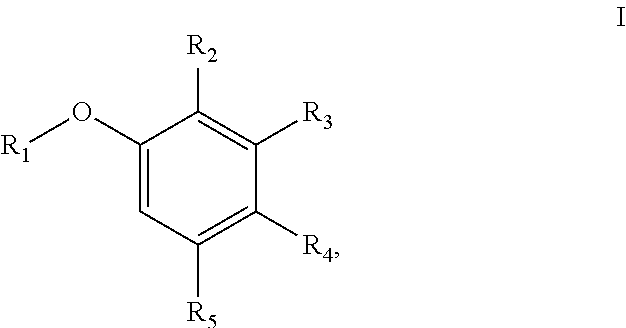

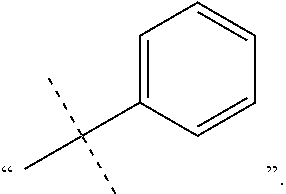


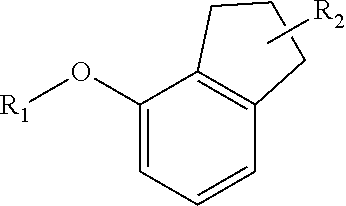
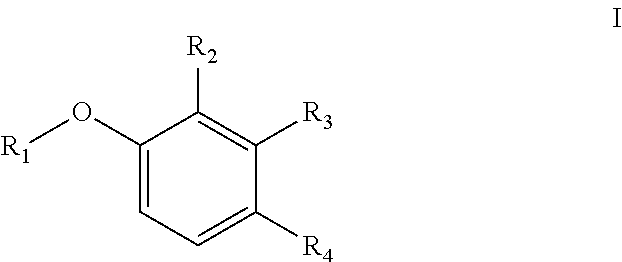


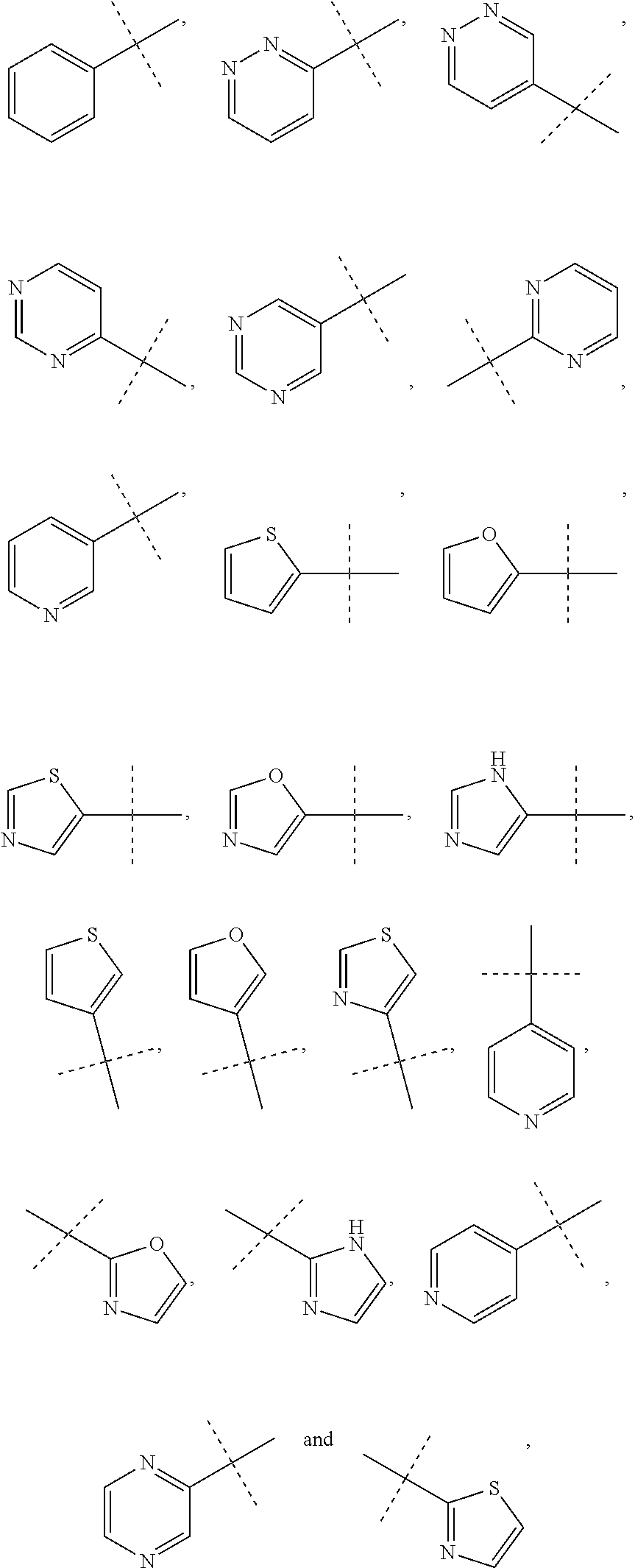


View All Diagrams
| United States Patent Application | 20190119214 |
| Kind Code | A1 |
| Dixon; Darryl David ; et al. | April 25, 2019 |
ARYL ETHERS AND USES THEREOF
Abstract
The present disclosure relates to HIF-2.alpha. inhibitors and methods of making and using them for treating cancer. Certain compounds were potent in HIF-2.alpha. scintillation proximity assay, luciferase assay, and VEGF ELISA assay, and led to tumor size reduction and regression in 786-O xenograft bearing mice in vivo.
| Inventors: | Dixon; Darryl David; (Somerset, NJ) ; Grina; Jonas; (Coppell, TX) ; Josey; John A.; (Dallas, TX) ; Rizzi; James P.; (Irving, TX) ; Schlachter; Stephen T.; (Dallas, TX) ; Wallace; Eli M.; (Richardson, TX) ; Wang; Bin; (Dallas, TX) ; Wehn; Paul; (Dallas, TX) ; Xu; Rui; (Dallas, TX) ; Yang; Hanbiao; (Coppell, TX) | ||||||||||
| Applicant: |
|
||||||||||
|---|---|---|---|---|---|---|---|---|---|---|---|
| Family ID: | 52628976 | ||||||||||
| Appl. No.: | 16/164653 | ||||||||||
| Filed: | October 18, 2018 |
Related U.S. Patent Documents
| Application Number | Filing Date | Patent Number | ||
|---|---|---|---|---|
| 15805390 | Nov 7, 2017 | 10144711 | ||
| 16164653 | ||||
| 14905776 | Jan 15, 2016 | 9908845 | ||
| PCT/US2014/054375 | Sep 5, 2014 | |||
| 15805390 | ||||
| 61978421 | Apr 11, 2014 | |||
| 61875674 | Sep 9, 2013 | |||
| Current U.S. Class: | 1/1 |
| Current CPC Class: | C07C 2602/08 20170501; C07C 317/24 20130101; C07C 2602/04 20170501; C07C 205/22 20130101; C07D 213/85 20130101; C07C 43/23 20130101; C07D 213/89 20130101; A61P 13/12 20180101; C07C 317/36 20130101; C07C 381/10 20130101; C07C 313/06 20130101; C07C 323/22 20130101; C07C 43/263 20130101; C07C 255/54 20130101; C07C 317/34 20130101; C07C 317/48 20130101; C07C 2603/94 20170501; C07C 317/22 20130101; A61K 41/0038 20130101; C07D 213/65 20130101; C07C 317/32 20130101; C07C 43/275 20130101; C07C 43/29 20130101; A61K 31/09 20130101; A61K 31/10 20130101; C07D 231/56 20130101; C07C 317/46 20130101; C07C 317/44 20130101; C07C 311/29 20130101; C07C 2602/10 20170501; A61P 35/00 20180101; C07C 255/56 20130101; C07C 43/285 20130101; C07B 39/00 20130101; C07C 317/40 20130101; A61P 43/00 20180101; C07C 43/205 20130101; C07C 43/225 20130101; C07C 317/42 20130101 |
| International Class: | C07D 213/85 20060101 C07D213/85; A61K 31/10 20060101 A61K031/10; C07C 255/56 20060101 C07C255/56; A61K 31/09 20060101 A61K031/09; C07C 205/22 20060101 C07C205/22; C07C 311/29 20060101 C07C311/29; C07C 313/06 20060101 C07C313/06; C07D 213/89 20060101 C07D213/89; C07D 231/56 20060101 C07D231/56; C07D 213/65 20060101 C07D213/65; C07C 255/54 20060101 C07C255/54; C07C 43/225 20060101 C07C043/225; C07C 43/23 20060101 C07C043/23; C07C 43/263 20060101 C07C043/263; C07C 43/205 20060101 C07C043/205; C07C 43/285 20060101 C07C043/285; C07C 381/10 20060101 C07C381/10; C07C 323/22 20060101 C07C323/22; C07C 317/48 20060101 C07C317/48; C07C 317/46 20060101 C07C317/46; C07C 317/44 20060101 C07C317/44; C07C 317/42 20060101 C07C317/42; C07C 317/40 20060101 C07C317/40; C07C 317/36 20060101 C07C317/36; C07C 317/34 20060101 C07C317/34; C07C 317/32 20060101 C07C317/32; C07C 317/24 20060101 C07C317/24; C07C 317/22 20060101 C07C317/22 |
Goverment Interests
[0002] This invention was in part funded by a grant from Cancer Prevention Research Institute of Texas (Grant number R1009).
Claims
1.-64. (canceled)
65. A process for preparing 3-[(1S,2S,3R)-2,3-difluoro-1-hydroxy-7-methylsulfonyl-indan-4-yl]oxy-5-fl- uoro-benzonitrile, comprising: (i) fluorinating a compound of Formula A: ##STR00572## to provide a compound of Formula B: ##STR00573## and (ii) deprotecting the compound of Formula B to provide 3-[(1S,2S,3R)-2,3-difluoro-1-hydroxy-7-methylsulfonyl-indan-4-yl]oxy-5-fl- uoro-benzonitrile, represented by the formula: ##STR00574## wherein P is a protecting group.
66. The process of claim 65, wherein P is selected from acyl and methoxymethyl ether.
67. The process of claim 66, wherein P is --C(.dbd.O)R, wherein R is C.sub.1-C.sub.4 alkyl.
68. The process of claim 67, wherein P is --C(.dbd.O)CH.sub.3.
69. The process of claim 65, wherein the fluorinating comprises adding (diethylamino)sulfur trifluoride to the compound of Formula A.
70. The process of claim 65, further comprising, prior to step (i): (i-a) hydrolyzing a compound of Formula C: ##STR00575## to provide the compound of Formula A.
71. The process of claim 70, wherein the hydrolyzing comprises a silver salt.
72. The process of claim 71, wherein the silver salt is selected from Ag.sub.2CO.sub.3, AgClO.sub.4 and AgBF.sub.4.
73. The process of claim 70, further comprising, prior to step (i-a): (i-b) brominating a compound of Formula D: ##STR00576## to provide the compound of Formula C.
74. The process of claim 73, further comprising, prior to step (i-b): (i-c) protecting the hydroxy group of 3-fluoro-5-(((1S,2R)-2-fluoro-1-hydroxy-7-(methylsulfonyl)-2,3-dihydro-1H- -inden-4-yl)oxy)benzonitrile, represented by the formula: ##STR00577## with protecting group P to provide the compound of Formula D.
75. A process for preparing 3-fluoro-5-(((1S,2R)-2-fluoro-1-hydroxy-7-(methylsulfonyl)-2,3-dihydro-1H- -inden-4-yl)oxy)benzonitrile, comprising: (i) fluorinating 3-fluoro-5-(7-methylsulfonyl-1-oxo-indan-4-yl)oxy-benzonitrile, represented by the formula: ##STR00578## to provide 3-fluoro-5-((2-fluoro-7-(methylsulfonyl)-1-oxo-2,3-dihydro-1H-inden-4-yl)- oxy)benzonitrile, represented by the formula: ##STR00579## and (ii) reducing the 3-fluoro-5-((2-fluoro-7-(methylsulfonyl)-1-oxo-2,3-dihydro-1H-inden-4-yl)- oxy)benzonitrile to provide the 3-fluoro-5-(((1S,2R)-2-fluoro-1-hydroxy-7-(methylsulfonyl)-2,3-dihydro-1H- -inden-4-yl)oxy)benzonitrile, represented by the formula: ##STR00580##
76. The process of claim 75, wherein the fluorinating comprises adding N-fluoro-o-benzendisulfonamide, acetyl hypofluorite, Accufluor.RTM., Selectfluor.RTM., Selectfluor.RTM. II, or N-fluorobenzenesulfonamide to the 3-fluoro-5-(7-methylsulfonyl-1-oxo-indan-4-yl)oxy-benzonitrile.
77. The process of claim 75, wherein the reducing is an asymmetric reduction.
78. The process of claim 77, wherein the reducing provides the 3-fluoro-5-(((1S,2R)-2-fluoro-1-hydroxy-7-(methylsulfonyl)-2,3-dihydro-1H- -inden-4-yl)oxy)benzonitrile with greater than 90% enantioselectivity.
79. The process of claim 77, wherein the asymmetric reduction is selected from Corey-Bakshi-Shibata reduction, asymmetric hydrogenation, and asymmetric transfer hydrogenation.
80. The process of claim 77, further comprising a ruthenium catalyst.
81. The process of claim 75, further comprising, prior to step (i): (i-a) oxidizing 3-fluoro-5-(7-methylsulfanyl-1-oxo-indan-4-yl)oxy-benzonitrile, represented by the formula: ##STR00581## to provide the 3-fluoro-5-(7-methylsulfanyl-1-oxo-indan-4-yl)oxy-benzonitrile.
82. The process of claim 81, further comprising, prior to step (i-a): (i-b) converting 3-(2-hydroxy-5-methylsulfanyl-phenyl)propanoic acid, represented by the formula: ##STR00582## to 3-[2-(3-cyano-5-fluoro-phenoxy)-5-methylsulfanyl-phenyl]propanoic acid, represented by the formula: ##STR00583## and (i-c) cyclizing the 3-[2-(3-cyano-5-fluoro-phenoxy)-5-methylsulfanyl-phenyl]propanoic acid to provide the 3-fluoro-5-(7-methylsulfanyl-1-oxo-indan-4-yl)oxy-benzonitrile.
83. A compound that is 3-[2-(3-cyano-5-fluoro-phenoxy)-5-methylsulfanyl-phenyl]propanoic acid, represented by the formula: ##STR00584##
84. A compound that is 3-fluoro-5-(7-methylsulfanyl-1-oxo-indan-4-yl)oxy-benzonitrile, represented by the formula: ##STR00585##
Description
[0001] This application is a Continuation of U.S. application Ser. No. 15/805,390, filed on Nov. 7, 2017, which is a Continuation of U.S. application Ser. No. 14/905,776, filed Jan. 15, 2016, which is a National Stage Entry of PCT/US2014/054375, filed Sep. 5, 2014, which claims benefit of priority to U.S. Provisional App. Nos. 61/875,674, filed Sep. 9, 2013, and 61/978,421, filed Apr. 11, 2014, the entire contents of each application being hereby incorporated by reference.
[0003] Intratumoral hypoxia is a driving force in cancer progression and is closely linked to poor patient prognosis and resistance to chemotherapy and radiation treatment. Progress over the past several decades in mapping the molecular mechanisms that enable cellular adaptation to chronic oxygen deprivation has intensified interest in identifying drugs that effectively block the hypoxic response pathway in tumors. Hypoxia-Inducible Factors (HIF-1.alpha. and HIF-2.alpha.) are transcription factors that play central roles in this pathway, and thus represent attractive targets for therapeutic intervention. The half-life of HIF-.alpha. proteins is tightly regulated by the oxidative status within the cell. Under normoxic conditions, specific proline residues on the HIF proteins are hydroxylated by the oxygen sensitive HIF-specific prolyl-hydroxylases (PHD). The tumor suppressor von Hippel-Lindau (VHL) protein binds to the specific hydroxylated proline residues and recruits E3 ubiquition-ligase complex that targets HIF-.alpha. proteins for proteasomal degradation. Because PHDs require oxygen to function, under hypoxic conditions, HIF-.alpha. proteins accumulate and enter the nucleus to activate gene expression. Genetic mutations of the VHL gene that result in loss of function lead to constitutively active HIF-.alpha. proteins regardless of oxygen levels. Upon activation, these transcription factors stimulate the expression of genes that coordinately regulate anaerobic metabolism, angiogenesis, cell proliferation, cell survival, extracellular matrix remodeling, pH homeostasis, amino acid and nucleotide metabolism, and genomic instability. While many gene products involved in the hypoxic response have been explored individually as therapeutic targets for cancer, broad inhibition of the pathway through direct targeting of HIF-.alpha. proteins offers an exciting opportunity to attack tumors on multiple fronts (Keith, et al. Nature Rev. Cancer 12: 9-22, 2012).
[0004] Both HIF-1.alpha. and HIF-2.alpha. form a dimeric complex with HIF-1.beta. (or ARNT: aryl hydrocarbon receptor nuclear translocator) and subsequently bind to hypoxia response elements (HRE) in target genes. Because the level of HIF-1.beta. is unaffected by oxygen levels or VHL, transcriptional activity of the complex is largely driven by the availability of the HIF-.alpha. proteins. While HIF-1.alpha. and HIF-2.alpha. share significant sequence homology, they differ in tissue distribution, sensitivity to hypoxia, timing of activation and target gene specificity (Hu, et al. Mol. Cell Biol. 23: 9361-9374, 2003 and Keith, et al. Nature Rev. Cancer 12: 9-22, 2012). Whereas HIF-1.alpha. mRNA is ubiquitously expressed, the expression of HIF-2.alpha. mRNA is found primarily in kidney fibroblasts, hepatocytes and intestinal lumen epithelial cells. Consistent with the tight regulation of the HIF-.alpha. proteins under normal physiology, neither is detected in normal tissue with the exception of HIF-2.alpha. in macrophages (Talks, et al. Am. J. Pathol. 157: 411-421, 2000). However, HIF-2.alpha. protein has been detected in various human tumors of the bladder, breast, colon, liver, ovaries, pancreas, prostate and kidney as well as tumor-associated macrophages (Talks, et al. Am. J. Pathol. 157: 411-421, 2000). HIF-1.alpha. has been reported to give a transient, acute transcriptional response to hypoxia while HIF-2.alpha. provides more prolonged transcriptional activity. Furthermore, HIF-2.alpha. has greater transcriptional activity than HIF-1.alpha. under moderately hypoxic conditions like those encountered in end capillaries (Holmquist-Mengelbier, et al. Cancer Cell 10: 413-423, 2006). Whereas some hypoxia-regulated genes are controlled by both HIF-1.alpha. and HIF-2.alpha., some are only responsive to specific HIF-.alpha. proteins. For example, lactate dehydrogenase A (LDHA), phosphoglycerate kinase (PGK) and pyruvate dehydrogenase kinase 1 (PDK1) are uniquely controlled by HIF-1.alpha. whereas Oct-4 and erythropoietin (EPO) by HIF-2.alpha.. Often the relative contributions of the HIF-.alpha. proteins to gene transcription are cell type-, and disease-specific. More importantly, the HIF-.alpha. proteins may play contrasting roles in tumorigenesis. For example, the oncogene MYC is a transcription factor that controls cell cycle G1/S transition. MYC is overexpressed in 40% of human cancer. It has been shown that HIF-2.alpha. activity increases MYC transcription activity whereas HIF-1.alpha. inhibits MYC activity. As a result, in MYC driven tumors, HIF-2.alpha. inhibition reduced proliferation whereas HIF-1.alpha. inhibition increased growth (Gordan, et al. Cancer Cell 11: 335-347, 2007 and Koshiji et al. EMBO J. 23: 1949-1956, 2004).
[0005] Therefore, the identification of effective small molecules to modulate the activity of HIF-2.alpha. is desirable.
SUMMARY
[0006] In one aspect, the present disclosure provides a compound of Formula I
##STR00001## [0007] or a pharmaceutically acceptable salt thereof, wherein: [0008] R.sub.1 is aryl or heteroaryl; [0009] R.sub.2 is nitro, carboxaldehyde, carboxylic acid, ester, amido, cyano, halo, sulfonyl, alkyl or heteroalkyl; [0010] R.sub.3 is hydrogen, halo, cyano, alkyl, heteroalkyl, alkenyl, alkynyl, alkylamino, carboxaldehyde, carboxylic acid, oxime, ester, amido or acyl, or R.sub.2/R.sub.3 and atoms they are attached to form a 5- or 6-membered carbocycle with at least one sp.sup.3 hybridized carbon; [0011] R.sub.4 is nitro, halo, cyano, alkyl, sulfinyl, sulfonamide, sulfonyl or sulfoximinyl; and [0012] R.sub.5 is hydrogen, halo or alkyl.
[0013] In another aspect, the present disclosure provides a pharmaceutical composition comprising a compound described herein and a pharmaceutically acceptable carrier or excipient. The compound may exist in an amorphous form, a crystalline form, or as a salt, solvate or hydrate.
[0014] In another aspect, the present disclosure provides a method of treating renal cell carcinoma by administrating a therapeutically effective amount of a compound described herein or a pharmaceutical composition thereof to a subject in need of such treatment. In some embodiments, the subject is a human.
[0015] In another aspect, the present disclosure provides a method of inhibiting the activities of HIF-2.alpha. in a cell, comprising contacting the cell with an effective amount of a compound described herein.
[0016] In another aspect, the present disclosure provides a kit comprising a pharmaceutical composition comprising a compound described herein and a pharmaceutically acceptable carrier or excipient and an instruction for using the composition to treat a subject suffering from cancer. In some embodiments, the cancer is renal cell carcinoma.
BRIEF DESCRIPTION OF FIGURES
[0017] FIG. 1 shows treatment of renal cell carcinoma 786-O xenograft bearing mice at 0 mg/kg (denoted as "Veh"), 10 mg/kg, 30 mg/kg, and 100 mg/kg of Compound 15 three times each at 12 hour intervals. FIG. 1 shows that Compound 15 treatment of renal cell carcinoma 786-O xenograft bearing mice reduced the mRNA levels of HIF-2.alpha. and HIF-2.alpha.-regulated genes (PAI-1, CCND1, VEGFA, and GLUT1) in tumor. Compound 15 had no significant effect on the mRNA level of HIF-1.alpha. or non-HIF-2.alpha.-regulated genes (PGK1 and PDK1).
[0018] FIG. 2 shows treatment of renal cell carcinoma 786-O xenograft bearing mice at 0 mg/kg (denoted as "Vehicle") and 10 mg/kg of Compound 163 three times each at 12 hour intervals. FIG. 2 shows that Compound 163 treatment of renal cell carcinoma 786-O xenograft bearing mice reduced the mRNA levels of HIF-2.alpha. and HIF-2.alpha.-regulated genes (PAI-1 and CCND1) in tumor. Compound 163 had no significant effect on the mRNA levels of HIF-1.alpha. and non-HIF-2.alpha.-regulated genes (PGK1 and PDK1).
[0019] FIG. 3 shows treatment of 786-O xenograft bearing mice at 0 mg/kg (denoted as "Veh"), 10 mg/kg, 30 mg/kg, and 100 mg/kg of Compound 15 three times each at 12 hour intervals. FIG. 3 shows that Compound 15 treatment of 786-O xenograft bearing mice reduced HIF-2.alpha.-regulated EPO gene expression in mouse kidney, but had no significant effect on the expression of HIF-1.alpha.-regulated PGK1 gene.
[0020] FIG. 4 shows treatment of 786-O xenograft bearing mice at 0 mg/kg (denoted as "Veh"), 10 mg/kg, 30 mg/kg, and 100 mg/kg of Compound 15 three times each at 12 hour intervals. FIG. 4 shows that Compound 15 treatment of 786-O xenograft bearing mice reduced the levels of HIF-2.alpha. and CyclinD1 proteins in tumor.
[0021] FIG. 5 shows human VEGF levels of 786-O xenograft bearing mice before (denoted as "Prior to treatment") and after treatment (denoted as "12 h post treatment") at 0 mg/kg (denoted as "Vehicle"), 10 mg/kg, 30 mg/kg, and 100 mg/kg of Compound 15 three times each at 12 hour intervals. FIG. 5 shows that Compound 15 treatment of 786-O xenograft bearing mice reduced the plasma level of human VEGFA.
[0022] FIG. 6 shows treatment of 786-O xenograft bearing mice at 0 mg/kg (denoted as "Vehicle") and 10 mg/kg of Compound 163 three times each at 12 hour intervals. FIG. 6 shows that Compound 163 treatment of 786-O xenograft bearing mice reduced the plasma level of human VEGFA.
[0023] FIG. 7 shows treatment of 786-O xenograft bearing mice at 0 mg/kg (denoted as "Vehicle"), 3 mg/kg, 10 mg/kg, 30 mg/kg, and 100 mg/kg of Compound 15 BID and 40 mg/kg of sutent QD, respectively, for 20 days. FIG. 7 shows that Compound 15 treatment of 786-O xenograft bearing mice as a single agent led to tumor size reduction and regression.
[0024] FIG. 8 shows that Compound 163 treatment of 786-O xenograft bearing mice at 0 mg/kg (denoted as "Vehicle") and 10 mg/kg BID of Compound 163 BID for 28 days. FIG. 8 shows that Compound 163 treatment of 786-O xenograft bearing mice as a single agent led to tumor size reduction and regression.
[0025] FIG. 9 depicts a 96-well plate layout of an ELISA assay.
[0026] FIG. 10 depicts a 96-well plate layout of a luciferase assay.
DETAILED DESCRIPTION OF THE INVENTION
[0027] For purposes of interpreting this disclosure, the following definitions will apply.
[0028] The term "HIF-2.alpha." refers to a monomeric protein that contains several conserved structured domains: basic helix-loop-helix (bHLH), and two Per-ARNT-Sim (PAS) domains designated PAS-A and PAS-B, in addition to C-terminal regulatory regions. "HIF-2.alpha." is also alternatively known by several other names in the scientific literature, including Endothelial PAS Domain Protein 1 (EPAS1), HIF2A, PASD2, HIF-2-Alpha, HIF2-Alpha, HLF, Hypoxia-Inducible Factor 2-Alpha, HIF-1alpha-Like Factor, and MOP2. As a member of the bHLH/PAS family of transcription factors, "HIF-2.alpha." forms an active heterodimeric transcription factor complex by binding to the ARNT (also known as HIF-1.beta.) protein through non-covalent interactions.
[0029] The term "subject" includes, but is not limited to, humans of any age group, e.g., a pediatric subject (e.g., infant, child or adolescent) or adult subject (e.g., young adult, middle-aged adult or senior adult)) and/or other primates (e.g., cynomolgus monkeys or rhesus monkeys); mammals, including commercially relevant mammals such as cattle, pigs, horses, sheep, goats, cats, and/or dogs; and/or birds, including commercially relevant birds such as chickens, ducks, geese, quail, and/or turkeys.
[0030] The term "scintillation proximity assay" (SPA) refers to a homogenous assay in which light is emitted when a radiolabeled ligand is brought into close proximity to a radiosensitive bead. The assay typically contains a target protein that contains a tag (e.g., His Tag, Glutathione S-transferase Tag). The tag on the protein is used to bind the target protein to the scintillation bead. Radio-labeled ligand (e.g., labeled with tritium) that binds to the protein is now in close proximity to the bead, and when the radio-label (e.g., tritium) decays, the high energy particle hits the bead resulting in the emission of light that is detected by a detector, such as photomultiplier tube or CCD camera. When unlabeled ligands or compounds that bind to the protein are used in the assay, they displace the radio-labeled ligand, resulting in loss of signal. For a general reference describing the assay, see Park, et al. Analytical Biochemistry 269: 94-104, 1999.
[0031] HIF-2.alpha. activity as used herein has its ordinary meaning in the art. HIF-2.alpha. activity, for example, includes activation of gene transcription mediated by HIF-2.alpha..
[0032] The term "inhibiting HIF-2.alpha. activity", as used herein, refers to slowing, reducing, altering, as well as completely eliminating and/or preventing HIF-2.alpha. activity.
[0033] As used herein, the terms "treatment", "treating", "palliating" and "ameliorating" are used interchangeably herein. These terms refer to an approach for obtaining beneficial or desired results including, but are not limited to, therapeutic benefit and/or a prophylactic benefit. By therapeutic benefit is meant eradication or amelioration of the underlying disorder being treated. Also, a therapeutic benefit is achieved with the eradication or amelioration of one or more of the physiological symptoms associated with the underlying disorder such that an improvement is observed in the patient, notwithstanding that the patient can still be afflicted with the underlying disorder. For prophylactic benefit, the pharmaceutical compositions can be administered to a patient at risk of developing a particular disease, or to a patient reporting one or more of the physiological symptoms of a disease, even though a diagnosis of this disease may not have been made.
[0034] The term "alkyl" refers to a straight or branched hydrocarbon chain radical comprising carbon and hydrogen atoms, containing no unsaturation, and having from one to ten carbon atoms (i.e., C1-C10 alkyl). Whenever it appears herein, a numerical range such as "1 to 10" refers to each integer in the given range; e.g., "1 to 10 carbon atoms" means that the alkyl group may consist of 1 carbon atom, 2 carbon atoms, 3 carbon atoms, etc., up to and including 10 carbon atoms, although the present definition also covers the occurrence of the term "alkyl" where no numerical range is designated. In some embodiments, it is a C1-C4 alkyl group. Typical alkyl groups include, but are in no way limited to, methyl, ethyl, n-propyl, isopropyl, n-butyl, isobutyl, sec-butyl, tert-butyl, pentyl, isopentyl, neopentyl, hexyl, septyl, and the like. The alkyl is attached to the rest of the molecule by a single bond. Unless stated otherwise specifically in the specification, an alkyl group is optionally substituted by one or more of the following substituents: alkyl, heteroalkyl, alkenyl, alkynyl, cycloalkyl, heterocycloalkyl, aryl, heteroaryl, hydroxy, halo, cyano, nitro, oxo, thioxo, trimethylsilanyl, --OR.sup.a, --SR.sup.a, --OC(.dbd.O)--R.sup.a, --OC(.dbd.O)OR.sup.a, --OC(.dbd.O)N(R.sup.a).sub.2, --N(R.sup.a).sub.2, --C(.dbd.O)OR.sup.a, --C(.dbd.O)R.sup.a, --C(.dbd.O)N(R.sup.a).sub.2, --N(R.sup.a)C(.dbd.O)OR.sup.a, --N(R.sup.a)C(.dbd.O)N(R.sup.a).sub.2, --N(R.sup.a)C(.dbd.O)R.sup.a, --N(R.sup.a)S(.dbd.O).sub.tR.sup.a (where t is 1 or 2), --N(R.sup.a)S(.dbd.O).sub.tN(R.sup.a).sub.2 (where t is 1 or 2), --S(.dbd.O).sub.tR.sup.a (where t is 1 or 2), --S(.dbd.O).sub.tN(R.sup.a).sub.2 (where t is 1 or 2), --OPO.sub.3WY (where W and Y are independently hydrogen, methyl, ethyl, alkyl, lithium, sodium or potassium) or --OPO.sub.3Z (where Z is calcium, magnesium or iron), wherein each R.sup.a is independently hydrogen, alkyl, heteroalkyl, cycloalkyl, heterocycloalkyl, aryl or heteroaryl.
[0035] The term "aromatic" or "aryl" refers to an aromatic radical with six to ten ring atoms (i.e., C6-C10 aromatic or C6-C10 aryl) which has at least one ring having a conjugated pi electron system which is carbocyclic (e.g., phenyl, fluorenyl, and naphthyl). Whenever it appears herein, a numerical range such as "6 to 10" refers to each integer in the given range; e.g., "6 to 10 ring atoms" means that the aryl group may consist of 6 ring atoms, 7 ring atoms, etc., up to and including 10 ring atoms. The term includes monocyclic or fused-ring polycyclic (i.e., rings which share adjacent pairs of ring atoms) groups. Unless stated otherwise specifically in the specification, an aryl moiety is optionally substituted by one or more substituents which are independently alkyl, heteroalkyl, alkenyl, allynyl, cycloalkyl, heterocycloalkyl, aryl, heteroaryl, hydroxy, halo, cyano, nitro, oxo, thioxo, trimethylsilanyl, --OR.sup.a, --SR.sup.a, --OC(.dbd.O)--R.sup.a, --OC(.dbd.O)OR.sup.a, --OC(.dbd.O)N(R.sup.a).sub.2, --N(R.sup.a).sub.2, --C(.dbd.O)R.sup.a, --C(.dbd.O)OR.sup.a, --C(.dbd.O)N(R.sup.a).sub.2, --N(R.sup.a)C(.dbd.O)OR.sup.a, --N(R.sup.a)C(.dbd.O)N(R.sup.a).sub.2, --N(R.sup.a)C(.dbd.O)R.sup.a, --N(R.sup.a)S(.dbd.O).sub.tN(R.sup.a).sub.2 (where t is 1 or 2), --N(R.sup.a)S(.dbd.O).sub.tR.sup.a (where t is 1 or 2), --S(.dbd.O).sub.tR.sup.a (where t is 1 or 2), --S(.dbd.O).sub.tN(R.sup.a).sub.2 (where t is 1 or 2), or --OPO.sub.3WY (where W and Y are independently hydrogen, methyl, ethyl, alkyl, lithium, sodium or potassium) or --OPO.sub.3Z (where Z is calcium, magnesium or iron), wherein each R.sup.a is independently hydrogen, alkyl, heteroalkyl, cycloalkyl, heterocycloalkyl, aryl or heteroaryl.
[0036] The term "heteroaryl" or, alternatively, "heteroaromatic" refers to a 5- to 18-membered aromatic radical (i.e., C5-C18 heteroaryl) that includes one or more ring heteroatoms selected from nitrogen, oxygen and sulfur, and which may be a monocyclic, bicyclic, tricyclic or tetracyclic ring system. Whenever it appears herein, a numerical range such as "5 to 18" refers to each integer in the given range; e.g., "5 to 18 ring atoms" means that the heteroaryl group may consist of 5 ring atoms, 6 ring atoms, etc., up to and including 18 ring atoms. An N-containing "heteroaromatic" or "heteroaryl" moiety refers to an aromatic group in which at least one of the skeletal atoms of the ring is a nitrogen atom. The polycyclic heteroaryl group may be fused or non-fused. The heteroatom(s) in the heteroaryl radical, e.g., nitrogen or sulfur, is optionally oxidized. One or more nitrogen atoms, if present, are optionally quaternized. The heteroaryl is attached to the rest of the molecule through any atom of the ring(s). Examples of heteroaryls include, but are not limited to, azepinyl, acridinyl, benzimidazolyl, benzindolyl, 1,3-benzodioxolyl, benzooxazolyl, benzo[d]thiazolyl, benzothiadiazolyl, benzo[b][1,4]dioxepinyl, benzo[b][1,4]oxazinyl, 1,4-benzodioxanyl, benzonaphthofuranyl, benzoxazolyl, benzodioxolyl, benzodioxinyl, benzoxazolyl, benzopyranyl, benzopyranonyl, benzofuranyl, benzofuranonyl, benzofurazanyl, benzothiazolyl, benzothienyl, benzothieno[3,2-d]pyrimidinyl, benzotriazolyl, benzo[4,6]imidazo[1,2-a]pyridinyl, carbazolyl, cinnolinyl, cyclopenta[d]pyrimidinyl, 6,7-dihydro-5H-cyclopenta[4,5]thieno[2,3-d]pyrimidinyl, 5,6-dihydrobenzo[h]quinazolinyl, 5,6-dihydrobenzo[h]cinnolinyl, 6,7-dihydro-5H-benzo[6,7]cyclohepta[1,2-c]pyridazinyl, dibenzofuranyl, dibenzothiophenyl, furanyl, furazanyl, furanonyl, furo[3,2-c]pyridinyl, 5,6,7,8,9,10-hexahydrocycloocta[d]pyrimidinyl, 5,6,7,8,9,10-hexahydrocycloocta[d]pyridazinyl, 5,6,7,8,9,10-hexahydrocycloocta[d]pyridinyl, isothiazolyl, imidazolyl, indazolyl, indolyl, indazolyl, isoindolyl, indolinyl, isoindolinyl, isoquinolyl, indolizinyl, isoxazolyl, 5,8-methano-5,6,7,8-tetrahydroquinazolinyl, naphthyridinyl, 1,6-naphthyridinonyl, oxadiazolyl, 2-oxoazepinyl, oxazolyl, oxiranyl, 5,6,6a,7,8,9,10,10a-octahydrobenzo[h]quinazolinyl, 1-phenyl-1H-pyrrolyl, phenazinyl, phenothiazinyl, phenoxazinyl, phthalazinyl, pteridinyl, purinyl, pyranyl, pyrrolyl, pyrazolyl, pyrazolo[3,4-d]pyrimidinyl, pyridinyl, pyrido[3,2-d]pyrimidinyl, pyrido[3,4-d]pyrimidinyl, pyrazinyl, pyrimidinyl, pyridazinyl, pyrrolyl, quinazolinyl, quinoxalinyl, quinolinyl, isoquinolinyl, tetrahydroquinolinyl, 5,6,7,8-tetrahydroquinazolinyl, 5,6,7,8-tetrahydrobenzo[4,5]thieno[2,3-d]pyrimidinyl, 6,7,8,9-tetrahydro-5H-cyclohepta[4,5]thieno[2,3-d]pyrimidinyl, 5,6,7,8-tetrahydropyrido[4,5-c]pyridazinyl, thiazolyl, thiadiazolyl, thiapyranyl, triazolyl, tetrazolyl, triazinyl, thieno[2,3-d]pyrimidinyl, thieno[3,2-d]pyrimidinyl, thieno[2,3-c]pridinyl, and thiophenyl (i.e. thienyl). Unless stated otherwise specifically in the specification, a heteroaryl moiety is optionally substituted by one or more substituents which are independently: alkyl, heteroalkyl, alkenyl, alkynyl, cycloalkyl, heterocycloalkyl, aryl, heteroaryl, hydroxy, halo, cyano, nitro, oxo, thioxo, trimethylsilanyl, --SR.sup.a, --OC(.dbd.O)--R.sup.a, --OC(.dbd.O)OR.sup.a, --N(R.sup.a).sub.2, --C(.dbd.O)OR.sup.a, --OC(.dbd.O)N(R.sup.a).sub.2, --C(.dbd.O)R.sup.a, --C(.dbd.O)N(R.sup.a).sub.2, --N(R.sup.a)C(.dbd.O)OR.sup.a, --N(R.sup.a)C(.dbd.O)N(R.sup.a).sub.2, --N(R.sup.a)C(.dbd.O)R.sup.a, --N(R.sup.a)S(.dbd.O).sub.tR.sup.a (where t is 1 or 2), --N(R.sup.a)S(.dbd.O).sub.tN(R.sup.a).sub.2 (where t is 1 or 2), --S(.dbd.O).sub.tR.sup.a (where t is 1 or 2), --S(.dbd.O).sub.tN(R.sup.a).sub.2 (where t is 1 or 2), --OPO.sub.3WY (where W and Y are independently hydrogen, methyl, ethyl, alkyl, lithium, sodium or potassium) or --OPO.sub.3Z (where Z is calcium, magnesium or iron), wherein each R.sup.a is independently hydrogen, alkyl, heteroalkyl, cyclolalkyl, heterocycloalkyl, aryl or heteroaryl. Examples of monocylic heteroaryls include, but are not limited to, imidazolyl, pyridinyl, pyrrolyl, pyrazinyl, pyrimidinyl, thiazolyl, furanyl and thienyl.
[0037] The term "acyl" refers to a --(C.dbd.O)R radical, wherein R is alkyl, cycloalkyl, aryl, heteroaryl, heteroalkyl, or heterocycloalkyl, which are as described herein. The R group is joined to the carbonyl through a carbon-carbon single bond. In some embodiments, it is a C1-C10 acyl radical which refers to the total number of chain or ring atoms of the alkyl, cycloalkyl, aryl, heteroalkyl, heteroaryl or heterocycloalkyl portion of the acyl group plus the carbonyl carbon of acyl, i.e. ring or chain atoms plus carbonyl. If the R radical is heteroaryl or heterocycloalkyl, the hetero ring or chain atoms contribute to the total number of chain or ring atoms. Unless stated otherwise specifically in the specification, the R of an acyl group is optionally substituted by one or more substituents which independently are: alkyl, heteroalkyl, alkenyl, alkynyl, cycloalkyl, heterocycloalkyl, aryl, heteroaryl, hydroxy, halo, cyano, trifluoromethyl, trifluoromethoxy, nitro, trimethylsilanyl, --OR.sup.a, --SR.sup.a, --OC(.dbd.O)--R.sup.a, --OC(.dbd.O)OR.sup.a, --N(R.sup.a).sub.2, --C(.dbd.O)R.sup.a, --C(.dbd.O)OR.sup.a, --OC(.dbd.O)N(R.sup.a).sub.2, --C(.dbd.O)N(R.sup.a).sub.2, --N(R.sup.a)C(.dbd.O)OR.sup.a, --N(R.sup.a)C(.dbd.O)N(R.sup.a).sub.2, --N(R.sup.a)C(.dbd.O)R.sup.a, --N(R.sup.a)S(.dbd.O).sub.tR.sup.a (where t is 1 or 2), --N(R.sup.a)S(.dbd.O).sub.tN(R.sup.a).sub.2 (where t is 1 or 2), --S(.dbd.O).sub.tR.sup.a (where t is 1 or 2), --S(.dbd.O).sub.tN(R.sup.a).sub.2 (where t is 1 or 2), or --P(.dbd.O)(OR.sup.a).sub.2, wherein each of R.sup.a is independently hydrogen, alkyl, heteroalkyl, cycloalkyl, heterocycloalkyl, aryl or heteroaryl.
[0038] The term "halo", "halide", or alternatively, "halogen" means fluoro, chloro, bromo or iodo. The terms "haloalkyl" refers to alkyl structures that are substituted with one or more halo groups or combinations thereof. The terms "haloalkoxy" refers to alkoxy structures that are substituted with one or more halo groups or combinations thereof. The terms "fluoroalkyl" and "fluoroalkoxy" refer to haloalkyl and haloalkoxy groups, respectively, in which the halo is fluoro. Examples of fluoroalkyl include, but are not limited to, --CH.sub.2F, --CHF.sub.2, --CF.sub.3, --CF.sub.2CH.sub.3, --CH.sub.2CF.sub.3, and --CF.sub.2CF.sub.3.
[0039] The term "cyano" refers to a --CN radical.
[0040] The term "alkoxy" refers to an --O-alkyl radical, wherein alkyl is as described herein and contains 1 to 10 carbons (i.e., C1-C10 alkoxy). Whenever it appears herein, a numerical range such as "1 to 10" refers to each integer in the given range; e.g., "1 to 10 carbon atoms" means that the alkyl group may consist of 1 carbon atom, 2 carbon atoms, 3 carbon atoms, etc., up to and including 10 carbon atoms. In some embodiments, it is a C1-C4 alkoxy group. Unless stated otherwise specifically in the specification, an alkoxy moiety may be substituted by one or more of the substituents described as suitable substituents for an alkyl radical.
[0041] The term "sp.sup.3 hybridized carbon" refers to a carbon atom that is bonded to four other atoms. sp.sup.3 hybridization results from the combination of the s orbital and all three p orbitals in the second energy level of carbon. It results in four equivalent orbitals and the geometric arrangement of those four orbitals is tetrahedral.
[0042] The term "sulfonyl" refers to a --S(.dbd.O).sub.2--R radical, wherein R is selected from the group consisting of alkyl, cycloalkyl, aryl, heteroalkyl, heteroaryl (bonded through a ring carbon) and heterocycloalkyl (bonded through a ring carbon). Unless stated otherwise specifically in the specification, the R group may be substituted by one or more of the substituents described as suitable substituents for an alkyl, an aryl or a heteroaryl radical.
[0043] The term "sulfoximinyl" refers to a --S(.dbd.O)(.dbd.NR.sup.a)--R.sup.b radical, wherein R.sup.a is selected from the group consisting of hydrogen, alkyl, cycloalkyl, aryl, cyano, carbamoyl, acyl, heteroaryl (bonded through a ring carbon) and heterocycloalkyl (bonded through a ring carbon) and R.sup.b is independently selected from the group consisting of alkyl, cycloalkyl, aryl, heteroalkyl, heteroaryl (bonded through a ring carbon) and heterocycloalkyl (bonded through a ring carbon). Unless stated otherwise specifically in the specification, the R.sup.a and R.sup.b group may be substituted by one or more of the substituents described as suitable substituents for an alkyl, an aryl or a heteroaryl radical.
[0044] The term "sulfonamide" refers to a --S(.dbd.O).sub.2--N(R.sup.a).sub.2 radical, wherein each R.sup.a is independently hydrogen, alkyl, heteroalkyl, cycloalkyl or heterocycloalkyl, and at least one R.sup.a is hydrogen.
[0045] The term "alkylsulfonamide" refers to a --S(.dbd.O).sub.2--NHR radical, wherein R is alkyl or cycloalkyl.
[0046] The term "cycloalkyl" refers to a monocyclic or polycyclic non-aromatic radical that contains carbon and hydrogen, and may be saturated, or partially unsaturated. Cycloalkyl groups include groups having from 3 to 10 ring atoms (i.e., C3-C10 cycloalkyl). Whenever it appears herein, a numerical range such as "3 to 10" refers to each integer in the given range; e.g., "3 to 10 carbon atoms" means that the cycloalkyl group may consist of 3 carbon ring atoms, 4 carbon ring atoms, 5 carbon ring atoms, etc., up to and including 10 carbon ring atoms. In some embodiments, it is a C3-C5 cycloalkyl radical. Illustrative examples of cycloalkyl groups include, but are not limited to the following moieties: cyclopropyl, cyclobutyl, cyclopentyl, cyclohexyl, cycloseptyl, cyclooctyl, cyclononyl, cyclodecyl, and the like. Unless stated otherwise specifically in the specification, a cycloalkyl group is optionally substituted by one or more substituents which independently are: alkyl, heteroalkyl, alkenyl, alkynyl, cycloalkyl, heterocycloalkyl, aryl, heteroaryl, hydroxy, halo, cyano, nitro, oxo, thioxo, trimethylsilanyl, --OR.sup.a, --SR.sup.a, --OC(.dbd.O)--R.sup.a, --OC(.dbd.O)OR.sup.a, --OC(.dbd.O)N(R.sup.a).sub.2, --N(R.sup.a).sub.2, --C(.dbd.O)R.sup.a, --C(.dbd.O)OR.sup.a, --C(.dbd.O)N(R.sup.a).sub.2, --N(R.sup.a)C(.dbd.O)OR.sup.a, --N(R.sup.a)C(.dbd.O)N(R.sup.a).sub.2, --N(R.sup.a)C(.dbd.O)R.sup.a, --N(R.sup.a)S(.dbd.O).sub.tR.sup.a (where t is 1 or 2), --N(R.sup.a)S(.dbd.O).sub.tN(R.sup.a).sub.2 (where t is 1 or 2), --S(.dbd.O).sub.tR.sup.a (where t is 1 or 2),
--S(.dbd.O).sub.tN(R.sup.a).sub.2 (where t is 1 or 2), --OPO.sub.3WY (where W and Y are independently hydrogen, methyl, ethyl, alkyl, lithium, sodium or potassium) or --OPO.sub.3Z (where Z is calcium, magnesium or iron), wherein each R.sup.a is independently hydrogen, alkyl, heteroalkyl, cycloalkyl, heterocycloalkyl, aryl or heteroaryl.
[0047] The term "heterocyclyl" or "heterocycloalkyl" refers to a stable and not fully aromatic 3- to 18-membered ring (i.e., C3-C18 heterocycloalkyl) radical that comprises two to twelve ring carbon atoms and from one to six ring heteroatoms selected from nitrogen, oxygen and sulfur. Whenever it appears herein, a numerical range such as "3 to 18" refers to each integer in the given range; e.g., "3 to 18 ring atoms" means that the heterocycloalkyl group may consist of 3 ring atoms, 4 ring atoms, etc., up to and including 18 ring atoms. In some embodiments, it is a C5-C10 heterocycloalkyl. In some embodiments, it is a C4-C10 heterocycloalkyl. In some embodiments, it is a C3-C10 heterocycloalkyl. Unless stated otherwise specifically in the specification, the heterocycloalkyl radical may be a monocyclic, bicyclic, tricyclic or tetracyclic ring system, which may include fused or bridged ring systems. The heteroatoms in the heterocycloalkyl radical may be optionally oxidized. One or more nitrogen atoms, if present, may optionally be quaternized. The heterocycloalkyl radical may be partially or fully saturated. The heterocycloalkyl may be attached to the rest of the molecule through any atom of the ring(s). Examples of such heterocycloalkyl radicals include, but are not limited to, 6,7-dihydro-5H-cyclopenta[b]pyridine, dioxolanyl, thienyl[1,3]dithianyl, decahydroisoquinolyl, imidazolinyl, imidazolidinyl, isothiazolidinyl, isoxazolidinyl, morpholinyl, octahydroindolyl, octahydroisoindolyl, 2-oxopiperazinyl, 2-oxopiperidinyl, 2-oxopyrrolidinyl, oxazolidinyl, piperidinyl, piperazinyl, 4-piperidonyl, pyrrolidinyl, pyrazolidinyl, quinuclidinyl, thiazolidinyl, tetrahydrofuryl, trithianyl, tetrahydropyranyl, thiomorpholinyl, thiamorpholinyl, 1-oxo-thiomorpholinyl, and 1,1-dioxo-thiomorpholinyl. Unless stated otherwise specifically in the specification, a heterocycloalkyl moiety is optionally substituted by one or more substituents which independently are: alkyl, heteroalkyl, alkenyl, alkynyl, cycloalkyl, heterocycloalkyl, aryl, heteroaryl, hydroxy, halo, cyano, nitro, oxo, thioxo, trimethylsilanyl, --OR.sup.a, --SR.sup.a, --OC(.dbd.O)--R.sup.a, --OC(.dbd.O)OR.sup.a, --OC(.dbd.O)N(R.sup.a).sub.2, --N(R.sup.a).sub.2, --C(.dbd.O)R.sup.a, --C(.dbd.O)OR.sup.a, --C(.dbd.O)N(R.sup.a).sub.2, --N(R.sup.a)C(.dbd.O)OR.sup.a, --N(R.sup.a)C(.dbd.O)N(R.sup.a).sub.2, --N(R.sup.a)C(.dbd.O)R.sup.a, --N(R.sup.a)S(.dbd.O).sub.tR.sup.a (where t is 1 or 2), --N(R.sup.a)S(.dbd.O).sub.tN(R.sup.a).sub.2 (where t is 1 or 2), --S(.dbd.O).sub.tR.sup.a (where t is 1 or 2), --S(.dbd.O).sub.tN(R.sup.a).sub.2 (where t is 1 or 2), --OPO.sub.3WY (where W and Y are independently hydrogen, methyl, ethyl, alkyl, lithium, sodium or potassium) or --OPO.sub.3Z (where Z is calcium, magnesium or iron), wherein each R.sup.a is independently hydrogen, alkyl, heteroalkyl, cycloalkyl, heterocycloalkyl, aryl or heteroaryl.
[0048] The terms "heteroalkyl", "heteroalkenyl" and "heteroalkynyl" include optionally substituted alkyl, alkenyl and alkynyl radicals, which respectively have one or more skeletal chain atoms selected from an atom other than carbon, e.g., oxygen, nitrogen, sulfur, phosphorus or combinations thereof. A numerical range, which refers to the chain length in total, may be given. For example, C3-C4 heteroalkyl has a chain length of 3-4 atoms. For example, a --CH.sub.2OCH.sub.2CH.sub.3 radical is referred to as a "C4 heteroalkyl", which includes the heteroatom in the atom chain length description. Connection to the rest of the molecule is through a carbon in the heteroalkyl chain. A heteroalkyl may be a substituted alkyl. The same definition applies to heteroalkenyl or heteroalkynyl. Unless otherwise stated in the specification, a heteroalkyl group may be substituted with one or more substituents which independently are: alkyl, heteroalkyl, alkenyl, alkynyl, cycloalkyl, heterocycloalkyl, aryl, heteroaryl, hydroxy, halo, cyano, nitro, oxo, thioxo, trimethylsilanyl, --OR.sup.a, --SR.sup.a, --OC(.dbd.O)--R.sup.a, --OC(.dbd.O)OR.sup.a, --OC(.dbd.O)N(R.sup.a).sub.2, --N(R.sup.a).sub.2, --C(.dbd.O)R.sup.a, --C(.dbd.O)OR.sup.a, --C(.dbd.O)N(R.sup.a).sub.2, --N(R.sup.a)C(.dbd.O)OR.sup.a, --N(R.sup.a)C(.dbd.O)N(R.sup.a).sub.2, --N(R.sup.a)C(.dbd.O)R.sup.a, --N(R.sup.a)S(.dbd.O).sub.tR.sub.a (where t is 1 or 2), --N(R.sup.a)S(.dbd.O).sub.tN(R.sup.a).sub.2 (where t is 1 or 2), --S(.dbd.O).sub.tR.sup.a (where t is 1 or 2), --S(.dbd.O).sub.tN(R.sup.a).sub.2 (where t is 1 or 2), --OPO.sub.3WY (where W and Y are independently hydrogen, methyl, ethyl, alkyl, lithium, sodium or potassium) or --OPO.sub.3Z (where Z is calcium, magnesium or iron), wherein each R.sup.a is independently hydrogen, alkyl, heteroalkyl, cycloalkyl, heterocycloalkyl, aryl or heteroaryl.
[0049] The term "amino" or "amine" refers to a --NH.sub.2 radical group,
[0050] The term "acyloxy" refers to a R(C.dbd.O)O-- radical wherein R is alkyl, cycloalkyl, aryl, heteroalkyl, heteroaryl or heterocycloalkyl, which are as described herein. In some embodiments, it is a C2-C4 acyloxy radical, wherein the C2-C4 refers to the total number, i.e., 1-3 of the chain or ring atoms of the alkyl, cycloalkyl, aryl, heteroalkyl, heteroaryl or heterocycloalkyl portion of the acyloxy group plus the carbonyl carbon of acyl, i.e., the ring or chain atoms plus carbonyl. If the R radical is heteroaryl or heterocycloalkyl, the hetero ring or chain atoms contribute to the total number of chain or ring atoms. Unless stated otherwise specifically in the specification, the R of an acyloxy group is optionally substituted by one or more of the following substituents: alkyl, heteroalkyl, alkenyl, alkynyl, cycloalkyl, heterocycloalkyl, aryl, heteroaryl, hydroxy, halo, cyano, nitro, oxo, thioxo, trimethylsilanyl, --OR.sup.a, --SR.sup.a, --OC(.dbd.O)--R.sup.a, --OC(.dbd.O)OR.sup.a, --OC(.dbd.O)N(R.sup.a).sub.2, --N(R.sup.a).sub.2, --C(.dbd.O)R.sup.a, --C(.dbd.O)OR.sup.a, --C(.dbd.O)N(R.sup.a).sub.2, --N(R.sup.a)C(.dbd.O)OR.sup.a, --N(R.sup.a)C(.dbd.O)N(R.sup.a).sub.2, --N(R.sup.a)C(.dbd.O)R.sup.a, --N(R.sup.a)S(.dbd.O).sub.tR.sup.a (where t is 1 or 2), --N(R.sup.a)S(.dbd.O).sub.tN(R.sup.a).sub.2 (where t is 1 or 2), --S(.dbd.O).sub.tR.sup.a (where t is 1 or 2), --S(.dbd.O).sub.tN(R.sup.a).sub.2 (where t is 1 or 2), --OPO.sub.3WY (where W and Y are independently hydrogen, methyl, ethyl, alkyl, lithium, sodium or potassium) or --OPO.sub.3Z (where Z is calcium, magnesium or iron), wherein each of R.sup.a is independently hydrogen, alkyl, heteroalkyl, cycloalkyl, heterocycloalkyl, aryl or heteroaryl.
[0051] The term "alkenyl" refers to a straight or branched hydrocarbon chain radical group comprising carbon and hydrogen atoms, containing at least one double bond, and having from two to ten carbon atoms (i.e., C2-C10 alkenyl). Whenever it appears herein, a numerical range such as "2 to 10" refers to each integer in the given range; e.g., "2 to 10 carbon atoms" means that the alkenyl group may contain 2 carbon atoms, 3 carbon atoms, etc., up to and including 10 carbon atoms. In certain embodiments, an alkenyl comprises two to eight carbon atoms (i.e., C2-C8 alkenyl). In other embodiments, an alkenyl comprises two to five carbon atoms (i.e., C2-C5 alkenyl). The alkenyl is attached to the rest of the molecule by a single bond, for example, ethenyl (i.e., vinyl), prop-1-enyl, but-1-enyl, pent-1-enyl, penta-1,4-dienyl, and the like. Unless stated otherwise specifically in the specification, an alkenyl group is optionally substituted by one or more of the following substituents: alkyl, heteroalkyl, alkenyl, alkynyl, cycloalkyl, heterocycloalkyl, aryl, heteroaryl, hydroxy, halo, cyano, nitro, oxo, thioxo, trimethylsilanyl, --OR.sup.a, --SR.sup.a, --OC(.dbd.O)--R.sup.a, --OC(.dbd.O)OR.sup.a, --OC(.dbd.O)N(R.sup.a).sub.2, --N(R.sup.a).sub.2, --C(.dbd.O)R.sup.a, --C(.dbd.O)OR.sup.a, --C(.dbd.O)N(R.sup.a).sub.2, --N(R.sup.a)C(.dbd.O)R.sup.a, --N(R.sup.a)C(.dbd.O)OR.sup.a, --N(R.sup.a)C(.dbd.O)N(R.sup.a).sub.2, --N(R.sup.a)S(.dbd.O).sub.tR.sup.a (where t is 1 or 2), --N(R.sup.a)S(.dbd.O).sub.tN(R.sup.a).sub.2 (where t is 1 or 2), --S(.dbd.O).sub.tR.sup.a (where t is 1 or 2), --S(.dbd.O).sub.tN(R.sup.a).sub.2 (where t is 1 or 2), --OPO.sub.3WY (where W and Y are independently hydrogen, methyl, ethyl, alkyl, lithium, sodium or potassium) or --OPO.sub.3Z (where Z is calcium, magnesium or iron), wherein each of R.sup.a is independently hydrogen, alkyl, heteroalkyl, cycloalkyl, heterocycloalkyl, aryl or heteroaryl.
[0052] The term "alkynyl" refers to a straight or branched hydrocarbon chain radical group comprising carbon and hydrogen atoms, containing at least one triple bond, and having from two to ten carbon atoms (i.e., C2-C10 alkynyl). In some embodiments, an alkynyl group may contain one or more double bonds. Whenever it appears herein, a numerical range such as "2 to 10" refers to each integer in the given range; e.g., "2 to 10 carbon atoms" means that the alkynyl group may contain 2 carbon atoms, 3 carbon atoms, etc., up to and including 10 carbon atoms. In certain embodiments, an alkynyl comprises two to eight carbon atoms (i.e., C2-C8 alkynyl). In other embodiments, an alkynyl has two to five carbon atoms (i.e., C2-C5 alkynyl). The alkynyl is attached to the rest of the molecule by a single bond, for example, ethynyl, propynyl, butynyl, pentynyl, hexynyl, and the like. Unless stated otherwise specifically in the specification, an alkynyl group is optionally substituted by one or more of the following substituents: alkyl, heteroalkyl, alkenyl, alkynyl, cycloalkyl, heterocycloalkyl, aryl, heteroaryl, hydroxy, halo, cyano, nitro, oxo, thioxo, trimethylsilanyl, --OR.sup.a, --SR.sup.a, --OC(.dbd.O)--R.sup.a, --OC(.dbd.O)OR.sup.a, --OC(.dbd.O)N(R.sup.a).sub.2, --N(R.sup.a).sub.2, --C(.dbd.O)R.sup.a, --C(.dbd.O)OR.sup.a, --C(.dbd.O)N(R.sup.a).sub.2, --N(R.sup.a)C(.dbd.O)OR.sup.a, --N(R.sup.a)C(.dbd.O)R.sup.a, --N(R.sup.a)C(.dbd.O)N(R.sup.a).sub.2, --N(R.sup.a)S(.dbd.O).sub.tR.sup.a (where t is 1 or 2), --N(R.sup.a)S(.dbd.O).sub.tN(R.sup.a).sub.2 (where t is 1 or 2), --S(.dbd.O).sub.tR.sup.a (where t is 1 or 2), --S(.dbd.O).sub.tN(R.sup.a).sub.2 (where t is 1 or 2), --OPO.sub.3WY (where W and Y are independently hydrogen, methyl, ethyl, alkyl, lithium, sodium or potassium) or --OPO.sub.3Z (where Z is calcium, magnesium or iron), wherein each R.sup.a is independently hydrogen, alkyl, heteroalkyl, cycloalkyl, heterocycloalkyl, aryl or heteroaryl.
[0053] The term "alkylamino" refers to a chemical moiety with formula --N(R.sup.a).sub.2, wherein each R.sup.a is independently hydrogen, alkyl, heteroalkyl, cycloalkyl, or heterocycloalkyl, and at least one R.sup.a is not hydrogen. Two R.sup.as may optionally form a 3-8 membered ring.
[0054] The term "amide" or "amido" refers to a chemical moiety with formula --C(.dbd.O)N(R.sup.a).sub.2 or --NR.sup.aC(.dbd.O)R.sup.a, wherein each of R.sup.a is independently selected from the group consisting of hydrogen, alkyl, cycloalkyl, aryl, heteroaryl (bonded through a ring carbon) and heterocycloalkyl. Two R.sup.as, together with the atoms they are attached to, optionally form a 5-10 membered ring. In some embodiments, it is a C1-C4 amido or amide radical, which includes the amide carbonyl in the total number of carbons in the radical. Unless stated otherwise specifically in the specification, an amido group is optionally substituted independently by one or more of the substituents as described herein for alkyl, cycloalkyl, aryl, heteroaryl, or heterocycloalkyl. An amino acid or a peptide molecule may be attached to a compound having an amine or a carboxylic acid moiety, thereby forming a prodrug. The procedures and specific groups to make such amides are known to those of skilled in the art and can readily be found in reference sources such as Greene and Wuts, Protective Groups in Organic Synthesis, 3rd Ed., John Wiley & Sons, New York, --N.Y., 1999.
[0055] "Carboxaldehyde" refers to a --(C.dbd.O)H radical.
[0056] "Carboxylic acid" refers to a --(C.dbd.O)OH radical.
[0057] "Ester" refers to a chemical radical of formula --C(.dbd.O)OR, where R is selected from the group consisting of alkyl, cycloalkyl, aryl, heteroaryl (bonded through a ring carbon) and heteroalkyl (bonded through a ring carbon). A hydroxy or carboxylic acid moiety on the compounds described herein may be esterified. The procedures and specific groups to make such esters are known to those skilled in the art and can readily be found in reference sources such as Greene and Wuts, Protective Groups in Organic Synthesis, 3rd Ed., John Wiley & Sons, --New York, --N.Y., 1999. Unless stated otherwise specifically in the specification, an ester group is optionally substituted by one or more substituents which independently are: alkyl, heteroalkyl, alkenyl, alkynyl, cycloalkyl, heterocycloalkyl, aryl, heteroaryl, hydroxy, halo, cyano, nitro, oxo, thioxo, trimethylsilanyl, --OR.sup.a, --SR.sup.a, --OC(.dbd.O)--R.sup.a, --OC(.dbd.O)OR.sup.a, --OC(.dbd.O)N(R.sup.a).sub.2, --N(R.sup.a).sub.2, --C(.dbd.O)R.sup.a, --C(.dbd.O)OR.sup.a, --C(.dbd.O)N(R.sup.a).sub.2, --N(R.sup.a)C(.dbd.O)OR.sup.a, --N(R.sup.a)C(.dbd.O)N(R.sup.a).sub.2, --N(R.sup.a)C(.dbd.O)R.sup.a, --N(R.sup.a)S(.dbd.O).sub.tR.sup.a (where t is 1 or 2), --N(R.sup.a)S(.dbd.O).sub.tN(R.sup.a).sub.2 (where t is 1 or 2), --S(.dbd.O).sub.tOR.sup.a (where t is 1 or 2), --S(.dbd.O).sub.tN(R.sup.a).sub.2 (where t is 1 or 2), --OPO.sub.3WY (where W and Y are independently hydrogen, methyl, ethyl, alkyl, lithium, sodium or potassium) or --OPO.sub.3Z (where Z is calcium, magnesium or iron), wherein each of R.sup.a is independently hydrogen, alkyl, heteroalkyl, cycloalkyl, heterocycloalkyl, aryl, or heteroaryl.
[0058] "Imino" refers to a .dbd.N--R.sup.a radical, wherein R.sup.a is hydrogen, alkyl, heteroalkyl, cycloalkyl, cyano, aryl, heterocycloalkyl or heteroaryl.
[0059] "Isocyanato" refers to a --NCO radical.
[0060] "Isothiocyanato" refers to a --NCS radical.
[0061] "Mercaptyl" refers to an (alkyl)S-- or (H)S-- radical.
[0062] "Moiety" refers to a specific segment or functional group of a molecule. Chemical moieties are often recognized chemical entities embedded in or appended to a molecule.
[0063] "Hydroxy" refers to a --OH radical.
[0064] "Oxa" refers to a --O-- radical.
[0065] "Oxo" refers to a .dbd.O radical.
[0066] "Nitro" refers to a --NO.sub.2 radical.
[0067] "Oxime" refers to a --C(.dbd.N--OH)--R radical, where R is hydrogen or alkyl.
[0068] "Sulfinyl" refers to a --S(.dbd.O)--R radical, where R is selected from the group consisting of alkyl, cycloalkyl, aryl, heteroalkyl, heteroaryl (bonded through a ring carbon) and heterocyclyl (bonded through a ring carbon). In some embodiments, R is fluoroalkyl.
[0069] "Sulfoxyl" refers to a --S(.dbd.O).sub.2OH radical.
[0070] "Sulfonate" refers to a --S(.dbd.O).sub.2--OR radical, where R is selected from the group consisting of alkyl, cycloalkyl, aryl, heteroalkyl, heteroaryl (bonded through a ring carbon) and heteroalkyl (bonded through a ring carbon). The R group is optionally substituted by one or more of the substituents described for alkyl, heteroalkyl, cycloalkyl, heterocycloalkyl, aryl, and heteroaryl respectively.
[0071] "Thiocyanato" refers to a --CNS radical.
[0072] "Thioxo" refers to a .dbd.S radical.
[0073] "Substituted" means that the referenced group may be substituted with one or more additional group(s) individually and independently selected from acyl, alkyl, heteroalkyl, cycloalkyl, heterocycloalkyl, aryl, heteroaryl, hydroxy, alkoxy, mercapto, alkylthio, arylthio, cyano, halo, carbonyl, ester, thiocarbonyl, isocyanato, thiocyanato, isothiocyanato, nitro, perhaloalkyl, perfluoroalkyl, phosphate, silyl, sulfinyl, sulfonyl, sulfonamide, sulfoximinyl, alkylamino, and amino, and the protected derivatives thereof. The substituents themselves may be substituted, for example, a cycloalkyl substituent may have a halide substituted at one or more ring carbons, and the like. The protecting groups that may form the protective derivatives of the above substituents are known to those of skill in the art and may be found in references such as Greene and Wuts cited herein.
[0074] The term "optional" or "optionally" means that the subsequently described event or circumstance may or may not occur, and includes instances where the event or circumstance occurs and instances in which it does not. For example, "alkyl optionally substituted with" encompasses both "alkyl" and "alkyl" substituted with groups as defined herein. It will be understood by those skilled in the art, with respect to any group containing one or more substituents, that such groups are not intended to introduce any substitution or substitution patterns which would be deemed unacceptable by one of ordinary skill in the art.
[0075] The methods and formulations described herein include the use of N-oxides, crystalline forms (also known as polymorphs), or pharmaceutically acceptable salts of compounds having the structure of formulae described herein, as well as active metabolites of these compounds having the same type of activity. In addition, the compounds described herein can exist in unsolvated as well as solvated forms with pharmaceutically acceptable solvents such as water, ethanol, and the like. The solvated forms of the compounds presented herein are also considered to be disclosed herein.
[0076] The compounds described herein may exhibit their natural isotopic abundance, or one or more of the atoms may be artificially enriched in a particular isotope having the same atomic number, but an atomic mass or mass number different from the atomic mass or mass number predominantly found in nature. The present invention is meant to include all suitable isotopic variations of the compounds described herein. For example, hydrogen has three naturally occurring isotopes, denoted .sup.1H (protium), .sup.2H (deuterium), and .sup.3H (tritium). Protium is the most abundant isotope in nature. Enriching for deuterium may afford certain therapeutic advantages, such as increased in vivo half-life and/or exposure, or may provide a compound useful for investigating in vivo routes of drug elimination and metabolism. Isotopically-enriched compounds may be prepared by conventional techniques well known to those skilled in the art or by processes analogous to those described in the Schemes and Examples herein using appropriate isotopically-enriched reagents and/or intermediates. See Pleiss and Voger, Synthesis and Applications of Isotopically Labeled Compounds, Vol. 7, Wiley, ISBN-10: 0471495018, published on Mar. 14, 2001.
[0077] Unless otherwise specified, chemical entities described herein may include, but are not limited to, when possible, their optical isomers, such as enantiomers and diastereomers, mixtures of enantiomers, including racemates, mixtures of diastereomers, and other mixtures thereof, to the extent they can be made by one of ordinary skill in the art by routine experimentation. In those situations, the single enantiomers or diastereomers, i.e., optically active forms, can be obtained by asymmetric synthesis or by resolution of the racemates or mixtures of diastereomers. Resolution of the racemates or mixtures of diastereomers, if needed, can be accomplished, for example, by conventional methods such as crystallization in the presence of a resolving agent, or chromatography, using, for example, a chiral high-pressure liquid chromatography (HPLC) column. In addition, chemical entities having carbon-carbon double bonds or carbon-nitrogen double bonds may exist in Z- or E-form (or cis- or trans-form). Furthermore, some chemical entities may exist in various tautomeric forms. Unless otherwise specified, chemical entities described herein are intended to include all Z-, E- and tautomeric forms as well.
[0078] The term "pharmaceutically acceptable" means that a chemical entity, such as a compound, a carrier, an additive or a salt, is acceptable for being administrated to a subject.
[0079] The term "pharmaceutically acceptable salts" refers to salts prepared from pharmaceutically acceptable bases or acids including inorganic or organic bases and inorganic or organic acids. Salts derived from inorganic bases may be selected, for example, from aluminum, ammonium, calcium, copper, ferric, ferrous, lithium, magnesium, manganic, manganous, potassium, sodium, and zinc salts. Further, for example, the pharmaceutically acceptable salts derived from inorganic bases may be selected from ammonium, calcium, magnesium, potassium, and sodium salts. Salts derived from pharmaceutically acceptable organic bases may be selected, for example, from salts of primary, secondary, and tertiary amines, substituted amines including naturally occurring substituted amines, cyclic amines, and basic ion exchange resins, such as arginine, betaine, caffeine, choline, N,N'-dibenzylethylene-diamine, diethylamine, 2-diethylaminoethanol, 2-dimethylaminoethanol, ethanolamine, ethylenediamine, N-ethyl-morpholine, N-ethylpiperidine, glucamine, glucosamine, histidine, hydrabamine, isopropylamine, lysine, methylglucamine, morpholine, piperazine, piperidine, polyamine resins, procaine, purines, theobromine, triethylamine, trimethylamine, tripropylamine, and tromethamine.
[0080] When chemical entities disclosed herein are basic, salts may be prepared using at least one pharmaceutically acceptable acid, selected from inorganic and organic acids. Such acid may be selected, for example, from acetic, benzenesulfonic, benzoic, camphorsulfonic, citric, ethanesulfonic, fumaric, gluconic, glutamic, hydrobromic, hydrochloric, isethionic, lactic, maleic, malic, mandelic, methanesulfonic, mucic, nitric, pamoic, pantothenic, phosphoric, succinic, sulfuric, tartaric, trifluoroacetic acid, and p-toluenesulfonic acids. In some embodiments, such acid may be selected, for example, from citric, hydrobromic, hydrochloric, maleic, phosphoric, sulfuric, fumaric, and tartaric acids.
[0081] The term "pharmaceutically acceptable carrier" as used herein means a diluent, excipient, encapsulating material or formulation auxiliary, which may be non-toxic, and inert, which may not have undesirable effect on a subject, preferably a mammal, more preferably a human, or which may be suitable for delivering an active agent to the target site without affecting the activity of the agent.
[0082] The term "enantiomeric excess," as used herein, is the percent excess of one enantiomer compared to that of the other enantiomer in a mixture, and can be calculated using the following equation: enantiomeric excess=((R-S)/(R+S)).times.100=% (R*)-% (S*), wherein R and S are the number of moles of each enantiomer in the mixture, and R* and S* are the respective mole fractions of the enantiomers in the mixture. For example, for a mixture with 87% R enantiomer and 13% S enantiomer, the enantiomeric excess is 74%.
[0083] The term "effective amount" or "therapeutically effective amount" refers to an amount of a compound or pharmaceutical composition described herein that is sufficient to effect the intended application including, but not limited to, disease treatment, as illustrated below. The therapeutically effective amount can vary depending upon the intended application (in vitro or in vivo), or the subject and disease condition being treated, e.g., the weight and age of the subject, the severity of the disease condition, the manner of administration and the like, which can readily be determined by one of ordinary skill in the art. The specific dose will vary depending on, for example, the particular compounds chosen, the dosing regimen to be followed, whether it is administered in combination with other agents, timing of administration, the tissue to which it is administered, and the physical delivery system in which it is carried.
[0084] The term "about" refers to .+-.10% of a stated number or value.
[0085] The following abbreviations and terms have the indicated meanings throughout:
[0086] DAST=Diethylaminosulfur trifluoride
[0087] DCM=Dichloromethane
[0088] MTBE=Methyl t-butyl ether
[0089] HATU=O-(7-azabenzotriazol-1-yl)-N,N,N',N'-tetramethyluronium hexafluorophosphate
[0090] NBS=N-Bromosuccinimide
[0091] NMP=N-Methyl-2-pyrrolidone
[0092] e.e. or ee=Enantiomeric excess
[0093] PPTS=Pyridinium p-toluenesulfonate
[0094] DMAP=4-Dimethylaminopyridine
[0095] DMF=N,N-Dimethylformamide
Compounds
[0096] When "" is drawn across a bond, it denotes where a bond disconnection or attachment occurs. For example, in the chemical structure shown below,
##STR00002##
[0097] R.sub.1 group is attached to the para position of a fluorophenyl ring through a single bond. When R.sub.1 is phenyl, it can also be drawn as
##STR00003##
[0098] The waved line "" means a bond with undefined stereochemistry. For example,
##STR00004##
represents a mixture of
##STR00005##
[0099] When a bond is drawn across a ring, it means substitution at a non-specific ring atom or position. For example, in the structure shown below,
##STR00006##
[0100] R.sub.2 may be attached to any one of the --CH.sub.2-- in the five-membered ring.
[0101] In one aspect, the present disclosure provides a compound having the structure of Formula I,
##STR00007##
or a pharmaceutically acceptable salt thereof, wherein
[0102] R.sub.1 is monocyclic aryl or monocyclic heteroaryl;
[0103] R.sub.2 is nitro, carboxaldehyde, carboxylic acid, ester, amido, cyano, halo, sulfonyl or alkyl;
[0104] R.sub.3 is hydrogen, halo, cyano, alkyl, heteroalkyl, alkenyl, alkynyl, alkylamino, carboxaldehyde, carboxylic acid, ester, amido or acyl, or R.sub.2/R.sub.3 and atoms they are attached to form a 5 or 6 membered carbocycle with at least one sp.sup.3 hybridized carbon; and
[0105] R.sub.4 is halo, cyano, fluoroalkyl, sulfinyl, alkylsulfonamide, sulfonyl or sulfoximinyl.
[0106] In some embodiments, R.sub.1 is phenyl or pyridyl, optionally substituted with one or more substituents selected from the group consisting of halo, alkyl, alkoxy and cyano.
[0107] In a further embodiment, R.sub.1 is
##STR00008##
[0108] wherein the aryl ring may optionally be substituted with one or more substituents selected from the group consisting of cyano, halo, alkyl and alkoxy.
[0109] In another further embodiment, R.sub.1 is
##STR00009##
[0110] wherein X is N or CR.sub.7, R.sub.6 is cyano, halo, alkyl or alkoxy, and R.sub.7 is hydrogen, cyano, halo, alkyl or alkoxy.
[0111] In some embodiments, R.sub.1 is selected from the group consisting of:
##STR00010##
and the rings may optionally be substituted by one or more substituents described for aryl and heteroaryl.
[0112] In some embodiments, R.sub.2 is cyano, halo or alkyl. In some embodiments, R.sub.2 is halo or alkyl. In some embodiments, R.sub.2 is fluoro, chloro or bromo. In some embodiments, R.sub.2 is alkyl substituted with at least one fluorine. In some further embodiments, R.sub.2 is --CH.sub.2F, --CHF.sub.2, or --CF.sub.3.
[0113] In some embodiments, R.sub.3 is hydrogen, halo, cyano, alkyl, heteroalkyl, alkenyl, alkynyl, alkylamino, carboxaldehyde, carboxylic acid, ester, amido or acyl, and R.sub.2/R.sub.3 and atoms they are attached to optionally form a 5 or 6 membered carbocycle with at least one sp.sup.3 hybridized carbon. In some embodiments, R.sub.3 is hydrogen, halo, cyano, alkyl, heteroalkyl or acyl, and R.sub.2/R.sub.3 and atoms they are attached to optionally form a 5 or 6 membered carbocycle with at least one sp.sup.3 hybridized carbon. In a further embodiment, R.sub.3 is halo, cyano, alkyl, heteroalkyl or acyl. The 5 or 6 membered carbocycle with at least one sp.sup.3 hybridized carbon may optionally be substituted with fluoro, hydroxy, alkyl, and heteroalkyl. In a yet further embodiment, R.sub.3 is CH.sub.2OH. In some embodiments, R.sub.2/R.sub.3 and atoms they are attached to form a 5 or 6 membered carbocycle with at least one sp.sup.3 carbon. Representative compounds with the carbocycle include, but are not limited to, the following:
##STR00011##
[0114] wherein the carbocycle formed by linking R.sub.2 and R.sub.3 may optionally be substituted.
[0115] In some embodiments, when R.sub.3 is hydrogen, R.sub.4 is --S(.dbd.O).sub.2R.sub.a or --S(.dbd.O)(.dbd.NR.sub.b)R.sub.a, wherein R.sub.a is fluoroalkyl and R.sub.b is hydrogen or alkyl; and R.sub.1 is selected from the group consisting of
##STR00012##
wherein
[0116] X is N or CR.sub.7, R.sub.6 is cyano, halo, alkyl or alkoxy, and R.sub.7 is hydrogen, cyano, halo, alkyl or alkoxy; and
##STR00013##
may optionally be substituted with one or more substituents selected from the group consisting of cyano, halo, alkyl and alkoxy.
[0117] In some embodiments, R.sub.4 is halo, cyano, fluoroalkyl, sulfinyl, sulfonyl or sulfoximinyl. In some embodiments, R.sub.4 is fluoroalkyl, sulfonyl or sulfoximinyl. In some embodiments, R.sub.4 is sulfonyl or sulfoximinyl. In a further embodiment, R.sub.4 is --S(.dbd.O).sub.2R.sub.a, wherein R.sub.a is alkyl or cycloalkyl. In another further embodiment, R.sub.4 is --S(.dbd.O).sub.2R.sub.a or --S(.dbd.O)(.dbd.NR.sub.b)R.sub.a, wherein R.sub.a is fluoroalkyl and R.sub.b is hydrogen or alkyl. Suitable examples of fluoroalkyl include, but are not limited to, --CH.sub.2F, --CHF.sub.2, --CF.sub.3, --CH.sub.2CF.sub.3, --CH.sub.2CHF.sub.2, --CH.sub.2CH.sub.2F, --CHFCH.sub.3, and --CF.sub.2CH.sub.3.
[0118] In some embodiments, each of R.sub.2 and R.sub.3 is alkyl and R.sub.4 is cyano, fluoroalkyl, sulfonyl or sulfoximinyl. In some further embodiments, R.sub.1 is phenyl or pyridyl.
[0119] In a still further embodiment, R.sub.1 is
##STR00014##
wherein the aryl ring may optionally further substituted with one or more substituents selected from the group consisting of cyano, halo, alkyl and alkoxy.
[0120] In another still further embodiment, R.sub.1 is
##STR00015##
wherein
[0121] X is N or CR.sub.7, R.sub.6 is cyano, halo, alkyl or alkoxy, and R.sub.7 is hydrogen, cyano, halo, alkyl or alkoxy.
[0122] In another aspect, the present invention provides a compound having the structure of Formula IIa
##STR00016##
or a pharmaceutically acceptable salt thereof, wherein
[0123] R.sub.2 is nitro, carboxaldehyde, carboxylic acid, ester, amido, cyano, halo, sulfonyl or alkyl;
[0124] R.sub.3 is hydrogen, halo, cyano, alkyl, heteroalkyl, alkenyl, alkynyl, alkylamino or acyl, or R.sub.2/R.sub.3 and atoms they are attached to form a 5 or 6 membered carbocycle with at least one sp.sup.3 hybridized carbon;
[0125] R.sub.4 is halo, cyano, fluoroalkyl, sulfinyl, alkylsulfonamide, sulfonyl or sulfoximinyl;
[0126] X is N or CR.sub.7;
[0127] R.sub.7 is hydrogen, cyano, halo, alkyl or alkoxy; and
[0128] R.sub.6 is cyano, halo, alkyl or alkoxy.
[0129] In some embodiments, R.sub.3 is alkyl. In a further embodiment, R.sub.3 is --CH.sub.2OH. In some embodiments, when R.sub.3 is hydrogen, R.sub.4 is --S(.dbd.O).sub.2R.sub.a or --S(.dbd.O)(.dbd.NR.sub.b)R.sub.a, wherein R.sub.a is fluoroalkyl and R.sub.b is hydrogen or alkyl. In some embodiments, R.sub.2/R.sub.3 and atoms they are attached to form a 5 or 6 membered carbocycle with at least one sp.sup.3 hybridized carbon. Representative compounds with the carbocycle include, but are not limited to, the following:
##STR00017##
[0130] wherein the carbocycle formed by linking R.sub.2 and R.sub.3 may optionally be substituted.
[0131] In another aspect, the present invention provides a compound having the structure of Formula IIb
##STR00018##
or a pharmaceutically acceptable salt thereof, wherein
[0132] R.sub.2 is nitro, carboxaldehyde, carboxylic acid, ester, amido, cyano, halo, sulfonyl or alkyl;
[0133] R.sub.3 is hydrogen, halo, cyano, alkyl, heteroalkyl, alkenyl, alkynyl, alkylamino or acyl, or R.sub.2/R.sub.3 and atoms they are attached to form a 5 or 6 membered carbocycle with at least one sp.sup.3 hybridized carbon;
[0134] R.sub.4 is halo, cyano, fluoroalkyl, sulfinyl, alkylsulfonamide, sulfonyl or sulfoximinyl;
[0135] n is 0, 1, 2, 3, or 4;
[0136] Rc is cyano, halo, alkyl or alkoxy. In some embodiments, R.sub.2/R.sub.3 and atoms they are attached to form a 5 or 6 membered carbocycle with at least one sp.sup.3 hybridized carbon.
[0137] Representative compounds with the carbocycle include, but are not limited to, the following:
##STR00019##
[0138] wherein the carbocycle formed by linking R.sub.2 and R.sub.3 may optionally be substituted.
[0139] In some embodiments, R.sub.3 is alkyl. In a further embodiment, R.sub.3 is --CH.sub.2OH.
[0140] In another aspect, the present invention provides a compound having the structure of Formula III
##STR00020##
or a pharmaceutically acceptable salt thereof, wherein
[0141] n is 0, 1, 2, 3 or 4;
[0142] R.sub.1 is monocyclic aryl or monocyclic heteroaryl;
[0143] R.sub.4 is halo, cyano, fluoroalkyl, sulfinyl, alkylsulfonamide, sulfonyl or sulfoximinyl;
[0144] R.sub.8 is hydrogen, hydroxy, alkoxy, or amino;
[0145] R.sub.9 is hydrogen, alkyl, alkenyl or alkynyl, or R.sub.8 and R.sub.9 in combination form oxo; and
[0146] each of R.sub.10 is independently selected from the group consisting of fluoro, hydroxy, alkyl and heteroalkyl with the proviso that when R.sub.10 is hydroxy, n is 1 or 2.
[0147] In some embodiments, R.sub.8 is hydroxy or amino. In some further embodiments, R.sub.9 is hydrogen. In a further embodiment, R.sub.4 is cyano, fluoroalkyl, sulfinyl, sulfonyl or sulfoximinyl. In a still further embodiment, R.sub.4 is sulfonyl or sulfoximinyl.
[0148] In some embodiments, the compound has the structure of Formula IV
##STR00021##
[0149] In some embodiments, R.sub.8 is hydroxy or amino. In some embodiments, R.sub.8 is hydroxy. In some other embodiments, R.sub.8 is amino.
[0150] In some embodiments, the compound has the structure of Formula V
##STR00022##
[0151] In some embodiments, R.sub.4 is cyano, fluoroalkyl, sulfinyl, alkylsulfonamide, sulfonyl or sulfoximinyl. In some embodiments, R.sub.4 is sulfonyl or sulfoximinyl.
[0152] In some embodiments, the compound has the structure of Formula VI
##STR00023##
[0153] In some embodiments, R.sub.4 is cyano, fluoroalkyl, sulfinyl, alkylsulfonamide, sulfonyl or sulfoximinyl. In some embodiments, R.sub.4 is sulfonyl or sulfoximinyl.
[0154] In some embodiments, a compound of Formula V or VI has an enantiomeric excess of at least about 80%, at least about 81%, at least about 82%, at least about 83%, at least about 84%, at least about 85%, at least about 86%, at least about 87%, at least about 88%, at least about 89%, at least about 90%, at least about 91%, at least about 92%, at least about 93%, at least about 94%, at least about 95%, at least about 96%, at least about 97%, or even higher. In some embodiments, a compound of Formula V or VI has an enantiomeric excess of about 80%, about 81%, about 82%, about 83%, about 84%, about 85%, about 86%, about 87%, about 88%, about 89%, about 90%, about 91%, about 92%, about 93%, about 94%, about 95%, about 96%, or about 97%.
[0155] In one aspect, the present disclosure provides a compound having the structure of Formula I
##STR00024##
[0156] or a pharmaceutically acceptable salt thereof, wherein:
[0157] R.sub.1 is aryl or heteroaryl;
[0158] R.sub.2 is nitro, carboxaldehyde, carboxylic acid, ester, amido, cyano, halo, sulfonyl or alkyl;
[0159] R.sub.3 is hydrogen, halo, cyano, alkyl, heteroalkyl, alkenyl, alkynyl, alkylamino, carboxaldehyde, carboxylic acid, oxime, ester, amido or acyl, or R.sub.2/R.sub.3 and atoms they are attached to form a 5- or 6-membered carbocycle with at least one sp.sup.3 hybridized carbon;
[0160] R.sub.4 is nitro, halo, cyano, alkyl, sulfinyl, sulfonamide, sulfonyl or sulfoximinyl; and
[0161] R.sub.5 is hydrogen, halo or alkyl.
[0162] In some embodiments, R.sub.1 is phenyl or monocyclic heteroaryl. In some further embodiments, R.sub.1 is phenyl or pyridyl, optionally substituted with one or more substituents selected from the group consisting of halo, alkyl, alkoxy, and cyano. In a further embodiment, the substituent(s) is selected from the group consisting of halo, C1-C4 alkyl, C1-C4 alkoxy, and cyano.
[0163] In some embodiments, R.sub.1 is
##STR00025##
[0164] wherein the aryl ring may optionally be substituted with one or more substituents selected from the group consisting of cyano, halo, alkyl and alkoxy. In a further embodiment, the substituent(s) is selected from the group consisting of halo, C1-C4 alkyl, C1-C4 alkoxy, and cyano.
[0165] In some embodiments, R.sub.1 is
##STR00026##
[0166] wherein X is N or CR.sub.7, R.sub.6 is cyano, halo, alkyl or alkoxy, and R.sub.7 is hydrogen, cyano, halo, alkyl or alkoxy. In a further embodiment, R.sub.6 is cyano, halo, C1-C4 alkyl or C1-C4 alkoxy, and R.sub.7 is hydrogen, cyano, halo, C1-C4 alkyl or C1-C4 alkoxy.
[0167] In some embodiments, R.sub.1 is pyridyl N-oxide. In a further embodiment, the pyridyl N-oxide is substituted with one or more substituents selected from the group consisting of halo, C1-C4 alkyl, C1-C4 alkoxy, and cyano.
[0168] In some embodiments, R.sub.1 is bicyclic heteroaryl. In a further embodiment, the bicyclic heteroaryl is substituted with one or more substituents selected from the group consisting of halo, C1-C4 alkyl, C1-C4 alkoxy, and cyano.
[0169] In some embodiments, R.sub.1 is selected from the group consisting of:
##STR00027##
and the rings specified for R.sub.1 may optionally be substituted by one or more substituents described for aryl and heteroaryl. In a further embodiment, the substituent(s) is selected from the group consisting of halo, C1-C4 alkyl, C1-C4 alkoxy, and cyano.
[0170] In some embodiments, R.sub.2 is cyano, halo or alkyl. In some embodiments, R.sub.2 is halo or alkyl. In some embodiments, R.sub.2 is fluoro, chloro, bromo or iodo. In some embodiments, R.sub.2 is fluoroalkyl. In some further embodiments, R.sub.2 is --CH.sub.2F, --CHF.sub.2, or --CF.sub.3.
[0171] In some embodiments, R.sub.3 is hydrogen, halo, cyano, alkyl, heteroalkyl or acyl; or R.sub.2/R.sub.3 and atoms they are attached to may optionally form a 5- or 6-membered carbocycle with at least one sp.sup.3 hybridized carbon. In a further embodiment, R.sub.3 is halo, cyano or alkyl. In yet a further embodiment, R.sub.3 is --(CH.sub.2).sub.nOH, wherein n is 1, 2, or 3. In still a further embodiment, n is 1.
[0172] In some embodiments, R.sub.2/R.sub.3 and atoms they are attached to form a 5- or 6-membered carbocycle with at least one sp.sup.3 carbon. Representative compounds with the carbocycle include, but are not limited to, the following:
##STR00028##
[0173] wherein the carbocycle formed by linking R.sub.2 and R.sub.3 may be optionally substituted with fluoro, chloro, hydroxy, alkyl, or heteroalkyl. In a further embodiment, the substituent(s) is selected from the group consisting of halo, C1-C4 alkyl, C1-C4 alkoxy, and cyano.
[0174] In some embodiments, R.sub.3 is hydrogen, R.sub.4 is --S(.dbd.O).sub.2R.sub.a or --S(.dbd.O)(.dbd.NR.sub.b)R.sub.c, wherein R.sub.a is fluoroalkyl, R.sub.b is hydrogen, cyano or alkyl and R, is alkyl. In a further embodiment, R.sub.1 is selected from the group consisting of
##STR00029##
[0175] wherein:
[0176] X is N or CR.sub.7, R.sub.6 is cyano, halo, alkyl or alkoxy, and R.sub.7 is hydrogen, cyano, halo, alkyl or alkoxy; and
##STR00030##
may optionally be substituted with one or more substituents selected from the group consisting of cyano, halo, alkyl and alkoxy. In a further embodiment, the alkyl is C1-C4 alkyl. In another further embodiment, the alkoxy is C1-C4 alkoxy.
[0177] In some embodiments, R.sub.4 is halo, cyano, fluoroalkyl, sulfinyl, sulfonamide, sulfonyl or sulfoximinyl. In some embodiments, R.sub.4 is cyano, fluoroalkyl, sulfonamide, sulfinyl, sulfonyl or sulfoximinyl. In some embodiments, R.sub.4 is fluoroalkyl, sulfonamide, sulfonyl or sulfoximinyl.
[0178] In some embodiments, R.sub.4 is --S(.dbd.O).sub.2R.sub.a, wherein R.sub.a is alkyl or cycloalkyl. In a further embodiment, R.sub.a is C1-C4 alkyl, optionally substituted with one or more fluorines. Suitable examples of fluorine-substituted C1-C4 alkyl include, but are not limited to, --CH.sub.2F, --CHF.sub.2, --CF.sub.3, --CH.sub.2CF.sub.3, --CH.sub.2CHF.sub.2, --CH.sub.2CH.sub.2F, --CHFCH.sub.3, and --CF.sub.2CH.sub.3. In still a further embodiment, R.sub.a is methyl, optionally substituted with one or more fluorines.
[0179] In some embodiments, R.sub.4 is --S(.dbd.O)(.dbd.NR.sub.b)R.sub.a, wherein R.sub.a is alkyl or cycloalkyl and R.sub.b is hydrogen, cyano, or alkyl. In a further embodiment, R.sub.a is C1-C4 alkyl, optionally substituted with one or more fluorines. Suitable examples of fluorine-substituted C1-C4 alkyl include, but are not limited to, --CH.sub.2F, --CF.sub.3, --CH.sub.2CF.sub.3, --CH.sub.2CHF.sub.2, --CH.sub.2CH.sub.2F, --CHFCH.sub.3, and --CF.sub.2CH.sub.3.
[0180] In some embodiments, R.sub.4 is --S(.dbd.O).sub.2--N(R.sub.a).sub.2, wherein each R.sub.a is independently hydrogen, alkyl, heteroalkyl, cycloalkyl or heterocycloalkyl, and at least one R.sub.a is hydrogen. In a further embodiment, both R.sub.as are hydrogen. In another further embodiment, one R.sub.a is hydrogen and the other R.sub.a is C1-C4 alkyl.
[0181] In some embodiments, R.sub.4 is selected from the group consisting of --CN, --CF.sub.3, --S(.dbd.O)CH.sub.3, --S(.dbd.O).sub.2CH.sub.3, --S(.dbd.O).sub.2CH.sub.2F, --S(.dbd.O).sub.2CHF.sub.2, --S(.dbd.O).sub.2CF.sub.3, --S(.dbd.O).sub.2NH.sub.2, --S(.dbd.O).sub.2NHCH.sub.3, --S(.dbd.O)(.dbd.NH)CH.sub.3, --S(.dbd.O)(.dbd.NH)CH.sub.2F, --S(.dbd.O)(.dbd.NH)CHF.sub.2, --S(.dbd.O)(.dbd.NH)CF.sub.3, --S(.dbd.O)(.dbd.N--CN)CH.sub.3, --S(.dbd.O)(.dbd.N--CN)CH.sub.2F, --S(.dbd.O)(.dbd.N--CN)CHF.sub.2, and --S(.dbd.O)(.dbd.N--CN)CF.sub.3.
[0182] In some embodiments, R.sub.5 is hydrogen. In some other embodiments, R.sub.5 is C1-C4 alkyl. In a further embodiment, R.sub.5 is methyl.
[0183] In some embodiments, each of R.sub.2 and R.sub.3 is independently alkyl and R.sub.4 is cyano, fluoroalkyl, sulfonamide, sulfinyl, sulfonyl or sulfoximinyl.
[0184] In some embodiments, R.sub.3 is --CH.sub.2OH. In a further embodiment, R.sub.4 is cyano, fluoroalkyl, sulfonamide, sulfinyl, sulfonyl or sulfoximinyl and R.sub.5 is hydrogen. In still a further embodiment, R.sub.2 is cyano, halo, or alkyl.
[0185] In some embodiments, R.sub.1 is phenyl or monocyclic heteroaryl; R.sub.2 is nitro, halo, cyano or alkyl; R.sub.3 is halo, cyano or alkyl; R.sub.4 is cyano, fluoroalkyl, sulfonamide, sulfinyl, sulfonyl or sulfoximinyl. In a further embodiment, R.sub.4 is selected from the group consisting of --CN, --CF.sub.3, --S(.dbd.O)CH.sub.3, --S(.dbd.O).sub.2CH.sub.3, --S(.dbd.O).sub.2CH.sub.2F, --S(.dbd.O).sub.2CHF.sub.2, --S(.dbd.O).sub.2CF.sub.3, --S(.dbd.O).sub.2NH.sub.2, --S(.dbd.O).sub.2NHCH.sub.3, --S(.dbd.O)(.dbd.NH)CH.sub.3, --S(.dbd.O)(.dbd.NH)CH.sub.2F, --S(.dbd.O)(.dbd.NH)CHF.sub.2, --S(.dbd.O)(.dbd.NH)CF.sub.3, --S(.dbd.O)(.dbd.N--CN)CH.sub.3, --S(.dbd.O)(.dbd.N--CN)CH.sub.2F, --S(.dbd.O)(.dbd.N--CN)CHF.sub.2, and --S(.dbd.O)(.dbd.N--CN)CF.sub.3. In still a further embodiment, R.sub.5 is hydrogen.
[0186] In some embodiments, R.sub.1 is bicyclic heteroaryl; R.sub.2 is nitro, halo, cyano or alkyl; R.sub.3 is halo, cyano or alkyl; R.sub.4 is cyano, fluoroalkyl, sulfonamide, sulfinyl, sulfonyl or sulfoximinyl; and R.sub.5 is hydrogen.
[0187] In some embodiments, R.sub.1 is phenyl, monocyclic heteroaryl, or bicyclic heteroaryl; R.sub.2 is halo, cyano or alkyl; R.sub.3 is halo, cyano or alkyl; R.sub.4 is cyano, fluoroalkyl, sulfonamide, sulfinyl, sulfonyl or sulfoximinyl; R.sub.5 is hydrogen; and R.sub.3 is --CH.sub.2OH.
[0188] In some embodiments, R.sub.2 and R.sub.3 and the atoms they are attached to form a 5- or 6-membered carbocycle with at least one sp.sup.3 carbon; R.sub.4 is cyano, fluoroalkyl, sulfonamide, sulfinyl, sulfonyl or sulfoximinyl; and R.sub.5 is hydrogen. In a further embodiment, R.sub.1 is phenyl or monocyclic heteroaryl. In another further embodiment, R.sub.1 is bicyclic heteroaryl.
[0189] In another aspect, the present invention provides a compound having the structure of Formula IIa
##STR00031##
[0190] or a pharmaceutically acceptable salt thereof, wherein:
[0191] R.sub.2 is nitro, carboxaldehyde, carboxylic acid, ester, amido, cyano, halo, sulfonyl or alkyl;
[0192] R.sub.3 is hydrogen, halo, cyano, oxime, alkyl, heteroalkyl, alkenyl, alkynyl, alkylamino or acyl, or R.sub.2/R.sub.3 and atoms they are attached to form a 5- or 6-membered carbocycle with at least one sp.sup.3 hybridized carbon;
[0193] R.sub.4 is nitro, halo, cyano, alkyl, sulfinyl, sulfonamide, sulfonyl, or sulfoximinyl;
[0194] R.sub.5 is hydrogen, halo or alkyl.
[0195] X is N or CR.sub.7;
[0196] R.sub.6 is cyano, halo, alkyl, or alkoxy; and
[0197] R.sub.7 is hydrogen, cyano, halo, alkyl, or alkoxy.
[0198] In some embodiments, R.sub.2 is cyano, halo, or alkyl. In some embodiments, R.sub.2 is halo or alkyl. In some embodiments, R.sub.2 is fluoro, chloro, bromo, or iodo. In some embodiments, R.sub.2 is fluoroalkyl. In some further embodiments, R.sub.2 is --CH.sub.2F, --CHF.sub.2, or --CF.sub.3.
[0199] In some embodiments, R.sub.3 is hydrogen, halo, cyano, alkyl, heteroalkyl, or acyl; or R.sub.2/R.sub.3 and atoms they are attached to may optionally form a 5- or 6-membered carbocycle with at least one sp.sup.3 hybridized carbon.
[0200] In some embodiments, R.sub.3 is halo, cyano, or alkyl. In a further embodiment, R.sub.3 is --(CH.sub.2).sub.nOH, wherein n is 1, 2 or 3.
[0201] In some embodiments, R.sub.2/R.sub.3 and atoms they are attached to form a 5- or 6-membered carbocycle with at least one sp.sup.3 carbon. Representative compounds with the carbocycle include, but are not limited to, the following:
##STR00032##
[0202] wherein the carbocycle formed by linking R.sub.2 and R.sub.3 may be optionally substituted with fluoro, chloro, hydroxy, alkyl, or heteroalkyl. In a further embodiment, the substituent(s) is selected from the group consisting of halo, C1-C4 alkyl, C1-C4 alkoxy, and cyano.
[0203] In some embodiments, R.sub.3 is hydrogen, R.sub.4 is --S(.dbd.O).sub.2R.sub.a or --S(.dbd.O)(.dbd.NR.sub.b)R.sub.a, wherein R.sub.a is fluoroalkyl and R.sub.b is hydrogen, cyano, or alkyl.
[0204] In some embodiments, R.sub.4 is halo, cyano, fluoroalkyl, sulfinyl, sulfonamide, sulfonyl or sulfoximinyl. In some embodiments, R.sub.4 is cyano, fluoroalkyl, sulfonamide, sulfinyl, sulfonyl, or sulfoximinyl. In some embodiments, R.sub.4 is fluoroalkyl, sulfonamide, sulfonyl, or sulfoximinyl.
[0205] In some embodiments, R.sub.4 is --S(.dbd.O).sub.2R.sub.a, wherein R.sub.a is alkyl or cycloalkyl. In a further embodiment, R.sub.a is C1-C4 alkyl, optionally substituted with one or more fluorines. Suitable examples of fluorine-substituted C1-C4 alkyl include, but are not limited to, --CH.sub.2F, --CHF.sub.2, --CF.sub.3, --CH.sub.2CF.sub.3, --CH.sub.2CHF.sub.2, --CH.sub.2CH.sub.2F, --CHFCH.sub.3, and --CF.sub.2CH.sub.3. In still a further embodiment, R.sub.a is methyl, optionally substituted with one or more fluorines.
[0206] In some embodiments, R.sub.4 is --S(.dbd.O)(.dbd.NR.sub.b)R.sub.a, wherein R.sub.a is alkyl or cycloalkyl and R.sub.b is hydrogen, cyano, or alkyl. In a further embodiment, R.sub.a is C1-C4 alkyl, optionally substituted with one or more fluorines. Suitable examples of fluorine-substituted C1-C4 alkyl include, but are not limited to, --CH.sub.2F, --CHF.sub.2, --CF.sub.3, --CH.sub.2CF.sub.3, --CH.sub.2CHF.sub.2, --CH.sub.2CH.sub.2F, --CHFCH.sub.3, and --CF.sub.2CH.sub.3.
[0207] In some embodiments, R.sub.4 is --S(.dbd.O).sub.2--N(R.sub.a).sub.2, wherein each R.sub.a is independently hydrogen, alkyl, heteroalkyl, cycloalkyl, or heterocycloalkyl, and at least one R.sub.a is hydrogen. In a further embodiment, both R.sub.as are hydrogen. In another further embodiment, one R.sub.a is hydrogen and the other R.sub.a is C1-C4 alkyl.
[0208] In some embodiments, R.sub.4 is selected from the group consisting of --CN, --CF.sub.3, --S(.dbd.O)CH.sub.3, --S(.dbd.O).sub.2CH.sub.3, --S(.dbd.O).sub.2CH.sub.2F, --S(.dbd.O).sub.2CHF.sub.2, --S(.dbd.O).sub.2CF.sub.3, --S(.dbd.O).sub.2NH.sub.2, --S(.dbd.O).sub.2NHCH.sub.3, --S(.dbd.O)(.dbd.NH)CH.sub.3, --S(.dbd.O)(.dbd.NH)CH.sub.2F, --S(.dbd.O)(.dbd.NH)CHF.sub.2, --S(.dbd.O)(.dbd.NH)CF.sub.3, --S(.dbd.O)(.dbd.N--CN)CH.sub.3, --S(.dbd.O)(.dbd.N--CN)CH.sub.2F, --S(.dbd.O)(.dbd.N--CN)CHF.sub.2, and --S(.dbd.O)(.dbd.N--CN)CF.sub.3.
[0209] In some embodiments, R.sub.5 is hydrogen. In some other embodiments, R.sub.5 is C1-C4 alkyl. In a further embodiment, R.sub.5 is methyl.
[0210] In some embodiments, R.sub.6 is cyano, halo, C1-C4 alkyl, or C1-C4 alkoxy.
[0211] In some embodiments, R.sub.7 is hydrogen, cyano, halo, C1-C4 alkyl, or C1-C4 alkoxy.
[0212] In some embodiments, R.sub.2/R.sub.3 and atoms they are attached to form a 5- or 6-membered carbocycle with at least one sp.sup.3 carbon and R.sub.4 is cyano, fluoroalkyl, sulfonamide, sulfinyl, sulfonyl, or sulfoximinyl.
[0213] In some embodiments, R.sub.3 is --CH.sub.2OH and R.sub.4 is cyano, fluoroalkyl, sulfonamide, sulfonyl, or sulfoximinyl. In a further embodiment, R.sub.2 is halo, cyano, or alkyl. In still a further embodiment, R.sub.5 is hydrogen.
[0214] In some embodiments, R.sub.2 is halo, cyano or alkyl; R.sub.3 is --CH.sub.2OH; R.sub.4 is cyano, fluoroalkyl, sulfonamide, sulfonyl, or sulfoximinyl; R.sub.5 is hydrogen; X is N or CR.sub.7; R.sub.7 is halo, cyano or C1-C4 alkyl; and R.sub.6 is halo, cyano or C1-C4 alkyl. In a further embodiment, R.sub.4 is selected from the group consisting of --CN, --CF.sub.3, --S(.dbd.O)CH.sub.3, --S(.dbd.O).sub.2CH.sub.3, --S(.dbd.O).sub.2CH.sub.2F, --S(.dbd.O).sub.2CHF.sub.2, --S(.dbd.O).sub.2CF.sub.3, --S(.dbd.O).sub.2NH.sub.2, --S(.dbd.O).sub.2NHCH.sub.3, --S(.dbd.O)(.dbd.NH)CH.sub.3, --S(.dbd.O)(.dbd.NH)CH.sub.2F, --S(.dbd.O)(.dbd.NH)CHF.sub.2, --S(.dbd.O)(.dbd.NH)CF.sub.3, --S(.dbd.O)(.dbd.N--CN)CH.sub.3, --S(.dbd.O)(.dbd.N--CN)CH.sub.2F, --S(.dbd.O)(.dbd.N--CN)CHF.sub.2, and --S(.dbd.O)(.dbd.N--CN)CF.sub.3.
[0215] In another aspect, the present invention provides a compound having the structure of Formula IIb
##STR00033##
[0216] or a pharmaceutically acceptable salt thereof, wherein:
[0217] R.sub.2 is nitro, carboxaldehyde, carboxylic acid, ester, amido, cyano, halo, sulfonyl, or alkyl;
[0218] R.sub.3 is hydrogen, halo, cyano, oxime, alkyl, heteroalkyl, alkenyl, alkynyl, alkylamino, or acyl; or R.sub.2/R.sub.3 and atoms they are attached to form a 5- or 6-membered carbocycle with at least one sp.sup.3 hybridized carbon;
[0219] R.sub.4 is nitro, halo, cyano, alkyl, sulfinyl, sulfonamide, sulfonyl, or sulfoximinyl;
[0220] R.sub.5 is hydrogen, halo or alkyl;
[0221] n is 1, 2, 3, or 4; and
[0222] Rc is hydrogen, cyano, halo, alkyl or alkoxy.
[0223] In some embodiments, R.sub.2 is cyano, halo, or alkyl. In some embodiments, R.sub.2 is halo or alkyl. In some embodiments, R.sub.2 is fluoro, chloro, bromo, or iodo. In some embodiments, R.sub.2 is fluoroalkyl. In some further embodiments, R.sub.2 is --CH.sub.2F, --CHF.sub.2 or --CF.sub.3.
[0224] In some embodiments, R.sub.3 is hydrogen, halo, cyano, alkyl, heteroalkyl, or acyl; or R.sub.2/R.sub.3 and atoms they are attached to may optionally form a 5- or 6-membered carbocycle with at least one sp.sup.3 hybridized carbon. In a further embodiment, R.sub.3 is halo, cyano or alkyl. In yet a further embodiment, R.sub.3 is --(CH.sub.2).sub.nOH, wherein n is 1, 2 or 3.
[0225] In some embodiments, R.sub.2/R.sub.3 and atoms they are attached to form a 5- or 6-membered carbocycle with at least one sp.sup.3 carbon. Representative compounds with the carbocycle include, but are not limited to, the following:
##STR00034##
[0226] wherein the carbocycle formed by linking R.sub.2 and R.sub.3 may be optionally substituted with fluoro, chloro, hydroxy, alkyl or heteroalkyl. In a further embodiment, the substituent(s) is selected from the group consisting of halo, C1-C4 alkyl, C1-C4 alkoxy, and cyano.
[0227] In some embodiments, R.sub.3 is hydrogen, R.sub.4 is --S(.dbd.O).sub.2R.sub.a or --S(.dbd.O)(.dbd.NR.sub.b)R.sub.d, wherein R.sub.a is fluoroalkyl, R.sub.b is hydrogen, cyano or alkyl and R.sub.d is alkyl.
[0228] In some embodiments, R.sub.4 is halo, cyano, fluoroalkyl, sulfinyl, sulfonamide, sulfonyl or sulfoximinyl. In some embodiments, R.sub.4 is cyano, fluoroalkyl, sulfonamide, sulfinyl, sulfonyl or sulfoximinyl. In some embodiments, R.sub.4 is fluoroalkyl, sulfonamide, sulfonyl or sulfoximinyl.
[0229] In some embodiments, R.sub.4 is --S(.dbd.O).sub.2R.sub.a, wherein R.sub.a is alkyl or cycloalkyl. In a further embodiment, R.sub.a is C1-C4 alkyl, optionally substituted with one or more fluorines. Suitable examples of fluorine-substituted C1-C4 alkyl include, but are not limited to, --CH.sub.2F, --CHF.sub.2, --CF.sub.3, --CH.sub.2CF.sub.3, --CH.sub.2CHF.sub.2, --CH.sub.2CH.sub.2F, --CHFCH.sub.3, and --CF.sub.2CH.sub.3. In still a further embodiment, R.sub.a is methyl, optionally substituted with one or more fluorines.
[0230] In some embodiments, R.sub.4 is --S(.dbd.O)(.dbd.NR.sub.b)R.sub.a, wherein R.sub.a is alkyl or cycloalkyl and R.sub.b is hydrogen, cyano, or alkyl. In a further embodiment, R.sub.a is C1-C4 alkyl, optionally substituted with one or more fluorines. Suitable examples of fluorine-substituted C1-C4 alkyl include, but are not limited to, --CH.sub.2F, --CHF.sub.2, --CF.sub.3, --CH.sub.2CF.sub.3, --CH.sub.2CHF.sub.2, --CH.sub.2CH.sub.2F, --CHFCH.sub.3, and --CF.sub.2CH.sub.3.
[0231] In some embodiments, R.sub.4 is --S(.dbd.O).sub.2--N(R.sub.a).sub.2, wherein each R.sub.a is independently hydrogen, alkyl, heteroalkyl, cycloalkyl, or heterocycloalkyl; and at least one R.sub.a is hydrogen. In a further embodiment, both R.sub.as are hydrogen. In another further embodiment, one R.sub.a is hydrogen and the other R.sub.a is C1-C4 alkyl.
[0232] In some embodiments, R.sub.4 is selected from the group consisting of --CN, --CF.sub.3, --S(.dbd.O)CH.sub.3, --S(.dbd.O).sub.2CH.sub.3, --S(.dbd.O).sub.2CH.sub.2F, --S(.dbd.O).sub.2CHF.sub.2, --S(.dbd.O).sub.2CF.sub.3, --S(.dbd.O).sub.2NH.sub.2, --S(.dbd.O).sub.2NHCH.sub.3, --S(.dbd.O)(.dbd.NH)CH.sub.3, --S(.dbd.O)(.dbd.NH)CH.sub.2F, --S(.dbd.O)(.dbd.NH)CHF.sub.2, --S(.dbd.O)(.dbd.NH)CF.sub.3, --S(.dbd.O)(.dbd.N--CN)CH.sub.3, --S(.dbd.O)(.dbd.N--CN)CH.sub.2F, --S(.dbd.O)(.dbd.N--CN)CHF.sub.2, and --S(.dbd.O)(.dbd.N--CN)CF.sub.3.
[0233] In some embodiments, R.sub.5 is hydrogen. In some other embodiments, R.sub.5 is C1-C4 alkyl. In a further embodiment, R.sub.5 is methyl.
[0234] In some embodiments, R.sub.3 is --CH.sub.2OH and R.sub.4 is fluoroalkyl, sulfonamide, sulfonyl, sulfinyl, or sulfoximinyl. In a further embodiment, R.sub.2 is halo, cyano, or alkyl. In still a further embodiment, R.sub.5 is hydrogen.
[0235] In some embodiments, R.sub.2 is halo, cyano, or alkyl; R.sub.3 is --CH.sub.2OH; R.sub.4 is fluoroalkyl, sulfonamide, sulfinyl, sulfonyl, or sulfoximinyl; R.sub.5 is hydrogen; and R, is halo, cyano, or alkyl. In a further embodiment, R.sub.4 is selected from the group consisting of --CF.sub.3, --S(.dbd.O)CH.sub.3, --S(.dbd.O).sub.2CH.sub.3, --S(.dbd.O).sub.2CH.sub.2F, --S(.dbd.O).sub.2CHF.sub.2, --S(.dbd.O).sub.2CF.sub.3, --S(.dbd.O).sub.2NH.sub.2, --S(.dbd.O).sub.2NHCH.sub.3, --S(.dbd.O)(.dbd.NH)CH.sub.3, --S(.dbd.O)(.dbd.NH)CH.sub.2F, --S(.dbd.O)(.dbd.NH)CHF.sub.2, --S(.dbd.O)(.dbd.NH)CF.sub.3, --S(.dbd.O)(.dbd.N--CN)CH.sub.3, --S(.dbd.O)(.dbd.N--CN)CH.sub.2F, --S(.dbd.O)(.dbd.N--CN)CHF.sub.2, and --S(.dbd.O)(.dbd.N--CN)CF.sub.3.
[0236] In some embodiments, R.sub.2/R.sub.3 and atoms they are attached to form a 5- or 6-membered carbocycle with at least one sp.sup.3 carbon and R.sub.4 is cyano, fluoroalkyl, sulfonamide, sulfinyl, sulfonyl, or sulfoximinyl. In a further embodiment, R.sub.4 is selected from the group consisting of --CN, --CF.sub.3, --S(.dbd.O)CH.sub.3, --S(.dbd.O).sub.2CH.sub.3, --S(.dbd.O).sub.2CH.sub.2F, --S(.dbd.O).sub.2CHF.sub.2, --S(.dbd.O).sub.2CF.sub.3, --S(.dbd.O).sub.2NH.sub.2, --S(.dbd.O).sub.2NHCH.sub.3, --S(.dbd.O)(.dbd.NH)CH.sub.3, --S(.dbd.O)(.dbd.NH)CH.sub.2F, --S(.dbd.O)(.dbd.NH)CHF.sub.2, --S(.dbd.O)(.dbd.NH)CF.sub.3, --S(.dbd.O)(.dbd.N--CN)CH.sub.3, --S(.dbd.O)(.dbd.N--CN)CH.sub.2F, --S(.dbd.O)(.dbd.N--CN)CHF.sub.2, and --S(.dbd.O)(.dbd.N--CN)CF.sub.3. In still a further embodiment, R.sub.5 is hydrogen.
[0237] In some embodiments, Rc is cyano, halo, C1-C4 alkyl or C1-C4 alkoxy.
[0238] In another aspect, the present invention provides a compound having the structure of Formula III
##STR00035##
[0239] or a pharmaceutically acceptable salt thereof, wherein:
[0240] n is 1, 2, 3 or 4;
[0241] R.sub.1 is aryl or heteroaryl;
[0242] R.sub.4 is nitro, halo, cyano, alkyl, sulfinyl, sulfonamide, sulfonyl, or sulfoximinyl;
[0243] R.sub.5 is hydrogen, halo or alkyl;
[0244] R.sub.8 is hydrogen, hydroxy, alkoxy, alkylamino, or amino;
[0245] R.sub.9 is hydrogen, alkyl, alkenyl, or alkynyl, or R.sub.8 and R.sub.9 in combination form oxo or oxime; and
[0246] each of R.sub.10 is independently selected from the group consisting of hydrogen, fluoro, chloro, hydroxy, alkyl, and heteroalkyl with the proviso that when R.sub.10 is hydroxy, n is 1 or 2; or two R.sub.10 and the carbon atom(s) they are attached to form a 3- to 8-membered cycloalkyl or heterocycloalkyl.
[0247] In some embodiments, R.sub.1 is phenyl or monocyclic heteroaryl. In some further embodiments, R.sub.1 is phenyl or pyridyl, optionally substituted with one or more substituents selected from the group consisting of halo, alkyl, alkoxy, and cyano. In a further embodiment, R.sub.1 is
##STR00036##
[0248] wherein the aryl ring is optionally substituted with one or more substituents selected from the group consisting of cyano, halo, alkyl, and alkoxy. In another further embodiment, R.sub.1 is
##STR00037##
[0249] wherein X is N or CR.sub.7, R.sub.6 is cyano, halo, alkyl, or alkoxy, and R.sub.7 is hydrogen, cyano, halo, alkyl, or alkoxy.
[0250] In some embodiments, R.sub.1 is bicyclic heteroaryl.
[0251] In some embodiments, R.sub.1 is selected from the group consisting of:
##STR00038##
and the rings specified for R.sub.1 may optionally be substituted with one or more substituents described for aryl and heteroaryl. In a further embodiment, the substituent(s) is selected from the group consisting of halo, C1-C4 alkyl, C1-C4 alkoxy, and cyano.
[0252] In some embodiments, R.sub.4 is cyano, fluoroalkyl, sulfinyl, sulfonamide, sulfonyl, or sulfoximinyl. In a further embodiment, R.sub.4 is fluoroalkyl, sulfonamide, sulfinyl, sulfonyl, or sulfoximinyl.
[0253] In some embodiments, R.sub.4 is --S(.dbd.O).sub.2R.sub.a, wherein R.sub.a is alkyl or cycloalkyl. In a further embodiment, R.sub.a is C1-C4 alkyl, optionally substituted with one or more fluorines. Suitable examples of fluorine-substituted C1-C4 alkyl include, but are not limited to, --CH.sub.2F, --CHF.sub.2, --CF.sub.3, --CH.sub.2CF.sub.3, --CH.sub.2CHF.sub.2, --CH.sub.2CH.sub.2F, --CHFCH.sub.3, and --CF.sub.2CH.sub.3. In still a further embodiment, R.sub.a is methyl, optionally substituted with one or more fluorines.
[0254] In some embodiments, R.sub.4 is --S(.dbd.O)(.dbd.NR.sub.b)R.sub.a, wherein R.sub.a is alkyl or cycloalkyl and R.sub.b is hydrogen, cyano, or alkyl. In a further embodiment, R.sub.a is C1-C4 alkyl, optionally substituted with one or more fluorines. Suitable examples of fluorine-substituted C1-C4 alkyl include, but are not limited to, --CH.sub.2F, --CHF.sub.2, --CF.sub.3, --CH.sub.2CF.sub.3, --CH.sub.2CHF.sub.2, --CH.sub.2CH.sub.2F, --CHFCH.sub.3, and --CF.sub.2CH.sub.3.
[0255] In some embodiments, R.sub.4 is --S(.dbd.O).sub.2--N(R.sub.a).sub.2, wherein each of R.sub.a is independently hydrogen, alkyl, heteroalkyl, cycloalkyl, or heterocycloalkyl, and at least one R.sub.a is hydrogen. In a further embodiment, both R.sub.as are hydrogen. In another further embodiment, one R.sub.a is hydrogen and the other R.sub.a is C1-C4 alkyl.
[0256] In some embodiments, R.sub.4 is selected from the group consisting of --CN, --CF.sub.3, --S(.dbd.O)CH.sub.3, --S(.dbd.O).sub.2CH.sub.3, --S(.dbd.O).sub.2CH.sub.2F, --S(.dbd.O).sub.2CHF.sub.2, --S(.dbd.O).sub.2CF.sub.3, --S(.dbd.O).sub.2NH.sub.2, --S(.dbd.O).sub.2NHCH.sub.3, --S(.dbd.O)(.dbd.NH)CH.sub.3, --S(.dbd.O)(.dbd.NH)CH.sub.2F, --S(.dbd.O)(.dbd.NH)CHF.sub.2, --S(.dbd.O)(.dbd.NH)CF.sub.3, --S(.dbd.O)(.dbd.N--CN)CH.sub.3, --S(.dbd.O)(.dbd.N--CN)CH.sub.2F, --S(.dbd.O)(.dbd.N--CN)CHF.sub.2, and --S(.dbd.O)(.dbd.N--CN)CF.sub.3.
[0257] In some embodiments, R.sub.5 is hydrogen or alkyl. In some other embodiments, R.sub.5 is alkyl. In a further embodiment, R.sub.5 is C1-C4 alkyl.
[0258] In some embodiments, R.sub.8 is hydroxy or amino. In a further embodiment, R.sub.8 is hydroxy. In another further embodiment, R.sub.8 is amino.
[0259] In some embodiments, R.sub.10 is fluoro. In a further embodiment, n is 1, 2 or 3.
[0260] In some embodiments, R.sub.1 is monocyclic aryl or monocyclic heteroaryl and R.sub.8 is hydroxy or amino. In a further embodiment, R.sub.10 is fluoro. In still a further embodiment, n is 1, 2 or 3.
[0261] In some embodiments, R.sub.1 is phenyl or monocyclic heteroaryl, R.sub.8 is hydroxy or amino, R.sub.10 is fluoro, n is 1, 2 or 3 and R.sub.5 is hydrogen.
[0262] In some embodiments, R.sub.1 is bicyclic heteroaryl and R.sub.8 is hydroxy or amino. In a further embodiment, R.sub.10 is fluoro. In still a further embodiment, n is 1, 2 or 3.
[0263] In some embodiments, R.sub.1 is bicyclic heteroaryl, R.sub.8 is hydroxy or amino, R.sub.10 is fluoro, n is 1, 2 or 3, and R.sub.5 is hydrogen.
[0264] In some embodiments, R.sub.4 is cyano, fluoroalkyl, sulfonamide, sulfinyl, sulfonyl, or sulfoximinyl, and R.sub.8 is hydroxy or amino. In a further embodiment, R.sub.9 is hydrogen. In another further embodiment, R.sub.10 is fluoro. In still a further embodiment, n is 1, 2 or 3.
[0265] In some embodiments, R.sub.4 is cyano, fluoroalkyl, sulfonamide, sulfonyl, sulfinyl, or sulfoximinyl; R.sub.8 is hydroxy or amino; R.sub.10 is fluoro; n is 1, 2 or 3; and R.sub.5 is hydrogen. In a further embodiment, R.sub.9 is hydrogen.
[0266] In some embodiments, R.sub.8 is hydroxy or amino and R.sub.9 is hydrogen. In a further embodiment, R.sub.10 is fluoro. In still a further embodiment, n is 1, 2 or 3.
[0267] In some embodiments, R.sub.8 is hydroxy or amino, R.sub.9 is hydrogen, R.sub.10 is fluoro, n is 1, 2 or 3, and R.sub.5 is hydrogen. In a further embodiment, R.sub.4 is selected from the group consisting of --CN, --CF.sub.3, --S(.dbd.O).sub.2CH.sub.3, --S(.dbd.O).sub.2CH.sub.2F, --S(.dbd.O).sub.2CHF.sub.2, --S(.dbd.O).sub.2CF.sub.3, --S(.dbd.O).sub.2NH.sub.2, --S(.dbd.O).sub.2NHCH.sub.3, --S(.dbd.O)(.dbd.NH)CH.sub.3, --S(.dbd.O)(.dbd.NH)CH.sub.2F, --S(.dbd.O)(.dbd.NH)CHF.sub.2, --S(.dbd.O)(.dbd.NH)CF.sub.3, --S(.dbd.O)(.dbd.N--CN)CH.sub.3, --S(.dbd.O)(.dbd.N--CN)CH.sub.2F, --S(.dbd.O)(.dbd.N--CN)CHF.sub.2, and --S(.dbd.O)(.dbd.N--CN)CF.sub.3.
[0268] In another aspect, the present invention provides a compound having the structure of Formula IVa, IVb, IVc or IVd:
##STR00039##
[0269] or a pharmaceutically acceptable salt thereof,
[0270] wherein:
[0271] R.sub.1 is aryl or heteroaryl;
[0272] R.sub.4 is nitro, halo, cyano, alkyl, sulfinyl, sulfonamide, sulfonyl, or sulfoximinyl;
[0273] R.sub.5 is hydrogen, halo or alkyl; and
[0274] R.sub.8 is hydrogen, hydroxy, alkoxy, alkylamino or amino.
[0275] In some embodiments, R.sub.1 is monocyclic aryl or monocyclic heteroaryl. In some further embodiments, R.sub.1 is phenyl or pyridyl, optionally substituted with one or more substituents selected from the group consisting of halo, alkyl, alkoxy, and cyano. In a further embodiment, R.sub.1 is
##STR00040##
[0276] wherein the aryl ring may optionally be substituted with one or more substituents selected from the group consisting of cyano, halo, alkyl, and alkoxy. In another further embodiment, R.sub.1 is
##STR00041##
[0277] wherein X is N or CR.sub.7, R.sub.6 is cyano, halo, alkyl or alkoxy, and R.sub.7 is hydrogen, cyano, halo, alkyl, or alkoxy.
[0278] In some embodiments, R.sub.1 is bicyclic heteroaryl having at least one N atom.
[0279] In some embodiments, R.sub.1 is selected from the group consisting of:
##STR00042##
and the rings specified for R.sub.1 may optionally be substituted by one or more substituents described for aryl and heteroaryl. In a further embodiment, the substituent(s) is selected from the group consisting of halo, C1-C4 alkyl, C1-C4 alkoxy, and cyano.
[0280] In some embodiments, R.sub.4 is cyano, fluoroalkyl, sulfinyl, sulfonamide, sulfonyl, or sulfoximinyl. In a further embodiment, R.sub.4 is fluoroalkyl, sulfonamide, sulfinyl, sulfonyl, or sulfoximinyl.
[0281] In some embodiments, R.sub.4 is --S(.dbd.O).sub.2R.sub.a, wherein R.sub.a is alkyl or cycloalkyl. In a further embodiment, R.sub.a is C1-C4 alkyl, optionally substituted with one or more fluorines. Suitable examples of fluoroalkyl include, but are not limited to, --CH.sub.2F, --CHF.sub.2, --CF.sub.3, --CH.sub.2CF.sub.3, --CH.sub.2CHF.sub.2, --CH.sub.2CH.sub.2F, --CHFCH.sub.3, and --CF.sub.2CH.sub.3. In still a further embodiment, R.sub.a is methyl, optionally substituted with one or more fluorines.
[0282] In some embodiments, R.sub.4 is --S(.dbd.O)(.dbd.NR.sub.b)R.sub.a, wherein R.sub.a is alkyl or cycloalkyl and R.sub.b is hydrogen, cyano, or alkyl. In a further embodiment, R.sub.a is C1-C4 alkyl, optionally substituted with one or more fluorines. Suitable examples of fluoroalkyl include, but are not limited to, --CH.sub.2F, --CHF.sub.2, --CF.sub.3, --CH.sub.2CF.sub.3, --CH.sub.2CHF.sub.2, --CH.sub.2CH.sub.2F, --CHFCH.sub.3, and --CF.sub.2CH.sub.3.
[0283] In some embodiments, R.sub.4 is --S(.dbd.O).sub.2--N(R.sub.a).sub.2, wherein each R.sub.a is independently hydrogen, alkyl, heteroalkyl, cycloalkyl, or heterocycloalkyl, and at least one R.sub.a is hydrogen. In a further embodiment, both R.sub.as are hydrogen. In another further embodiment, one R.sub.a is hydrogen and the other R.sub.a is C1-C4 alkyl.
[0284] In some embodiments, R.sub.4 is selected from the group consisting of --CN, --CF.sub.3, --S(.dbd.O)CH.sub.3, --S(.dbd.O).sub.2CH.sub.3, --S(.dbd.O).sub.2CH.sub.2F, --S(.dbd.O).sub.2CHF.sub.2, --S(.dbd.O).sub.2CF.sub.3, --S(.dbd.O).sub.2NH.sub.2, --S(.dbd.O).sub.2NHCH.sub.3, --S(.dbd.O)(.dbd.NH)CH.sub.3, --S(.dbd.O)(.dbd.NH)CH.sub.2F, --S(.dbd.O)(.dbd.NH)CHF.sub.2, --S(.dbd.O)(.dbd.NH)CF.sub.3, --S(.dbd.O)(.dbd.N--CN)CH.sub.3, --S(.dbd.O)(.dbd.N--CN)CH.sub.2F, --S(.dbd.O)(.dbd.N--CN)CHF.sub.2, and --S(.dbd.O)(.dbd.N--CN)CF.sub.3.
[0285] In some embodiments, R.sub.5 is hydrogen or alkyl. In some other embodiments, R.sub.5 is alkyl. In a further embodiments, R.sub.5 is C1-C4 alkyl.
[0286] In some embodiments, R.sub.8 is hydroxy. In some other embodiments, R.sub.8 is amino.
[0287] In some embodiments, R.sub.1 is bicyclic heteroaryl and R.sub.4 is cyano, fluoroalkyl, sulfonamide, sulfinyl, sulfonyl, or sulfoximinyl. In a further embodiment, R.sub.5 is hydrogen. In another further embodiment, R.sub.4 is selected from the group consisting of --CN, --CF.sub.3, --S(.dbd.O)CH.sub.3, --S(.dbd.O).sub.2CH.sub.3, --S(.dbd.O).sub.2CH.sub.2F, --S(.dbd.O).sub.2CHF.sub.2, --S(.dbd.O).sub.2CF.sub.3, --S(.dbd.O).sub.2NH.sub.2, --S(.dbd.O).sub.2NHCH.sub.3, --S(.dbd.O)(.dbd.NH)CH.sub.3, --S(.dbd.O)(.dbd.NH)CH.sub.2F, --S(.dbd.O)(.dbd.NH)CHF.sub.2, --S(.dbd.O)(.dbd.NH)CF.sub.3, --S(.dbd.O)(.dbd.N--CN)CH.sub.3, --S(.dbd.O)(.dbd.N--CN)CH.sub.2F, --S(.dbd.O)(.dbd.N--CN)CHF.sub.2, and --S(.dbd.O)(.dbd.N--CN)CF.sub.3.
[0288] In some embodiments, R.sub.1 is bicyclic heteroaryl; R.sub.4 is cyano, fluoroalkyl, sulfonamide, sulfonyl, sulfinyl, or sulfoximinyl; R.sub.8 is hydroxy or amino; and R.sub.5 is hydrogen. In a further embodiment, R.sub.8 is hydroxy. In another further embodiment, R.sub.4 is selected from the group consisting of --CN, --CF.sub.3, --S(.dbd.O)CH.sub.3, --S(.dbd.O).sub.2CH.sub.3, --S(.dbd.O).sub.2CH.sub.2F, --S(.dbd.O).sub.2CHF.sub.2, --S(.dbd.O).sub.2CF.sub.3, --S(.dbd.O).sub.2NH.sub.2, --S(.dbd.O).sub.2NHCH.sub.3, --S(.dbd.O)(.dbd.NH)CH.sub.3, --S(.dbd.O)(.dbd.NH)CH.sub.2F, --S(.dbd.O)(.dbd.NH)CHF.sub.2, --S(.dbd.O)(.dbd.NH)CF.sub.3, --S(.dbd.O)(.dbd.N--CN)CH.sub.3, --S(.dbd.O)(.dbd.N--CN)CH.sub.2F, --S(.dbd.O)(.dbd.N--CN)CHF.sub.2, and --S(.dbd.O)(.dbd.N--CN)CF.sub.3.
[0289] In some embodiments, R.sub.1 is phenyl, or monocyclic heteroaryl and R.sub.4 is cyano, fluoroalkyl, sulfonamide, sulfinyl, sulfonyl, or sulfoximinyl. In a further embodiment, R.sub.5 is hydrogen. In another further embodiment, R.sub.4 is selected from the group consisting of --CN, --CF.sub.3, --S(.dbd.O)CH.sub.3, --S(.dbd.O).sub.2CH.sub.3, --S(.dbd.O).sub.2CH.sub.2F, --S(.dbd.O).sub.2CHF.sub.2, --S(.dbd.O).sub.2CF.sub.3, --S(.dbd.O).sub.2NH.sub.2, --S(.dbd.O).sub.2NHCH.sub.3, --S(.dbd.O)(.dbd.NH)CH.sub.3, --S(.dbd.O)(.dbd.NH)CH.sub.2F, --S(.dbd.O)(.dbd.NH)CHF.sub.2, --S(.dbd.O)(.dbd.NH)CF.sub.3, --S(.dbd.O)(.dbd.N--CN)CH.sub.3, --S(.dbd.O)(.dbd.N--CN)CH.sub.2F, --S(.dbd.O)(.dbd.N--CN)CHF.sub.2, and --S(.dbd.O)(.dbd.N--CN)CF.sub.3.
[0290] In some embodiments, R.sub.1 is phenyl or monocyclic heteroaryl; R.sub.4 is cyano, fluoroalkyl, sulfonamide, sulfinyl, sulfonyl or sulfoximinyl; R.sub.8 is hydroxy or amino; and R.sub.5 is hydrogen. In a further embodiment, R.sub.8 is hydroxy. In another further embodiment, R.sub.4 is selected from the group consisting of --CN, --CF.sub.3, --S(.dbd.O)CH.sub.3, --S(.dbd.O).sub.2CH.sub.3, --S(.dbd.O).sub.2CH.sub.2F, --S(.dbd.O).sub.2CHF.sub.2, --S(.dbd.O).sub.2CF.sub.3, --S(.dbd.O).sub.2NH.sub.2, --S(.dbd.O).sub.2NHCH.sub.3, --S(.dbd.O)(.dbd.NH)CH.sub.3, --S(.dbd.O)(.dbd.NH)CH.sub.2F, --S(.dbd.O)(.dbd.NH)CHF.sub.2, --S(.dbd.O)(.dbd.NH)CF.sub.3, --S(.dbd.O)(.dbd.N--CN)CH.sub.3, --S(.dbd.O)(.dbd.N--CN)CH.sub.2F, --S(.dbd.O)(.dbd.N--CN)CHF.sub.2, and --S(.dbd.O)(.dbd.N--CN)CF.sub.3.
[0291] In some embodiments, R.sub.1 is phenyl or monocyclic heteroaryl and R.sub.8 is hydroxy or amino. In a further embodiment, R.sub.5 is hydrogen. In another further embodiment, R.sub.5 is alkyl. In still a further embodiment, R.sub.5 is C1-C4 alkyl.
[0292] In some embodiments, R.sub.1 is bicyclic heteroaryl and R.sub.8 is hydroxy or amino. In a further embodiment, R.sub.5 is hydrogen. In another further embodiment, R.sub.5 is alkyl. In still a further embodiment, R.sub.5 is C1-C4 alkyl.
[0293] In another aspect, the present invention provides a compound having the structure of Formula Va, Vb, Vc or Vd:
##STR00043##
[0294] or a pharmaceutically acceptable salt thereof,
[0295] wherein:
[0296] R.sub.1 is aryl or heteroaryl;
[0297] R.sub.4 is halo, cyano, alkyl, sulfonamide, sulfinyl, sulfonyl or sulfoximinyl;
[0298] R.sub.5 is hydrogen, halo or alkyl; and
[0299] R.sub.8 is hydroxy or amino.
[0300] In some embodiments, R.sub.1 is phenyl or monocyclic heteroaryl. In some further embodiments, R.sub.1 is phenyl or pyridyl, optionally substituted with one or more substituents selected from the group consisting of halo, alkyl, alkoxy, and cyano. In a further embodiment, R.sub.1 is
##STR00044##
[0301] wherein the aryl ring may optionally be substituted with one or more substituents selected from the group consisting of cyano, halo, alkyl, or alkoxy. In another further embodiment, R.sub.1 is
##STR00045##
[0302] wherein X is N or CR.sub.7, R.sub.6 is cyano, halo, alkyl, or alkoxy, and R.sub.7 is hydrogen, cyano, halo, alkyl, or alkoxy.
[0303] In some embodiments, R.sub.1 is bicyclic heteroaryl.
[0304] In some embodiments, R.sub.1 is selected from the group consisting of:
##STR00046##
and the rings specified for R.sub.1 may optionally be substituted by one or more substituents described for aryl and heteroaryl. In a further embodiment, the substituent(s) is selected from the group consisting of halo, C1-C4 alkyl, C1-C4 alkoxy, and cyano.
[0305] In some embodiments, R.sub.4 is cyano, fluoroalkyl, sulfonamide, sulfonyl, sulfinyl, or sulfoximinyl.
[0306] In some embodiments, R.sub.4 is --S(.dbd.O).sub.2R.sub.a, wherein R.sub.a is alkyl or cycloalkyl. In a further embodiment, R.sub.a is C1-C4 alkyl, optionally substituted with one or more fluorines. Suitable examples of fluorine-substituted C1-C4 alkyl include, but are not limited to, --CH.sub.2F, --CHF.sub.2, --CF.sub.3, --CH.sub.2CF.sub.3, --CH.sub.2CHF.sub.2, --CH.sub.2CH.sub.2F, --CHFCH.sub.3, and --CF.sub.2CH.sub.3. In still a further embodiment, R.sub.a is methyl, optionally substituted with one or more fluorines.
[0307] In some embodiments, R.sub.4 is --S(.dbd.O)(.dbd.NR.sub.b)R.sub.a, wherein R.sub.a is alkyl or cycloalkyl and R.sub.b is hydrogen, cyano, or alkyl. In a further embodiment, R.sub.a is C1-C4 alkyl, optionally substituted with one or more fluorines. Suitable examples of fluorine-substituted C1-C4 alkyl include, but are not limited to, --CH.sub.2F, --CHF.sub.2, --CF.sub.3, --CH.sub.2CF.sub.3, --CH.sub.2CHF.sub.2, --CH.sub.2CH.sub.2F, --CHFCH.sub.3, and --CF.sub.2CH.sub.3.
[0308] In some embodiments, R.sub.4 is --S(.dbd.O).sub.2--N(R.sub.a).sub.2, wherein each R.sub.a is independently hydrogen, alkyl, heteroalkyl, cycloalkyl, or heterocycloalkyl, and at least one R.sub.a is hydrogen. In a further embodiment, both R.sub.as are hydrogen. In another further embodiment, one R.sub.a is hydrogen and the other R.sub.a is C1-C4 alkyl.
[0309] In some embodiments, R.sub.4 is selected from the group consisting of --CN, --CF.sub.3, --S(.dbd.O)CH.sub.3, --S(.dbd.O).sub.2CH.sub.3, --S(.dbd.O).sub.2CH.sub.2F, --S(.dbd.O).sub.2CHF.sub.2, --S(.dbd.O).sub.2CF.sub.3, --S(.dbd.O).sub.2NH.sub.2, --S(.dbd.O).sub.2NHCH.sub.3, --S(.dbd.O)(.dbd.NH)CH.sub.3, --S(.dbd.O)(.dbd.NH)CH.sub.2F, --S(.dbd.O)(.dbd.NH)CHF.sub.2, --S(.dbd.O)(.dbd.NH)CF.sub.3, --S(.dbd.O)(.dbd.N--CN)CH.sub.3, --S(.dbd.O)(.dbd.N--CN)CH.sub.2F, --S(.dbd.O)(.dbd.N--CN)CHF.sub.2, and --S(.dbd.O)(.dbd.N--CN)CF.sub.3.
[0310] In some embodiments, R.sub.5 is hydrogen or alkyl. In some other embodiments, R.sub.5 is alkyl. In a further embodiments, R.sub.5 is C1-C4 alkyl.
[0311] In some embodiments, R.sub.8 is hydroxy. In some other embodiments, R.sub.8 is amino.
[0312] In some embodiments, R.sub.1 is bicyclic heteroaryl and R.sub.4 is cyano, fluoroalkyl, sulfonamide, sulfonyl, sulfinyl, or sulfoximinyl. In a further embodiment, R.sub.5 is hydrogen. In still a further embodiment, R.sub.4 is selected from the group consisting of --CN, --CF.sub.3, --S(.dbd.O)CH.sub.3, --S(.dbd.O).sub.2CH.sub.3, --S(.dbd.O).sub.2CH.sub.2F, --S(.dbd.O).sub.2CHF.sub.2, --S(.dbd.O).sub.2CF.sub.3, --S(.dbd.O).sub.2NH.sub.2, --S(.dbd.O).sub.2NHCH.sub.3, --S(.dbd.O)(.dbd.NH)CH.sub.3, --S(.dbd.O)(.dbd.NH)CH.sub.2F, --S(.dbd.O)(.dbd.NH)CHF.sub.2, --S(.dbd.O)(.dbd.NH)CF.sub.3, --S(.dbd.O)(.dbd.N--CN)CH.sub.3, --S(.dbd.O)(.dbd.N--CN)CH.sub.2F, --S(.dbd.O)(.dbd.N--CN)CHF.sub.2, and --S(.dbd.O)(.dbd.N--CN)CF.sub.3.
[0313] In some embodiments, R.sub.1 is bicyclic heteroaryl; R.sub.4 is cyano, fluoroalkyl, --In a further embodiment, R.sub.8 is hydroxy. In still a further embodiments, R.sub.4 is selected from the group consisting of --CN, CF.sub.3, --S(.dbd.O)CH.sub.3, --S(.dbd.O).sub.2CH.sub.3, --S(.dbd.O).sub.2CH.sub.2F, --S(.dbd.O).sub.2CHF.sub.2, --S(.dbd.O).sub.2CF.sub.3, --S(.dbd.O).sub.2NH.sub.2, --S(.dbd.O).sub.2NHCH.sub.3, --S(.dbd.O)(.dbd.NH)CH.sub.3, --S(.dbd.O)(.dbd.NH)CH.sub.2F, --S(.dbd.O)(.dbd.NH)CHF.sub.2, --S(.dbd.O)(.dbd.NH)CF.sub.3, --S(.dbd.O)(.dbd.N--CN)CH.sub.3, --S(.dbd.O)(.dbd.N--CN)CH.sub.2F, --S(.dbd.O)(.dbd.N--CN)CHF.sub.2, and --S(.dbd.O)(.dbd.N--CN)CF.sub.3.
[0314] In some embodiments, R.sub.1 is phenyl or monocyclic heteroaryl and R.sub.4 is cyano, fluoroalkyl, sulfonamide, sulfonyl, sulfinyl, or sulfoximinyl. In a further embodiment, R.sub.5 is hydrogen. In still a further embodiments, R.sub.4 is selected from the group consisting of --CN, --CF.sub.3, --S(.dbd.O)CH.sub.3, --S(.dbd.O).sub.2CH.sub.3, --S(.dbd.O).sub.2CH.sub.2F, --S(.dbd.O).sub.2CHF.sub.2, --S(.dbd.O).sub.2CF.sub.3, --S(.dbd.O).sub.2NH.sub.2, --S(.dbd.O).sub.2NHCH.sub.3, --S(.dbd.O)(.dbd.NH)CH.sub.3, --S(.dbd.O)(.dbd.NH)CH.sub.2F, --S(.dbd.O)(.dbd.NH)CHF.sub.2, --S(.dbd.O)(.dbd.NH)CF.sub.3, --S(.dbd.O)(.dbd.N--CN)CH.sub.3, --S(.dbd.O)(.dbd.N--CN)CH.sub.2F, --S(.dbd.O)(.dbd.N--CN)CHF.sub.2, and --S(.dbd.O)(.dbd.N--CN)CF.sub.3.
[0315] In some embodiments, R.sub.1 is phenyl or monocyclic heteroaryl; R.sub.4 is cyano, fluoroalkyl, sulfonamide, sulfonyl, sulfinyl, or sulfoximinyl; R.sub.8 is hydroxy or amino; and R.sub.5 is hydrogen. In a further embodiment, R.sub.8 is hydroxy. In still a further embodiments, R.sub.4 is selected from the group consisting of --CN, --CF.sub.3, --S(.dbd.O)CH.sub.3, --S(.dbd.O).sub.2CH.sub.3, --S(.dbd.O).sub.2CH.sub.2F, --S(.dbd.O).sub.2CHF.sub.2, --S(.dbd.O).sub.2CF.sub.3, --S(.dbd.O).sub.2NH.sub.2, --S(.dbd.O).sub.2NHCH.sub.3, --S(.dbd.O)(.dbd.NH)CH.sub.3, --S(.dbd.O)(.dbd.NH)CH.sub.2F, --S(.dbd.O)(.dbd.NH)CHF.sub.2, --S(.dbd.O)(.dbd.NH)CF.sub.3, --S(.dbd.O)(.dbd.N--CN)CH.sub.3, --S(.dbd.O)(.dbd.N--CN)CH.sub.2F, --S(.dbd.O)(.dbd.N--CN)CHF.sub.2, and --S(.dbd.O)(.dbd.N--CN)CF.sub.3.
[0316] In some embodiments, R.sub.1 is phenyl or monocyclic heteroaryl and R.sub.8 is hydroxy or amino. In a further embodiment, R.sub.5 is hydrogen. In another further embodiment, R.sub.5 is alkyl. In still a further embodiment, R.sub.5 is C1-C4 alkyl.
[0317] In some embodiments, R.sub.1 is bicyclic heteroaryl and R.sub.8 is hydroxy or amino. In a further embodiment, R.sub.5 is hydrogen. In another further embodiment, R.sub.5 is alkyl. In still a further embodiment, R.sub.5 is C1-C4 alkyl.
[0318] In some embodiments, a compound of any one of Formulae Va-Vd has enantiomeric excess of at least about 80%, at least about 81%, at least about 82%, at least about 83%, at least about 84%, at least about 85%, at least about 86%, at least about 87%, at least about 88%, at least about 89%, at least about 90%, at least about 91%, at least about 92%, at least about 93%, at least about 94%, at least about 95%, at least about 96%, at least about 97%, at least about 98%, or even higher. In some embodiments, a compound of any one of Formulae Va-Vd has enantiomeric excess of about 80%, about 81%, about 82%, about 83%, about 84%, about 85%, about 86%, about 87%, about 88%, about 89%, about 90%, about 91%, about 92%, about 93%, about 94%, about 95%, about 96%, about 97%, about 98%, or about 99%.
[0319] In another aspect, the present disclosure provides a compound or pharmaceutically acceptable salt selected from the group consisting of the following compounds:
TABLE-US-00001 Example Number Structure 1 ##STR00047## 2 ##STR00048## 6 ##STR00049## 8 ##STR00050## 9 ##STR00051## 11 ##STR00052## 15 ##STR00053## 17 ##STR00054## 25 ##STR00055## 26 ##STR00056## 27 ##STR00057## 55 ##STR00058## 56 ##STR00059## 57 ##STR00060## 58 ##STR00061## 59 ##STR00062## 60 ##STR00063## 61 ##STR00064## 62 ##STR00065## 63 ##STR00066## 64 ##STR00067## 65 ##STR00068## 67 ##STR00069## 115 ##STR00070## 155 ##STR00071## 158 ##STR00072## 159 ##STR00073## 160 ##STR00074## 161 ##STR00075## 162 ##STR00076## 163 ##STR00077## 165 ##STR00078## 166 ##STR00079## 167 ##STR00080## 185 ##STR00081## 186 ##STR00082## 187 ##STR00083## 188 ##STR00084## 191 ##STR00085## 192 ##STR00086## 196 ##STR00087## 198 ##STR00088## 200 ##STR00089## 206 ##STR00090## 215 ##STR00091## 221 ##STR00092## 223 ##STR00093## 224 ##STR00094## 225 ##STR00095## 227 ##STR00096## 228 ##STR00097## 229 ##STR00098## 230 ##STR00099## 231 ##STR00100## 232 ##STR00101## 233 ##STR00102## 234 ##STR00103## 235 ##STR00104## 236 ##STR00105## 237 ##STR00106## 240 ##STR00107## 241 ##STR00108## 245 ##STR00109## 247 ##STR00110## 251 ##STR00111## 252 ##STR00112## 254 ##STR00113## 256 ##STR00114## 260 ##STR00115## 266 ##STR00116## 267 ##STR00117## 270 ##STR00118## 273 ##STR00119## 274 ##STR00120## 275 ##STR00121## 276 ##STR00122## 277 ##STR00123## 285 ##STR00124## 286 ##STR00125## 289 ##STR00126## 290 ##STR00127## 292 ##STR00128## 302 ##STR00129## 303 ##STR00130## 304 ##STR00131## 305 ##STR00132## 306 ##STR00133## 309 ##STR00134## 310 ##STR00135## 314 ##STR00136## 315 ##STR00137## 316 ##STR00138## 317 ##STR00139## 336 ##STR00140## 338 ##STR00141## 342 ##STR00142##
Method of Use
[0320] The chemical entities described herein are useful for the treatment, or in the preparation of a medicament for the treatment of HIF-2.alpha. mediated diseases, including but are not limited to, cancer. A role of HIF-2.alpha. in tumorigenesis and tumor progression has been implicated in many human cancers. One of the strongest links between HIF-2.alpha. activity and disease is in renal cell carcinoma (RCC), including clear cell renal cell carcinoma (ccRCC) (reviewed in Shen and Kaelin, Seminars in Cancer Biology 23: 18-25, 2013). Greater than eighty percent of ccRCC have defective VHL either through deletion, mutation or post-translational modification. Defective VHL in ccRCC results in constitutively active HIF-.alpha. proteins regardless of the oxygen level. A series of studies using gain-of-function and loss-of-function approaches in xenograft mouse models have clearly demonstrated that HIF-2.alpha. is the key oncogenic substrate of VHL (Kondo, et al. Cancer Cell 1: 237-246, 2002; Kondo, et al. PLoS Biology 1: 439-444, 2002; Maranchi, et al. Cancer Cell 1: 247-255, 2002; Zimmer, et al. Mol. Cancer Res 2: 89-95, 2004). In these studies, biological knockdown of HIF-2.alpha. in VHL-null tumors inhibited tumor formation in a manner analogous to reintroduction of VHL. And, overexpression of HIF-2.alpha. overcame the tumor suppressive role of VHL. In addition, single nucleotide polymorphism in HIF-2.alpha. that rendered HIF-2.alpha. refractory to PHD-mediated degradation have been linked to increased risk of kidney cancer. Furthermore, immunohistochemical analyses of morphologically normal renal tubular cells show HIF activation, thereby supporting an early, dominant pathologic role in the disease (Mandriota, et al. Cancer Cell 1: 459-468, 2002; Raval, et al. Mol. Cell. Biol. 25: 5675-5686, 2005). In addition to their role in tumor initiation, the VHL-HIF-2.alpha. axis has been implicated in ccRCC tumor metastasis (Vanharanta et al. Nature Medicine 19: 50-59, 2013). Genetic studies on HIF-1.alpha. have led to the hypothesis that HIF-1.alpha. acts as a tumor suppressor in kidney cancer. HIF-1.alpha. resides on a frequently deleted chromosome in ccRCC and deletion of HIF-1.alpha. increased tumor growth in mice (reviewed in Shen and Kaelin, Seminars in Cancer Biology 23: 18-25, 2013). Taken together, these data overwhelmingly support the potential therapeutic utility of HIF-2.alpha. targeted agents for the treatment of ccRCC.
[0321] VHL disease is an autosomal dominant syndrome that not only predisposes patients to kidney cancer (.about.70% lifetime risk), but also to hemangioblastomas, pheochromocytoma and pancreatic neuroendocrine tumors. VHL disease results in tumors with constitutively active HIF-.alpha. proteins with the majority of these dependent on HIF-2.alpha. activity (Maher, et al. Eur. J. Hum. Genet. 19: 617-623, 2011). HIF-2.alpha. has been linked to cancers of the retina, adrenal gland and pancreas through both VHL disease and activating mutations. Recently, gain-of-function HIF-2.alpha. mutations have been identified in erythrocytosis and paraganglioma with polycythemia (Zhuang, et al. NEJM 367: 922-930, 2012; Percy, et al. NEJM 358: 162-168, 2008; and Percy, et al. Am. J Hematol. 87: 439-442, 2012). Notably, a number of known HIF-2.alpha. target gene products (e.g., VEGF, PDGF, and cyclin D1) have been shown to play pivotal roles in cancers derived from kidney, liver, colon, lung, and brain. In fact, therapies targeted against one of the key HIF-2.alpha. regulated gene products, VEGF, have been approved for the treatment of these cancers.
[0322] Due to poor vascularization, intratumor environment of rapidly growing tumors are normally hypoxic, a condition that activates HIF-.alpha. which supports tumor cell survival and proliferation. Studies have demonstrated a correlation between HIF-2.alpha. overexpression and poor prognosis in multiple cancers including astrocytoma, breast, cervical, colorectal, glioblastoma, glioma, head and neck, hepatocellular, non-small cell lung, melanoma, neuroblastoma, ovarian, and prostate, thereby providing support for HIF-2.alpha. as a therapeutic target for these diseases (reviewed in Keith, et al. Nature Rev. Cancer 12: 9-22, 2012). Also, epigenetic inactivation of VHL expression and thus constitutive activation of HIF-.alpha. proteins has been found in many cancers including RCC, multiple myeloma, retinoblastoma, NSCLC, pancreatic endocrine tumors, squamous cell carcinoma, acute myeloid leukemia, myelodysplastic syndrome, and esophageal squamous cell carcinoma (reviewed in Nguyen, et al. Arch. Pharm. Res 36: 252-263, 2013).
[0323] Specifically, HIF-2.alpha. has been demonstrated to play an important role in APC mutant colorectal cancer through control of genes involved in proliferation, iron utilization and inflammation (Xue, et al. Cancer Res 72: 2285-2293, 2012; and Xue and Shah, Carcinogenesis 32: 163-169, 2013). In hepatocellular carcinoma (HCC), knock-down of HIF-2.alpha. in preclinical models reduced the expression of VEGF and cyclin D1 genes both in vitro and in vivo, resulting in inhibition of cell proliferation and tumor growth (He, et al. Cancer Sci. 103: 528-534, 2012). Additionally, fifty percent of NSCLC patients have overexpression of HIF-2.alpha. protein, which correlates strongly with VEGF expression and most importantly poor overall survival. HIF-1.alpha. is also overexpressed in many lung cancer patients. However, in contrast to HIF-2.alpha., HIF-1.alpha. expression does not correlate with reduced overall survival (Giatromanolaki, et al. Br. J. Cancer 85: 881-890, 2001). In mice engineered with both non-degradable HIF-2.alpha. and mutant KRAS tumors, increased tumor burden and decreased survival were observed when compared to mice with only mutant KRAS expression (Kim, et al. J. Clin. Invest. 119: 2160-2170, 2009). This research demonstrates that HIF-2.alpha. contributes to tumor growth and progression in lung cancer and suggests a relationship with clinical prognosis in NSCLC. Furthermore, HIF-2.alpha. activity has been linked to the progression of chronic obstructive pulmonary disease (COPD) and lung cancer in mouse models (Karoor, et al. Cancer Prev. Res. 5: 1061-1071, 2012). However, genetic deletion of HIF-2.alpha. in a KRAS mutant mouse model increased tumor growth through the reduction of Scgb3a1 tumor suppressor gene (Mazumdar, et al. PNAS 107: 14182-14187, 2010). In total, these studies implicate HIF-2.alpha. in lung cancer progression but suggest that maintenance of the basal HIF-2.alpha. level maybe beneficial. HIF-2.alpha. activity has also been demonstrated to be important in central nervous system cancers (Holmquist-Mengelbier, et al. Cancer Cell 10: 413-423, 2006 and Li, et al. Cancer Cell 15: 501-513, 2009). In preclinical animal models of neuroblastoma, HIF-2.alpha. knockdown reduced tumor growth. Additionally, high protein levels of HIF-2.alpha. were correlated with advanced disease, poor prognosis and high VEGF levels. Similarly, poor survival in glioma correlated with HIF-2.alpha. expression. And, inhibition of HIF-2.alpha. in glioma stem cells reduced cell proliferation, and survival in vitro and tumor initiation in vivo. Interestingly, while HIF-1.alpha. is expressed in both neural progenitors and brain tumor stem cells, HIF-2.alpha. is only expressed in the latter. Moreover, glioma survival is correlated to HIF-2.alpha. but not HIF-1.alpha. levels.
[0324] Approximately 50% of cancer patients receive radiation treatment, either alone or in combination with other therapies. Tumor hypoxia has long been associated with resistance to radiation therapy. Therefore, inhibition of HIF-2.alpha. could improve radiation response of cancer/tumor cells. Bhatt and co-workers showed that decreasing levels of HIF-2.alpha. leads to increased sensitivity to ionizing radiation in renal cell carcinoma cell lines (Bhatt, et al. BJU Int 102: 358-363, 2008). Furthermore, Bertout and co-workers demonstrated that HIF-2.alpha. inhibition enhances effectiveness of radiation through increased p53-dependent apoptosis (Bertout, et al. PNAS 106: 14391-14396, 2009).
[0325] Multiple groups have reported attempts to discover inhibitors of HIF-.alpha. activity. These efforts include irreversible inhibitors, small molecules, cyclic peptides and natural products (Cardoso, et al. Protein Sci. 21: 1885-1896, 2012, Miranda, et al. 2013, Mooring, et al. J. Am. Chem. Soc. 135: 10418-10425, 2011, Tan, et al. Cancer Res. 65: 605-612, 2005, and WO2013011033 and WO2013057101). Some indirect, non-specific approaches to block HIF-.alpha. protein activity have also been described (Zimmer, et al. Mole Cell 32: 838-848, 2008 and Carew, et al. PLoS ONE 7: e31120, 2012). The reported molecular mechanisms of these approaches include decreased HIF-1.alpha. mRNA levels, decreased HIF-1.alpha. protein synthesis, increased HIF-1.alpha. degradation, decreased HIF subunit heterodimerization, decreased HIF binding to DNA, and decreased HIF transcriptional activity. For example, acriflavine, an antibacterial agent, is reported to bind directly to the PAS-B domain of HIF-1.alpha. and HIF-2.alpha. and block their interaction with HIF-1.beta., thereby blocking HIF-dependent gene transcription and leading to impaired tumor growth and vascularization (Lee, et al. PNAS 106: 17910-17915, 2009). Furthermore, HIF-1.alpha. protein synthesis has reported to be blocked by various molecules including rapamycin, temsirolimus, everolimus, cardiac glycosides, microtubule targeting agents (taxotere), and topoisomerase inhibitors (topotecan). Drugs that induce degradation of HIF-1.alpha. include HSP90 inhibitors, e.g., 17-allylamino-17-demethoxygeldanamycin, and antioxidants, such as ascorbate. Anthracyclines, such as doxorubicin and daunorubicin, bind to DNA and block the binding of HIF-1.alpha. and HIF-2.alpha. in cultured cells and also block HIF-1.alpha.-dependent expression of angiogenic growth factors, leading to impaired tumor growth (Semenza, Trends Pharmacol. Sci. 33: 207-214, 2012). However, attempts to identify selective molecules that directly interfere with HIF-2.alpha. function have been met with little success, evidenced by the current paucity of clinical (or preclinical) programs targeting this transcription factor.
[0326] Recent work from Professors Kevin Gardner and Richard Bruick at the University of Texas Southwestern Medical Center has revealed a unique ligand-binding pocket in a select domain of HIF-2.alpha. that is required for HIF-2.alpha. transcriptional activity. High-resolution structural data gathered against one of the isolated HIF-2.alpha. PAS domains, both alone and in complexes, revealed a large internal hydrated cavity (280 A.sup.3)--highly unusual for a protein of this size (Scheuermann et al. PNAS 106: 450-455, 2009 and Key et al. J. Am. Chem. Soc., 131: 17647-17654, 2009). Furthermore, small molecule HIF-2.alpha. PAS B domain binders have been identified (Rogers, et al. J. Med. Chem. 56: 1739-1747, 2013). Binding of these ligands leads to inhibition of HIF-2.alpha. transcriptional activity in cells (Scheuermann, et al. Nat Chem Biol. 9: 271-276, 2013).
[0327] In one aspect, the compounds or their pharmaceutical compositions described herein are useful as inhibitors of HIF-2.alpha.. Thus, without wishing to be bound by any particular theory, the compounds or their pharmaceutical compositions described herein are particularly useful for treating or lessening the severity of a disease, condition, or disorder where activation of HIF-2.alpha. and/or one or more downstream processes associated with the activation or over activation of HIF-2.alpha. are implicated in the disease, condition, or disorder. Accordingly, the present invention provides a method for treating or lessening the severity of a disease, condition, or disorder where activation or over activation of HIF-2.alpha. is implicated in the disease state.
[0328] In another aspect, the present disclosure provides a method of treating renal cell carcinoma of a subject with a compound described herein or a pharmaceutically acceptable salt thereof. RCC is one of the most common forms of kidney cancer arising from the proximal convoluted tubule. RCC is also known as hypernephroma. Initial treatment is commonly a radical or partial nephrectomy and remains the mainstay of curative treatment. Where the tumor is confined to the renal parenchyma, the 5-year survival rate is 60-70%, but this is lowered considerably where metastasis have spread. RCC is generally resistant to radiation therapy and chemotherapy, although some cases respond to immunotherapy. Targeted cancer therapies such as sunitinib, temsirolimus, bevacizumab, axitinib, pazopanib, interferon-alpha, and sorafenib have improved the outlook for RCC (progression-free survival), although they have not yet demonstrated improved survival rate. Subtypes of RCC include, but are not limited to, clear cell renal cell carcinoma, papillary renal cell carcinoma, and chromophobe renal cell carcinoma.
Pharmaceutical Compositions and Dosage Forms
[0329] A compound or a pharmaceutically acceptable salt thereof may be formulated as a pharmaceutical composition prior to being administered to a subject. The pharmaceutical composition may comprise additional additives such as pharmaceutically acceptable excipients, carriers, and vehicles. Suitable pharmaceutically acceptable excipients, carriers, and vehicles include but are not limited to processing agents and drug delivery modifiers, for example, ethylene glycol, calcium phosphate, magnesium stearate, talc, monosaccharides, disaccharides, starch, gelatin, cellulose, methyl cellulose, hydroxypropyl cellulose, sodium carboxymethyl cellulose, dextrose, hydroxypropyl-.beta.-cyclodextrin, polyvinylpyrrolidine, low melting waxes, ion exchange resins, and the like, as well as combinations of any two or more thereof.
[0330] A pharmaceutical composition comprising a compound or a pharmaceutically acceptable salt thereof may be administered enterally, orally, parenterally, sublingually, rectally, or topically in a unit dosage containing pharmaceutically acceptable excipients, carriers, or vehicles. Generally, the unit dosage is a dose sufficient for the compound or its pharmaceutically acceptable salt to achieve desired therapeutic effect. Suitable modes of administration include oral, subcutaneous, intra-arterial, intramuscular, intraperitoneal, intranasal, intraocular, subdural, vaginal, gastrointestinal, and the like. The compound or its salt can also be administered as prodrugs, wherein the prodrugs undergo transformation in the body of the treated subject to form a therapeutically active ingredient.
[0331] A pharmaceutical composition comprising a compound or a pharmaceutically acceptable salt described herein may be in any form suitable for the intended purpose of administration, including, for example, a solid or a liquid dosage form. The liquid dosage form may include solution, suspension, softgel, syrup, elixir, or emulsion. Liquid carriers are typically used in preparing solutions, suspensions, and emulsions. Liquid carriers contemplated for use in the practice of the present invention include, for example, water, saline, ethylene glycol, propylene glycol, pharmaceutically acceptable organic solvents, pharmaceutically acceptable oils or fats, and the like, as well as mixtures of two or more thereof. The liquid carrier may contain other suitable pharmaceutically acceptable additives such as solubilizers, emulsifiers, nutrients, buffers, preservatives, suspending agents, thickening agents, viscosity regulators, stabilizers, and the like. Suitable organic solvents include, for example, monohydric alcohols, such as ethanol, and polyhydric alcohols, such as glycols. Suitable oils include, for example, soybean oil, coconut oil, olive oil, safflower oil, cottonseed oil, sunflower oil, and the like. For parenteral administration, the carrier can also be an oily ester such as isopropyl myristate, and the like. Compositions of the present invention may also be in the form of nanoparticles, microparticles, microcapsules, liposomal encapsulates, and the like, as well as combinations of any two or more thereof. Solid dosage forms for oral administration may include capsule, tablet, pill, powder, and granule. In such solid dosage forms, the active compound may be admixed with at least one inert diluent such as sucrose, lactose, or starch. Such dosage forms may also comprise additional substances other than inert diluents, e.g., lubricating agents such as magnesium stearate. In the case of capsules, tablets, and pills, the dosage forms may also comprise buffering agents. Tablets and pills can additionally be prepared with enteric coatings.
[0332] In cases of a solid dosage form, examples of daily dosages of the compounds described herein which can be used are an effective amount within the dosage range of about 0.001 mg to about 2 mg per kilogram of body weight, about 0.001 mg to about 5 mg per kilogram of body weight, about 0.001 mg to about 10 mg per kilogram of body weight, about 0.001 mg to about 20 mg per kilogram of body weight, about 0.001 mg to about 50 mg per kilogram of body weight, about 0.001 mg to about 100 mg per kilogram of body weight, about 0.001 mg to about 200 mg per kilogram of body weight, or about 0.001 mg to about 300 mg per kilogram of body weight. When administered orally or by inhalation, examples of daily dosages are an effective amount within the dosage range of about 0.1 mg to about 10 mg, or about 0.1 mg to about 20 mg, or about 0.1 mg to about 30 mg, or about 0.1 mg to about 40 mg, or about 0.1 mg to about 50 mg, or about 0.1 mg to about 60 mg, or about 0.1 mg to about 70 mg, or about 0.1 mg to about 80 mg, or about 0.1 mg to about 90 mg, or about 0.1 mg to about 100 mg, or about 0.1 mg to about 200 mg, or about 0.1 mg to about 300 mg, or about 0.1 mg to about 400 mg, or about 0.1 mg to about 500 mg, or about 0.1 mg to about 600 mg, or about 0.1 mg to about 700 mg, or about 0.1 mg to about 800 mg, or about 0.1 mg to about 900 mg, or about 0.1 mg to about 1 g, or about 20 mg to 300 mg, or about 20 mg to 500 mg, or about 20 mg to 700 mg, or about 20 mg to 1000 mg, or about 50 mg to 1500 mg, or about 50 mg to 2000 mg. Preferred fixed daily doses include about 1 mg, about 2 mg, about 3 mg, about 4 mg, about 5 mg, about 6 mg, about 7 mg, about 8 mg, about 9 mg, about 10 mg, about 12 mg, about 15 mg, about 18 mg, about 20 mg, about 30 mg, about 40 mg, about 50 mg, about 60 mg, about 70 mg, about 80 mg, about 90 mg, about 100 mg, about 150 mg, about 200 mg, about 250 mg, about 300 mg, about 400 mg, about 500 mg, about 600 mg, about 700 mg, about 800 mg, about 900 mg, about 1000 mg, about 1200 mg, about 1500 mg, or about 2000 mg, independently of body weight. However, it is understood that pediatric patients may require smaller dosages, and depending on the severity of the disease and condition of the patient, dosages may vary. The compound will preferably be administered once daily, but may be administered two, three or four times daily, or every other day, or once or twice per week.
[0333] When formulated as a liquid, the concentration of the compounds described herein may be about 0.01 mg/ml to about 0.1 mg/ml or about 0.1 mg/ml to about 1 mg/ml, but can also be about 1 mg/ml to about 10 mg/ml or about 10 mg/ml to about 100 mg/ml. The liquid formulation could be a solution or a suspension. When formulated as a solid, for example as a tablet or as a powder for inhalation, the concentration, expressed as the weight of a compound divided by total weight, will typically be about 0.01% to about 0.1%, about 0.1% to about 1%, about 1% to about 10%, about 10% to about 20%, about 20% to about 40%, about 40% to about 60%, about 60% to about 80%, or about 80% to about 100%.
[0334] The compounds of the present invention can also be administered in the form of liposomes. As is known in the art, liposomes are generally derived from phospholipids or other lipid substances. Liposomes are formed by mono- or multilamellar hydrated liquid crystals that are dispersed in an aqueous medium. Any non-toxic, physiologically acceptable and metabolizable lipid capable of forming liposomes can be used. The present compositions in liposome form can contain, in addition to a compound of the present invention, stabilizers, preservatives, excipients, and the like. The preferred lipids are the phospholipids and phosphatidyl cholines (lecithins), both natural and synthetic. Methods to form liposomes are known in the art. See, for example, Prescott, Ed., "Methods in Cell Biology", Volume XIV, ISBN: 978-0-12-564114-2, Academic Press, New York, N.W., p. 33 (1976) and Medina, Zhu, and Kairemo, "Targeted liposomal drug delivery in cancer", Current Pharm. Des. 10: 2981-2989, 2004. For additional information regarding drug formulation and administration, see "Remington: The Science and Practice of Pharmacy," Lippincott Williams & Wilkins, Philadelphia, ISBN-10: 0781746736, 21.sup.st Edition (2005).
Method of Making
[0335] Compounds disclosed herein may be prepared by routes described below. Materials used herein are either commercially available or prepared by synthetic methods generally known in the art. These schemes are not limited to the compounds listed or by any particular substituents, which are employed for illustrative purposes. Although various steps are described and depicted in Schemes 1-12, the steps in some cases may be performed in a different order than the order shown. Various modifications to these synthetic reaction schemes may be made and will be suggested to one skilled in the art having referred to the disclosure contained in this Application. Numberings or R groups in each scheme do not necessarily correspond to that of claims or other schemes or tables.
##STR00143## ##STR00144##
[0336] In some embodiments, compounds of Formula 1-9 are prepared according to steps outlined in Scheme 1. The synthesis starts with phenol 1-1. Reaction of 1-1 with chloride 1-2 (wherein R.sub.1 and R.sub.2 are independently alkyl) provides intermediate 1-3. The reaction may be carried out in a suitable organic solvent in the presence of a base. Suitable bases for the reaction include, but are not limited to, organic bases, for example, triethylamine, N,N-diisopropylethylamine, 1,4-diazabicyclo[2.2.2]octane, and inorganic bases, for example, sodium hydroxide, cesium carbonate, cesium bicarbonate, sodium carbonate, and potassium carbonate. Compound 1-3 is then subjected to a rearrangement reaction to give compound 1-4. Elevated temperature may be needed for the rearrangement to occur. The temperature may be in a range of 100.degree. C. to 300.degree. C. In some embodiments, the temperature is in a range of 180.degree. C. to 240.degree. C. Hydrolysis of compound 1-4 provides thiophenol 1-5, which is alkylated to provide compound 1-6. A variety of alkyl group may be introduced. In some embodiments, R.sub.3 is a C1-C4 alkyl. In a further embodiment, R.sub.3 is a C1-C4 fluoroalkyl. Oxidation of compound 1-6 may be accomplished by a variety of methods known in the art, including but are not limited to, RuCl.sub.3 catalyzed oxidation in the presence of NaIO.sub.4, oxidation with m-chloroperbenzoic acid (mCPBA) and oxidation with Oxone.RTM.. The ketone in 1-7 is then reduced to give alcohol 1-8, which then undergoes a nucleophilic aromatic substitution (SNAr) reaction with a suitable substrate R.sub.4OH (wherein R.sub.4 is aryl or heteroaryl) to give compounds of Formula 1-9. Temperature for carrying out the SNAr reaction may depend on the reactivity of both R.sub.4OH and/or compound 1-8. The reaction may be carried out in a temperature range from room temperature to 200.degree. C. In some embodiments, the temperature range is from room temperature to 60.degree. C. In some other embodiments, the temperature range is from 60.degree. C. to 100.degree. C. In some other embodiments, the temperature range is from 100.degree. C. to 200.degree. C.
##STR00145##
[0337] In some other embodiments, compounds of Formula 1-9 are prepared asymmetrically to give compounds of Formula 2-2 (Scheme 2). For example, direct asymmetric reduction of ketone 1-7 (Step A) may be accomplished chemically or enzymatically. For a recent review on enzymatic reduction of ketones, see Moore, et al. Acc. Chem. Res. 40: 1412-1419, 2007. Examples of chemical asymmetric reduction of ketone include, but are not limited to, Corey-Bakshi-Shibata (CBS) reduction, asymmetric hydrogenation, and asymmetric transfer hydrogenation. In some embodiments, the asymmetric transfer hydrogenation is catalyzed by ruthenium. For examples of methods and catalysts for ruthenium catalyzed transfer hydrogenation, see U.S. Pat. Nos. 6,184,381 and 6,887,820. Exemplary catalysts for asymmetric transfer hydrogenation include, but are not limited to, the following (shown as the R, R configuration):
##STR00146## ##STR00147##
[0338] The asymmetric transfer hydrogenation may be carried out at or below room temperature. In some embodiments, the asymmetric transfer hydrogenation is carried out at about 4.degree. C. The alcohol product may have an enantiomeric excess of at least 90%, at least 91%, at least 92%, at least 93%, at least 94%, at least 95%, at least 96%, at least 97%, or even higher. It is well understood by one skilled in the art that changing the catalyst configuration will lead to a product with the opposite configuration. The chiral alcohol 2-1 can be coupled with a suitable substrate, for example a phenol, to give compounds of Formula 2-2 without significant loss of enantiomeric excess. The loss of enantiomeric excess (ee) in the coupling step for 2-2 may be less than about 1%, less than about 2%, less than about 3%, less than about 4%, less than about 5%, less than about 6%, or less than about 8%.
##STR00148##
[0339] In some embodiments, compounds of Formula 3-6 are prepared according to Scheme 3. The ketone in 1-7 is protected as a ketal to give compound 3-1, wherein each of R.sub.4 and R.sub.5 is independently an alkyl group. In addition, R.sub.4 and R.sub.5 may optionally be connected to form a cyclic ketal. Exemplary structures of ketal 3-1 include, but are not limited to, the following:
##STR00149##
[0340] Ketal 3-1 and a suitable a suitable substrate R.sub.1OH (wherein R.sub.1 is aryl or heteroaryl) may undergo a nucleophilic aromatic substitution reaction (SNAr) to give biaryl ether 3-2. Similarly to the SNAr reaction described in Step G of Scheme 1, the reaction temperature may depend on the reactivity of ketal 3-1 and/or R.sub.1OH. Following deprotection of the ketal in 3-2, the resulting ketone 3-3 is condensed with an amine to form imine 3-4, wherein R.sub.6 is alkyl. The imine functional group in 3-4 may exist as a mixture of E, Z isomers. Fluorination of 3-4 can be accomplished with a fluorinating reagent, for example, 1-(chloromethyl)-4-fluoro-1,4-diazoniabicyclo[2.2.2]octane ditetrafluoroborate, to give difluoroketone 3-5 after acid hydrolysis. Finally, reduction of the ketone in 3-5 with a hydride donor gives compounds of Formula 3-6.
##STR00150##
[0341] Similarly, compounds of Formula 4-1 can be prepared in asymmetric fashion by asymmetric reduction as outlined in Scheme 2. In some embodiments, the asymmetric reduction gives compounds of Formula 4-1 with an enantiomeric excess of at least about 80%, at least about 81%, at least about 82%, at least about 83%, at least about 84%, at least about 85%, at least about 86%, at least about 87%, at least about 88%, at least about 89%, at least about 90%, at least about 91%, at least about 92%, at least about 93%, at least about 94%, at least about 95%, at least about 96%, at least about 97%, at least about 98% or even higher. The enantiomeric excess of compounds of Formulae 2-2 and 4-1 may be determined by chrial HPLC or Mosher ester analysis. For determination of ee with Mosher ester, see Hoye, et al. Natural Protocol, 2: 2451, 2007.
##STR00151## ##STR00152##
[0342] Alternatively, compounds of Formula 4-1 are prepared according to Scheme 5. The ketone in 5-1 is fluorinated to give monofluoroketone 5-2, which is then converted to a silylenol ether, e.g., TBS enol ether 5-3. Other silyl protecting groups, for example, triisopropylsilyl or diphenyl-t-butylsilyl, may also be used. The resulting enol ether is further fluorinated to give difluoroketone 5-4, which undergoes an asymmetric reduction, such as asymmetric transfer hydrogenation as described herein, to give chiral alcohol 5-5. Protection of the hydroxy moiety, followed by SNAr reaction and then deprotection provides compounds of Formula 4-1.
##STR00153##
[0343] Alternatively, compounds of Formula 3-6 are prepared according to Scheme 6. Treatment of aryl fluoro 3-1 with a hydroxide source gives phenol 6-1. Suitable hydroxide sources include, but are not limited to, sodium hydroxide and potassium hydroxide. Suitable solvents for the reaction include, but are not limited to, DMSO, DMA, DMF or EtOH. The phenol 6-1 can react with an aryl or heteroaryl halide via a SNAr reaction to give biaryl ether 3-2, which can be converted to compounds of Formula 3-6 as described in Scheme 3.
##STR00154##
[0344] Compounds of Formula 7-3 and 7-4 may be prepared according to Scheme 7. For example, condensation of NH.sub.2R.sub.3 with difluoroketone 7-1, wherein R.sub.1 is aryl or heteroaryl and R.sub.2 is aryl, heteroaryl, alkyl, heteroalkyl, heterocycle, or cycloalkyl, gives intermediate 7-2. In some embodiments, R.sub.3 is a chiral auxiliary. Exemplary chiral auxiliaries include but are not limited to the following:
##STR00155##
and their enantiomers thereof. Hydride reduction of intermediate 7-2 yields 7-3. At this stage, the chiral auxiliary may be cleaved under appropriate conditions, e.g., hydrogenation or acid treatment, to give chiral secondary amine 7-4. In some other embodiments, when compounds of Formula 7-3 are desirable, wherein R.sub.3 is not hydrogen, asymmetric hydrogenation or asymmetric transfer hydrogenation is applied on intermediate 7-2 to give compounds of Formula 7-3. For a review on asymmetric hydrogenation and asymmetric transfer hydrogenation, see Iwao Ojima ed. Catalytic Asymmetric Synthesis, Wiley-VCH, Inc., 2000, ISBN 0-471-29805-0.
##STR00156##
[0345] In some embodiments, compounds of Formula 8-2 are prepared according to Scheme 8. For example, ketones of Formula 3-3 is monofluorinated to give monofluoroketones of Formula 8-1. The monofluorination can be achieved with a variety of fluorinating reagents, e.g., --N-Fluoro-o-benzenedisulfonimide, acetyl hypofluorite, Accufluor.RTM., Selectluor.RTM., Selectfluor.RTM. II, or N-Fluorobenzenesulfonimide, in the presence or absence of a base. The compounds of Formula 8-1 are reduced to give compounds of Formula 8-2. In some cases, the reduction is highly diasteroselective to give compounds of Formula 8-2 with greater than 80%, greater than 82%, greater than 84%, greater than 86%, greater than 88%, greater than 90%, greater than 92%, greater than 94%, greater than 96%, or even greater than 96% diasteroselectivity. In some cases, the reduction is highly enantioselective to give compounds of Formula 8-2 with greater than 80%, greater than 82%, greater than 84%, greater than 86%, greater than 88%, greater than 90%, greater than 92%, greater than 94%, greater than 96%, or even greater than 96% enantioselectivity. Reduction conditions to achieve high enantioselectivity include, but are not limited to, asymmetric transfer hydrogenation and enzymatic reduction as described herein.
##STR00157##
[0346] In some embodiments, compounds of Formula 9-6 are prepared according to scheme 9, wherein R.sub.4 is hydrogen, alkyl or fluoro. The hydroxy group in compounds of Formula 9-1 may be protected with, e.g., acyl or methoxymethyl ether (MOM), to give compounds of Formula 9-2. Benzylic bromination in Step B may be carried out with a bromide source, e.g., --N-bromosuccinimide, in the presence of a radical initiator, e.g., 2,2'-azobis(2-methylpropionitrile) (AIBN) or benzyol peroxide. The bromide in compounds of Formula 9-3 can be replaced with a hydroxy group in a solvent comprising water in the presence of a silver salt, e.g., Ag.sub.2CO.sub.3 or AgClO.sub.4 or AgBF.sub.4. Finally, fluorination of the hydroxy group in Formula 9-4 followed by deprotection gives compounds of Formula 9-6. In some cases, direct benzylic oxidation may be used for converting compounds of Formula 9-2 to compounds of Formula 9-4, thus bypassing an intermediate bromination step.
##STR00158## ##STR00159##
[0347] In some embodiments, compounds of Formula 10-7 is prepared according to Scheme 10. For example, compounds of Formula 10-3 may be prepared from compounds of Formula 3-2 by following a similar sequence as outlined in Scheme 9. Further functional group manupilations lead to compounds of Formula 10-7.
##STR00160##
[0348] Alternatively, compounds of Formula 10-3 is deprotected to give diketone 11-1, which is fluorinated to give difluoro diketone 11-2. Asymmetric reduction of 11-2 provides diol 11-2. In some embodiments, one of the hydroxy groups is selectively fluorinated to give compounds of Formula 10-7.
##STR00161## ##STR00162##
[0349] Alternatively, compounds of Formula 10-7 are prepared according to Scheme 12. For example, difluoroketone 12-2 is reduced to give hydroxyketone 12-3. The reduction maybe enantioselective under transfer hydrogenation conditions with a Ru-catalysis as described herein. One of the aryl fluorine may be selective displaced with an alkyl thiol to give compounds of Formula 12-4. Oxidation, fluorination, followed by nucleophilic aromatic substitution give compounds of Formula 10-7
##STR00163##
[0350] In some embodiments, compounds of Formula 13-4 are prepared according to Scheme 13. Aryl sulfides 13-1 are treated with H.sub.2N--R.sub.3 and an oxidant, e.g., diacetoxyiodobenzene or dipivaloyloxyiodobenzene, in a suitable solvent, such as acetoniltrile, to obtain aryl sulfinimides 13-2. In some embodiments, for compounds of Formula 13-1 with fluoroalkyl R.sub.2 substituents, the presence of rhodium(II) acetate or Rh.sub.2(esp).sub.2 catalyst, along with magnesium oxide, is helpful. Oxidation of the aryl sulfinimides 13-2 to substituted sulfoximines 13-3 may be accomplished with catalytic ruthenium(III) chloride and sodium periodate in a suitable solvent, such as a mixture of water, acetonitrile, and carbon tetrachloride. Substituted sulfoximines 13-3 are then manipulated similarly as described in Schemes 3 and 4 to afford sulfoximines of Formula 13-4 as a diastereomeric mixture. The diastereomers may be separated by column chromatography.
EXPERIMENTS
[0351] The examples below are intended to be purely exemplary and should not be considered to be limiting in any way. Efforts have been made to ensure accuracy with respect to numbers used (for example, amounts, temperature, etc.) but some experimental errors and deviations should be taken into account.
[0352] .sup.1H and .sup.19F NMR analysis of intermediates and exemplified compounds were performed on an Agilent Technologies 400/54 magnet system (operating at 399.85 MHz or 376.24 MHz). Vnmrj VERSION 3.2 software Pulse sequences were selected from the default experiment set. Reference frequency was set using TMS as an internal standard. Typical deuterated solvents were utilized as indicated in the individual examples.
[0353] LCMS analysis of intermediates and exemplified compounds was performed on an Agilent Technologies 1200 Series HPLC system coupled to an Agilent Technologies 6150 Quadrapole LC/MS detector. Analytes were detected by UV absorbance at 220 and 254 nm. Analyte ions were detected by mass spectrometry in both negative and positive modes (110-800 amu scan range, API-ES ionization). A long HPLC method was run on a Phenomenex.RTM. Kinetex 2.6 .mu.m C18 100 .ANG., 30.times.3.00 mm column. The column temperature was set at 40.degree. C. UV absorptions were detected at 220 and 254 nm. Samples were prepared as a solution in about 1:1 (v/v) acetonitrile:water mixture. Flow rate was about 0.80 mL/minute. Elution solvents were acetonitrile and water each containing 0.1% formic acid. In a typical run, a linear gradient starting with 5% acetonitrile and 95% water and ending with 95% acetonitrile and 5% water over 12 minutes was carried out. At the end of each run, the column was washed with 95% acetonitrile and 5% water for 2 minutes.
[0354] Enantiomeric excess was determined by Mosher ester analysis or with chiral HPLC. The chiral HPLC analysis was performed on an Agilent Technologies 1200 Series HPLC system. Analytes were detected by UV absorbance at 220 and 254 nm. A detailed description of the analytical method is provided below:
[0355] Column: Lux.RTM. 5u Cellulose-4 5.0 .mu.m 1000 .ANG., 150.times.4.60 mm
[0356] Flow rate: 1.5 mL/min
[0357] Mobile phase A: 0.1% Formic acid in water
[0358] Mobile phase B: 0.1% Formic acid in Acetonitrile
[0359] Strong needle wash: 90% Acetonitrile, 10% Water
[0360] Weak needle wash: 10% Water, 90% Acetonitrile
[0361] Injection volume: 2 .mu.L
[0362] Column temperature: 40.degree. C.
[0363] Autosampler temperature: Room temperature
[0364] Run time: 5.0 min
[0365] Gradient: 60% mobile phase A and 40% mobile phase B
[0366] Routine chromatographic purification was performed using Biotage Isolera One automated systems running Biotage Isolera One 2.0.6 software (Biotage LLC, Charlotte, --N.C.). Flow rates were the default values specified for the particular column in use. Reverse phase chromatography was performed using elution gradients of water and acetonitrile on KP-C18-HS Flash+columns (Biotage LLC) of various sizes. Typical loading was between 1:50 and 1:1000 crude sample: RP SiO.sub.2 by weight. Normal phase chromatography was performed using elution gradients of various solvents (e.g. hexane, ethyl acetate, methylene chloride, methanol, acetone, chloroform, MTBE, etc.). The columns were SNAP Cartridges containing KP-SIL or SNAP Ultra (25 .mu.m spherical particles) of various sizes (Biotage LLC). Typical loading was between 1:10 to 1:150 crude sample: SiO.sub.2 by weight.
[0367] Compound names were generated with ChemBioDraw ultra 13.0.0.3015 or OpenEye Scientific Software's mol2nam application.
Example 1
##STR00164##
[0368] (R)-4-(3-chloro-5-fluorophenoxy)-7-((difluoromethyl)sulfonyl)-2,3-d- ihydro-1H-inden-1-ol (Compound 1)
Step A: Preparation of O-(7-fluoro-3-oxo-indan-4-yl)-N,N-dimethylcarbamothioate
[0369] A mixture of 4-fluoro-7-hydroxy-indan-1-one (17.0 g, 102 mmol), DMF (340 mL), N,N-dimethylcarbamothioyl chloride (37.9 g, 307 mmol), and 1,4-diazabicyclo[2.2.2]octane (34.4 g, 307 mmol) was stirred at ambient temperature for 2 hours. The reaction was poured into cold water and extracted with EtOAc. The combined organic layers were washed with water and brine, dried and concentrated. The resulting solid was recrystallized from 1:1 hexane:EtOAc (240 mL) to give O-(7-fluoro-3-oxo-indan-4-yl)-N,N-dimethylcarbamothioate as a white solid (12.0 g). The mother liquid was concentrated and purified by flash chromatography on silica gel (0-1% EtOAc in dichloromethane) to give a solid, which was triturated with 4:1 hexane:EtOAc to give additional O-(7-fluoro-3-oxo-indan-4-yl)-N,N-dimethylcarbamothioate (6.9 g, combined yield 18.9 g, 73%). LCMS ESI (+) m/z 254 (M+H).
Step B: Preparation of S-(7-fluoro-3-oxo-indan-4-yl)-N,N-dimethylcarbamothioate
[0370] A mixture of O-(7-fluoro-3-oxo-indan-4-yl)-N,N-dimethylcarbamothioate (18.9 g, 74.6 mmol) and diphenyl ether (200 mL) was heated at 220.degree. C. under nitrogen for 30 minutes. After cooling, the reaction mixture was diluted with hexane. The mixture was passed through a short silica gel pad eluting with hexane to remove diphenyl ether. Further elution with EtOAc afforded the crude product, which was purified by flash chromatography on silica gel (15-40% EtOAc/hexane) to afford S-(7-fluoro-3-oxo-indan-4-yl)-N,N-dimethylcarbamothioate (18.0 g, 95%) as a solid. LCMS ESI (+) m/z 254 (M+H).
Step C: Preparation of 4-fluoro-7-sulfanyl-indan-1-one
[0371] A stirred mixture of S-(7-fluoro-3-oxo-indan-4-yl)-N,N-dimethylcarbamothioate (25.0 g, 98.7 mmol), 95% ethanol (490 mL) and 3N NaOH (173 mL, 691 mmol) was heated under nitrogen at reflux for 30 minutes. After cooling, the reaction mixture was cooled to 0.degree. C. using an ice bath. 3N HCl was added dropwise to adjust the pH to 4-5. Most ethanol was evaporated under reduced pressure. The precipitated solid was collected by filtration, washed with water and dried to give 4-fluoro-7-sulfanyl-indan-1-one (17.0 g, 95%), which was used in the next step without further purification.
Step D: Preparation of 7-(difluoromethylsulfanyl)-4-fluoro-indan-1-one
[0372] To a stirred solution of 4-fluoro-7-sulfanyl-indan-1-one (crude from Step C, 17.0 g, 93.3 mmol) in acetonitrile (490 mL) was added a solution of KOH (104.7 g, 1866 mmol) in water (490 mL). The reaction mixture was purged with nitrogen and then cooled to -78.degree. C. Bromodifluoromethyl diethylphosphonate (33.2 mL, 187 mmol) was added all in once. The resulting mixture was allowed to warm to ambient temperature and vigorously stirred for 2 hours. The reaction mixture was partitioned between EtOAc and water. The aqueous layer was extracted with EtOAc. The combined organics were washed with water and brine, dried over Na.sub.2SO.sub.4, filtered, and concentrated to dryness. The residue was purified by passing through a short silica gel pad eluting with 10% EtOAc in hexane to give 7-(difluoromethylsulfanyl)-4-fluoro-indan-1-one (18.3 g, 84%), which was used in the next step without further purification. LCMS ESI (+) m/z 233 (M+H).
Step E: Preparation of 7-((difluoromethyl)sulfonyl)-4-fluoro-2,3-dihydro-1H-inden-1-one
[0373] Sodium periodate (41.9 g, 196 mmol) was added all at once to 7-(difluoromethylsulfanyl)-4-fluoro-indan-1-one (18.2 g, 78.4 mmol) and ruthenium(III) chloride (0.41 g, 2.0 mmol) in acetonitrile (392 mL)/carbon tetrachloride (392 mL)/water (392 mL). The reaction mixture was stirred at ambient temperature for 5 hours. Solids were removed by filtration through Celite and rinsed with CH.sub.2Cl.sub.2. The organic layer was separated. The aqueous layer was extracted with CH.sub.2Cl.sub.2. The combined organics were washed with brine, dried over Na.sub.2SO.sub.4, filtered and concentrated in vacuo. The crude product was passed through a short silica gel pad eluting with 30% EtOAc/hexane to give 7-(difluoromethylsulfonyl)-4-fluoro-indan-1-one (18.8 g, 91%) as a white solid. LCMS ESI (+) m/z 265 (M+H).
Step F: Preparation of (1R)-7-(difluoromethylsulfonyl)-4-fluoro-indan-1-ol
[0374] A pear-shaped flask was charged with 7-(difluoromethylsulfonyl)-4-fluoro-indan-1-one (992 mg, 3.75 mmol), formic acid (0.178 mL, 4.69 mmol), triethylamine (0.576 mL, 4.13 mmol), and dichloromethane (25 mL). The reaction mixture was backfilled with nitrogen. RuCl(p-cymene)[(R,R)-Ts-DPEN](48 mg, 0.08 mmol) was added in one portion, and the reaction mixture was stirred at ambient temperature overnight. The reaction was concentrated under reduced pressure. The residue was purified by flash chromatography on silica gel (5-20% EtOAc in hexanes) to give (1R)-7-(difluoromethylsulfonyl)-4-fluoro-indan-1-ol (990 mg, 99%) as a solid. The ee was determined to be 98% by .sup.19F NMR analysis of the corresponding Mosher ester. LCMS ESI (+) m/z 267 (M+H); ESI (-) m/z 311 (M-H+46).
Step G: Preparation of (R)-4-(3-chloro-5-fluorophenoxy)-7-((difluoromethyl)sulfonyl)-2,3-dihydro- -1H-inden-1-ol (Compound 1)
[0375] A solution of 3-chloro-5-fluoro-phenol (24 mg, 0.17 mmol) and (1R)-7-(difluoromethylsulfonyl)-4-fluoro-indan-1-ol (40 mg, 0.15 mmol) in NMP (1 mL) at ambient temperature was treated with NaHCO.sub.3 (37 mg, 0.45 mmol). The reaction mixture was stirred at 90.degree. C. under nitrogen for 4 hours. After cooling, the reaction mixture was partitioned between EtOAc and water. The aqueous layer was extracted with EtOAc. The combined organic layers were washed with water and brine, dried and concentrated. The residue was purified by C18 reverse phase flash chromatography (Biotage Isolera One unit, C18 Flash 12+M column, 10-60% CH.sub.3CN/water) to give Compound 1 (25 mg, 42%). The ee was determined to be 98% by .sup.19F NMR analysis of the corresponding Mosher ester. LCMS ESI (+) m/z 393 (M+H); ESI (-) m/z 437, 439 (M-H+46); .sup.1H NMR (400 MHz, CDCl.sub.3): .delta. 7.81 (d, 1H), 7.00-6.89 (m, 3H), 6.73-6.71 (m, 1H), 6.35 (t, 1H), 5.66-5.65 (m, 1H), 3.19-3.13 (m, 2H), 2.96-2.90 (m, 1H), 2.50-2.40 (m, 1H), 2.30-2.24 (m, 1H).
Alternative Synthesis of 4-fluoro-7-sulfanyl-indan-1-one
Step A
[0376] A solution of (7-fluoro-3-oxo-indan-4-yl)trifluoromethanesulfonate (237.0 mg, 0.79 mmol) and Xantphos (50.6 mg, 0.09 mmol) in 1,4-Dioxane (3 mL) was sparged with nitrogen for 3 mins. The reaction mixture was then treated sequentially with S-Potassium Thioacetate (136.1 mg, 1.19 mmol) and Tris(dibenzylideneacetone)dipalladium(0) (36.4 mg, 0.04 mmol) under continuous nitrogen stream. The vessel was sealed and heated to 100.degree. C. for 4 hours. The reaction mixture was filtered to remove insolubles with CH.sub.2Cl.sub.2 used as a rinse. The filtrate was concentrated and purification was achieved by chromatography on silica using 10%-30% EtOAc/hexane to give S-(7-fluoro-3-oxo-indan-4-yl) ethanethioate (99 mg, 0.44 mmol, 46% yield). LCMS ESI (+) m/z 225 (M+H).
Step B
[0377] To a round bottom flask containing S-(7-fluoro-3-oxo-indan-4-yl) ethanethioate (99.0 mg, 0.4400 mmol) dissolved in 4.4 mL of degassed THF (sparged with nitrogen for 5 min) was added ammonium hydroxide (620 .mu.L, 4.45 mmol). The resulting reaction mixture stirred for 40 minutes under nitrogen atmosphere. TLC indicates consumption of starting material and LCMS identifies the desired product. The reaction mixture was concentrated to remove excess THF and then poured into 1 mL of 1 M NaOH and 15 mL of water and rinsed with 2.times.20 mL of CH.sub.2Cl.sub.2. The remaining aqueous phase was acidified with 10 mL of 1 M HCl and extracted with 3.times.20 mL of CH.sub.2Cl.sub.2. The combined organic extracts were dried with MgSO.sub.4, filtered, and concentrated to dryness. The product was used without further purification to give 4-fluoro-7-sulfanyl-indan-1-one (44 mg, 0.24 mmol, 55% yield).
Example 2
##STR00165##
[0378] (R)-7-((Difluoromethyl)sulfonyl)-4-(3,5-difluorophenoxy)-2,3-dihydr- o-1H-inden-1-ol (Compound 2)
[0379] Prepared similarly as described in Example 1 using 3,5-difluoro-phenol in place of 3-chloro-5-fluoro-phenol in Step G. LCMS ESI (+) m/z 377 (M+H); ESI (-) m/z 421 (M-H+46); .sup.1H NMR (400 MHz, CDCl.sub.3): .delta. 7.81 (d, 1H), 6.96 (d, 1H), 6.73-6.68 (m, 1H), 6.62-6.61 (m, 2H), 6.36 (t, 1H), 5.66-5.65 (m, 1H), 3.22-3.10 (m, 2H), 2.96-2.90 (m, 1H), 2.50-2.40 (m, 1H), 2.29-2.24 (m, 1H).
Example 3
##STR00166##
[0380] (R)-4-((5-chloropyridin-3-yl)oxy)-7-((difluoromethyl)sulfonyl)-2,3-- dihydro-1H-inden-1-ol (Compound 3)
[0381] Prepared similarly as described in Example 1 using 5-chloropyridin-3-ol in place of 3-chloro-5-fluoro-phenol in Step G. LCMS ESI (+) m/z 376, 378 (M+H); .sup.1H NMR (400 MHz, CDCl.sub.3): .delta. 8.49 (s, 1H), 8.36 (s, 1H), 7.81 (d, 1H), 7.44-7.43 (m, 1H), 6.89 (d, 1H), 6.36 (t, 1H), 5.67-5.66 (m, 1H), 3.23-3.16 (m, 2H), 2.99-2.92 (m, 1H), 2.51-2.42 (m, 1H), 2.32-2.25 (m, 1H).
Example 4
##STR00167##
[0382] (R)-5-((7-((Difluoromethyl)sulfonyl)-1-hydroxy-2,3-dihydro-1H-inden- -4-yl)oxy)nicotinonitrile (Compound 4)
[0383] Prepared similarly as described in Example 1 using 5-hydroxynicotinonitrile in place of 3-chloro-5-fluoro-phenol in Step G. LCMS ESI (+) m/z 367 (M+H); .sup.1H NMR (400 MHz, CDCl.sub.3): .delta. 8.76 (s, 1H), 8.66 (s, 1H), 7.86 (d, 1H), 7.65-7.64 (m, 1H), 6.93 (d, 1H), 6.38 (t, 1H), 5.71-5.65 (m, 1H), 3.20-3.16 (m, 2H), 2.96-2.90 (m, 1H), 2.50-2.42 (m, 1H), 2.37-2.24 (m, 1H).
Example 5
##STR00168##
[0384] (R)-7-((difluoromethyl)sulfonyl)-4-((5-fluoropyridin-3-yl)oxy)-2,3-- dihydro-1H-inden-1-ol (Compound 5)
[0385] Prepared similarly as described in Example 1 using 5-fluoropyridin-3-ol in place of 3-chloro-5-fluoro-phenol in Step G. LCMS ESI (+) m/z 360 (M+H); .sup.1H NMR (400 MHz, CDCl.sub.3): .delta. 8.41 (s, 1H), 8.32 (s, 1H), 7.82 (d, 1H), 7.22-7.17 (m, 1H), 6.92 (d, 1H), 6.37 (t, 1H), 5.70-5.60 (m, 1H), 3.23-3.18 (m, 2H), 2.99-2.97 (m, 1H), 2.54-2.40 (m, 1H), 2.34-2.22 (m, 1H).
Example 6
##STR00169##
[0386] (R)-7-((difluoromethyl)sulfonyl)-4-(3-fluoro-5-methoxyphenoxy)-2,3-- dihydro-1H-inden-1-ol (Compound 6)
[0387] Prepared similarly as described in Example 1 using 3-fluoro-5-methoxyphenol in place of 3-chloro-5-fluoro-phenol in Step G. LCMS ESI (-) m/z 433 (M-H+46); .sup.1H NMR (400 MHz, CDCl.sub.3): .delta. 7.77 (d, 1H), 6.91 (d, 1H), 6.54-6.50 (m, 1H), 6.42-6.38 (m, 2H), 6.39 (t, 1H), 5.67-5.63 (m, 1H), 3.80 (s, 3H), 3.23-3.15 (m, 2H), 2.99-2.92 (m, 1H), 2.50-2.45 (m, 1H), 2.30-2.23 (m, 1H).
Example 7
##STR00170##
[0388] Step A: Preparation of 7-((difluoromethyl)sulfonyl)-4-fluoro-3-methyl-2,3-dihydro-1H-inden-1-ol
[0389] To a solution of 7-(difluoromethylsulfonyl)-4-fluoro-3-methyl-indan-1-one (55 mg, 0.2 mmol, prepared similarly as described in Example 1 using 4-fluoro-7-hydroxy-3-methyl-2,3-dihydro-1H-inden-1-one in place of 4-fluoro-7-hydroxy-2,3-dihydro-1H-inden-1-one in Step A) in methanol (5 mL) at room temperature was added sodium borohydride (15 mg, 0.4 mmol) portion wise. The reaction was stirred at room temperature until starting material disappeared by TLC analysis. The reaction mixture was diluted with brine and extracted with EtOAc. The combined extract was dried over MgSO.sub.4, filtered and concentrated. The crude product was used in the next step without further purification.
Step B
[0390] A mixture of 7-(difluoromethylsulfonyl)-4-fluoro-3-methyl-indan-1-ol (55 mg, 0.2 mmol, crude from step A), 3-chloro-5-fluoro-phenol (57 mg, 0.39 mmol), and cesium bicarbonate (76 mg, 0.39 mmol) in 1-methyl-2-pyridone (2 mL) was heated under N.sub.2 at 90.degree. C. for 1 hour. LCMS indicated the presence of both product and starting material in the reaction mixture. The flask was resealed and heated at 100.degree. C. for 2 hours. The reaction mixture was cooled to room temperature, diluted with brine and extracted with EtOAc. The combined organic extracts were dried over MgSO.sub.4, filtered and concentrated. Purification with preparative TLC with EtOAc/hexane (10%) followed by reverse phase column chromatography with water/acetonitrile (10% to 90%) gave racemic Compound 7a (2.4 mg, 3% from step A) and racemic Compound 7b (0.7 mg, 1% from step A). LCMS ESI (+) m/z 254 (M+H). Characterization for 7a: LCMS ESI (+) m/z 429, 431 (M+Na); .sup.1H NMR (400 MHz, CDCl.sub.3): .delta. 7.81 (d, 1H), 7.01-6.98 (m, 1H), 6.91-6.89 (m, 2H), 6.75-6.71 (m, 1H), 6.34 (t, 1H), 5.58-5.53 (m, 1H), 3.48-3.40 (m, 1H), 3.22 (d, 1H), 2.66-2.59 (m, 1), 1.98-1.93 (m, 1H), 1.46 (d, 3H). Characterization for 7b: LCMS ESI (+) m/z 429, 431 (M+Na); .sup.1H NMR (400 MHz, CDCl.sub.3): .delta. 7.81 (d, 1H), 7.01-6.97 (m, 1H), 6.92 (d, 1H), 6.89-6.88 (m, 1H), 6.73-6.69 (m, 1H), 6.38 (t, 1H), 5.70-5.67 (m, 1H), 3.71-3.64 (m, 1H), 3.25 (d, 1H), 2.47-2.41 (m, 1H), 2.14-2.06 (m, 1H), 1.36 (d, 3H).
Example 8
##STR00171##
[0391] Step A: Preparation of 7-((difluoromethyl)sulfonyl)-4-fluoro-2,3-dihydrospiro[indene-1,2'-[1,3]d- ioxolane] (Compound 8)
[0392] A mixture of 7-(difluoromethylsulfonyl)-4-fluoro-indan-1-one (114 mg, 0.43 mmol), ethylene glycol (4 mL, 0.43 mmol), p-toluenesulfonic acid monohydrate (4 mg, 0.02 mmol) and toluene (20 mL) was refluxed with azotropic removal of H.sub.2O using a Dean-Stark trap. The reaction was monitored by LCMS and ethylene glycol was added twice (4 mL each time). After refluxing for about 6 hours, LCMS indicated about 50% conversion. The mixture was cooled to room temperature, diluted with saturated aqueous NaHCO.sub.3, and extracted with EtOAc. The organic layer was dried over Na.sub.2SO.sub.4, filtered, and concentrated. The residue was purified by C18 reverse phase flash chromatography (Biotage Isolera One unit, 10-50% CH.sub.3CN/water) to give incomplete separation of starting material and product. Fractions containing starting material and product were combined and used in the next step. LCMS ESI (+) m/z 309 (M+H).
Step B: Preparation of 4-(3-chloro-5-fluorophenoxy)-7-((difluoromethyl)sulfonyl)-2,3-dihydrospir- o[indene-1,2'-[1,3]dioxolane]
[0393] Prepared analogously to Step B of Example 7 using 7-((difluoromethyl)sulfonyl)-4-fluoro-2,3-dihydrospiro[indene-1,2'-[1,3]d- ioxolane] in place of 7-((difluoromethyl)sulfonyl)-4-fluoro-3-methyl-2,3-dihydro-1H-inden-1-ol. LCMS ESI (+) m/z 435/437 (M+H).
Step C: Preparation of 4-(3-chloro-5-fluoro-phenoxy)-7-(difluoromethylsulfonyl)indan-1-one
[0394] To a solution of 4-(3-chloro-5-fluorophenoxy)-7-((difluoromethyl)sulfonyl)-2,3-dihydrospir- o[indene-1,2'-[1,3]dioxolane] (5 mg, 0.012 mmol) in acetone (1 mL) at room temperature was added pyridinium p-toluenesulfonate (PPTS, 3 small crystals) and water (0.2 mL). The reaction was heated at 85.degree. C. in a sealed tube for 1 hour. LCMS indicated a clean reaction with about 1:1 mixture of product: starting material. Additional 4-(3-chloro-5-fluorophenoxy)-7-((difluoromethyl)sulfonyl)-2,3-dihydrospir- o[indene-1,2'-[1,3]dioxolane] (45 mg) in acetone (3 mL) was added, followed by PPTS (20 mg, 0.08 mmol) and water (0.3 mL). The reaction mixture was heated at 90.degree. C. for 4 hours, concentrated, and purified by C18 reverse phase flash chromatography (Biotage Isolera One unit, 10-90% CH.sub.3CN/water) to give 4-(3-chloro-5-fluoro-phenoxy)-7-(difluoromethylsulfonyl)indan-1-one (42 mg, 0.11 mmol, 94% yield). LCMS ESI (+) m/z 391/393 (M+H).
Step D: Preparation of (E,Z)--N-butyl-4-(3-chloro-5-fluorophenoxy)-7-((difluoromethyl)sulfonyl)-- 2,3-dihydro-1H-inden-1-imine
[0395] A mixture of 4-(3-chloro-5-fluoro-phenoxy)-7-(difluoromethylsulfonyl)indan-1-one (42 mg, 0.11 mmol), 4 .ANG. molecule sieves (300 mg, 0.11 mmol), trifluoroacetic acid (5 drops) and butan-1-amine (840 mg, 11.5 mmol) in benzene (1.2 mL) was heated under nitrogen in a sealed tube at 80.degree. C. for 2 hours. The reaction was not complete by .sup.1HNMR analysis. The reaction mixture was transferred to a round bottom flask. Additional benzene (20 mL) and butane-1-amine (0.5 mL) were added. The reaction mixture was refluxed with azeotropic removal of water using a Dean-Stark trap. After one hour, additional benzene (10 mL) and butane-1-amine (0.5 mL) were added. The procedure was repeated one more time. After refluxing for two additional hours, the reaction mixture was concentrated and then dissolved in t-butyl ethyl ether. The organic layer was washed with saturated aqueous NaHCO.sub.3 and then brine, dried over Na.sub.2SO.sub.4, filtered, and concentrated. The crude imine (E,Z)--N-butyl-4-(3-chloro-5-fluorophenoxy)-7-((difluoromethyl)sulfonyl)-- 2,3-dihydro-1H-inden-1-imine was used in the next step without further purification.
Step E: Preparation of 4-(3-chloro-5-fluoro-phenoxy)-7-(difluoromethylsulfonyl)-2,2-difluoro-ind- an-1-one
[0396] A mixture of (E,Z)--N-butyl-4-(3-chloro-5-fluoro-phenoxy)-7-(difluoromethylsulfonyl)in- dan-1-imine (48 mg, 0.11 mmol, crude from Step D), sodium sulfate (200 mg, 0.11 mmol) and Selectfluor.RTM. (95 mg, 0.27 mmol) in anhydrous acetonitrile (10 mL) was heated at 85.degree. C. under N.sub.2 for 4 hours. After the reaction mixture was cooled to room temperature, HCl (37%, 1 mL) was added. The reaction mixture was stirred at room temperature for 15 minutes, and concentrated. The residue was diluted with EtOAc, washed with saturated NaHCO.sub.3 and brine, dried over Na.sub.2SO.sub.4, filtered, and concentrated. The crude product was used in the next step without further purification. LCMS ESI (+) m/z 444/446 (M+NH4).
Step F: Preparation of 4-(3-chloro-5-fluoro-phenoxy)-7-(difluoromethylsulfonyl)-2,2-difluoro-ind- an-1-ol (Compound 8)
[0397] To a solution of 4-(3-chloro-5-fluoro-phenoxy)-7-(difluoromethylsulfonyl)-2,2-difluoro-ind- an-1-one (crude from Step E) in methanol (4 mL) was added sodium borohydride (100 mg, 2.64 mmol). The reaction was stirred at room temperature for 20 minutes. The reaction mixture was poured into brine, extracted with EtOAc, dried over MgSO.sub.4, filtered, and concentrated. The residue was purified twice by preparative TLC with EtOAc/hexane (15%) to give Compound 8 (14 mg, 30% from Step E). LCMS ESI (+) m/z 429, 431 (M+H). .sup.1H NMR (400 MHz, CDCl.sub.3): .delta. 7.90 (d, 1H), 7.06-7.03 (m, 1H), 6.98 (d, 1H), 6.94-6.92 (m, 1H), 6.78-6.74 (m, 1H), 6.42 (t, 1H), 5.50 (d, 1H), 3.61-3.43 (m, 2H), 3.24 (s, 1H).
Example 9
##STR00172##
[0398] 7-(difluoromethylsulfonyl)-4-(3,5-difluorophenoxy)-2,2-difluoro-ind- an-1-ol (Compound 9)
[0399] Prepared analogously to the procedure for Compound 8 in Example 8. LCMS ESI (+) m/z 413 (M+H); .sup.1H NMR (400 MHz, CDCl.sub.3): .delta. 7.90 (d, 1H), 7.01 (d, 1H), 6.80-6.73 (m, 1H), 6.70-6.63 (m, 2H), 6.43 (t, 1H), 5.50 (m, 1H), 3.60-3.43 (m, 2H), 3.30 (d, 1H).
Example 10
##STR00173##
[0400] 7-(3-chloro-5-fluoro-phenoxy)-4-(difluoromethylsulfonyl)indan-1-ol (Compound 10)
Step A: Preparation of 4-bromo-7-(3-chloro-5-fluoro-phenoxy)indan-1-one
[0401] A mixture of 4-bromo-7-fluoro-indan-1-one (50 mg, 0.22 mmol), 3-chloro-5-fluoro-phenol (48 mg, 0.33 mmol) and cesium bicarbonate (50.8 mg, 0.26 mmol) in 1-methyl-2-pyrrolidone (1.5 mL) was heated at 100.degree. C. for 2 hours. LCMS indicated about 40% conversion. The reaction mixture was heated for another 2 hours at 110.degree. C. and directly purified by C18 reverse phase flash chromatography (Biotage Isolera One unit, 10-80% CH.sub.3CN/water) to give 4-bromo-7-(3-chloro-5-fluoro-phenoxy)indan-1-one (27 mg, 0.08 mmol, 35% yield). LCMS ESI (+) m/z 355, 357, 359 (M+H).
Step B: Preparation of S-[7-(3-chloro-5-fluoro-phenoxy)-1-oxo-indan-4-yl]ethanethioate
[0402] A mixture of 4-bromo-7-(3-chloro-5-fluoro-phenoxy)indan-1-one (22 mg, 0.06 mmol), Pd.sub.2(dba).sub.3 (2.8 mg), xantphos (3.58 mg, 0.01 mmol) and S-potassium thioacetate (17.7 mg, 0.15 mmol) was heated in a microwave at 150.degree. C. under N.sub.2 for 30 minutes. The reaction mixture was concentrated under reduced pressure and purified by flash chromatography with EtOAc/hexane (0% to 30%) to give S-[7-(3-chloro-5-fluoro-phenoxy)-1-oxo-indan-4-yl]ethanethioate (8.3 mg, 0.02 mmol, 38% yield). LCMS ESI (+) m/z 351, 353 (M+H).
Step C: Preparation of 7-(3-chloro-5-fluoro-phenoxy)-4-sulfanyl-indan-1-one
[0403] To a solution of S-[7-(3-chloro-5-fluoro-phenoxy)-1-oxo-indan-4-yl]ethanethioate (8.3 mg, 0.02 mmol) in tetrahydrofuran (6 mL) at room temperature under nitrogen was added ammonium hydroxide (0.2 mL). The reaction mixture was stirred at room temperature for 1.5 hours and then concentrated. The residue was dissolved in EtOAc and washed with 1 N HCl, dried over MgSO.sub.4, filtered, and concentrated. The crude product was used in the next step without further purification. LCMS ESI (-) m/z 307, 309 (M-H).
Step D: Preparation of 7-(3-chloro-5-fluoro-phenoxy)-4-(difluoromethylsulfanyl)indan-1-one
[0404] To a mixture of KOH (13.27 mg, 0.24 mmol) and 7-(3-chloro-5-fluoro-phenoxy)-4-sulfanyl-indan-1-one (7.3 mg, 0.02 mmol) in a mixture of water (0.4 mL) and acetonitrile (1.5 mL) at -5.degree. C. was added bromodifluoromethyl diethylphosphonate (0.01 mL, 0.07 mmol). The reaction mixture was stirred at room temperature for 3 hours, diluted with brine, and extracted with EtOAc. The organic layer was dried over MgSO.sub.4, filtered, and concentrated. The residue was purified by flash column chromatography with EtOAc/hexane (0% to 40%) to give 7-(3-chloro-5-fluoro-phenoxy)-4-(difluoromethylsulfanyl)indan-1-one (3.5 mg, 0.01 mmol, 41% yield). LCMS ESI (+) m/z 359, 361 (M+H).
Step E: Preparation of 7-(3-chloro-5-fluoro-phenoxy)-4-(difluoromethylsulfonyl)indan-1-one
[0405] A mixture of 7-(3-chloro-5-fluoro-phenoxy)-4-(difluoromethylsulfanyl)indan-1-one (3.5 mg, 0.01 mmol), ruthenium trichloride (0.1 mg), and sodium periodate (6.3 mg, 0.03 mmol) in a mixture of acetonitrile (1 mL), carbon tetrachloride (1 mL), and water (2 mL) was stirred at room temperature for 3 hours. The reaction mixture was diluted with brine, extracted with EtOAc. The organic layer was dried over MgSO.sub.4, filtered, and concentrated. The residue was purified by flash column chromatography with EtOAc/hexane (0% to 60%) to give 7-(3-chloro-5-fluoro-phenoxy)-4-(difluoromethylsulfanyl)indan-1-one (3.5 mg, 0.01 mmol, quant.). LCMS ESI (+) m/z 391, 393 (M+H).
Step F: Preparation of 7-(3-chloro-5-fluoro-phenoxy)-4-(difluoromethylsulfonyl)indan-1-ol (Compound 10)
[0406] To a solution of 7-(3-chloro-5-fluoro-phenoxy)-4-(difluoromethylsulfonyl)indan-1-one (4 mg, 0.01 mmol) in methanol (1 mL) at room temperature was added sodium borohydride (10 mg, 0.26 mmol) portion wise. The reaction mixture was stirred at room temperature for 30 minutes and directly purified by preparative TLC with EtOAc/hexane (35%) to give Compound 10 (2.8 mg, 0.007 mmol, 70% yield). LCMS ESI (+) m/z 375, 377 (M--OH). .sup.1H NMR (400 MHz, CDCl.sub.3): .delta. 7.85 (d, 1H), 7.04-7.00 (m, 1H), 6.97-6.95 (m, 1H), 6.84-6.77 (m, 2H), 6.18 (t, 1H), 5.58-5.53 (m, 1H), 3.59-3.50 (m, 1H), 3.34-3.26 (m, 1H), 2.60-2.50 (m, 1H), 2.31 (d, 1H), 2.21-2.13 (m, 1H).
Example 11
##STR00174##
[0407] 3-[7-(difluoromethylsulfonyl)-2,2-difluoro-1-hydroxy-indan-4-yl]oxy- -5-fluoro-benzonitrile (Compound 11)
[0408] Prepared analogously to the procedure for Compound 8. LCMS ESI (+) m/z 437 (M+NH.sub.4); .sup.1H NMR (400 MHz, CDCl.sub.3): .delta. 7.94 (d, 1H), 7.33-7.29 (m, 1H), 7.23-7.21 (m, 1H), 7.13-7.09 (m, 1H), 7.00 (d, 1H), 6.43 (t, 1H), 5.51 (d, 1H), 3.60-3.43 (m, 2H), 3.30 (br s, 1H).
Example 12
##STR00175##
[0409] 1-allyl-7-(difluoromethylsulfonyl)-4-(3,5-difluorophenoxy)-2,2-difl- uoro-indan-1-ol (Compound 12)
[0410] A mixture of 7-(difluoromethylsulfonyl)-4-(3,5-difluorophenoxy)-2,2-difluoro-indan-1-o- ne (prepared analogously to the procedures in Example 8, 24 mg, 0.06 mmol), 3-iodoprop-1-ene (0.05 mL, 0.58 mmol), and indium (67 mg, 0.58 mmol) in N,N-dimethylformamide (2 mL) was stirred at room temperature overnight. The reaction mixture was diluted with 1:1 water/brine and extracted with EtOAc. The organic layer was dried over MgSO.sub.4, filtered, and concentrated. The residue was purified by flash column chromatography with EtOAc/hexane (30%) to give Compound 12 (9.7 mg, 0.02 mmol, 37% yield). LCMS ESI (-) m/z 451 (M-H); .sup.1H NMR (400 MHz, CDCl.sub.3): .delta. 8.01 (d, 1H), 6.97 (d, 1H), 6.82-6.55 (m, 4H), 5.76-5.64 (m, 1H), 5.35-5.26 (m, 2H), 3.54-3.44 (m, 2H), 3.31-3.18 (m, 1H), 3.06-2.96 (m, 2H).
Example 13
##STR00176##
[0411] 3-[7-(difluoromethylsulfonyl)-2,2-difluoro-1-hydroxy-1-methyl-indan- -4-yl]oxy-5-fluoro-benzonitrile (Compound 13)
[0412] To a solution of 3-[7-(difluoromethylsulfonyl)-2,2-difluoro-1-oxo-indan-4-yl]oxy-5-fluoro-- benzonitrile (4.8 mg, 0.01 mmol) in tetrahydrofuran (4 mL) at room temperature was added dimethylzinc (0.01 mL, 0.01 mmol). The reaction was heated to 80.degree. C. for 1 hour. The reaction mixture was directly purified by preparative TLC with EtOAc/hexane (30%) to give Compound 13 (2.1 mg, 0.005 mmol, 42% yield). LCMS ESI (+) m/z 451 (M+NH.sub.4); .sup.1H NMR (400 MHz, CDCl.sub.3): .delta. 8.0 (d, 1H), 7.33-7.30 (m, 1H), 7.23-7.21 (m, .sup.1H), 7.13-7.09 (m, 1H), 6.92 (d, 1H), 6.62 (m, 1H), 3.58-3.49 (m, 2H), 3.34-3.20 (m, 1H), 1.84-1.82 (m, 3H).
Example 14
##STR00177##
[0413] 2-[7-(3,5-difluorophenoxy)-3-hydroxy-indan-4-yl]sulfonylacetonitril- e (Compound 14)
Step A: Preparation of 2-(7-fluoro-3-oxo-indan-4-yl)sulfanylacetonitrile
[0414] A mixture of 4-fluoro-7-sulfanyl-indan-1-one (prepared from 1 g of S-(7-fluoro-3-oxo-indan-4-yl)-N,N-dimethylcarbamothioate according to Step C of Example 1), sodium carbonate (1 g, 9.43 mmol) and bromoacetonitrile (719.7 mg, 6 mmol) was heated at 60.degree. C. overnight. The reaction mixture was concentrated under reduced pressure. The residue was purified by flash column chromatography with EtOAc/hexane (0% to 30%) to give 980 mg of 2-(7-fluoro-3-oxo-indan-4-yl)sulfanylacetonitrile as a brown solid (quant. yield).
Steps B-F
[0415] 2-[7-(3,5-Difluorophenoxy)-3-hydroxy-indan-4-yl]sulfonylacetonitril- e (Compound 14) was prepared analogously to the procedures in Example 1. LCMS ESI (-) m/z 364 (M-H); .sup.1H NMR (400 MHz, CDCl.sub.3): .delta. 7.9 (d, 1H), 6.97 (d, 1H), 6.73-6.67 (m 1H), 6.64-6.58 (m, 1H), 5.83-5.79 (m, 1H), 6.57-6.53 (m, 1H), 4.22 (d, 1H), 3.20-3.10 (m, 1H), 2.95-2.85 (m, 2H), 2.60-2.50 (m, 1H), 2.25-2.16 (m, 1H).
Example 15
##STR00178##
[0416] 3-[(1S)-7-(difluoromethylsulfonyl)-2,2-difluoro-1-hydroxy-indan-4-y- l]oxy-5-fluoro-benzonitrile (Compound 15)
Step A: Preparation of 3-((7-((difluoromethyl)sulfonyl)-2,3-dihydrospiro[indene-1,2'-[1,3]dioxol- an]-4-yl)oxy)-5-fluorobenzonitrile
[0417] A mixture of 3-fluoro-5-hydroxy-benzonitrile (1.33 g, 9.7 mmol), 7'-(difluoromethylsulfonyl)-4'-fluoro-spiro[1,3-dioxolane-2,1'-indane] (1.0 g, 3.24 mmol), and cesium bicarbonate (1.26 g, 6.5 mmol) in 1-methyl-2-pyrrolidone (1.8 mL) was heated under N.sub.2 at 110.degree. C. (microwave) for 1 hour and 5 minutes. The reaction was repeated ten times. The reaction mixtures were combined, diluted with EtOAc, and washed twice with 1 N NaOH. The combined aqueous layer was extracted with EtOAc. The EtOAc extracts were combined and washed with brine, dried over Na.sub.2SO.sub.4, filtered, and concentrated to about 100 mL to give a suspension. The suspension was filtered to give 3-((7-((difluoromethyl)sulfonyl)-2,3-dihydrospiro[indene-1,2'-[1,3]dioxol- an]-4-yl)oxy)-5-fluorobenzonitrile as an off-white solid (6.25 g). The filtrate was diluted with EtOAc, washed with brine (3.times.), dried over Na.sub.2SO.sub.4, filtered, and concentrated. The residue was purified by flash column chromatography on silica gel with EtOAc/hexane (0% to 40%) to give additional 3-((7-((difluoromethyl)sulfonyl)-2,2-difluoro-2,3-dihydrospiro[indene-1,2- '-[1,3]dioxolan]-4-yl)oxy)-5-fluorobenzonitrile (3.3 g, 69% combined yield) as a white solid. LCMS ESI (+) m/z 426 (M+H).
Step B: Preparation of 3-((7-((difluoromethyl)sulfonyl)-1-oxo-2,3-dihydro-1H-inden-4-yl)oxy)-5-f- luorobenzonitrile
[0418] A mixture of 3-((7-((difluoromethyl)sulfonyl)-2,3-dihydrospiro[indene-1,2'-[1,3]dioxol- an]-4-yl)oxy)-5-fluorobenzonitrile (10.9 g, 25.6 mmol) and PPTS (667 mg, 2.66 mmol) in acetone (100 mL)/water (15 mL) was heated at 82.degree. C. for 5 hours and then 75.degree. C. overight. The reaction mixture was cooled to room temperature, concentrated under reduced pressure, diluted with EtOAc, washed with saturated aqueous NaHCO.sub.3, dried over MgSO.sub.4, filtered, and concentrated. The residue was filtered and washed with water. The solid obtained was briefly dried under vacuum at 50.degree. C. and then triturated with EtOAc/hexane to give 3-((7-((difluoromethyl)sulfonyl)-1-oxo-2,3-dihydro-1H-inden-4-yl)oxy)-5-f- luorobenzonitrile (8 g). Flash column chromatography of the mother liquor on silica gel with EtOAc/hexane (0% to 80%) provided additional 3-((7-((difluoromethyl)sulfonyl)-1-oxo-2,3-dihydro-1H-inden-4-yl)oxy)-5-f- luorobenzonitrile (1.3 g, combined 9.3 g, quant. yield). LCMS ESI (+) m/z 382 (M+H).
Step C: Preparation of (E,Z)-3-((1-(butylimino)-7-((difluoromethyl)sulfonyl)-2,3-dihydro-1H-inde- n-4-yl)oxy)-5-fluorobenzonitrile
[0419] A mixture of 3-((7-((difluoromethyl)sulfonyl)-1-oxo-2,3-dihydro-1H-inden-4-yl)oxy)-5-f- luorobenzonitrile (1.42 g, 3.72 mmol), butylamine (6.0 mL) and 5 drops of trifluoroacetic acid (0.1 mL) in benzene (40 mL) was refluxed overnight with removal of water using a Dean-Stark trap. The reaction mixture was concentrated under reduced pressure, diluted with methyl tert-butyl ether, washed with saturated aqueous NaHCO.sub.3 and brine, dried over Na.sub.2SO.sub.4, filtered, and concentrated. The residue was used in the next step without further purification.
Step D: Preparation of 3-((7-((difluoromethyl)sulfonyl)-2,2-difluoro-1-oxo-2,3-dihydro-1H-inden-- 4-yl)oxy)-5-fluorobenzonitrile
[0420] A mixture of (E,Z)-3-((1-(butylimino)-7-((difluoromethyl)sulfonyl)-2,3-dihydro-1H-inde- n-4-yl)oxy)-5-fluorobenzonitrile (1.29 g, 3 mmol, crude from step C), Selectfluor.RTM. (2.62 g, 7.4 mmol) and sodium sulfate (4 g, 28.2 mmol) under N.sub.2 was heated at 82.degree. C. for 4 hours. After cooling to room temperature, concentrated HCl (37%, 3 mL) was added. The mixture was stirred at room temperature for 15 minutes and then concentrated under reduced pressure. The residue was diluted with methyl t-butyl ether, washed with half saturated aqueous NaHCO.sub.3 and then brine, dried over Na.sub.2SO.sub.4, filtered, and triturated with EtOAc/hexane to give 3-((7-((difluoromethyl)sulfonyl)-2,2-difluoro-1-oxo-2,3-dihydro-1H-inden-- 4-yl)oxy)-5-fluorobenzonitrile as an off-white solid (0.5 g). The mother liquor was purified by flash column chromatography with EtOAc/hexane (5% to 40%) to give additional 3-((7-((difluoromethyl)sulfonyl)-2,2-difluoro-1-oxo-2,3-dihydro-1H-inden-- 4-yl)oxy)-5-fluorobenzonitrile (0.13 g, 51% combined yield). LCMS ESI (+) m/z 418 (M+H) and 435 (M+NH.sub.4).
Step E: Preparation of (S)-3-((7-((difluoromethyl)sulfonyl)-2,2-difluoro-1-hydroxy-2,3-dihydro-1- H-inden-4-yl)oxy)-5-fluorobenzonitrile (Compound 15)
[0421] An ice cold solution of RuCl(p-cymene)[(R,R)-Ts-DPEN] (0.6 mg) in dichloromethane (0.2 mL) was added by syringe under nitrogen to an ice cold solution of 3-[7-(difluoromethylsulfonyl)-2,2-difluoro-1-oxo-indan-4-yl]oxy-5-fluoro-- benzonitrile (28 mg, 0.07 mmol), triethylamine (18.7 .mu.L, 0.13 mmol) and formic acid (7.6 .mu.L, 0.2 mmol) in dichloromethane (0.5 mL) and then placed in a refrigerator at 4.degree. C. overnight. The reaction mixture was directly purified on preparative TLC with EtOAc/hexane (40%) to give Compound 15 (23.4 mg, 0.06 mmol, 83% yield). The ee was determined to be greater than 95% by .sup.19F NMR analysis of the corresponding Mosher ester. LCMS ESI (+) m/z 420 (M+H); .sup.1H NMR (400 MHz, CDCl.sub.3): .delta. 7.94 (d, 1H), 7.33-6.98 (m, 4H), 6.44 (t, 1H), 5.51 (d, 1H), 3.61-3.45 (m, 2H).
Example 16
##STR00179##
[0422] (S)-4-(3-chloro-5-fluorophenoxy)-7-((difluoromethyl)sulfonyl)-2,3-d- ihydro-1H-inden-1-ol (Compound 16)
[0423] Prepared similarly as described in Example 1 using RuCl(p-cymene)[(S,S)-Ts-DPEN] in place of RuCl(p-cymene)[(R,R)-Ts-DPEN] in Step F. The e.e. was determined to be 96% by .sup.19F NMR analysis of the corresponding Mosher ester. LCMS ESI (+) m/z 393 (M+H); ESI (-) m/z 437/439 (M-H+46); .sup.1H NMR (400 MHz, CDCl.sub.3): .delta. 7.81 (d, 1H), 7.00-6.98 (m, 1H), 6.94 (d, 1H), 6.89-6.88 (m, 1H), 6.74-6.71 (m, 1H), 6.35 (t, 1H), 5.67-5.65 (m, 1H), 3.21-3.13 (m, 2H), 2.96-2.89 (m, 1H), 2.50-2.41 (m, 1H), 2.30-2.23 (m, 1H).
Example 17
##STR00180##
[0424] 4-(3-chloro-5-fluorophenoxy)-7-((difluoromethyl)sulfonyl)-2,3-dihyd- ro-1H-inden-1-ol (Compound 17)
Step A: Preparation of 7-(difluoromethylsulfonyl)-4-fluoro-indan-1-ol
[0425] To a stirred solution of 7-(difluoromethylsulfonyl)-4-fluoro-indan-1-one (110 mg, 0.42 mmol) in methanol (4 mL) was added sodium borohydride (24 mg, 0.62 mmol). The reaction mixture was stirred at ambient temperature for 1 hour. Saturated aqueous NH.sub.4Cl solution was added dropwise. The mixture was extracted with EtOAc. The combined organic layers were washed with water and brine, dried and concentrated in vacuo to give 7-(difluoromethylsulfonyl)-4-fluoro-indan-1-ol (100 mg, 90%), which was used in the next step without further purification. LCMS ESI (+) m/z 267 (M+H); ESI (-) m/z 311 (M-H+46).
Step B: Preparation of 4-(3-chloro-5-fluorophenoxy)-7-((difluoromethyl)sulfonyl)-2,3-dihydro-1H-- inden-1-ol (Compound 17)
[0426] Prepared similarly as described in Example 1 Step G using 7-(difluoromethylsulfonyl)-4-fluoro-indan-1-ol in place of (1R)-7-(difluoromethylsulfonyl)-4-fluoro-indan-1-ol. LCMS ESI (+) m/z 393 (M+H); ESI (-) m/z 437, 439 (M-H+46).
Example 18
##STR00181##
[0427] 4-(3-chloro-5-fluorophenoxy)-7-((difluoromethyl)sulfonyl)-2,3-dihyd- ro-1H-inden-1-one (Compound 18)
[0428] To a stirred solution of 4-(3-chloro-5-fluoro-phenoxy)-7-(difluoromethylsulfonyl)indan-1-ol Compound 17 (23 mg, 0.06 mmol) in dichloromethane (1 mL) was added Dess-Martin periodinane (37 mg, 0.09 mmol). The reaction mixture was stirred at ambient temperature for 3 hours. The reaction mixture was partitioned between EtOAc and water. The aqueous layer was extracted with EtOAc. The combined organic layers were washed with water and brine, dried and concentrated. The residue was purified by flash chromatography on silica gel (5-20% EtOAc in hexane) to give Compound 18 (20 mg, 87%) as a white solid. LCMS ESI (+) m/z 391, 393 (M+H); .sup.1H NMR (400 MHz, CDCl.sub.3): .delta. 8.15 (d, 1H), 7.14 (d, 1H), 7.12 (t, 1H), 7.07-7.04 (m, 1H), 6.96-6.93 (m, 1H), 6.80-6.76 (m, 1H), 3.23-3.20 (m, 2H), 2.90-2.87 (m, 2H).
Example 19
##STR00182##
[0429] 7-((difluoromethyl)sulfonyl)-4-(3,5-difluorophenoxy)-2,3-dihydro-1H- -inden-1-amine (Compound 19)
Step A: Preparation of 7-((difluoromethyl)sulfonyl)-4-(3,5-difluorophenoxy)-2,3-dihydro-1H-inden- -1-one
[0430] Prepared as described in Example 18 using (R)-7-((difluoromethyl)sulfonyl)-4-(3,5-difluorophenoxy)-2,3-dihydro-1H-i- nden-1-ol (Compound 2) in place of 4-(3-chloro-5-fluoro-phenoxy)-7-(difluoromethylsulfonyl)indan-1-ol (Compound 17). LCMS ESI (+) m/z 375 (M+H).
Step B: Preparation of 7-((difluoromethyl)sulfonyl)-4-(3,5-difluorophenoxy)-2,3-dihydro-1H-inden- -1-amine (Compound 19)
[0431] A mixture of 7-((difluoromethyl)sulfonyl)-4-(3,5-difluorophenoxy)-2,3-dihydro-1H-inden- -1-one (25 mg, 0.07 mmol) and NH.sub.4OAc (51 mg, 0.67 mmol) in i-PrOH (0.77 mL) was stirred at ambient temperature for 1 hour. NaBH.sub.3CN (17 mg, 0.27 mmol) was added. The mixture was heated at reflux for 1 hour. After cooling, the reaction was quenched by the addition of saturated aqueous NaHCO.sub.3 solution. The aqueous layer was extracted with dichloromethane. The combined organic layers were washed with brine, dried and concentrated. The residue was purified by flash chromatography on silica gel (2-12% MeOH in dichloromethane) to give Compound 19, which was converted to HCl salt by treatment with 4N HCl in dioxane (4 mg, 16% yield). LCMS ESI (+) m/z 376 (M+H). .sup.1H NMR for free base (400 MHz, CDCl.sub.3): .delta. 7.81 (d, 1H), 6.92 (d, 1H), 6.72-6.67 (m, 1H), 6.62 (t, 1H), 6.63-6.59 (m, 2H), 4.96-4.94 (m, 1H), 3.18-3.10 (m, 1H), 2.99-2.92 (m, 1H), 2.51-2.41 (m, 1H), 2.30-2.00 (m, 3H).
Example 20
##STR00183##
[0432] 4-((Difluoromethyl)sulfonyl)-7-(3,5-difluorophenoxy)-2,3-dihydro-1H- -indene (Compound 20)
[0433] To a mixture of ((1R)-7-(difluoromethylsulfonyl)-4-(3,5-difluorophenoxy)indan-1-ol (Compound 2) (25 mg, 0.07 mmol), triethylsilane (0.13 mL, 0.80 mmol), and EtOH (0.7 mL) was added Pd(OH).sub.2/C (20% load on carbon, 5 mg). The reaction mixture was heated at reflux overnight. After cooling, the reaction mixture was filtered through Celite. The filtrate was concentrated. The residue was purified by C18 reverse phase flash chromatography (Biotage Isolera One unit, C18 Flash 12+M column, 30-95% CH.sub.3CN/water) to afford Compound 20 (10 mg, 42%) as a white solid. LCMS ESI (+) m/z 361 (M+H); .sup.1H NMR (400 MHz, CDCl.sub.3): .delta. 7.76 (d, 1H), 6.87 (d, 1H), 6.69-6.63 (m, 1H), 6.60-6.55 (m, 2H), 6.18 (t, 1H), 3.37 (t, 2H), 2.93 (t, 2H), 2.20-2.17 (m, 2H).
Example 21
##STR00184##
[0434] 4-((Difluoromethyl)sulfonyl)-7-(3,5-difluorophenoxy)-1H-indene (Compound 21)
[0435] A mixture of 7-(difluoromethylsulfonyl)-4-(3,5-difluorophenoxy)indan-1-ol (60 mg, 0.16 mmol), p-toluenesulfonic acid monohydrate (9.1 mg, 0.05 mmol) and toluene (1.6 mL) was heated at 100.degree. C. for 5 hours. After cooling, the reaction mixture was concentrated. The residue was purified by C18 reverse phase flash chromatography (Biotage Isolera One unit, C18 Flash 12+M column, 20-60% CH.sub.3CN/water) to afford Compound 21 (50 mg, 88% yield) as a solid. LCMS ESI (+) m/z 359 (M+H); .sup.1H NMR (400 MHz, CDCl.sub.3): .delta. 7.88 (d, 1H), 7.47-7.45 (m, 1H), 6.93-6.90 (m, 2H), 6.71-6.60 (m, 3H), 6.22 (t, 1H), 3.49-3.48 (m, 1H).
Example 22
##STR00185##
[0436] 4-((Difluoromethyl)sulfonyl)-7-(3,5-difluorophenoxy)-2,3-dihydro-1H- -inden-2-ol (Compound 22)
Step A: Preparation of 2-((difluoromethyl)sulfonyl)-5-(3,5-difluorophenoxy)-1a,6a-dihydro-6H-ind- eno[1,2-b]oxirene
[0437] To a stirred solution of 4-(difluoromethylsulfonyl)-7-(3,5-difluorophenoxy)-1H-indene (Compound 21) (30 mg, 0.08 mmol) in dichloromethane (0.4 mL) was added 3-chloroperbenzoic acid (38 mg, 0.17 mmol). The reaction mixture was stirred for 40 hours at ambient temperature. The reaction mixture then diluted with dichloromethane, washed with 20% sodium carbonate, dried over anhydrous sodium sulfate and concentrated under reduced pressure. The crude product was purified by column chromatography on silica gel (15% EtOAc in hexane) to afford 2-((difluoromethyl)sulfonyl)-5-(3,5-difluorophenoxy)-1a,6a-dihydro-6H-ind- eno[1,2-b]oxirene (24 mg, 77%). LCMS ESI (-) m/z 357 (M--H-16).
Step B: Preparation of 4-((difluoromethyl)sulfonyl)-7-(3,5-difluorophenoxy)-2,3-dihydro-1H-inden- -2-ol (Compound 22)
[0438] To a stirred solution of 2-((difluoromethyl)sulfonyl)-5-(3,5-difluorophenoxy)-1a,6a-dihydro-6H-ind- eno[1,2-b]oxirene (24 mg, 0.06 mmol) in 1,2-dichloroethane (0.6 mL) was added diiodozinc (31 mg, 0.1 mmol) and sodium cyanoborohydride (8.1 mg, 0.13 mmol). The reaction mixture was heated to reflux for 16 hours. After cooling, the reaction was quenched by the addition of 1N HCl. The mixture was extracted with dichloromethane. The combined organic layers were washed with brine, dried and concentrated. The residue was purified by flash chromatography on silica gel (10-30% EtOAc in hexane) to give Compound 22 (7 mg, 29%). LCMS ESI (-) m/z 421 (M-H+46); .sup.1H NMR (400 MHz, CDCl.sub.3): .delta. 7.79 (d, 1H), 6.90 (d, 1H), 6.72-6.66 (m, 1H), 6.64-6.57 (m, 2H), 6.19 (t, 1H), 4.85-4.81 (m, 1H), 3.60-3.44 (m, 3H), 3.21-2.99 (m, 2H).
Example 23
##STR00186##
[0439] cis-(.+-.)7-((Difluoromethyl)sulfonyl)-4-(3,5-difluorophenoxy)-2,3-- dihydro-1H-indene-1,2-diol (Compound 23)
[0440] Two diols were isolated as a mixture of two diastereomers from Example 22 Step B by further elution of the silica gel column with 50% EtOAc in hexane. The mixture was further purified by C18 reverse phase flash chromatography (Biotage Isolera One unit, C18 Flash 12+M column, 20-50% CH.sub.3CN/water) to give Compound 23 (4 mg, 16%) as a solid. LCMS ESI (-) m/z 437 (M-H+46); .sup.1H NMR (400 MHz, CDCl.sub.3): .delta. 7.83 (d, 1H), 6.98 (d, 1H), 6.74-6.69 (m, 1H), 6.64-6.62 (m, 2H), 6.36 (t, 1H), 5.37 (brs, 1H), 4.65-4.63 (m, 1H), 3.45-3.39 (m, 2H), 2.92-2.88 (m, 1H).
Example 24
##STR00187##
[0441] (7-((Difluoromethyl)sulfonyl)-4-(3,5-difluorophenoxy)-2,3-dihydro-1- H-inden-1-yl)methanol (Compound 24)
Step A: Preparation of 7-((difluoromethyl)thio)-4-fluoro-2,3-dihydro-1H-indene-1-carbaldehyde
[0442] Lithium bis(trimethylsilyl)amide (1.0 M solution in THF, 0.32 mL, 0.32 mmol) was added dropwise to a stirred suspension of (methoxy methyl)triphenylphosphonium chloride (103 mg, 0.30 mmol) in dry THF (1 mL) at 0.degree. C. under nitrogen. The mixture was stirred at 0.degree. C. for 1 hour. A solution of 7-(difluoromethylsulfanyl)-4-fluoro-indan-1-one (50 mg, 0.22 mmol) in THF (1 mL) was added dropwise. The mixture was stirred at 0.degree. C. for 1 hour and at ambient temperature overnight. Water was added and the mixture was partitioned between EtOAc and brine. The aqueous layer was extracted with EtOAc. The combined organic layers were washed with brine, dried and concentrated. The crude was dissolved in tetrahydrofuran (2 mL). Concentrated HCl (0.11 mL) was added. The reaction mixture was stirred at ambient temperature for 4 hours, and then extracted with EtOAc. The combined organic layers were washed with brine, dried and concentrated. The residue was purified by flash chromatography on silica gel (10-50% EtOAc/hexane) to give 7-((difluoromethyl)thio)-4-fluoro-2,3-dihydro-1H-indene-1-carbaldehyde (24 mg, 45%). LCMS ESI (-) m/z 245 (M-H).
Step B: Preparation of (7-((difluoromethyl)thio)-4-fluoro-2,3-dihydro-1H-inden-1-yl)methanol
[0443] To a stirred solution of 7-((difluoromethyl)thio)-4-fluoro-2,3-dihydro-1H-indene-1-carbaldehyde (24 mg, 0.10 mmol) in MeOH (1 mL) was added sodium borohydride (5.5 mg, 0.15 mmol). The reaction mixture was stirred at ambient temperature for 30 minutes. Water was added dropwise to quench the reaction. The mixture was extracted with EtOAc. The combined organic layers were washed with water and brine, dried and concentrated. The residue was purified by flash chromatography on silica gel (10-50% EtOAc/hexane) to give (7-((difluoromethyl)thio)-4-fluoro-2,3-dihydro-1H-inden-1-yl)methanol (17 mg, 70% yield). LCMS ESI (-) m/z 247 (M-H).
Step C: Preparation of (7-((difluoromethyl)sulfonyl)-4-fluoro-2,3-dihydro-1H-inden-1-yl)methanol
[0444] To a stirred solution of (7-((difluoromethyl)thio)-4-fluoro-2,3-dihydro-1H-inden-1-yl)methanol (17 mg, 0.07 mmol) in dichloromethane (0.7 mL) was added 3-chloroperbenzoic acid (35 mg, 0.21 mmol). The reaction mixture was stirred at ambient temperature overnight. The reaction was quenched by the addition of saturated aqueous NaHCO.sub.3 solution and saturated aqueous Na.sub.2S.sub.2O.sub.3 solution and then extracted twice with EtOAc. The combined organic layers were washed with water and brine, dried and concentrated. The residue was purified by flash chromatography on silica gel (10-30% EtOAc/hexane) to give (7-((difluoromethyl)sulfonyl)-4-fluoro-2,3-dihydro-1H-inden-1-yl)methanol (14 mg, 73%). LCMS ESI (+) m/z 281 (M+H).
Step D: Preparation of (7-((difluoromethyl)sulfonyl)-4-(3,5-difluorophenoxy)-2,3-dihydro-1H-inde- n-1-yl)methanol (Compound 24)
[0445] Prepared similarly as described in Example 1 Step G using (7-((difluoromethyl)sulfonyl)-4-fluoro-2,3-dihydro-1H-inden-1-yl)methanol in place of (1R)-7-(difluoromethylsulfonyl)-4-fluoro-indan-1-ol. LCMS ESI (+) 391 m/z (M+H); .sup.1H NMR (400 MHz, CDCl.sub.3): .delta. 7.77 (d, 1H), 6.90 (d, 1H), 6.71-6.65 (m, 1H), 6.62-6.36 (m, 2H), 6.23 (t, 1H), 3.94-3.71 (m, 3H), 2.97-2.89 (m, 2H), 2.84 (s, 1H), 2.40-2.22 (m, 2H).
Example 25
##STR00188##
[0446] (S)-4-((5-chloropyridin-3-yl)oxy)-7-((difluoromethyl)sulfonyl)-2,2-- difluoro-2,3-dihydro-1H-inden-1-ol (Compound 25)
Step A: Preparation of 3-chloro-5-((7-((difluoromethyl)sulfonyl)-2,3-dihydrospiro[indene-1,2'-[1- ,3]dioxolan]-4-yl)oxy)pyridine
[0447] 7-((Difluoromethyl)sulfonyl)-4-fluoro-2,3-dihydrospiro[indene-1,2'-- [1,3]dioxolane] (3.0 g, 9.7 mmol) was combined with 5-chloropyridin-3-ol (1.89 g, 14.6 mmol) and sodium bicarbonate (2.45 g, 29.2 mmol) then the solids were suspended in N-methylpyrrolidinone (28.5 mL). The mixture was heated to 90.degree. C. for 14 hours then stirred at ambient temperature for 34 hours. The reaction mixture was diluted with ethyl acetate and water and the layers were separated. The aqueous was washed with ethyl acetate and the combined organic layers were washed five times with water, saturated NaCl, dried over Na.sub.2SO.sub.4 and concentrated in vacuo to a cream-colored solid (4.36 g). LCMS ESI (+) m/z (M+H) 418, 420.
Step B: Preparation of 4-((5-chloropyridin-3-yl)oxy)-7-((difluoromethyl)sulfonyl)-2,3-dihydro-1H- -inden-1-one
[0448] 3-Chloro-5-((7-((difluoromethyl)sulfonyl)-2,3-dihydrospiro[indene-1- ,2'-[1,3]dioxolan]-4-yl)oxy)pyridine (5.07 g, 12.1 mmol) was dissolved in 6:1 acetone/water (100 mL) and treated with pyridinium p-toluenesulfonate (304 mg, 1.21 mmol). The mixture was heated to 82.degree. C. for 22 hours then stirred at ambient temperature for 38 hours. The reaction mixture was treated with additional pyridinium p-toluenesulfonate (304 mg, 1.21 mmol) and reheated to 90.degree. C. for 24 hours. The reaction was cooled and concentrated in vacuo. The remaining aqueous was treated with saturated NaHCO.sub.3 and ethyl acetate then separated. The aqueous was washed with ethyl acetate and the combined organics were washed with saturated NaHCO.sub.3, saturated NaCl, dried over Na.sub.2SO.sub.4 and concentrated in vacuo to a tan solid (4.25 g). LCMS ESI (+) m/z (M+H) 374, 376.
Step C: Preparation of N-butyl-4-((5-chloropyridin-3-yl)oxy)-7-((difluoromethyl)sulfonyl)-2,3-di- hydro-1H-inden-1-imine
[0449] 4-((5-Chloropyridin-3-yl)oxy)-7-((difluoromethyl)sulfonyl)-2,3-dihy- dro-1H-inden-1-one (4.25 g, 11.4 mmol) was suspended in benzene (250 mL) and treated with butylamine (45 mL, 454 mmol) and trifluoroacetic acid (0.44 mL, 5.7 mmol). The reaction flask was heated through a Dean-Stark trap while monitoring the reaction by .sup.1H NMR. After 3.5 hours, the reaction mixture was cooled and concentrated in vacuo then the residue was redissolved in MTBE and water. After separation, the organic layer was washed three times with water, saturated NaHCO.sub.3, saturated NaCl, dried over Na.sub.2SO.sub.4 and concentrated in vacuo to a tan solid (4.8 g).
Step D: Preparation of 4-((5-chloropyridin-3-yl)oxy)-7-((difluoromethyl)sulfonyl)-2,2-difluoro-2- ,3-dihydro-1H-inden-1-one
[0450] N-Butyl-4-((5-chloropyridin-3-yl)oxy)-7-((difluoromethyl)sulfonyl)-- 2,3-dihydro-1H-inden-1-imine (4.8 g, 11.2 mmol) was dissolved in dry acetonitrile (110 mL) and treated with Selectfluor.RTM. (9.9 g, 28 mmol) and sodium sulfate (16 g, 112 mmol). The mixture was heated to 100.degree. C. for 8 hours then stirred for 3 hours at ambient temperature. The mixture was treated with concentrated aqueous HCl (14 mL, 169 mmol) and stirred for 10 minutes. The mixture was concentrated in vacuo then the resulting suspension was diluted with water (250 mL) and ethyl acetate. After separation, the aqueous was washed twice with ethyl acetate and the combined organic layer was washed with saturated NaHCO.sub.3, saturated NaCl, dried over Na.sub.2SO.sub.4 and concentrated in vacuo to a dark semi-solid. The crude product was redissolved in methylene chloride and chromatographed on SiO.sub.2 eluting with a gradient of ethyl acetate/hexane. The desired material was collected and concentrated in vacuo to a cream-colored solid (1.76 g). LCMS ESI (+) m/z (M+H) 409.9/411.9.
Step E: Preparation of (S)-4-((5-chloropyridin-3-yl)oxy)-7-((difluoromethyl)sulfonyl)-2,2-difluo- ro-2,3-dihydro-1H-inden-1-ol (Compound 25)
[0451] 4-((5-Chloropyridin-3-yl)oxy)-7-((difluoromethyl)sulfonyl)-2,2-difl- uoro-2,3-dihydro-1H-inden-1-one (1.76 g, 4.3 mmol) was dissolved in methylene chloride (46 mL), treated with triethylamine (1.2 mL, 8.6 mmol) and formic acid (0.49 mL, 12.9 mmol) then cooled to 0.degree. C. The solution was treated with solid RuCl(p-cymene)[(R,R)-Ts-DPEN] (27 mg, 0.04 mmol). The homogeneous reaction mixture was transferred to the refrigerator and allowed to stand at 4.degree. C. for 14 hours. The mixture was concentrated in vacuo and chromatographed on SiO.sub.2 eluting with a gradient of ethyl acetate and hexanes. After chromatography, the desired product was concentrated in vacuo. The remaining oil was dissolved in Et.sub.2O, concentrated in vacuo, and dried under high vacuum to give Compound 25 as a white foam (1.64 g). LCMS ESI (+) m/z (M+H) 410, 412. .sup.1H NMR (400 MHz, CDCl.sub.3) .delta. 8.55-8.54 (m, 1H), 8.40-8.39 (m, 1H), 7.91 (d, 1H), 7.52-7.49 (m, 1H), 6.93 (d, 1H), 6.44 (t, 1H), 5.53-5.49 (m, 1H), 3.64-3.48 (m, 2H), 3.35 (d, 1H).
Alternative Synthesis of 4-((5-chloropyridin-3-yl)oxy)-7-((difluoromethyl)sulfonyl)-2,3-dihydro-1H- -inden-1-one
Preparation of 4-((5-chloropyridin-3-yl)oxy)-7-((difluoromethyl)sulfonyl)-2,3-dihydro-1H- -inden-1-one
[0452] Prepared similarly as described in Example 18 using (R)-4-((5-chloropyridin-3-yl)oxy)-7-((difluoromethyl)sulfonyl)-2,3-dihydr- o-1H-inden-1-ol (Compound 3) in place of 4-(3-chloro-5-fluoro-phenoxy)-7-(difluoromethylsulfonyl)indan-1-ol (Compound 17). LCMS ESI (+) m/z 374, 376 (M+H).
Example 26
##STR00189##
[0453] (S)-4-(3-Chloro-4-fluorophenoxy)-7-((difluoromethyl)sulfonyl)-2,2-d- ifluoro-2,3-dihydro-1H-inden-1-ol (Compound 26)
Step A: Preparation of 7-((difluoromethyl)sulfonyl)-2,4-difluoro-2,3-dihydro-1H-inden-1-one
[0454] A mixture of 7-(difluoromethylsulfonyl)-4-fluoro-indan-1-one (100 mg, 0.38 mmol), methanol (4 mL) and Accufluor.RTM. (50% on aluminum oxide, 158 mg, 0.490 mmol) was heated at reflux for 5 hours. After cooling, the solvent was removed under reduced pressure. The residue was taken up in dichloromethane and filtered. The filtrate was washed with water and brine, dried and concentrated. The residue was purified by flash chromatography on silica gel (10-25% EtOAc/hexane) to give 7-((difluoromethyl)sulfonyl)-2,4-difluoro-2,3-dihydro-1H-inden-1-one (55 mg, 51%). LCMS ESI (+) m/z 283 (M+H).
Step B: Preparation of tert-butyl(((4-((difluoromethyl)sulfonyl)-2,7-difluoro-1H-inden-3-yl)oxy)- dimethylsilane
[0455] To a stirred solution of 7-((difluoromethyl)sulfonyl)-2,4-difluoro-2,3-dihydro-1H-inden-1-one (352 mg, 1.25 mmol) and triethylamine (1.04 mL, 7.48 mmol) in dichloromethane (10 mL) was added dropwise [tert-butyl(dimethyl)silyl]trifluoromethanesulfonate (0.43 mL, 1.87 mmol) at 0.degree. C. under nitrogen. The reaction mixture was allowed to warm to ambient temperature and stir for 3 hours. The reaction mixture was diluted with EtOAc, washed with saturated aqueous NaHCO.sub.3 solution and brine, dried and concentrated. The crude was used in the next step without further purification. LCMS ESI (+) m/z 397 (M+H).
Step C: Preparation of 7-((difluoromethyl)sulfonyl)-2,2,4-trifluoro-2,3-dihydro-1H-inden-1-one
[0456] To a stirred solution of tert-buty((4-((difluoromethyl)sulfonyl)-2,7-difluoro-1H-inden-3-yl)oxy)di- methylsilane (crude, 494 mg, 1.25 mmol) in acetonitrile (12 mL) was added Selectfluor.RTM. (574 mg, 1.62 mmol). The resulting mixture was stirred at ambient temperature for 3 hours. The solvent was evaporated in vacuo. The residue was partitioned between EtOAc and water. The aqueous layer was extracted with EtOAc. The combined organics were washed with water and brine, dried over Na.sub.2SO.sub.4, filtered, and concentrated to dryness. The residue was purified by flash chromatography on silica gel (8-28% EtOAc in hexane) to give 7-((difluoromethyl)sulfonyl)-2,2,4-trifluoro-2,3-dihydro-1H-inden-1-one (315 mg, 84%). LCMS ESI (+) m/z 301 (M+H).
Step D: Preparation of (S)-7-((difluoromethyl)sulfonyl)-2,2,4-trifluoro-2,3-dihydro-1H-inden-1-o- l
[0457] Prepared analogously to the procedure for in Example 1 Step F. LCMS ESI (-) m/z 347 (M-H+46).
Step E: Preparation of (S)-tert-butyl((7-((difluoromethyl)sulfonyl)-2,2,4-trifluoro-2,3-dihydro-- 1H-inden-1-yl)oxy)dimethylsilane
[0458] To a stirred solution of (S)-7-((difluoromethyl)sulfonyl)-2,2,4-trifluoro-2,3-dihydro-1H-inden-1-o- l (140 mg, 0.46 mmol) in dichloromethane (5 mL) was added 2,6-dimethylpyridine (0.21 mL, 1.9 mmol) under nitrogen. The reaction was cooled to -78.degree. C. [tert-Butyl(dimethyl)silyl]trifluoromethanesulfonate (0.27 mL, 1.2 mmol) was added dropwise. The resulting mixture was allowed to warm to ambient temperature and stirred for 3 hours. The reaction mixture was partitioned between EtOAc and water. The aqueous layer was extracted with EtOAc. The combined organics were washed with water and brine, dried over Na.sub.2SO.sub.4, filtered, and concentrated to dryness. The residue was purified by flash column chromatography on silica gel (2-10% EtOAc in hexane) to give (S)-tert-butyl((7-((difluoromethyl)sulfonyl)-2,2,4-trifluoro-2,3-dihydro-- 1H-inden-1-yl)oxy)dimethylsilane (155 mg, 80%). LCMS ESI (+) m/z 417 (M+H).
Step F: Preparation of (S)-tert-butyl((4-(3-chloro-4-fluorophenoxy)-7-((difluoromethyl)sulfonyl)- -2,2-difluoro-2,3-dihydro-1H-inden-1-yl)oxy)dimethylsilane
[0459] A mixture of (S)-tert-butyl((7-((difluoromethyl)sulfonyl)-2,2,4-trifluoro-2,3-dihydro-- 1H-inden-1-yl)oxy)dimethylsilane (100 mg, 0.24 mmol), 3-chloro-4-fluoro-phenol (70 mg, 0.48 mmol) and sodium hydrogen carbonate (61 mg, 0.72 mmol) in 1-methyl-2-pyrrolidone (0.8 mL) was heated at 70.degree. C. under nitrogen for 3 hours. After cooling, the reaction mixture was partitioned between EtOAc and water. The aqueous layer was extracted with EtOAc. The combined organic layers were washed with water and brine, dried over Na.sub.2SO.sub.4, and concentrated. The residue was purified by flash chromatography on silica gel (3-15% EtOAc/hexane) affording (S)-tert-butyl((4-(3-chloro-4-fluorophenoxy)-7-((difluoromethyl- )sulfonyl)-2,2-difluoro-2,3-dihydro-1H-inden-1-yl)oxy)dimethylsilane (41 mg, 31%). LCMS ESI (-) m/z 541, 543 (M-H).
Step G: Preparation of (S)-4-(3-chloro-4-fluorophenoxy)-7-((difluoromethyl)sulfonyl)-2,2-difluor- o-2,3-dihydro-1H-inden-1-ol (Compound 26)
[0460] To a stirred solution of (S)-tert-butyl((4-(3-chloro-4-fluorophenoxy)-7-((difluoromethyl)sulfonyl)- -2,2-difluoro-2,3-dihydro-1H-inden-1-yl)oxy)dimethylsilane (41 mg, 0.08 mmol) in tetrahydrofuran (0.8 mL) was added tetrabutylammonium fluoride (1.0 M solution in THF, 0.08 mL, 0.08 mmol). The reaction mixture was stirred at ambient temperature for 1 hour. The reaction mixture was then partitioned between EtOAc and water. The aqueous layer was extracted with EtOAc. The combined organic layers were washed with water and brine, dried and concentrated. The residue was purified by C18 reverse phase flash chromatography (Biotage Isolera One unit, C18 Flash 12+M column, 20-95% CH.sub.3CN/water) to give Compound 26 (17 mg, 53%) as a white solid. The ee was determined to be >95% by .sup.19F NMR analysis of the corresponding Mosher ester. LCMS ESI (-) m/z 473, 475 (M-H+46); .sup.1H NMR (400 MHz, CDCl.sub.3): .delta. 7.86 (d, 1H), 7.26-7.22 (m, 2H), 7.05-6.95 (m, 1H), 6.86 (d, 1H), 6.41 (t, 1H), 5.51-5.47 (m, 1H), 3.58-3.51 (m, 2H), 3.26 (brd s, 1H).
Example 27
##STR00190##
[0461] (S)-5-((7-((Difluoromethyl)sulfonyl)-2,2-difluoro-1-hydroxy-2,3-dih- ydro-1H-inden-4-yl)oxy)nicotinonitrile (Compound 27)
[0462] Prepared similarly as described in Example 26 using 5-hydroxynicotinonitrile in place of 3-chloro-4-fluoro-phenol in Step F. LCMS ESI (+) m/z 403 (M+H); .sup.1H NMR (400 MHz, CDCl.sub.3): .delta. 8.82 (s, 1H), 8.71 (s, 1H), 7.95 (d, 1H), 7.73-7.71 (m, 1H), 6.95 (d, 1H), 6.44 (t, 1H), 5.55-5.50 (m, 1H), 3.60-3.51 (m, 2H), 3.29 (d, 1H).
Example 28
##STR00191##
[0463] 2-Chloro-6-(3-chloro-5-fluorophenoxy)-3-((trifluoromethyl)sulfonyl)- benzonitrile (Compound 28)
Step A: Preparation of 2-bromo-3-chloro-4-((trifluoromethyl)thio)aniline
[0464] To a stirred solution of 3-chloro-4-((trifluoromethyl)thio)aniline (3.0 g, 13.2 mmol) in DMF (60 mL) was added dropwise a solution of NBS (2.7 g, 15.2 mmol) in DMF (30 mL) at 0.degree. C. under nitrogen. The reaction mixture was stirred at ambient temperature overnight. The reaction mixture was poured into water and extracted with EtOAc. The combined organic layers were washed with water and brine, dried and concentrated. The residue was purified by column chromatography on silica gel (1-5% EtOAc in hexane) to give 2-bromo-3-chloro-4-((trifluoromethyl)thio)aniline (1.10 g, 27%). LCMS ESI (-) m/z 304, 306, 308 (M-H).
Step B: Preparation of (3-bromo-2,4-dichlorophenyl)(trifluoromethyl)sulfane
[0465] To a stirred solution of 2-bromo-3-chloro-4-((trifluoromethyl)thio)aniline (0.80 g, 2.61 mmol) in acetic acid (8 mL) was added concentrated HCl (4 mL) dropwise. The reaction mixture was stirred for 10 minutes. A solution of NaNO.sub.2 (0.216 g, 3.13 mmol) in water (2 mL) was added dropwise. In a separate flask, a solution of CuCl (388 mg, 3.92 mmol) in concentrated HCl (4 mL) was prepared. The reaction mixture of the diazonium salt prepared beforehand was then quickly added dropwise to the solution of the copper salt. The resulting reaction mixture was stirred at ambient temperature for 2 hours. The reaction mixture was then poured into ice-cooled water and the aqueous phase was extracted twice with EtOAc. The combined organic layers were dried, filtered and then evaporated. The resulting crude product was purified by column chromatography on silica gel (1-3% EtOAc in hexane) to yield (3-bromo-2,4-dichlorophenyl)(trifluoromethyl)sulfane (0.38 g, 47%). LCMS ESI (-) m/z 319, 321, 323 (M-H).
Step C: Preparation of 2,6-dichloro-3-((trifluoromethyl)thio)benzonitrile
[0466] To a solution of (3-bromo-2,4-dichlorophenyl)(trifluoromethyl)sulfane (68 mg, 0.21 mmol) in NMP (1 mL) in a microwave reaction vessel was added CuCN (22 mg, 0.25 mmol). The reaction mixture was heated at 190.degree. C. in a microwave reactor for 30 minutes. After cooling, the reaction mixture was partitioned between EtOAc and water. The aqueous layer was extracted with EtOAc. The combined organic layers were washed with water and brine, dried and concentrated. The crude was purified by flash chromatography on silica gel (2-5% EtOAc/hexane) to give 2,6-dichloro-3-((trifluoromethyl)thio)benzonitrile (25 mg, 44%).
Step D: Preparation of 2,6-dichloro-3-((trifluoromethyl)sulfonyl)benzonitrile
[0467] To a stirred mixture of 2,6-dichloro-3-((trifluoromethyl)thio)benzonitrile (35 mg, 0.13 mmol), acetonitrile (3 mL), CCl.sub.4 (3 mL) and water (6 mL) were added NaIO.sub.4 (69 mg, 0.32 mmol) and RuCl.sub.3 (1 mg, 0.003 mmol). The reaction mixture was stirred at ambient temperature for 3 hours. The reaction mixture was partitioned between EtOAc and water. The aqueous layer was extracted with EtOAc. The combined organic layers were washed with water and brine, dried and concentrated. The residue was purified by flash chromatography on silica gel (2-10% EtOAc/hexane) to give 2,6-dichloro-3-((trifluoromethyl)sulfonyl)benzonitrile (25 mg, 64%). .sup.1H NMR (400 MHz, CDCl.sub.3): .delta. 8.31 (d, 1H), 7.75 (d, 1H).
Step E: Preparation of 2-chloro-6-(3-chloro-5-fluorophenoxy)-3-((trifluoromethyl)sulfonyl)benzon- itrile (Compound 28)
[0468] To a pear-shaped flask were added 2,6-dichloro-3-((trifluoromethyl)sulfonyl)benzonitrile (25 mg, 0.082 mmol), 3-chloro-5-fluorophenol (12 mg, 0.08 mmol) and NMP (1 mL). Cs.sub.2CO.sub.3 (16 mg, 0.05 mmol) was added. The reaction mixture was stirred at ambient temperature for 3 hours and then partitioned between EtOAc and water. The aqueous layer was extracted with EtOAc. The combined organic layers were washed with brine, dried and concentrated. The residue was purified by C18 reverse phase flash chromatography (Biotage Isolera One unit, C18 Flash 12+M column, 20-100% CH.sub.3CN/water) to give Compound 28 (18 mg, 53%) as a white solid. LCMS ESI (-) m/z 412, 414 (M-H); .sup.1H NMR (400 MHz, CDCl.sub.3): .delta. 8.27 (d, 1H), 7.17-7.14 (m, 1H), 7.03-7.02 (m, 1H), 6.97 (d, 1H), 6.88-6.85 (m, 1H).
Example 29
##STR00192##
[0469] 2-Chloro-6-(3-cyano-5-fluorophenoxy)-3-((trifluoromethyl)sulfonyl)b- enzonitrile (Compound 29)
[0470] Prepared similarly as described in Example 28 using 3-fluoro-5-hydroxybenzonitrile in place of 3-chloro-5-fluorophenol in Step E. LCMS ESI (-) m/z 403/405 (M-H); .sup.1H NMR (400 MHz, CDCl.sub.3): .delta. 8.31 (d, 1H), 7.44-7.41 (m, 1H), 7.32-7.31 (m, 1H), 7.24-7.20 (m, 1H), 6.97 (d, 1H).
Example 30
##STR00193##
[0471] 2-Chloro-6-(3-cyano-5-fluorophenoxy)-3-((difluoromethyl)sulfonyl)be- nzonitrile (Compound 30)
Step A: Preparation of 3-bromo-2,4-dichlorobenzenethiol
[0472] To a stirred solution of triphenylphosphine (2.43 g, 9.25 mmol) in dichloromethane (8 mL) and DMF (0.5 mL) was added dropwise a solution of 3-bromo-2,4-dichlorobenzene-1-sulfonyl chloride (1.00 g, 3.08 mmol) in dichloromethane (8 mL) at 0.degree. C. The reaction mixture was allowed to gradually warm to ambient temperature over 2 hours. The reaction mixture was concentrated. To the residue was added 1 N NaOH solution and extracted with ether. The aqueous layer was acidified with 3 N HCl and extracted with EtOAc. The combined organic layers were washed with brine, dried (MgSO.sub.4), filtered and concentrated in vacuo. The residue was purified by flash chromatography on silica gel affording 3-bromo-2,4-dichlorobenzenethiol (0.207 g, 26%) as a white solid. LCMS ESI (-) m/z 255, 257, 259 (M-H).
Step B: Preparation of (3-bromo-2,4-dichlorophenyl)(trifluoromethyl)sulfane
[0473] Prepared similarly as described in Example 1 Step D using 3-bromo-2,4-dichlorobenzenethiol in place of 4-fluoro-7-sulfanyl-indan-1-one. .sup.1H NMR (400 MHz, CDCl.sub.3): .delta. 7.57 (d, 1H), 7.41 (d, 1H), 6.90 (t, 1H).
Step C: Preparation of (2-chloro-6-(3-cyano-5-fluorophenoxy)-3-((difluoromethyl)sulfonyl)benzoni- trile (Compound 30)
[0474] Prepared analogously to the procedures for Compound 28 in Example 28 Step C to Step E. LCMS ESI (-) m/z 385, 387 (M-H); .sup.1H NMR (400 MHz, CDCl.sub.3): .delta. 8.28 (d, 1H), 7.42-7.40 (m, 1H), 7.31-7.26 (m, 1H), 7.22-7.19 (m, 1H), 6.97 (d, 1H), 6.45 (t, 1H).
Example 31
##STR00194##
[0475] 6-(3-Cyanophenoxy)-3-((difluoromethyl)sulfonyl)-2-methylbenzonitril- e (Compound 31)
Step A: 3-Bromo-6-fluoro-2-methyl-benzonitrile
[0476] 2-Fluoro-6-methyl-benzonitrile (1000 mg, 7.4 mmol) was added to trifluoromethanesulfonic acid (4.98 mL, 56.2 mmol) cooled in ice. The resulting cold solution was treated with N-bromosuccinimide (1380 mg, 7.8 mmol). The mixture was allowed to stir at ambient temperature. After 30 min, the reaction mixture was poured into ice water and extracted with 2 portions dichloromethane. The combined dichloromethane layers were washed with brine, dried over MgSO.sub.4, filtered, and evaporated to yield 3-bromo-6-fluoro-2-methyl-benzonitrile (1560 mg, 7.3 mmol, 98% yield) as a light brown oil that solidified.
Step B: S-(3-Cyano-4-fluoro-2-methyl-phenyl)ethanethioate
[0477] To a solution of 3-bromo-6-fluoro-2-methyl-benzonitrile (1500 mg, 7.0 mmol) in 1,4-dioxane (35 mL) was added acetylsulfanylpotassium (840 mg, 7.4 mmol). The mixture was sparged with nitrogen and then (5-diphenylphosphanyl-9,9-dimethyl-xanthen-4-yl)-diphenyl-phosphane (487 mg, 0.8 mmol) and tris(dibenzylideneacetone)dipalladium(0) (3523 mg, 0.4 mmol) were added. The sparging was stopped, and the flask was heated at reflux under nitrogen. After 4.5 hours, the reaction mixture was diluted with EtOAc and brine, filtered, and partitioned. The EtOAc was washed with brine, dried over MgSO.sub.4, filtered and evaporated.
[0478] The residue was chromatographed on a Biotage 50 g SNAP column with a 10% to 60% EtOAc:hexane gradient. The product containing fractions were combined to afford S-(3-cyano-4-fluoro-2-methyl-phenyl) ethanethioate (441 mg, 2.1 mmol, 30% yield).
Step C: 6-Fluoro-2-methyl-3-sulfanyl-benzonitrile
[0479] Lithium hydroxide monohydrate (265 mg, 6.3 mmol) was added to a degassed (N.sub.2) solution of S-(3-cyano-4-fluoro-2-methyl-phenyl) ethanethioate (441 mg, 2.1 mmol) in methanol (12 mL) and water (3 mL). The mixture was stirred at ambient temperature under nitrogen. After 45 minutes, the reaction mixture was evaporated, the aqueous residue was neutralized with 10% HCl, and the mixture was extracted with EtOAc. The EtOAc was washed with brine, dried over MgSO.sub.4, filtered, and evaporated to afford 6-fluoro-2-methyl-3-sulfanyl-benzonitrile (370 mg, 2.2 mmol, 100% yield).
Step D: 3-(Difluoromethylsulfanyl)-6-fluoro-2-methyl-benzonitrile
[0480] Potassium hydroxide (1862 mg, 33 mmol) was added to a degassed frozen slurry of 6-fluoro-2-methyl-3-sulfanyl-benzonitrile (370 mg, 2.2 mmol) and bromodifluoromethyl diethylphosphonate (886 mg, 3.3 mmol) in acetonitrile (6 mL) and water (6 mL) cooled in dry ice/acetone under nitrogen. The mixture was allowed to warm to ambient temperature. After 20 minutes, the reaction mixture was partitioned between MTBE and brine. The MTBE was washed with brine, dried over MgSO.sub.4, filtered, and evaporated to yield a yellow oil. This was chromatographed on a Biotage 50 g SNAP column with a 0% to 40% EtOAc:hexane gradient. 3-(Difluoromethylsulfanyl)-6-fluoro-2-methyl-benzonitrile was obtained as a pale yellow oil (239 mg, 1.1 mmol, 50% yield).
Step E: 3-(Difluoromethylsulfonyl)-6-fluoro-2-methyl-benzonitrile
[0481] 3-Chloroperbenzoic acid (740 mg, 3.3 mmol) was added to a solution of 3-(difluoromethylsulfanyl)-6-fluoro-2-methyl-benzonitrile (239 mg, 1.1 mmol) in dichloromethane (10 mL). The reaction mixture was stirred at ambient temperature overnight. Additional 3-chloroperbenzoic acid (246 mg, 1.1 mmol) was added and the mixture was heated at reflux for 24 hours. The reaction mixture was concentrated, diluted with EtOAc, washed twice with a mixture of saturated aqueous NaHCO.sub.3 and aqueous sodium thiosulfate (1 M), water, brine, dried over MgSO.sub.4, filtered, and evaporated to afford a white solid. This was chromatographed on a Biotage 25 g SNAP column with a 20% to 60% EtOAc:hexane gradient. 3-(Difluoromethylsulfonyl)-6-fluoro-2-methyl-benzonitrile was obtained as a white solid (138 mg, 0.6 mmol, 50% yield).
Step F: 6-(3-Cyanophenoxy)-3-((difluoromethyl)sulfonyl)-2-methylbenzonitri- le (Compound 31)
[0482] 3-Hydroxybenzonitrile (7.17 mg, 0.06 mmol) was added to a solution of 3-(difluoromethylsulfonyl)-6-fluoro-2-methyl-benzonitrile (15 mg, 0.06 mmol) and sodium hydrogen carbonate (10 mg, 0.12 mmol) in DMF (0.5 mL) in a vial. The vial was sealed and heated at 50.degree. C. After 50 minutes, the reaction mixture was partitioned between EtOAc and water. The EtOAc was washed with water, brine, dried over MgSO.sub.4, filtered, and evaporated. The residue was chromatographed on a Biotage 10 g SNAP column with a 20% to 80% EtOAc:hexane gradient to give Compound 31 as a white solid (18.4 mg, 0.05 mmol, 88% yield). .sup.1H NMR (400 MHz, CDCl.sub.3): .delta. 8.14 (d, 1H), 7.67-7.61 (m, 2H), 7.48-7.47 (m, 1H), 6.80 (d, 1H), 6.24 (t, 1H), 2.98 (s, 3H). m/z (ES-API-neg) [M-H]=374.
Example 32
##STR00195##
[0483] 6-(3-Chloro-5-fluorophenoxy)-3-((difluoromethyl)sulfonyl)-2-methylb- enzonitrile (Compound 32)
[0484] Prepared similarly according to Example 31, Step F, substituting 3-chloro-5-fluorophenol for 3-hydroxybenzonitrile. .sup.1H NMR (400 MHz, CDCl.sub.3): .delta. 8.15 (d, 1H), 7.12-7.08 (m, 1H), 7.01-6.99 (m, 1H), 6.89 (d, 1H), 6.85-6.81 (m, 1H), 6.24 (t, 1H), 2.97 (s, 3H). m/z (ES-API-neg) [M-1]=374
Example 33
##STR00196##
[0485] 6-(3-Cyano-5-fluorophenoxy)-3-((difluoromethyl)sulfonyl)-2-methylbe- nzonitrile (Compound 33)
[0486] Prepared similarly according to Example 31, Step F, substituting 3-fluoro-5-hydroxybenzonitrile for 3-hydroxybenzonitrile. .sup.1H NMR (400 MHz, CDCl.sub.3): .delta. 8.20 (d, 1H), 7.39-7.35 (m, 1H), 7.29-7.27 (m, 1H), 7.20-7.16 (m, 1H), 6.90 (d, 1H), 6.26 (t, 1H), 2.90 (s, 3H). m/z (ES-API-neg) [M-1]=365.
Example 34
##STR00197##
[0487] 3-((Difluoromethyl)sulfonyl)-6-(3,5-difluorophenoxy)-2-methylbenzon- itrile (Compound 34)
[0488] Prepared similarly according to Example 31, Step F, substituting 3,5-difluorophenol for 3-hydroxybenzonitrile. .sup.1H NMR (400 MHz, CDCl.sub.3): .delta. 8.15 (d, 1H), 6.91 (d, 1H), 6.85-6.79 (m, 1H), 6.77-6.70 (m, 2H), 6.24 (t, 1H), 2.97 (s, 3H). m/z (ES-API-neg) [M-1]=358.
Example 35
##STR00198##
[0489] 6-(3-Chloro-5-fluorophenoxy)-3-((difluoromethyl)sulfonyl)-2-(hydrox- ymethyl)benzonitrile (Compound 35)
Step A: 2-(Bromomethyl)-6-(3-chloro-5-fluoro-phenoxy)-3-(difluoromethylsul- fonyl)benzonitrile
[0490] N-Bromosuccinimide (24 mg, 0.14 mmol) was added to a solution of 6-(3-chloro-5-fluoro-phenoxy)-3-(difluoromethylsulfonyl)-2-methylbenzonit- rile Compound 32 (50.8 mg, 0.14 mmol) in carbon tetrachloride (3 mL). The suspension was treated with AIBN (1.1 mg, 0.01 mmol) and heated at reflux for 9 days, with additional N-bromosuccinimide and AIBN being added as needed to drive the reaction to completion. Finally, the reaction mixture was diluted with dichloromethane, washed with water, brine, dried over MgSO.sub.4, filtered, and evaporated to yield a colorless glass. This was chromatographed on a Biotage 10 g SNAP column with a 10% to 60% EtOAc:hexane gradient. 2-(Bromomethyl)-6-(3-chloro-5-fluoro-phenoxy)-3-(difluoromethylsulfonyl)b- enzonitrile was obtained as a white solid (26.4 mg, 0.06 mmol, 43% yield).
Step B: [3-(3-Chloro-5-fluoro-phenoxy)-2-cyano-6-(difluoromethylsulfonyl)p- henyl]methyl Acetate
[0491] 2-(Bromomethyl)-6-(3-chloro-5-fluoro-phenoxy)-3-(difluoromethylsulf- onyl)benzonitrile (12 mg, 0.03 mmol) in DMF (0.50 mL) was treated with potassium acetate (13.2 mg, 0.13 mmol). The solution was stirred at ambient temperature. After 30 minutes, the reaction mixture was partitioned between EtOAc and water. The EtOAc was washed with water, brine, dried over MgSO.sub.4, filtered, and evaporated to afford a residue. This was chromatographed on a Biotage 10 g SNAP column with a 10% to 60% EtOAc:hexane gradient to give [3-(3-Chloro-5-fluoro-phenoxy)-2-cyano-6-(difluoromethylsulfonyl)phenyl]m- ethyl acetate (4.4 mg, 0.01 mmol, 38% yield). m/z (ES-API-pos) [M+H]=451.
Step C: 6-(3-Chloro-5-fluorophenoxy)-3-((difluoromethyl)sulfonyl)-2-(hydro- xymethyl)benzonitrile (Compound 35)
[0492] Lithium hydroxide hydrate (0.85 mg, 0.02 mmol) was added to a solution of [3-(3-chloro-5-fluoro-phenoxy)-2-cyano-6-(difluoromethylsulfonyl)phenyl]m- ethyl acetate (4.4 mg, 0.01 mmol) in methanol (0.80 mL) and water (0.40 mL). After 15 minutes, the reaction mixture was treated with a few drops of 1M HCl and evaporated. The residue was partitioned between EtOAc and water. The EtOAc was washed with brine, dried over MgSO.sub.4, filtered, and evaporated to afford a white film. This was chromatographed on a Biotage 10 g SNAP column with a 10% to 60% EtOAc:hexane gradient. Further purification was completed using a 2 mm preparative TLC plate and developed 4 times with 4:1 dichloromethane:hexane to give Compound 35 (1.0 mg, 0.003 mmol, 25% yield) as a white solid. .sup.1H NMR (400 MHz, CDCl.sub.3): .delta. 8.07 (d, 1H), 7.13-7.05 (m, 1H), 7.04-6.95 (m, 2H), 6.89-6.85 (m, 1H), 6.26 (t, 1H), 5.60 (s, 2H). m/z (ES-API-neg) [M-1]=391.
Example 36
##STR00199##
[0493] 6-(3-Chloro-5-fluorophenoxy)-3-((difluoromethyl)sulfonyl)-2-((dimet- hylamino)methyl)benzonitrile (Compound 36)
[0494] N N-Dimethylamine in THF (1.0 M, 0.02 mL, 0.02 mmol) was added to an ice cold solution of 2-(bromomethyl)-6-(3-chloro-5-fluoro-phenoxy)-3-(difluoromethylsulfonyl)b- enzonitrile (10 mg, 0.02 mmol) and triethylamine (0.01 mL, 0.07 mmol) in tetrahydrofuran (1 mL). The mixture was allowed to warm to ambient temperature. After 1 hour, the reaction mixture was evaporated. The residue was partitioned between EtOAc and water. The EtOAc was washed with brine, dried over MgSO.sub.4, filtered, and evaporated to afford a residue. This was chromatographed on a Biotage 10 g SNAP column with a 10% to 60% EtOAc:hexane gradient to give Compound 36 (4.1 mg, 0.01 mmol, 45% yield) as a white solid. .sup.1H NMR (400 MHz, CDCl.sub.3): .delta. 8.29 (d, 1H), 7.13-7.09 (m, 1H), 7.02 (t, 1H), 7.01-6.99 (m, 1H), 6.96 (d, 1H), 6.86-6.82 (m, 1H), 4.11 (s, 2H), 2.34 (s, 6H). m/z (ES-API-pos) [M+H]=419.
Example 37
##STR00200##
[0495] 6-(3-Chloro-5-fluorophenoxy)-3-((difluoromethyl)sulfinyl)-2-methylb- enzonitrile (Compound 37)
Step A: (3-Cyano-4-fluoro-2-methyl-phenyl)-(difluoromethyl)-oxido-sulfoniu- m
[0496] 3-Chloroperbenzoic acid (740 mg, 3.3 mmol) was added to a solution of 3-(difluoromethylsulfanyl)-6-fluoro-2-methyl-benzonitrile (239 mg, 1.1 mmol) in dichloromethane (10 mL). The reaction mixture was stirred at ambient temperature overnight. Additional 3-chloroperbenzoic acid (246 mg, 1.1 mmol) was added and the mixture was heated at reflux for 24 hours. The reaction mixture was concentrated, diluted with EtOAc, washed twice with a mixture of saturated aqueous NaHCO.sub.3 and aqueous sodium thiosulfate (1 M), water, brine, dried over MgSO.sub.4, filtered, and evaporated to afford a white solid. This was chromatographed on a Biotage 25 g SNAP column with a 20% to 60% EtOAc:hexane gradient to give 3-(difluoromethylsulfonyl)-6-fluoro-2-methyl-benzonitrile (138 mg, 0.55 mmol, 50% yield) as a white solid and (3-cyano-4-fluoro-2-methyl-phenyl)-(difluoromethyl)-oxido-sulfonium (28.7 mg, 0.12 mmol, 11% yield) as a colorless glass.
Step B: 6-(3-Chloro-5-fluorophenoxy)-3-((difluoromethyl)sulfinyl)-2-methyl- benzonitrile (Compound 37)
[0497] 3-Chloro-5-fluoro-phenol (0.0022 mL, 0.0200 mmol) was added to a solution of (3-cyano-4-fluoro-2-methyl-phenyl)-(difluoromethyl)-oxido-sulfonium (5.0 mg, 0.02 mmol) and potassium carbonate (4.4 mg, 0.03 mmol) in DMF (0.5 mL) in a vial. The vial was sealed and heated at 50.degree. C. After 75 min, the reaction mixture was partitioned between EtOAc and water. The EtOAc was washed with water, brine, dried over MgSO.sub.4, filtered, and evaporated. The residue was chromatographed on a Biotage 10 g SNAP column with a 10% to 60% EtOAc:hexane gradient to give Compound 37 (6.8 mg, 0.02 mmol, 88% yield) as a colorless glass. .sup.1H NMR (400 MHz, CDCl.sub.3): .delta. 8.07 (d, 1H), 7.07-7.03 (m, 1H), 7.01 (d, 1H), 6.96-6.94 (m, 1H), 6.81-6.77 (m, 1H), 6.15 (t, 1H), 2.68 (s, 3H). m/z (ES-API-neg) [M-H]=358.
Example 38
##STR00201##
[0498] 2-Chloro-3-(3-chloro-5-fluorophenoxy)-6-((difluoromethyl)sulfonyl)b- enzonitrile (Compound 38)
Step A: 2-Chloro-3-fluoro-6-sulfanyl-benzonitrile
[0499] A flask containing a solution of 2-chloro-3,6-difluoro-benzonitrile (2.0 g, 11.5 mmol) in DMF (10 mL) was sparged with nitrogen, cooled in ice, and treated with sodiosulfanylsodium (944 mg, 12.1 mmol). The yellow suspension was stirred and slowly allowed to warm to ambient temperature. After 45 min, the reaction mixture was diluted with 1M NaOH, washed with 2 portions of dichloromethane, acidified to pH 2 with conc. HCl, and extracted with 2 portions of dichloromethane. The dichloromethane was washed with two portions of brine, dried over MgSO.sub.4, filtered, and evaporated to yield 2-chloro-3-fluoro-6-sulfanyl-benzonitrile (1.44 g, 7.7 mmol, 67% yield) as a waxy pale yellow solid. m/z (ES-API-neg) [M-H]=186.
Step B: 2-Chloro-6-(difluoromethylsulfanyl)-3-fluoro-benzonitrile
[0500] Bromodifluoromethyl diethylphosphonate (384 mg, 1.44 mmol) was added to a degassed frozen slurry of 2-chloro-3-fluoro-6-sulfanyl-benzonitrile (180 mg, 0.96 mmol) and potassium hydroxide (807 mg, 14.4 mmol) in acetonitrile (4 mL) and water (4 mL) cooled in dry ice/acetone under nitrogen. The mixture was allowed to warm to ambient temperature. After 20 min, the reaction mixture was partitioned between MTBE and brine. The MTBE was washed with brine, dried over MgSO.sub.4, filtered, and evaporated to yield a yellow oil. This was chromatographed on a Biotage 25 g SNAP column with a 10% to 60% EtOAc:hexane gradient to give 2-chloro-6-(difluoromethylsulfanyl)-3-fluoro-benzonitrile (77 mg, 0.33 mmol, 34% yield) as a colorless oil.
Step C: 2-Chloro-6-(difluoromethylsulfonyl)-3-fluoro-benzonitrile
[0501] A solution of 2-chloro-6-(difluoromethylsulfanyl)-3-fluoro-benzonitrile (77 mg, 0.33 mmol) and 3-chloroperbenzoic acid (197 mg, 1.14 mmol) in dichloromethane (10 mL) was heated at reflux overnight. An additional 100 mg 3-chloroperbenzoic acid was added and refluxing continued overnight. The reaction mixture was concentrated, diluted with EtOAc, washed twice with a mixture of saturated aqueous NaHCO.sub.3 and 1M sodium thiosulfate, water, brine, dried over MgSO.sub.4, filtered, and evaporated to afford a white solid. This was chromatographed on a Biotage 10 g SNAP column with a 20% to 80% EtOAc:hexane gradient to give 2-chloro-6-(difluoromethylsulfonyl)-3-fluoro-benzonitrile (68 mg, 0.25 mmol, 76% yield) as a waxy white solid. m/z (ES-API-neg) [M-H]=266.
Step D: (2-Chloro-3-(3-chloro-5-fluorophenoxy)-6-((difluoromethyl)sulfonyl- )phenyl)methanol (Compound 38)
[0502] As solution of 2-chloro-6-(difluoromethylsulfonyl)-3-fluoro-benzonitrile (10 mg, 0.04 mmol) and 3-chloro-5-fluoro-phenol (0.004 mL, 0.04 mmol) in acetonitrile (0.5 mL) was treated with sodium hydrogen carbonate (6 mg, 0.07 mmol). The mixture was heated at 50.degree. C. After 3 hours, the reaction mixture was partitioned between EtOAc and water. The EtOAc was washed with water, brine, dried over MgSO.sub.4, filtered, and evaporated. The residue was chromatographed on a Biotage 10 g SNAP column with a 10% to 60% EtOAc:hexane gradient to give Compound 38 (6.8 mg, 0.02 mmol, 46% yield) as a colorless glass. .sup.1H NMR (400 MHz, CDCl.sub.3): .delta. 8.03 (d, 1H), 7.24 (d, 1H), 7.12-7.08 (m, 1H), 6.96-6.94 (m, 1H), 6.81-6.77 (m, 1H), 6.41 (t, 1H). m/z (ES-API-neg) [M-H+18]=413.
Example 39
##STR00202##
[0503] 2-Chloro-3-(3-cyano-5-fluorophenoxy)-6-((difluoromethyl)sulfonyl)be- nzonitrile (Compound 39)
[0504] Prepared similarly according to Example 38, Step D, substituting 3-fluoro-5-hydroxy-benzonitrile for 3-chloro-5-fluoro-phenol. .sup.1H NMR (400 MHz, CDCl.sub.3): .delta. 8.09 (d, 1H), 7.37-7.34 (m, 1H), 7.29 (d, 1H), 7.22-7.21 (m, 1H), 7.14-7.10 (m, 1H), 6.43 (t, 1H). m/z (ES-API-neg) [M-H+18]=404.
Example 40
##STR00203##
[0505] 2-Chloro-3-(3-cyanophenoxy)-6-((difluoromethyl)sulfonyl)benzonitril- e (Compound 40)
[0506] Prepared similarly according to Example 38, Step D, substituting 3-hydroxy-benzonitrile for 3-chloro-5-fluoro-phenol. .sup.1H NMR (400 MHz, CDCl.sub.3): .delta. 8.03 (d, 1H), 7.68-7.62 (m, 2H), 7.45-7.43 (m, 1H), 7.40-7.36 (m, 1H), 7.17 (d, 1H), 6.41 (t, 1H). m/z (ES-API-neg) [M-H+18]=386.
Example 41
##STR00204##
[0507] (2-Chloro-3-(3-chloro-5-fluorophenoxy)-6-((difluoromethyl)sulfonyl)- phenyl)methanol (Compound 41)
Step A: 2-Chloro-6-(difluoromethylsulfanyl)-3-fluoro-benzaldehyde
[0508] Diisobutylaluminum hydride solution (1.18 mL, 1.18 mmol, 1M in heptane) was added to an ice cold solution of 2-chloro-6-(difluoromethylsulfanyl)-3-fluoro-benzonitrile (200 mg, 0.84 mmol) in dichloromethane (5 mL). After 1 hour, the reaction mixture was treated with 2 mL methanol, then 2 mL 10% HCl. This was stirred for 1 h. The mixture was concentrated and the aqueous residue was partitioned between EtOAc and water. The EtOAc was washed with brine, dried over MgSO.sub.4, filtered, and evaporated to afford a pale yellow oil. This was chromatographed on a Biotage 25 g SNAP column with a 10% to 60% EtOAc:hexane gradient to give 2-chloro-6-(difluoromethylsulfanyl)-3-fluoro-benzaldehyde (124 mg, 0.5 mmol, 61% yield) as a colorless glass.
Step B: [2-chloro-6-(difluoromethylsulfanyl)-3-fluoro-phenyl]methanol
[0509] Sodium borohydride (29 mg, 0.77 mmol) was added to an ice cold solution of 2-chloro-6-(difluoromethylsulfanyl)-3-fluoro-benzaldehyde (124 mg, 0.52 mmol) in methanol (10 mL). The reaction mixture was allowed to slowly warm to ambient temperature. After 1.5 hours, the reaction was quenched with saturated aqueous NH.sub.4Cl and concentrated. The aqueous slurry was partitioned between EtOAc and water. The EtOAc was washed with brine, dried over MgSO.sub.4, filtered, and evaporated to yield [2-chloro-6-(difluoromethylsulfanyl)-3-fluoro-phenyl]methanol (110 mg, 0.45 mmol, 88% yield) as a colorless oil.
Step D: [2-chloro-6-(difluoromethylsulfonyl)-3-fluoro-phenyl]methanol
[0510] 3-Chloroperbenzoic acid (235 mg, 1.36 mmol) was added to a solution of [2-chloro-6-(difluoromethylsulfanyl)-3-fluoro-phenyl]methanol (110 mg, 0.45 mmol) in dichloromethane (10 mL). The vial was sealed and heated at 45.degree. C. After 4.5 hours, the reaction mixture was concentrated, diluted with EtOAc, washed twice with a mixture of saturated aqueous NaHCO.sub.3 and 1M sodium thiosulfate, then with water, brine, dried over MgSO.sub.4, filtered, and evaporated to afford a colorless oil that solidified. This was chromatographed on a Biotage 10 g SNAP column with a 10% to 80% EtOAc:hexane gradient to give [2-chloro-6-(difluoromethylsulfonyl)-3-fluoro-phenyl]methanol (94 mg, 0.34 mmol, 76% yield) as a waxy white solid.
Step E: (2-Chloro-3-(3-chloro-5-fluorophenoxy)-6-((difluoromethyl)sulfonyl- )phenyl)methanol (Compound 41)
[0511] 3-Chloro-5-fluoro-phenol (0.004 mL, 0.04 mmol) was added to a solution of [2-chloro-6-(difluoromethylsulfonyl)-3-fluoro-phenyl]methanol (10 mg, 0.04 mmol) and sodium hydrogen carbonate (6.12 mg, 0.07 mmol) in DMF (0.5 mL) in a vial. The vial was sealed and heated at 80.degree. C. After 3 hours, the reaction mixture was partitioned between EtOAc and saturated aqueous NaHCO.sub.3. The EtOAc was washed with water, brine, dried over MgSO.sub.4, filtered, and evaporated. The residue was chromatographed on a Biotage 10 g SNAP column with a 10% to 60% EtOAc:hexane gradient to give Compound 41 (8.8 mg, 0.02 mmol, 60% yield) as a white solid. .sup.1H NMR (400 MHz, CDCl.sub.3): .delta. 8.01 (d, 1H), 7.06 (d, 1H), 7.04-7.01 (m, 1H), 6.91-6.88 (m, 1H), 6.76-6.71 (m, 1H), 6.47 (t, 1H), 5.21 (d, 2H), 2.69 (t, 1H). m/z (ES-API-neg) [M-H+46]=445.
Example 42
##STR00205##
[0512] 3-(2-Chloro-4-((difluoromethyl)sulfonyl)-3-(hydroxymethyl)phenoxy)-- 5-fluorobenzonitrile (Compound 42)
[0513] Prepared similarly according to Example 41, Step E, substituting 3-fluoro-5-hydroxy-benzonitrile for 3-chloro-5-fluoro-phenol. .sup.1H NMR (400 MHz, CDCl.sub.3): .delta. 8.06 (d, 1H), 7.28-7.25 (m, 1H), 7.15-7.12 (m, 2H), 7.07-7.03 (m, 1H), 6.50 (t, 1H), 5.21 (d, 2H), 2.70 (t, 1H). m/z (ES-API-neg) [M-H+46]=436.
Example 43
##STR00206##
[0514] 3-(2-Chloro-4-((difluoromethyl)sulfonyl)-3-(hydroxymethyl)phenoxy)b- enzonitrile (Compound 43)
[0515] Prepared similarly according to Example 41, Step E, substituting 3-hydroxy-benzonitrile for 3-chloro-5-fluoro-phenol. .sup.1H NMR (400 MHz, CDCl.sub.3): .delta. 8.00 (d, 1H), 7.59-7.56 (m, 1H), 7.38-7.37 (m, 1H), 7.36-7.31 (m, 1H), 7.00 (d, 1H), 6.48 (t, 1H), 5.22 (d, 2H), 2.71 (t, 1H). m/z (ES-API-neg) [M-H+46]=418.
Example 44
##STR00207##
[0516] 2-Chloro-1-(3-chloro-5-fluorophenoxy)-4-((difluoromethyl)sulfonyl)-- 3-(methoxymethyl)benzene (Compound 44)
Step A: 2-Chloro-3-(3-chloro-5-fluoro-phenoxy)-6-(difluoromethylsulfonyl)p- henyl]methyl Methanesulfonate
[0517] Methanesulfonyl chloride (0.0039 mL, 0.05 mmol) was added to an ice cold solution of [2-chloro-3-(3-chloro-5-fluoro-phenoxy)-6-(difluoromethylsulfonyl)phenyl]- methanol (Compound 41, 16.9 mg, 0.04 mmol) and triethylamine (0.01 mL, 0.11 mmol) in dichloromethane (2 mL). The mixture was allowed to slowly warm to ambient temperature. After 2 hours, the reaction mixture was diluted with dichloromethane, washed with water, brine, dried over MgSO.sub.4, filtered, and evaporated to afford [2-chloro-3-(3-chloro-5-fluoro-phenoxy)-6-(difluoromethylsulfonyl)phenyl]- methyl methanesulfonate as a colorless film.
Step B: 2-Chloro-1-(3-chloro-5-fluorophenoxy)-4-((difluoromethyl)sulfonyl)- -3-(methoxymethyl)benzene (Compound 44)
[0518] A solution of 25% sodium methanolate in methanol (0.01 mL, 0.04 mmol) was added to a solution of [2-chloro-3-(3-chloro-5-fluoro-phenoxy)-6-(difluoromethylsulfonyl)phenyl]- methyl methanesulfonate (20 mg, 0.04 mmol) in methanol (1 mL). The mixture was heated at 50.degree. C. Another equivalent of 25% sodium methoxide in methanol was added. After 2 hours, the reaction mixture was evaporated and the residue was partitioned between EtOAc and dilute brine. The EtOAc was washed with brine, dried over MgSO.sub.4, filtered, and evaporate. The residue was chromatographed on a Biotage 10 g SNAP column with a 10% to 60% EtOAc:hexane gradient to give Compound 44 as a colorless film (0.9 mg, 0.002 mmol, 5% yield). .sup.1H NMR (400 MHz, CDCl.sub.3): .delta. 8.01 (d, 1H), 7.06 (d, 1H), 7.04-7.01 (m, 1H), 6.91-6.88 (m, 1H), 6.76-6.71 (m, 1H), 6.47 (t, 1H), 5.21 (d, 2H), 2.69 (t, 1H). m/z (ES-API-neg) [M-H+46]=445.
Example 45
##STR00208##
[0519] 1-(2-Chloro-3-(3-chloro-5-fluorophenoxy)-6-((difluoromethyl)sulfony- l)benzyl)-1H-imidazole (Compound 45)
[0520] Imidazole (15.8 mg, 0.23 mmol) was added to a solution of crude [2-chloro-3-(3-chloro-5-fluoro-phenoxy)-6-(difluoromethylsulfonyl)phenyl]- methyl methanesulfonate (37 mg, 0.08 mmol) in tetrahydrofuran (2 mL). The mixture was heated at 80.degree. C. for 1 hour. The reaction mixture was partitioned between EtOAc and water. The EtOAc was washed with brine, dried over MgSO.sub.4, filtered, and evaporated. The residue was chromatographed on a Biotage 10 g SNAP column with a 10% to 100% EtOAc:hexane gradient. Desired fractions containing 1-(2-chloro-3-(3-chloro-5-fluorophenoxy)-6-((difluoromethyl)sulfonyl)benz- yl)-1H-imidazole were concentrated to give Compound 45 as a colorless glass (18.8 mg, 0.04 mmol, 54% yield). .sup.1H NMR (400 MHz, CDCl.sub.3): .delta. 8.06 (d, 1H), 7.67 (s, 1H), 7.12-7.03 (m, 4H), 6.93 (s, 1H), 6.77 (br d, 1H), 5.92 (t, 1H), 5.76 (d, 2H). m/z (ES-API-pos) [M+H]=451.
Example 46
##STR00209##
[0521] 2-Chloro-1-(3-chloro-5-fluorophenoxy)-3-(chloromethyl)-4-((difluoro- methyl)sulfonyl)benzene (Compound 46)
[0522] Isolated as a by-product of Example 45. Compound 46 was obtained as a colorless glass (1.7 mg, 0.004 mmol, 5% yield). .sup.1H NMR (400 MHz, CDCl.sub.3): .delta. 8.03 (d, 1H), 7.07 (d, 1H), 7.06-7.03 (m, 1H), 6.93-6.91 (m, 1H), 6.78-6.74 (m, 1H), 6.42 (t, 1H), 5.26 (d, 2H). m/z (ES-API-neg) [M-H+46]=463.
Example 47
##STR00210##
[0523] N-(2-Chloro-3-(3-chloro-5-fluorophenoxy)-6-((difluoromethyl)sulfony- l)benzyl)-2,2,2-trifluoroethan-1-amine (Compound 47)
[0524] 2,2,2-Trifluoroethylamine (8.68 mg, 0.09 mmol) was added to a solution of [2-chloro-3-(3-chloro-5-fluoro-phenoxy)-6-(difluoromethylsulfonyl)phenyl]- methyl methanesulfonate (28 mg, 0.06 mmol) and triethylamine (0.02 mL, 0.12 mmol) in tetrahydrofuran (1 mL) in a vial. The mixture was heated at 80.degree. C. overnight. After cooling, the reaction mixture was partitioned between EtOAc and water. The EtOAc was washed with brine, dried over MgSO.sub.4, filtered, and evaporated. The residue was chromatographed on a Biotage 10 g SNAP column with a 10% to 60% EtOAc:hexane gradient to give Compound 47 (28 mg, 0.06 mmol) as a colorless glass. .sup.1H NMR (400 MHz, CDCl.sub.3): .delta. 8.04 (d, 1H), 7.05-7.01 (m, 2H), 6.90-6.89 (m, 1H), 6.75-6.71 (m, 1H), 6.67 (s, 1H), 6.43 (t, 1H), 4.50 (br s, 2H) 3.40-3.30 (m, 2H). m/z (ES-API-pos) [M+H]=482.
Example 48
##STR00211##
[0525] N-(2-Chloro-3-(3-chloro-5-fluorophenoxy)-6-((difluoromethyl)sulfony- l)benzyl)tetrahydro-2H-pyran-4-amine (Compound 48)
[0526] 4-Aminotetrahydropyran (0.02 mL, 0.2 mmol) was added to a solution of [2-chloro-3-(3-chloro-5-fluoro-phenoxy)-6-(difluoromethylsulfonyl)phen- yl]methyl methanesulfonate (23.8 mg, 0.05 mmol) in DMF (1 mL). The mixture was heated at 60.degree. C. After 1.5 hours, the reaction mixture was partitioned between EtOAc and dilute aqueous NaCl. The EtOAc was washed with water, brine, dried over MgSO.sub.4, filtered, and evaporated to afford a colorless glass. This was chromatographed on a Biotage 10 g SNAP column with a 20% to 80% EtOAc:hexane gradient to give Compound 48 (15 mg, 0.03 mmol, 62% yield) as a colorless glass. .sup.1H NMR (400 MHz, CDCl.sub.3): .delta. 8.04 (d, 1H), 7.07 (t, 2H), 7.03-6.99 (m, 2H), 6.89-6.87 (m, 1H), 6.74-6.70 (m, 1H), 4.40 (s, 2H), 4.05-3.98 (m, 2H) 3.48-3.40 (m, 2H), 2.89-2.81 (m, 1H), 1.97-1.90 (m, 2H), 1.52-1.41 (m, 3H). m/z (ES-API-pos) [M+H]=484.
Example 49
##STR00212##
[0527] N-(2-Chloro-3-(3-chloro-5-fluorophenoxy)-6-((difluoromethyl)sulfony- l)benzyl)tetrahydro-2H-pyran-3-amine (Compound 49)
[0528] [2-Chloro-3-(3-chloro-5-fluorophenoxy)-6-(difluoromethylsulfonyl)ph- enyl]methyl methanesulfonate (20 mg, 0.04 mmol) was added to a solution of crude tetrahydropyran-3-ylamine (17 mg, 0.17 mmol) in DMF (0.5 mL). The mixture was allowed to stir at 50.degree. C. for 2 hours. The reaction mixture was partitioned between EtOAc and water. The EtOAc was washed with water, brine, dried over MgSO.sub.4, filtered, and evaporated to afford a colorless glass. This was chromatographed on a Biotage 10 g SNAP column with a 10% to 60% EtOAc:hexane gradient to give Compound 49 (14 mg, 0.03 mmol, 69% yield) as a colorless glass. .sup.1H NMR (400 MHz, CDCl.sub.3): .delta. 8.04 (d, 1H), 7.09 (t, 2H), 7.03-7.00 (m, 2H), 6.89-6.88 (m, 1H), 6.74-6.70 (m, 1H), 4.40 (s, 2H), 3.94-3.89 (m, 1H) 3.78-3.71 (m, 1H), 3.56-3.49 (m, 1H), 3.39-3.33 (m, 1H), 2.86-2.79 (m, 1H), 2.06-1.97 (m, 1H), 1.80-1.72 (m, 1H), 1.66-1.46 (m, 3H). m/z (ES-API-pos) [M+H]=484.
Example 50
##STR00213##
[0529] 6-(3-Chloro-5-fluorophenoxy)-2-methyl-3-(methylsulfonyl)benzonitril- e (Compound 50)
Step A: 6-Fluoro-2-methyl-3-methylsulfanyl-benzonitrile
[0530] Dimethyl sulfate (0.13 mL, 1.38 mmol) was added to a mixture of potassium carbonate (273 mg, 1.97 mmol) and 6-fluoro-2-methyl-3-sulfanyl-benzonitrile (220 mg, 1.32 mmol) in DMF (5 mL). This was stirred at ambient temperature for 10 minutes. The mixture was partitioned between EtOAc and water. The EtOAc was washed with water, brine, dried over MgSO.sub.4, filtered, and evaporated to afford 6-fluoro-2-methyl-3-methylsulfanyl-benzonitrile (220 mg, 1.2 mmol, 92% yield) as a tan solid.
Step B: 6-Fluoro-2-methyl-3-methylsulfonyl-benzonitrile
[0531] 3-Chloroperbenzoic acid (628 mg, 3.64 mmol) was added to a solution of 6-fluoro-2-methyl-3-methylsulfanyl-benzonitrile (220 mg, 1.2 mmol) in dichloromethane (20 mL). The solution was stirred at ambient temperature overnight. The reaction mixture was concentrated, diluted with EtOAc, washed twice with a mixture of saturated aqueous NaHCO.sub.3 and 1M sodium thiosulfate, then with water, brine, dried over MgSO.sub.4, filtered, and evaporated to afford 6-fluoro-2-methyl-3-methylsulfonyl-benzonitrile (250 mg, 1.17 mmol, 97% yield) as a white solid.
Step C: 6-(3-Chloro-5-fluorophenoxy)-2-methyl-3-(methylsulfonyl)benzonitri- le (Compound 50)
[0532] 3-Chloro-5-fluorophenol (0.01 mL, 0.05 mmol) was added to a solution of sodium hydrogen carbonate (7.9 mg, 0.09 mmol) and 6-fluoro-2-methyl-3-methylsulfonyl-benzonitrile (10 mg, 0.05 mmol) in DMF (0.5 mL) in a vial. The vial was sealed and heated at 50.degree. C. After 3 hours, the reaction mixture was partitioned between EtOAc and saturated aqueous NaHCO.sub.3. The EtOAc was washed with brine, dried over MgSO.sub.4, filtered, and evaporated. The residue was chromatographed on a Biotage 10 g SNAP column with a 10% to 60% EtOAc:hexane gradient to give Compound 50 (7.7 mg, 0.02 mmol, 48% yield). .sup.1H NMR (400 MHz, CDCl.sub.3): .delta. 8.20 (d, 1H), 7.08-7.04 (m, 1H), 6.96-6.94 (m, 1H), 6.87 (d, 1H), 6.81-6.77 (m, 1H), 3.12 (s, 3H), 2.97 (s, 3H). m/z (ES-API-neg) [M-H]=338.
Example 51
##STR00214##
[0533] 6-(3-Cyano-5-fluorophenoxy)-2-methyl-3-(methylsulfonyl)benzonitrile (Compound 51)
[0534] Prepared similarly according to Example 50, Step C, substituting 3-fluoro-5-hydroxybenzonitrile for 3-chloro-5-fluoro-phenol. .sup.1H NMR (400 MHz, CDCl.sub.3): .delta. 8.25 (d, 1H), 7.33-7.30 (m, 1H), 7.22-7.20 (m, 1H), 7.16-7.12 (m, 1H), 6.93-6.89 (m, 1H), 3.13 (s, 3H), 2.98 (s, 3H). m/z (ES-API-neg) [M-H]=329.
Example 52
##STR00215##
[0535] 6-(3,5-Difluorophenoxy)-2-methyl-3-(methylsulfonyl)benzonitrile (Compound 52)
[0536] Prepared similarly according to Example 50, Step C, substituting 3,5-difluorophenol for 3-chloro-5-fluorophenol. .sup.1H NMR (400 MHz, CDCl.sub.3): .delta. 8.20 (d, 1H), 6.91-6.88 (m, 1H), 6.81-6.75 (m, 1H), 6.72-6.65 (m, 2H), 3.12 (s, 3H), 2.97 (s, 3H). m/z (ES-API-neg) [M-H]=322.
Example 53
##STR00216##
[0537] 1-(3-Chloro-5-fluorophenoxy)-2-(difluoromethyl)-3-methyl-4-(methyls- ulfonyl)benzene (Compound 53)
Step A: 6-(3-Chloro-5-fluoro-phenoxy)-2-methyl-3-methylsulfonyl-benzaldehy- de
[0538] 1M DIBAL in heptane (0.45 mL, 0.45 mmol) was added to an ice cold solution of 6-(3-chloro-5-fluoro-phenoxy)-2-methyl-3-methylsulfonyl-benzonitrile Compound 50 (109 mg, 0.32 mmol) in dichloromethane (5 mL). After 30 min, the reaction mixture was treated with 1.5 mL methanol, then 1.5 mL 10% HCl. After stirring for 1 h, the mixture was concentrated and the aqueous residue was partitioned between EtOAc and water. The EtOAc was washed with brine, dried over MgSO.sub.4, filtered, and evaporated to afford 6-(3-chloro-5-fluoro-phenoxy)-2-methyl-3-methylsulfonyl-benzaldehyde (99.1 mg, 0.3 mmol, 90% yield) as a white solid. m/z (ES-API-pos) [M+H]=444.
Step B: 1-(3-Chloro-5-fluorophenoxy)-2-(difluoromethyl)-3-methyl-4-(methyl- sulfonyl)benzene (Compound 53)
[0539] Diethylaminosulfur trifluoride (0.084 mL, 0.64 mmol) was added to a solution of 6-(3-chloro-5-fluoro-phenoxy)-2-methyl-3-methylsulfonyl-benzaldehyde (99.1 mg, 0.29 mmol) in dichloromethane (10 mL). After addition, ethanol (0.001 mL, 0.01 mmol) was added. The reaction mixture was stirred at ambient temperature overnight. Additional diethylaminosulfur trifluoride was added over 2 days until the starting aldehyde was consumed, as determined by LC/MS. The reaction mixture was diluted with dichloromethane and treated with saturated aqueous NaHCO.sub.3. The dichloromethane layer was washed with water, brine, dried over MgSO.sub.4, filtered, and evaporated. The residue was chromatographed on a Biotage 10 g SNAP column with a 10% to 60% EtOAc:hexane gradient to give Compound 53 (65 mg, 0.18 mmol, 62% yield). .sup.1H NMR (400 MHz, CDCl.sub.3): .delta. 8.18 (br d, 1H), 7.26 (t, 1H), 7.01-6.97 (m, 1H), 6.89-6.84 (m, 2H), 6.71-6.67 (m, 1H), 3.15 (s, 3H), 2.95 (t, 3H). m/z (ES-API-neg) [M-H]=363.
Example 54
##STR00217##
[0540] (3-(3-Chloro-5-fluorophenoxy)-2-(difluoromethyl)-6-(methylsulfonyl)- phenyl)methanol (Compound 54)
Step A: 3-(Bromomethyl)-1-(3-chloro-5-fluoro-phenoxy)-2-(difluoromethyl)-4- -methylsulfonylbenzene
[0541] Benzoyl peroxide (1.84 mg, 0.01 mmol) was added to a solution of 1-(3-chloro-5-fluoro-phenoxy)-2-(difluoromethyl)-3-methyl-4-methylsulfony- l-benzene Compound 53 (55.5 mg, 0.15 mmol) and N-bromosuccinimide (27 mg, 0.15 mmol) in carbon tetrachloride (4 mL). The mixture was heated at reflux overnight, with additional benzoyl peroxide and N-bromosuccinimide added until the starting material was consumed. The reaction mixture was evaporated and the residue was partitioned between EtOAc and water. The EtOAc was washed with brine, dried over MgSO.sub.4, filtered, and evaporated to afford a colorless oil. The residue was chromatographed on a Biotage 10 g SNAP column with a 10% to 60% EtOAc:hexane gradient to give 3-(bromomethyl)-1-(3-chloro-5-fluoro-phenoxy)-2-(difluoromethyl)-4-m- ethylsulfonylbenzene (40.2 mg, 0.09 mmol, 60% yield) as a colorless glass.
Step B: [3-(3-chloro-5-fluoro-phenoxy)-2-(difluoromethyl)-6-methylsulfonyl- -phenyl]methyl Acetate
[0542] 3-(Bromomethyl)-1-(3-chloro-5-fluoro-phenoxy)-2-(difluoromethyl)-4-- methylsulfonyl-benzene (40.2 mg, 0.09 mmol) in DMF (1.5 mL) was treated with potassium acetate (44 mg, 0.45 mmol). The solution was stirred at ambient temperature for 20 minutes. The reaction mixture was partitioned between EtOAc and water. The EtOAc was washed with water, brine, dried over MgSO.sub.4, filtered, and evaporated to afford [3-(3-chloro-5-fluoro-phenoxy)-2-(difluoromethyl)-6-methylsulfonyl-phenyl- ]methyl acetate (38 mg, 0.09 mmol, 100% yield). m/z (ES-API-neg) [M-H]=421.
Step C: (3-(3-Chloro-5-fluorophenoxy)-2-(difluoromethyl)-6-(methylsulfonyl- )phenyl)methanol (Compound 54)
[0543] Lithium hydroxide hydrate (11.3 mg, 0.27 mmol) was added to a solution of [3-(3-chloro-5-fluoro-phenoxy)-2-(difluoromethyl)-6-methylsulfonyl-phenyl- ]methyl acetate (38 mg, 0.09 mmol) in methanol (4 mL) and water (1 mL). The mixture was stirred at ambient temperature for 10 minutes. The reaction mixture was evaporated and the residue was partitioned between EtOAc and water. The EtOAc was washed with brine, dried over MgSO.sub.4, filtered, and evaporated. The residue was chromatographed on a Biotage 10 g SNAP column with a 10% to 60% EtOAc:hexane gradient to give Compound 54 (25.2 mg, 0.07 mmol, 74% yield) and as a colorless glass. .sup.1H NMR (400 MHz, CDCl.sub.3): .delta. 8.21 (d, 1H), 7.31 (t, 1H), 7.03-6.98 (m, 2H), 6.89-6.87 (m, 1H), 6.74-6.70 (m, 1H), 5.27 (d, 2H), 3.30 (s, 3H), 2.96-2.91 (m, 1H). m/z (ES-API-neg) [M-H+46]=425.
Example 55
##STR00218##
[0544] (R)-4-(3,5-Difluorophenoxy)-7-((trifluoromethyl)sulfonyl)-2,3-dihyd- ro-1H-inden-1-ol (Compound 55)
Step A: 4-Fluoro-7-(trifluoromethylsulfanyl)indan-1-one
[0545] Methyl viologen dichloride hydrate (22.6 mg, 0.09 mmol) and 4-fluoro-7-sulfanyl-indan-1-one (320 mg, 1.76 mmol) were dissolved in DMF (3 mL) in a vial. The solution was cooled in dry ice/acetone and trifluoromethyl iodide gas (688 mg, 3.5 mmol) was condensed into the cooled solution. Triethylamine (0.34 mL, 2.46 mmol) was added and the vial was sealed. This was stirred at ambient temperature overnight. The reaction mixture was partitioned between EtOAc and water. The EtOAc was washed with water, brine, dried over MgSO.sub.4, filtered, and evaporated. The residue was chromatographed on a Biotage 50 g SNAP column with a 10% to 60% EtOAc:hexane gradient to give 4-fluoro-7-(trifluoromethylsulfanyl)indan-1-one (130 mg, 0.52 mmol, 30% yield) as a colorless glass. m/z (ES-API-neg) [M-H]=281.
Step B: 4-Fluoro-7-(trifluoromethylsulfonyl)indan-1-one
[0546] Sodium periodate (457.8 mg, 2.14 mmol) was added to a mixture of 4-fluoro-7-sulfanyl-indan-1-one (130 mg, 0.71 mmol) and ruthenium(III) chloride (4.44 mg, 0.02 mmol) in carbon tetrachloride (2 mL), acetonitrile (2 mL), and water (4 mL). The mixture was stirred at ambient temperature for 2 hours. The reaction mixture was partitioned between dichloromethane and water. The dichloromethane was washed with brine, dried over MgSO.sub.4, filtered, and evaporated. The residue was chromatographed on a Biotage 25 g SNAP column with a 10% to 60% EtOAc:hexane gradient to give 4-fluoro-7-(trifluoromethylsulfonyl)indan-1-one (127 mg, 0.45 mmol, 63% yield) as a white solid.
Step C: (1R)-4-Fluoro-7-(trifluoromethylsulfonyl)indan-1-ol
[0547] To a solution of 4-fluoro-7-(trifluoromethylsulfonyl)indan-1-one (127 mg, 0.45 mmol) in dichloromethane (5 mL) was added formic acid (0.02 mL, 0.56 mmol) and triethylamine (0.07 mL, 0.5 mmol). The reaction mixture was sparged with nitrogen and RuCl(p-cymene)[(R,R)-Ts-DPEN] (5.7 mg, 0.01 mmol) was added in one portion. The reaction mixture was stirred at room temperature overnight under nitrogen. The reaction mixture was evaporated and the residue was chromatographed on a Biotage 25 g SNAP column with a 10% to 60% EtOAc:hexane gradient to give (1R)-4-fluoro-7-(trifluoromethylsulfonyl)indan-1-ol (115 mg, 0.4 mmol, 90% yield) as a colorless oil. .sup.19F NMR (CDCl.sub.3) showed e.e. >93% based on Mosher ester CF.sub.3 resonances.
Step D: (R)-4-(3,5-Difluorophenoxy)-7-((trifluoromethyl)sulfonyl)-2,3-dihy- dro-1H-inden-1-ol (Compound 55)
[0548] 3,5-Difluorophenol (8.66 mg, 0.07 mmol) was added to a solution of (1R)-4-fluoro-7-(trifluoromethylsulfonyl)indan-1-ol (17.2 mg, 0.06 mmol) and sodium hydrogen carbonate (10.17 mg, 0.12 mmol) in DMF (0.5 mL). This was heated at 80.degree. C. After 2 hours, the reaction mixture was partitioned between EtOAc and water. The EtOAc was washed with water, brine, dried over MgSO.sub.4, filtered, and evaporated. The residue was chromatographed on a Biotage 10 g SNAP column with a 5% to 40% EtOAc:hexane gradient to give an impure product. This was rechromatographed on a Biotage 10 g SNAP column with a 40% to 100% dichloromethane:hexane gradient to give a product with a small amount of impurity. This was rechromatographed on a Biotage 10 g SNAP column with a 5% to 35% EtOAc:hexane gradient to give Compound 55 (6.5 mg, 0.02 mmol, 27% yield) as a colorless oil. .sup.1H NMR (400 MHz, CDCl.sub.3): .delta. 7.84 (d, 1H), 6.95 (d, 1H), 6.76-6.70 (m, 1H), 6.66-6.60 (m, 2H), 5.65-5.60 (m, 1H), 3.25-3.15 (m, 2H), 3.00-2.92 (m, 1H) 2.47-2.28 (m, 2H). m/z (ES-API-neg) [M-H]=393.
Example 56
##STR00219##
[0549] (R)-4-(3-Chloro-5-fluorophenoxy)-7-((trifluoromethyl)sulfonyl)-2,3-- dihydro-1H-inden-1-ol (Compound 56)
[0550] Prepared similarly according to Example 55, Step D substituting 3-chloro-5-fluorophenol for 3,5-difluorophenol. .sup.1H NMR (400 MHz, CDCl.sub.3): .delta. 7.84 (d, 1H), 7.03-6.99 (m, 1H), 6.93 (d, 1H), 6.92-6.90 (m, 1H), 6.75-6.71 (m, 1H), 5.65-5.61 (m, 1H), 3.24-3.15 (m, 2H), 3.01-2.92 (m, 1H) 2.47-2.28 (m, 2H). m/z (ES-API-neg) [M-H+46]=455.
Example 57
##STR00220##
[0551] (R)-3-Fluoro-5-((1-hydroxy-7-((trifluoromethyl)sulfonyl)-2,3-dihydr- o-1H-inden-4-yl)oxy)benzonitrile (Compound 57)
[0552] Prepared similarly according to Example 55, Step D substituting 3-fluoro-5-hydroxybenzonitrile for 3,5-difluorophenol. .sup.1H NMR (400 MHz, CDCl.sub.3): .delta. 7.88 (d, 1H), 7.28-7.25 (m, 2H), 7.19-7.17 (m, 1H), 7.09-7.05 (m, 1H), 6.96 (d, 1H), 5.66-5.62 (m, 1H), 3.23-3.13 (m, 2H), 2.99-2.90 (m, 1H) 2.47-2.29 (m, 2H). m/z (ES-API-neg) [M-H+46]=446.
Example 58
##STR00221##
[0553] (R)-4-(3,5-Difluorophenoxy)-7-(trifluoromethyl)-2,3-dihydro-1H-inde- n-1-ol (Compound 58)
Step A: 4-Fluoro-7-(trifluoromethyl)indan-1-one
[0554] A solution of 7-bromo-4-fluoro-indan-1-one (1.00 g, 4.37 mmol) in DMF (15 mL) in a microwave vial was treated with copper(I) iodide (1.66 g, 8.73 mmol) and methyl 2,2-difluoro-2-fluorosulfonyl-acetate (2.78 mL, 21.8 mmol). The vial was sealed and heated in a heating bath at 100.degree. C. overnight. CAUTION: Pressure buildup from released CO.sub.2 is likely. Additional aliquots of methyl 2,2-difluoro-2-sulfonylacetate and CuI were added, the vial was resealed, and heating continued for another 24 hours. The reaction mixture was diluted with water and EtOAc, filtered through celite, and the layers separated. The EtOAc was washed with water, brine, dried over MgSO.sub.4, filtered, and evaporated. The residue was chromatographed on a Biotage 50 g SNAP column with a 10% to 60% dichloromethane:hexane gradient to give 4-fluoro-7-(trifluoromethyl)indan-1-one (209 mg, 0.96 mmol, 22% yield) as a tan solid.
Step B: (1R)-4-fluoro-7-(trifluoromethyl)indan-1-ol
[0555] To a solution of 4-fluoro-7-(trifluoromethyl)indan-1-one (209 mg, 0.96 mmol) in dichloromethane (7 mL) was added formic acid (0.05 mL, 1.2 mmol) and triethylamine (0.15 mL, 1.05 mmol). The reaction mixture was sparged with nitrogen and RuCl(p-cymene)[(R,R)-Ts-DPEN] (12.2 mg, 0.02 mmol) was added in one portion. The reaction mixture was stirred at room temperature overnight under nitrogen. The solvent was evaporated and the residue was chromatographed on a Biotage 25 g SNAP column with a 5% to 30% EtOAc:hexane gradient to give (1R)-4-fluoro-7-(trifluoromethyl)indan-1-ol (169 mg, 0.77 mmol, 80% yield) as a tan solid. Mosher ester analysis (.sup.1H NMR (CDCl.sub.3)) of the methoxy signal integrations indicated a 90% enantiomeric excess.
Step C: (R)-4-(3,5-Difluorophenoxy)-7-(trifluoromethyl)-2,3-dihydro-1H-ind- en-1-ol (Compound 58)
[0556] 3,5-Difluorophenol (13 mg, 0.10 mmol) was added to a mixture of (1R)-4-fluoro-7-(trifluoromethyl)indan-1-ol (21 mg, 0.10 mmol) and cesium carbonate (46.6 mg, 0.14 mmol) in DMF (0.5 mL) in a vial. The vial was sealed and heated at 135.degree. C. for 24 hours. The reaction mixture was partitioned between EtOAc and 0.3 M aqueous NaOH. The EtOAc was washed with dilute aqueous NaOH, water, brine, dried over MgSO.sub.4, filtered, and evaporated. The residue was chromatographed on a Biotage 10 g SNAP column with a 5% to 40% EtOAc:hexane gradient to give an impure product. This was rechromatographed on a Biotage 10 g SNAP column with a 5% to 30% EtOAc:hexane gradient followed by re-chromatographing on a Biotage 12M RP column with a 20% to 90% acetonitrile:water gradient to give Compound 58 (2.4 mg, 0.007 mmol, 8% yield) as a colorless oil. .sup.1H NMR (400 MHz, CDCl.sub.3): .delta. 7.53-7.49 (m, 1H), 6.98-6.95 (m, 1H), 6.62-6.55 (m, 1H), 6.53-6.46 (m, 2H), 5.53 (br s, 1H), 3.11-3.01 (m, 1H), 2.84-2.76 (m, 1H), 2.41-2.31 (m, 1H) 2.25-2.18 (m, 1H), 2.04 (br s, 1H). m/z (ES-API-neg) [M-H]=329.
Example 59
##STR00222##
[0557] (R)-4-(3,5-Difluorophenoxy)-7-((fluoromethyl)sulfonyl)-2,3-dihydro-- 1H-inden-1-ol (Compound 59)
Step A: 4-Fluoro-7-methylsulfinyl-indan-1-one
[0558] 3-Chloroperbenzoic acid (37 mg, 0.15 mmol) was added to an ice-cold solution of 4-fluoro-7-methylsulfanyl-indan-1-one (30 mg, 0.15 mmol) in dichloromethane (5 mL). After 5 minutes, the reaction mixture was concentrated, diluted with EtOAc, washed twice with a mixture of saturated aqueous NaHCO.sub.3 and 1M sodium thiosulfate, water, brine, dried over MgSO.sub.4, filtered, and evaporated to afford 4-fluoro-7-methylsulfinyl-indan-1-one (26 mg, 0.12 mmol, 80% yield) as a white solid. m/z (ES-API-pos) [M+H]=213.
Step B: 4-Fluoro-7-(fluoromethylsulfanyl)indan-1-one
[0559] Diethylaminosulfur trifluoride (5.5 mL, 41.9 mmol) was added dropwise to an ice cold solution of 4-fluoro-7-methylsulfinyl-indan-1-one (1480 mg, 7 mmol) and trichlorostibane (795 mg, 3.5 mmol) in dichloromethane (140 mL). The mixture was stirred at ambient temperature. After 3 hours the reaction mixture was quenched with dropwise addition of saturated aqueous NaHCO.sub.3. The mixture was diluted with dichloromethane and washed with saturated aqueous NaHCO.sub.3, brine, dried over MgSO.sub.4, filtered, and evaporated to yield 4-fluoro-7-(fluoromethylsulfanyl)indan-1-one (1550 mg, 7.24 mmol, 100% yield).
Step C: 4-Fluoro-7-(fluoromethylsulfonyl)indan-1-one
[0560] 3-Chloroperbenzoic acid (5.35 g, 21.7 mmol) was added to a solution of 4-fluoro-7-(fluoromethylsulfanyl)indan-1-one (1550 mg, 7.24 mmol) in dichloromethane (145 mL). After 4.5 hours, additional 3-chloroperbenzoic acid (5.35 g, 21.7 mmol) was added. After 6.5 hours, the reaction mixture was concentrated, diluted with EtOAc, washed with 2 portions of a mixture of 1M Na.sub.2S.sub.2O.sub.3 and saturated aqueous NaHCO.sub.3, brine, dried over MgSO.sub.4, filtered, and evaporated to afford a tan solid. This was chromatographed on a Biotage 100 g SNAP column with a 20% to 80% EtOAc:hexane gradient to give 4-fluoro-7-(fluoromethylsulfonyl)indan-1-one (700 mg, 2.84 mmol, 39% yield) as a white solid. m/z (ES-API-pos) [M+H]=247.
Step D: 4-Fluoro-7-(fluoromethylsulfonyl)indan-1-ol
[0561] 4-Fluoro-7-(fluoromethylsulfonyl)indan-1-one (17.9 mg, 0.07 mmol) was added to a solution of sodium borohydride (4.13 mg, 0.11 mmol) in methanol (2 mL). The reaction mixture was allowed to stir at ambient temperature. After 1.25 hours, the reaction was quenched with saturated aqueous NH.sub.4Cl and concentrated. The aqueous slurry was partitioned between EtOAc and water. The EtOAc was washed with brine, dried over MgSO.sub.4, filtered, and evaporated to yield 4-fluoro-7-(fluoromethylsulfonyl)indan-1-ol (15.3 mg, 0.06 mmol, 85% yield).
Step E: 4-(3,5-Difluorophenoxy)-7-((fluoromethyl)sulfonyl)-2,3-dihydro-1H-- inden-1-ol (Compound 59)
[0562] 3,5-Difluorophenol (12.0 mg, 0.09 mmol) was added to a mixture of 4-fluoro-7-(fluoromethylsulfonyl)indan-1-ol (15.3 mg, 0.06 mmol) and cesium hydrogen carbonate (23.9 mg, 0.12 mmol) in DMF (1 mL). The mixture was stirred at 80.degree. C. for a total of 6 hours. The reaction mixture was partitioned between EtOAc and dilute NaOH. The EtOAc was washed with water, brine, dried over MgSO.sub.4, filtered, and evaporated. The residue was chromatographed on a Biotage 10 g SNAP column with a 10% to 40% EtOAc:hexane gradient to give an impure product. This was rechromatographed on a Biotage 12M RP column with a 20% to 90% ACN:water gradient to give Compound 59 (1.7 mg, 0.005 mmol, 8% yield) as a colorless glass. .sup.1H NMR (400 MHz, CDCl.sub.3): .delta. 7.81 (d, 1H), 6.97 (d, 1H), 6.70-6.64 (m, 1H), 6.61-6.55 (m, 2H), 5.70-5.66 (m, 1H), 5.41-5.14 (m, 2H), 3.29 (d, 1H), 3.18-3.09 (m, 1H), 2.92-2.83 (m, 1H), 2.51-2.42 (m, 1H) 2.27-2.19 (m, 1H). m/z (ES-API-neg) [M-H+46]=403.
Example 60
##STR00223##
[0563] (R)-4-(3,5-Difluorophenoxy)-7-((fluoromethyl)sulfonyl)-2,3-dihydro-- 1H-inden-1-ol (Compound 60)
Step A: (1R)-4-fluoro-7-(fluoromethylsulfonyl)indan-1-ol
[0564] To a solution of 4-fluoro-7-(fluoromethylsulfonyl)indan-1-one (227 mg, 0.92 mmol) in dichloromethane (10 mL) was added formic acid (0.04 mL, 1.15 mmol) and triethylamine (0.14 mL, 1 mmol). The reaction mixture was sparged with nitrogen and RuCl(p-cymene)[(R,R)-Ts-DPEN] (11.7 mg, 0.02 mmol) was added in one portion. The reaction mixture was stirred at room temperature overnight under nitrogen. The reaction mixture was evaporated and the residue was chromatographed on a Biotage 25 g SNAP column with a 10% to 80% EtOAc:hexane gradient to give (1R)-4-fluoro-7-(fluoromethylsulfonyl)indan-1-ol (230 mg, 0.93 mmol, 100% yield) as a colorless oil that solidified on standing. m/z (ES-API-neg) [M-H+46]=293.0. .sup.19FNMR (CDCl.sub.3) showed an enantiomeric excess of >90% based on the Mosher ester trifluoromethyl resonances.
Step B: (R)-4-(3,5-Difluorophenoxy)-7-((fluoromethyl)sulfonyl)-2,3-dihydro- -1H-inden-1-ol (Compound 60)
[0565] 3,5-Difluorophenol (15.7 mg, 0.12 mmol) was added to a mixture of (1R)-4-fluoro-7-(fluoromethylsulfonyl)indan-1-ol (20 mg, 0.08 mmol) and sodium hydrogen carbonate (20.3 mg, 0.24 mmol) in DMF (1 mL). The mixture was stirred and heated at 80.degree. C. overnight, then at 100.degree. C. for 24 hours. The reaction mixture was partitioned between EtOAc and dilute NaOH. The EtOAc was washed with water, brine, dried over MgSO.sub.4, filtered, and evaporated. The residue was chromatographed on a Biotage 10 g SNAP column with a 10% to 50% EtOAc:hexane gradient to give Compound 60 (10.5 mg, 0.03 mmol, 36% yield). .sup.1H NMR (400 MHz, CDCl.sub.3): .delta. 7.81 (d, 1H), 6.97 (d, 1H), 6.70-6.64 (m, 1H), 6.61-6.55 (m, 2H), 5.70-5.66 (m, 1H), 5.42-5.13 (m, 2H), 3.30 (d, 1H), 3.18-3.09 (m, 1H), 2.92-2.83 (m, 1H), 2.51-2.42 (m, 1H) 2.27-2.19 (m, 1H). m/z (ES-API-neg) [M-H+46]=403.
Example 61
##STR00224##
[0566] (R)-4-(3-Chloro-5-fluorophenoxy)-7-((fluoromethyl)sulfonyl)-2,3-dih- ydro-1H-inden-1-ol (Compound 61)
[0567] Prepared similarly according to Example 60, Step B, substituting 3-chloro-5-fluorophenol for 3,5-difluorophenol. .sup.1H NMR (400 MHz, CDCl.sub.3): .delta. 7.81 (d, 1H), 6.97-6.93 (m, 2H), 6.87-6.85 (m, 1H), 6.71-6.67 (m, 1H), 5.71-5.66 (m, 1H), 5.42-5.13 (m, 2H), 3.30 (d, 1H), 3.18-3.09 (m, 1H), 2.92-2.84 (m, 1H), 2.51-2.41 (m, 1H) 2.28-2.19 (m, 1H). m/z (ES-API-neg) [M-H+46]=419.
Example 62
##STR00225##
[0568] (R)-3-Fluoro-5-((7-((fluoromethyl)sulfonyl)-1-hydroxy-2,3-dihydro-1- H-inden-4-yl)oxy)benzonitrile (Compound 62)
[0569] Prepared similarly according to Example 60, Step B, substituting 3-fluoro-5-hydroxybenzonitrile for 3,5-difluorophenol. .sup.1H NMR (400 MHz, CDCl.sub.3): .delta. 7.85 (d, 1H), 7.23-7.19 (m, 2H), 7.13-7.11 (m, 1H), 7.04-7.00 (m, 1H), 6.98 (d, 1H), 5.72-5.67 (m, 1H), 5.44-5.12 (m, 2H), 3.29 (d, 1H), 3.16-3.07 (m, 1H), 2.90-2.81 (m, 1H), 2.52-2.42 (m, 1H), 2.29-2.20 (m, 1H). m/z (ES-API-neg) [M-H+46]=410.
Example 63
##STR00226##
[0570] (S)-3-((2,2-difluoro-7-((fluoromethyl)sulfonyl)-1-hydroxy-2,3-dihyd- ro-1H-inden-4-yl)oxy)-5-fluorobenzonitrile (Compound 63)
Step A: 4'-Fluoro-7'-(fluoromethylsulfonyl)spiro[1,3-dioxolane-2,1'-indane- ]
[0571] Trimethylsilyl trifluoromethanesulfonate (0.1 mL, 0.570 mmol) was added to a solution of 4-fluoro-7-(fluoromethylsulfonyl)indan-1-one (700 mg, 2.8 mmol) and trimethyl(2-trimethylsilyloxyethoxy)silane (1.4 mL, 5.7 mmol) in dichloromethane (50 mL) cooled to -78.degree. C. The reaction mixture was allowed to warm to ambient temperature. After 5.5 hours, the reaction mixture was quenched with triethylamine (1.58 mL, 11.4 mmol) and evaporated. The residue was partitioned between EtOAc and dilute NaCl. The EtOAc was washed with water, brine, dried over MgSO.sub.4, filtered, and evaporated to afford 4'-fluoro-7'-(fluoromethylsulfonyl)spiro[1,3-dioxolane-2,1'-indane] (630 mg, 2.2 mmol, 76% yield).
Step B: 3-Fluoro-5-[7'-(fluoromethylsulfonyl)spiro[1,3-dioxolane-2,1'-inda- ne]-4'-yl]oxy-benzonitrile
[0572] A solution of sodium hydrogen carbonate (108.5 mg, 1.29 mmol), 3-fluoro-5-hydroxy-benzonitrile (85.0 mg, 0.62 mmol), and 4'-fluoro-7'-(fluoromethylsulfonyl)spiro[1,3-dioxolane-2,1'-indane] (150 mg, 0.52 mmol) in DMF (3 mL) in a vial were heated at 110.degree. C. overnight. The reaction mixture was partitioned between EtOAc and dilute NaOH. The EtOAc was washed with water, brine, dried over MgSO.sub.4, filtered, and evaporated. The residue was chromatographed on a Biotage 25 g SNAP column with a 10% to 60% EtOAc:hexane gradient to give 3-fluoro-5-[7'-(fluoromethylsulfonyl)spiro[1,3-dioxolane-2,1'-indane]-4'-- yl]oxy-benzonitrile (101 mg, 0.25 mmol, 48% yield) as a colorless glass.
Step C: 3-Fluoro-5-[7-(fluoromethylsulfonyl)-1-oxo-indan-4-yl]oxy-benzonit- rile
[0573] 3-Fluoro-5-[7'-(fluoromethylsulfonyl)spiro[1,3-dioxolane-2,1'-indan- e]-4'-yl]oxy-benzonitrile (101 mg, 0.25 mmol) was added to a solution of 4-methylbenzenesulfonate pyridin-1-ium (62.3 mg, 0.25 mmol) in acetone (6 mL) and water (0.75 mL) in a vial. The vial was sealed and the mixture was heated at 85.degree. C. After 2.5 hours, the reaction mixture was evaporated and the residue was partitioned between EtOAc and water. The EtOAc was washed with brine, dried over MgSO.sub.4, filtered, and evaporated to yield 3-fluoro-5-[7-(fluoromethylsulfonyl)-1-oxo-indan-4-yl]oxy-benzonitrile (84.5 mg, 0.23 mmol, 94% yield). m/z (ES-API-pos) [M+H]=364.
Step D: 3-[(E,Z)-1-Butylimino-7-(fluoromethylsulfonyl)indan-4-yl]oxy-5-flu- oro-benzonitrile
[0574] Trifluoroacetic acid (0.0036 mL, 0.05 mmol) was added to a solution of 3-fluoro-5-[7-(fluoromethylsulfonyl)-1-oxo-indan-4-yl]oxy-benzonitrile (84.5 mg, 0.23 mmol) and butan-1-amine (2.3 mL, 23.3 mmol) in benzene (10 mL). The mixture was heated at reflux for 5 hours with a Dean-Stark trap attached. The reaction mixture was evaporated and the residue was partitioned between EtOAc and saturated aqueous NaHCO.sub.3. The EtOAc was washed with brine, dried over MgSO.sub.4, filtered, and evaporated to yield 3-[(E,Z)-1-butylimino-7-(fluoromethylsulfonyl)indan-4-yl]oxy-5-fluo- ro-benzonitrile (99 mg, 0.24 mmol, 100% yield).
Step E: 3-[2,2-Difluoro-7-(fluoromethylsulfonyl)-1-oxo-indan-4-yl]oxy-5-fl- uoro-benzonitrile
[0575] 1-(Chloromethyl)-4-fluoro-1,4-diazoniabicyclo[2.2.2]octane ditetrafluoroborate (209 mg, 0.59 mmol) was added to a solution of 3-[(E,Z)-1-butylimino-7-(fluoromethylsulfonyl)indan-4-yl]oxy-5-fluoro-ben- zonitrile (99 mg, 0.240 mmol) and sodium sulfate (33.6 mg, 0.24 mmol) in acetonitrile (6 mL) in a vial. The vial was sealed and heated at 100.degree. C. for 6 hours. The reaction mixture was treated with 1 mL 6 M HCl and stirred for 5 minutes. The reaction mixture was partitioned between EtOAc and water. The EtOAc was washed with brine, dried over MgSO.sub.4, filtered, and evaporated. The residue was chromatographed on a Biotage 10 g SNAP column with a 10% to 60% EtOAc:hexane gradient to give 3-[2,2-difluoro-7-(fluoromethylsulfonyl)-1-oxo-indan-4-yl]oxy-5-fluo- ro-benzonitrile (37.2 mg, 0.09 mmol, 39% yield) as a white solid.
Step F: (S)-3-((2,2-difluoro-7-((fluoromethyl)sulfonyl)-1-hydroxy-2,3-dihy- dro-1H-inden-4-yl)oxy)-5-fluorobenzonitrile (Compound 63)
[0576] RuCl(p-cymene)[(R,R)-Ts-DPEN] (1.19 mg, 0.002 mmol) was added to a nitrogen-sparged solution of 3-[2,2-difluoro-7-(fluoromethylsulfonyl)-1-oxo-indan-4-yl]oxy-5-fluoro-be- nzonitrile (37.2 mg, 0.09 mmol), formic acid (0.0044 mL, 0.12 mmol), and triethylamine (0.014 mL, 0.10 mmol) in dichloromethane (6 mL). This was stirred at ambient temperature for 3.5 hours. The reaction mixture was evaporated and the residue was chromatographed on a Biotage 10 g SNAP column with a 10% to 40% EtOAc:hexane gradient to give Compound 63 (30.8 mg, 0.08 mmol, 82% yield). .sup.1H NMR (400 MHz, CDCl.sub.3): .delta. 7.93 (d, 1H), 7.30-7.26 (m, 1H), 7.20-7.19 (m, 1H), 7.10-7.07 (m, 1H), 7.00 (d, 1H), 5.59-5.13 (m, 3H), 3.58-3.38 (m, 1H). m/z (ES-API-neg) [M-H+46]=446. .sup.19F NMR (CDCl.sub.3) showed an e.e. of 89% based on the Mosher ester analysis of the trifluoromethyl resonance.
Example 64
##STR00227##
[0577] (S)-4-(3,5-Difluorophenoxy)-2,2-difluoro-7-((fluoromethyl)sulfonyl)- -2,3-dihydro-1H-inden-1-ol (Compound 64)
[0578] Prepared similarly according to Example 63, Steps B-F, substituting 3,5-difluorophenol for 3-fluoro-5-hydroxy-benzonitrile. .sup.1H NMR (400 MHz, CDCl.sub.3): .delta. 7.90 (d, 1H), 7.01 (d, 1H), 6.77-6.71 (m, 1H), 6.67-6.60 (m, 2H), 5.58-5.12 (m, 3H), 3.58-3.38 (m, 3H). m/z (ES-API-neg) [M-H+46]=439. Enantiomeric excess>93%.
Example 65
##STR00228##
[0579] (S)-4-(3-Chloro-5-fluorophenoxy)-2,2-difluoro-7-((fluoromethyl)sulf- onyl)-2,3-dihydro-1H-inden-1-ol (Compound 65)
[0580] Prepared similarly according to Example 63, Steps B-F, substituting 3-chloro-5-difluorophenol for 3-fluoro-5-hydroxy-benzonitrile. .sup.1H NMR (400 MHz, CDCl.sub.3): .delta. 7.90 (d, 1H), 7.03-7.00 (m, 1H), 6.98 (d, 1H), 6.91-6.90 (m, 1H), 6.76-6.72 (m, 1H), 5.58-5.12 (m, 3H), 3.59-3.39 (m, 3H). m/z (ES-API-neg) [M-H+46]=455. Enantiomeric excess determined by Mosher ester analysis: 86%.
Example 66
##STR00229##
[0581] (R)-7-(3,5-Difluorophenoxy)-3-hydroxy-2,3-dihydro-1H-indene-4-carbo- nitrile (Compound 66)
Step A: 7-Fluoro-3-oxo-indane-4-carbonitrile
[0582] A mixture of 7-bromo-4-fluoro-indan-1-one (500 mg, 2.2 mmol) and copper cyanide (254 mg, 2.8 mmol) in 1-methyl-2-pyrrolidone (11 mL) was heated at 190.degree. C. for 45 minutes in a microwave. The reaction mixture was partitioned between water and EtOAc, filtered through celite, and the EtOAc layer was washed with 2 portions of water, brine, dried over MgSO.sub.4, filtered, and evaporated to yield 7-fluoro-3-oxo-indane-4-carbonitrile (300 mg, 1.7 mmol, 79% yield).
Step B: 7-(3,5-Difluorophenoxy)-3-oxo-indane-4-carbonitrile
[0583] 3,5-Difluorophenol (48.0 mg, 0.370 mmol) was added to a mixture of sodium hydrogen carbonate (51.6 mg, 0.61 mmol) and 7-fluoro-3-oxo-indane-4-carbonitrile (53.8 mg, 0.310 mmol) in DMF (2 mL). The mixture was stirred at 100.degree. C. overnight. The reaction mixture was partitioned between EtOAc and dilute aqueous NaCl. The EtOAc was washed with dilute aqueous NaOH, brine, dried over MgSO.sub.4, filtered, and evaporated. The residue was chromatographed on a Biotage 10 g SNAP column with a 10% to 60% EtOAc:hexane gradient to give 7-(3,5-difluorophenoxy)-3-oxo-indane-4-carbonitrile (32.2 mg, 0.11 mmol, 37% yield).
Step C: (R)-7-(3,5-Difluorophenoxy)-3-hydroxy-2,3-dihydro-1H-indene-4-carb- onitrile Compound 66
[0584] RuCl(p-cymene)[(R,R)-Ts-DPEN] (13.4 mg, 0.020 mmol) was added to a nitrogen-sparged solution of 7-(3,5-difluorophenoxy)-3-oxo-indane-4-carbonitrile (30 mg, 0.11 mmol), triethylamine (0.02 mL, 0.12 mmol), and formic acid (0.005 mL, 0.13 mmol) in dichloromethane (5 mL). The mixture was stirred at ambient temperature under nitrogen for 4 hours and evaporated. The residue was chromatographed on a Biotage 10 g SNAP column with a 20% to 80% EtOAc:hexane gradient to give Compound 66 (27.2 mg, 0.09 mmol, 90% yield). .sup.1H NMR (400 MHz, CDCl.sub.3): .delta. 7.55-7.52 (m, 1H), 6.90 (d, 1H), 6.65-6.60 (m, 1H), 6.55-6.49 (m, 2H), 5.56-5.51 (m, 1H), 3.08-3.00 (m, 1H), 2.80-2.71 (m, 1H), 2.68-2.64 (m, 1H) 2.60-2.50 (m, 1H), 2.17-2.08 (m, 1H). m/z (ES-API-neg) [M-H]=286. .sup.19F NMR (CDCl.sub.3) showed an e.e. of 95% based on analysis of the Mosher ester trifluoromethyl resonance.
Example 67
##STR00230##
[0585] (S)-7-(3,5-Difluorophenoxy)-2,2-difluoro-3-hydroxy-2,3-dihydro-1H-i- ndene-4-carbonitrile (Compound 67)
Step A: (E,Z)-3-Butylimino-7-(3,5-difluorophenoxy)indane-4-carbonitrile
[0586] A solution of 7-(3,5-difluorophenoxy)-3-oxo-indane-4-carbonitrile (82.7 mg, 0.29 mmol), butan-1-amine (2.87 mL, 29 mmol), and trifluoroacetic acid (0.0044 mL, 0.058 mmol) in benzene (20 mL) was heated at reflux for 9 hours with a Dean-Stark trap attached. The reaction mixture was evaporated and the residue was partitioned between EtOAc and dilute NaHCO.sub.3. The EtOAc was washed with brine, dried over MgSO.sub.4, filtered, and evaporated to afford (E,Z)-3-butylimino-7-(3,5-difluorophenoxy)indane-4-carbonitrile (92 mg, 0.27 mmol, 93% yield).
Step B: 7-(3,5-Difluorophenoxy)-2,2-difluoro-3-oxo-indane-4-carbonitrile
[0587] 1-(Chloromethyl)-4-fluoro-1,4-diazoniabicyclo[2.2.2]octane ditetrafluoroborate (239 mg, 0.68 mmol) was added to a solution of (E,Z)-3-butylimino-7-(3,5-difluorophenoxy)indane-4-carbonitrile (92 mg, 0.27 mmol) and sodium sulfate (38.4 mg, 0.270 mmol) in acetonitrile (6 mL) in a vial. The vial was sealed and heated at 100.degree. C. for 6 hours. After cooling, the reaction mixture was treated with 1 mL 6 M HCl and stirred for 15 minutes. The reaction mixture was partitioned between EtOAc and water. The EtOAc was washed with brine, dried over MgSO.sub.4, filtered, and evaporated. The residue was chromatographed on a Biotage 10 g SNAP column with a 10% to 60% EtOAc:hexane gradient to give 7-(3,5-difluorophenoxy)-2,2-difluoro-3-oxo-indane-4-carbonitrile (29.8 mg, 0.09 mmol, 34% yield) as a white solid. m/z (ES-API-pos) [M+H+18]=339.
Step C: (S)-7-(3,5-Difluorophenoxy)-2,2-difluoro-3-hydroxy-2,3-dihydro-1H-- indene-4-carbonitrile (Compound 67)
[0588] RuCl(p-cymene)[(R,R)-Ts-DPEN] (1.2 mg, 0.002 mmol) was added to a nitrogen-sparged solution of 7-(3,5-difluorophenoxy)-2,2-difluoro-3-oxo-indane-4-carbonitrile (29.8 mg, 0.09 mmol), formic acid (0.004 mL, 0.12 mmol), and triethylamine (0.014 mL, 0.100 mmol) in dichloromethane (6 mL). The mixture was stirred at ambient temperature for 3.5 hours. The reaction mixture was evaporated and the residue was chromatographed on a Biotage 10 g SNAP column with a 10% to 60% EtOAc:hexane gradient to give Compound 67 (24.5 mg, 0.08 mmol, 82% yield) as a waxy white crystalline solid. .sup.1H NMR (400 MHz, CDCl.sub.3): .delta. 7.62 (d, 1H), 6.94 (d, 1H), 6.72-6.67 (m, 1H), 6.61-6.54 (m, 2H), 5.36-5.30 (m, 1H), 3.54-3.30 (m, 2H), 3.13-3.10 (m, 1H). m/z (ES-API-neg) [M-H+46]=368. .sup.19F NMR (CDCl.sub.3) showed an e.e. of 50% based on the Mosher ester analysis of the trifluoromethyl resonance.
Example 68
##STR00231##
[0589] (N-((7-(3-Cyano-5-fluorophenoxy)-3-hydroxy-2,3-dihydro-1H-inden-4-y- l)(methyl)(oxo)-.lamda..sup.6-sulfanylidene)cyanamide (Compound 68)
Step A: N-((7-fluoro-3-oxo-2,3-dihydro-1H-inden-4-yl)(methyl)-.lamda..sup.- 4-sulfanylidene)cyanamide
[0590] (Diacetoxyiodo)benzene (902 mg, 2.8 mmol) was added to an ice-cold solution of 4-fluoro-7-methylsulfanyl-indan-1-one (500 mg, 2.55 mmol) and cyanamide (128 mg, 3.1 mmol) in acetonitrile (25 mL). The reaction mixture was stirred at ice-bath temperature for 40 minutes, and allowed to warm to ambient temperature. After 6 hours, the reaction mixture was evaporated. The residue was partitioned between EtOAc and water. The EtOAc was washed with brine, dried over MgSO.sub.4, filtered, and evaporated to afford the desired product (600 mg, 2.5 mmol, 100% yield). m/z (LCMS ESI-pos) [M+H]=237.
Step B: N-((7-fluoro-3-oxo-2,3-dihydro-1H-inden-4-yl)(methyl)(oxo)-.lamda.- .sup.6-sulfanylidene)cyanamide
[0591] Sodium periodate (271 mg, 1.27 mmol) was added to a mixture of (E,Z)--N-((7-fluoro-3-oxo-2,3-dihydro-1H-inden-4-yl)(methyl)-.lamda..sup.- 4-sulfanylidene)cyanamide (100 mg, 0.42 mmol) and ruthenium(III) chloride (2.63 mg, 0.013 mmol) in carbon tetrachloride (4 mL), acetonitrile (4 mL), and water (8 mL). The mixture was stirred overnight at ambient temperature. The reaction mixture was partitioned between dichloromethane and water. The dichloromethane was washed with brine, dried over MgSO.sub.4, filtered, and evaporated to afford the desired product (100 mg; 0.4 mmol; 94% yield). m/z (LCMS ESI-pos) [M+H]=253.
Step C: N-((7-(3-cyano-5-fluorophenoxy)-3-oxo-2,3-dihydro-1H-inden-4-yl)(m- ethyl)(oxo)-.lamda..sup.6-sulfanylidene)cyanamide
[0592] Sodium hydrogen carbonate (60 mg, 0.71 mmol) was added to a vial containing a solution of 3-fluoro-5-hydroxy-benzonitrile (65 mg, 0.48 mmol) and N-((7-fluoro-3-oxo-2,3-dihydro-1H-inden-4-yl)(methyl)(oxo)-.lam- da..sup.6-sulfanylidene)cyanamide (60 mg, 0.48 mmol) in DMF (1.5 mL). The sealed vial was heated at 70.degree. C. overnight. The reaction mixture was partitioned between EtOAc and dilute NaCl. The EtOAc was washed with water, brine, dried over MgSO.sub.4, filtered, and evaporated. The residue was chromatographed on a Biotage 10 g SNAP column with a 30% to 100% EtOAc:hexane gradient to give the desired product (3.0 mg; 0.008 mmol; 3% yield). m/z (LCMS ESI-pos) [M+H]=370.
Step D: N-((7-(3-Cyano-5-fluorophenoxy)-3-hydroxy-2,3-dihydro-1H-inden-4-y- l)(methyl)(oxo)-.lamda..sup.6-sulfanylidene)cyanamide (Compound 68)
[0593] Sodium borohydride (0.4 mg, 0.007 mmol) was added to an ice-cold solution of N-((7-(3-cyano-5-fluorophenoxy)-3-oxo-2,3-dihydro-1H-inden-4-yl)(methyl)(- oxo)-.lamda..sup.6-sulfanylidene)cyanamide (2.6 mg, 0.007 mmol) in methanol (1 mL). The mixture was stirred at ambient temperature overnight. The reaction mixture was quenched with saturated aqueous NH.sub.4Cl and evaporated. The residue was chromatographed on a Biotage 10 g SNAP column with a 20% to 80% EtOAc:hexane gradient to give Compound 68 (1.2 mg, 0.003 mmol, 46% yield). m/z (LCMS ESI-pos) [M+H]=372; .sup.1H NMR (400 MHz, CDCl.sub.3): .delta. 7.87 (d, 1H), 7.25-7.22 (m, 1H), 7.15-7.13 (m, 1H), 7.08-6.97 (m, 2H), 5.86-5.80 (m, 1H), 3.51 (s, 3H), 3.19-3.06 (m, 2H), 2.95-2.78 (m, 1H), 2.65-2.55 (m, 1H), 2.27-2.14 (m, 1H).
Example 69
##STR00232##
[0594] 2-bromo-1-(3-chloro-5-fluorophenoxy)-4-((difluoromethyl)sulfonimido- yl)benzene (Compound 69)
Step A: 2-bromo-4-((difluoromethyl)sulfinyl)-1-fluorobenzene
[0595] To a solution of (3-bromo-4-fluorophenyl)(difluoromethyl)sulfane (530 mg, 2.06 mmol) in MeOH (10 mL) cooled to 0.degree. C. was added OXONE.RTM. (633.7 mg, 1.03 mmol) as a solution in 8 mL of water. The OXONE.RTM. solution was added in 2 portions each 15 minutes apart. The resulting suspension was allowed to warm to room temperature over 2 hours. One milliliter of 1 M sodium thiosulfate solution was added to quench any left over oxidant, then the volatiles were removed by concentration under reduced pressure. The leftover residue was solubilized with 90 mL of water and extracted with 3.times.40 mL EtOAc. The combined organics were rinsed with 20 mL of brine, dried with MgSO.sub.4, filtered, and concentrated to dryness. Purification was achieved by chromatography on silica gel using 0-30% EtOAC/hexane as eluent to give the desired product (100 mg, 18% yield).
Step B: 2-bromo-4-(S-(difluoromethyl)sulfonimidoyl)-1-fluorobenzene
[0596] A suspension of 2-bromo-4-((difluoromethyl)sulfinyl)-1-fluorobenzene (100 mg, 0.37 mmol), 2,2,2-trifluoroacetamide (83 mg, 0.73 mmol), bis(rhodium(.alpha.,.alpha.,.alpha.',.alpha.'-tetramethyl-1,3-benezenedip- ropionic acid)) (11 mg, 4 mol %), and magnesium oxide (74 mg, 1.83 mmol) in 1.7 mL of dichloromethane was treated with diacetoxy iodobenzene (236 mg, 0.73 mmol) and left to stir overnight. The reaction mixture was filtered through celite, concentrated to dryness, and then redissolved in 4 mL of MeOH. The resulting reaction mixture was treated with K.sub.2CO.sub.3 (5 mg) and stirred for 2 hours at room temperature. The reaction mixture was concentrated to dryness and the residue purified by chromatography on silica 50-100% CH.sub.2Cl.sub.2/hexane as eluent to give 2-bromo-4-(S-(difluoromethyl)sulfonimidoyl)-1-fluorobenzene (73 mg, 0.25 mmol, 69% yield). LCMS ESI (+) m/z 288, 290 (M+H).
Step C: 2-bromo-1-(3-chloro-5-fluorophenoxy)-4-((difluoromethyl)sulfonimid- oyl)benzene (Compound 69)
[0597] 2-Bromo-4-(S-(difluoromethyl)sulfonimidoyl)-1-fluorobenzene (35 mg, 0.12 mmol) and 3-chloro-5-fluorophenol (23 mg, 0.16 mmol) were dissolved in 0.5 mL of DMF and treated with cesium carbonate (48 mg, 0.146 mmol). The reaction was heated to 90.degree. C. for 1.5 hours. The reaction mixture was poured into 60 mL of water and extracted with 3.times.20 mL Et.sub.2O. The combined organics were rinsed with 20 mL of brine, dried with MgSO.sub.4, filtered, and concentrated to dryness. The crude residue was purified on silica using 0-30% EtOAc/hexane as eluent to give Compound 69 (29 mg, 0.70 mmol, 58% yield) as a clear oil. LCMS ESI (+) m/z 414, 416, 418 (M+H); .sup.1H NMR (400 MHz, CDCl.sub.3): .delta. 8.34 (d, 1H), 7.96 (m, 1H), 7.08 (d, 1H), 6.99 (m, 1H), 6.86 (m, 1H), 6.70 (m, 1H), 6.16 (t, 1H), 3.35 (br s, 1H).
Example 70
##STR00233##
[0598] N-methyl-2-bromo-1-(3-chloro-5-fluorophenoxy)-4-(S-(difluoromethyl)- sulfonimidoyl)benzene (Compound 70)
[0599] A flask containing 2-bromo-1-(3-chloro-5-fluorophenoxy)-4-((difluoromethyl)sulfonimidoyl)ben- zene (20 mg, 0.20 mmol) dissolved in DMF (0.5 mL) was treated sequentially with potassium carbonate (8.0 mg, 0.24 mmol) and iodomethane (4 .mu.L, 0.236 mmol). The resulting suspension stirred overnight at room temperature. The crude residue was applied directly to a reversed-phase column for purification using 10-100% CH.sub.3CN/Water to give Compound 70 (1.0 mg, 5% yield) as a clear oil. LCMS ESI (+) m/z 428, 430, 432 (M+H); .sup.1H NMR (400 MHz, CDCl.sub.3): .delta. 8.26 (d, 1H), 7.87 (m, 1H), 7.07 (d, 1H), 6.98 (m, 1H), 6.86 (m, 1H), 6.70 (m, 1H), 6.22 (t, 1H), 2.98 (s, 3H).
Example 71
##STR00234##
[0600] 2-bromo-1-(3-chloro-5-fluorophenoxy)-4-((trifluoromethyl)sulfonimid- oyl)benzene (Compound 71)
Step A: 1-fluoro-2-bromo-4-((trifluoromethyl)sulfinyl)benzene
[0601] To a solution of (3-bromo-4-fluorophenyl)(trifluoromethyl)sulfane (530 mg, 1.93 mmol) in MeOH (10 mL) at 25.degree. C. was added OXONE.RTM. (592 mg, 0.96 mmol) as a solution in 8 mL of water. The OXONE.RTM. solution was added in 2 portions each 15 minutes apart. The reaction mixture was heated to 50.degree. C. and left to stir overnight. One milliliter of 1 M sodium thiosulfate solution was added to quench any leftover oxidant. Volatile solvents were removed by concentration under reduced pressure. The residue was solubilized with 60 mL of water and extracted with 3.times.30 mL EtOAc. The combined organics were rinsed with 20 mL of brine, dried with MgSO.sub.4, filtered, and concentrated to dryness. The crude residue was purified on silica gel using 0-20% EtOAC/hexane as eluent (90 mg, 16%).
Step B: (3-bromo-4-fluorophenyl)(imino)(trifluoromethyl)-.lamda..sup.6-sul- fanone
[0602] A sample of 1-fluoro-2-bromo-4-((trifluoromethyl)sulfinyl)benzene (88 mg, 0.30 mmol) was dissolved in 0.6 mL of fuming sulfuric acid (20% SO.sub.3), cooled to 0.degree. C., and treated with sodium azide (21 mg, 0.32 mmol). The sample was heated to 70.degree. C. for 1.5 hours (CAUTION: explosion potential, use appropriate caution and protective apparatus). Due to incomplete conversion as judged by LCMS, the reaction mixture was cooled back to 0.degree. C. and treated with an additional portion of sodium azide (21 mg, 0.32 mmol) and reheated. The reaction mixture was cooled to room temperature, poured onto ice, and extracted with 3.times.20 mL Et.sub.2O. The combined organics were rinsed with 20 mL saturated aqueous sodium bicarbonate, rinsed with 20 mL of brine, dried with MgSO.sub.4, filtered, and concentrated to dryness. The crude residue was purified on silica using 0-40% EtOAc/hexane as eluent. (3-Bromo-4-fluorophenyl)(imino)(trifluoromethyl)-.lamda..sup.6-sulfanone was isolated as a beige oil (54.6 mg, 0.18 mmol, 59% yield). LCMS ESI (-) m/z 304, 306 (M-H).
Step C: 2-bromo-1-(3-chloro-5-fluorophenoxy)-4-((trifluoromethyl)sulfonimi- doyl)benzene
[0603] Prepared analogously as described in step C of the preparation for Compound 69. Purified by chromatography on silica using 0-15% EtOAc/hexane as eluent to give Compound 71 as a clear oil (45 mg, 0.10 mmol, 58% yield). LCMS ESI (-) m/z 430, 432, 434 (M-H); .sup.1H NMR (400 MHz, CDCl.sub.3): .delta. 8.42 (d, 1H), 8.03 (m, 1H), 7.07 (d, 1H), 7.01 (m, 1H), 6.89 (m, 1H), 6.73 (m, 1H), 3.65 (br s, 1H).
Example 72
##STR00235##
[0604] 2-(3-chloro-5-fluorophenoxy)-5-((trifluoromethyl)sulfonimidoyl)benz- onitrile (Compound 72)
[0605] 2-Bromo-1-(3-chloro-5-fluorophenoxy)-4-((trifluoromethyl)sulfonimid- oyl)benzene (23 mg, 0.05 mmol), palladium (II) chloride (dppf) methylene chloride adduct (16 mg, 0.02 mmol) and dicyanozinc (5 mg, 0.05 mmol) were dissolved in 0.4 mL of DMF. The resulting mixture was heated to 170.degree. C. by microwave irradiation for 30 minutes. The resulting suspension was purified directly by injection onto a reverse phase column as solution in DMF using 30-90% ACN/Water as eluent to give Compound 72 as a beige oil (6.1 mg, 31%). LCMS ESI (-) m/z 377, 379 (M-H); .sup.1H NMR (400 MHz, CDCl.sub.3): .delta. 8.47 (d, 1H), 8.23 (m, 1H), 7.12 (m, 1H), 7.07 (d, 1H), 7.00 (m, 1H), 6.84 (m, 1H), 3.74 (br s, 1H).
Example 73
##STR00236##
[0606] 2-(3-cyano-5-fluorophenoxy)-5-((trifluoromethyl)sulfonimidoyl)benzo- nitrile (Compound 73)
[0607] 2-Bromo-1-(3-chloro-5-fluorophenoxy)-4-((trifluoromethyl)sulfonimid- oyl)benzene (22.7 mg, 0.05 mmol), palladium (II) chloride (dppf) methylene chloride adduct (16.3 mg, 0.020 mmol) and dicyanozinc (5 mg, 0.05 mmol) were dissolved in 0.4 mL of DMF. The resulting mixture was heated to 170.degree. C. by microwave irradiation for 30 minutes. The resulting suspension was purified directly by injection onto a reverse phase column as solution in DMF using 30-90% ACN/Water as eluent to give Compound 73 as a beige oil (5.2 mg, 27%). LCMS ESI (-) m/z 368 (M-H); .sup.1H NMR (400 MHz, CDCl.sub.3): .delta. 8.50 (d, 1H), 8.28 (m, 1H), 7.38 (m, 1H), 7.30 (m, 1H), 7.20 (m, 1H), 7.09 (d, 1H), 3.78 (br s, 1H).
Example 74
##STR00237##
[0608] (2-bromo-3-(3-chloro-5-fluorophenoxy)-6-((difluoromethyl)sulfonyl)p- henyl)methanol (Compound 74)
[0609] Prepared by an analogous set of procedures delineated in the preparation of Compound 102. The reaction mixture was purified directly on reverse phase by injection of the DMF reaction solution. 40%-80% CH.sub.3CN/Water was used as eluent to give Compound 74 (22.3 mg, 0.05 mmol, 49% yield) as a white solid. LCMS ESI (+) m/z 462, 464, 466 (M+NH.sub.4); .sup.1H NMR (400 MHz, CDCl.sub.3): .delta. 8.06 (d, 1H), 7.04-6.99 (m, 2H), 6.90 (m, 1H), 6.73 (m, 1H), 6.48 (t, 1H), 5.25 (d, 2H), 2.69 (t, 1H).
Example 75
##STR00238##
[0610] (3-bromo-2-chloro-4-(3-chloro-5-fluorophenoxy)phenyl)(imino)(triflu- oromethyl)-.lamda..sup.6-sulfanone (Compound 75)
Step A: 2-bromo-1,3-dichloro-4-((trifluoromethyl)sulfinyl)benzene
[0611] A solution of 2-bromo-1,3-dichloro-4-(trifluoromethylsulfanyl)benzene (135 mg, 0.41 mmol) in dichloromethane (4.1 mL) at 25.degree. C. was treated with 3-chloroperbenzoic acid (92.8 mg, 0.41 mmol) and stirred at 25.degree. C. overnight. After stirring overnight, an additional 3-chloroperbenzoic acid (30.9 mg, 0.33 equivalent) was added and the reaction was left to stir for 2 more days. The reaction mixture was poured into 10 mL of 1 N NaOH and extracted with 3.times.10 mL of CH.sub.2Cl.sub.2. The combined organics were rinsed with 10 mL of brine, dried with MgSO.sub.4, filtered, and concentrated to dryness. The product was used without further purification.
Step B: (3-bromo-2,4-dichlorophenyl)(imino)(trifluoromethyl)-.lamda..sup.6- -sulfanone
[0612] See step B from the preparation for Compound 71. The crude residue was purified on silica using 0.fwdarw.25% EtOAc/hexane as eluent to give the desired product (24.8 mg, 0.07 mmol, 17% yield). LCMS ESI (+) m/z: 356, 358, 360.
Step C: (3-bromo-2-chloro-4-(3-chloro-5-fluorophenoxy)phenyl)(imino)(trifl- uoromethyl)-.lamda..sup.6-sulfanone
[0613] A solution of 3-chloro-5-fluoro-phenol (10.2 mg, 0.070 mmol) and (3-bromo-2,4-dichlorophenyl)(imino)(trifluoromethyl)-.lamda..sup.6-sulfan- one (24.8 mg, 0.07 mmol) in DMF (0.7 mL) at room temperature was treated with potassium carbonate (325 mesh, 9.6 mg, 0.07 mmol) and stirred at 85.degree. C. until complete by LCMS (.about.1 hour). The reaction mixture was purified directly on reverse phase by injection of the DMF reaction solution. 30%-100% CH.sub.3CN/Water was used as eluent. Repurification was achieved by chromatography on silica using 40%-100% CH.sub.2Cl.sub.2/hexane to give Compound 75 as glassy solid (1.6 mg, 5% yield). LCMS ESI (-) m/z 464, 466, 468 (M-H); .sup.1H NMR (400 MHz, CDCl.sub.3): .delta. 8.33 (d, 1H), 7.03 (m, 1H), 6.98 (d, 1H), 6.90 (m, 1H), 6.74 (m, 1H), 3.88 (br s, 1H).
Example 76
##STR00239##
[0614] 2-bromo-3-(3-chloro-5-fluorophenoxy)-6-((difluoromethyl)sulfonyl)be- nzonitrile (Compound 76)
[0615] Prepared by an analogous set of procedures delineated in the preparation of Compound 98. LCMS ESI (+) m/z 441, 443, 445 (M+H); .sup.1H NMR (400 MHz, CDCl.sub.3): .delta. 8.00 (d, 1H), 7.36 (d, 1H), 7.03 (m, 1H), 6.87 (m, 1H), 6.72 (m, 1H), 6.33 (t, 1H).
Example 77
##STR00240##
[0616] 2-Bromo-3-(3-cyano-5-fluorophenoxy)-6-((difluoromethyl)sulfonyl)ben- zonitrile (Compound 77)
[0617] Prepared by an analogous set of procedures delineated in the preparation of Compound 98. LCMS ESI (+) m/z 432, 434 (M+H); .sup.1H NMR (400 MHz, CDCl.sub.3): .delta. 8.06 (d, 1H), 7.42 (d, 1H), 7.28 (m, 1H), 7.12 (m, 1H), 7.03 (m, 1H), 6.36 (t, 1H).
Example 78
##STR00241##
[0618] 3-((7-((Difluoromethyl)sulfonyl)-1-hydroxy-2,3-dihydro-1H-inden-4-y- l)oxy)-5-fluorobenzonitrile (Compound 78)
[0619] Prepared similarly according to step G in the synthesis of Compound 1 using 3-fluoro-5-hydroxy-benzonitrile as the phenol component. LCMS ESI (+) m/z 401 (M+NH.sub.4); .sup.1H NMR (400 MHz, CDCl.sub.3): .delta. 7.86 (d, 1H), 7.16 (m, 1H), 7.04 (m, 1H), 6.97 (d, 1H), 6.37 (t, 1H), 5.69-5.65 (m, 1H), 3.21-3.11 (m, 2H), 2.92 (m, 1H), 2.51-2.41 (m, 1H), 2.32-2.23 (m, 1H).
Example 79
##STR00242##
[0620] 2-Acetyl-6-(3-cyano-5-fluorophenoxy)-3-((trifluoromethyl)sulfonyl)b- enzonitrile (Compound 79)
[0621] A solution of 2-chloro-6-(3-cyano-5-fluoro-phenoxy)-3-(trifluoromethylsulfonyl)benzonit- rile (10 mg, 0.025 mmol) and bis(di-tert-butyl(4-dimethylaminophenyl)phosphine)dichloropalladium(II) (1.8 mg, 0.003 mmol) in DMF (0.25 mL) was treated with tributyl(1-ethoxyvinyl)stannane (16.7 .mu.L, 0.05 mmol) and heated to 160.degree. C. for 15 minutes by microwave irradiation. The reaction mixture was poured into 10 mL of water and extracted with 3.times.15 mL Et.sub.2O. The combined organics were rinsed with 10 mL of brine, dried with MgSO.sub.4, filtered, and concentrated to dryness. The crude residue was dissolved in 2 mL of dioxane and treated with 10% HCl (1 mL). Concentrated HCl (1.5 mL) was added to drive the reaction to completion. The reaction mixture was quenched by the careful addition of saturated NaHCO.sub.3. The reaction mixture was poured into 20 mL of brine and extracted with 3.times.20 mL EtOAc. The combined organics were rinsed with 10 mL of brine, dried with MgSO.sub.4, filtered, and concentrated to dryness. Purification was achieved by chromatography on silica using 10%-30% EtOAc/hexane as eluent to give Compound 79 as a beige oil (1.1 mg, 11%). .sup.1H NMR (400 MHz, CDCl.sub.3): .delta. 8.16 (d, 1H), 7.43 (m, 1H), 7.34-7.32 (m, 1H), 7.24-7.21 (m, 1H), 7.06 (d, 1H), 2.79 (s, 3H).
Example 80
##STR00243##
[0622] 3-(2-Bromo-4-((difluoromethyl)sulfonyl)-3-(hydroxymethyl)phenoxy)-5- -fluorobenzonitrile (Compound 80)
[0623] Prepared by an analogous set of procedures delineated in the preparation of Compound 102. 3-fluoro-5-hydroxy-benzonitrile was used as the phenol component in place of 3-chloro-5-fluoro-phenol. LCMS ESI (+) m/z 453, 455 (M+NH.sub.4); .sup.1H NMR (400 MHz, CDCl.sub.3): .delta. 8.11 (d, 1H), 7.28-7.23 (m, 1H), 7.15-7.13 (m, 1H), 7.09 (d, 1H), 7.05 (m, 1H), 6.50 (t, 1H), 5.25 (d, 2H), 2.69 (t, 1H).
Example 81
##STR00244##
[0624] 3-(2-Bromo-4-((difluoromethyl)sulfonyl)-3-(hydroxymethyl)phenoxy)be- nzonitrile (Compound 81)
[0625] Prepared by an analogous set of procedures delineated in the preparation of Compound 102. 3-Hydroxy-benzonitrile was used as the phenol component in place of 3-chloro-5-fluoro-phenol. LCMS ESI (+) m/z 435, 437 (M+NH.sub.4); .sup.1H NMR (400 MHz, CDCl.sub.3): .delta. 8.05 (d, 1H), 7.59-7.56 (m, 2H), 7.39-7.37 (m, 1H), 7.36-7.31 (m, 1H), 6.95 (d, 1H), 6.48 (t, 1H), 5.26 (d, 2H), 2.70 (t, 1H).
Example 82
##STR00245##
[0626] Methyl 2-bromo-3-(3-chloro-5-fluorophenoxy)-6-((difluoromethyl)sulfinyl)benzoate (Compound 82)
Step A: Methyl 2-bromo-6-((difluoromethyl)sulfinyl)-3-fluorobenzoate
[0627] Prepared by an analogous set of procedures delineated in the preparation of Compound 96. Purification was achieved on silica using 5%-25% EtOAc/hexane as eluent (88 mg, 53% yield).
Step B: Methyl 2-bromo-3-(3-chloro-5-fluorophenoxy)-6-((difluoromethyl)sulfinyl)benzoate
[0628] See step C from the preparation of Compound 69. Purified by chromatography on silica using 5%-25% EtOAc/hexane as eluent to give Compound 82 as a colorless oil (13.2 mg, 11% yield). LCMS ESI (+) m/z 457, 459, 461 (M+H); .sup.1H NMR (400 MHz, CDCl.sub.3): .delta. 8.05 (d, 1H), 7.28 (d, 1H), 6.96 (m, 1H), 6.83-6.81 (m, 1H), 6.66 (m, 1H), 6.58 (m, 1H), 4.04 (t, 3H).
Example 83
##STR00246##
[0629] tert-Butyl (2-bromo-3-(3-chloro-5-fluorophenoxy)-6-((difluoromethyl)sulfonyl)benzyl)- carbamate (Compound 83)
Step A: Preparation of tert-butyl (2-bromo-6-((difluoromethyl)thio)-3-fluorobenzyl)carbamate
[0630] 2-Bromo-6-((difluoromethyl)thio)-3-fluorobenzonitrile was prepared by an analogous set of procedures delineated in the preparation of Compound 98. A solution of 2-bromo-6-(difluoromethylsulfanyl)-3-fluoro-benzonitrile (45 mg, 0.16 mmol) in tetrahydrofuran (1 mL) was treated with dimethylsulfonioboranuide (46.6 .mu.L, 0.48 mmol) and stirred at 60.degree. C. for 4 hours. The reaction mixture was quenched by the addition of 1 mL of MeOH and 0.8 mL of 4 M HCl in dioxane. The resulting mixture stirred for 15 minutes at room temperature and 30 minutes at 50.degree. C. The reaction mixture was quenched by the addition of 2 mL of saturated NaHCO.sub.3 and then concentrated under reduced pressure. The residue was solubilized with 10 mL of 1:1 CH.sub.2Cl.sub.2/water. The biphasic mixture was treated with tert-butoxycarbonyl tert-butyl carbonate (34.8 mg, 0.16 mmol) and left to stir for 1 hour. The reaction mixture was extracted with 3.times.15 mL 30% iso-propyl alcohol in CHCl.sub.3. The combined organics were rinsed with 20 mL of brine, dried with MgSO.sub.4, filtered, and concentrated to dryness. Purification was achieved by chromatography on silica using 5%-30% EtOAc/hexane as eluent to give the desired product (56 mg, 91% yield). LCMS ESI (+) m/z 286, 288 [MH.sup.+--CO.sub.2--C.sub.4H.sub.8].
Step B: Preparation of tert-butyl-(2-bromo-6-((difluoromethyl)sulfonyl)-3-fluorobenzyl)carbamate
[0631] A procedure similar to Step E in Example 1 was followed. LCMS ESI (+) m/z 362, 364 [MH.sup.+--C.sub.4H.sub.8].
Step C: Preparation of tert-butyl-(2-bromo-3-(3-chloro-5-fluorophenoxy)-6-((difluoromethyl)sulfo- nyl)benzyl)carbamate
[0632] A procedure similar to Step F in Example 1 was followed. Purification was achieved by chromatography on silica using 5%-30% EtOAc/hexane to give Compound 83 as a clear film (51 mg, 51% yield). LCMS ESI (+) m/z 488, 490, 492 [MH.sup.+--C.sub.4H.sub.8]; .sup.1H NMR (400 MHz, CDCl.sub.3): .delta. 8.04 (d, 1H), 7.02 (m, 1H), 6.99 (d, 1H), 6.90-6.88 (m, 1H), 6.73 (m, 1H), 6.62 (br t, 1H), 5.22 (br s, 1H), 4.95 (d, 2H), 1.45 (s, 9H).
Example 84
##STR00247##
[0633] 7-(3-Chloro-5-fluorophenoxy)-4-((difluoromethyl)sulfonyl)isobenzofu- ran-1 (3H)-one (Compound 84)
Step A: Preparation of [2-bromo-6-(difluoromethylsulfanyl)-3-fluoro-phenyl]methanol
[0634] A procedure similar to Step D in Example 1 was followed. LCMS ESI (+) m/z 269, 271 (M+H-16).
Step B: Preparation of 4-(difluoromethylsulfanyl)-7-fluoro-3H-isobenzofuran-1-one
[0635] A solution of [2-bromo-6-(difluoromethylsulfanyl)-3-fluoro-phenyl]methanol (51 mg, 0.18 mmol) in 1-methyl-2-pyrrolidone (0.8 mL) was treated with copper(I) cyanide (19.1 mg, 0.21 mmol) and stirred at 160.degree. C. by microwave irradiation for 35 minutes. The reaction mixture was purified directly on reverse phase by injection of the reaction solution. 10%-70% CH.sub.3CN/Water was used as eluent to give 4-(difluoromethylsulfanyl)-7-fluoro-3H-isobenzofuran-1-one (18 mg, 0.08 mmol, 43% yield). LCMS ESI (+) m/z 235 (M+H).
Step C: Preparation of 4-((difluoromethyl)sulfonyl)-7-fluoroisobenzofuran-1(3H)-one
[0636] A solution of 3-chloroperbenzoic acid (60.3 mg, 0.27 mmol) in dichloromethane (2 mL) at 0.degree. C. was treated with 4-(difluoromethylsulfanyl)-7-fluoro-3H-isobenzofuran-1-one (18 mg, 0.08 mmol) and left to stir 2 days at room temperature. The reaction mixture was poured into 10 mL of 1 M NaOH and extracted with 3.times.20 mL CH.sub.2Cl.sub.2. The combined organics were rinsed with 20 mL of brine, dried with MgSO.sub.4, filtered, and concentrated to dryness. Purification was achieved by chromatography on silica using 10%-40% EtOAc/hexane provided 4-((difluoromethyl)sulfonyl)-7-fluoroisobenzofuran-1(3H)-one (19 mg, 0.07 mmol, 92% yield). LCMS ESI (-) m/z 265 (M-H).
Step D: Preparation of 7-(3-chloro-5-fluorophenoxy)-4-((difluoromethyl)sulfonyl)isobenzofuran-1(- 3H)-one
[0637] A procedure similar to Step F of Example 1 was followed. Sodium bicarbonate was used in place potassium carbonate. Purification was achieved by chromatography on silica using 5%-30% EtOAc/hexane to give Compound 84 as a white solid (21.7 mg, 78% yield). LCMS ESI (+) m/z 393, 395 (M+H); .sup.1H NMR (400 MHz, CDCl.sub.3): .delta. 8.07 (d, 1H), 7.11 (m, 1H), 7.04-6.99 (m, 2H), 6.87 (m, 1H), 6.26 (t, 1H), 5.61 (d, 2H).
Example 85
##STR00248##
[0638] (2-Bromo-3-(3-chloro-5-fluorophenoxy)-6-((difluoromethyl)sulfonyl)p- henyl)methanamine (Compound 85)
[0639] A solution of tert-butyl (2-bromo-3-(3-chloro-5-fluorophenoxy)-6-((difluoromethyl)sulfonyl)benzyl)- carbamate (49 mg, 0.09 mmol) in dichloromethane (1 mL) at 25.degree. C. was treated with 0.5 mL of TFA. The reaction mixture was left to stir for 1 hour. Volatiles were removed by concentration under reduced pressure. The residue was solubilized with 15 mL of 30% isopropyl alcohol/CHCl.sub.3 and poured into 10 mL of saturated NaHCO.sub.3. The organic phase was separated and the aqueous extracted further with 3.times.10 mL 30% iso-propyl alcohol/CHCl.sub.3. The combined organics were rinsed with 20 mL of brine, dried with MgSO.sub.4, filtered, and concentrated to dryness to give Compound 85 as a clear film (35 mg, 87% yield). LCMS ESI (+) m/z 444, 446, 448 (M+H); .sup.1H NMR (400 MHz, CDCl.sub.3): .delta. 8.04 (d, 1H), 7.02 (m, 1H), 6.97 (d, 1H), 6.89 (m, 1H), 6.73 (m, 1H), 6.66 (t, 1H), 4.45 (br s, 2H).
Example 86
##STR00249##
[0640] N-(2-Bromo-3-(3-chloro-5-fluorophenoxy)-6-((difluoromethyl)sulfonyl- )benzyl)acetamide (Compound 86)
[0641] A solution of (2-bromo-3-(3-chloro-5-fluorophenoxy)-6-((difluoromethyl)sulfonyl)phenyl)- methanamine (15.4 mg, 0.03 mmol) and triethylamine (9.6 .mu.L, 0.07 mmol) in dichloromethane (1 mL) at 25.degree. C. was treated with acetic anhydride (4.0 .mu.L, 0.04 mmol) and stirred at 25.degree. C. until complete by LCMS (.about.1 hour). The reaction mixture was poured into 10 mL of saturated NaHCO.sub.3 and extracted with 3.times.10 mL 30% iso-propyl alcohol/CHCl.sub.3. The combined organics were rinsed with 10 mL of brine, dried with MgSO.sub.4, filtered, and concentrated to dryness to give Compound 86 as a white solid (16.7 mg, 99% yield). LCMS ESI (+) m/z 486, 488, 490 (M+H); .sup.1H NMR (400 MHz, CDCl.sub.3): .delta. 8.04 (d, 1H), 7.03 (m, 1H), 6.99 (d, 1H), 6.90 (m, 1H), 6.74 (m, 1H), 6.66 (t, 1H), 6.11 (br s, 1H), 5.05 (d, 2H), 2.00 (s, 3H).
Example 87
##STR00250##
[0642] (3-(3-Chloro-5-fluorophenoxy)-6-((difluoromethyl)sulfonyl)-1,2-phen- ylene)dimethanol (Compound 87)
[0643] A solution of 7-(3-chloro-5-fluorophenoxy)-4-((difluoromethyl)sulfonyl)isobenzofuran-1(- 3H)-one (20 mg, 0.05 mmol) in tetrahydrofuran (2 mL) at 0.degree. C. was treated with lithium aluminum hydride (1.0 M in THF, 0.1 mL, 0.10 mmol) and stirred at 0.degree. C. for 2 hours. Workup was achieved by adding 20% sodium potassium tartrate solution (1 mL), stirring for 20 min, and then concentrating the reaction mixture to remove THF. The leftover reaction mixture was poured into 20 mL of water and extracted with 3.times.10 mL iso-propyl alcohol/CHCl.sub.3. The combined organics were rinsed with 10 mL of brine, dried with MgSO4, filtered, and concentrated to dryness. Purification was achieved by chromatography on silica using 10%-50% EtOAc/hexane to give Compound 87 as a white solid (10 mg, 49% yield). LCMS ESI (+) m/z 379, 381 (M+H-16); .sup.1H NMR (400 MHz, CDCl.sub.3): .delta. 8.07 (d, 1H), 7.02 (d, 1H), 7.00 (m, 1H), 6.90-6.88 (m, 1H), 6.75-6.71 (m, 1H), 6.46 (t, 1H), 5.18 (d, 2H), 5.01 (d, 2H), 3.01 (t, 1H), 2.76 (t, 1H).
Example 88
##STR00251##
[0644] 7-(3-Chloro-5-fluorophenoxy)-4-((difluoromethyl)sulfonyl)-1,3-dihyd- roisobenzofuran-1-ol (Compound 88)
[0645] A solution of 7-(3-chloro-5-fluorophenoxy)-4-((difluoromethyl)sulfonyl)isobenzofuran-1(- 3H)-one (20 mg, 0.05 mmol) in tetrahydrofuran (2 mL) at 0.degree. C. was treated with lithium aluminum hydride (1.0 M in THF, 0.1 mL, 0.10 mmol) and stirred at 0.degree. C. for 2 hours. Workup was achieved by adding 20% sodium potassium tartrate solution (1 mL), stirring for 20 minutes, and then concentrating the reaction mixture to remove THF. The leftover reaction mixture was poured into 20 mL of water and extracted with 3.times.10 mL iso-propanol/CHCl.sub.3. The combined organics were rinsed with 10 mL of brine, dried with MgSO.sub.4, filtered, and concentrated to dryness. Purification was achieved by chromatography on silica using 10%-50% EtOAc/hexane to give Compound 88 as a clear solid (0.8 mg, 4% yield). LCMS ESI (+) m/z 377, 379 (M+H-16); .sup.1H NMR (400 MHz, CDCl.sub.3): .delta. 7.89 (d, 1H), 7.03 (m, 1H), 6.97-6.94 (m, 2H), 6.80 (m, 1H), 6.67 (m, 1H), 6.20 (t, 1H), 5.57 (m, 1H), 5.39 (d, 1H), 3.33 (d, 1H).
Example 89
##STR00252##
[0646] (2-Bromo-6-((difluoromethyl)sulfonyl)-3-(3-(trifluoromethyl)phenoxy- )phenyl)methanol (Compound 89)
[0647] Prepared by an analogous set of procedures delineated in the preparation of Compound 102. LCMS ESI (+) m/z 478, 480 (M+NH.sub.4); .sup.1H NMR (400 MHz, CDCl.sub.3): .delta. 8.01 (d, 1H), 7.63-7.55 (m, 2H), 7.41-7.38 (m, 1H), 7.28 (m, 1H), 6.90 (d, 1H), 6.47 (t, 1H), 5.26 (d, 2H), 2.73 (t, 1H).
Example 90
##STR00253##
[0648] 4-(3-Chloro-5-fluorophenoxy)-7-(methylsulfonyl)-2,3-dihydro-1H-inde- n-1-ol (Compound 90)
Step A: 4-fluoro-7-(methylthio)-2,3-dihydro-1H-inden-1-ol
[0649] A solution of 4-fluoro-7-methylsulfanyl-indan-1-one (88 mg, 0.45 mmol) in methanol (2.2 mL) at 25.degree. C. was treated with sodium borohydride (25 mg, 0.67 mmol) and stirred at 25.degree. C. for 30 minutes. The reaction mixture was quenched by the addition of 1 mL of water. Volatiles were removed by concentration under reduced pressure. The reaction mixture was poured into 10 mL of water and extracted with 3.times.20 mL EtOAc. The combined organics were rinsed with 10 mL of brine, dried with MgSO.sub.4, filtered, and concentrated to dryness. The resulting product was used immediately without further purification. LCMS ESI (+) m/z 181 (M+H-16).
Step B: 4-fluoro-7-(methylsulfonyl)-2,3-dihydro-1H-inden-1-ol
[0650] 4-Fluoro-7-(methylthio)-2,3-dihydro-1H-inden-1-ol (0.45 mmol) was dissolved in dichloromethane (2.2 mL) and treated with 3-chloroperbenzoic acid (301.5 mg, 1.35 mmol). The reaction mixture was left to stir at 25.degree. C. overnight. The reaction mixture was poured into 10 mL of 1 N NaOH and extracted with 3.times.20 mL CH.sub.2Cl.sub.2. The combined organics were rinsed with 10 mL of brine, dried with MgSO.sub.4, filtered, and concentrated to dryness (35 mg, 34% yield). The resulting product was used immediately without further purification. LCMS ESI (+) m/z 213 (M+H-16).
Step C: 4-(3-chloro-5-fluorophenoxy)-7-(methylsulfonyl)-2,3-dihydro-1H-ind- en-1-ol
[0651] A suspension of 4-fluoro-7-(methylsulfonyl)-2,3-dihydro-1H-inden-1-ol (12 mg, 0.05 mmol), 3-chloro-5-fluoro-phenol (7.6 mg, 0.05 mmol), and cesium bicarbonate (11.1 mg, 0.06 mmol) in 1-methyl-2-pyrrolidone (0.5 mL) was heated to 145.degree. C. for 4 hours. The reaction mixture was poured into 20 mL of water and extracted with 3.times.10 mL Et.sub.2O. The combined organics were rinsed with 10 mL of brine, dried with MgSO.sub.4, filtered, and concentrated to dryness. Purification was achieved by chromatography on silica using 20%-60% EtOAc/hexane to give Compound 90 as a thin film (4.9 mg, 26% yield). LCMS ESI (+) m/z 339, 341 (M+H-16); .sup.1H NMR (400 MHz, CDCl.sub.3): .delta. 7.80 (d, 1H), 6.95 (d, 1H), 6.93 (m, 1H), 6.84-6.82 (m, 1H), 6.66 (m, 1H), 5.68 (m, 1H), 3.64 (d, 1H), 3.20 (s, 3H), 3.15-3.06 (m, 1H), 2.83 (m, 1H), 2.53-2.43 (m, 1H), 2.27-2.18 (m, 1H).
Example 91
##STR00254##
[0652] 4-(3-Chloro-5-fluorophenoxy)-7-(ethylsulfonyl)-2,3-dihydro-1H-inden- -1-ol (Compound 91)
[0653] An analogous set of procedures for the preparation of Compound 90 was followed. In step A, iodomethane was replaced with iodoethane. In step F, the reaction mixture was purified directly on reverse phase by injection of the reaction solution. 20%-80% CH.sub.3CN/Water was used as eluent. LCMS ESI (+) m/z 353, 355 (M--OH); .sup.1H NMR (400 MHz, CDCl.sub.3): .delta. 7.74 (d, 1H), 6.95-6.92 (m, 2H), 6.84-6.82 (m, 1H), 6.66 (m, 1H), 5.65-5.60 (m, 1H), 3.70 (d, 1H), 3.35-3.19 (m, 2H), 3.15-3.06 (m, 1H), 2.83 (m, 1H), 2.49-2.39 (m, 1H), 2.27-2.19 (m, 1H), 1.34 (t, 3H).
Example 92
##STR00255##
[0654] 3-(3-Chloro-5-fluorophenoxy)-2-(difluoromethyl)-6-(methylsulfonyl)b- enzonitrile (Compound 92)
Step A: 2-bromo-3-(difluoromethyl)-1,4-difluoro-benzene
[0655] A solution of 2-bromo-3,6-difluoro-benzaldehyde (5 g, 22.6 mmol) in dichloromethane (113 mL) at 0.degree. C. was treated with diethylaminosulfur trifluoride (7.17 mL, 54.3 mmol). The ice bath was removed from the resulting reaction mixture and it stirred for 2 hours at room temperature. The reaction mixture was cooled to 0.degree. C. and quenched by the careful addition of 60 mL of saturated aqueous NaHCO.sub.3 (CO.sub.2 evolution occurred). The reaction mixture was vigorously stirred for 30 minutes. An additional portion of 30 mL of saturated aqueous NaHCO.sub.3 was added and the reaction stirred for a further 30 minutes. The reaction mixture was extracted with 3.times.40 mL CH.sub.2Cl.sub.2. The combined organics were rinsed with 20 mL of brine, dried with MgSO.sub.4, filtered, and concentrated to dryness to give 2-bromo-3-(difluoromethyl)-1,4-difluoro-benzene. The product was used without further purification.
Step B: 2-(difluoromethyl)-3,6-difluorobenzonitrile
[0656] A solution of 2-bromo-3-(difluoromethyl)-1,4-difluoro-benzene (5.12 g, 21.1 mmol) in 1-methyl-2-pyrrolidone (42 mL) was treated with copper(I) cyanide (2.45 g, 27.4 mmol) and stirred at 180.degree. C. for 1 hour and 45 minutes. The reaction mixture was cooled to room temperature and diluted with 200 mL of ether. The resulting suspension was filtered through celite. The filtrate was poured into 500 mL of water, separated, and extracted further with 3.times.70 mL Et.sub.2O. The combined organics were rinsed with 50 mL of brine, dried with MgSO.sub.4, filtered, and concentrated to dryness. Purification was achieved by chromatography on silica using 20%-70% CH.sub.2Cl.sub.2/hexane. Product is a white solid that can sublime under prolonged exposure to high vacuum (3.0 g, 15.9 mmol, 76% yield).
Step C: 2-(difluoromethyl)-3-fluoro-6-methylsulfanyl-benzonitrile
[0657] To a solution of 2-(difluoromethyl)-3,6-difluoro-benzonitrile (5.27 g, 27.9 mmol) in tetrahydrofuran (120 mL) was added methylsulfanylsodium (2.05 g, 29.3 mmol) at 0.degree. C. After addition, the reaction mixture was stirred at 0.degree. C. for 8 hours and then warmed to ambient temperature overnight. Water (50 mL) and MTBE (100 mL) were added. The organic layer was separated, washed with brine, dried (sodium sulfate), filtered and concentrated under reduced pressure to give 2-(difluoromethyl)-3-fluoro-6-methylsulfanyl-benzonitrile (6 g, 27.6 mmol, 99% yield) as yellow solid, which was used directly in the next step without purification. Alternatively, purification was achieved by chromatography on silica using 10%-35% EtOAc/hexane. LCMS ESI (+) m/z 218 (M+H).
Step D: 2-(difluoromethyl)-3-fluoro-6-methylsulfonyl-benzonitrile
[0658] A suspension of 2-(difluoromethyl)-3-fluoro-6-methylsulfanyl-benzonitrile (6.3 g, 29 mmol), Oxone.RTM. (53.56 g, 87.01 mmol) in acetonitrile (70 mL) and water (35 mL) was stirred at 56.degree. C. for 3 hours. After cooling to ambient temperature, solid was removed by filtration and washed with MTBE (200 mL). The volatile solvent was removed under reduced pressure from the filtrate. The resulting solution was extracted with MTBE (400 mL), washed with brine, dried (sodium sulfate), filtered and concentrated under reduced pressure. The resulting solid was suspended in 2:1 hexane/MTBE (150 mL) and stirred for 10 minutes. The resulting white solid was collected by filtration and dried to give 2-(difluoromethyl)-3-fluoro-6-methylsulfonyl-benzonitrile (4.46 g, 17.9 mmol, 62% yield). LCMS ESI (+) m/z 250 (M+H).
Step E: 3-(3-chloro-5-fluorophenoxy)-2-(difluoromethyl)-6-(methylsulfonyl)- benzonitrile
[0659] A solution of 2-(difluoromethyl)-3-fluoro-6-methylsulfonyl-benzonitrile (150 mg, 0.6 mmol), 3-chloro-5-fluoro-phenol (88.2 mg, 0.6 mmol), and cesium bicarbonate (116.7 mg, 0.6 mmol) in DMF (1.5 mL) was stirred at 50.degree. C. for 6 hours. The reaction mixture was poured into 50 mL of water containing 1 mL of 1 M NaOH and extracted with 3.times.20 mL Et.sub.2O. The combined organics were rinsed with 20 mL of brine, dried with MgSO.sub.4, filtered, and concentrated to dryness. Purification was achieved by chromatography on silica using 10%-40% EtOAc/hexane as eluent to give Compound 92 as a white solid (121 mg, 53% yield). LCMS ESI (+) m/z 393, 395 (M+NH.sub.4); .sup.1H NMR (400 MHz, CDCl.sub.3): .delta. 8.29-8.25 (m, 1H), 7.27-7.23 (m, 1H), 7.22 (t, 1H), 7.10-7.06 (m, 1H), 6.93-6.91 (m, 1H), 6.76 (m, 1H), 3.35 (s, 3H).
Example 93
##STR00256##
[0660] 2-(Difluoromethyl)-3-(3,5-difluorophenoxy)-6-(methylsulfonyl)benzon- itrile (Compound 93)
[0661] The product was prepared similarly according to step E in the synthesis for Compound 92 using 3,5-difluorophenol as the phenol component. LCMS ESI (+) m/z 377 (M+NH.sub.4); .sup.1H NMR (400 MHz, CDCl.sub.3): .delta. 8.29-8.25 (m, 1H), 7.29-7.25 (m, 1H), 7.22 (t, 1H), 6.80 (tt, 1H), 6.69-6.63 (m, 2H), 3.35 (s, 3H).
Example 94
##STR00257##
[0662] 3-(3-Cyano-5-fluorophenoxy)-2-(difluoromethyl)-6-(methylsulfonyl)be- nzonitrile (Compound 94)
[0663] The product was prepared similarly according to step E in the synthesis for Compound 92 using 3-fluoro-5-hydroxybenzonitrile as the phenol component. LCMS ESI (+) m/z 384 (M+NH.sub.4); .sup.1H NMR (400 MHz, CDCl.sub.3): .delta. 8.34-8.30 (m, 1H), 7.35-7.32 (m, 1H), 7.29-7.25 (m, 1H), 7.21 (t, 1H), 7.21-7.18 (m, 1H), 7.11 (m, 1H), 3.36 (s, 3H).
Example 95
##STR00258##
[0664] 3-Fluoro-5-((5-hydroxy-4-(methylsulfonyl)-5,6,7,8-tetrahydronaphtha- len-1-yl)oxy)benzonitrile (Compound 95)
Step A: 8-bromo-5-hydroxy-tetralin-1-one
[0665] Glassware was flame dried prior to the reaction. A solution of 8-bromo-5-methoxy-tetralin-1-one (510.2 mg, 2 mmol) in 1,2-dichloroethane (10 mL) was treated with aluminum trichloride (1173.4 mg, 8.8 mmol) and the resulting suspension was stirred at 85.degree. C. for 3.5 hours. The reaction mixture was carefully poured into 34 mL of 10% HCl and stirred for 2 hours. The reaction mixture was diluted with 22 mL of CH.sub.2Cl.sub.2 and vigorously stirred. The mixture was filtered through celite to remove black-colored insoluble materials to give 8-bromo-5-hydroxy-tetralin-1-one (198 mg crude product), which was used without further purification. LCMS ESI (+) m/z 241, 243 (M+H).
Step B: 3-(8-bromo-1-oxo-tetralin-5-yl)oxy-5-fluoro-benzonitrile
[0666] A suspension of 3,5-difluorobenzonitrile (211.2 mg, 1.52 mmol), 8-bromo-5-hydroxy-tetralin-1-one (183 mg, 0.76 mmol), and cesium bicarbonate (161.9 mg, 0.83 mmol) in 1-methyl-2-pyrrolidone (3.0 mL) was stirred at 150.degree. C. by microwave irradiation for 30 minutes. The reaction mixture was poured into 40 mL of water and extracted with 3.times.20 mL Et.sub.2O. The combined organics were rinsed with 10 mL of brine, dried with MgSO.sub.4, filtered, and concentrated to dryness to give 3-(8-bromo-1-oxo-tetralin-5-yl)oxy-5-fluoro-benzonitrile (71.5 mg crude product). The product was isolated as a mixture of bromo and des-bromo derivatives and used without further purification. LCMS ESI (+) m/z 360, 362 (M+H).
Step C: 3-fluoro-5-((4-(methylsulfonyl)-5-oxo-5,6,7,8-tetrahydronaphthalen- -1-yl)oxy)benzonitrile
[0667] A solution of 3-(8-bromo-1-oxo-tetralin-5-yl)oxy-5-fluoro-benzonitrile (51.5 mg, 0.14 mmol), methanesulfinic acid sodium salt (16.1 mg, 0.16 mmol) and copper(I) iodide (136.2 mg, 0.7 mmol) in dimethyl sulfoxide (1 mL) was heated to 100.degree. C. for 30 minutes. The reaction mixture, while vigorously stirred, was diluted with 4 mL of Et.sub.2O and then diluted with 2 mL of water. The resulting suspension was filtered through celite and the filter cake rinsed extensively with Et.sub.2O. The filtrate was poured into 20 mL of water and extracted with 3.times.10 mL Et.sub.2O. The combined organics were rinsed with 10 mL of brine, dried with MgSO.sub.4, filtered, and concentrated to dryness. Purification was achieved by chromatography on silica using 10%-50% EtOAc/hexane to give 3-fluoro-5-((4-(methylsulfonyl)-5-oxo-5,6,7,8-tetrahydronaphthalen-1-yl)o- xy)benzonitrile (31.8 mg, 0.15 mmol, 62% yield). LCMS ESI (+) m/z 360 (M+H).
Step D: 3-fluoro-5-((5-hydroxy-4-(methylsulfonyl)-5,6,7,8-tetrahydronaphth- alen-1-yl)oxy)benzonitrile
[0668] A procedure similar to step C of Example 90 was followed. Purification was achieved by chromatography on silica using 20%-60% EtOAc/hexane to give Compound 95 as a thin film (10 mg, 84% yield). LCMS ESI (+) m/z 379 (M+NH.sub.4); .sup.1H NMR (400 MHz, CDCl.sub.3): .delta. 7.98 (d, 1H), 7.17 (m, 1H), 7.05-7.03 (m, 1H), 6.97 (m, 1H), 6.95 (d, 1H), 5.44-5.39 (m, 1H), 3.72 (m, 1H), 3.25 (s, 3H), 3.04-2.95 (m, 1H), 2.58-2.47 (m, 1H), 2.29-2.22 (m, 1H), 2.16-2.03 (m, 1H), 1.91-1.73 (m, 2H).
Example 96
##STR00259##
[0669] 2-Bromo-3-(3-chloro-5-fluorophenoxy)-6-iodobenzonitrile (Compound 96)
Step A: Preparation of 2-bromo-3-fluoro-6-iodobenzoic Acid
[0670] 2-Bromo-3-fluoro-benzoic acid (7.5 g, 34.3 mmol) was combined with palladium (II) acetate (384 mg, 1.7 mmol), iodine (8.7 g, 34.3 mmol), diacetoxy iodobenzene (11.0 g, 34.3 mmol) and DMF (165 mL). The resulting suspension was heated to 120.degree. C. for 28 hours then stirred at ambient temperature for 40 hours. The reaction was concentrated to remove most of the DMF then the residue was poured into 0.1 M HCl (resultant pH<3) and extracted with Et.sub.2O. Solid Na.sub.2S.sub.2O.sub.3 was added to dissipate some of the iodine color. After separation, the aqueous was washed three times with Et.sub.2O (100 mL each) then the combined organic layers were washed with 1M Na.sub.2S.sub.2O.sub.3 to remove the remaining purple color. The organic layer was washed with saturated NaCl, dried over Na.sub.2SO.sub.4 and concentrated in vacuo. The crude product solidified after standing under vacuum (8 g, 67%).
Step B: Preparation of 2-bromo-3-fluoro-6-iodobenzamide
[0671] 2-bromo-3-fluoro-6-iodobenzoic acid (2.33 g, 6.76 mmol) was dissolved in THF (20 mL) and cooled to 0.degree. C. The solution was treated with DMF (10 drops) followed by dropwise addition of thionyl chloride (1.0 mL, 10.1 mmol) then stirred for 10 minutes. The reaction was warmed to ambient temperature and stirred for 2 hours. The mixture was recooled to 0.degree. C. and treated with concentrated ammonium hydroxide (5 mL) and the mixture was allowed to warm to ambient temperature with the bath and stirred overnight. The mixture was concentrated in vacuo then redissolved in saturated NaHCO.sub.3 and ethyl acetate. The layers were separated and the organic phase was washed with saturated NaHCO.sub.3, saturated NaCl, dried over Na.sub.2SO.sub.4 and concentrated in vacuo to give a white solid (2.20 g, 94%).
Step C: Preparation of 2-bromo-3-fluoro-6-iodobenzonitrile
[0672] 2-Bromo-3-fluoro-6-iodobenzamide (10 g, 29 mmol) was suspended in phosphorus oxychloride (41 mL), treated with triethylamine (12.2 mL, 87.2 mmol) then the mixture was heated to 75.degree. C. for 3 hours. The reaction was cooled to ambient temperature with the bath and stirred overnight. The mixture was concentrated in vacuo to remove excess POCl.sub.3 then the semi-dry residue was treated with ice and some water. The mixture was stirred until the ice melted and the beige solid was collected by filtration, washed with water and air-dried (8.04 g, quant.).
Step D: Preparation of 2-bromo-3-(3-chloro-5-fluorophenoxy)-6-iodobenzonitrile (Compound 96)
[0673] 2-Bromo-3-fluoro-6-iodobenzonitrile (25.2 mg, 0.08 mmol) was combined with 3-chloro-5-fluorophenol (11 mg, 0.08 mmol) and 325-mesh potassium carbonate (13 mg, 0.09 mmol) in acetonitrile (0.25 mL). The mixture was heated to 210.degree. C. in an Initiator.RTM. microwave reactor for 30 minutes. After cooling, the reaction was diluted with Et.sub.2O and water then separated. The aqueous phase was washed with Et.sub.2O and the combined organic layers were washed twice with 10% Na.sub.2CO.sub.3, saturated NaHCO.sub.3, saturated NaCl, dried over Na.sub.2SO.sub.4 and concentrated in vacuo. The crude product was chromatographed on reversed-phase SiO.sub.2 eluting with a gradient of MeCN/water. The first material to elute from the column was concentrated in vacuo then the residue was partitioned between water and ethyl acetate. The organic layer was washed with saturated NaCl, dried over Na.sub.2SO.sub.4 and concentrated in vacuo to give Compound 96 (10 mg, 27%). .sup.1H NMR (400 MHz, CDCl.sub.3): .delta. 7.85 (d, 1H), 6.94 (d, 1H), 6.93-6.90 (m, 1H), 6.74-6.73 (m, 1H), 6.61-6.57 (m, 1H).
Example 97
##STR00260##
[0674] 2-Bromo-3-chloro-1-(3-chloro-5-fluorophenoxy)-4-(trifluoromethyl)be- nzene (Compound 97)
Step A: Preparation of 2-chloro-4-(3-chloro-5-fluorophenoxy)-3-nitro-1-(trifluoromethyl)benzene
[0675] 1,3-Dichloro-2-nitro-4-(trifluoromethyl)benzene (0.50 g, 1.9 mmol) was treated with cesium carbonate (1.25 g, 3.9 mmol) and slurried in NMP (4 mL). The suspension was cooled to 0.degree. C. and treated with 3-fluoro-5-chlorophenol (282 mg, 1.9 mmol) dissolved in NMP (2 mL). The mixture was stirred while the ice bath warmed to ambient temperature for 14 hours. The reaction mixture was diluted with water and Et.sub.2O then separated. The aqueous was washed with Et.sub.2O and the combined organic layers were washed twice with 10% Na.sub.2CO.sub.3, saturated NaCl, dried over Na.sub.2SO.sub.4 and concentrated in vacuo. The material was chromatographed on SiO.sub.2 eluting with a gradient of ethyl acetate/hexane and the fractions containing the desired material were concentrated in vacuo to a white solid (125 mg, 17%).
Step B: Preparation of 2-chloro-6-(3-chloro-5-fluorophenoxy)-3-(trifluoromethyl)aniline
[0676] 2-Chloro-4-(3-chloro-5-fluorophenoxy)-3-nitro-1-(trifluoromethyl)be- nzene (110 mg, 0.30 mmol) was dissolved in 95% ethanol (2 mL) and treated with tin (II) chloride pentahydrate (335 mg, 1.2 mmol). The mixture was heated to reflux for 5 hours then stirred at ambient temperature for 55 hours. The mixture was concentrated in vacuo then redissolved in ethyl acetate. The organic layer was washed three times with 10% NaOH, water, saturated NaHCO.sub.3, saturated NaCl, dried over Na.sub.2SO.sub.4 and concentrated in vacuo to a light oil (105 mg, quant.).
Step C: Preparation of 2-bromo-3-chloro-1-(3-chloro-5-fluorophenoxy)-4-(trifluoromethyl)benzene (Compound 97)
[0677] 2-Chloro-6-(3-chloro-5-fluorophenoxy)-3-(trifluoromethyl)aniline (102 mg, 0.30 mmol)) was dissolved in dioxane (0.7 mL), diluted with concentrated HCl (0.7 mL) then cooled to 0.degree. C. A solution of sodium nitrite (21 mg, 0.30 mmol) in water (50 .mu.L) was added dropwise then stirred 15 minutes after the addition. The diazonium intermediate was treated with a cooled (0.degree. C.) solution of copper (I) bromide (52 mg, 0.36 mmol) dissolved in 6N HCl (0.34 mL). The mixture was stirred for 15 minutes then warmed to 60.degree. C. for 16 hours. The reaction was quenched with water and ethyl acetate and the aqueous layer was separated from the dark organic layer. The organic layer was washed several times with saturated NH.sub.4Cl, saturated NaCl, dried over Na.sub.2SO.sub.4 and concentrated in vacuo. The crude product was chromatographed on SiO.sub.2 eluting with a gradient of ethyl acetate/hexane to give Compound 97 as a colorless oil (55 mg, 45%). .sup.1H NMR (400 MHz, CDCl.sub.3): .delta. 7.68 (d, 1H), 6.99-6.94 (m, 2H), 6.85-6.84 (m, 1H), 6.71-6.67 (m, 1H).
Example 98
##STR00261##
[0678] 2-Bromo-3-(3-chloro-5-fluorophenoxy)-6-((trifluoromethyl)sulfonyl)b- enzonitrile (Compound 98)
Step A: Preparation of S-(3-bromo-2-cyano-4-fluorophenyl) ethanethioate
[0679] 2-Bromo-3-fluoro-6-iodobenzonitrile [Compound 96, Step C] (6.5 g, 19.9 mmol) and Xantphos (1.38 g, 2.39 mmol) were suspended in 2:1 toluene/acetone (80 mL). The mixture was sparged with argon then treated with tris(dibenzylideneacetone)dipalladium (1.0 g, 1.1 mmol) and potassium ethanethioate (2.84 g, 24.9 mmol). The mixture was sealed under argon and heated to 70.degree. C. for 3 hours then stirred at ambient temperature overnight. The reaction was filtered through celite, the retained solids were washed with methylene chloride and the filtrate was concentrated in vacuo. The crude product was chromatographed on SiO.sub.2 eluting with a gradient of ethyl acetate and hexane. All fractions (including higher and lower R.sub.f materials) containing the desired material were collected and concentrated to a crude dark brown solid (4.0 g, 73%). This material was used without further purification.
Step B: Preparation of 2-bromo-3-fluoro-6-mercaptobenzonitrile
[0680] S-(3-Bromo-2-cyano-4-fluorophenyl) ethanethioate (4.0 g, 14.6 mmol) was dissolved in THF (130 mL) and the solution was sparged with argon gas for 10 minutes. Concentrated ammonium hydroxide (15M, 18 mL) was added and the resultant solution was sparged for an additional 5 minutes then stirred for 40 minutes. The reaction mixture was concentrated in vacuo then redissolved in Et.sub.2O and some water plus 10% NH.sub.4OH to adjust to pH 10. The aqueous layer was separated and washed twice with Et.sub.2O. The aqueous layer was adjusted to pH 2 with 1M KHSO.sub.4 then extracted three times with Et.sub.2O. The combined organics were washed with water, saturated NaCl, dried over Na.sub.2SO.sub.4 and concentrated in vacuo to a tan solid (1.92 g, 56%).
Step C: Preparation of 2-bromo-3-fluoro-6-((trifluoromethyl)thio)benzonitrile
[0681] 2-Bromo-3-fluoro-6-mercaptobenzonitrile (1.92 g, 8.3 mmol) was dissolved in DMF (11 mL) and treated with methyl viologen dichloride (213 mg, 0.83 mmol) and triethylamine (2.9 mL, 20.7 mmol). This solution was cooled to -78.degree. C. and excess trifluoromethyliodide gas (18.5 g) was condensed into the solution. The reaction vessel was sealed, warmed directly to ambient temperature and stirred for 18 hours. The reaction was cooled to -78.degree. C., opened carefully and the volatile reagents were removed with vigorous nitrogen flow through the solution. The mixture was poured into saturated NaCl, diluted with Et.sub.2O and separated. The aqueous phase was washed three times with Et.sub.2O and the combined organics were washed with saturated NaCl, dried over Na.sub.2SO.sub.4 and concentrated in vacuo. The crude product was purified on SiO.sub.2 eluting with a gradient of ethyl acetate and hexane to give 2-bromo-3-fluoro-6-((trifluoromethyl)thio)benzonitrile (2.46 g, quant.).
Step D: Preparation of 2-bromo-3-fluoro-6-((trifluoromethyl)sulfonyl)benzonitrile
[0682] 2-Bromo-3-fluoro-6-((trifluoromethyl)thio)benzonitrile (145 mg, 0.48 mmol) was dissolved in a mixture of MeCN, CCl.sub.4 and water (1:1:2, 4.8 mL) then ruthenium (III) chloride (3 mg, 0.01 mmol) and sodium periodate (310 mg, 1.45 mmol) were added. The suspension was stirred at ambient temperature for 4 hours. The mixture was diluted with methylene chloride and filtered through a pad of celite. The filtrate was separated and the aqueous layer was washed with fresh methylene chloride. The combined organic extracts were passed through a small pad of Florisil.RTM. (pre-wetted with methylene chloride). The filter media was washed with methylene chloride then the combined filtrates were concentrated in vacuo to a white solid (145 mg, quant.).
Step E: Preparation of 2-bromo-3-(3-chloro-5-fluorophenoxy)-6-((trifluoromethyl)sulfonyl)benzoni- trile (Compound 98)
[0683] 2-Bromo-3-fluoro-6-((trifluoromethyl)sulfonyl)benzonitrile (26 mg, 0.08 mmol) was combined with sodium bicarbonate (13 mg, 0.16 mmol) in acetonitrile (0.25 mL) and the suspension was cooled to 0.degree. C. A solution of 3-chloro-5-fluorophenol (11 mg, 0.08 mmol) in acetonitrile (0.25 mL) was added dropwise to the cold suspension. The mixture was stirred at 0.degree. C. for 30 minutes then warmed to ambient temperature for 6 hours. The mixture was diluted with ethyl acetate and water then separated. The organic layer was washed twice with saturated NaHCO.sub.3, saturated NaCl, dried over Na.sub.2SO.sub.4 and concentrated in vacuo. The crude product was chromatographed on SiO.sub.2 eluting with a gradient of ethyl acetate/hexane to give Compound 98 as a free-flowing white solid (22.7 mg, 62%). LCMS ESI (-) m/z (M-H) 456, 458; .sup.1H NMR (400 MHz, CDCl.sub.3): .delta. 8.12 (d, 1H), 7.18 (d, 1H), 7.14-7.11 (m, 1H), 6.97-6.96 (m, 1H), 6.82-6.79 (m, 1H).
Example 99
##STR00262##
[0684] 2-Bromo-3-(3-cyanophenoxy)-6-((trifluoromethyl)sulfonyl)benzonitril- e (Compound 99)
[0685] Prepared similarly as described in Compound 98, Step E utilizing 3-hydroxybenzonitrile (52%). LCMS ESI (+) m/z (M+NH.sub.4) 448, 450; .sup.1H NMR (400 MHz, CDCl.sub.3): .delta. 8.12 (d, 1H), 7.69-7.63 (m, 2H), 7.46-7.45 (m, 1H), 7.41-7.38 (m, 1H), 7.11 (d, 1H).
Example 100
##STR00263##
[0686] 2-Bromo-3-(3-cyano-5-fluorophenoxy)-6-((trifluoromethyl)sulfonyl)be- nzonitrile (Compound 100)
[0687] Prepared similarly as described in Example 98, Step E utilizing 3-fluoro-5-hydroxybenzonitrile (>90%). LCMS ESI (+) m/z (M+NH.sub.4) 466, 468; .sup.1H NMR (400 MHz, CDCl.sub.3): .delta. 8.17 (d, 1H), 7.39-7.36 (m, 1H), 7.24-7.23 (m, 1H), 7.22 (d, 1H), 7.16-7.13 (m, 1H).
Example 101
##STR00264##
[0688] 2-Bromo-3-(3-chloro-5-fluorophenoxy)-6-((trifluoromethyl)sulfonyl)b- enzaldehyde (Compound 101)
Step A: Preparation of 2-bromo-3-fluoro-6-((trifluoromethyl)sulfonyl)benzaldehyde
[0689] 2-Bromo-3-fluoro-6-(trifluoromethylsulfonyl)benzonitrile (500 mg, 1.5 mmol) [Compound 98, Step D] was dissolved in dichloromethane (8 mL) and cooled to 0.degree. C. The solution was treated slowly with a solution of diisobutylaluminum hydride (1M in heptane, 1.81 mL, 1.81 mmol) and the mixture was stirred at 0.degree. C. for 5 hours. Additional diisobutylaluminum hydride (1M in heptane, 0.3 mL, 0.3 mmol) was added dropwise and the reaction mixture was stirred at 0.degree. C. for an additional 2 hours. The reaction was quenched at 0.degree. C. by addition of cold 1N HCl (8 mL). The suspension was warmed to ambient temperature and stirred for 1 hour. The mixture was neutralized by addition of solid NaHCO.sub.3 and the resultant precipitate was filtered and washed with ethyl acetate. The filtrate was separated, the aqueous was washed with ethyl acetate and the combined organics were washed with saturated NaHCO.sub.3, saturated NaCl, dried over Na.sub.2SO.sub.4 and concentrated in vacuo to give the desired product (458 mg, 90%).
Step B: Preparation of 2-bromo-3-(3-chloro-5-fluorophenoxy)-6-((trifluoromethyl)sulfonyl)benzald- ehyde
[0690] 2-Bromo-3-fluoro-6-(trifluoromethylsulfonyl)benzaldehyde (458 mg, 1.37 mmol) was treated with sodium bicarbonate (230 mg, 2.73 mmol) and 3-chloro-5-fluoro-phenol (210 mg, 1.44 mmol) and the solids were slurried in acetonitrile (4 mL) then the mixture was stirred at 50.degree. C. for 20 hours. The reaction was concentrated in a stream of nitrogen gas then diluted with water and ethyl acetate. The layers were separated and the aqueous was washed three times with ethyl acetate. The combined organic layers were washed three times with 10% K.sub.2CO.sub.3, saturated NaHCO.sub.3, saturated NaCl, dried over Na.sub.2SO.sub.4 and concentrated in vacuo to a light yellow oil. The crude material was chromatographed on SiO.sub.2 eluting with a gradient of hexane/ethyl acetate to give Compound 101 as a colorless oil (525 mg, 83%). .sup.1H NMR (400 MHz, CDCl.sub.3): .delta. 10.31 (s, 1H), 7.99 (d, 1H), 7.10 (d, 1H), 7.10-7.07 (m, 1H), 6.96-6.94 (m, 1H), 6.81-6.77 (m, 1H).
Example 102
##STR00265##
[0691] (2-Bromo-3-(3-chloro-5-fluorophenoxy)-6-((trifluoromethyl)sulfonyl)- phenyl)methanol (Compound 102)
[0692] 2-Bromo-3-(3-chloro-5-fluoro-phenoxy)-6-(trifluoromethylsulfonyl)be- nzaldehyde [Compound 101] (16.5 mg, 0.04 mmol) was dissolved in 95% EtOH (0.5 mL) and treated with sodium borohydride (2.7 mg, 0.07 mmol) in a single portion. The mixture was stirred at ambient temperature for 3 hours, quenched with 1N HCl (0.5 mL), and stirred at ambient temperature for 30 minutes. The mixture was diluted with Et.sub.2O and separated. The aqueous was washed with Et.sub.2O and the combined organics were washed twice with water, saturated NaHCO.sub.3, saturated NaCl, dried over Na.sub.2SO.sub.4 and concentrated in vacuo. The crude solid was triturated in hexanes/methylene chloride and the resulting solid was filtered, washed with hexane and air-dried to give Compound 102 (8 mg, 43%). .sup.1H NMR (400 MHz, CDCl.sub.3): .delta. 7.77 (d, 1H), 7.16 (d, 1H), 7.00-6.97 (m, 1H), 6.83-6.82 (m, 1H), 6.70-6.67 (m, 1H), 5.43 (s, 2H).
Example 103
##STR00266##
[0693] 1-(2-Bromo-3-(3-chloro-5-fluorophenoxy)-6-((trifluoromethyl)sulfony- l)phenyl)ethan-1-ol (Compound 103)
[0694] 2-Bromo-3-(3-chloro-5-fluoro-phenoxy)-6-(trifluoromethylsulfonyl)be- nzaldehyde [Compound 101] (23 mg, 0.05 mmol) was dissolved in THF (0.2 mL), cooled to 0.degree. C. and treated dropwise with a solution of dimethylzinc (1M in heptane, 0.22 mL, 0.22 mmol). The mixture was heated to 80.degree. C. for 25 hours. After cooling to ambient temperature, the mixture was added to cold 1N HCl (1 mL). After stirring for several minutes, the aqueous layer was adjusted to pH 8-9 with saturated NaHCO.sub.3. The aqueous suspension was extracted three times with Et.sub.2O. The combined organics were washed with saturated NaHCO.sub.3, saturated NaCl, dried over Na.sub.2SO.sub.4 and concentrated in vacuo. The crude material was chromatographed on SiO.sub.2 eluting with 20:1 hexane/ethyl acetate to give Compound 103 as a white solid (8.7 mg, 36%). LCMS ESI (-) m/z (M-H) 475, 477; .sup.1H NMR (400 MHz, CDCl.sub.3): .delta. 8.11 (d, 1H), 7.06-7.03 (m, 1H), 6.95 (d, 1H), 6.92-6.91 (m, 1H), 6.77-6.74 (m, 1H), 5.88 (m, 1H), 3.38 (d, 1H), 1.81 (d, 3H).
Example 104
##STR00267##
[0695] 1-(2-Bromo-3-(3-chloro-5-fluorophenoxy)-6-((trifluoromethyl)sulfony- l)phenyl)ethan-1-one (Compound 104)
[0696] 1-[2-Bromo-3-(3-chloro-5-fluorophenoxy)-6-(trifluoromethylsulfonyl)- phenyl]ethan-1-ol (10 mg, 0.02 mmol) [Compound 103] was dissolved in methylene chloride (0.2 mL) and treated with Dess-Martin periodinane (11.5 mg, 0.03 mmol) and the solution was stirred at ambient temperature for 45 minutes. The reaction was diluted with saturated NaHCO.sub.3 and 10% aqueous sodium thiosulfate then stirred for 10 minutes. The aqueous was washed three times with Et.sub.2O and the combined organics were washed with saturated NaHCO.sub.3, saturated NaCl, dried over Na.sub.2SO.sub.4 and concentrated in vacuo to give Compound 104 as a semi-solid (11 mg, quant.). LCMS ESI (-) m/z (M-H) 473, 475; LCMS ESI (+) m/z (M+H) 474.8/476.7; .sup.1H NMR (400 MHz, CDCl.sub.3): .delta. 7.97-7.94 (m, 1H), 7.10-7.07 (m, 1H), 7.01 (d, 1H), 6.80-6.77 (m, 1H), 2.71 (s, 3H).
Example 105
##STR00268##
[0697] 3-(3-Chloro-5-fluorophenoxy)-2-cyano-6-((trifluoromethyl)sulfonyl)b- enzoic acid (Compound 105)
[0698] 2-Bromo-3-(3-chloro-5-fluoro-phenoxy)-6-(trifluoromethylsulfonyl)be- nzaldehyde (44 mg, 0.10 mmol) [Compound 101] was combined with copper (I) cyanide (8.6 mg, 0.1 mmol) in NMP (0.5 mL), purged with bubbling argon gas, then the mixture was heated to 190.degree. C. for 60 minutes in the Initiator.RTM. microwave reactor. After cooling, most of the NMP was removed in a stream of nitrogen gas. The residue was dissolved in ethyl acetate and water. The layers were separated and the organic layer was washed five times with water, saturated NaCl, dried over Na.sub.2SO.sub.4 and concentrated in vacuo. The crude product was chromatographed on SiO.sub.2 eluting with a gradient of ethyl acetate/hexane to give Compound 105 as a tan solid (45% yield). LCMS ESI (+) m/z (M+H) 424, 426; .sup.1H NMR (400 MHz, CDCl.sub.3): .delta. 8.35 (d, 1H), 7.84 (brd s, 1H), 7.26 (d, 1H), 7.15-7.12 (m, 1H), 7.04-7.03 (m, 1H), 6.89-6.86 (m, 1H).
Example 106
##STR00269##
[0699] 1-(2-Bromo-3-(3-chloro-5-fluorophenoxy)-6-((trifluoromethyl)sulfony- l)phenyl)ethan-1-one oxime (Compound 106)
[0700] Hydroxylamine hydrochloride (16 mg, 0.23 mmol) was combined with sodium acetate (18.6 mg, 0.23 mmol) and a solution of 1-[2-bromo-3-(3-chloro-5-fluoro-phenoxy)-6-(trifluoromethylsulfonyl)pheny- l]ethanone [Compound 104] (45 mg, 0.09 mmol) dissolved in 95% EtOH (0.9 mL) was added then the resultant mixture was stirred at ambient temperature for 16 hours. The solvent was removed using a stream of nitrogen gas and the residue was diluted with 1M Na.sub.2CO.sub.3 and ethyl acetate. The phases were separated and the aqueous was washed with ethyl acetate. The combined organic layers were washed with saturated NaHCO.sub.3, saturated NaCl, dried over Na.sub.2SO.sub.4 and concentrated in vacuo to a colorless film to give Compound 106 as a light yellow oil (44 mg, quant.). LCMS ESI (+) m/z (M+H) 492, 494; .sup.1H NMR (400 MHz, CDCl.sub.3): .delta. 7.95-7.94 (m, 1H), 7.09-7.06 (m, 1H), 7.01 (d, 1H), 6.96-6.95 (m, 1H), 6.80-6.77 (m, 1H), 2.70 (s, 3H).
Example 107
##STR00270##
[0701] 2-Bromo-3-(3-chloro-5-fluorophenoxy)-6-((trifluoromethyl)sulfonyl)b- enzaldehyde oxime (Compound 107)
[0702] Hydroxylamine hydrochloride (5.8 mg, 0.08 mmol) was added to a suspension of sodium acetate (6.8 mg, 0.08 mmol) and 2-bromo-3-(3-chloro-5-fluoro-phenoxy)-6-(trifluoromethylsulfonyl)benzalde- hyde [Compound 101] (16 mg, 0.03 mmol) in 95% EtOH (0.5 mL). The mixture was stirred at ambient temperature for 2 hours. The reaction mixture was concentrated in a stream of nitrogen gas then diluted with 1M Na.sub.2CO.sub.3 and ethyl acetate. After separation of the layers, the aqueous was washed with ethyl acetate and the combined organic layers were washed with saturated NaHCO.sub.3, saturated NaCl, dried over Na.sub.2SO.sub.4 and concentrated in vacuo to give Compound 107 as a colorless film (23 mg, quant.). LCMS ESI (+) m/z (M+H) 476, 478; .sup.1H NMR (400 MHz, CDCl.sub.3): .delta. 8.39 (s, 1H), 8.07 (d, 1H), 7.07 (d, 1H), 7.07-7.04 (m, 1H), 6.94-6.93 (m, 1H), 6.79-6.76 (m, 1H).
Example 108
##STR00271##
[0703] 2-((2-Bromo-3-(3-chloro-5-fluorophenoxy)-6-((trifluoromethyl)sulfon- yl)benzyl)amino)ethan-1-ol (Compound 108)
[0704] 2-Bromo-3-(3-chloro-5-fluoro-phenoxy)-6-(trifluoromethylsulfonyl)be- nzaldehyde [Compound 101] (10 mg, 0.02 mmol) was dissolved in 1,2-dichloroethane (0.1 mL) and treated with ethanolamine (1.4 .mu.L, 0.02 mmol) and sodium triacetoxyborohydride (14 mg, 0.06 mmol). The solution was stirred at ambient temperature for 18 hours. The mixture was quenched by dropwise addition of 10% HCl until the mixture remained acidic (pH<2). This mixture was stirred for 1 hour then readjusted to pH 8-9 with saturated NaHCO.sub.3 and diluted with Et.sub.2O and water. After separation, the aqueous was washed twice with Et.sub.2O. The combined organic layers were washed with water, saturated NaHCO.sub.3, saturated NaCl, dried over Na.sub.2SO.sub.4 and concentrated in vacuo. The crude material was chromatographed on SiO.sub.2 eluting with a gradient of ethyl acetate/hexane to give Compound 108 as colorless oil (3 mg, 29%). LCMS ESI (+) m/z (M+H) 506, 508; .sup.1H NMR (400 MHz, CDCl.sub.3): .delta. 8.07 (d, 1H), 7.06-7.03 (m, 1H), 6.98 (d, 1H), 6.93-6.92 (m, 1H), 6.78-6.74 (m, 1H), 4.32 (s, 2H), 3.72 (t, 2H), 2.97 (t, 2H).
Example 109
##STR00272##
[0705] 1-(2-Bromo-3-(3-chloro-5-fluorophenoxy)-6-((trifluoromethyl)sulfony- l)phenyl)-N-methylmethanamine (Compound 109)
[0706] 2-Bromo-3-(3-chloro-5-fluoro-phenoxy)-6-(trifluoromethylsulfonyl)be- nzaldehyde (30 mg, 0.06 mmol) [Compound 101] was dissolved in trimethyl orthoformate (0.3 mL) and treated with methylamine hydrochloride (4.4 mg, 0.07 mmol) and N,N-diisopropylethylamine (17 .mu.L, 0.06 mmol). The solution was stirred at ambient temperature for 18 hours. The mixture was treated with MeOH (0.25 mL) and sodium triacetoxyborohydride (41 mg, 0.19 mmol) and stirred for 3 days. The reaction was treated with sodium borohydride (10 mg) and stirred overnight at ambient temperature. The mixture was cooled to 0.degree. C. and quenched by dropwise addition of 10% HCl until the mixture remained acidic (pH<2). This mixture was stirred for 1 hour, readjusted to pH 8-9 with saturated NaHCO.sub.3 then diluted with Et.sub.2O and water. After separation, the aqueous was washed twice with Et.sub.2O. The combined organic layers were washed with water, saturated NaHCO.sub.3, saturated NaCl, dried over Na.sub.2SO.sub.4 and concentrated in vacuo. The crude material was chromatographed on SiO.sub.2 eluting with a gradient of hexane/ethyl acetate to give Compound 109 as colorless oil (2 mg, 7%). LCMS ESI (+) m/z (M+H) 476, 478; .sup.1H NMR (400 MHz, CDCl.sub.3): .delta. 8.06 (d, 1H), 7.05-7.02 (m, 1H), 6.97 (d, 1H), 6.91-6.90 (m, 1H), 6.76-6.72 (m, 1H), 4.25 (s, 2H), 2.57 (s, 3H).
Example 110
##STR00273##
[0707] N-Benzyl-1-(2-bromo-3-(3-chloro-5-fluorophenoxy)-6-((trifluoromethy- l)sulfonyl)phenyl)methanamine (Compound 110)
[0708] 2-Bromo-3-(3-chloro-5-fluoro-phenoxy)-6-(trifluoromethylsulfonyl)be- nzaldehyde (44 mg, 0.10 mmol) [Compound 101] was dissolved in 1,2-dichloroethane (0.4 mL) and treated with benzylamine (11 .mu.L, 0.10 mmol) and sodium triacetoxyborohydride (61 mg, 0.29 mmol). The solution was stirred at ambient temperature for 18 hours and the solvent was removed using a stream of nitrogen gas. The crude product was chromatographed on SiO.sub.2 eluting with a gradient of ethyl acetate/hexane to give Compound 110 as a white solid (14.8 mg, 27%). LCMS ESI (+) m/z (M+H) 552, 554; .sup.1H NMR (400 MHz, CDCl.sub.3): .delta. 8.04 (d, 1H), 7.39-7.31 (m, 4H), 7.28-7.23 (m, 1H), 7.05-7.02 (m, 1H), 6.94 (d, 1H), 6.91-6.89 (m, 1H), 6.75-6.72 (m, 1H), 4.30 (s, 2H), 3.96 (s, 2H).
Example 111
##STR00274##
[0709] 2-Chloro-3-(3-chloro-5-fluorophenoxy)-6-((trifluoromethyl)sulfonyl)- benzonitrile Compound 111)
Step A: Preparation of 2-chloro-3-fluoro-6-mercaptobenzonitrile
[0710] 2-Chloro-3,6-difluoro-benzonitrile (7.35 g, 42.4 mmol) in DMF (38 mL) was sparged with nitrogen gas for 5 minutes, cooled to 0.degree. C., and treated with sodium sulfide (3.47 g, 44.5 mmol). The yellow suspension was stirred at 0.degree. C. for 45 minutes. The reaction was diluted with methylene chloride and 1M NH.sub.4OH. After separation, the aqueous was washed with methylene chloride. The aqueous was adjusted to pH 2 with 10% KHSO.sub.4 then extracted twice with methylene chloride. The combined organics were washed with water, saturated NaCl, dried over Na.sub.2SO.sub.4 and concentrated in vacuo to light yellow oil (6.1 g, 75%).
Step B: Preparation of 2-chloro-3-fluoro-6-((trifluoromethyl)thio)benzonitrile
[0711] 2-Chloro-3-fluoro-6-mercaptobenzonitrile (6.1 g, 32 mmol) was dissolved in DMF (42 mL) and treated with methyl viologen dichloride (0.42 g, 1.6 mmol). This suspension was cooled to -78.degree. C. treated with triethylamine (11.3 mL, 81 mmol) then trifluoromethyliodide gas (5.2 g) was condensed into the solution. The reaction vessel was sealed and the mixture was warmed directly to ambient temperature and stirred for 14 hours. The reaction vessel was opened carefully then the volatile reagents were removed with vigorous nitrogen flow into the solution. The mixture was poured into saturated NaCl, diluted with Et.sub.2O and separated. The aqueous phase was washed three times with Et.sub.2O and the combined organic layers were washed with saturated NaCl, dried over Na.sub.2SO.sub.4 and concentrated in vacuo to dark oil (4.9 g). The crude product was chromatographed on SiO.sub.2, eluting with a gradient of ethyl acetate/hexane. The desired product was obtained as a light yellow oil (3.0 g, 37%).
Step C: Preparation of 2-chloro-3-fluoro-6-((trifluoromethyl)sulfonyl)benzonitrile
[0712] 2-Chloro-3-fluoro-6-((trifluoromethyl)thio)benzonitrile (0.38 g, 1.5 mmol) was dissolved in a mixture of MeCN, CCl.sub.4 and water (volume ratio 1:1:2, 15 mL) and ruthenium (III) chloride (9.1 mg, 0.04 mmol) was added. Sodium periodate (0.94 g, 4.4 mmol) was added in a single portion and the mixture was stirred at ambient temperature for 4 hours. The mixture was diluted with methylene chloride and filtered through a pad of celite. The filtrate was separated and the aqueous was washed with fresh methylene chloride. The combined extracts were passed through a pad of Florisil.RTM. (pre-wetted with methylene chloride). The pad was washed with methylene chloride then the combined colorless filtrates were gently concentrated in vacuo to a dark oil. The crude product was chromatographed on SiO.sub.2, eluting with a gradient of ethyl acetate/hexane. The product was obtained as a light oil which formed a white solid on standing (145 mg, 33%).
Step D: Preparation of 2-chloro-3-(3-chloro-5-fluorophenoxy)-6-((trifluoromethyl)sulfonyl)benzon- itrile
[0713] 2-Chloro-3-fluoro-6-((trifluoromethyl)sulfonyl)benzonitrile (1.08 g, 3.75 mmol) was combined with sodium bicarbonate (573 mg, 6.82 mmol) in acetonitrile (10 mL) and the suspension was cooled to 0.degree. C. 3-Chloro-5-fluoro-phenol (0.5 g, 3.4 mmol) was added to the suspension and the mixture was allowed to warm to ambient temperature and stirred for 60 hours. The reaction was diluted with 10% Na.sub.2CO.sub.3 and ethyl acetate then separated. The organic layer was washed three times with 10% Na.sub.2CO.sub.3, saturated NaHCO.sub.3, dried over Na.sub.2SO.sub.4 and concentrated in vacuo. The crude material was chromatographed on SiO.sub.2 eluting with a gradient of ethyl acetate/hexane to give Compound 111 as colorless oil (339 mg, 21%). LCMS ESI (+) m/z (M+NH.sub.4) 431, 433; .sup.1H NMR (400 MHz, CDCl.sub.3): .delta. 8.08 (d, 1H), 7.23 (d, 1H), 7.14-7.11 (m, 1H), 6.98-6.96 (m, 1H), 6.83-6.79 (m, 1H).
Example 112
##STR00275##
[0714] 2-Chloro-3-(3-chloro-5-fluorophenoxy)-6-((trifluoromethyl)sulfonyl)- benzaldehyde (Compound 112)
[0715] 2-Chloro-3-(3-chloro-5-fluorophenoxy)-6-((trifluoromethyl)sulfonyl)- benzonitrile [Compound 111] (339 mg, 0.82 mmol) was dissolved in dichloromethane (5 mL) and cooled to -20.degree. C. The solution was treated dropwise with 1M diisobutylaluminum hydride in heptanes (0.9 mL, 0.9 mmol) and stirred at -20.degree. C. for 90 minutes, then warmed to 0.degree. C. and stirred for 90 minutes. The reaction was quenched at 0.degree. C. by gradual addition of 10% HCl (ca. 3 mL) then the mixture was stirred at 0.degree. C. for 30 minutes. The mixture was diluted with methylene chloride and water then separated. The aqueous was washed with methylene chloride and the combined organic layers were washed with water, one-half saturated NaHCO.sub.3, dried over Na.sub.2SO.sub.4 and concentrated in vacuo. The crude material was chromatographed on SiO.sub.2 eluting with a gradient of hexane/ethyl acetate. The early eluting product was collected and concentrated to give Compound 112 as a colorless oil (67 mg, 19%). .sup.1H NMR (400 MHz, CDCl.sub.3): .delta. 10.43 (s, 1H), 7.96 (d, 1H), 7.15 (d, 1H), 7.09-7.07 (m, 1H), 6.95-6.94 (m, 1H), 6.80-6.77 (m, 1H).
Example 113
##STR00276##
[0716] 1-(2-Chloro-3-(3-chloro-5-fluorophenoxy)-6-((trifluoromethyl)sulfon- yl)phenyl)-N-methylmethanamine (Compound 113)
[0717] 2-Chloro-3-(3-chloro-5-fluorophenoxy)-6-((trifluoromethyl)sulfonyl)- benzaldehyde [Compound 112] (20 mg, 0.05 mmol) was dissolved in 1,2-dichloroethane (0.15 mL) and treated with methylamine hydrochloride (3.6 mg, 0.05 mmol), N,N-diisopropylethylamine (9.2 nL, 0.05 mmol), and sodium triacetoxyborohydride (30 mg, 0.14 mmol). The solution was stirred at ambient temperature for 18 hours. The mixture was quenched with 10% HCl and stirred for 20 minutes. The acid was neutralized with saturated NaHCO.sub.3, then the suspension was diluted with methylene chloride and water. After separation, the aqueous was washed twice with methylene chloride and the combined organic layers were washed with one-half saturated NaHCO.sub.3, water, dried over Na.sub.2SO.sub.4 and concentrated in vacuo. The residue was chromatographed on SiO.sub.2, eluting with a stepped gradient of hexane/ethyl acetate to give Compound 113 as a colorless oil (9 mg, 41%). LCMS ESI (+) m/z (M+H) 432, 434; .sup.1H NMR (400 MHz, CDCl.sub.3): .delta. 8.02 (d, 1H), 7.05-7.02 (m, 1H), 7.01 (d, 1H), 6.91-6.90 (m, 1H), 6.76-6.72 (m, 1H), 4.22 (s, 2H), 2.56 (s, 3H).
Example 114
##STR00277##
[0718] N-(2-Chloro-3-(3-chloro-5-fluorophenoxy)-6-((trifluoromethyl)sulfon- yl)benzyl)-2-fluoroethan-1-amine (Compound 114)
[0719] 2-Chloro-3-(3-chloro-5-fluorophenoxy)-6-((trifluoromethyl)sulfonyl)- benzaldehyde [Compound 112] (20 mg, 0.05 mmol) was dissolved in 1,2-dichloroethane (0.15 mL) and treated with 2-fluoroethylamine hydrochloride (5.2 .mu.L, 0.05 mmol) and sodium triacetoxyborohydride (30 mg, 0.14 mmol). The solution was stirred at ambient temperature for 18 hours. The mixture was quenched with 10% HCl and stirred for 20 minutes. The acid was neutralized with saturated NaHCO.sub.3 then diluted with methylene chloride and water. After separation, the aqueous was washed twice with methylene chloride and the combined organic layers were washed with one-half saturated NaHCO.sub.3, water, dried over Na.sub.2SO.sub.4 and concentrated in vacuo. The residue was chromatographed on SiO.sub.2, eluting with a stepped gradient of hexane/ethyl acetate to give Compound 114 as a colorless oil (5.9 mg, 25%). LCMS ESI (+) m/z (M+H) 464, 466; .sup.1H NMR (400 MHz, CDCl.sub.3): .delta. 8.02 (d, 1H), 7.06-7.03 (m, 1H), 7.01 (d, 1H), 6.92 (m, 1H), 6.77-6.73 (m, 1H), 4.64 (t, 1H), 4.52 (t, 1H), 4.34 (s, 2H), 3.11-3.09 (m, 1H), 3.04-3.02 (m, 1H).
Example 115
##STR00278##
[0720] (S)-4-((5-Chloropyridin-3-yl)oxy)-2,2-difluoro-7-(methylsulfonyl)-2- ,3-dihydro-1H-inden-1-ol (Compound 115)
Step A: Preparation of 4-((5-chloropyridin-3-yl)oxy)-7-(methylsulfonyl)-2,3-dihydro-1H-inden-1-o- ne
[0721] 3-Chloro-5-((7-(methylsulfonyl)-2,3-dihydrospiro[indene-1,2'-[1,3]d- ioxolan]-4-yl)oxy)pyridine [Prepared similarly as described in Example 8, Step B utilizing 3-chloro-5-hydroxypyridine.] (340 mg, 0.89 mmol) was dissolved in 6:1 acetone/water (4.4 mL) and treated with pyridinium p-toluenesulfonate (22.4 mg, 0.090 mmol). The mixture was heated to 82.degree. C. in a sealed bottle for 18 hours. The reaction was cooled and concentrated in a stream of nitrogen gas. The resulting solid was redissolved in ethyl acetate and the organic phase was washed twice with saturated NaHCO.sub.3, saturated NaCl, dried over Na.sub.2SO.sub.4 and concentrated in vacuo to a white solid (300 mg, quant.).
Step B: Preparation of (E,Z)--N-butyl-4-((5-chloropyridin-3-yl)oxy)-7-(methylsulfonyl)-2,3-dihyd- ro-1H-inden-1-imine
[0722] 4-((5-Chloropyridin-3-yl)oxy)-7-(methylsulfonyl)-2,3-dihydro-1H-ind- en-1-one (300 mg, 0.89 mmol) was dissolved in benzene (10 mL) and treated with butylamine (1.67 mL, 16.9 mmol) and trifluoroacetic acid (0.03 mL, 0.44 mmol) then the mixture was refluxed through a Dean-Stark trap for 2.5 hours. The progress of the reaction was followed by .sup.1H NMR. The reaction mixture was cooled and concentrated in vacuo. The residue was redissolved in ethyl acetate and saturated NaHCO.sub.3 then separated. The organic layer was washed with saturated NaHCO.sub.3, saturated NaCl, dried over Na.sub.2SO.sub.4 and concentrated in vacuo to a sticky residue (355 mg). .sup.1H NMR of this material showed both imine isomers were present.
Step C: Preparation of 4-((5-chloropyr,quant.idin-3-yl)oxy)-2,2-difluoro-7-(methylsulfonyl)-2,3-- dihydro-1H-inden-1-one
[0723] (E,Z)--N-butyl-4-((5-chloropyridin-3-yl)oxy)-7-(methylsulfonyl)-2,3- -dihydro-1H-inden-1-imine (150 mg, 0.38 mmol) was treated with sodium sulfate (542 mg, 3.8 mmol) then dissolved in dry MeCN (4.8 mL). The suspension was treated with Selectfluor.RTM. (338 mg, 0.95 mmol). The flask and condenser were flushed with argon and heated to 82.degree. C. for 5.5 hours under argon then stirred for 9 hours at ambient temperature. The mixture was treated with concentrated hydrochloric acid (0.95 mL, 11.4 mmol) and stirred for 20 minutes at ambient temperature. The whole mixture was concentrated in vacuo to remove volatile solvents. The resulting suspension was diluted with ethyl acetate and water then separated. The organic layer was washed with water, saturated NaHCO.sub.3, saturated NaCl, dried over Na.sub.2SO.sub.4 and concentrated in vacuo to a solid. The crude material was purified on SiO.sub.2 eluting with a gradient of ethyl acetate/hexane. The desired material was collected and concentrated to a white solid (91 mg, 63%).
Step D: Preparation of (S)-4-((5-chloropyridin-3-yl)oxy)-2,2-difluoro-7-(methylsulfonyl)-2,3-dih- ydro-1H-inden-1-ol
[0724] 4-((5-Chloropyridin-3-yl)oxy)-2,2-difluoro-7-(methylsulfonyl)-2,3-d- ihydro-1H-inden-1-one (89 mg, 0.24 mmol) was dissolved in methylene chloride (1.1 mL), treated with triethylamine (0.07 mL, 0.48 mmol) and formic acid (0.03 mL, 0.7 mmol) then cooled to 0.degree. C. The solution was treated with a cold solution of RuCl(p-cymene)[(R,R)-Ts-DPEN] (1.5 mg) dissolved in methylene chloride (1.1 mL). The reaction mixture was transferred to the refrigerator and allowed to stand at 4.degree. C. for 60 hours. The mixture was concentrated in vacuo and chromatographed on SiO.sub.2 eluting with a gradient of ethyl acetate/hexane. The product was concentrated in vacuo to a colorless oil. The oil was dissolved in methylene chloride and hexane and re-concentrated to give Compound 115 as a white solid (64 mg, 70%). The stereopurity was >95% ee, as determined by Mosher ester analysis. LCMS ESI (+) m/z (M+H) 376, 378; .sup.1H NMR (400 MHz, CDCl.sub.3): .delta. 8.50-8.49 (m, 1H), 8.36-8.35 (m, 1H), 7.89 (d, 1H), 7.43 (t, 1H), 6.93 (d, 1H), 5.62-5.58 (m, 1H), 3.62-3.40 (m, 3H), 3.22 (s, 3H).
Example 116
##STR00279##
[0725] 2-Bromo-1-(3-chloro-5-fluorophenoxy)-4-((trifluoromethyl)sulfonyl)b- enzene (Compound 116)
Step A: Preparation of (3-bromo-4-fluorophenyl)(trifluoromethyl)sulfane
[0726] Trifluoromethyliodide (2.84 g, 14.5 mmol) was condensed into a solution containing 3-bromo-4-fluorobenzenethiol (1.00 g, 4.8 mmol), methyl viologen dichloride (118 mg, 0.48 mmol) and Et.sub.3N (1.68 mL, 12.1 mmol) in DMF (6.4 mL) at 78.degree. C. The sealed tube was quickly capped with a threaded Teflon cap and tightly sealed. The reaction mixture was then warmed to room temperature and stirred for 39 hours. The reaction mixture was cooled to 78.degree. C. and opened carefully, poured into brine (20 mL), extracted with Et.sub.2O (5.times.40 mL), washed with brine (20 mL), dried (Na.sub.2SO.sub.4) and concentrated in vacuo. The crude product was purified on silica gel (50 g SNAP, 16 CV, 1-20% EtOAc/hexanes) affording (3-bromo-4-fluorophenyl)(trifluoromethyl)sulfane (1.2 g, 90% yield) as a clear, colorless oil.
Step B: Preparation of 2-bromo-1-fluoro-4-((trifluoromethyl)sulfonyl)benzene
[0727] Sodium periodate (2.80 g, 13.1 mmol) was added all at once to (3-bromo-4-fluorophenyl)(trifluoromethyl)sulfane (1.20 g, 4.4 mmol) and RuCl.sub.3 (22.6 mg, 0.11 mmol) in MeCN (10 mL)/CCl.sub.4 (10 mL)/H.sub.2O (20 mL) at room temperature and stirred for 2 hours. The reaction mixture was extracted with EtOAc (3.times.50 mL), washed with brine (30 mL), dried (Na.sub.2SO.sub.4), filtered and concentrated in vacuo. The crude product was purified on silica gel (25 g SNAP, 14 CV, 2-20% EtOAc/hexane) affording 2-bromo-1-fluoro-4-((trifluoromethyl)sulfonyl)benzene (1.14 g, 85%) as a clear, colorless oil which became a white solid upon standing.
Step C: Preparation of 2-bromo-1-(3-chloro-5-fluorophenoxy)-4-((trifluoromethyl)sulfonyl)benzene (Compound 116)
[0728] Cesium carbonate (358 mg, 1.1 mmol) was added all at once to 2-bromo-1-fluoro-4-((trifluoromethyl)sulfonyl)benzene (307 mg, 1.0 mmol) and 3-chloro-5-fluorophenol (161 mg, 1.1 mmol) in NMP (3.0 mL) then warmed to 50.degree. C. and stirred for 1.5 hours. The mixture was cooled to room temperature and purified directly on reverse phase silica gel (25+M, 14 CV, 20-100% MeCN/water) affording Compound 116 (389 mg, 90% yield) as a white solid. LCMS ESI (-) m/z 431 (M-H). .sup.1H NMR (400 MHz, CDCl.sub.3): .delta. 8.30 (d, 1H), 7.93 (m, 1H), 7.08-7.02 (m, 2H), 6.93-6.91 (m, 1H), 6.78-6.74 (m, 1H).
Example 117
##STR00280##
[0729] 3-(2-Bromo-4-((trifluoromethyl)sulfonyl)phenoxy)benzonitrile (Compound 117)
[0730] Cesium carbonate (38.0 mg, 0.12 mmol) was added to 2-bromo-1-fluoro-4-((trifluoromethyl)sulfonyl)benzene (30.0 mg, 0.10 mmol) and 3-hydroxybenzonitrile (14.0 mg, 0.12 mmol) in NMP (0.5 mL) and then warmed to 50.degree. C. for 5 hours. Purified directly on reverse phase silica gel (12+M, 14 CV) eluting with 20-100% MeCN/water affording Compound 117 (35.6 mg, 0.09 mmol, 90% yield) as a white oil. LCMS ESI (-) m/z 404 (M-H).
Example 118
##STR00281##
[0731] 3-(2-Bromo-4-((trifluoromethyl)sulfonyl)phenoxy)-5-fluorobenzonitri- le (Compound 118)
[0732] Cesium carbonate (46.0 mg, 0.14 mmol) was added all at once to 2-bromo-1-fluoro-4-((trifluoromethyl)sulfonyl)benzene (40.0 mg, 0.13 mmol) and 3-fluoro-5-hydroxybenzonitrile (20.0 mg, 0.14 mmol) in NMP (0.5 mL) and then warmed to 50.degree. C. and stirred for 1.5 hours. The reaction mixture was cooled to room temperature and purified directly on reverse phase silica gel (12+M, 14 CV, 30-100% MeCN/water) affording Compound 118 (50 mg, 0.12 mmol, 91% yield) as a white solid. LCMS ESI (-) m/z 422 (M-H).
Example 119
##STR00282##
[0733] 2-(3-Chloro-5-fluorophenoxy)-5-((trifluoromethyl)sulfonyl)benzonitr- ile (Compound 119)
[0734] Pd(PPh.sub.3).sub.4 (14.4 mg, 0.013 mmol) was added all at once to Zn(CN).sub.2 (8.8 mg, 0.08 mmol) and 2-bromo-1-(3-chloro-5-fluorophenoxy)-4-((trifluoromethyl)sulfonyl)benzene (54.0 mg, 0.13 mmol) in NMP (1.0 mL) under nitrogen then evacuated and back-filled with nitrogen five times. The reaction mixture was then warmed to 100.degree. C. for 4 hours. The reaction mixture was cooled to room temperature, diluted with water (5 mL), extracted with Et.sub.2O (4.times.10 mL), washed with brine (10 mL), dried (Na.sub.2SO.sub.4), filtered and concentrated in vacuo. The crude product was purified on silica gel (10 g SNAP, 14 CV) eluting with 1-24% EtOAc/hexane affording Compound 119 (28.4 mg, 0.08 mmol, 60%) as a clear oil. LCMS ESI (-) m/z 379 (M--H); .sup.1H-NMR (400 MHz, CDCl.sub.3): .delta. 8.35 (d, 1H), 8.13 (m, 1H), 7.16-7.13 (m, 1H), 7.11 (d, 1H), 7.03-7.01 (m, 1H), 6.88-6.85 (m, 1H).
Example 120
##STR00283##
[0735] 2-(3-Cyano-5-fluorophenoxy)-5-((trifluoromethyl)sulfonyl)benzonitri- le (Compound 120)
[0736] Tetrakis(triphenylphosphine)palladium(0) (12.8 mg, 0.01 mmol) was added all at once to Zn(CN).sub.2 (7.8 mg, 0.07 mmol) and 3-(2-bromo-4-((trifluoromethyl)sulfonyl)phenoxy)-5-fluorobenzonitrile (47 mg, 0.11 mmol) in NMP (1.0 mL) under nitrogen then evacuated and back-filled with nitrogen five times. The reaction mixture was then warmed to 100.degree. C. for 6 hours. The reaction mixture was cooled to room temperature, diluted with water (5 mL), extracted with Et.sub.2O (4.times.10 mL), washed with brine (10 mL), dried (Na.sub.2SO.sub.4), filtered and concentrated in vacuo. The crude product was purified on reverse phase silica gel (12+M, 20-100% MeCN/water, 14 CV) then silica gel (10 g SNAP, 5-40% EtOAc/hexane, 14 CV) affording Compound 120 (10 mg, 0.03 mmol, 24% yield) as a clear oil that formed a white solid upon standing. LCMS ESI (-) m/z 369 (M-H).
Example 121
##STR00284##
[0737] Methyl 2-(3-chloro-5-fluorophenoxy)-5-((trifluoromethyl)sulfonyl)benzoate (Compound 121)
[0738] Triethylamine (106 .mu.L, 0.76 mmol) was added dropwise to a mixture of 2-bromo-1-(3-chloro-5-fluorophenoxy)-4-((trifluoromethyl)sulfonyl)benzene (110 mg, 0.25 mmol), Pd(OAc).sub.2 (5.7 mg, 0.025 mmol) and 1,3-bis(diphenylphosphino)propane (10.5 mg, 0.025 mmol) in DMF (1.5 mL) and MeOH (1.0 mL) that had been saturated with carbon monoxide. The reaction mixture was then warmed to 80.degree. C. under a balloon of carbon monoxide for 3.5 hours. The reaction mixture was cooled to room temperature and directly purified on reverse phase silica gel (25+M, 20-100% MeCN/water, 16 CV) affording Compound 121 (47 mg, 45% yield) as a clear, colorless oil. LCMS ESI (-) m/z 411 (M-H); .sup.1H NMR (400 MHz, CDCl.sub.3): .delta. 8.58 (d, 1H), 8.10-8.07 (m, 1H), 7.14 (d, 1H), 7.03-7.00 (m, 1H), 6.91-6.90 (m, 1H), 6.77-6.73 (m, 1H), 3.94 (s, 3H).
Example 122
##STR00285##
[0739] (2-(3-Chloro-5-fluorophenoxy)-5-((trifluoromethyl)sulfonyl)phenyl)m- ethanol (Compound 122)
[0740] DIBAL (1 M in heptanes, 174 .mu.L, 0.17 mmol) was added dropwise to methyl 2-(3-chloro-5-fluorophenoxy)-5-((trifluoromethyl)sulfonyl)benzoate (24 mg, 0.06 mmol) in CH.sub.2Cl.sub.2 (0.5 mL) at 0.degree. C. and stirred for 1 hour. Excess DIBAL was quenched by the careful addition of acetone (0.5 mL). The mixture was diluted with water (2 mL), extracted with dichloromethane (3.times.5 mL), washed with brine (5 mL), dried (Na.sub.2SO.sub.4), filtered and concentrated. The crude product was purified on silica gel (10 g SNAP, 14 CV, 20-55% EtOAc/hexane) affording Compound 122 (16 mg, 0.04 mmol, 72% yield) as a clear oil. LCMS ESI (-) m/z 383 (M-H).
Example 123
##STR00286##
[0741] 2-(3-Chloro-5-fluorophenoxy)-5-((trifluoromethyl)sulfonyl)benzaldeh- yde (Compound 123)
[0742] Dess-Martin periodinane (20 mg, 0.05 mmol, 1.5 equivalent) was added all at once to (2-(3-chloro-5-fluorophenoxy)-5-((trifluoromethyl)sulfonyl)phenyl)methano- l (12 mg, 0.03 mmol, 1.0 equiv) dissolved in ice cold CH.sub.2Cl.sub.2 (0.5 mL) and stirred for 40 minutes. The reaction was quenched with 1:1 saturated NaHCO.sub.3/Na.sub.2S.sub.2O.sub.3 (2 mL), extracted with CH.sub.2Cl.sub.2 (2.times.5 mL), dried (Na.sub.2SO.sub.4), filtered and concentrated. The residue was purified on silica gel (10 g SNAP, 14 CV, 7-60% EtOAc/hexane) affording Compound 123 (11 mg, 92% yield) as a clear oil.
Example 124
##STR00287##
[0743] 1-(3-Chloro-5-fluorophenoxy)-2-(difluoromethyl)-4-((trifluoromethyl- )sulfonyl)benzene (Compound 124)
[0744] (Diethylamino)sulfur trifluoride (10 mg, 0.08 mmol) was added to 2-(3-chloro-5-fluorophenoxy)-5-((trifluoromethyl)sulfonyl)benzaldehyde (5.0 mg, 0.01 mmol) in dichloromethane (0.2 mL) at room temperature and stirred for 4.5 days in a sealed flask. The reaction was quenched with saturated NaHCO.sub.3 (1 mL), extracted with MTBE (3.times.3 mL), washed with brine (3 mL), dried (MgSO.sub.4), filtered and concentrated. The crude product was purified on silica gel (10 g SNAP, 14 CV, 2-20% EtOAc/hexane) affording Compound 124 (4.0 mg, 0.01 mmol, 75% yield) as a clear oil. .sup.1HNMR (400 MHz, CDCl.sub.3): .delta. 8.35-8.34 (m, 1H), 8.09-8.05 (m, 1H), 7.17-6.90 (m, 4H), 6.82-6.78 (m, 1H).
Example 125
##STR00288##
[0745] 2-(3-Chloro-5-fluorophenoxy)-5-((trifluoromethyl)sulfonyl)benzamide (Compound 125)
Step A: Preparation of 2-(3-chloro-5-fluorophenoxy)-5-((trifluoromethyl)sulfonyl)benzoic Acid
[0746] Lithium hydroxide monohydrate (46 mg, 1.1 mmol, 10 equivalent) added all at once to methyl 2-(3-chloro-5-fluorophenoxy)-5-((trifluoromethyl)sulfonyl)benzoate (45 mg, 0.11 mmol, 1.0 equiv) in 4:1 THF/water (1.25 mL) and stirred at room temperature for 6 hours. The mixture was diluted with 4 N HCl (4 mL), extracted with EtOAc (3.times.10 mL), washed with brine (10 mL), dried (MgSO.sub.4), filtered and concentrated. The residue was purified on reverse phase column (12+M, 14 CV, 20-100% MeCN/water) to afford 2-(3-chloro-5-fluorophenoxy)-5-((trifluoromethyl)sulfonyl)benzoic acid (27.8 mg, 64% yield) as a sticky white foam.
Step B: Preparation of 2-(3-chloro-5-fluorophenoxy)-5-((trifluoromethyl)sulfonyl)benzamide (Compound 125)
[0747] N-[(Dimethylamino)-1H-1,2,3-triazolo-[4,5-b]pyridin-1-ylmethylene]-- N-methylmethanaminium hexafluorophosphate N-oxide, (HATU) (42.0 mg, 0.11 mmol) was added all at once to a solution of 2-(3-chloro-5-fluorophenoxy)-5-((trifluoromethyl)sulfonyl)benzoic acid (22.0 mg, 0.055 mmol), --NH.sub.4Cl (6.0 mg, 0.11 mmol) and N,N-diisopropylethylamine (29 .mu.L, 0.165 mmol) in DMF (0.5 mL) at room temperature then stirred for 16 hours in a sealed reaction vial. Purification directly on reverse phase column (12+M, 14 CV, 20-100% MeCN/water) affording Compound 125 (15.4 mg, 70% yield). LCMS ESI (-) m/z 396 (M-H); .sup.1H NMR (400 MHz, CDCl.sub.3): .delta. 8.95 (d, 1H), 8.07-8.04 (m, 1H), 7.21 (br s, 1H), 7.15-7.12 (m, 1H), 7.05 (d, 1H), 7.02-7.01 (m, 1H), 6.86-6.83 (m, 1H), 6.01 (br s, 1H).
Example 126
##STR00289##
[0748] 3-[2-(3-Chloro-5-fluoro-phenoxy)-5-(trifluoromethylsulfonyl)phenyl]- propan-1-ol (Compound 126)
Step A: Preparation of 2-allyl-1-(3-chloro-5-fluoro-phenoxy)-4-(trifluoromethylsulfonyl)benzene
[0749] Allyl(tributyl)stannane (0.13 mL, 0.43 mmol) was added by syringe to a degassed mixture of 2-bromo-1-(3-chloro-5-fluoro-phenoxy)-4-(trifluoromethylsulfonyl)benzene (116 mg, 0.27 mmol) and tetrakis(triphenylphosphine)palladium(0) (30.9 mg, 0.03 mmol) in DMF (2 mL) at room temperature to a microwave vial equipped with a septum under nitrogen. The septa was quickly replaced with a microwave cap and sealed under a blanket of nitrogen. The reaction mixture was then warmed to 160.degree. C. for 30 minutes in a microwave reactor. After cooling to room temperature, the mixture was filtered through Celite, washed with MTBE (10 mL) then stirred with saturated KF (10 mL) for 30 minutes. The phases were separated, the aqueous extracted with MTBE (3.times.10 mL), then the combined organics were washed with brine (20 mL), dried (Na.sub.2SO.sub.4), filtered and concentrated in vacuo. The crude product was purified on silica gel (10 g SNAP, 14 CV, 0-25% EtOAc/hexane) affording 2-allyl-1-(3-chloro-5-fluoro-phenoxy)-4-(trifluoromethylsulfonyl)benzene (95 mg, 0.24 mmol, 90% yield) as a clear oil.
Step B: Preparation of 3-[2-(3-chloro-5-fluoro-phenoxy)-5-(trifluoromethylsulfonyl)phenyl]propan- -1-ol (Compound 126)
[0750] 9-Borabicyclo[3.3.1]nonane (0.4 M in THF, 0.25 mL, 0.10 mmol) was added dropwise to 2-allyl-1-(3-chloro-5-fluoro-phenoxy)-4-(trifluoromethylsulfonyl)benzene (26.0 mg, 0.07 mmol) in tetrahydrofuran (0.50 mL) at room temperature and stirred for 18 hours. The reaction mixture was cooled to 10.degree. C. followed by the addition of 1 N NaOH (1 mL) and 30% H.sub.2O.sub.2 (100 .mu.L) and stirred for 1 hour. The reaction was extracted with EtOAc (3.times.5 mL), washed with brine (5 mL), dried (Na.sub.2SO.sub.4), filtered and concentrated in vacuo. The crude product was purified on silica gel (10 g SNAP, 14 CV, 12-100% EtOAc/hexane) affording Compound 126 (6.0 mg, 0.015 mmol, 22% yield) as a colorless oil. LCMS ESI (-) m/z 457 (M+HCO.sub.2.sup.-); .sup.1H NMR (400 MHz, CDCl.sub.3): .delta. 7.96 (d, 1H), 7.84 (m, 1H), 7.02-6.98 (m, 2H), 6.88-6.87 (m, 1H), 6.73-6.69 (m, 1H), 3.74-3.60 (m, 2H), 2.91-2.87 (m, 2H), 1.97-1.90 (m, 2H), 1.40-1.37 (m, 1H).
Example 127
##STR00290##
[0751] 2-[2-(3-Chloro-5-fluoro-phenoxy)-5-(trifluoromethylsulfonyl)phenyl]- ethanol (Compound 127)
Step A: Preparation of 1-(3-chloro-5-fluoro-phenoxy)-4-(trifluoromethylsulfonyl)-2-vinyl-benzene
[0752] Tributyl(vinyl)stannane (0.05 mL, 0.17 mmol) was added to a degassed mixture of 2-bromo-1-(3-chloro-5-fluoro-phenoxy)-4-(trifluoromethylsulfonyl)benzene (64 mg, 0.15 mmol) and tetrakis(triphenylphosphine)palladium(0) (17 mg, 0.01 mmol) in DMF (1 mL) in a microwave vial at room temperature under nitrogen. The septum was quickly replaced with a crimp cap and the reaction vial was sealed. The reaction mixture was then warmed to 160.degree. C. for 45 minutes in a microwave reactor. The crude mixture was purified directly on reverse phase column (25+M, 14 CV, 20-100% MeCN/water) affording 1-(3-chloro-5-fluoro-phenoxy)-4-(trifluoromethylsulfonyl)-2-vinyl-benzene (40 mg, 0.1 mmol, 67% yield) as a yellow oil.
Step B: Preparation of 2-[2-(3-chloro-5-fluoro-phenoxy)-5-(trifluoromethylsulfonyl)phenyl]ethano- l (Compound 127)
[0753] 9-Borabicyclo[3.3.1]nonane (0.4 M in THF, 0.8 mL, 0.32 mmol) was added dropwise to 1-(3-chloro-5-fluoro-phenoxy)-4-(trifluoromethylsulfonyl)-2-vinyl-benzene (38.0 mg, 0.10 mmol) in tetrahydrofuran (0.20 mL) at room temperature. The reaction mixture was stirred for 20 hours. The reaction mixture was then added carefully to ice water (10 mL), MTBE (10 mL), 3 N NaOH (0.5 mL) and 30% H.sub.2O.sub.2 (100 .mu.L) and stirred for 30 minutes. The mixture was extracted with MTBE (3.times.10 mL), washed with brine (20 mL), dried over MgSO.sub.4, filtered and concentrated. The crude product was purified on silica gel (10 g SNAP, 14 CV, 2-40% EtOAc/hexane) affording Compound 127 (9.0 mg, 0.02 mmol, 22% yield) as a clear, colorless oil. LCMS ESI (-) m/z 397 (M-H); .sup.1H NMR (400 MHz, CDCl.sub.3): .delta. 8.02 (d, 1H), 7.86 (m, 1H), 7.02-6.99 (m, 2H), 6.89-6.87 (m, 1H), 6.74-6.70 (m, 1H), 3.98-3.93 (m, 2H), 3.06 (t, 2H), 1.50-1.47 (m, 1H).
Example 128
##STR00291##
[0754] 2-Chloro-1-(3-chloro-5-fluorophenoxy)-4-((trifluoromethyl)sulfonyl)- benzene (Compound 128)
Step A: Preparation of (3-chloro-4-fluorophenyl)(trifluoromethyl)sulfane
[0755] Trifluoromethyliodide (2.17 g, 11.1 mmol) was condensed into a solution of 3-chloro-4-fluorobenzenethiol (0.6 g, 3.7 mmol, 1.0 equiv), methyl viologen dichloride (95 mg, 0.37 mmol, 0.1 equiv) and Et.sub.3N (1.3 mL, 9.2 mmol, 2.5 equiv) in DMF (5.0 mL) at 78.degree. C. The septum was quickly replaced with a threaded Teflon cap and tightly sealed. The reaction mixture was then warmed to room temperature and stirred for 60 hours. The reaction mixture was cooled to 78.degree. C. and opened carefully, poured into brine (20 mL), extracted with Et.sub.2O (5.times.20 mL), washed with brine (20 mL), dried (Na.sub.2SO.sub.4) and concentrated in vacuo using a low temperature water bath. The crude product was purified on silica gel (25 g SNAP, 14 CV, 1-10% EtOAc/hexane) affording (3-chloro-4-fluorophenyl)(trifluoromethyl)sulfane (600 mg) as a clear, colourless oil which was used in the next reaction immediately.
Step B: Preparation of 2-bromo-1-fluoro-4-((trifluoromethyl)sulfonyl)benzene
[0756] Sodium periodate (1.80 g, 8.4 mmol, 3.23 equiv) was added all at once to (3-chloro-4-fluorophenyl)(trifluoromethyl)sulfane (600 mg, 2.6 mmol, 1.0 equiv) and RuCl.sub.3 (13.5 mg, 0.065 mmol, 0.025 equiv) in MeCN (6 mL)/CCl.sub.4 (6 mL)/H.sub.2O (12 mL) at room temperature and stirred for 2 hours. The reaction mixture was filtered, the filter cake rinsed with CH.sub.2Cl.sub.2 (30 mL), then extracted with CH.sub.2Cl.sub.2 (3.times.30 mL), washed with brine (20 mL), dried (Na.sub.2SO.sub.4), filtered and concentrated in vacuo. The crude product was purified on silica gel (25 g SNAP, 14 CV) eluting with 1-20% EtOAc/hexane affording 2-bromo-1-fluoro-4-((trifluoromethyl)sulfonyl)benzene (530 mg, 55% yield over 2 steps) as a clear, colorless oil which turned into a white solid upon cooling to 78.degree. C.
Step C: Preparation of 2-chloro-1-(3-chloro-5-fluorophenoxy)-4-((trifluoromethyl)sulfonyl)benzen- e (Compound 128)
[0757] Cesium carbonate (41.0 mg, 0.126 mmol) was added all at once to 2-chloro-1-fluoro-4-((trifluoromethyl)sulfonyl)benzene (30.0 mg, 0.11 mmol) and 3-fluoro-5-chlorophenol (18.0 mg, 0.13 mmol) in NMP (0.5 mL) then warmed to 50.degree. C. and stirred for 1.5 hours. After cooling to room temperature, the mixture was purified directly on reverse phase column (12+M, 14 CV, 30-100% MeCN/water) affording Compound 128 (41.6 mg, 0.13 mmol, 94% yield) as a clear oil. LCMS ESI (-) m/z 387 (M-H).
Example 129
##STR00292##
[0758] 1-(3-Chloro-5-fluorophenoxy)-4-(trifluoromethyl)-2-((trifluoromethy- l)sulfonyl)benzene (Compound 129)
Step A: Preparation of (2-chloro-5-(trifluoromethyl)phenyl)(trifluoromethyl)sulfane
[0759] To a pressure vessel equipped with a septum, stir bar and methyl viologen dichloride (60 mg, 0.24 mmol, 0.1 equiv) under Ar was added DMF (3.0 mL), 2-chloro-5-(trifluoromethyl)benzenethiol (500 mg, 2.4 mmol, 1.0 equiv) and Et.sub.3N (819 .mu.L, 5.9 mmol, 2.5 equiv) at room temperature. The reaction mixture was then cooled to 78.degree. C. where CF.sub.3I (1.38 g, 7.1 mmol) was added through tygon tubing equipped with a needle along the cooled wall of the vessel (vented to a bubbler). The septum was then quickly replaced with a threaded Teflon cap and the reaction vessel was tightly sealed and warmed to room temperature where it was stirred for 18 hours. The reaction mixture was cooled to 78.degree. C. and opened carefully. The contents of the vessel were then poured into water (10 mL), extracted with Et.sub.2O (5.times.10 mL), washed with brine (20 mL), dried (Na.sub.2SO.sub.4), filtered and concentrated. The crude product was purified on silica gel (25 g SNAP, 14 CV) eluting with 5-40% EtOAc/hexane affording (2-chloro-5-(trifluoromethyl)phenyl)(trifluoromethyl)sulfane (450 mg, 68% yield) as a pale yellow liquid.
Step B: Preparation of 1-chloro-4-(trifluoromethyl)-2-((trifluoromethyl)sulfonyl)benzene
[0760] Sodium periodate (1.03 g, 4.8 mmol, 3.0 equiv) was added all at once to (2-chloro-5-(trifluoromethyl)phenyl)(trifluoromethyl)sulfone (450 mg, 1.6 mmol, 1.0 equiv) and RuCl.sub.3 (3.3 mg, 0.02 mmol, 0.01 equiv) in 1/1/2 MeCN/CCl.sub.4/H.sub.2O (8 mL) at room temperature and stirred vigorously for 15 hours. The reaction mixture was diluted with water (20 mL), extracted with CH.sub.2Cl.sub.2 (3.times.20 mL), washed with brine (20 mL), dried (Na.sub.2SO.sub.4), filtered and concentrated. The crude product was purified on silica gel (10 g SNAP, 14 CV) eluting with 2-30% EtOAc/hexane affording 1-chloro-4-(trifluoromethyl)-2-((trifluoromethyl)sulfonyl)benzene (426 mg, 85% yield) as a white solid.
Step C: Preparation of 1-(3-chloro-5-fluorophenoxy)-4-(trifluoromethyl)-2-((trifluoromethyl)sulf- onyl)benzene (Compound 129)
[0761] Potassium carbonate (31 mg, 0.221 mmol, 1.5 equiv) was added to 1-chloro-4-(trifluoromethyl)-2-((trifluoromethyl)sulfonyl)benzene (46 mg, 0.147 mmol, 1.0 equiv) and 3-chloro-5-fluorophenol (32 mg, 0.221 mmol, 1.5 equiv) in benzene (2.0 mL) then warmed to reflux overnight. The reaction was cooled to room temperature and concentrated in vacuo. Purification on reverse phase column (12+M, 14 CV, 30-100% MeCN/water) yielded Compound 129 (39.4 mg, 63% yield) as a white solid. LCMS ESI (-) m/z 421 (M-H); .sup.1H-NMR (400 MHz, CDCl.sub.3): .delta. 8.39-8.38 (m, 1H), 7.98-7.95 (m, 1H), 7.15 (d, 1H), 7.08-7.05 (m, 1H), 6.95-6.94 (m, 1H), 6.80-6.77 (m, 1H).
Example 130
##STR00293##
[0762] 2-Bromo-1-(3-chloro-5-fluorophenoxy)-4-(vinylsulfonyl)benzene (Compound 131)
Step A: Preparation of 2-((3-bromo-4-fluorophenyl)thio)ethyl acetate
[0763] Sodium bicarbonate (609 mg, 7.24 mmol, 3.0 equiv) was added all at once to 3-bromo-4-fluorobenzenethiol (500 mg, 2.42 mmol, 1.0 equiv) and 2-bromoethyl acetate (807 mg, 4.83 mmol, 2.0 equiv) in 1:1 dioxane/water (14.0 mL) at room temperature then stirred for 62 hours under nitrogen. The reaction mixture was diluted with water (20 mL), extracted with EtOAc (3.times.25 mL), washed with brine (25 mL), dried (MgSO.sub.4), filtered and concentrated. Crude 2-((3-bromo-4-fluorophenyl)thio)ethyl acetate was used without purification in the next reaction.
Step B: Preparation of 2-((3-bromo-4-fluorophenyl)sulfonyl)ethyl acetate
[0764] Crude 2-((3-bromo-4-fluorophenyl)thio)ethyl acetate (709 mg, 2.4 mmol, 1.0 equiv) in MeOH (12.0 mL) was added dropwise to Oxone.RTM. (3.28 g, 5.3 mmol, 2.2 equiv) in water (12.0 mL) by addition funnel over 10 minutes, then stirred an additional 2 hours. The reaction mixture was filtered, extracted with MTBE (4.times.25 mL), washed with brine (25 mL), dried (MgSO.sub.4), filtered and concentrated. The crude product was purified on silica gel (25 g SNAP, 14 CV, 10-100% EtOAc/hexane) affording 2-((3-bromo-4-fluorophenyl)sulfonyl)ethyl acetate (530 mg, 67% over 2 steps) as a clear oil that slowly became a white solid upon standing.
Step C: Preparation of 2-bromo-1-(3-chloro-5-fluorophenoxy)-4-(vinylsulfonyl)benzene (Compound 130)
[0765] Cesium carbonate (48 mg, 0.15 mmol, 1.2 equiv) was added all at once to 2-((3-bromo-4-fluorophenyl)sulfonyl)ethyl acetate (40 mg, 0.12 mmol, 1.0 equiv) and 3-chloro-5-fluorophenol (22 mg, 0.15 mmol, 1.2 equiv) in NMP (0.5 mL) then warmed to 50.degree. C. and stirred for 16 hours. The reaction mixture Cooled to room temperature and purified directly on reverse phase silica gel (12+M, 14 CV, 20-100% MeCN/water) then silica gel (10 g SNAP, 14 CV, 7-60% EtOAc/hexanes) affording Compound 130 (9.5 mg, 20% yield) as a clear oil. LCMS ESI (-) m/z 389 (M-H); .sup.1H-NMR (400 MHz, CDCl.sub.3): .delta. 8.18 (d, 1H), 7.83-7.80 (m, 1H), 7.07 (d, 1H), 6.97-6.94 (m, 1H), 6.82-6.81 (m, 1H), 6.70-6.64 (m, 2H), 6.54-6.50 (m, 1H), 6.13-6.11 (m, 1H).
Example 131
##STR00294##
[0766] 2-Bromo-1-(3-chloro-5-fluorophenoxy)-4-((difluoromethyl)sulfonyl)be- nzene (Compound 131)
Step A: Preparation of (3-bromo-4-fluorophenyl)(difluoromethyl)sulfane
[0767] Diethyl (bromodifluoromethyl)phosphonate (2.58 g, 9.66 mmol) was added all at once by syringe to a degassed mixture of 3-bromo-5-fluorobenzenethiol (1.00 g, 4.8 mmol) and KOH (5.42 g, 96.6 mmol) in MeCN (24.0 mL) and water (24.0 mL) at 78.degree. C. under nitrogen The cooling bath was removed immediately and the mixture was stirred at room temperature for 30 minutes. The reaction was diluted with water (20 mL), extracted with MTBE (4.times.50 mL), washed with brine (50 mL), dried (Na.sub.2SO.sub.4), filtered and concentrated in vacuo. Crude (3-bromo-4-fluorophenyl)(difluoromethyl)sulfane (1.24 g) was used directly in the following reaction. .sup.1HNMR (400 MHz, CDCl.sub.3): .delta. 7.82-7.80 (m, 1H), 7.54-7.50 (m, 1H), 7.15 (t, 1H), 6.80 (t, 1H).
Step B: Preparation of 2-bromo-1-fluoro-4-((trifluoromethyl)sulfonyl)benzene
[0768] Sodium periodate (2.58 g, 12.06 mmol) was added all at once to (3-bromo-4-fluorophenyl)(difluoromethyl)sulfane (1.24 g, 4.83 mmol) and RuCl.sub.3 (25 mg, 0.12 mmol) in MeCN (10 mL)/CCl.sub.4 (10 mL)/H.sub.2O (20 mL) at room temperature and stirred for 2 hours. The reaction mixture was filtered, the filter cake washed with dichloromethane, then the organic filtrate was washed with brine (30 mL), dried (Na.sub.2SO.sub.4), filtered and concentrated in vacuo. The crude product was purified on silica gel (25 g SNAP, 14 CV, 5-40% EtOAc/hexanes) affording 2-bromo-1-fluoro-4-((trifluoromethyl)sulfonyl)benzene (1.16 g, 83% yield over 2 steps) as a clear, colorless oil which became a white solid upon standing.
Step C: Preparation of 2-bromo-1-(3-chloro-5-fluorophenoxy)-4-((difluoromethyl)sulfonyl)benzene (Compound 131)
[0769] Cesium carbonate (358 mg, 1.1 mmol) was added all at once to 2-bromo-4-((difluoromethyl)sulfonyl)-1-fluorobenzene (289 mg, 1.0 mmol) and 3-chloro-5-fluorophenol (161 mg, 1.1 mmol) in NMP (3.0 mL) then warmed to 50.degree. C. and stirred for 2 hours and 45 minutes. The mixture was cooled to room temperature and purified directly on reverse phase silica gel (25+M, 14 CV, 20-100% MeCN/water) affording Compound 131 (369 mg, 89% yield) as a white solid. LCMS ESI (-) m/z 413 (M-H); .sup.1HNMR (400 MHz, CDCl.sub.3): .delta. 8.26 (d, 1H), 7.89-7.87 (m, 1H), 7.07 (d, 1H), 7.04-7.00 (m, 1H), 6.90-6.89 (m, 1H), 6.75-6.72 (m, 1H), 6.21 (t, 1H).
Example 132
##STR00295##
[0770] 3-(2-Bromo-4-((difluoromethyl)sulfonyl)phenoxy)-5-fluorobenzonitril- e (Compound 132)
Preparation of 3-(2-bromo-4-((difluoromethyl)sulfonyl)phenoxy)-5-fluorobenzonitrile (Compound 132)
[0771] Cesium carbonate (76.0 mg, 0.23 mmol) was added all at once to 2-bromo-4-((difluoromethyl)sulfonyl)-1-fluorobenzene (61.0 mg, 0.21 mmol) and 3-fluoro-5-hydroxybenzonitrile (32.0 mg, 0.23 mmol) in NMP (0.5 mL) then warmed to 50.degree. C. and stirred for 2.5 hours. The mixture was cooled to room temperature and purified directly on reverse phase silica gel (12+M, 14 CV, 20-100% MeCN/water) affording Compound 132 (76 mg, 0.19 mmol, 88% yield) as a white solid. LCMS ESI (-) m/z 404 (M-H); .sup.1HNMR (400 MHz, CDCl.sub.3): .delta. 8.30 (d, 1H), 7.95-7.93 (m, 1H), 7.27-7.25 (m, 1H), 7.15-7.13 (m, 2H), 7.06-7.03 (m, 1H), 6.24 (t, 1H).
Example 133
##STR00296##
[0772] 2-(3-Chloro-5-fluorophenoxy)-5-((difluoromethyl)sulfonyl)benzonitri- le (Compound 133)
[0773] Tetrakis(triphenylphosphine)palladium(0) (15.6 mg, 0.014 mmol) was added all at once to Zn(CN).sub.2 (9.5 mg, 0.08 mmol) and 2-bromo-1-(3-chloro-5-fluorophenoxy)-4-((difluoromethyl)sulfonyl)benzene (56.0 mg, 0.14 mmol) in NMP (0.6 mL) under nitrogen. The flask was evacuated and back-filled with nitrogen five times. The reaction mixture was then warmed to 100.degree. C. for 22 hours. The reaction mixture was cooled to room temperature, diluted with water (5 mL), extracted with Et.sub.2O (4.times.10 mL), washed with brine (10 mL), dried (Na.sub.2SO.sub.4), filtered and concentrated in vacuo. The crude product was purified on reverse phase silica gel (12+M, 15-100% MeCN/water, 14 CV) affording Compound 133 (4.6 mg, 0.01 mmol, 9% yield) as a pale yellow solid. LCMS ESI (-) m/z 360 (M-H); .sup.1HNMR (400 MHz, CDCl.sub.3): .delta. 8.34 (d, 1H), 8.15-8.12 (m, 1H), 7.40-7.37 (m, 1H), 7.31-7.29 (m, 1H), 7.22-7.19 (m, 1H), 7.10 (d, 1H), 6.26 (t, 1H).
Example 134
##STR00297##
[0774] 2-(3-Cyano-5-fluorophenoxy)-5-((difluoromethyl)sulfonyl)benzonitril- e (Compound 134)
Step A: Preparation of 2-fluoro-5-mercaptobenzonitrile
[0775] 3-Cyano-4-fluorobenzene-1-sulfonyl chloride (5.00 g, 22.77 mmol, 1.0 equiv) in CH.sub.2Cl.sub.2 (24.0 mL) was added dropwise by addition funnel over 20 minutes to an ice cold solution of PPh.sub.3 (17.91 g, 68.30 mmol, 3.0 equiv) in CH.sub.2Cl.sub.2 (24.0 mL) and DMF (1.3 mL) then stirred at room temperature for 60 hours. The mixture was diluted with 1 N HCl (50 mL), extracted with CH.sub.2Cl.sub.2 (3.times.50 mL) then concentrated. MTBE (200 mL) was added, Ph.sub.3PO was removed by filtration, the filter cake rinsed with MTBE (150 mL), and the organics were combined and concentrated. Purification on silica gel (100 g SNAP, 14 CV, 12-80% CH.sub.2Cl.sub.2/hexanes) afforded 2-fluoro-5-mercaptobenzonitrile (2.90 g, 83% yield) as a fluffy white solid.
Step B: Preparation of 5-((difluoromethyl)thio)-2-fluorobenzonitrile
[0776] Diethyl (bromodifluoromethyl)phosphonate (1.66 g, 6.2 mmol, 2.0 equiv) was added all at once by syringe to a degassed mixture of 2-fluoro-5-mercaptobenzonitrile (475 mg, 3.1 mmol, 1.0 equiv) and KOH (3.48 g, 62 mmol, 20.0 equiv) in MeCN (15.0 mL) and water (15.0 mL) at -78.degree. C. under nitrogen. The reaction was immediately removed from the cooling bath and stirred at room temperature for 30 minutes. The mixture was diluted with water (10 mL), extracted with MTBE (4.times.20 mL), washed with brine (30 mL), dried (Na.sub.2SO.sub.4), filtered and concentrated in vacuo. Crude 5-((difluoromethyl)thio)-2-fluorobenzonitrile (630 mg) was used directly in the following reaction.
Step C: Preparation of 5-((difluoromethyl)sulfonyl)-2-fluorobenzonitrile
[0777] Sodium periodate (1.66 g, 7.8 mmol, 2.5 equiv) was added all at once to 5-((difluoromethyl)thio)-2-fluorobenzonitrile (630 mg, 3.1 mmol, 1.0 equiv) and RuCl.sub.3 (16 mg, 0.078 mmol, 0.025 equiv) in 1:1:2 MeCN/CCl.sub.4/water (30 mL) at room temperature and stirred for 1 hour. The reaction was filtered, washed the filter cake with CH.sub.2Cl.sub.2 (30 mL), extracted with CH.sub.2Cl.sub.2 (2.times.25 mL), washed with brine (25 mL), dried (Na.sub.2SO.sub.4), filtered through a 3 cm pad of Florisil.RTM. and concentrated. The crude product was purified on silica gel (10 g SNAP, 14 CV, 7-60% EtOAc/hexane affording 5-((difluoromethyl)sulfonyl)-2-fluorobenzonitrile (528 mg, 72% yield over 2 steps) as a white solid.
Step D: Preparation of 2-(3-cyano-5-fluorophenoxy)-5-((difluoromethyl)sulfonyl)benzonitrile (Compound 134)
[0778] Cesium carbonate (70.0 mg, 0.22 mmol) was added all at once to 2-bromo-4-((difluoromethyl)sulfonyl)-1-fluorobenzene (46.0 mg, 0.20 mmol) and 5-((difluoromethyl)sulfonyl)-2-fluorobenzonitrile (30.0 mg, 0.22 mmol) in NMP (0.5 mL) then warmed to 50.degree. C. and stirred for 1.5 hours. The mixture was cooled to room temperature and purified directly on reverse phase silica gel (12+M, 14 CV, 20-100% MeCN/water) affording Compound 134 (44.8 mg, 0.13 mmol, 65% yield) as a white solid. LCMS ESI (-) m/z 351 (M-H). .sup.1HNMR (400 MHz, CDCl.sub.3): .delta. 8.34 (d, 1H), 8.15-8.12 (m, 1H), 7.40-7.37 (m, 1H), 7.31-7.29 (m, 1H), 7.22-7.19 (m, 1H), 7.10 (d, 1H), 6.26 (t, 1H).
Example 135
##STR00298##
[0779] 1-(3-Chloro-5-fluoro-phenoxy)-4-(difluoromethylsulfonyl)-2-methyl-b- enzene (Compound 135)
Step A: Preparation of 4-(difluoromethylsulfanyl)-1-fluoro-2-methyl-benzene
[0780] Bromodifluoromethyl diethylphosphonate (1.88 g, 7.0 mmol) was added by syringe to a degassed mixture of 4-fluoro-3-methyl-benzenethiol (500.0 mg, 3.5 mmol) and potassium hydroxide (3.95 g, 70.33 mmol) in acetonitrile (15 mL) and water (15 mL) at 78.degree. C. under nitrogen. The reaction mixture was then immediately warmed to room temperature and stirred vigorously for 30 minutes. The mixture was extracted with EtOAc (3.times.20 mL), washed with brine (20 mL), dried (Na.sub.2SO.sub.4), filtered and concentrated in vacuo. Crude 4-(difluoromethylsulfanyl)-1-fluoro-2-methyl-benzene was used as is in the next reaction.
Step B: Preparation of 4-(difluoromethylsulfonyl)-1-fluoro-2-methyl-benzene
[0781] Sodium periodate (1.51 g, 7.0 mmol) was added all at once to 4-(difluoromethylsulfanyl)-1-fluoro-2-methyl-benzene (676 mg, 3.52 mmol) and ruthenium(III) chloride (18.25 mg, 0.09 mmol) in carbon tetrachloride (8 mL)/acetonitrile (8 mL)/water (16 mL) at room temperature and stirred for 3 hours. The mixture was filtered, diluted with water (20 mL), washed with CH.sub.2Cl.sub.2 (3.times.20 mL), washed with brine (20 mL), dried (Na.sub.2SO.sub.4), filtered and concentrated in vacuo affording 4-(difluoromethylsulfonyl)-1-fluoro-2-methyl-benzene (480 mg, 2.14 mmol, 61% yield).
Step C: Preparation of 1-(3-chloro-5-fluoro-phenoxy)-4-(difluoromethylsulfonyl)-2-methyl-benzene (Compound 135)
[0782] Cesium carbonate (80 mg, 0.25 mmol) was added all at once to 4-(difluoromethylsulfonyl)-1-fluoro-2-methyl-benzene (50 mg, 0.22 mmol) and 3-chloro-5-fluoro-phenol (36 mg, 0.25 mmol) in 1-methyl-2-pyrrolidone (1.0 mL) at room temperature then the reaction vial was sealed with a threaded cap. The reaction mixture was then warmed to 50.degree. C. and continued to stir at this temperature until completion as judged by LC-MS. The mixture was cooled to room temperature then purified directly on reverse phase column (25+M, 14 CV, 20-100% MeCN/water) affording Compound 135 (43.6 mg, 0.12 mmol, 53% yield) as a brown oil. LCMS ESI (-) m/z 349 (M-H). .sup.1HNMR (400 MHz, CDCl.sub.3): .delta. 7.86 (d, 1H), 7.80-7.77 (m, 1H), 7.01 (d, 1H), 6.98-6.95 (m, 1H), 6.84-6.83 (m, 1H), 6.69-6.65 (m, 1H), 6.19 (t, 1H), 2.39 (s, 3H).
Example 136
##STR00299##
[0783] 3-[4-(Difluoromethylsulfonyl)-2-methyl-phenoxy]-5-fluoro-benzonitri- le (Compound 136)
[0784] Cesium carbonate (8-mg, 0.25 mmol) was added all at once to 4-(difluoromethylsulfonyl)-1-fluoro-2-methyl-benzene (50 mg, 0.22 mmol) and 3-fluoro-5-hydroxy-benzonitrile (34 mg, 0.25 mmol) in 1-methyl-2-pyrrolidone (1.0 mL) at room temperature then the reaction vial was sealed with a threaded cap. The reaction mixture was then warmed to 50.degree. C. and continued to stir at this temperature until completion as judged by LC-MS. The mixture was cooled to room temperature then purified directly on reverse phase column (25+M, 14 CV, 20-100% MeCN/water) affording Compound 136 (27 mg, 0.08 mmol, 34% yield) as a white solid. LCMS ESI (-) m/z 340 (M-H). .sup.1HNMR (400 MHz, CDCl.sub.3): .delta. 7.93 (d, 1H), 7.85-7.82 (m, 1H), 7.23-7.20 (m, 1H), 7.11-7.09 (m, 1H), 7.04 (d, 1H), 7.03-6.98 (m, 1H), 6.21 (t, 1H), 2.39 (s, 3H).
Example 137
##STR00300##
[0785] 2-Bromo-1-(3-chloro-5-fluorophenoxy)-4-((fluoromethyl)sulfonyl)benz- ene (Compound 137)
Step A: Preparation of (fluoromethyl)(4-fluorophenyl)sulfane
[0786] (Diethylamino)sulfur trifluoride (1.46 mL, 11.1 mmol) dissolved in CH.sub.2Cl.sub.2 (1.8 mL) was added drop-wise to a solution of 1-fluoro-4-(methylsulfinyl)benzene (1.0 g, 6.3 mmol) and SbCl.sub.3 (43 mg, 0.190 mmol) in CH.sub.2Cl.sub.2 (32 mL) at 5.degree. C. under nitrogen then stirred for 14 hours while gradually warming to room temperature. The reaction mixture was carefully quenched by the drop-wise addition of saturated NaHCO.sub.3 (10 mL), stirred for 30 minutes, extracted with CH.sub.2Cl.sub.2 (2.times.30 mL), washed with brine (30 mL), dried (Na.sub.2SO.sub.4), filtered and concentrated. The crude product was purified on silica gel (25 g SNAP, 14 CV, 5-50% EtOAc/hexane) affording (fluoromethyl)(4-fluorophenyl)sulfane (748 mg, 74% yield) as a yellow oil.
Step B: Preparation of 1-fluoro-4-((fluoromethyl)sulfonyl)benzene
[0787] (Fluoromethyl)(4-fluorophenyl)sulfane (748 mg, 4.7 mmol) in MeOH (20.0 mL) was added dropwise to an ice cold solution of Oxone.RTM. (6.32 g, 10.3 mmol) in water (20.0 mL) with vigorous stirring. The reaction mixture was then warmed to room temperature and stirred an additional 14 hours. Solids were removed by filtration, the filtrate was diluted with brine (50 mL), extracted with EtOAc (3.times.50 mL), washed with brine (50 mL), dried (MgSO.sub.4), filtered and concentrated. The crude product was purified on reverse phase column (25+M, 14 CV, 20-100% MeCN/water) affording 1-fluoro-4-((fluoromethyl)sulfonyl)benzene as a clear oil.
Step C: Preparation of 2-bromo-1-fluoro-4-((fluoromethyl)sulfonyl)benzene
[0788] N-Bromosuccinimide (228 mg, 1.28 mmol) was added in two equal portions over 30 minutes to 1-fluoro-4-((fluoromethyl)sulfonyl)benzene (205 mg, 1.07 mmol) in H.sub.2SO.sub.4. (1.2 mL) at room temperature then stirred overnight. The reaction mixture was poured onto ice, extracted with dichloromethane (4.times.10 mL), washed with 3 N NaOH (10 mL), brine (20 mL), dried (Na.sub.2SO.sub.4), filtered and concentrated. The crude product was purified on reverse phase column (25+M, 14 CV, 20-100% MeCN/water) affording 2-bromo-1-fluoro-4-((fluoromethyl)sulfonyl)benzene (217 mg, 75% yield) as a white solid.
Step D: Preparation of 2-bromo-1-(3-chloro-5-fluorophenoxy)-4-((fluoromethyl)sulfonyl)benzene (Compound 137)
[0789] Cesium carbonate (47 mg, 0.144 mmol) was added to 2-bromo-1-fluoro-4-((fluoromethyl)sulfonyl)benzene (30 mg, 0.11 mmol) and 3-chloro-5-fluorophenol (21 mg, 0.144 mmol) in NMP (0.5 mL) then warmed to 100.degree. C. for 1 hour. The mixture was cooled to room temperature then purified on reverse phase column(12+M, 14 CV, 20-100% MeCN/water) affording Compound 137 (31.7 mg, 72% yield). LCMS ESI (-) m/z 395 (M-H). .sup.1H-NMR (400 MHz, CDCl.sub.3): .delta. 8.25 (d, 1H), 7.89-7.86 (m, 1H), 7.09 (d, 1H), 7.00-6.97 (m, 1H), 6.87-6.86 (m, 1H), 6.72-6.69 (m, 1H), 5.17 (d, 2H).
Example 138
##STR00301##
[0790] 2-Bromo-1-(3-chloro-5-fluorophenoxy)-4-(methylsulfonyl)benzene (Compound 138)
Step A: Preparation of 2-bromo-1-fluoro-4-(methylsulfonyl)benzene
[0791] N-Bromosuccinimide (579 mg, 3.25 mmol, 1.1 equiv) was added in two equal portions over 30 minutes at room temperature to 1-fluoro-4-(methylsulfonyl)benzene (515 mg, 2.96 mmol) in concentrated H.sub.2SO.sub.4. (3.0 mL) and stirred for 6 hours. The mixture was carefully poured onto ice and water (10 mL), extracted with CH.sub.2Cl.sub.2 (4.times.15 mL), washed with 3 N NaOH (10 mL), brine (20 mL), dried (Na.sub.2SO.sub.4), filtered and concentrated in vacuo. The residue was purified on silica gel (10 g SNAP, 14 CV, 6-50% EtOAc/hexane) to afford 2-bromo-1-fluoro-4-(methylsulfonyl)benzene (530 mg, 71% yield) as a white solid.
Step B: Preparation of 2-bromo-1-(3-chloro-5-fluorophenoxy)-4-(methylsulfonyl)benzene (Compound 138)
[0792] Cesium carbonate (176 mg, 0.54 mmol) was added to 2-bromo-1-fluoro-4-(methylsulfonyl)benzene (114 mg, 0.45 mmol) and 3-chloro-5-fluorophenol (79 mg, 0.54 mmol) in NMP (2.0 mL) then warmed to 50.degree. C. for 20 hours. The crude reaction mixture was purified on reverse phase silica gel (25+M, 14 CV, 20-100% MeCN/water) affording Compound 138 (113 mg, 66% yield) as a white solid. LCMS ESI (-) m/z 377 (M-H).
Example 139
##STR00302##
[0793] 2-(3-Chloro-5-fluorophenoxy)-5-(methylsulfonyl)benzonitrile (Compound 139)
[0794] Copper (I) cyanide (11 mg, 0.126 mmol) was added all at once to a solution of 2-bromo-1-(3-chloro-5-fluorophenoxy)-4-(methylsulfonyl)benzene (40 mg, 0.105 mmol) in NMP (0.4 mL) in a microwave vial, sealed then warmed to 190.degree. C. for 30 minutes in a microwave reactor. The mixture was cooled to room temperature then purified directly on reverse phase column (12+M, 20-100% MeCN/water) affording Compound 139 (9 mg, 25% yield). LCMS ESI (-) m/z 370 (M+HCO.sub.2.sup.-), .sup.1HNMR (400 MHz, CDCl.sub.3): .delta. 8.29-8.28 (m, 1H), 8.09-8.06 (m, 1H), 7.10-7.06 (m, 2H), 6.97-6.96 (m, 1H), 6.83-6.79 (m, 1H), 3.10 (s, 3H).
Example 140
##STR00303##
[0795] 3-Bromo-1-(3-chloro-5-fluoro-phenoxy)-2-methyl-4-(trifluoromethylsu- lfonyl)benzene (Compound 140)
Step A: Preparation of 2,4-dibromo-3-methyl-benzenesulfonyl Chloride
[0796] 1,3-dibromo-2-methyl-benzene (5.5 mL, 40 mmol) was added dropwise by addition funnel over 10 minutes to sulfurochloridic acid (10 mL, 150 mmol) at room temperature and stirred for 2 hours then warmed to 40.degree. C. and stirred for an additional 2 hours. The mixture was carefully poured into water/ice (250 mL) and an off-white solid was collected by filtration, washed with water then dried under vacuum. Crude 2,4-dibromo-3-methyl-benzenesulfonyl chloride (13.3 g, 91%) was used without further purification.
Step B: Preparation of 2,4-dibromo-3-methyl-benzenethiol
[0797] A solution of 2,4-dibromo-3-methyl-benzenesulfonyl chloride (5 g, 14.4 mmol) in dichloromethane (20 mL) was added dropwise over 20 minutes to an ice-cold solution of triphenylphosphine (8.28 g, 31.57 mmol) in dichloromethane (20 mL) and DMF (1.2 mL). The reaction mixture was gradually warmed to room temperature over 4 hours. The mixture was quenched with 1 N HCl (30 mL), extracted with CH.sub.2Cl.sub.2 (3.times.30 mL), washed with brine (20 mL), dried over Na.sub.2SO.sub.4, filtered and concentrated in vacuo. Ph.sub.3PO was removed by stirring the crude product in MTBE (100 mL) and then filtered. The filtrate was concentrated. The crude product was purified on silica gel (50 g SNAP, 14 CV, 0-20% EtOAc/hexanes) affording 2,4-dibromo-3-methyl-benzenethiol (1.7 g, 5.7 mmol, 40% yield) as a white solid.
Step C: Preparation of 1,3-dibromo-2-methyl-4-(trifluoromethylsulfanyl)benzene
[0798] Trifluoromethyl iodide (1.77 g, 9.0 mmol) was condensed into a degassed solution of 2,4-dibromo-3-methyl-benzenethiol (850 mg, 3.0 mmol), triethylamine (1.05 mL, 7.5 mmol) and methyl viologen dichloride hydrate (77.5 mg, 0.3 mmol) in DMF (8.2 mL) at -78.degree. C. in a pressure vessel through a septum vented to a bubbler. The reaction vessel was then quickly sealed with a threaded teflon cap and stirred at room temperature for 24 hours. The mixture was diluted with Et.sub.2O (50 mL), washed with saturated NaHCO.sub.3 (20 mL), the aqueous phase was back-extracted with Et.sub.2O (3.times.30 mL), washed with brine (20 mL), dried (Na.sub.2SO.sub.4), filtered and concentrated in vacuo. Crude 1,3-dibromo-2-methyl-4-(trifluoromethylsulfanyl)benzene was used without further purification in the next reaction.
Step D: Preparation of 1,3-dibromo-2-methyl-4-(trifluoromethylsulfonyl)benzene
[0799] Sodium periodate (1.34 g, 6.3 mmol) was added all at once to 1,3-dibromo-2-methyl-4-(trifluoromethylsulfanyl)benzene (1 g, 2.9 mmol) and ruthenium(III) chloride (14.8 mg, 0.07 mmol) in acetonitrile (7 mL)/carbon tetrachloride (7 mL)/water (14 mL) at room temperature and stirred for 16 hours. The mixture was filtered, diluted with water (20 mL), washed with CH.sub.2Cl.sub.2 (3.times.20 mL), washed with brine (20 mL), dried (Na.sub.2SO.sub.4), filtered and concentrated in vacuo affording 1,3-dibromo-2-methyl-4-(trifluoromethylsulfonyl)benzene (660 mg, 1.7 mmol, 60% yield) as a white solid.
Step E: Preparation of 3-bromo-1-(3-chloro-5-fluoro-phenoxy)-2-methyl-4-(trifluoromethylsulfonyl- )benzene (Compound 140)
[0800] Cesium hydrogen carbonate (183 mg, 0.94 mmol) was added all at once to 1,3-dibromo-2-methyl-4-(trifluoromethylsulfonyl)benzene (328 mg, 0.86 mmol) and 3-chloro-5-fluoro-phenol (138 mg, 0.94 mmol) in 1-methyl-2-pyrrolidone (3.5 mL) at room temperature then the reaction vial was sealed with a threaded cap. The reaction mixture was then warmed to 50.degree. C. and continued to stir at this temperature until completion as judged by LC-MS. The mixture was cooled to room temperature then purified directly on reverse phase column (25+M, 14 CV, 20-100% MeCN/water) affording Compound 140 (140 mg, 0.3 mmol, 35% yield). LCMS ESI (-) m/z 445 (M-H); .sup.1HNMR (400 MHz, CDCl.sub.3): .delta. 8.07 (d, 1H), 7.03-7.00 (m, 1H), 6.94 (d, 1H), 6.87-6.86 (m, 1H), 6.72-6.68 (m, 1H), 2.52 (s, 3H).
Example 141
##STR00304##
[0801] 3-[3-Bromo-2-methyl-4-(trifluoromethylsulfonyl)phenoxy]-5-fluoro-be- nzonitrile (Compound 141)
[0802] Cesium carbonate (51.2 mg, 0.16 mmol) was added all at once to 1,3-dibromo-2-methyl-4-(trifluoromethylsulfonyl)benzene (100.0 mg, 0.26 mmol) and 3-fluoro-5-hydroxy-benzonitrile (35.9 mg, 0.26 mmol) in 1-methyl-2-pyrrolidone (1.0 mL) at room temperature then the reaction vial was sealed with a threaded cap. The reaction mixture was then warmed to 50.degree. C. and continued to stir at this temperature until completion as judged by LC-MS (20 hours). The mixture was cooled to room temperature then purified directly on reverse phase column (25+M, 14 CV, 20-100% MeCN/water) affording Compound 141 (71 mg, 0.15 mmol, 59% yield) as a colorless oil. LCMS ESI (+) m/z 438 (M+H).
Example 142
##STR00305##
[0803] 3-Fluoro-5-[3-(3-hydroxyprop-1-ynyl)-2-methyl-4-(trifluoromethylsul- fonyl)phenoxy]benzonitrile (Compound 142)
[0804] Copper (I) iodide (4.4 mg, 0.02 mmol) and dichloropalladium triphenylphosphane (8.2 mg, 0.01 mmol) were added to a degassed mixture of 3-[3-bromo-2-methyl-4-(trifluoromethylsulfonyl)phenoxy]-5-fluoro-benzo- nitrile (51 mg, 0.12 mmol), triethylamine (0.16 mL, 1.16 mmol) and propargyl alcohol (0.02 mL, 0.30 mmol) in DMF (0.90 mL) under a stream of nitrogen. The septum was quickly replaced with a crimp cap and sealed. The reaction mixture was then warmed to 100.degree. C. for 20 hours. The crude product was purified directly on reverse phase silica gel (12+M, 14 CV, 20-100% MeCN/water) affording Compound 142 (4.7 mg, 0.01 mmol, 10% yield) as a brown oil. LCMS ESI (-) m/z 412 (M-H); .sup.1HNMR (400 MHz, CDCl.sub.3): .delta. 8.00 (d, 1H), 7.26-7.23 (m, 1H), 7.12-7.11 (m, 1H), 7.03-6.99 (m, 1H), 6.97 (d, 1H), 4.62 (d, 2H), 2.49 (s, 3H), 1.96-1.91 (m, 1H).
Example 143
##STR00306##
[0805] 3-Chloro-1-(3-chloro-5-fluoro-phenoxy)-2-methyl-4-(trifluoromethyls- ulfonyl)benzene (Compound 143)
Step A: Preparation of 1,3-dichloro-2-methyl-4-(trifluoromethylsulfanyl)benzene
[0806] Trifluoromethyl iodide (3.6 g, 18.3 mmol) was condensed into a degassed solution of 2,4-dichloro-3-methyl-benzenethiol (1.18 g, 6.1 mmol), triethylamine (2.1 mL, 15.3 mmol) and methyl viologen dichloride hydrate (157 mg, 0.6 mmol) in DMF (8.2 mL) at -78.degree. C. in a pressure vessel. The reaction vessel was then quickly sealed with a threaded teflon cap and stirred at room temperature for 24 hours. The mixture was diluted with Et.sub.2O (50 mL), washed with saturated NaHCO.sub.3 (20 mL), the aqueous was back-extracted with Et.sub.2O (3.times.30 mL). The combined organic layers were washed with brine (20 mL), dried (Na.sub.2SO.sub.4), filtered and concentrated in vacuo. 1,3-Dichloro-2-methyl-4-(trifluoromethylsulfanyl)benzene (1.59 g, 6.1 mmol, 99.6% yield) was used without further purification in the next reaction assuming quantitative yield.
Step B: Preparation of 1,3-dichloro-2-methyl-4-(trifluoromethylsulfonyl)benzene
[0807] Sodium periodate (3.26 g, 15.2 mmol) was added all at once to 1,3-dichloro-2-methyl-4-(trifluoromethylsulfanyl)benzene (1.59 g, 6.1 mmol) and ruthenium (III) chloride (31.6 mg, 0.15 mmol) in acetonitrile (15 mL)/carbon tetrachloride (15 mL)/water (30 mL) at room temperature and stirred for 16 hours. The reaction mixture was filtered, diluted with water (20 mL), washed with CH.sub.2Cl.sub.2 (3.times.20 mL), washed with brine (20 mL), dried (Na.sub.2SO.sub.4), filtered and concentrated in vacuo affording 1,3-dichloro-2-methyl-4-(trifluoromethylsulfonyl)benzene (1.2 g, 4.1 mmol, 67% yield over 2 steps) as a white solid.
Step C: Preparation of 3-chloro-1-(3-chloro-5-fluoro-phenoxy)-2-methyl-4-(trifluoromethylsulfony- l)benzene (Compound 143)
[0808] Cesium carbonate (71 mg, 0.22 mmol) added all at once to a solution of 1,3-dichloro-2-methyl-4-(trifluoromethylsulfonyl)benzene (70 mg, 0.24 mmol) and 3-chloro-5-fluoro-phenol (32 mg, 0.22 mmol) in 1-methyl-2-pyrrolidone (1 mL) at room temperature and stirred for 45 minutes, warmed to 50.degree. C. and stirred for 2 hours. The reaction mixture was cooled to room temperature and purified directly on reverse phase silica gel (25+M, 14 CV, 30-100% MeCN/water) affording Compound 143 (67 mg, 0.16 mmol, 72% yield) as a white solid. LCMS ESI (-) m/z 401 (M-H). .sup.1HNMR (400 MHz, CDCl.sub.3): .delta. 8.03 (d, 1H), 7.03-7.00 (m, 1H), 6.90 (d, 1H), 6.88-6.86 (m, 1H), 6.72-6.69 (m, 1H), 2.47 (s, 3H).
Example 144
##STR00307##
[0809] 3-Fluoro-5-[3-chloro-2-methyl-4-(trifluoromethylsulfonyl)phenoxy]be- nzonitrile (Compound 144)
[0810] Cesium carbonate (71 mg, 0.22 mmol) was added all at once to a solution of 1,3-dichloro-2-methyl-4-(trifluoromethylsulfonyl)benzene (70 mg, 0.24 mmol) and 3-fluoro-5-hydroxy-benzonitrile (30 mg, 0.22 mmol) in 1-methyl-2-pyrrolidone (1 mL) at room temperature and stirred for 45 minutes, warmed to 50.degree. C. and stirred for 2 hours. The mixture was cooled to room temperature and purified directly on reverse phase column (25+M, 14 CV, 30-100% MeCN/water) affording a slightly impure product which was further purified on silica gel (10 g SNAP, 14 CV, 2-26% EtOAc/hexane) affording Compound 144 (33 mg, 0.08 mmol, 36% yield) as a white solid. LCMS ESI (-) m/z 392 (M-H); .sup.1HNMR (400 MHz, CDCl.sub.3): .delta. 8.05 (m, 1H), 7.29-7.26 (m, 1H), 7.14 (s, 1H), 7.05-7.02 (m, 1H), 6.94-6.91 (m, 1H), 2.46 (s, 3H).
Example 145
##STR00308##
[0811] 3-Fluoro-5-[3-formyl-2-methyl-4-(trifluoromethylsulfonyl)phenoxy]be- nzonitrile (Compound 145)
Step A: Preparation of 3-fluoro-5-[2-methyl-4-(trifluoromethylsulfonyl)-3-vinyl-phenoxy]benzonit- rile
[0812] Tributyl(vinyl)stannane (300 .mu.L, 1.0 mmol) was added to a degassed mixture of 3-[3-chloro-2-methyl-4-(trifluoromethylsulfonyl)phenoxy]-5-fluoro-benzoni- trile (250 mg, 0.63 mmol) and bis(di-tert-butyl(4-dimethylaminophenyl)phosphine)dichloropalladium(II) (45 mg, 0.06 mmol) in DMF (3.6 mL) at room temperature. The microwave vial was then evacuated and back-filled with nitrogen three times. The septum was quickly replaced with a crimp cap, sealed then the reaction was warmed to 160.degree. C. for 30 minutes in a microwave reactor. Once cooled to room temperature, the reaction mixture was diluted with MTBE (5 mL) and saturated KF (10 mL) followed by stirring for 30 minutes. The aqueous layer was extracted with MTBE (3.times.10 mL), washed with brine (10 mL), dried over Na.sub.2SO.sub.4, filtered and concentrated in vacuo. The crude product was purified on silica gel (10 g SNAP, 14 CV, 2-50% EtOAc/hexane) affording 3-fluoro-5-[2-methyl-4-(trifluoromethylsulfonyl)-3-vinyl-phenoxy]benzonit- rile (179 mg, 0.46 mmol, 73% yield) as a clear, colorless oil.
Step B: Preparation of 3-fluoro-5-[3-formyl-2-methyl-4-(trifluoromethylsulfonyl)phenoxy]benzonit- rile (Compound 145)
[0813] Tetraoxoosmium (0.07 mL, 0.01 mmol) was added dropwise by syringe to 3-fluoro-5-[2-methyl-4-(trifluoromethylsulfonyl)-3-vinyl-phenoxy]benzo- nitrile (85 mg, 0.22 mmol) and sodium periodate (142 mg, 0.66 mmol) in tetrahydrofuran (0.9 mL) and water (0.3 mL) at room temperature then stirred overnight. The mixture was diluted with water (5 mL), extracted with EtOAc (3.times.10 mL), washed with brine (10 mL), dried over MgSO.sub.4, filtered and concentrated. Purified on silica gel (25 g SNAP, 14 CV, % EtOAc/hexane) affording Compound 145 (50 mg, 0.13 mmol, 59% yield). LCMS ESI (-) m/z 386 (M-H); .sup.1HNMR (400 MHz, CDCl.sub.3): .delta. 10.62 (s, 1H), 7.97 (d, 1H), 7.30-7.27 (m, 1H), 7.16-7.15 (m, 1H), 7.10 (d, 1H), 7.07-7.03 (m, 1H), 2.40 (s, 3H).
Example 146
##STR00309##
[0814] 3-Fluoro-5-[3-(hydroxymethyl)-2-methyl-4-(trifluoromethylsulfonyl)p- henoxy]benzonitrile (Compound 146)
[0815] Sodium borohydride (2 mg, 0.05 mmol) was added all at once to crude 3-fluoro-5-[3-formyl-2-methyl-4-(trifluoromethylsulfonyl)phenoxy]benzonit- rile (5 mg, 0.01 mmol) in methanol (0.4 mL) at room temperature and stirred for 5 minutes. The reaction was quenched with 1 drop of 1 N HCl, diluted with water (5 mL), extracted with EtOAc (3.times.5 mL), washed with brine (5 mL), dried over Na.sub.2SO.sub.4, filtered and concentrated. The crude product was purified by preparative TLC (25% EtOAc/hexane) affording Compound 146 (2 mg, 0.005 mmol, 40% yield) as a clear oil. LCMS ESI (-) m/z 434 (M+HCO.sub.2.sup.-); .sup.1HNMR (400 MHz, CDCl.sub.3): .delta. 8.01 (d, 1H), 7.26-7.23 (m, 1H), 7.12-7.11 (m, 1H), 7.03-6.99 (m, 2H), 4.99 (d, 2H), 2.50 (s, 3H).
Example 147
##STR00310##
[0816] Methyl (E)-3-[3-(3-cyano-5-fluoro-phenoxy)-2-methyl-6-(trifluoromethylsulfonyl)p- henyl]prop-2-enoate (Compound 147)
[0817] Triethylamine (0.06 mL, 0.45 mmol) and DMF (1 mL) were added to 3-[3-bromo-2-methyl-4-(trifluoromethylsulfonyl)phenoxy]-5-fluoro-benzonit- rile (65 mg, 0.15 mmol) in a reaction vial equipped with a stir bar then evacuated and back-filled with nitrogen three times. Methyl prop-2-enoate (0.07 mL, 0.74 mmol) and di-.mu.-chlorobis[5-hydroxy-2-[1-(hydroxyimino)ethyl)phenyl]-palladium dimer (8.7 mg, 0.01 mmol) were added. The septum was quickly replaced with a crimp cap and sealed. The reaction mixture was warmed to 120.degree. C. for 16 hours. After cooling to room temperature, the mixture was filtered through a frit, and purified directly on reverse phase silica gel (25+M, 20-100% MeCN/water) affording Compound 147 (38 mg, 0.08 mmol, 54% yield) as a clear oil. LCMS ESI (-) m/z 442 (M-H). .sup.1H-NMR (400 MHz, CDCl.sub.3): .delta. 8.02 (s, 1H), 7.99 (d, 1H), 7.28-7.25 (m, 1H), 7.16-7.15 (m, 1H), 7.07-7.05 (m, 1H), 6.98 (d, 1H), 6.03 (d, 1H), 3.85 (s, 3H), 2.34 (s, 3H).
Example 148
##STR00311##
[0818] Ethyl (E)-3-(3-(3-cyano-5-fluorophenoxy)-2-methyl-6-((trifluoromethyl)sulfonyl)- phenyl)acrylate (Compound 148)
Step A: Preparation of (E)-3-[3-(3-cyano-5-fluoro-phenoxy)-2-methyl-6-(trifluoromethylsulfonyl)p- henyl]prop-2-enoic Acid
[0819] Lithium hydroxide monohydrate (66.31 mg, 1.58 mmol) was added all at once to methyl (E)-3-[3-(3-cyano-5-fluoro-phenoxy)-2-methyl-6-(trifluoromethylsulfonyl)p- henyl]prop-2-enoate (140 mg, 0.32 mmol) in tetrahydrofuran (1 mL) and water (1 mL) at room temperature then stirred for 2 hours. The reaction was quenched with 1 N HCl (1 mL), extracted with EtOAc (3.times.5 mL), washed with brine (5 mL), dried over Na.sub.2SO.sub.4, filtered and concentrated. Crude (E)-3-[3-(3-cyano-5-fluoro-phenoxy)-2-methyl-6-(trifluoromethylsulfonyl)p- henyl]prop-2-enoic acid (120 mg, 0.28 mmol, 88% yield) was used without further purification.
Step B: Preparation of ethyl (E)-3-(3-(3-cyano-5-fluorophenoxy)-2-methyl-6-((trifluoromethyl)sulfonyl)- phenyl)acrylate (Compound 148)
[0820] [(Dimethylamino)-1H-1,2,3-triazolo-[4,5-b]pyridin-1-ylmethylene]-N-- methylmethanaminium hexafluorophosphate N-oxide, (HATU) (14.7 mg, 0.04 mmol) was added all at once to (E)-3-[3-(3-cyano-5-fluoro-phenoxy)-2-methyl-6-(trifluoromethylsulfonyl)p- henyl]prop-2-enoic acid (11 mg, 0.03 mmol), N,N-diisopropylethylamine (6.6 mg, 0.05 mmol) and ethanol (5.9 mg, 0.13 mmol) in DMF (0.20 mL) at room temperature. The reaction mixture was stirred for 2 hours then purified directly on reverse phase column (12+M, 14 CV, 20-100% MeCN/water) affording Compound 148 (6.7 mg, 0.015 mmol, 57% yield) as a yellow oil. LCMS ESI (+) m/z 458 (M+H). .sup.1HNMR (400 MHz, CDCl.sub.3): .delta. 8.02 (s, 1H), 7.99 (d, 1H), 7.28-7.25 (m, 1H), 7.16-7.15 (m, 1H), 7.07-7.03 (m, 1H), 6.98 (d, 1H), 6.02 (d, 1H), 4.31 (q, 2H), 2.34 (s, 3H), 1.36 (t, 3H).
Example 149
##STR00312##
[0821] (E)-N-Benzyl-3-(3-(3-cyano-5-fluorophenoxy)-2-methyl-6-((trifluorom- ethyl)sulfonyl)phenyl)acrylamide (Compound 149)
[0822] [(Dimethylamino)-1H-1,2,3-triazolo-[4,5-b]pyridin-1-ylmethylene]-N-- methylmethanaminium hexafluorophosphate N-oxide (HATU,13.3 mg, 0.03 mmol) was added all at once to (E)-3-[3-(3-cyano-5-fluoro-pheno












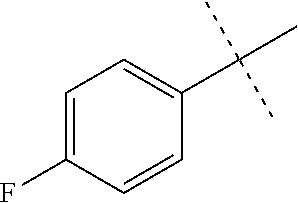
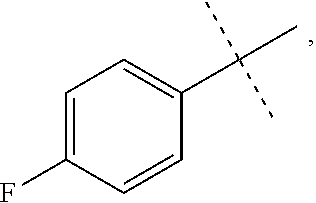
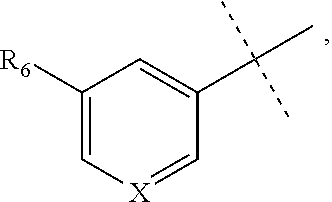


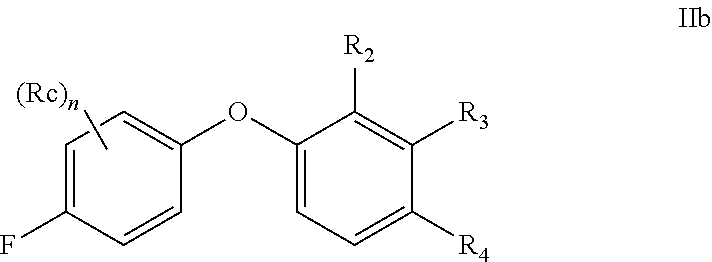

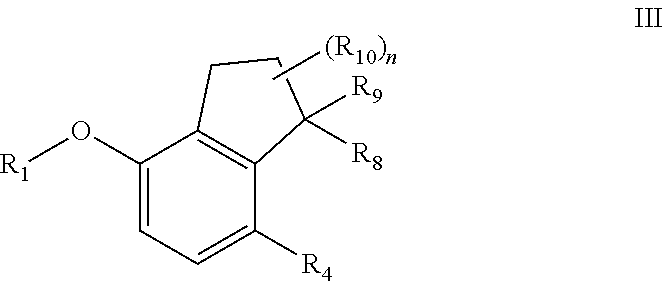
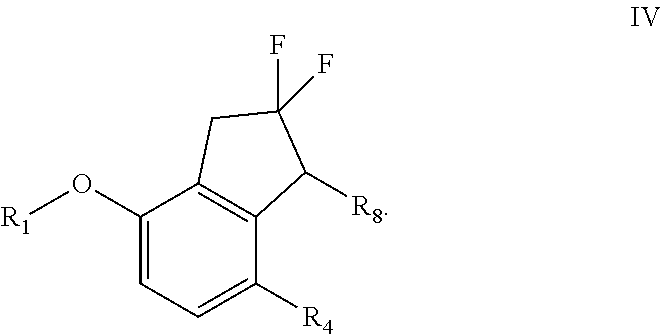
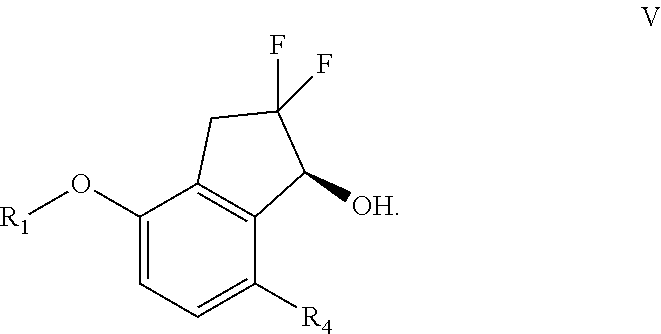
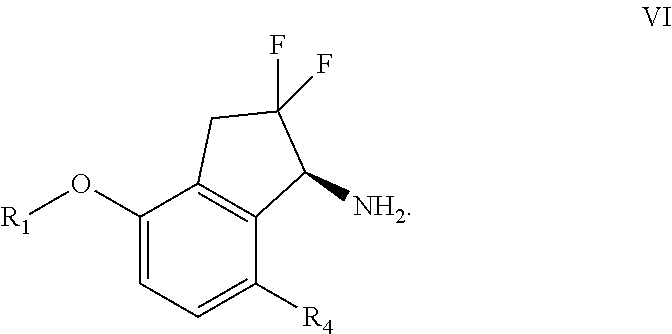
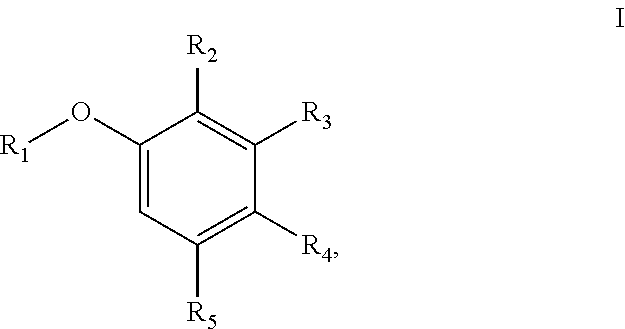

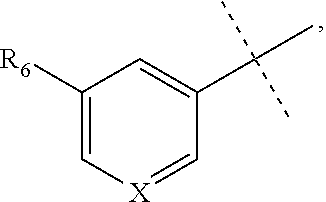

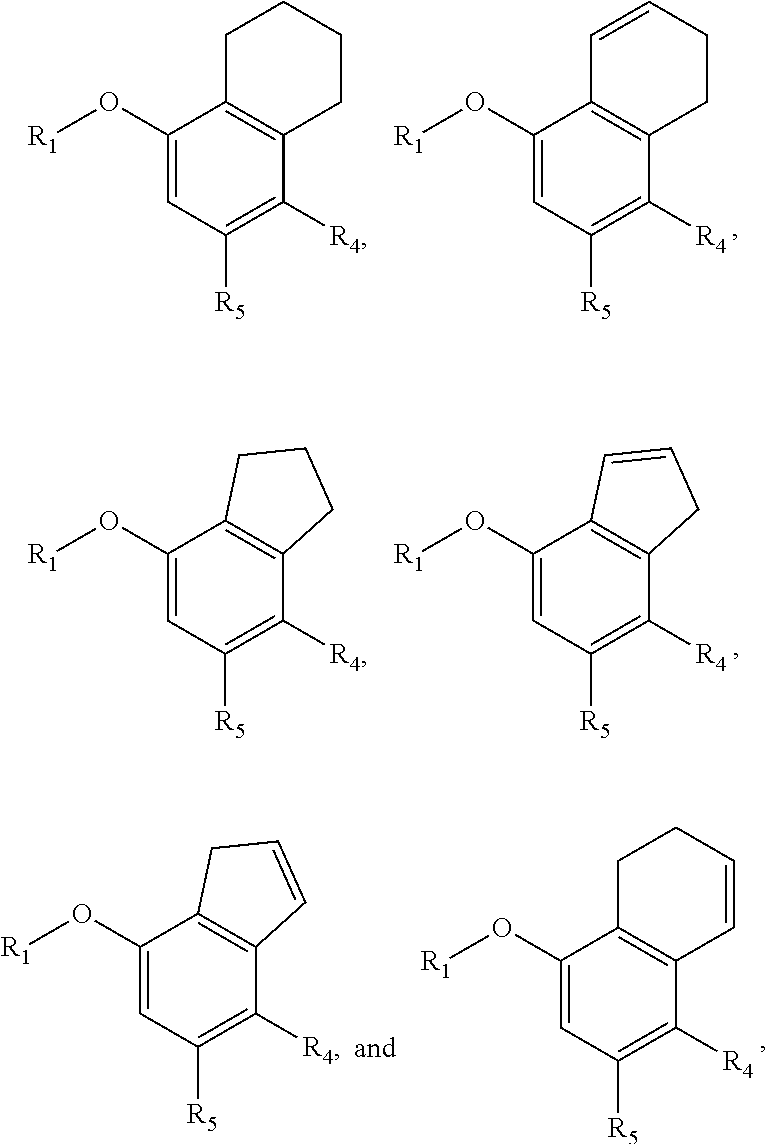

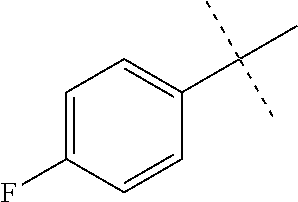
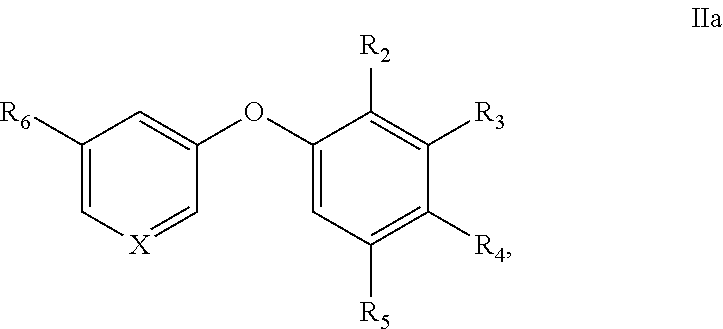

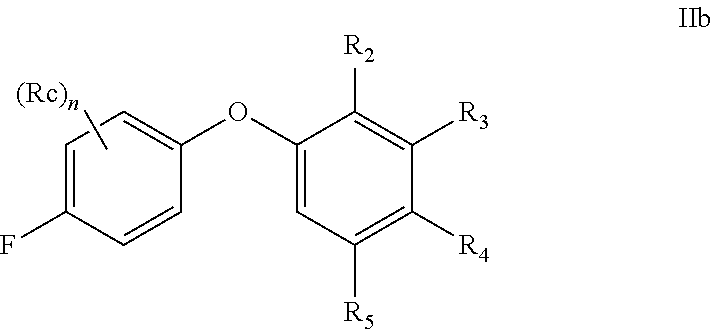





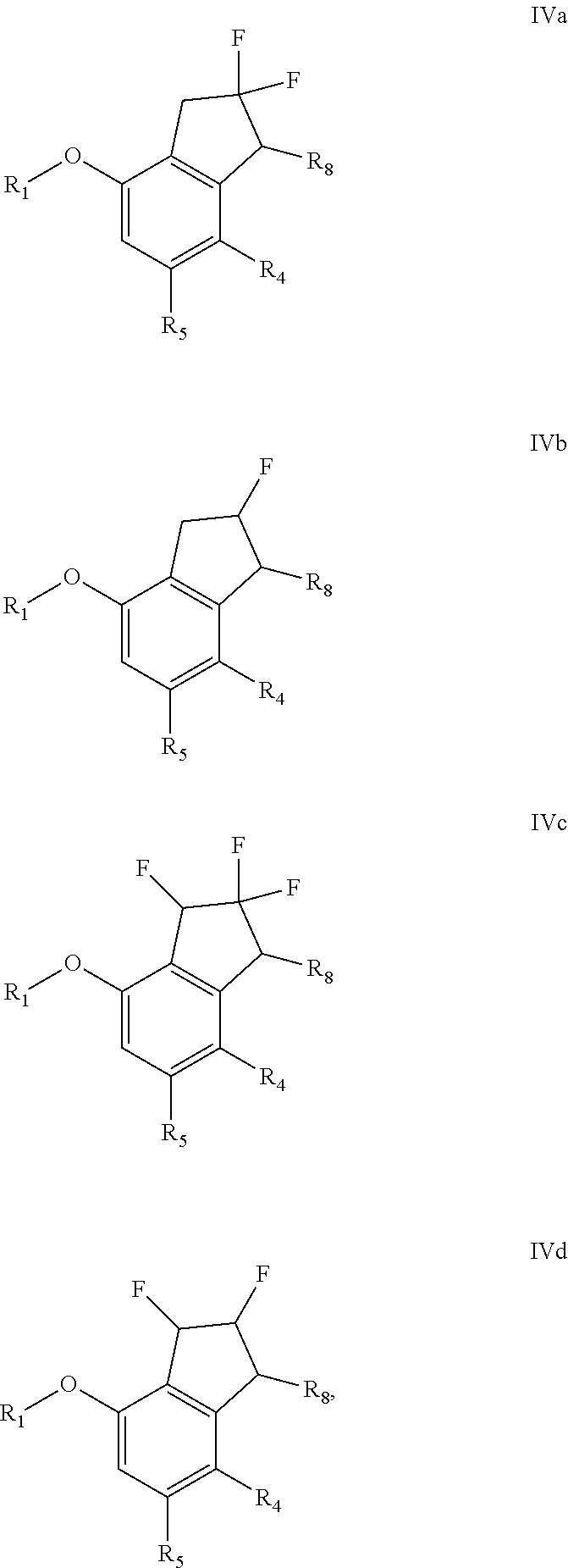
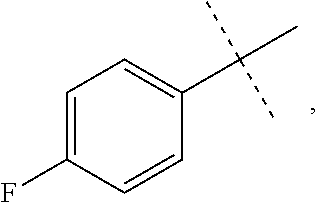


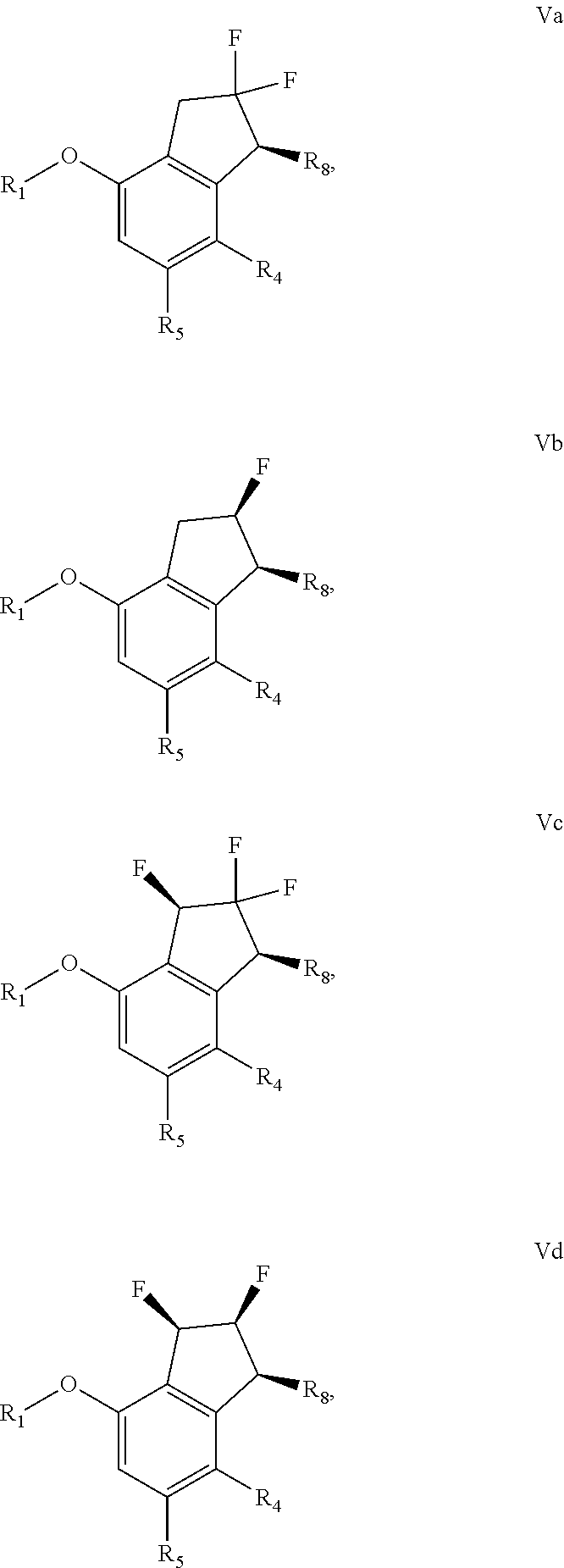
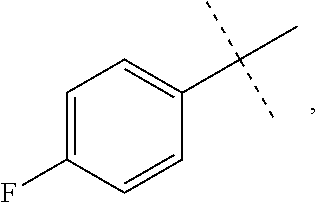
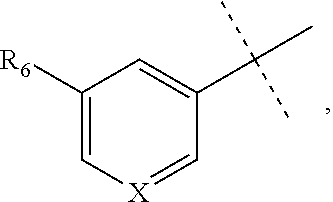

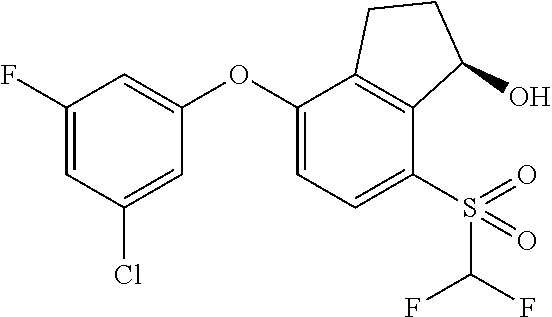
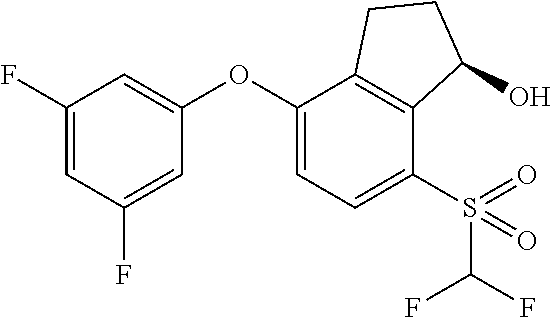

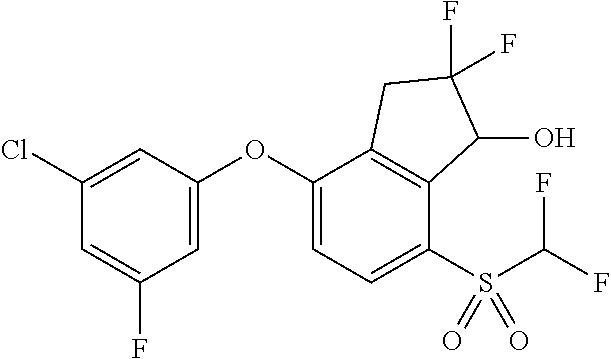
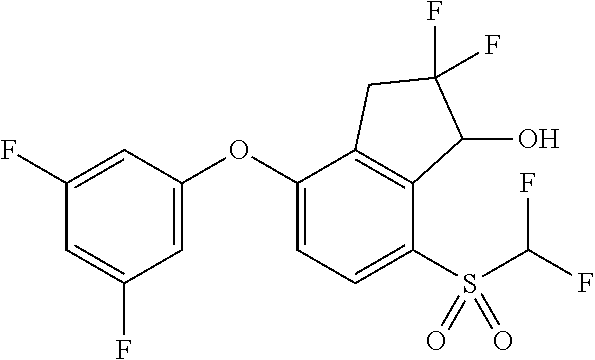
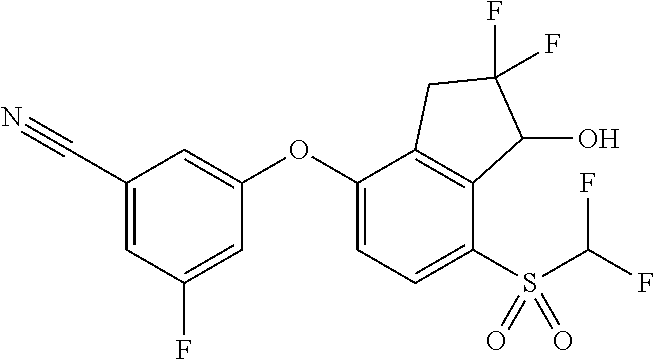
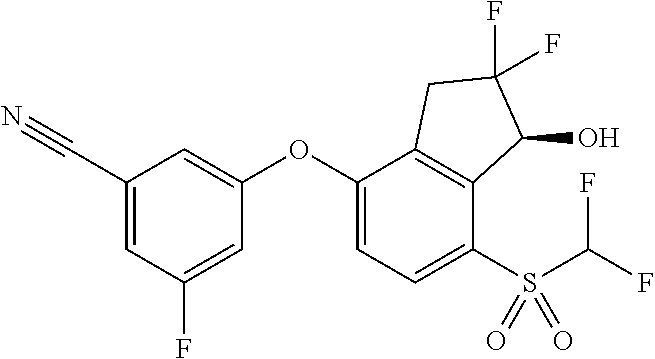
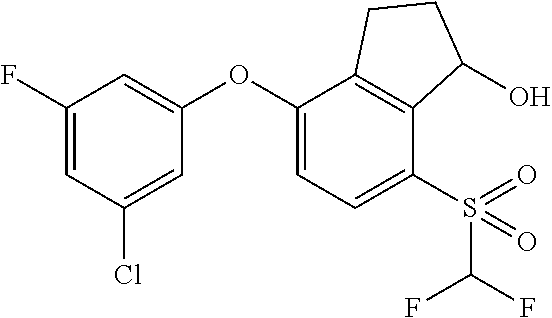
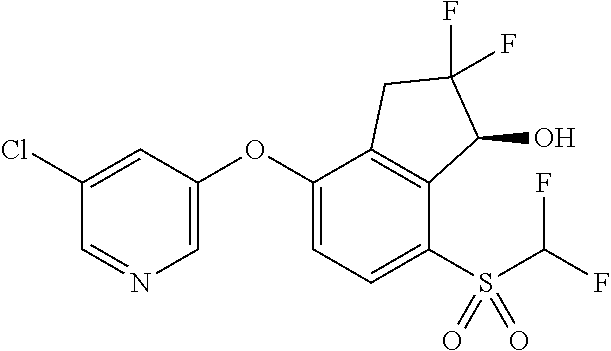
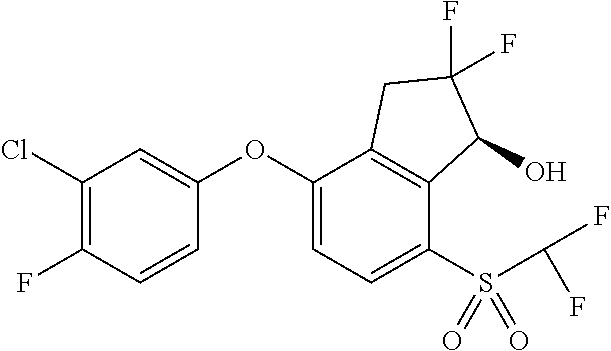
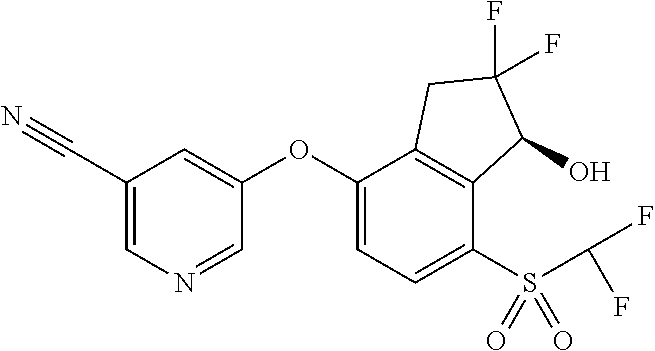
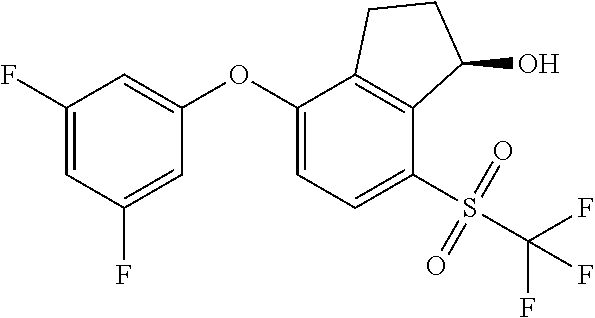

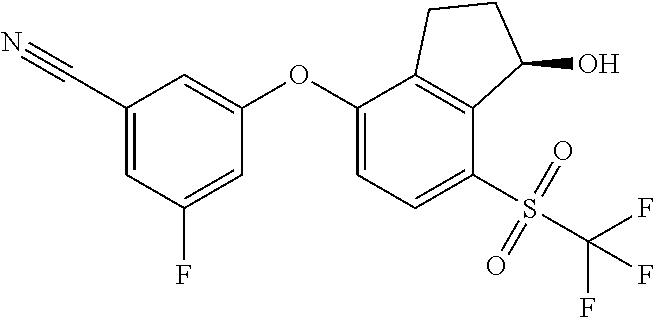
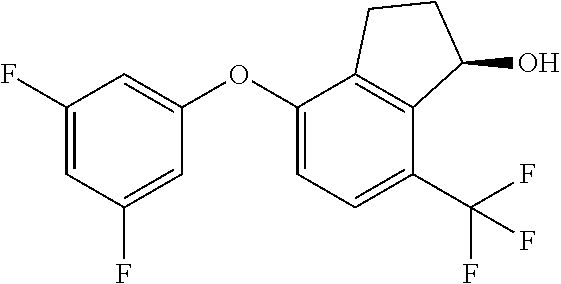




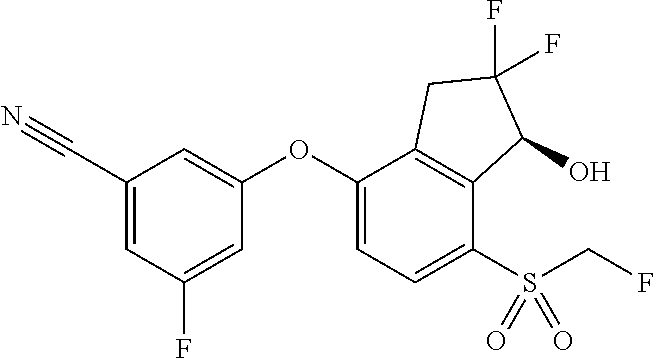
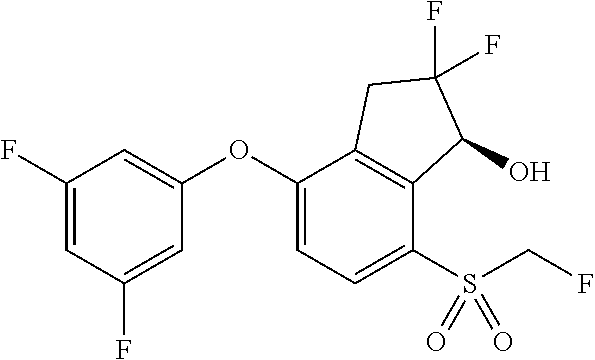

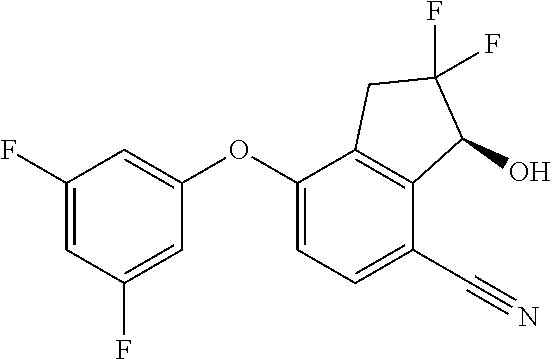

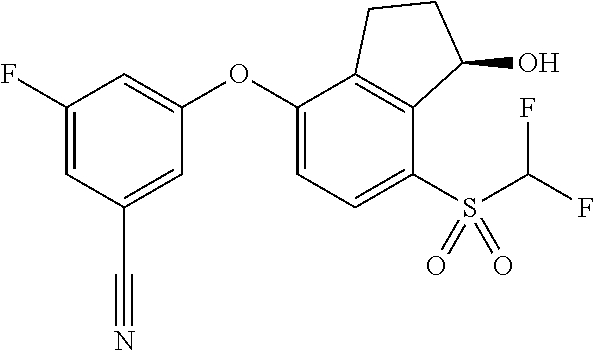

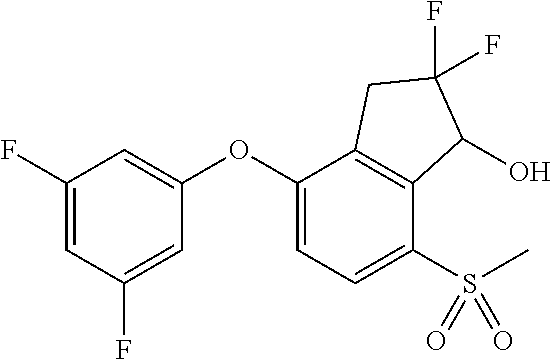
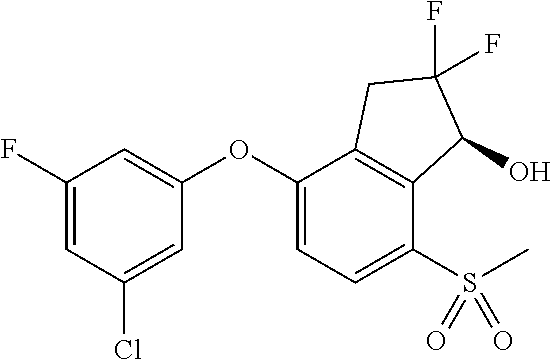
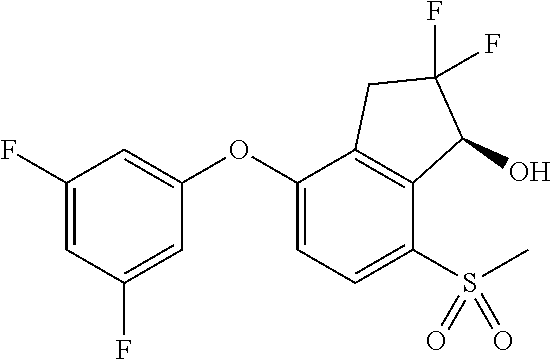


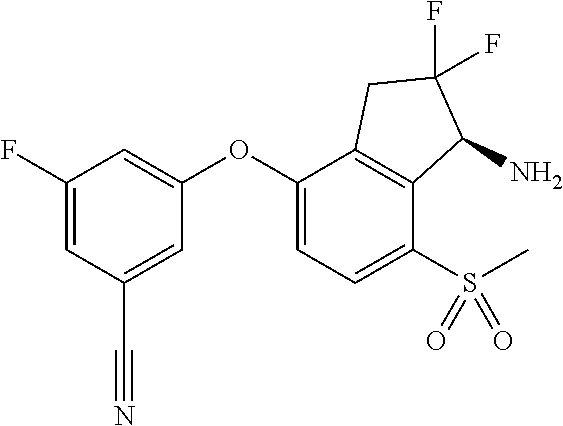
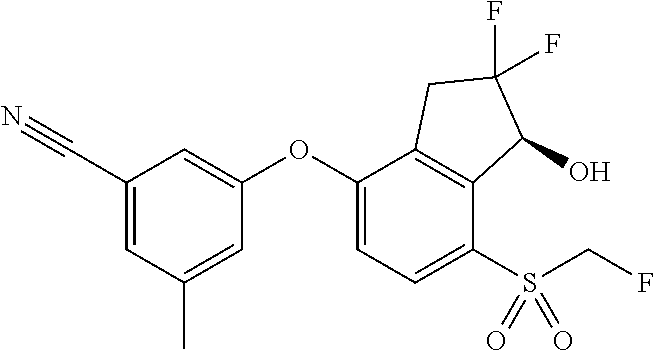
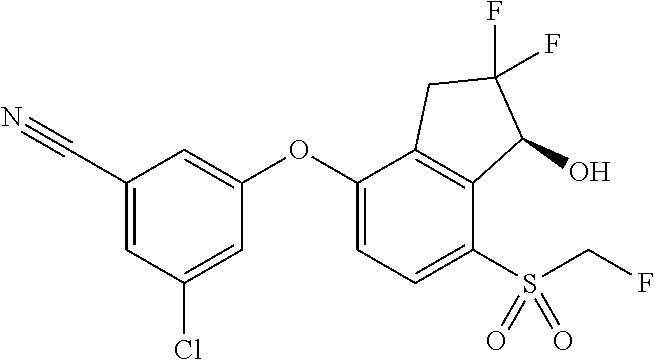
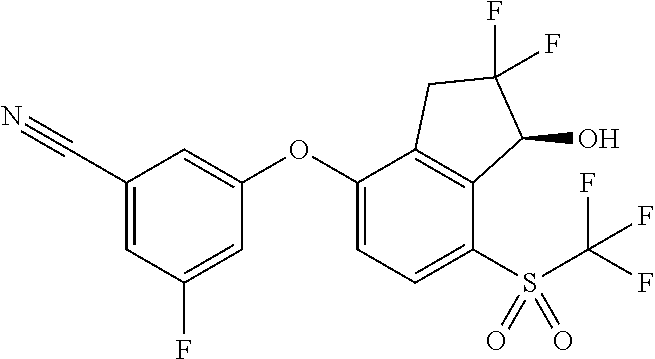

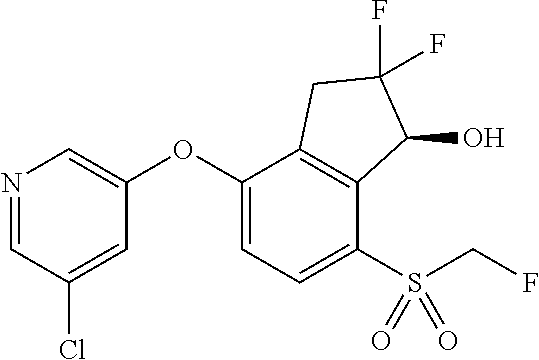

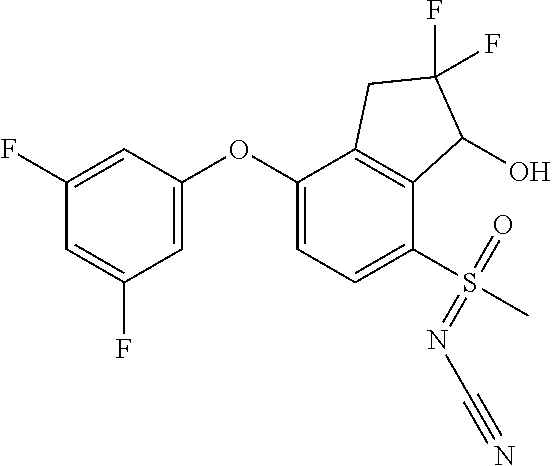
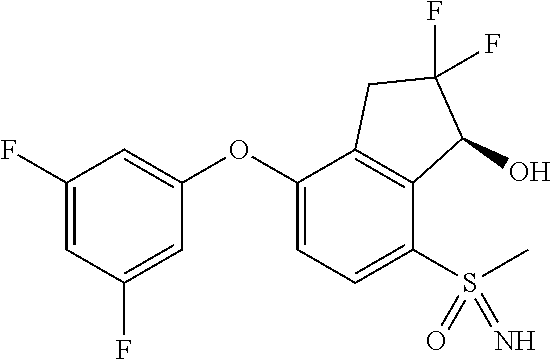
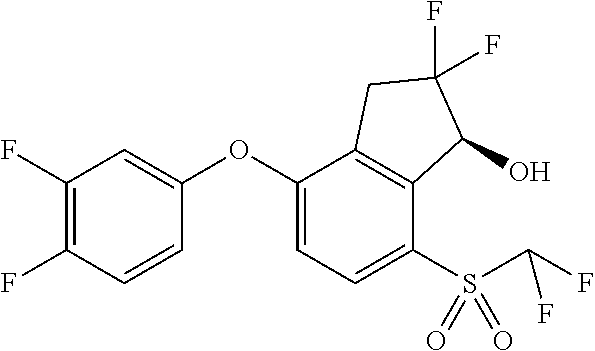
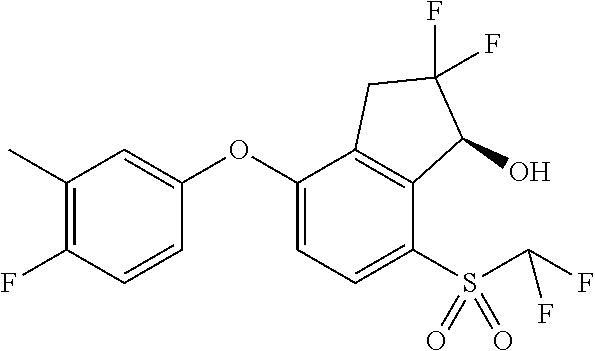

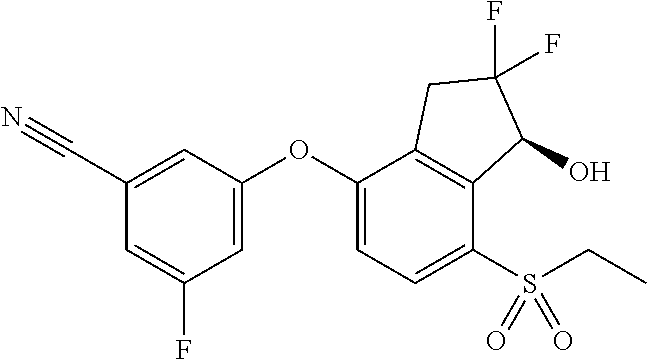
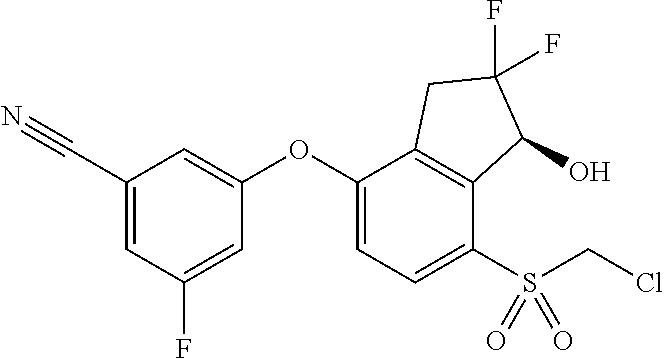
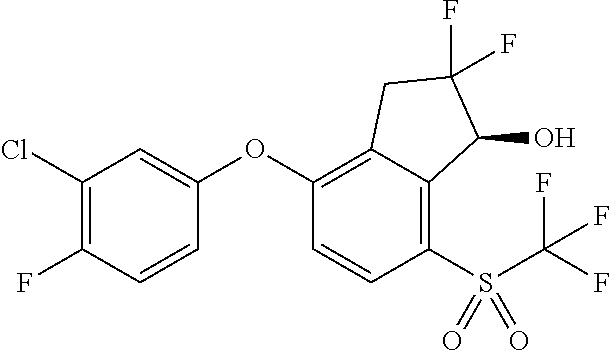
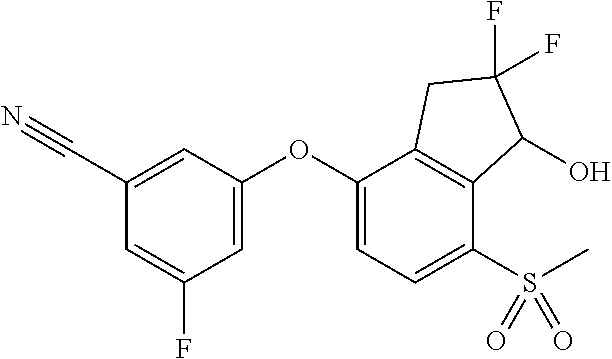
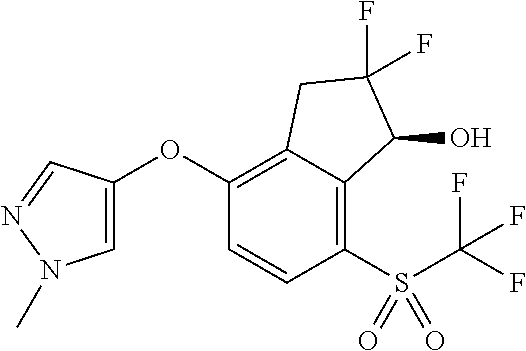
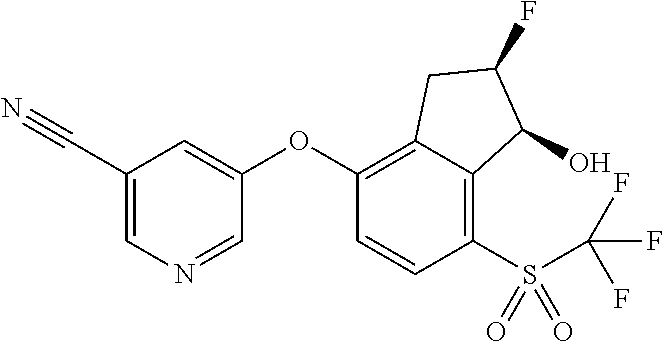


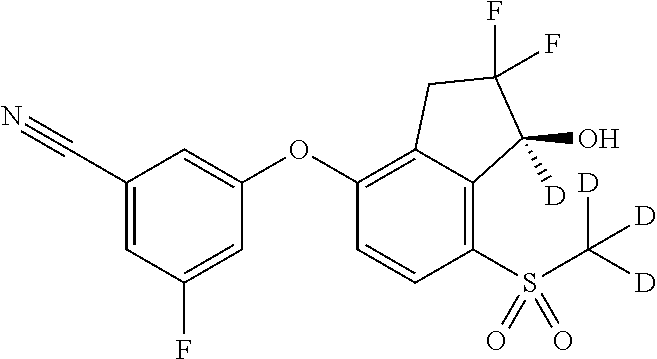

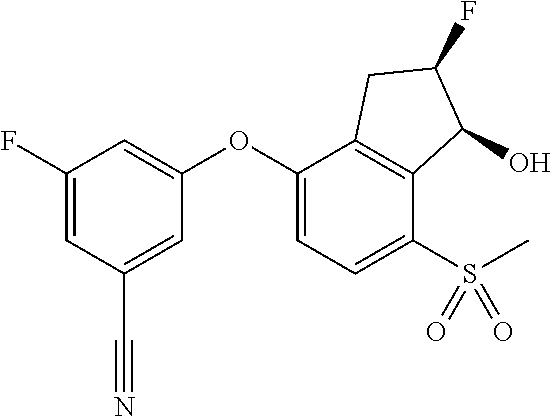
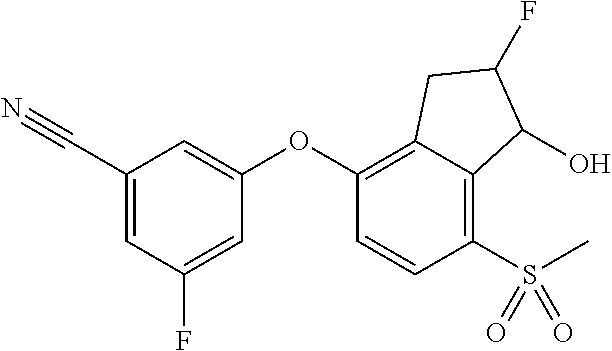


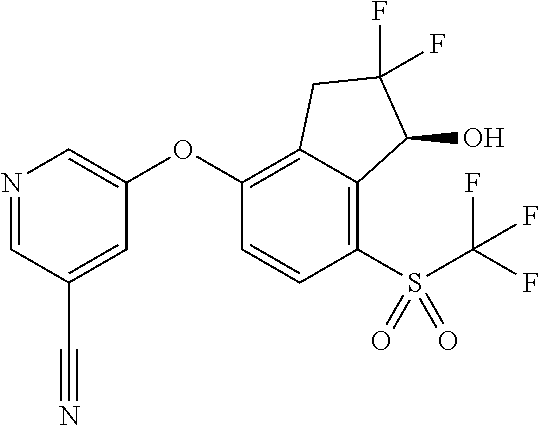

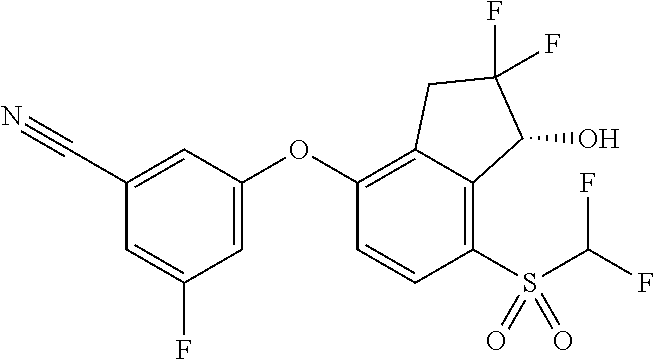
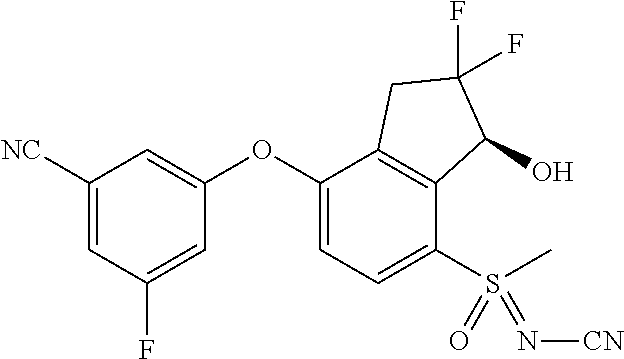
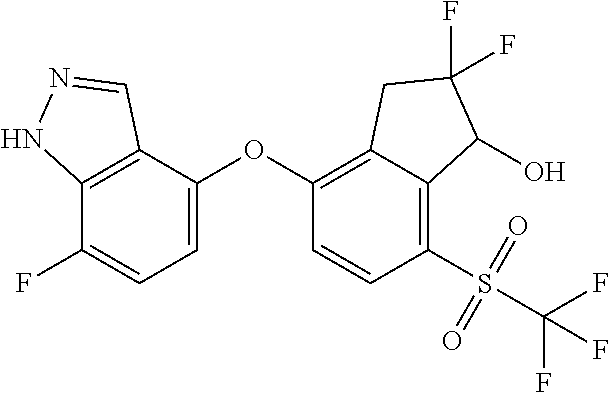

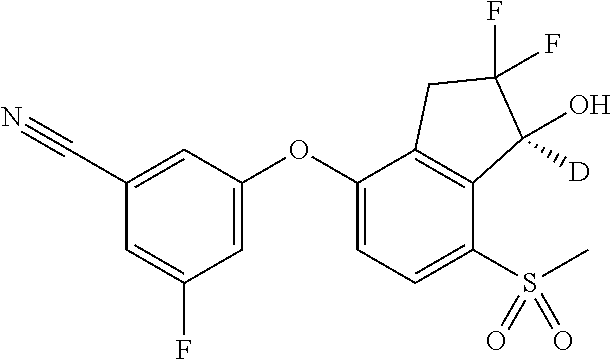

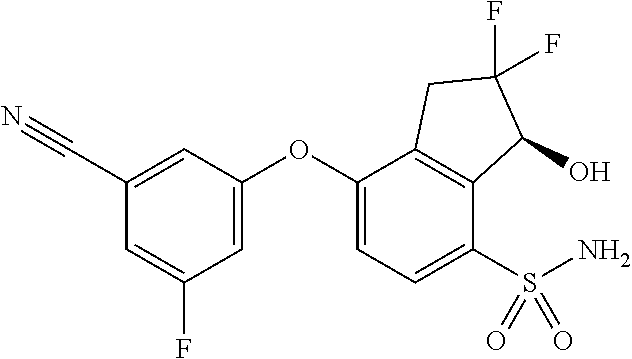

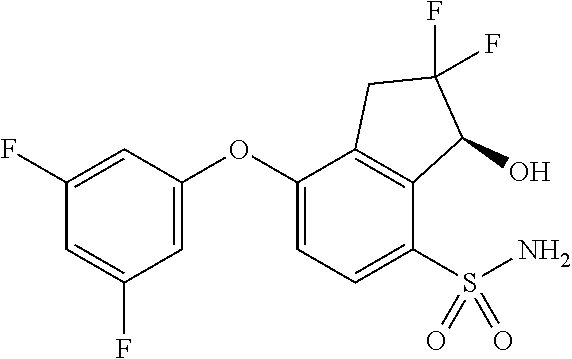
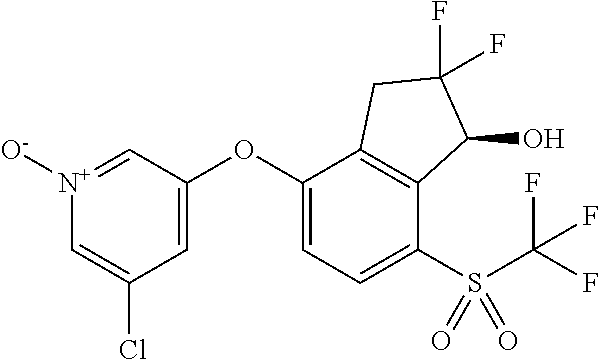
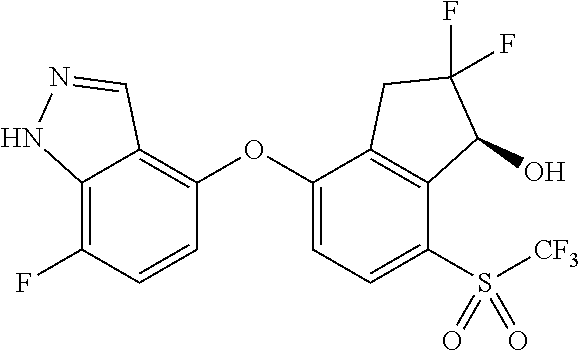
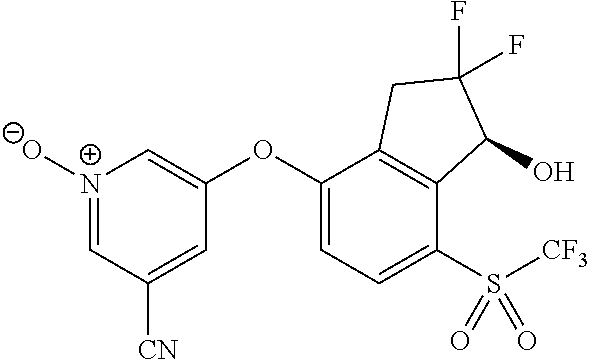


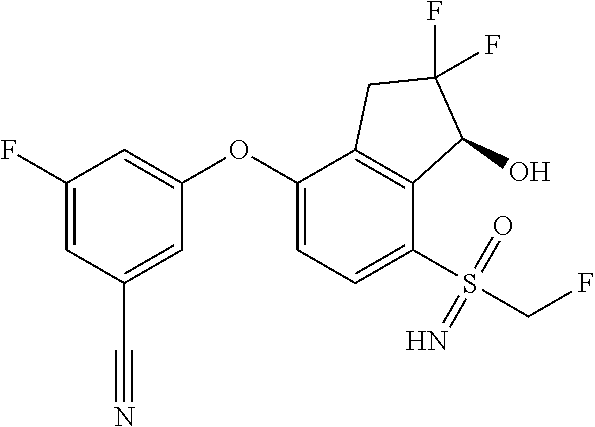
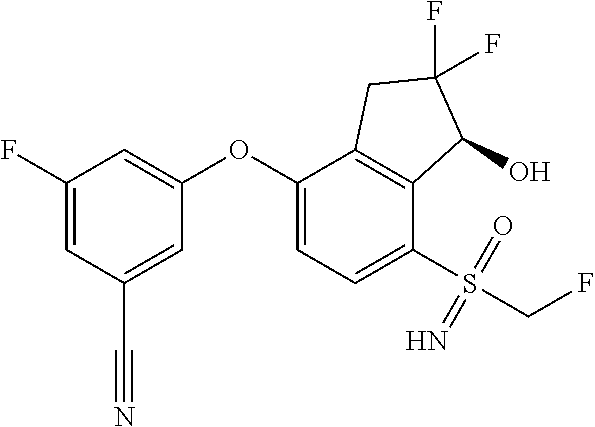

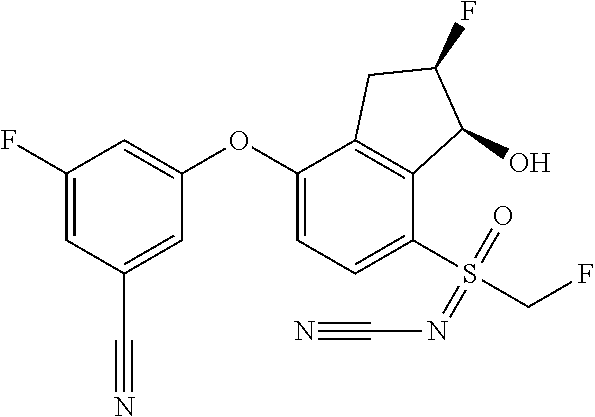
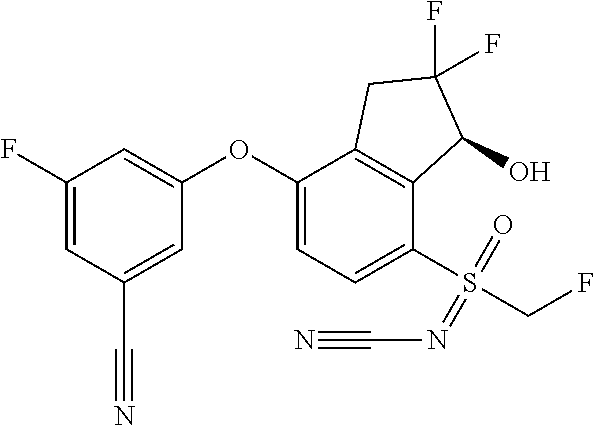
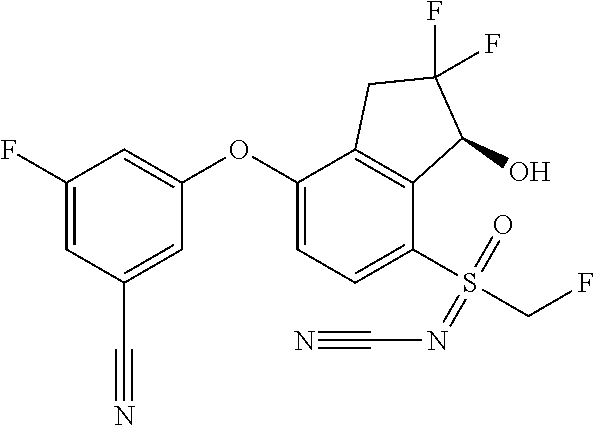
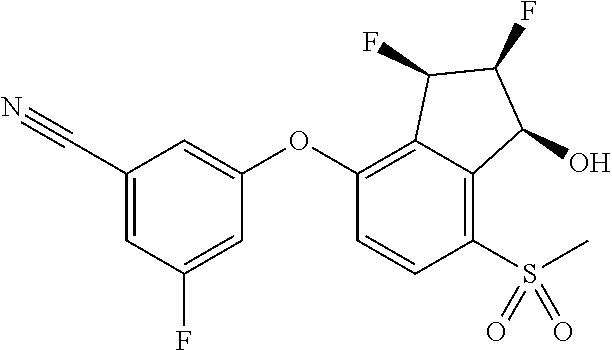
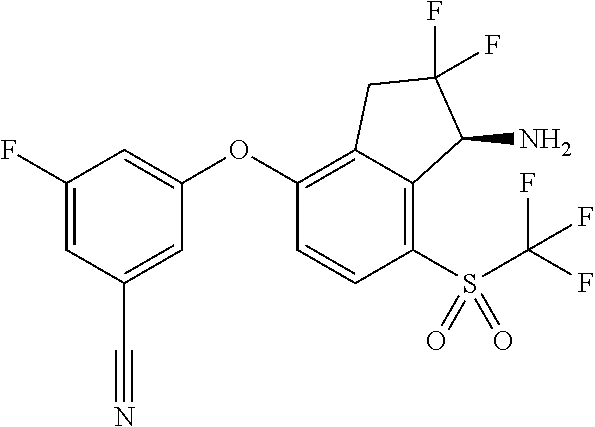

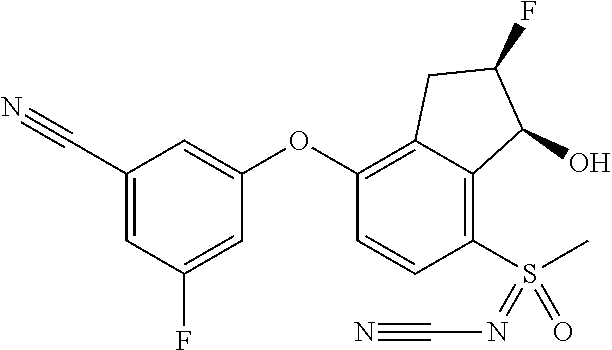
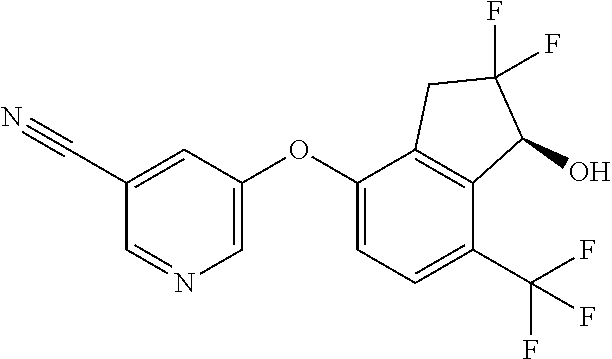
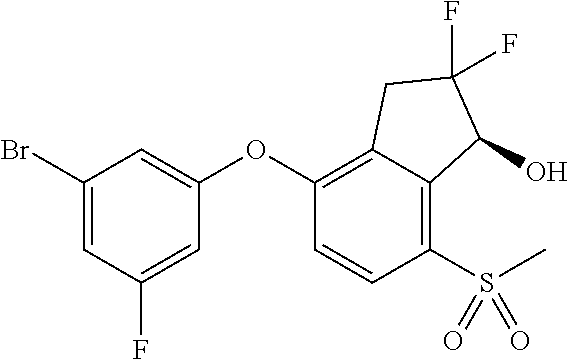

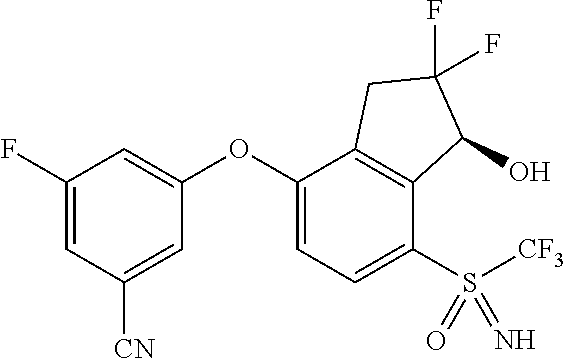
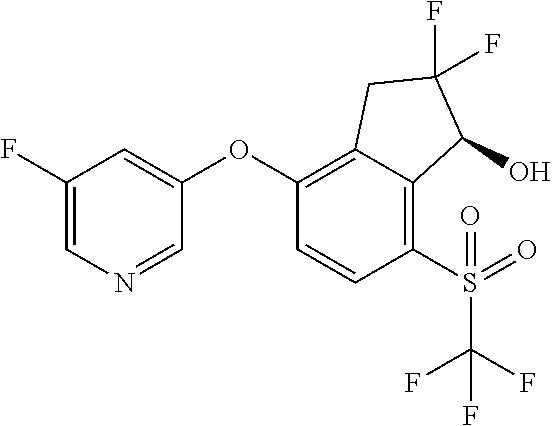
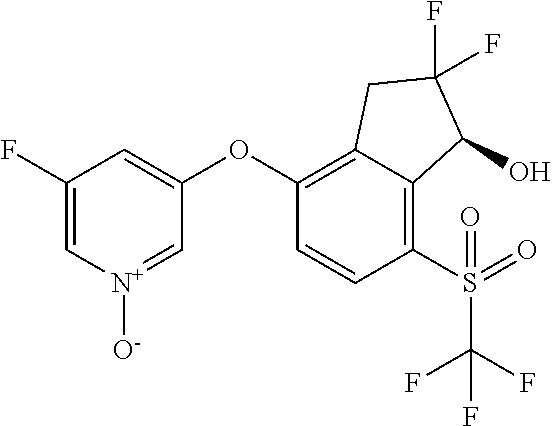
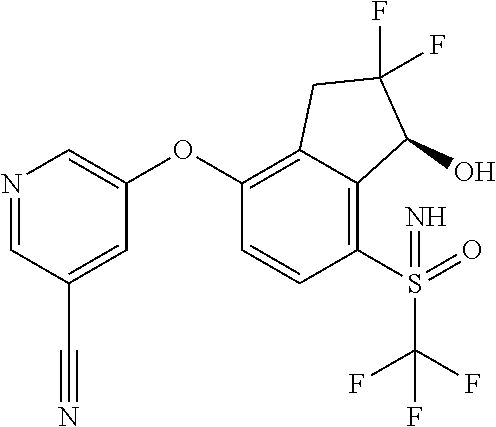

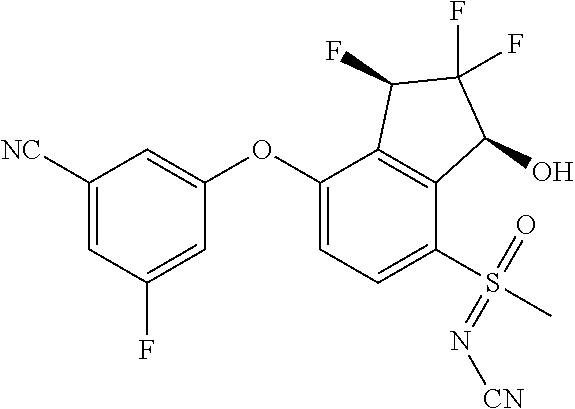
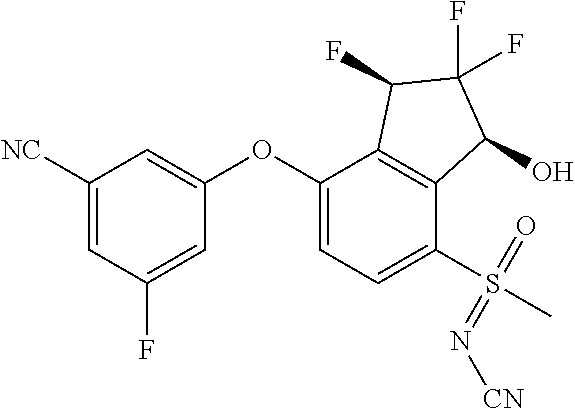
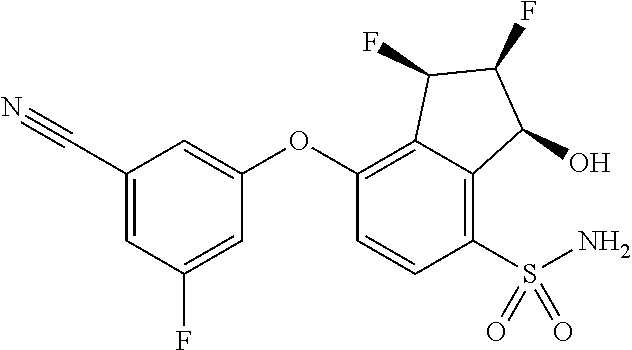
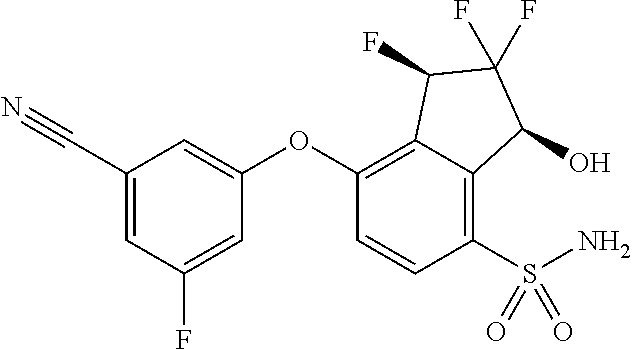


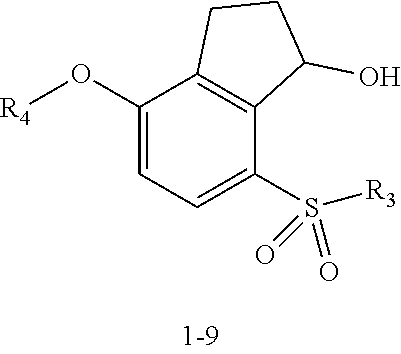
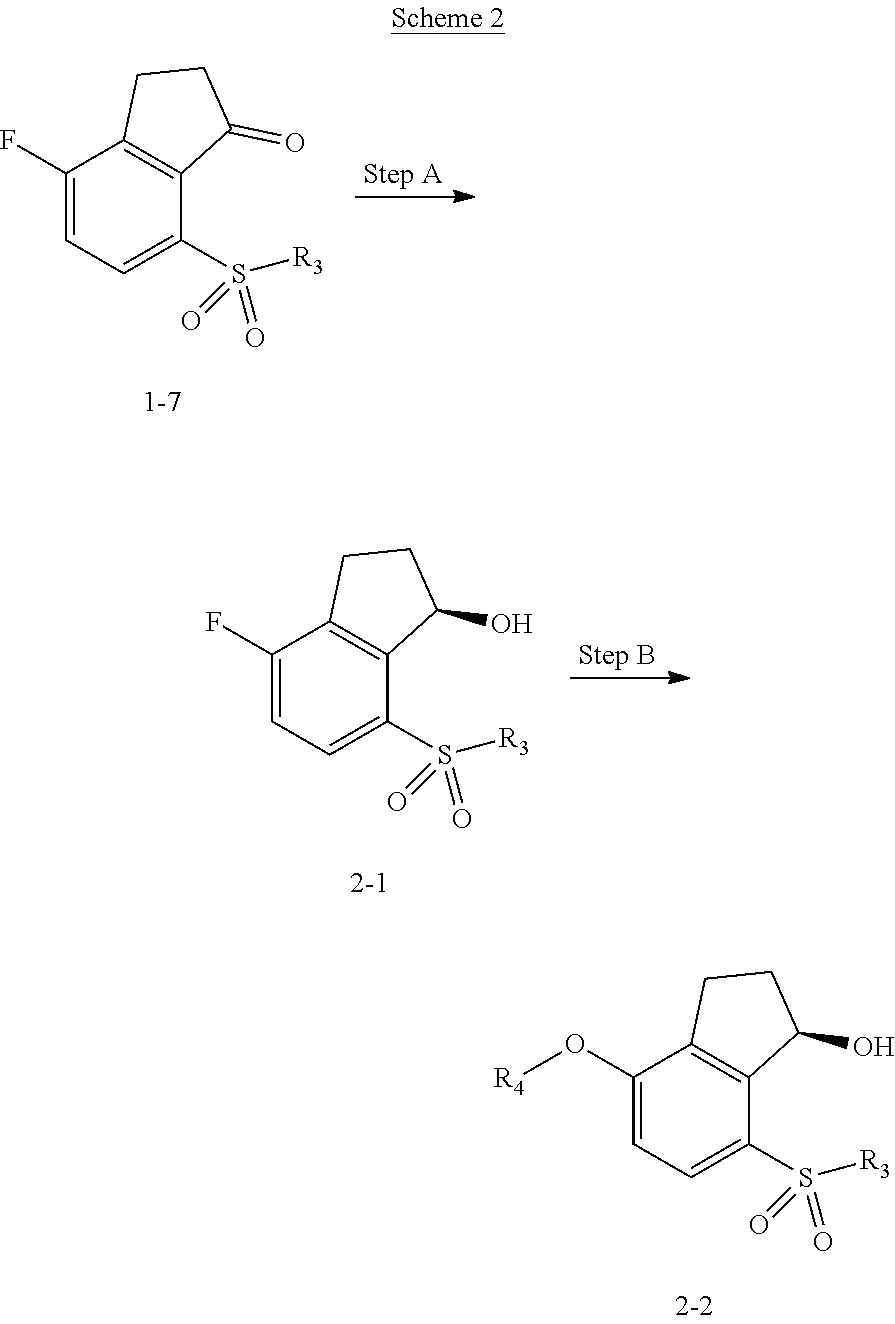

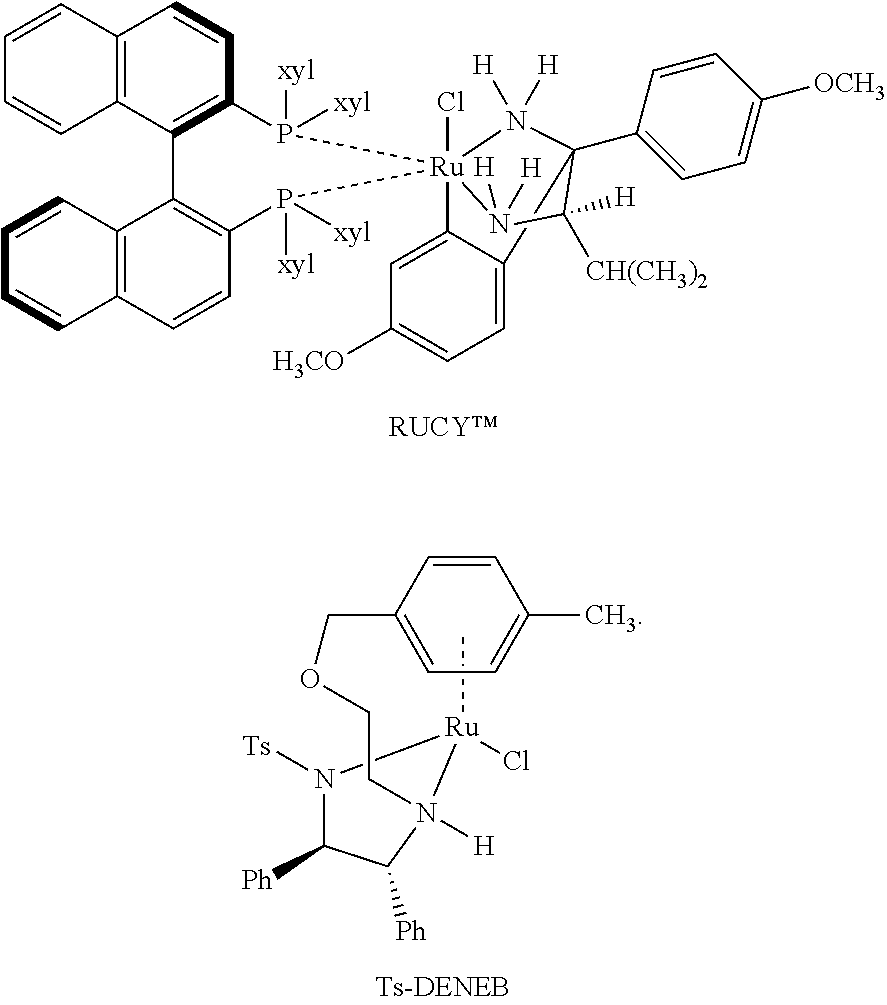
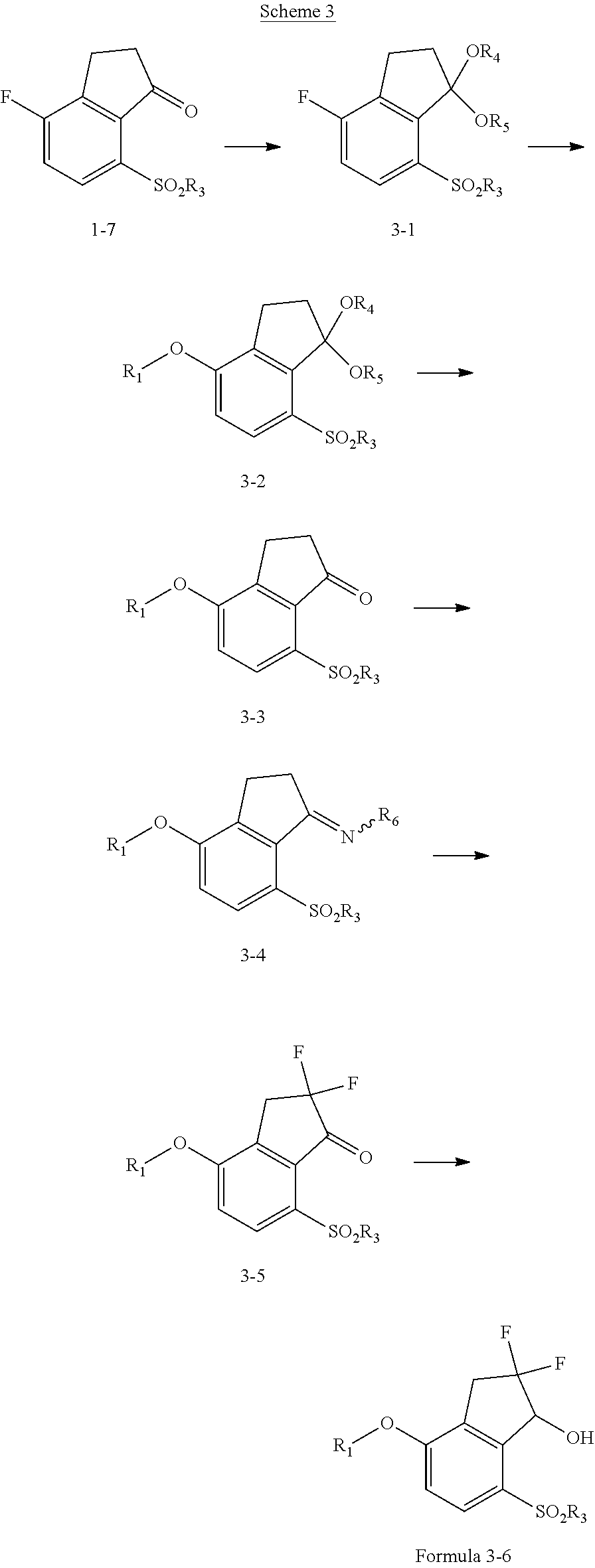
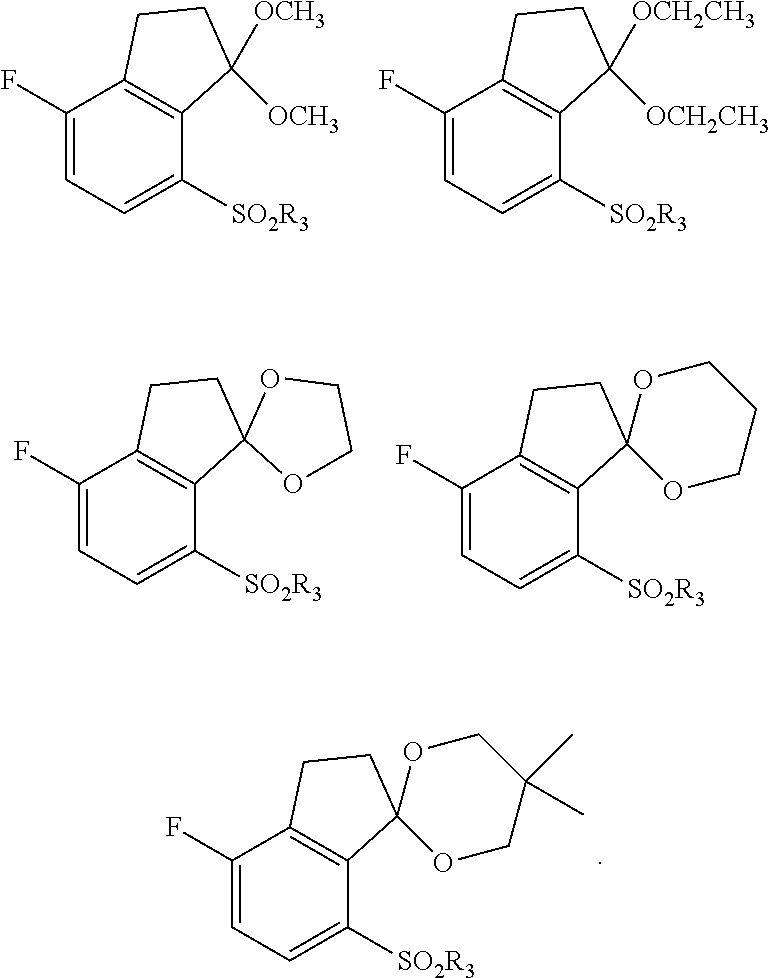
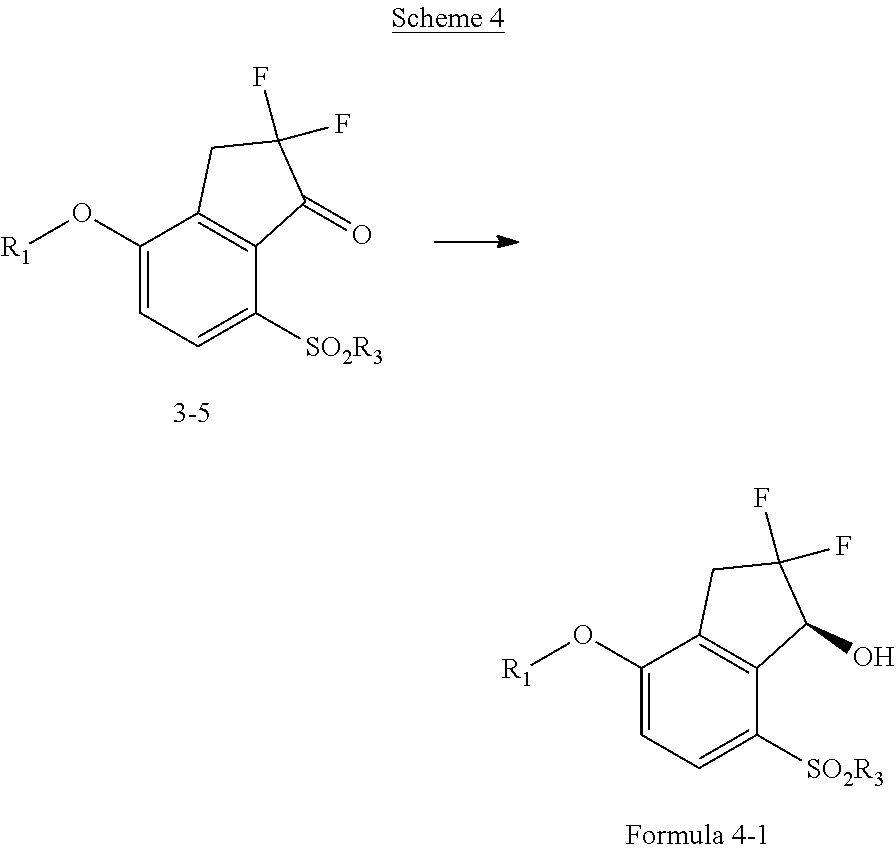

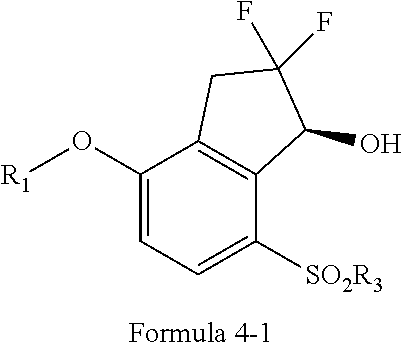

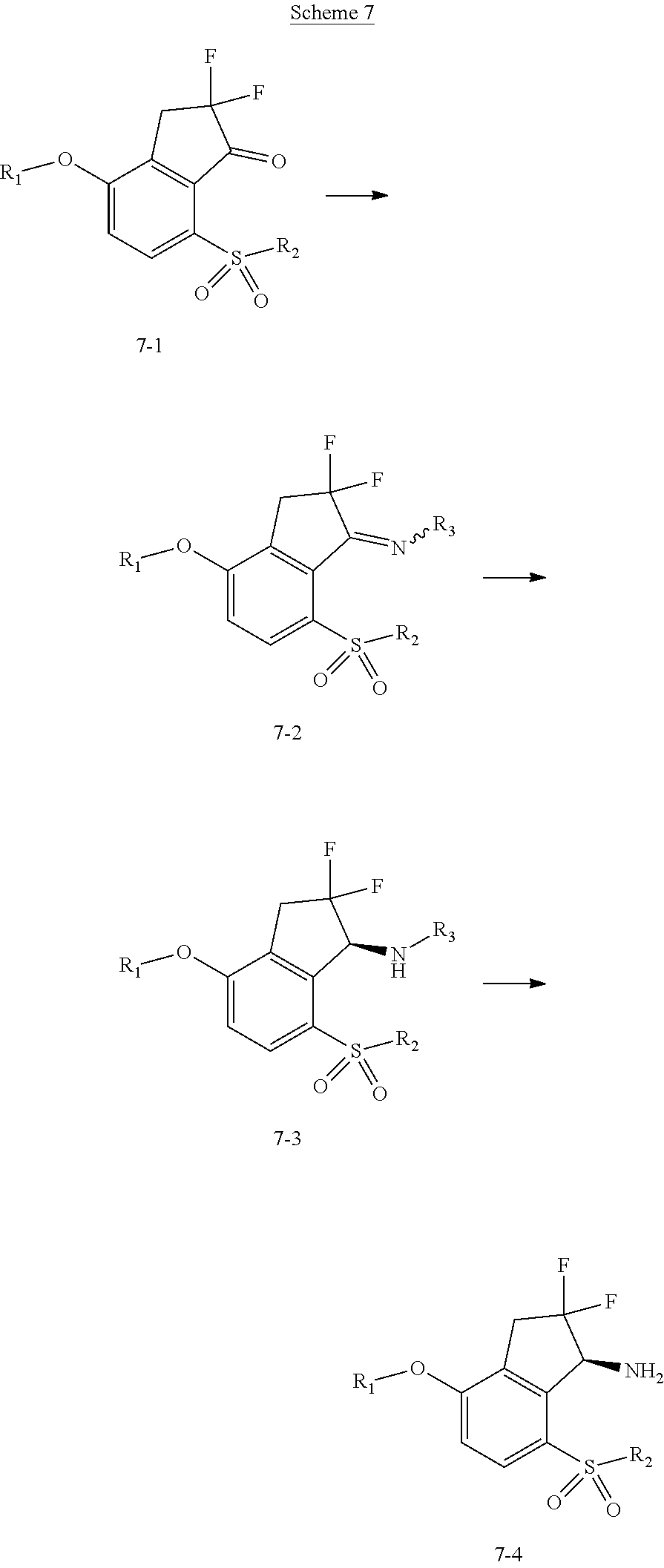

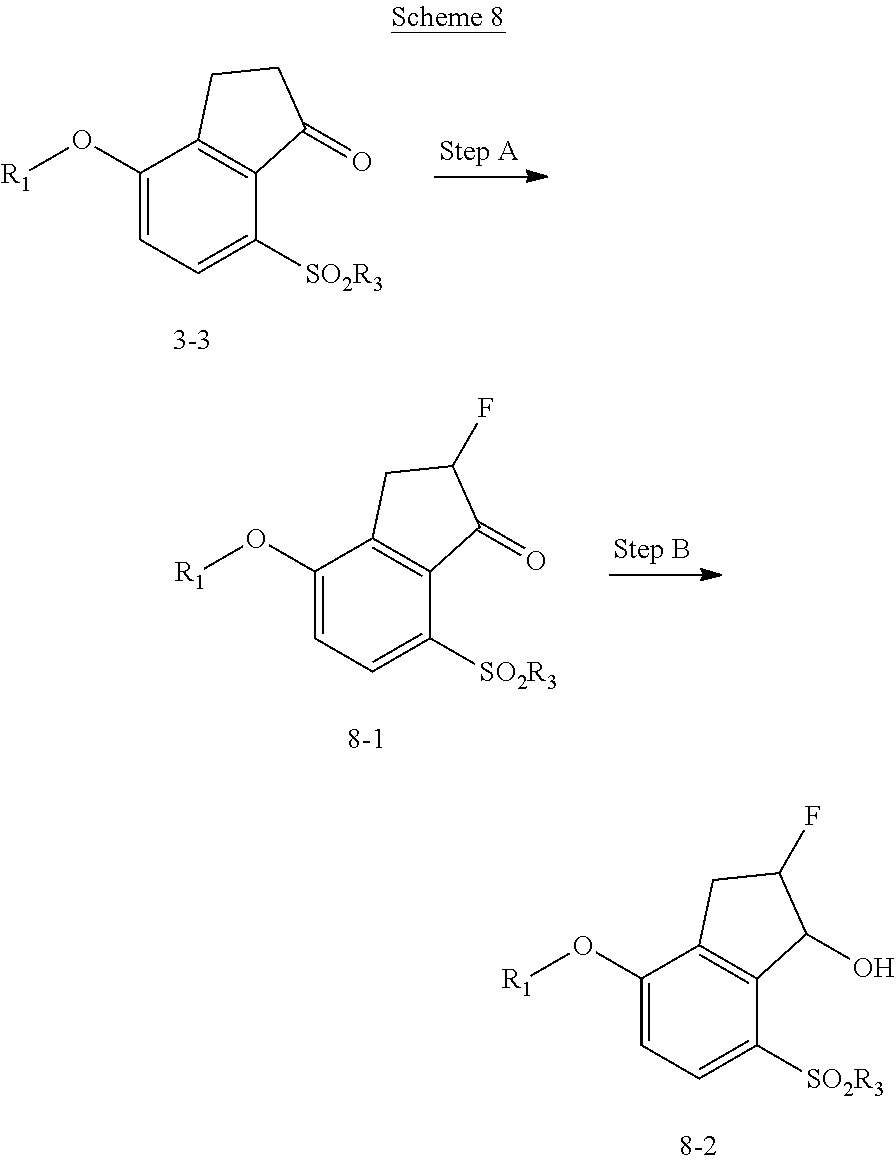


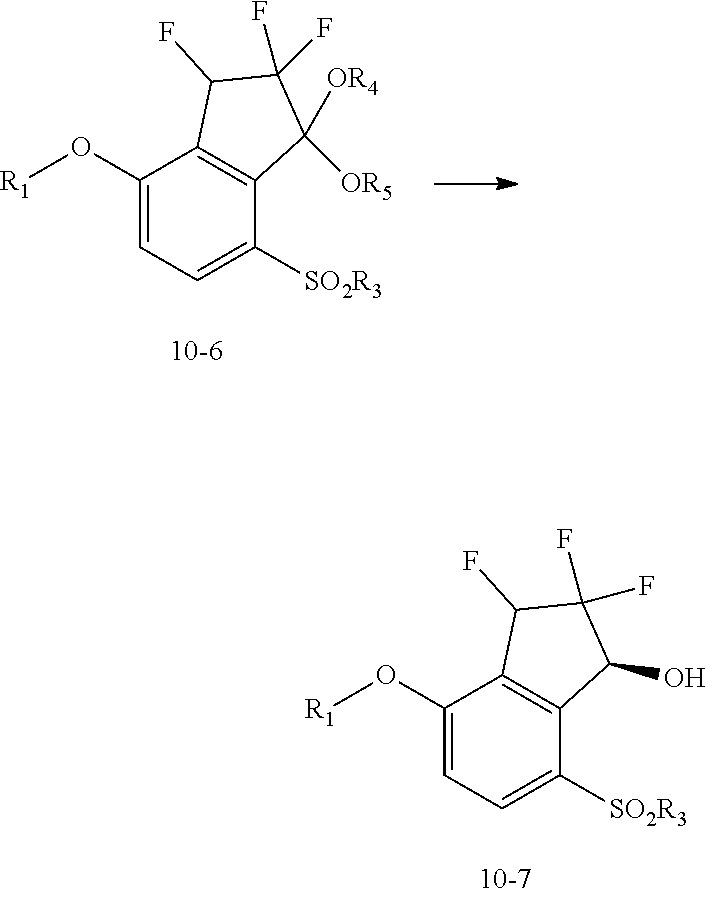


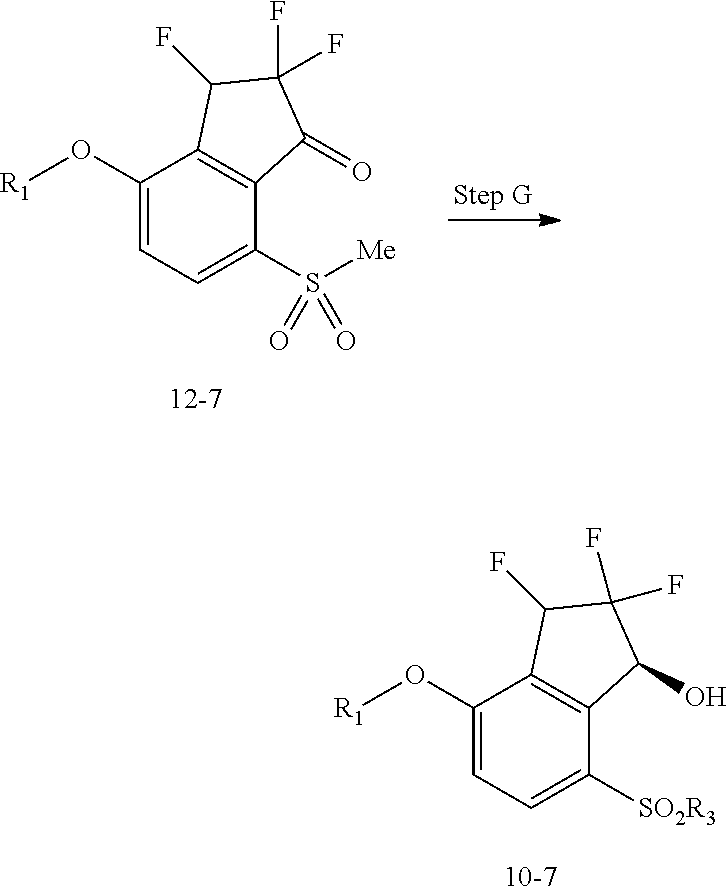


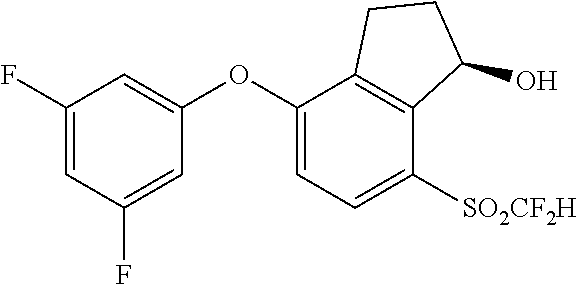
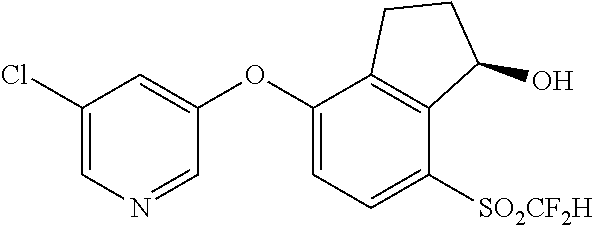
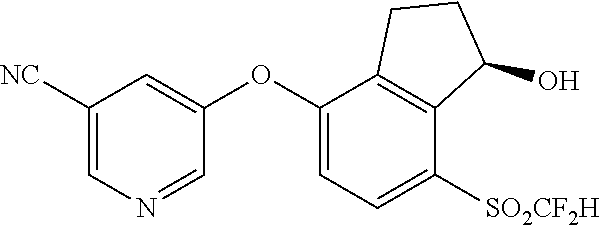
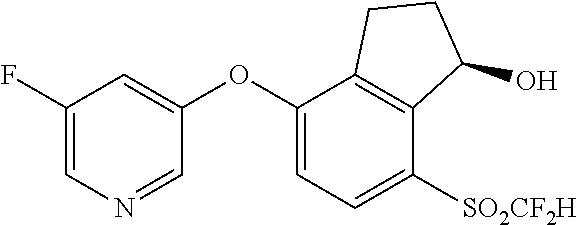
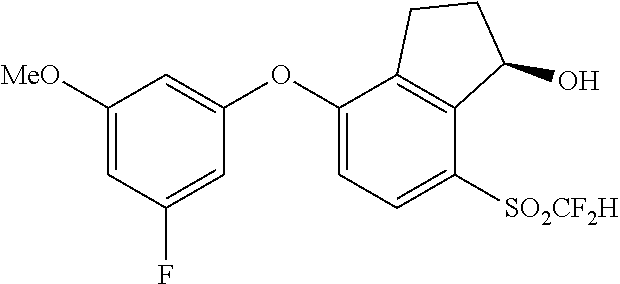
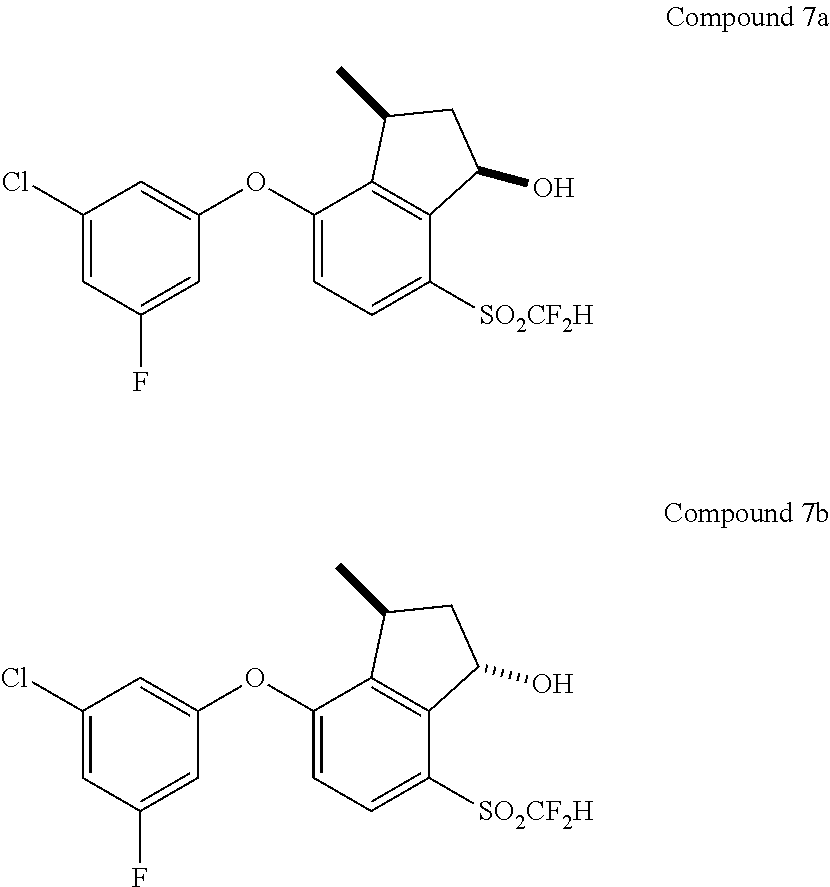
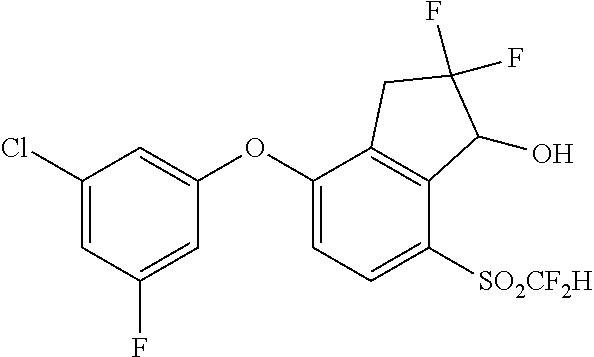

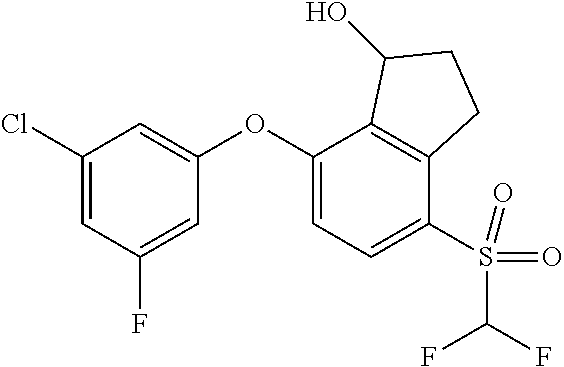
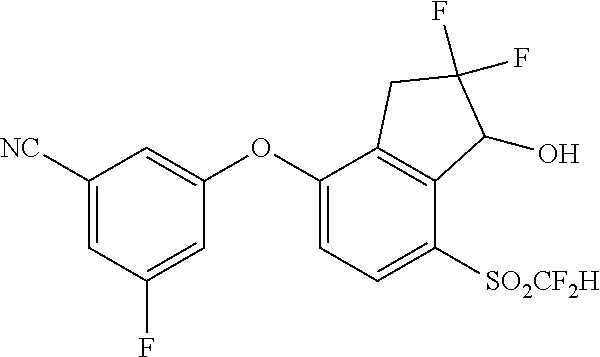
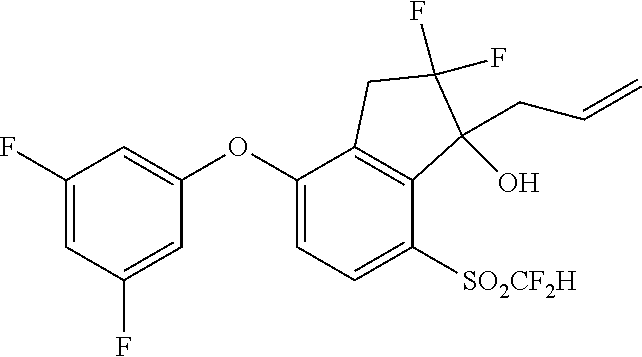
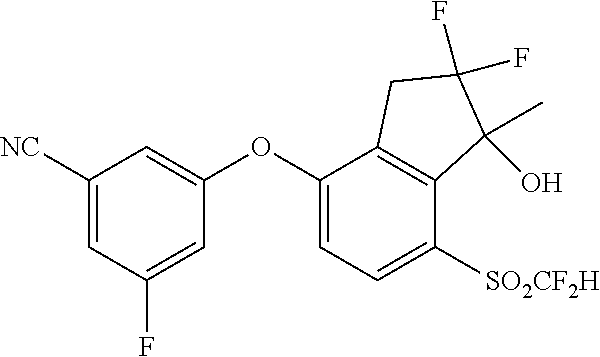
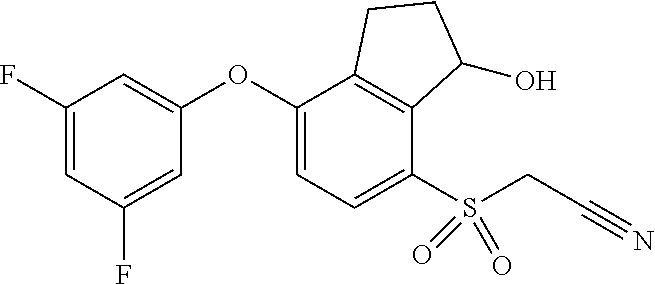
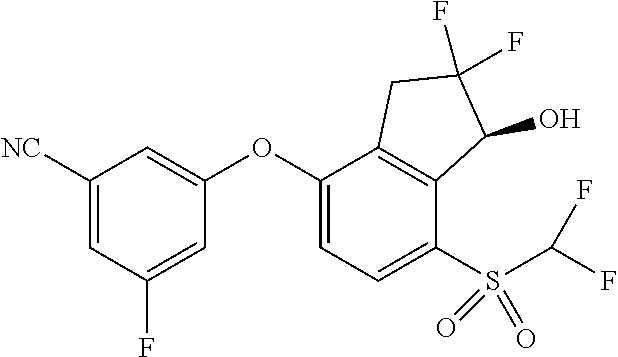

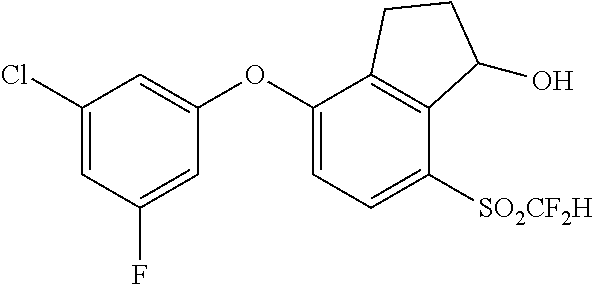


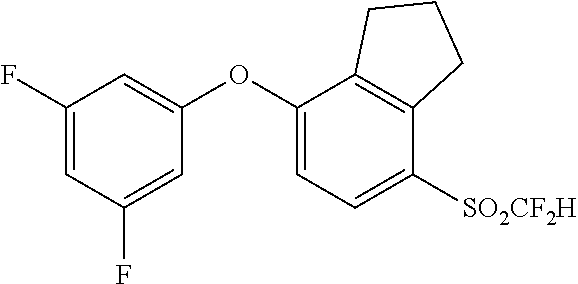
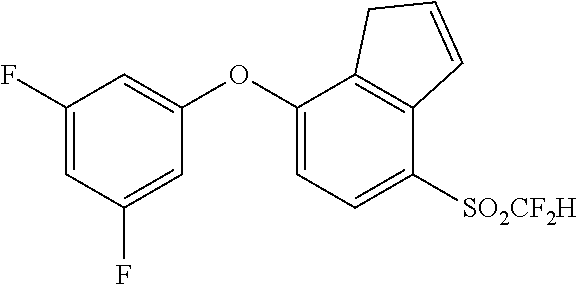


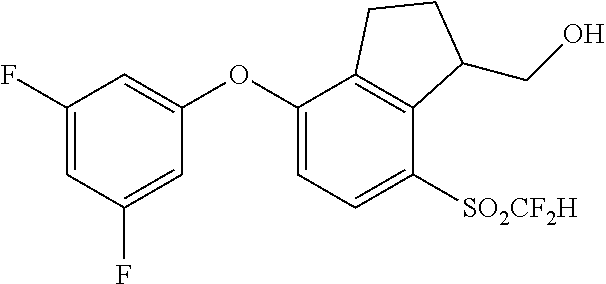

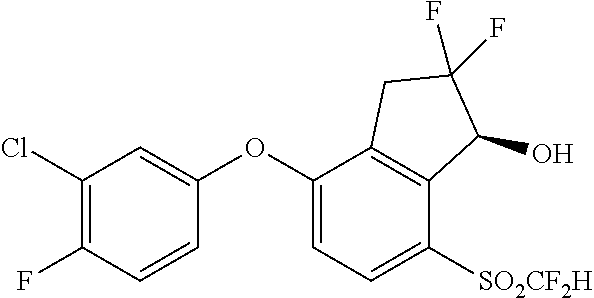
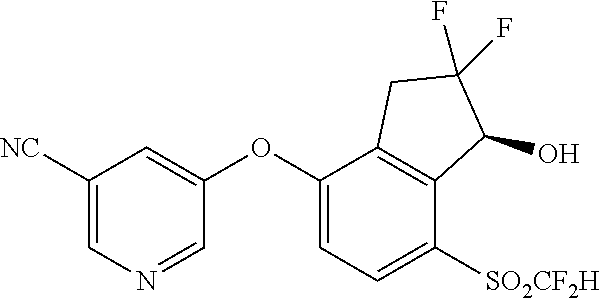


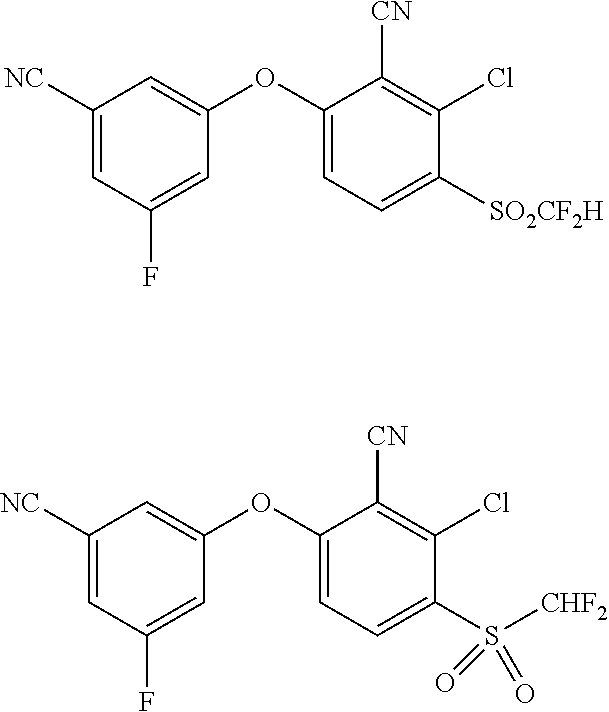
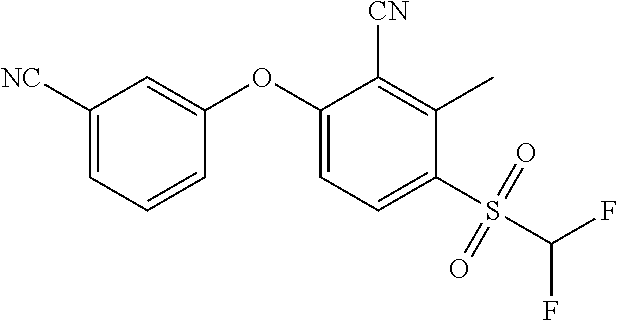

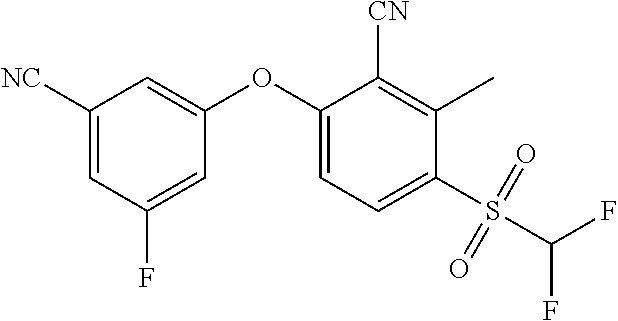
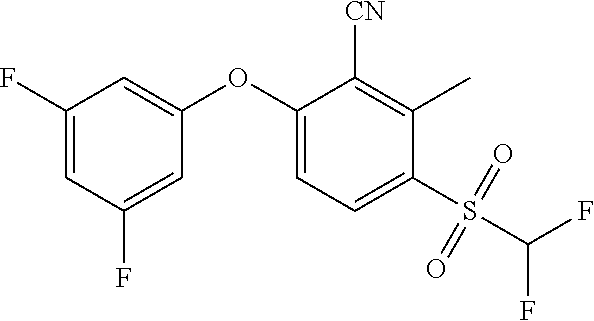
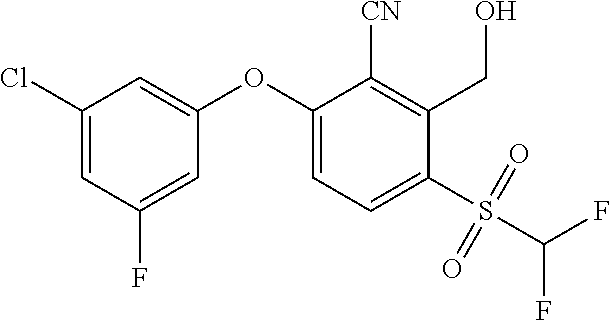
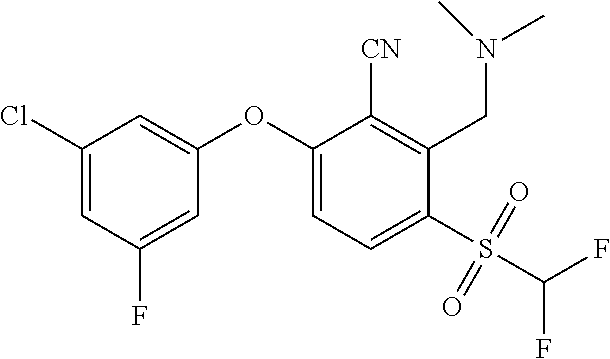
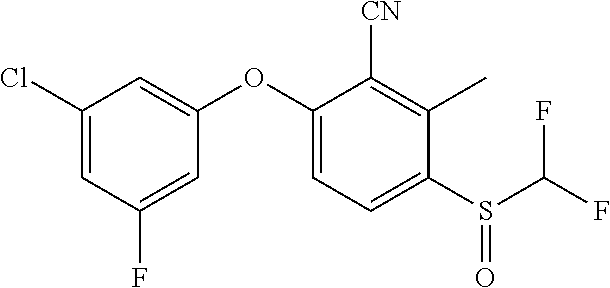
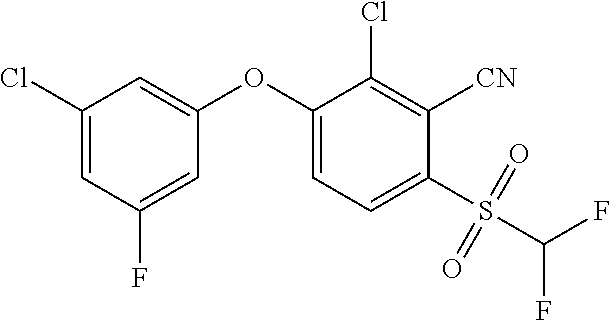

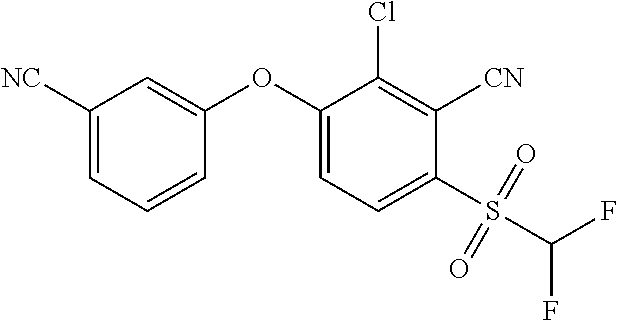
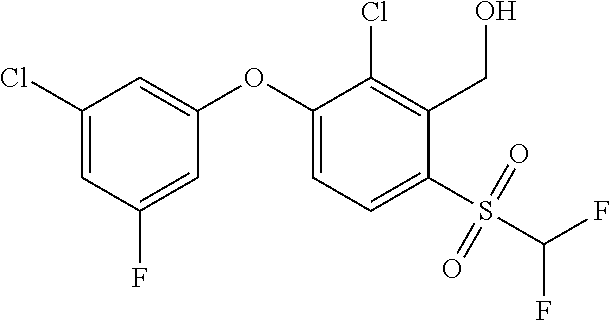
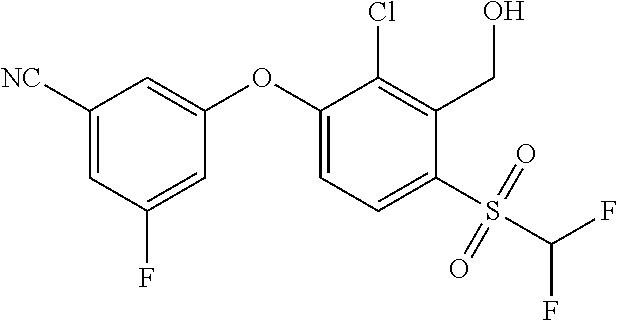
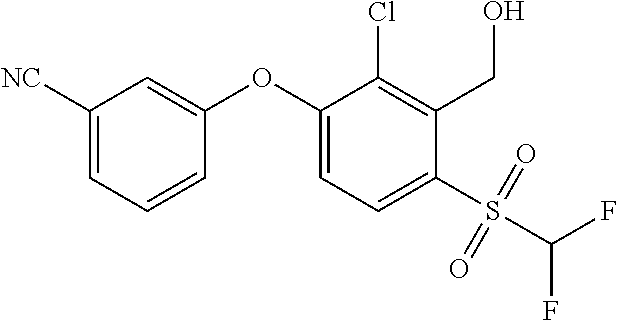
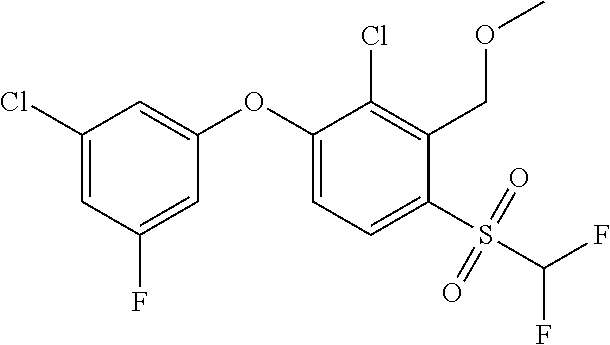
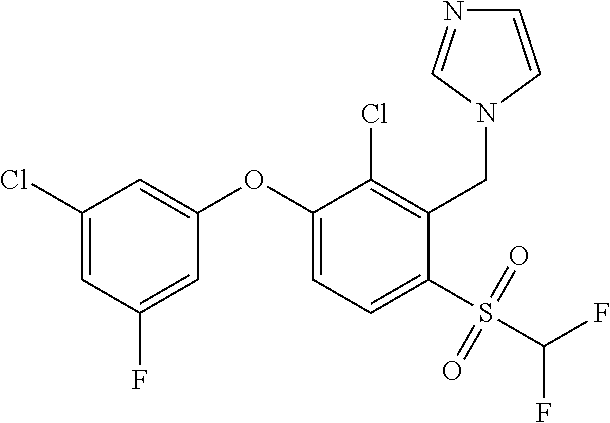
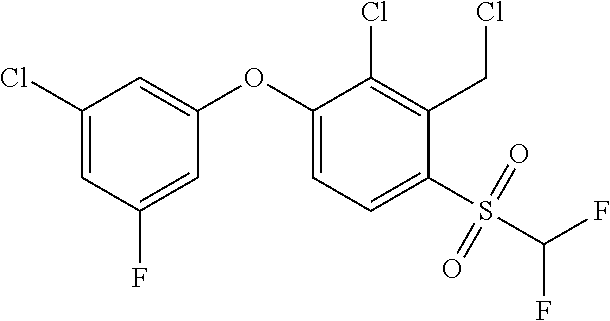
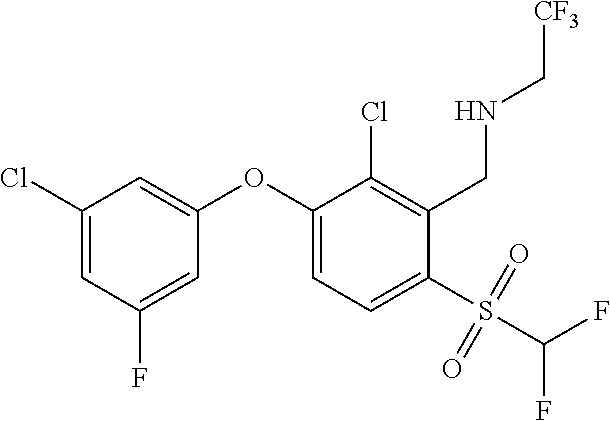
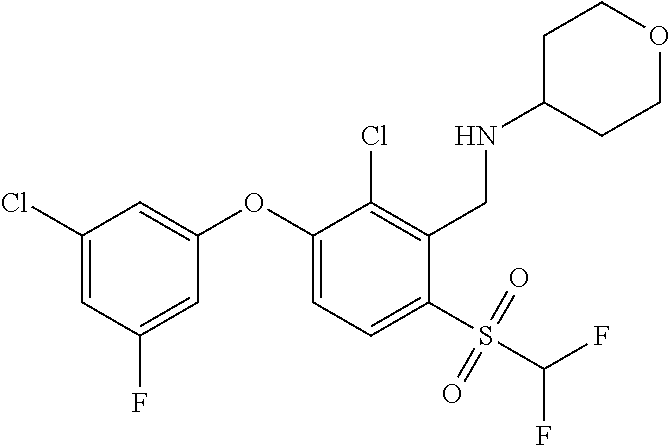
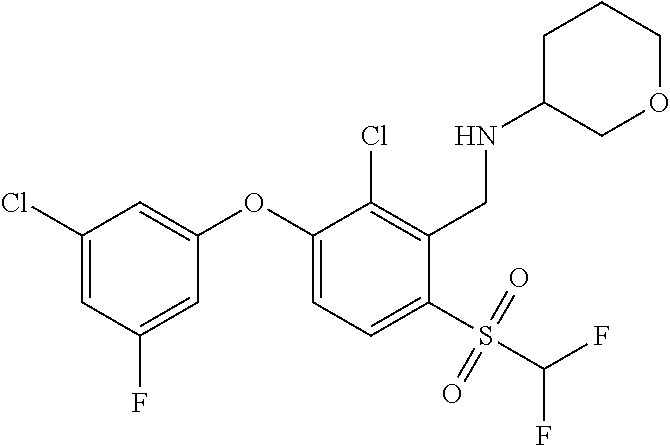
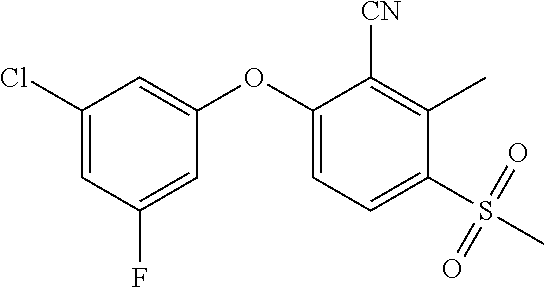
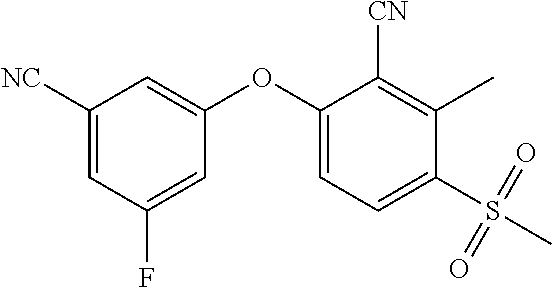

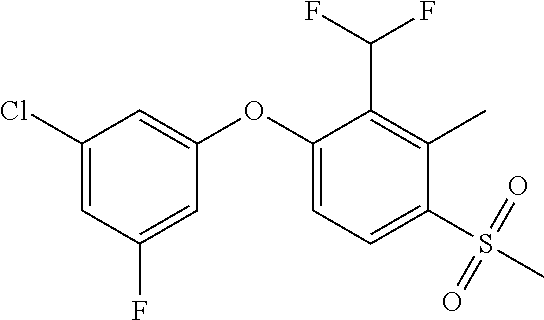
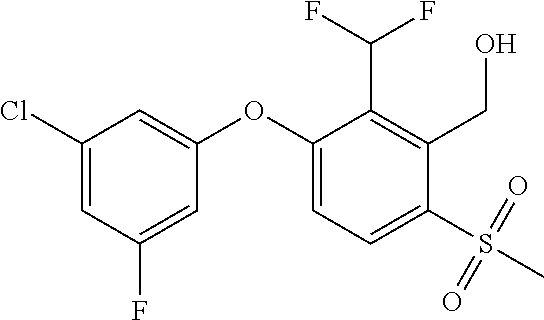
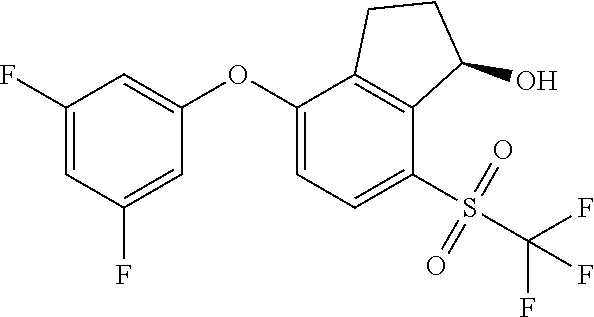
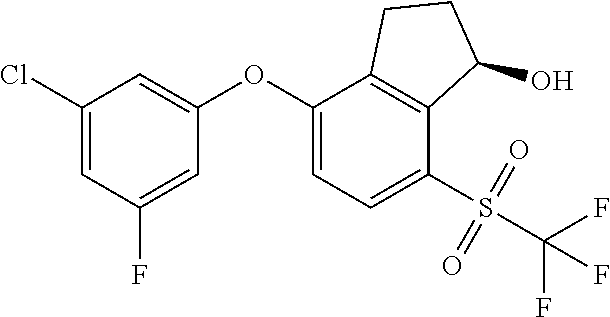
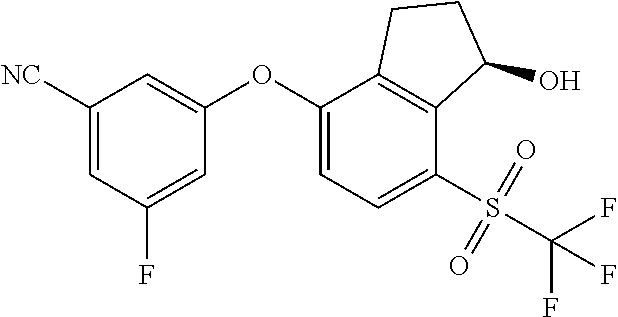
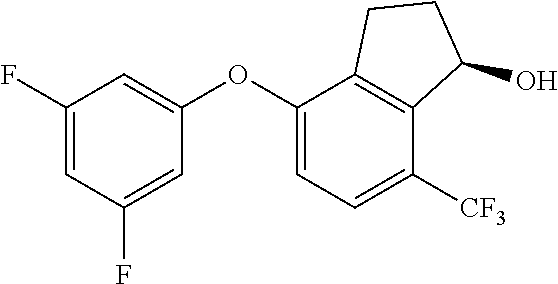

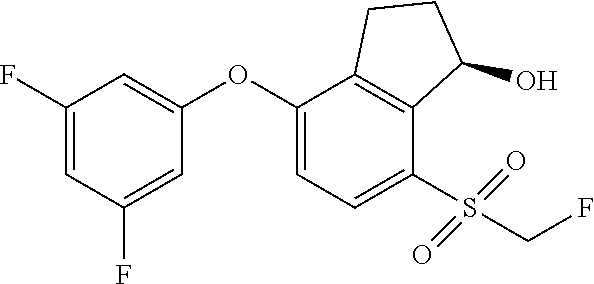
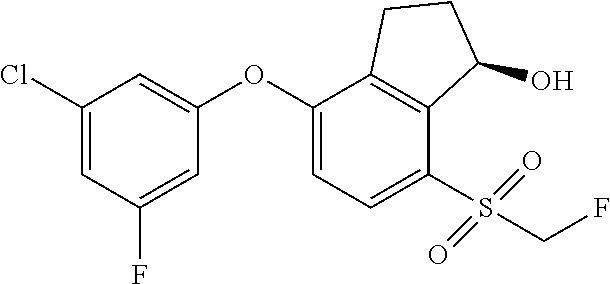

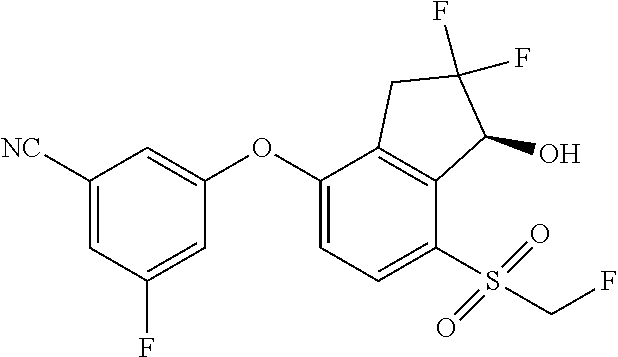
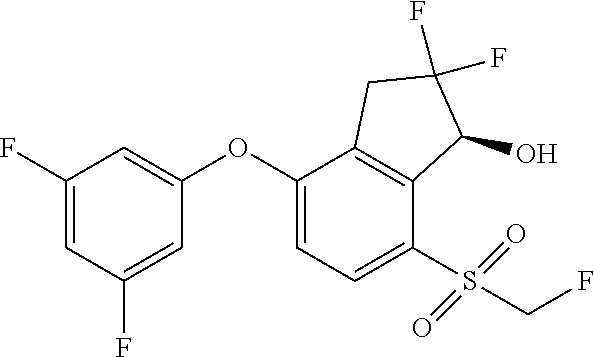

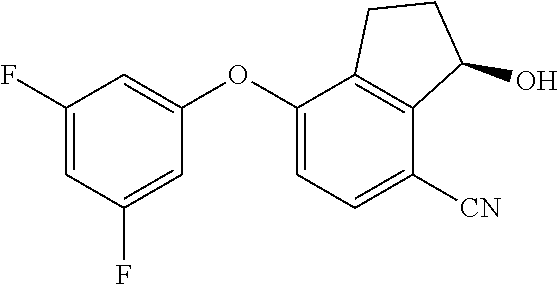

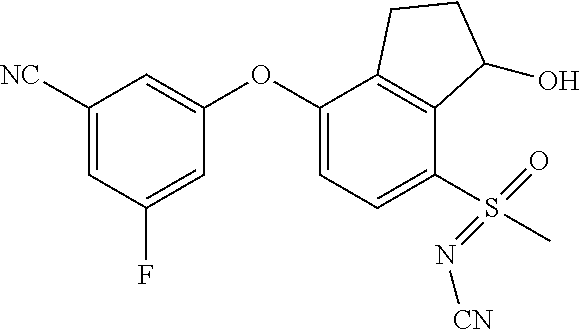
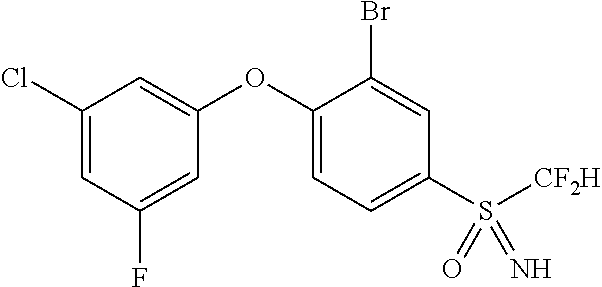


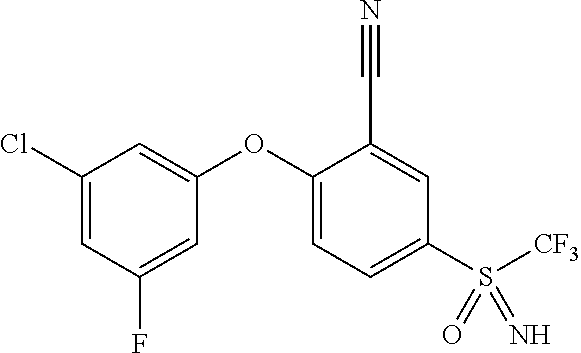
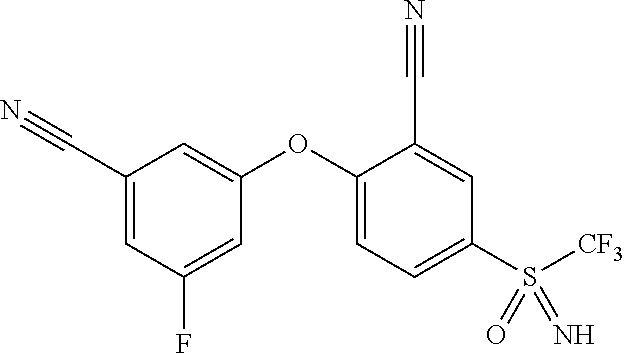
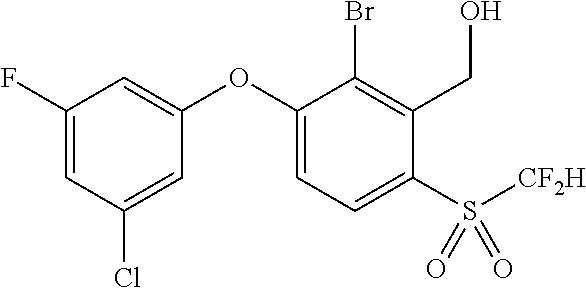
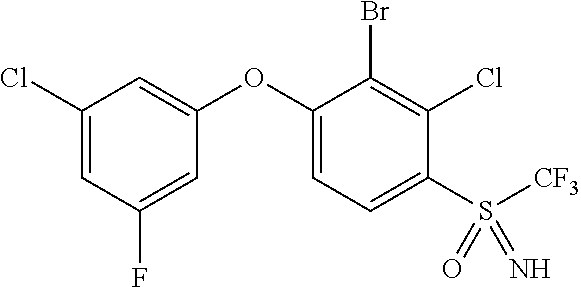
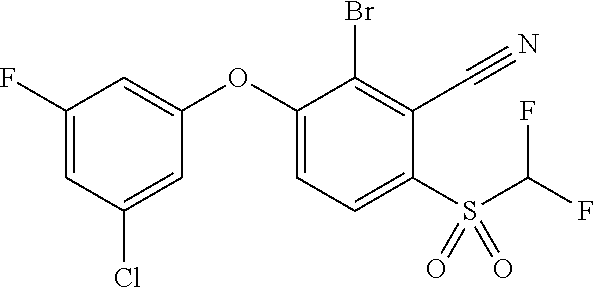


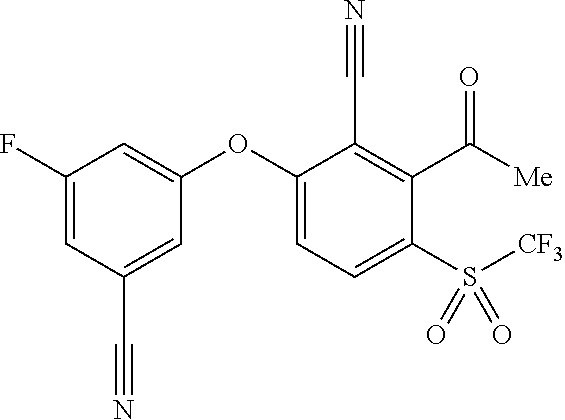

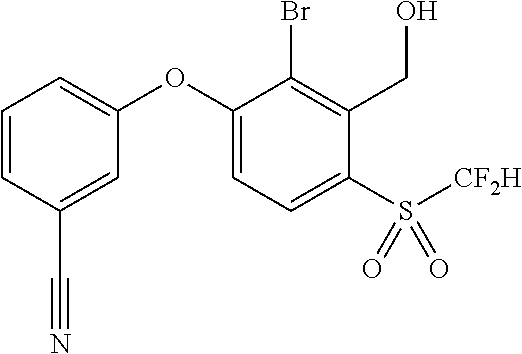


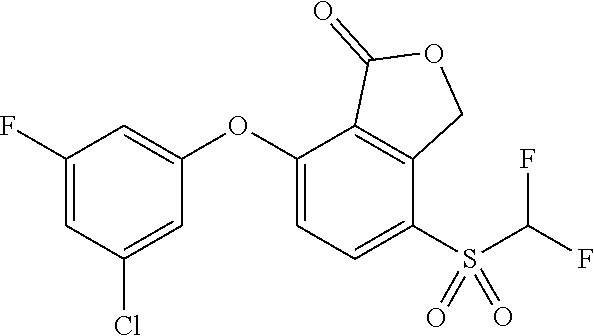
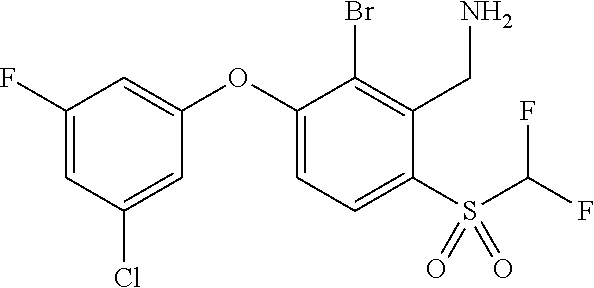
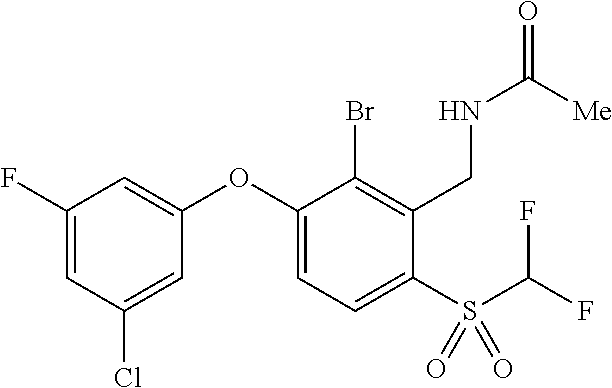
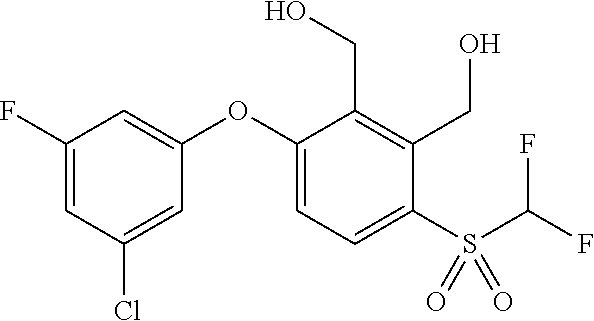
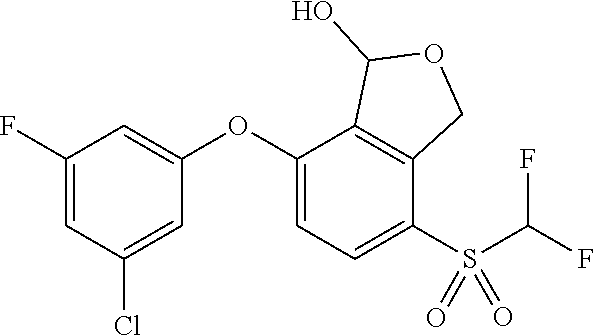
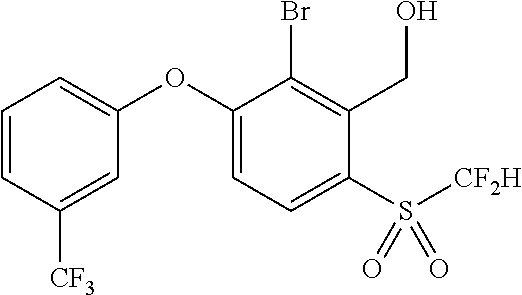
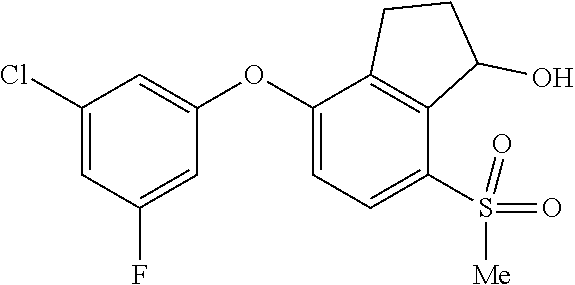

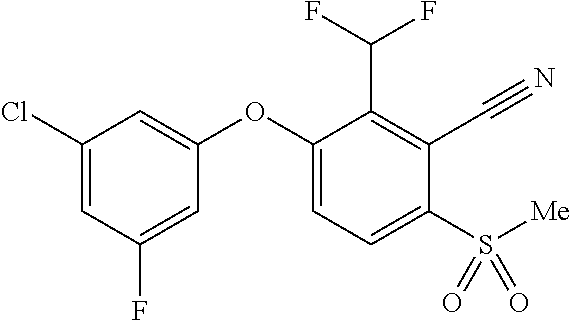
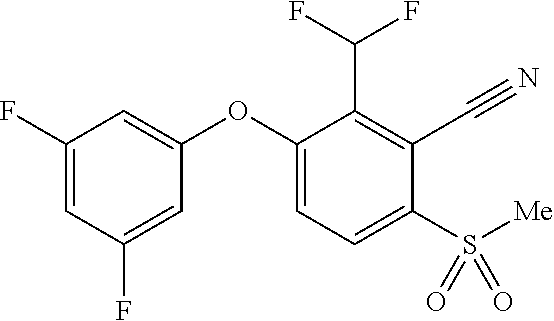

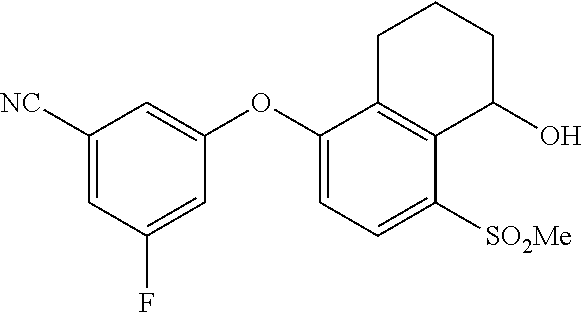
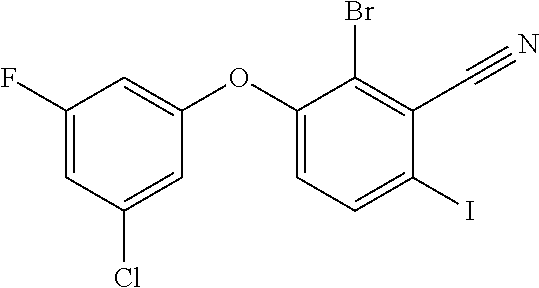
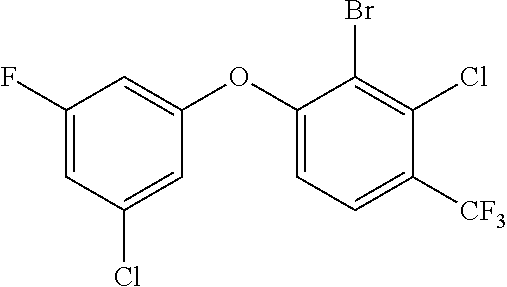
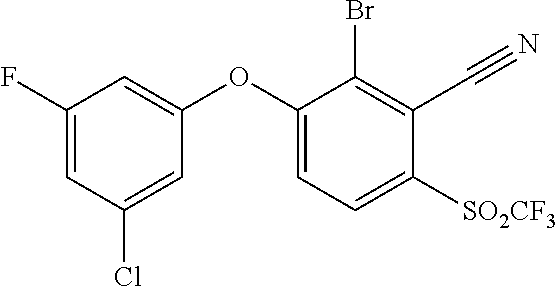
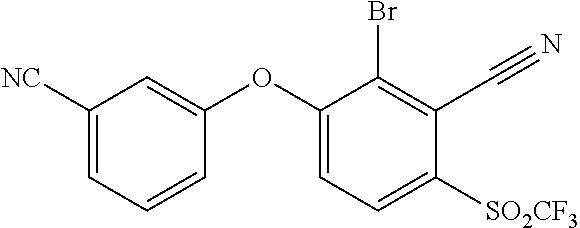
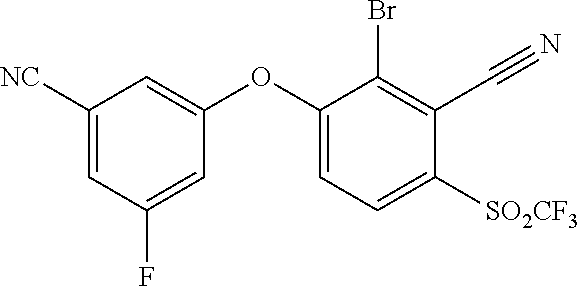
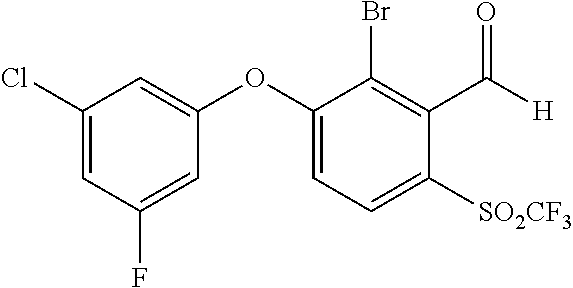
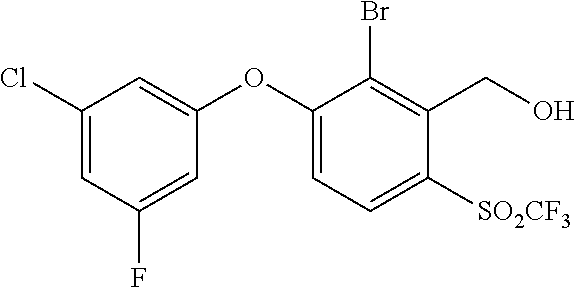
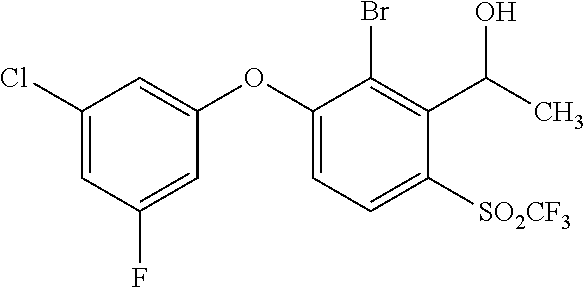
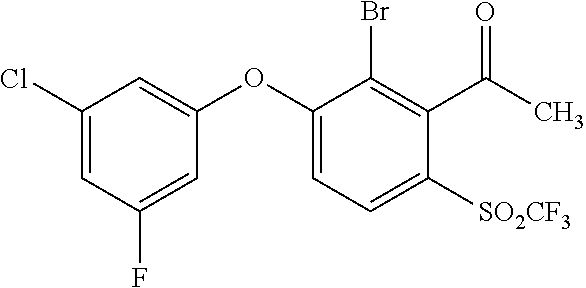
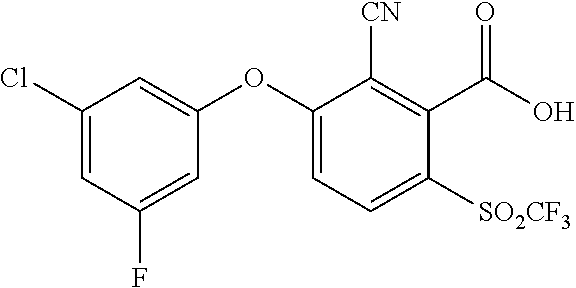
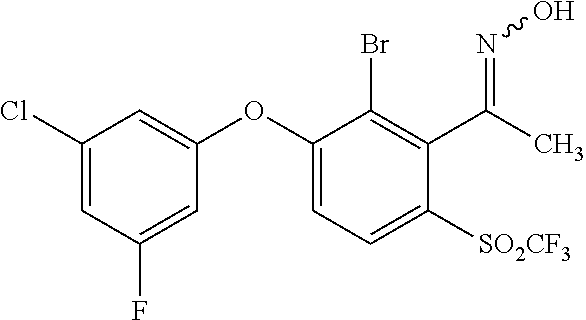

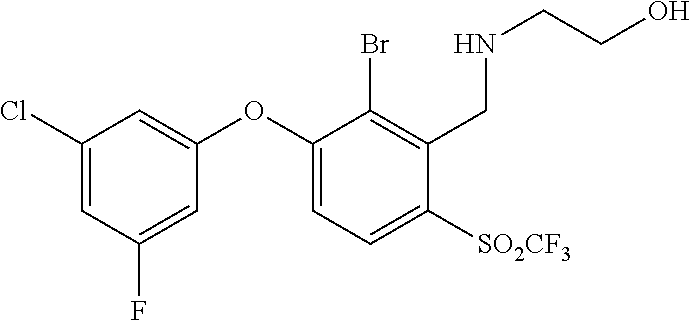
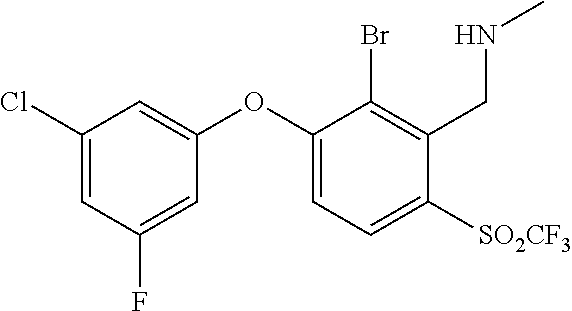
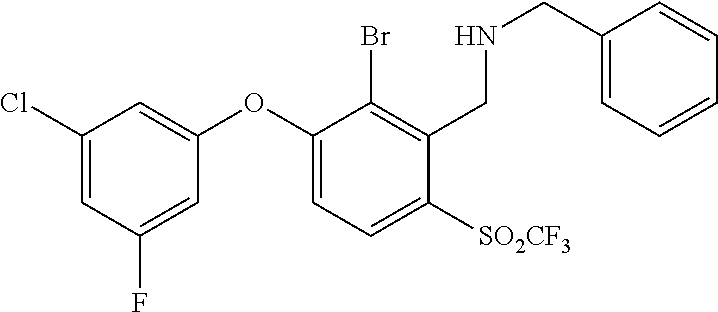
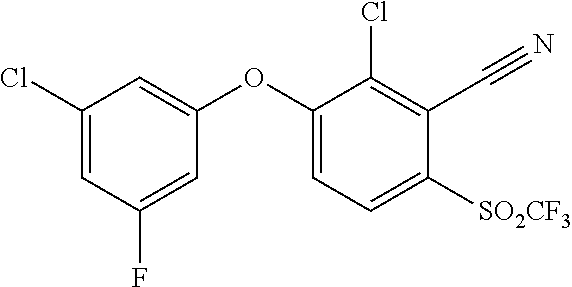
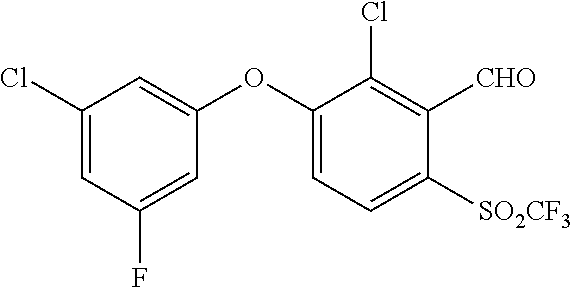
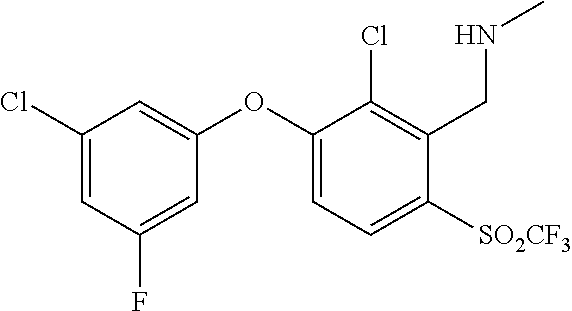
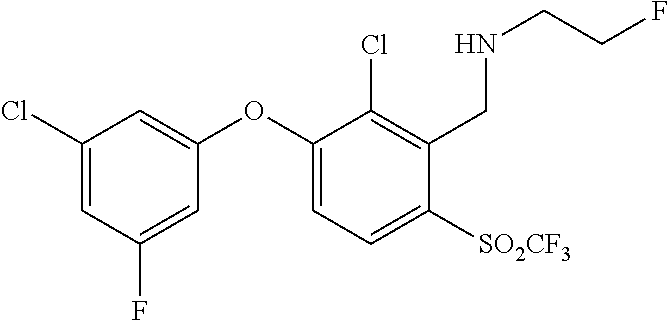
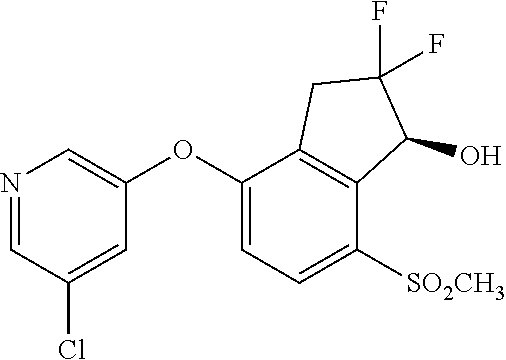
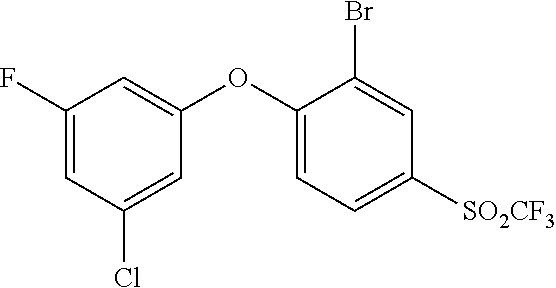
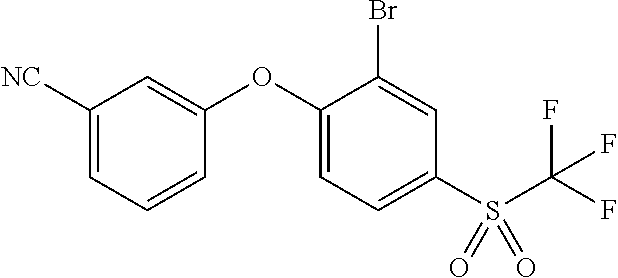
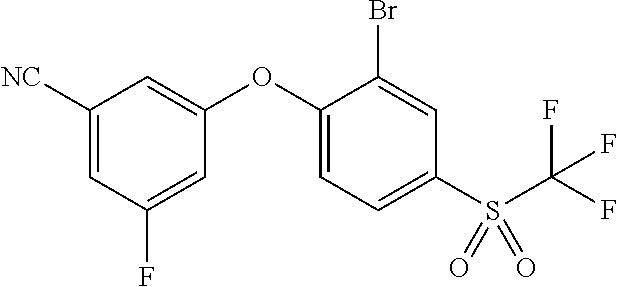
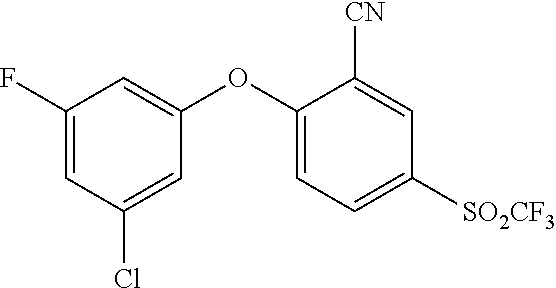
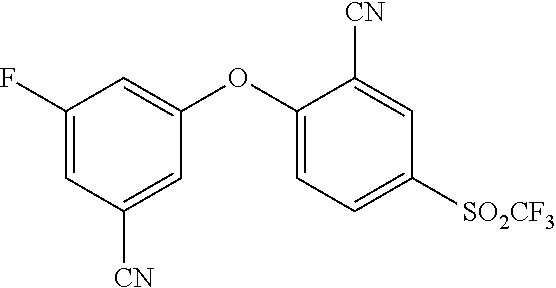


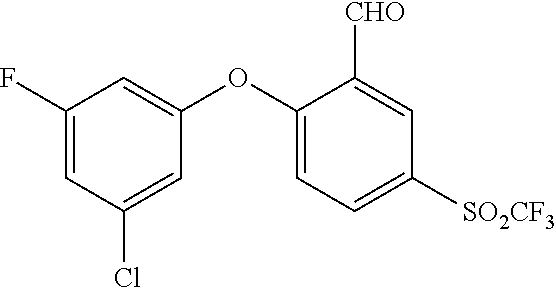
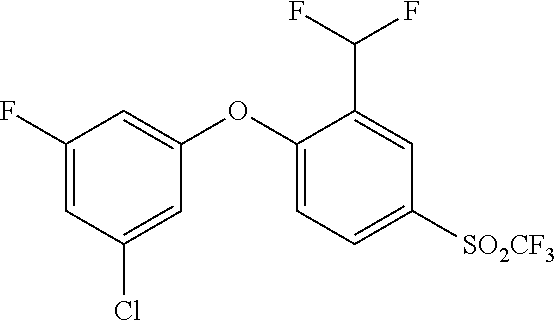
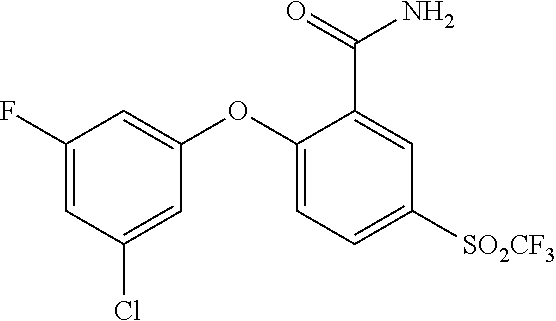
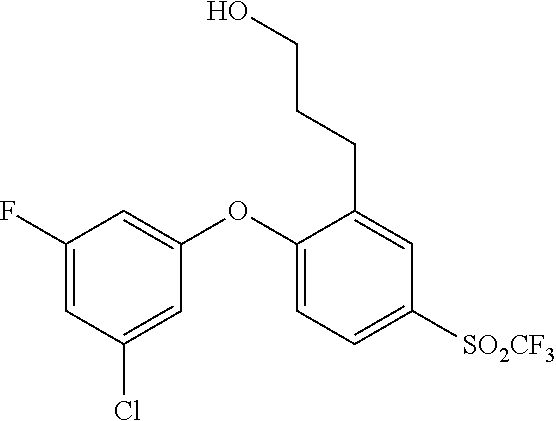



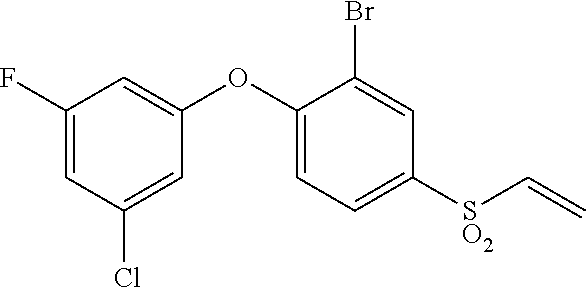
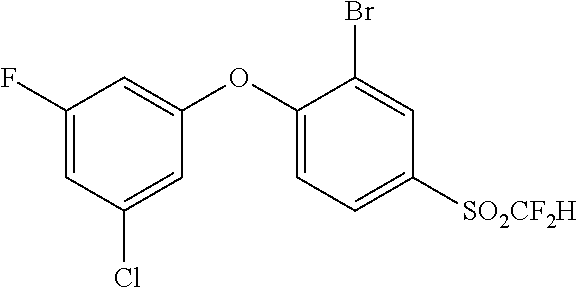



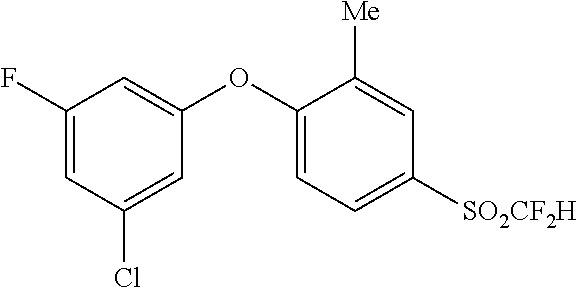
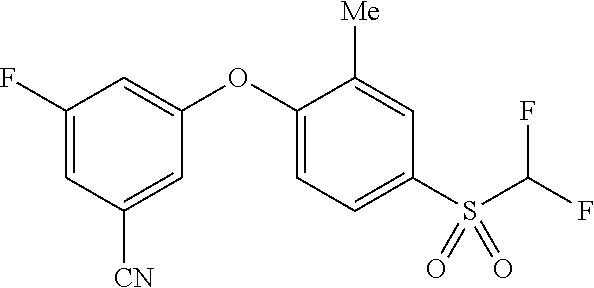
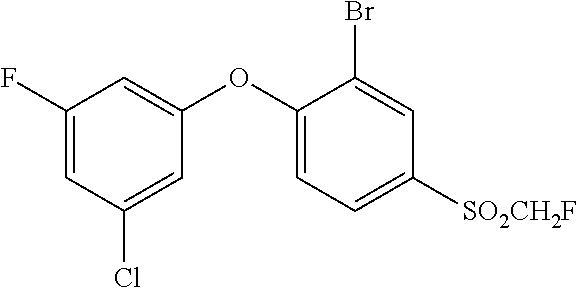
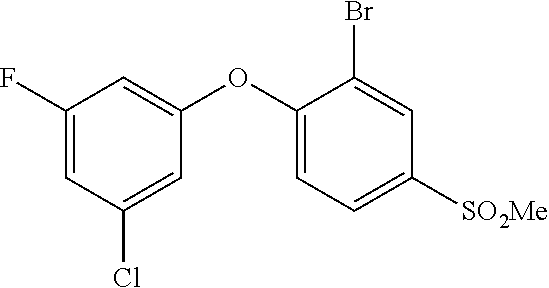
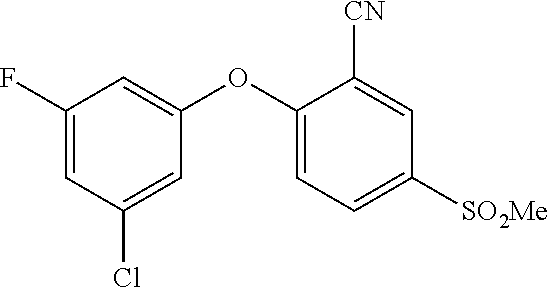
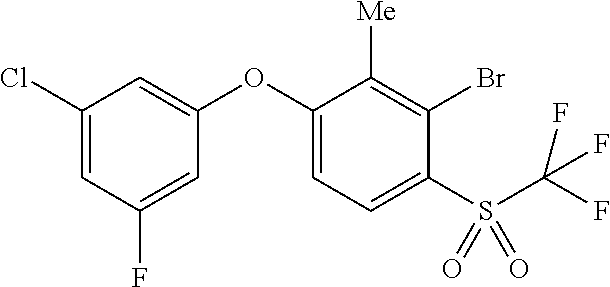


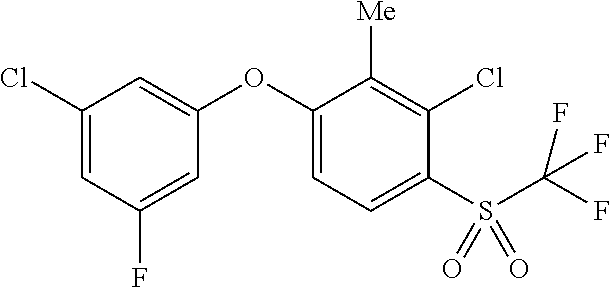
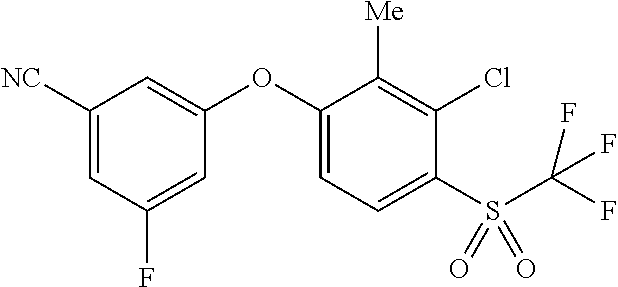
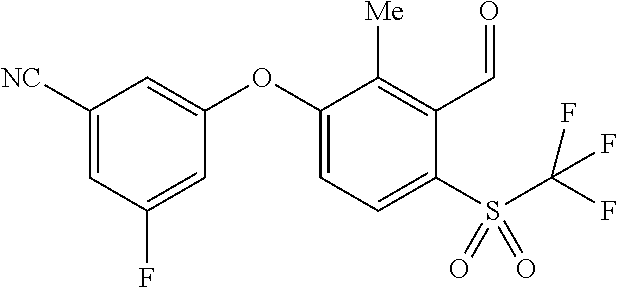
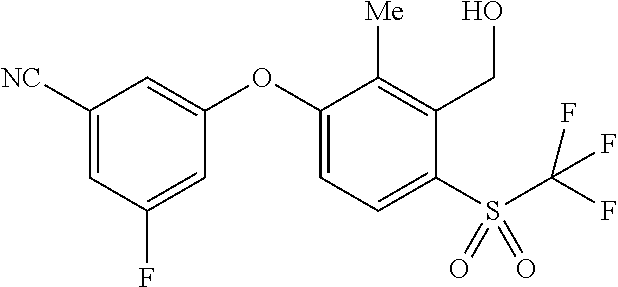
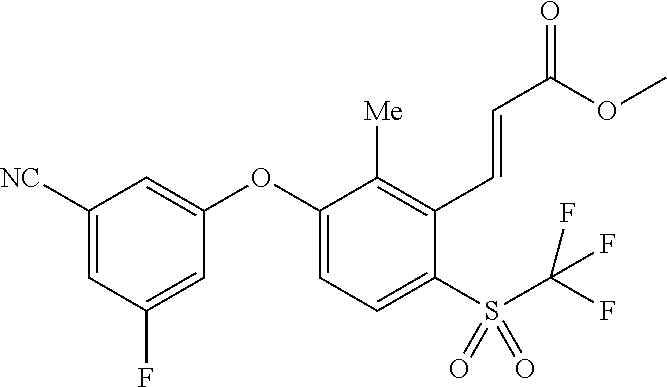
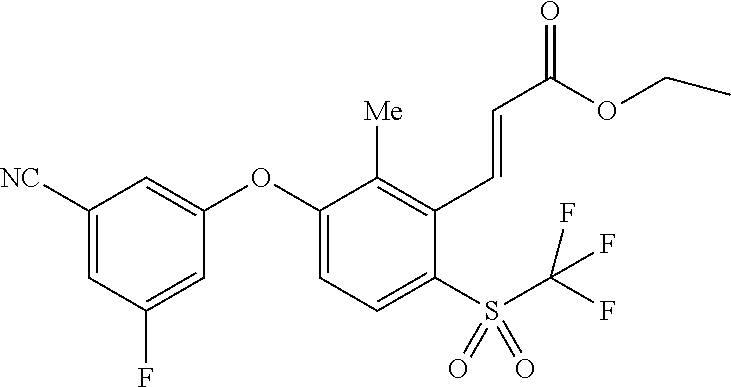

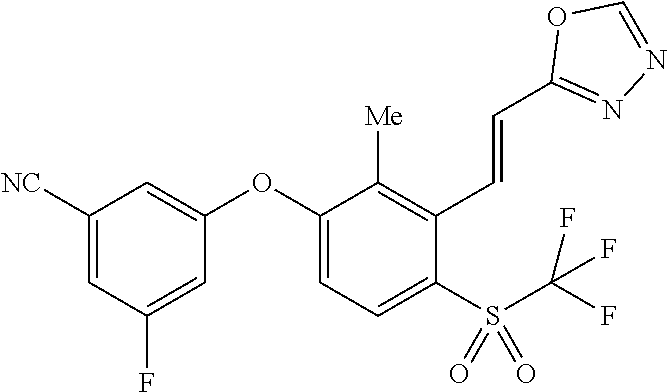



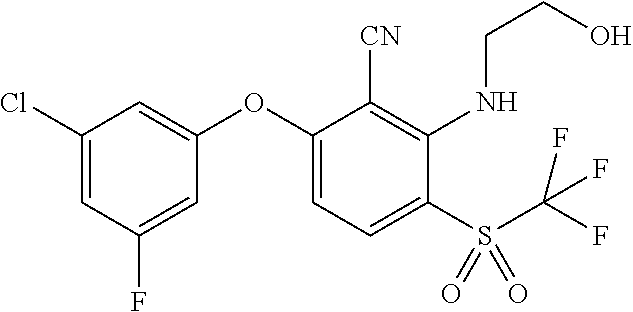
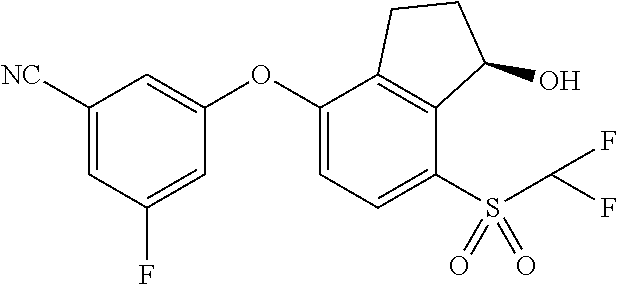
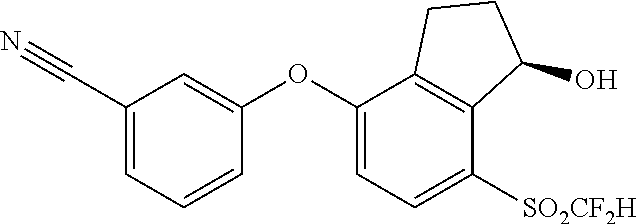

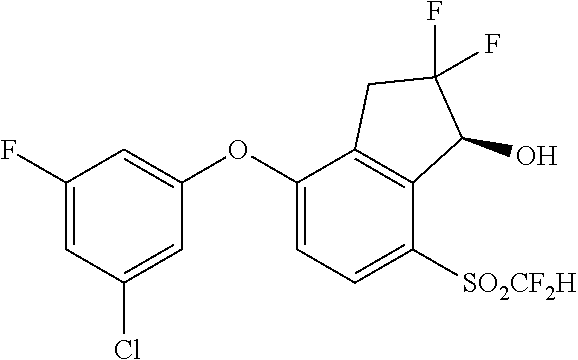
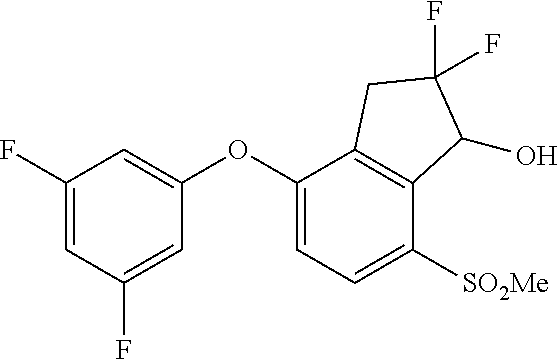
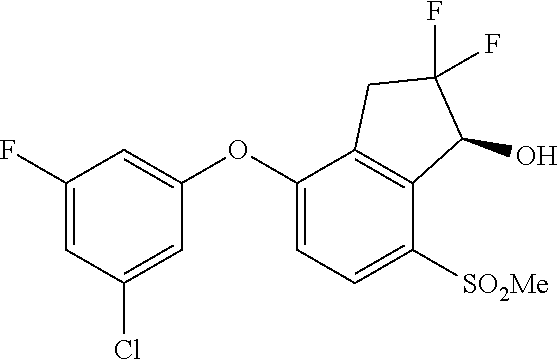

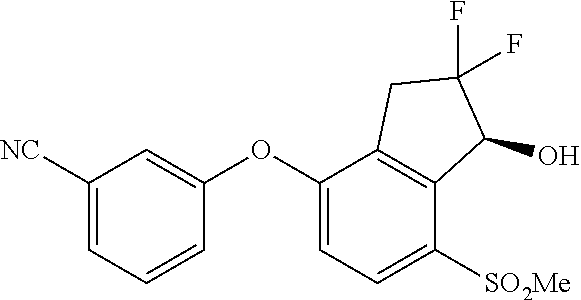



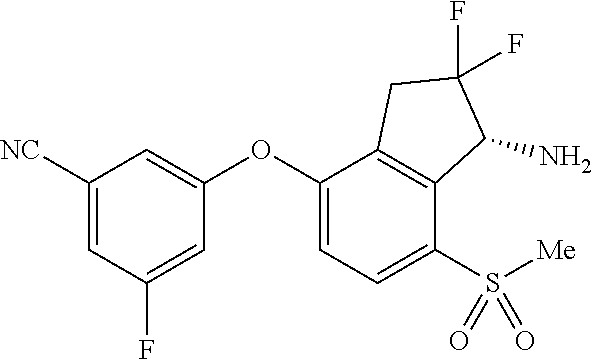


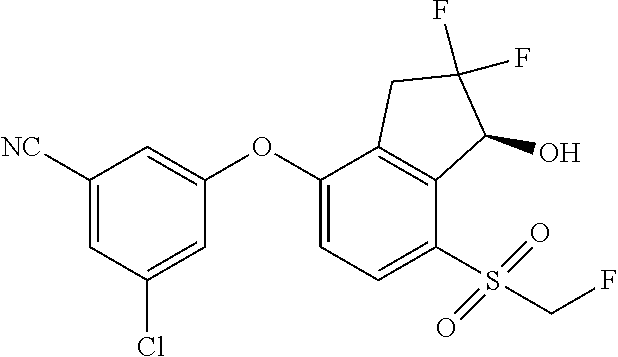

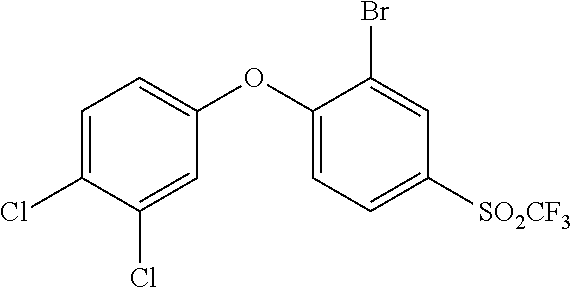


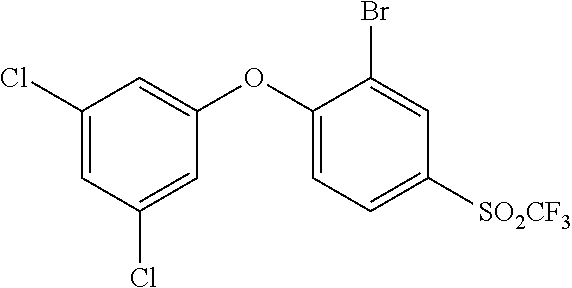

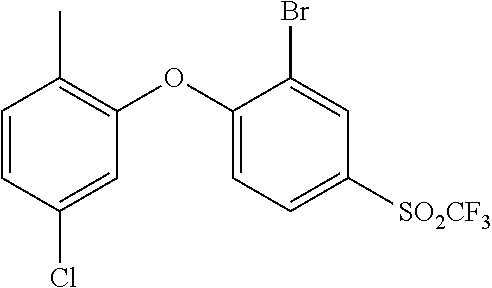
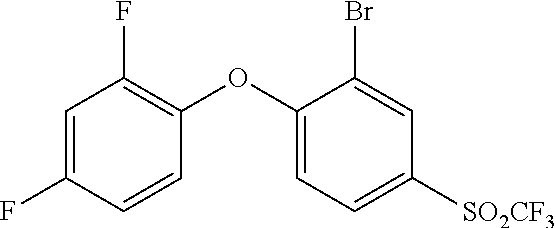
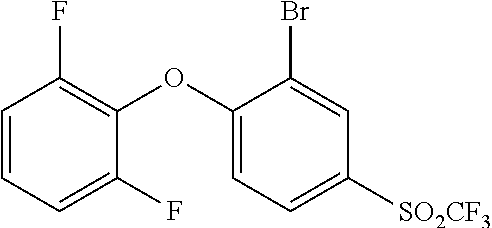
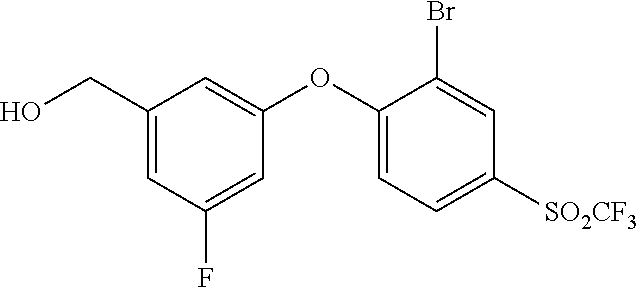
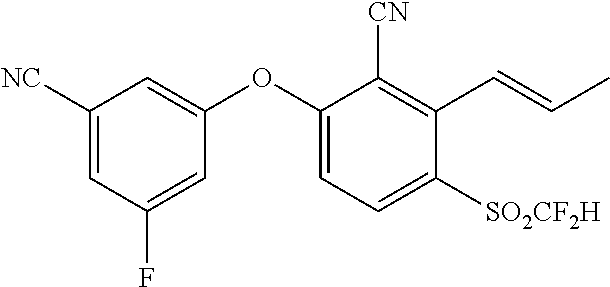

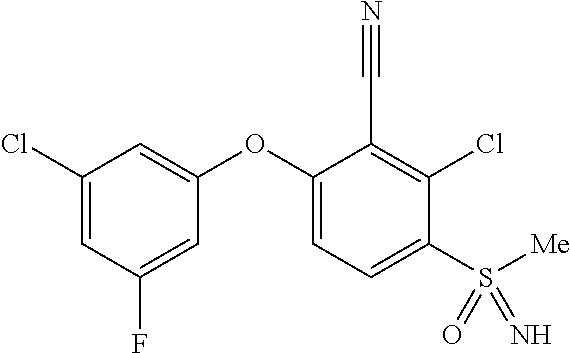
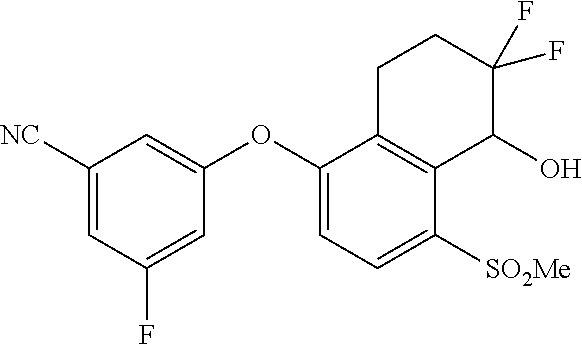

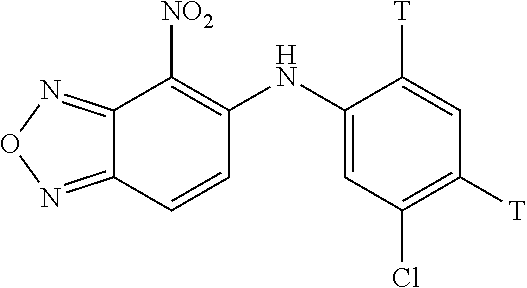
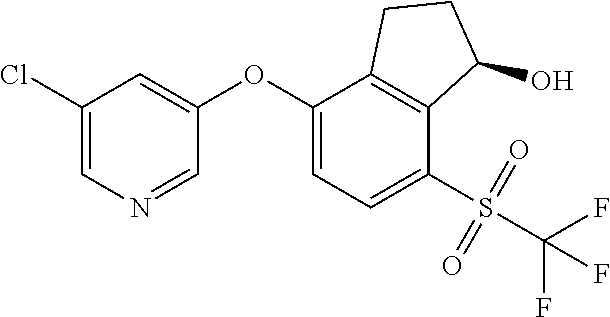
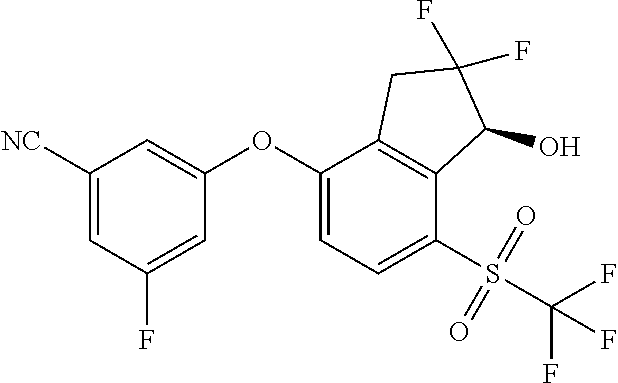

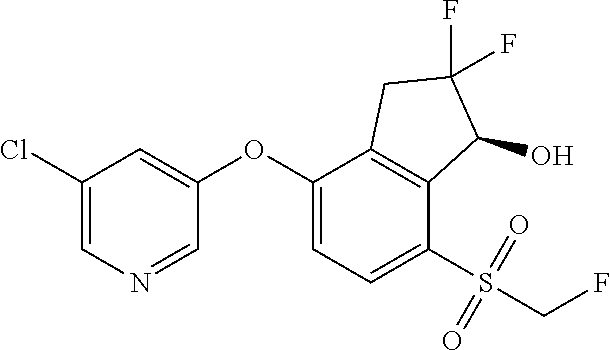


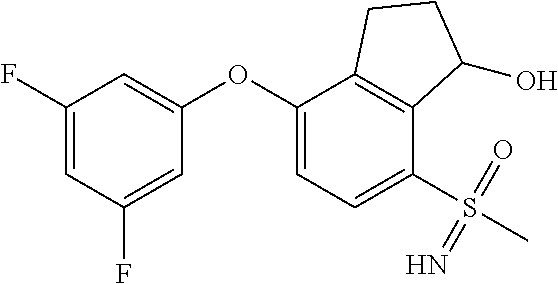
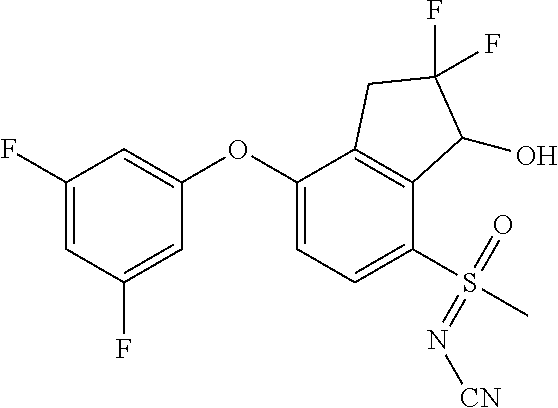
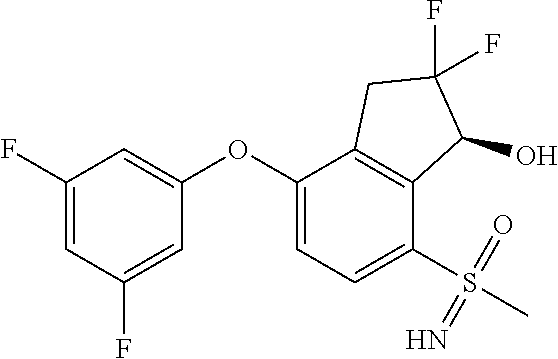
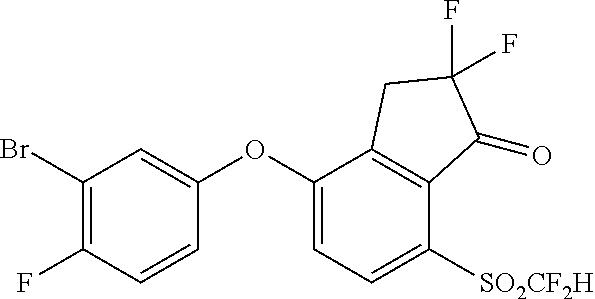
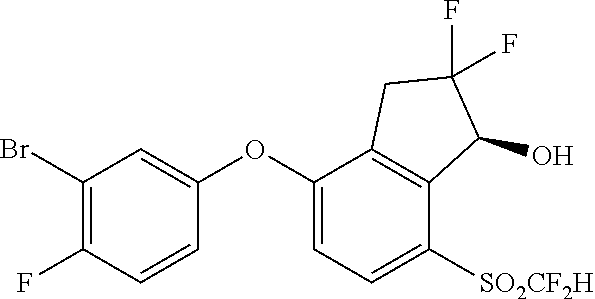
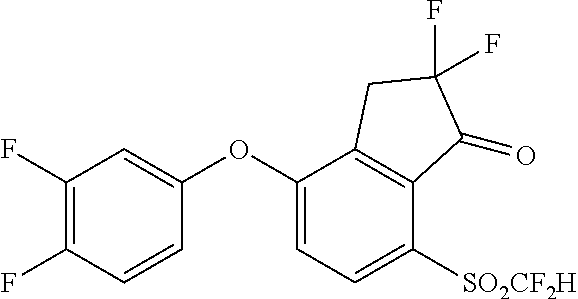
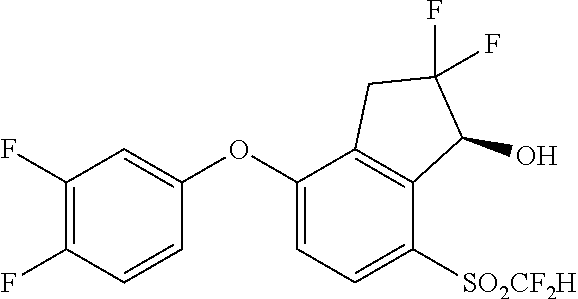
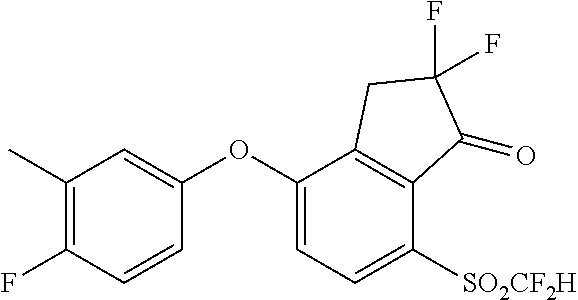
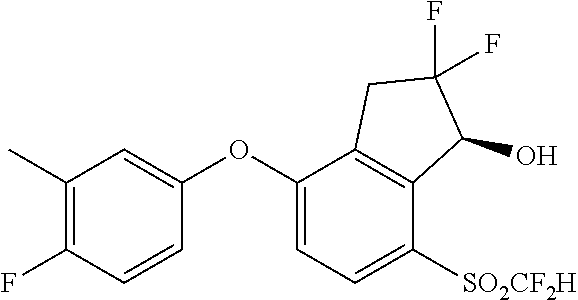

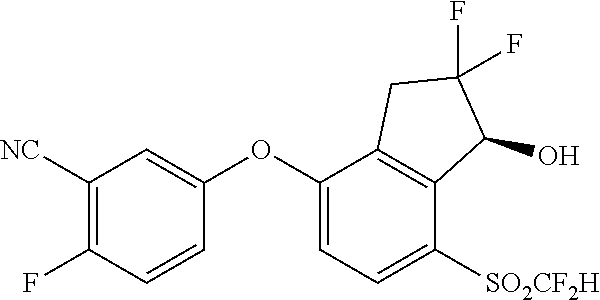

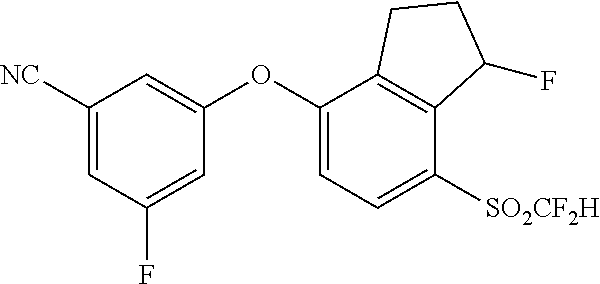



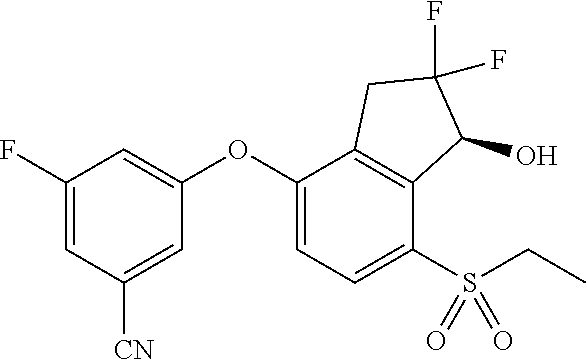

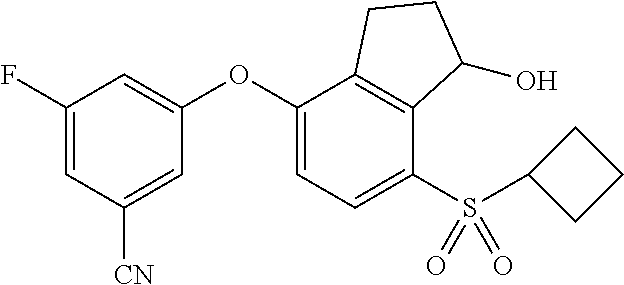
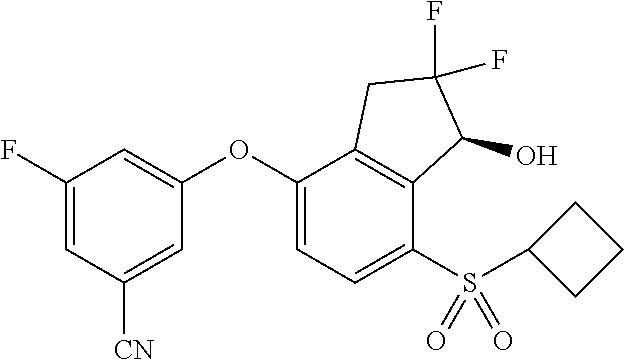
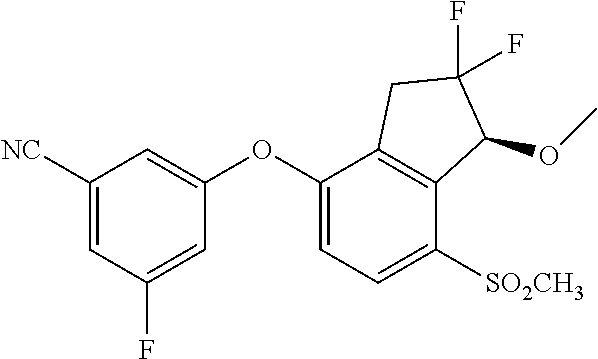
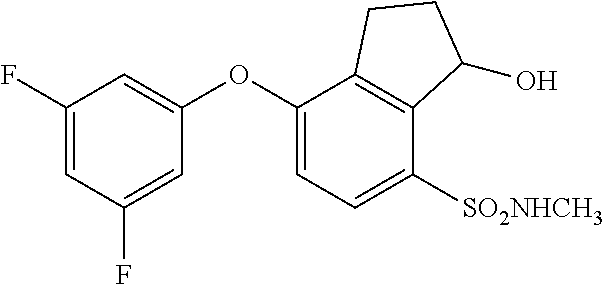
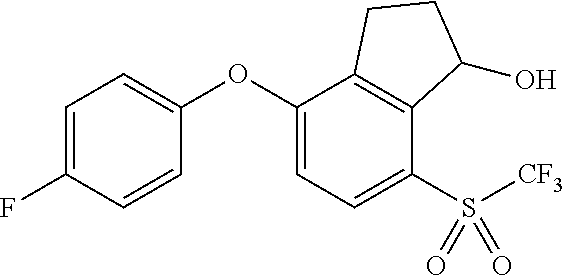
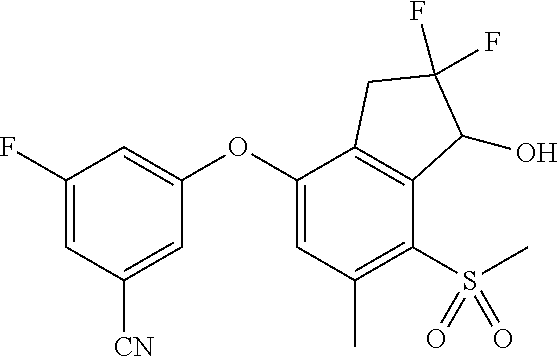
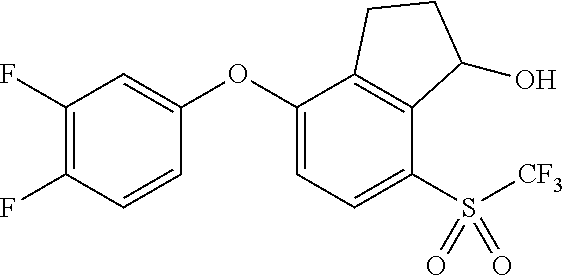
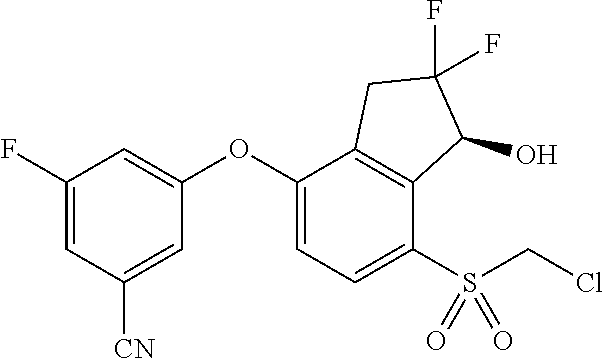
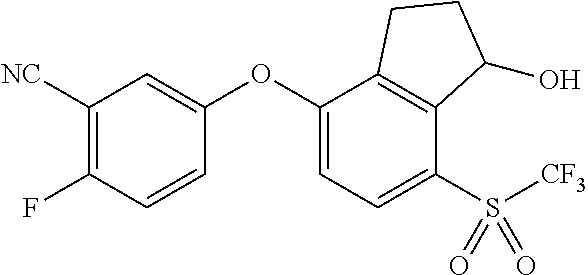
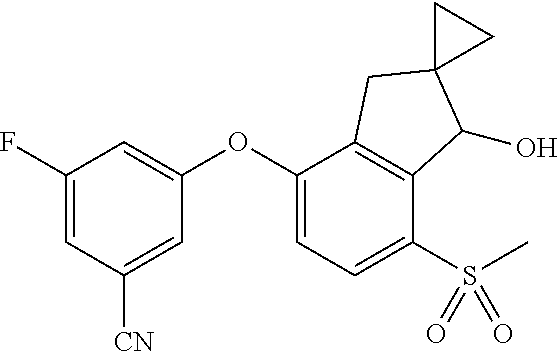
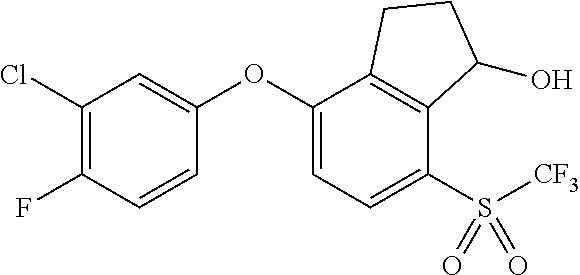
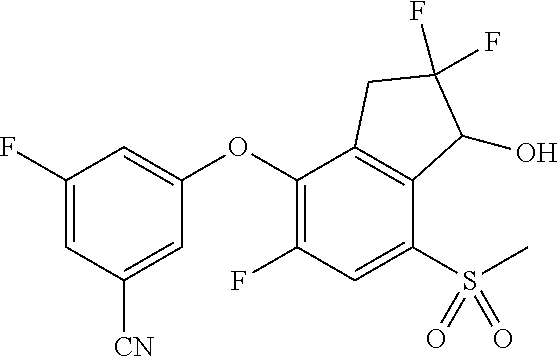
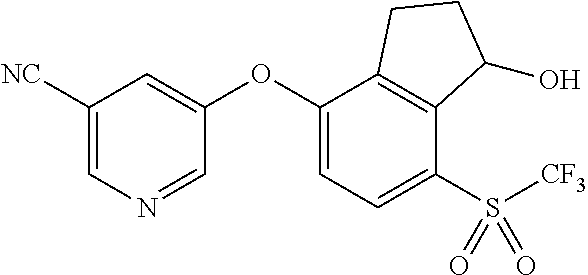

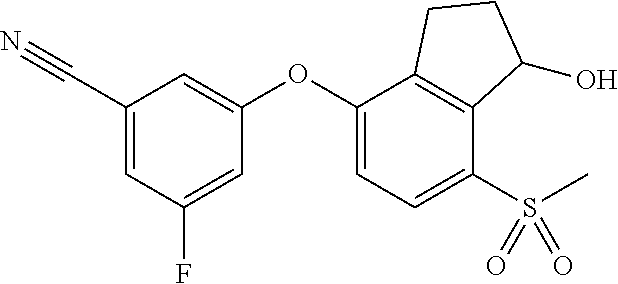
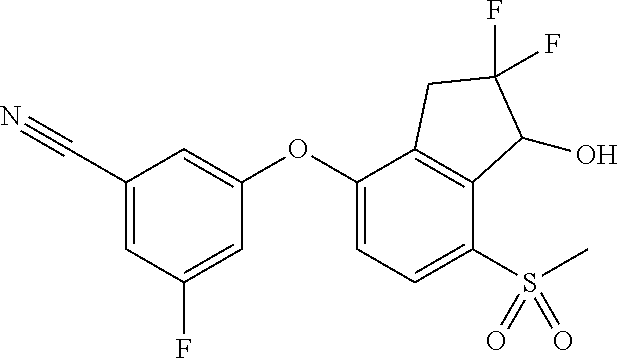
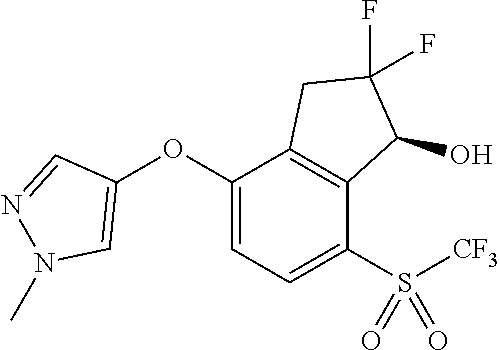


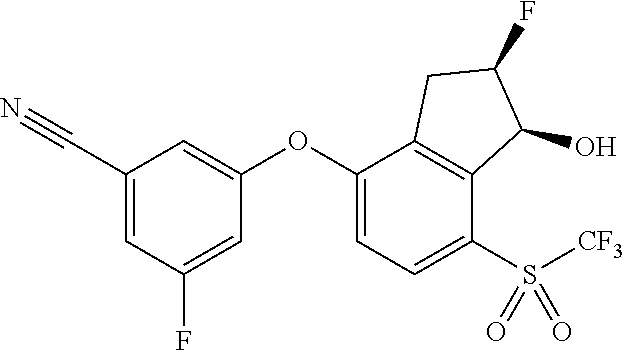
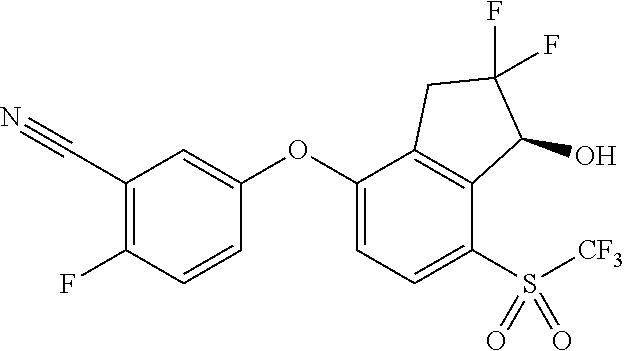
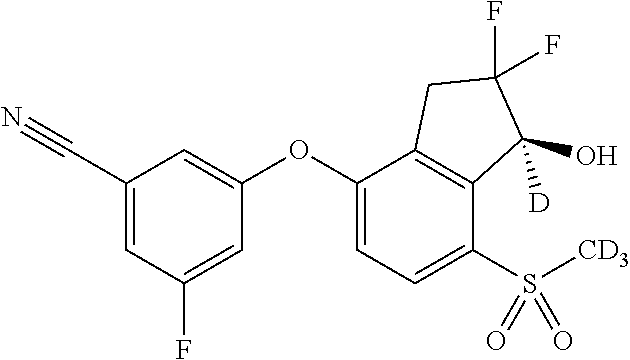
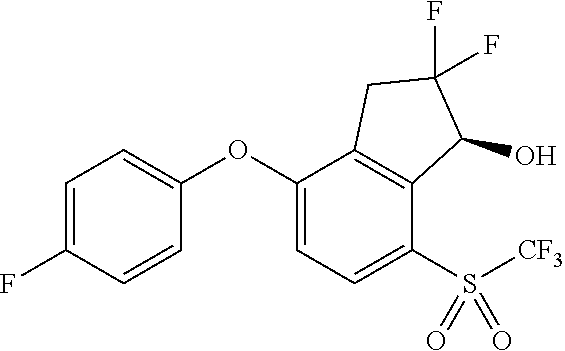
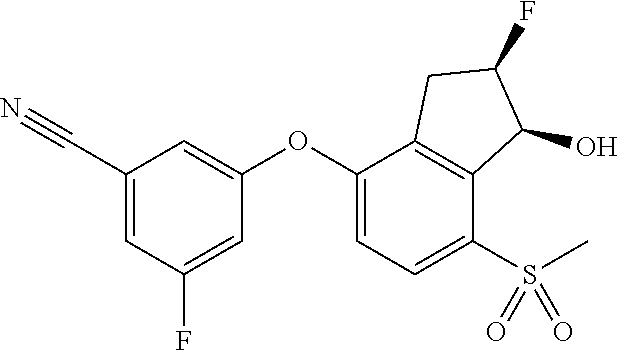
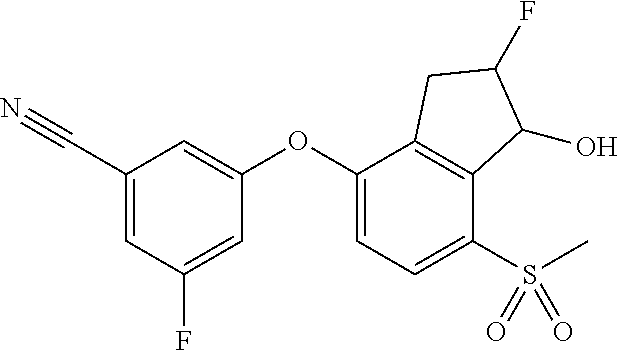

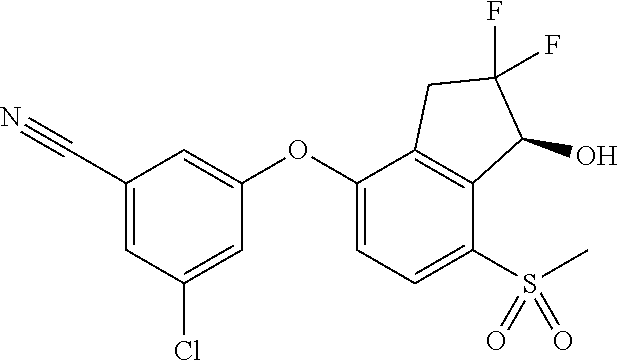


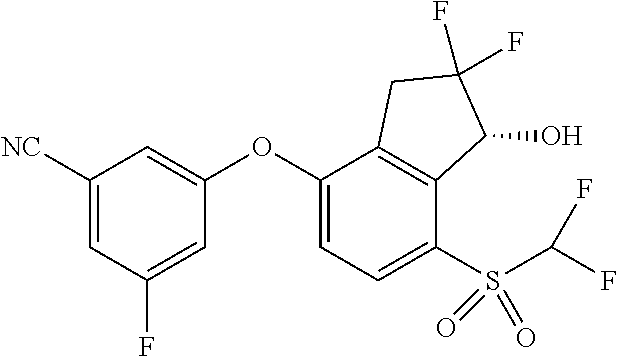
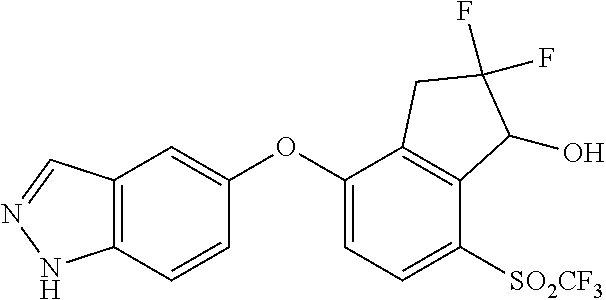
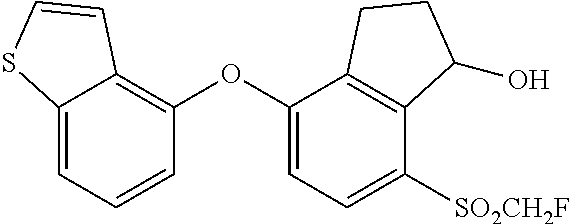
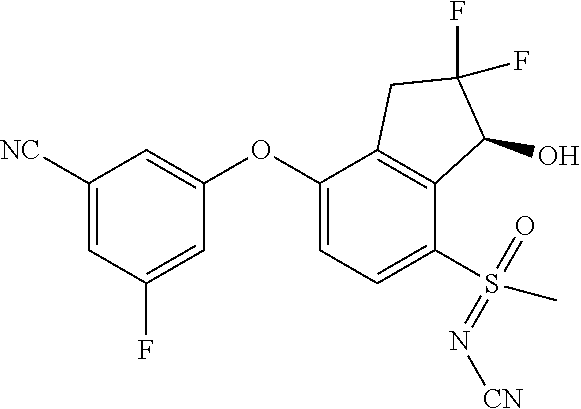
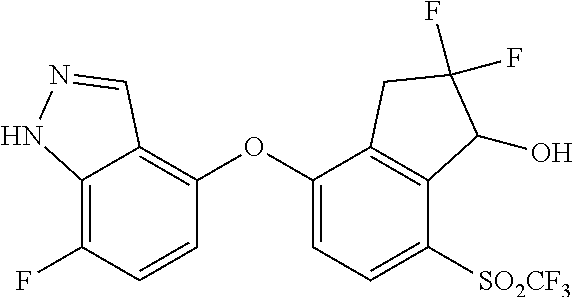

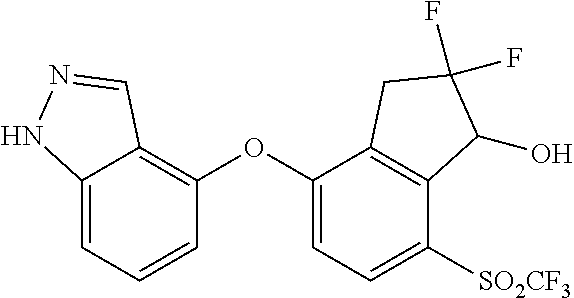
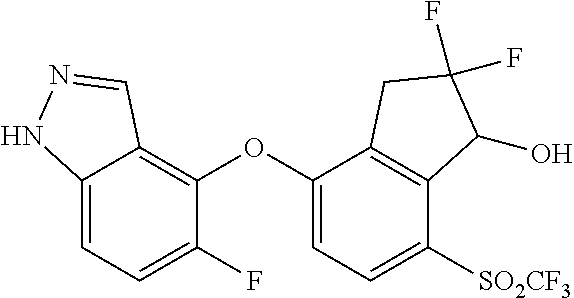
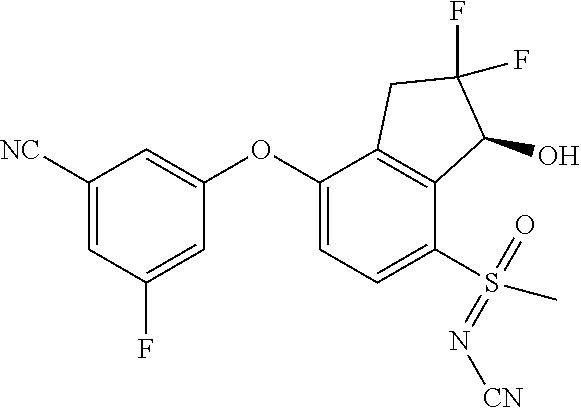
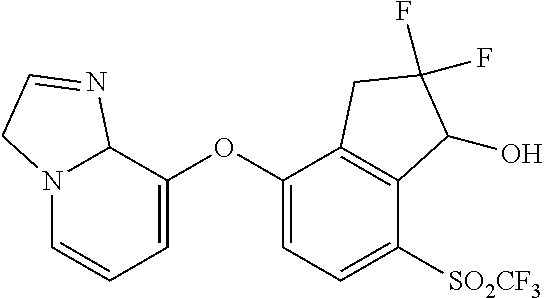
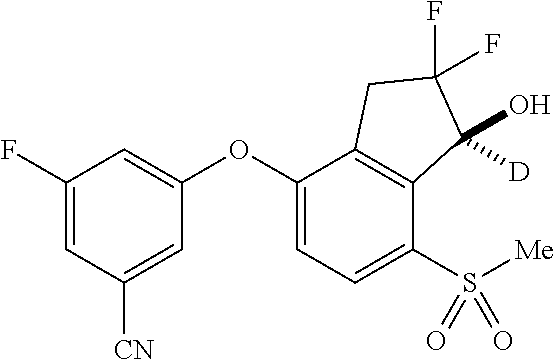
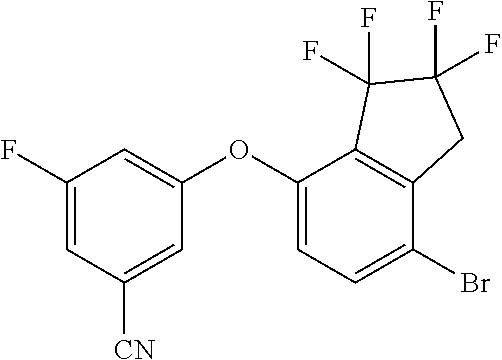


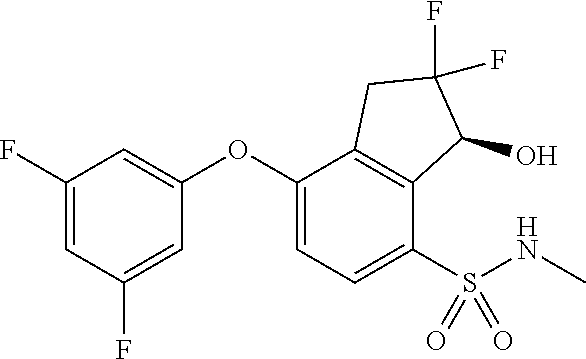

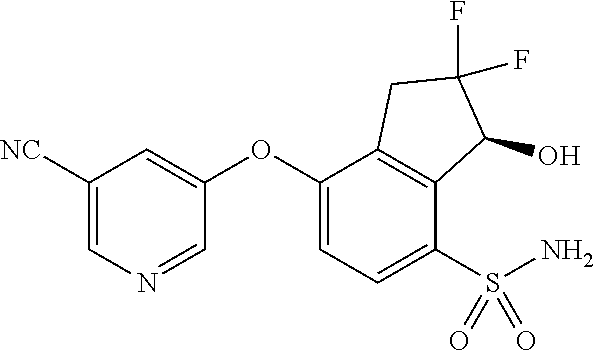
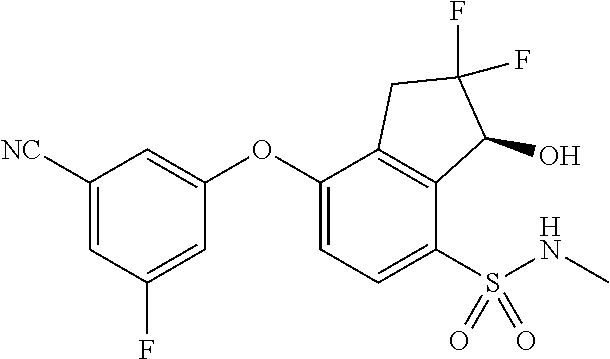
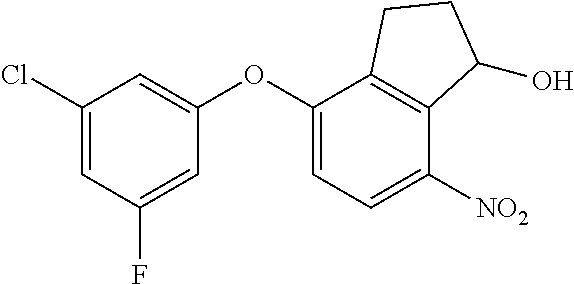
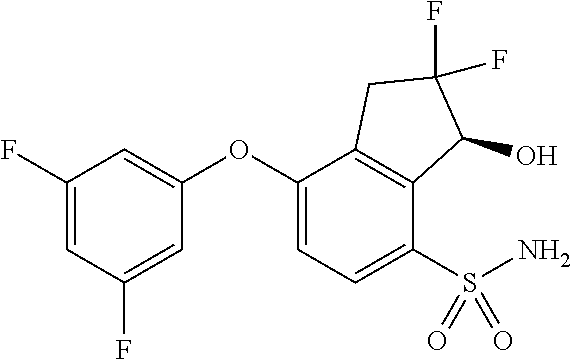
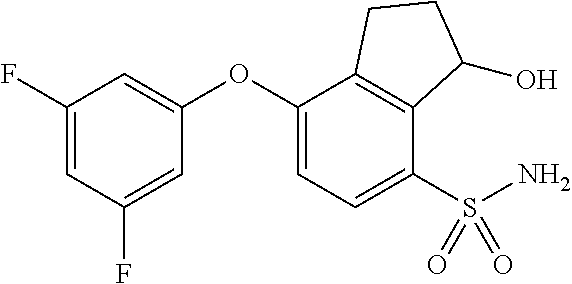
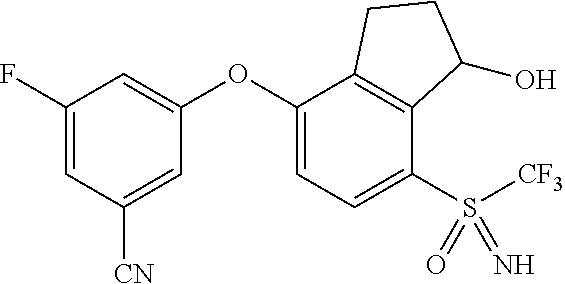
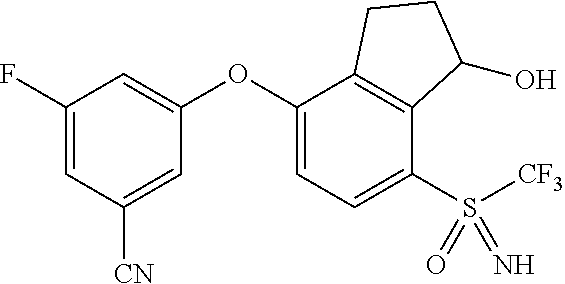
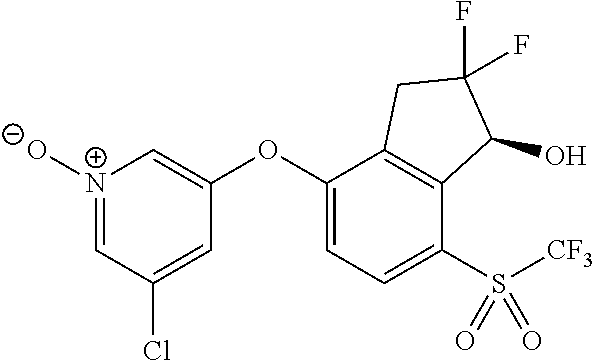

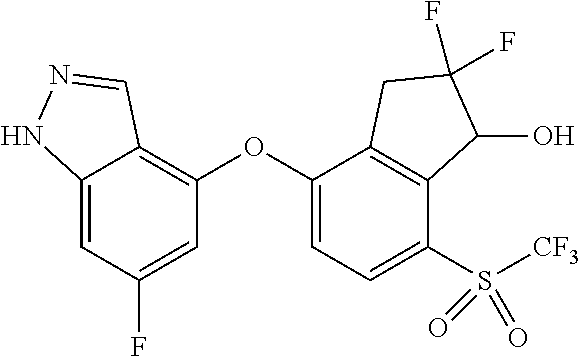

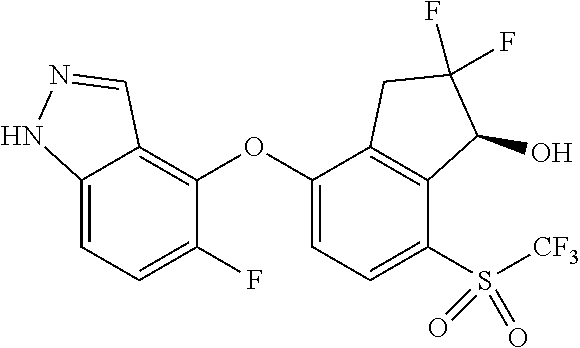
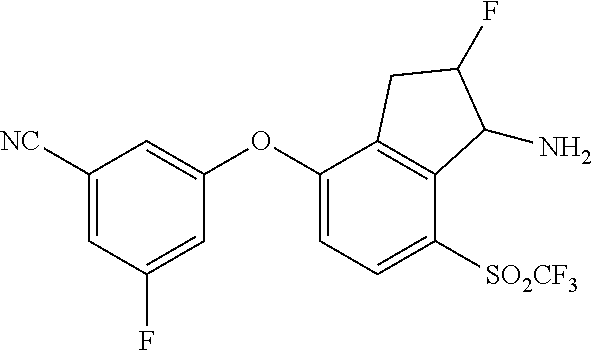
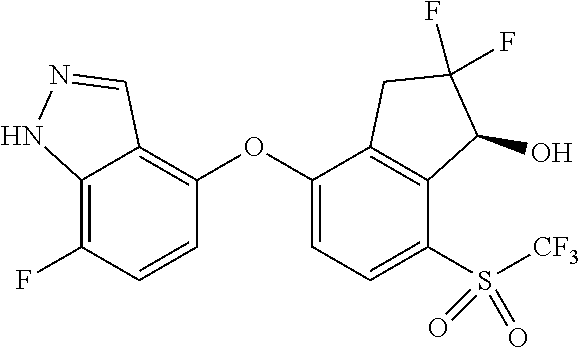
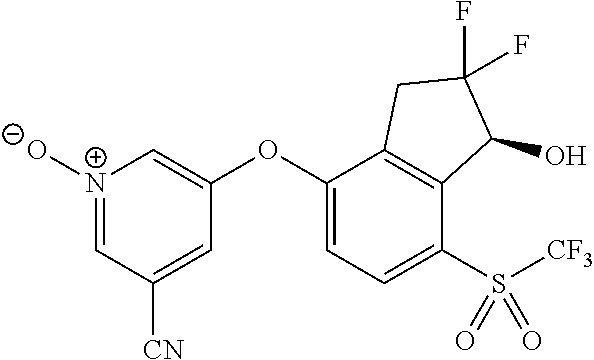
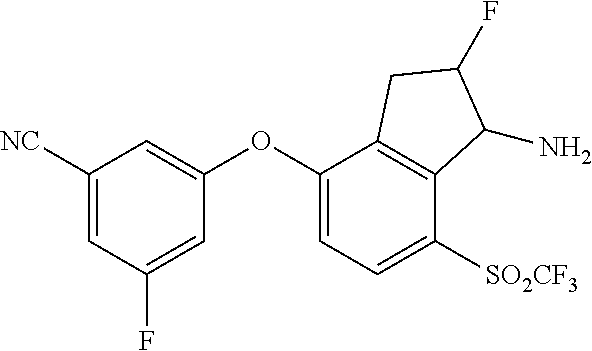
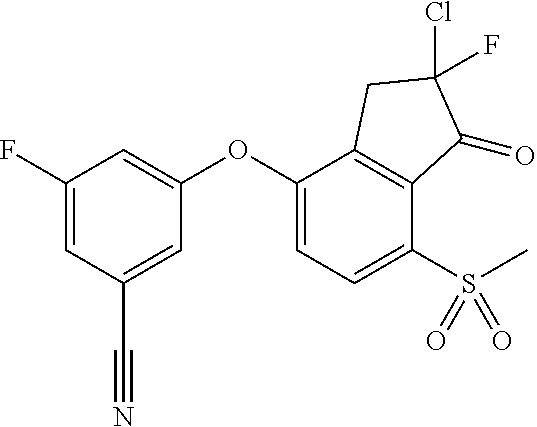
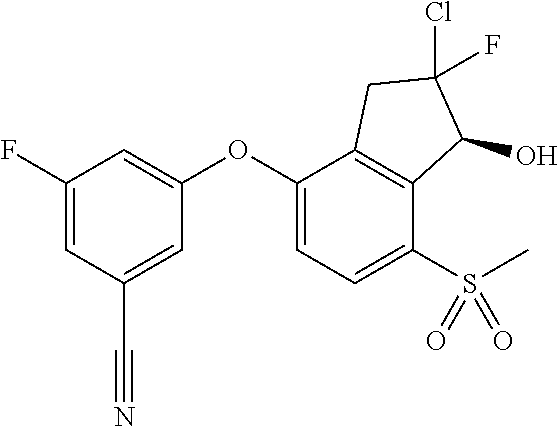
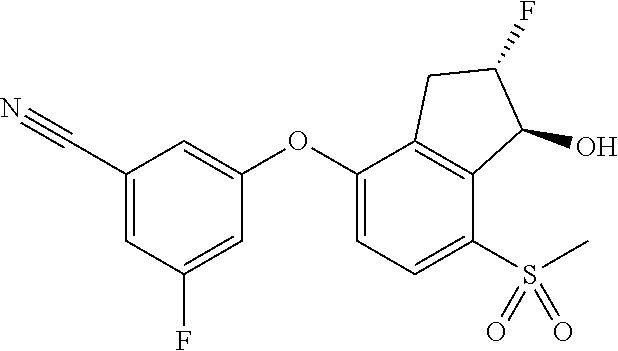
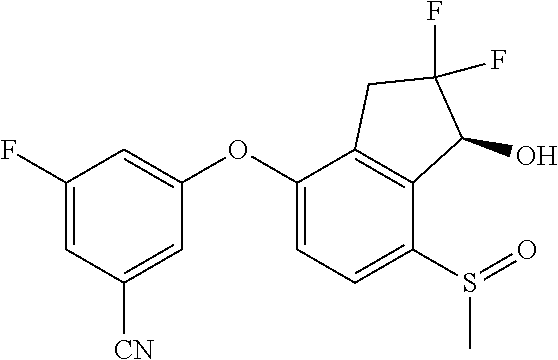
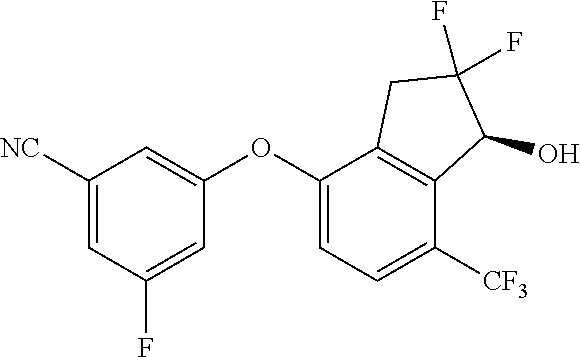
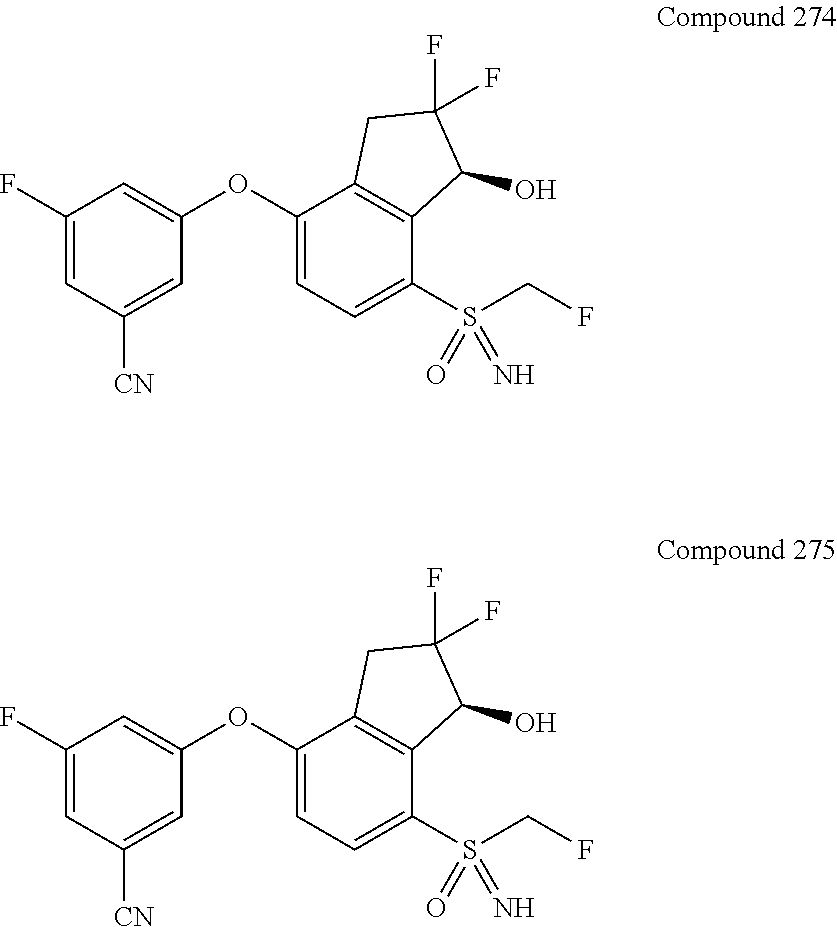
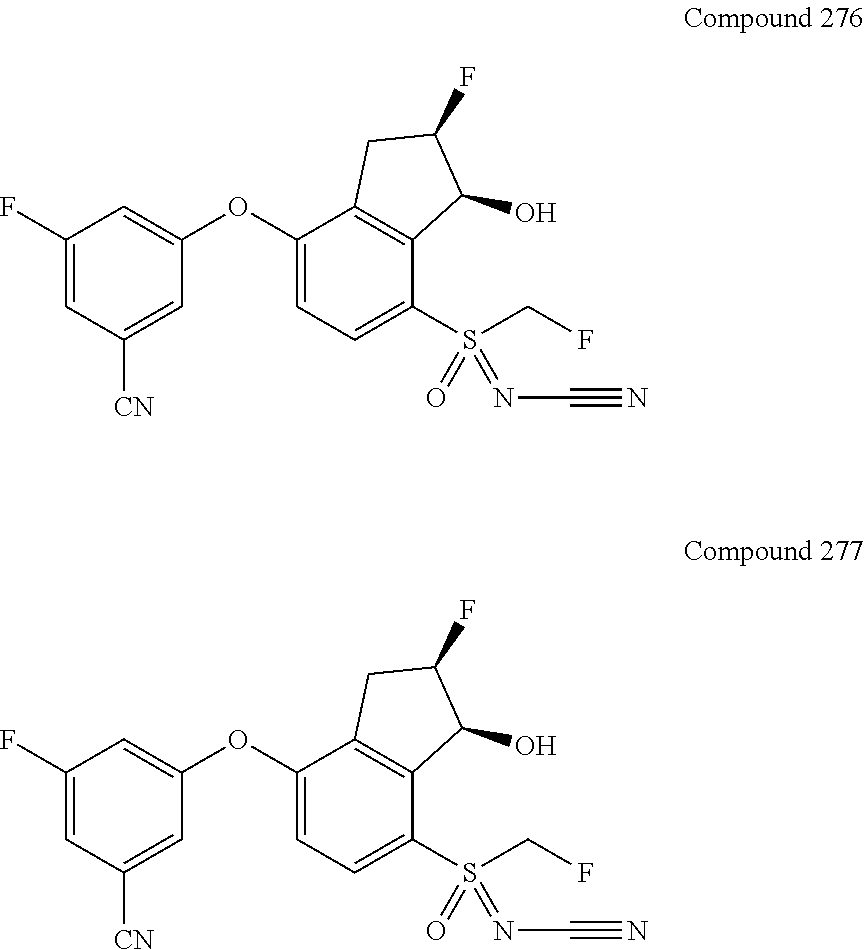
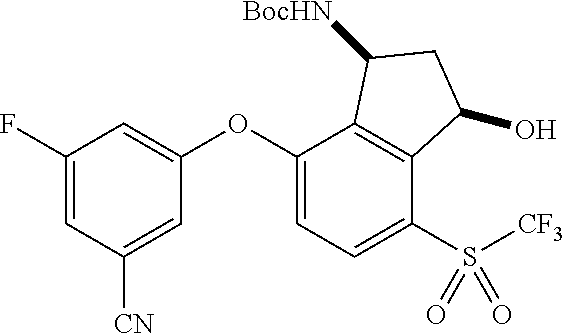
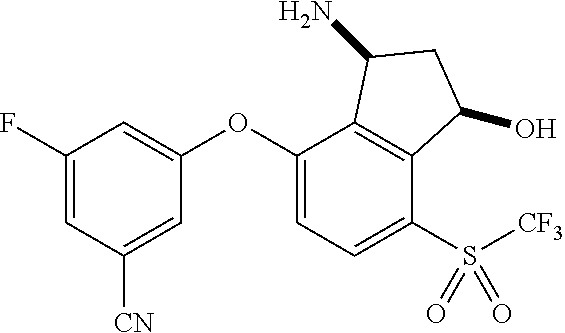

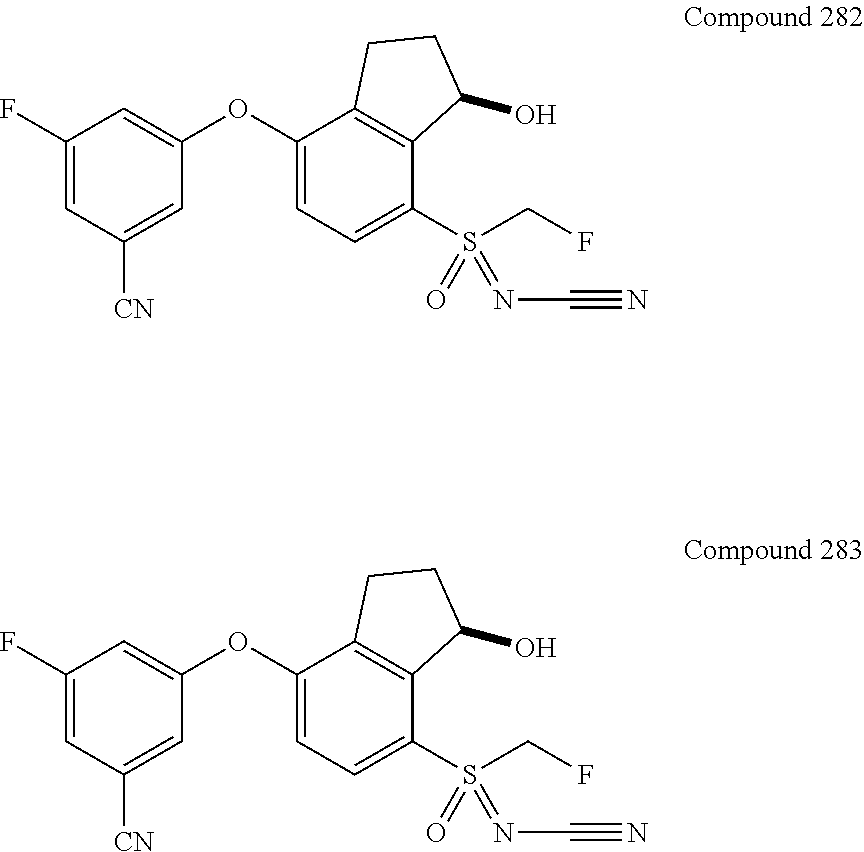
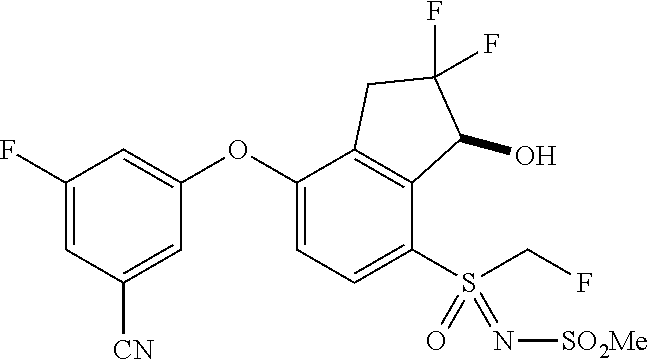
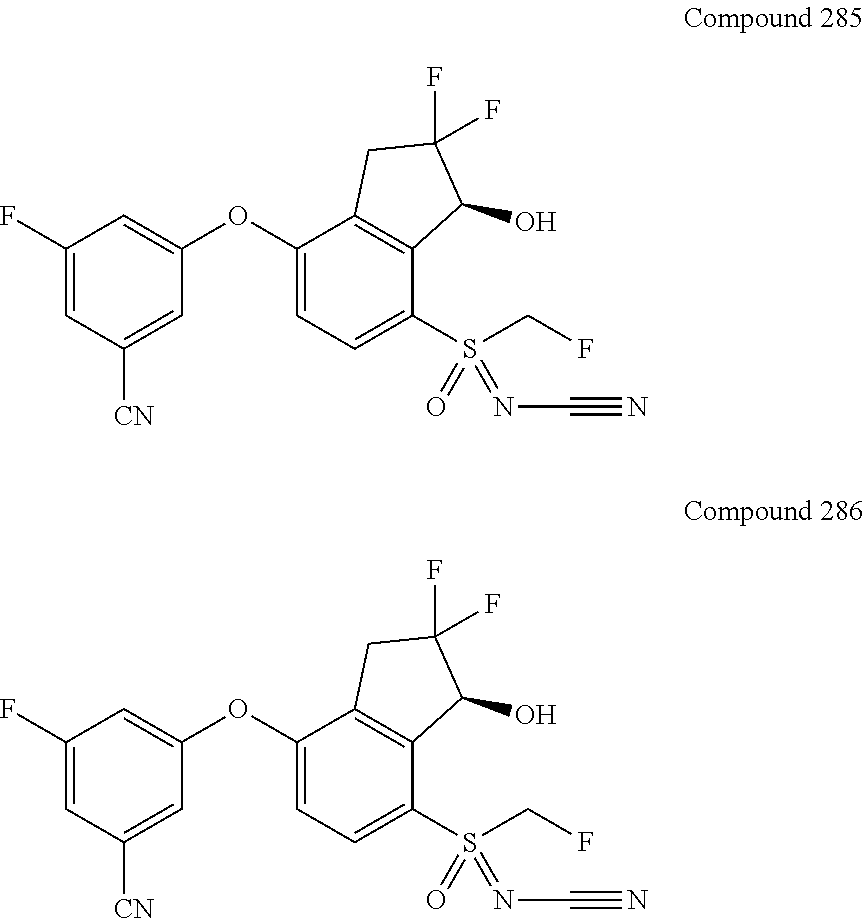
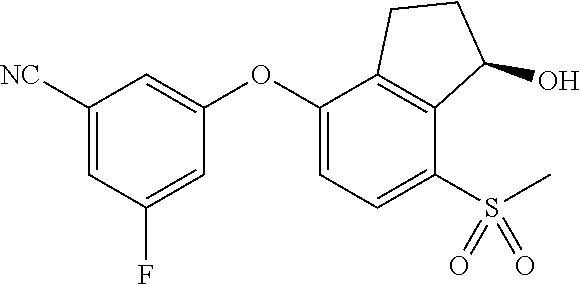
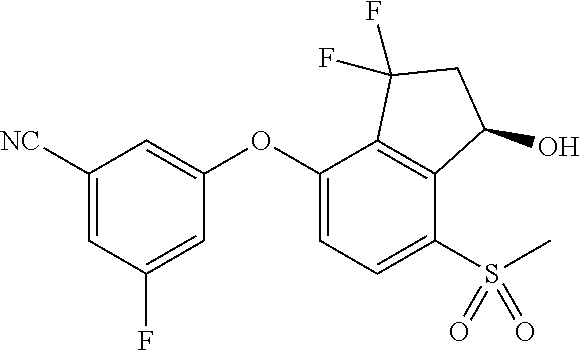

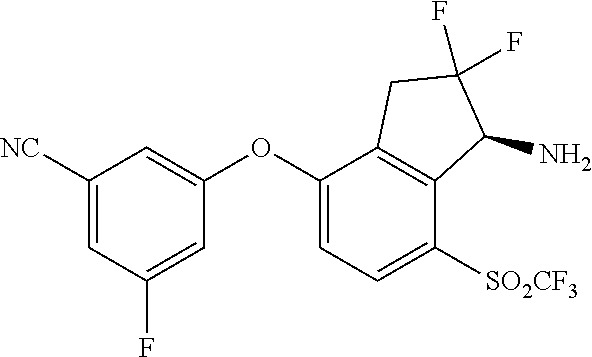

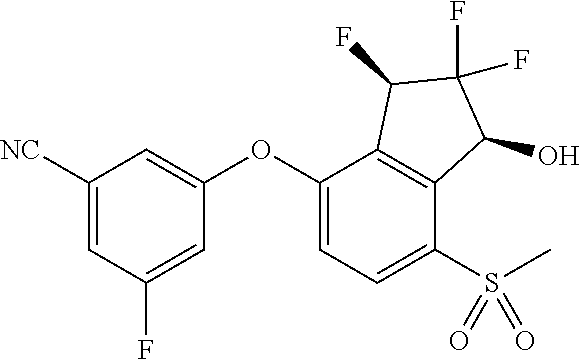



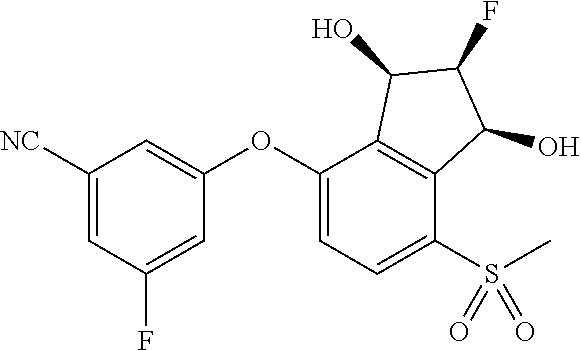
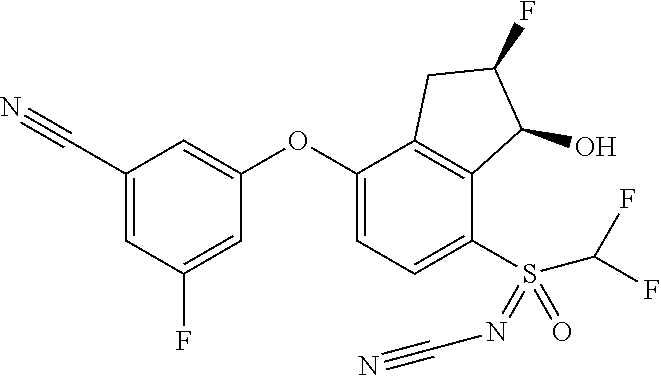
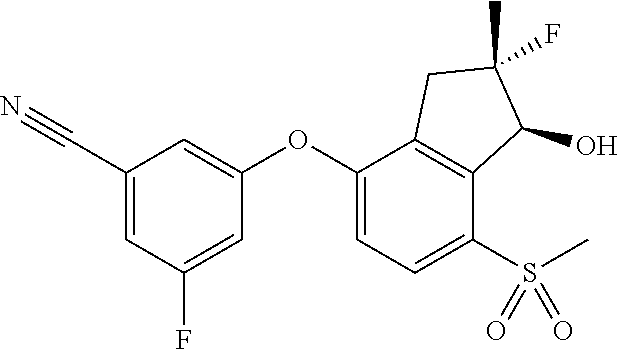
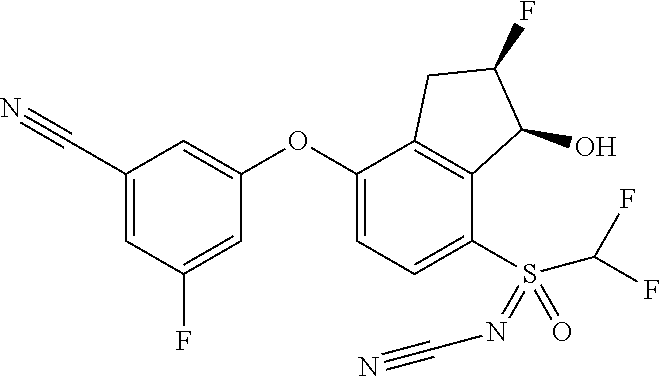
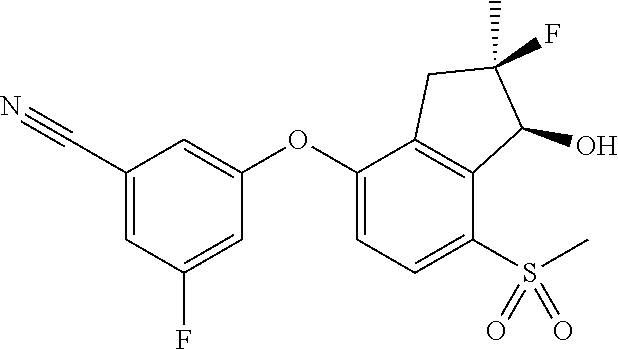
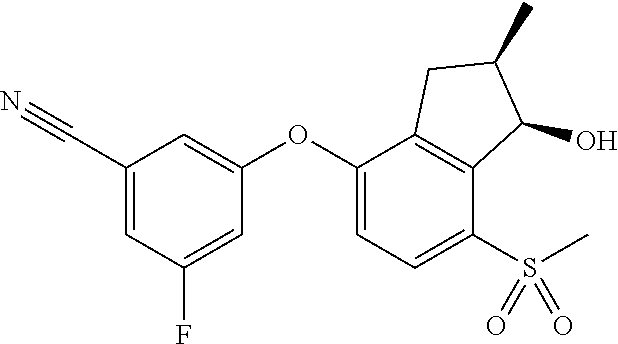

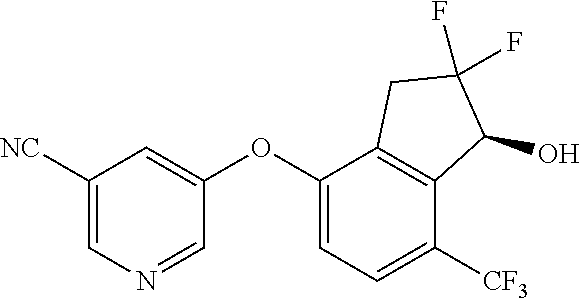
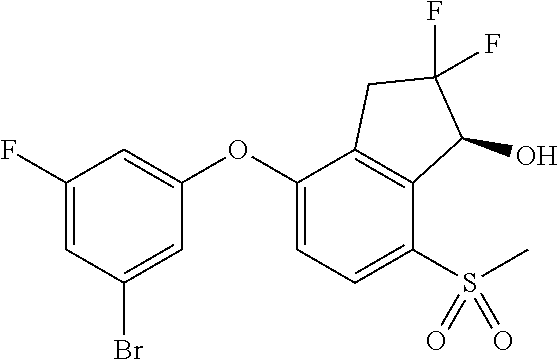
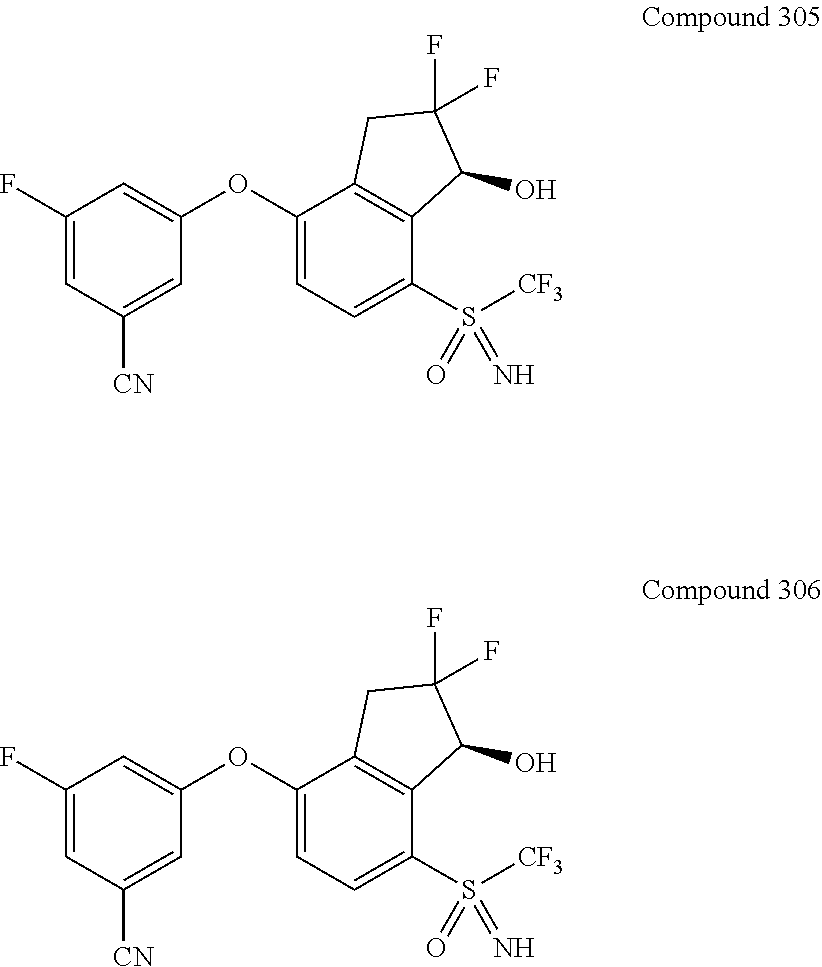
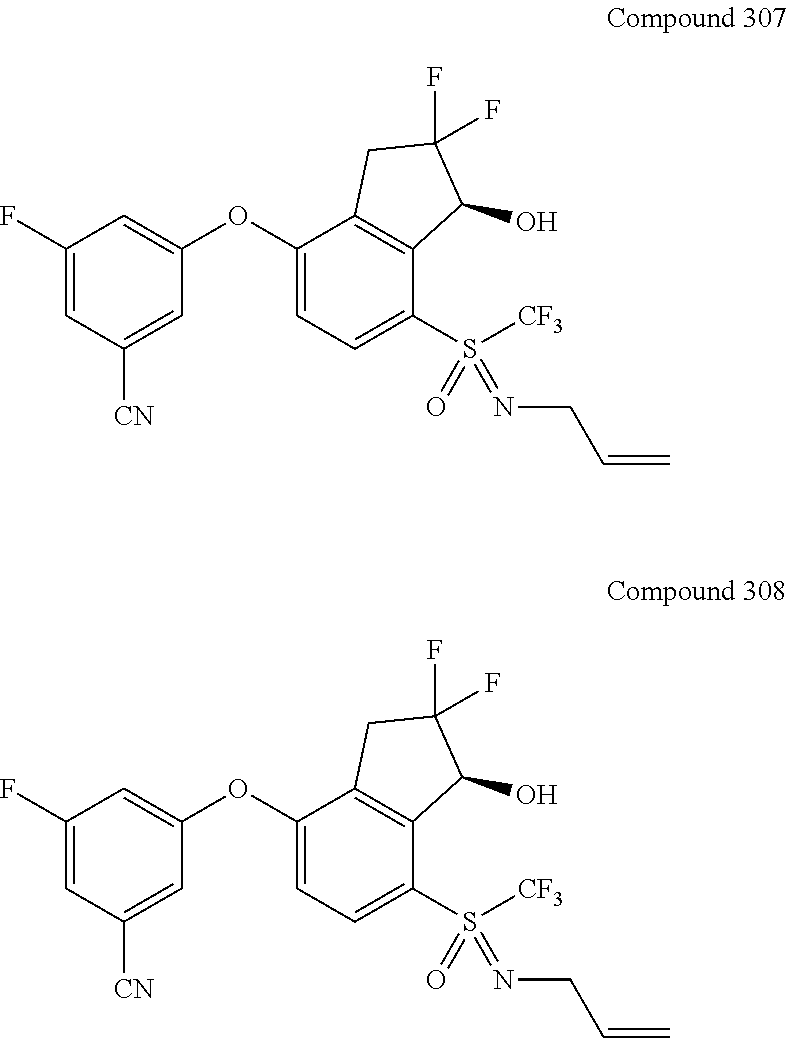
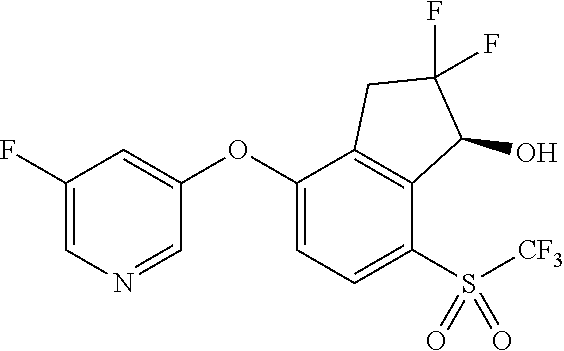
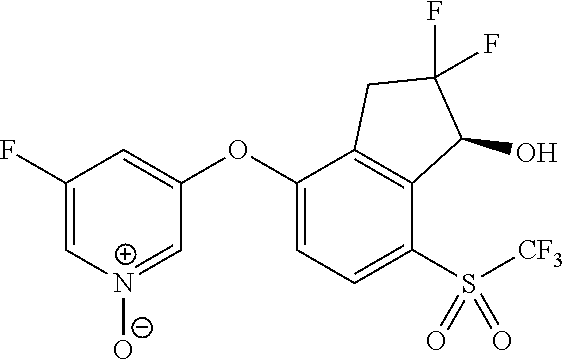


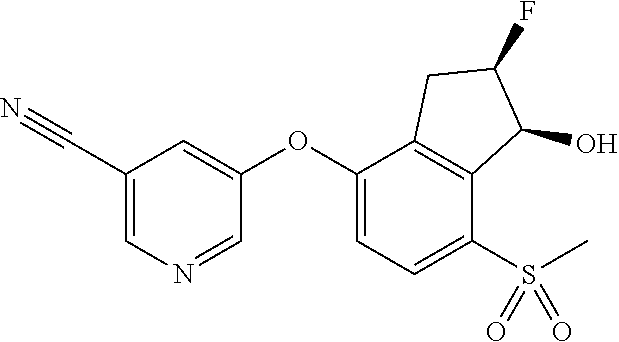
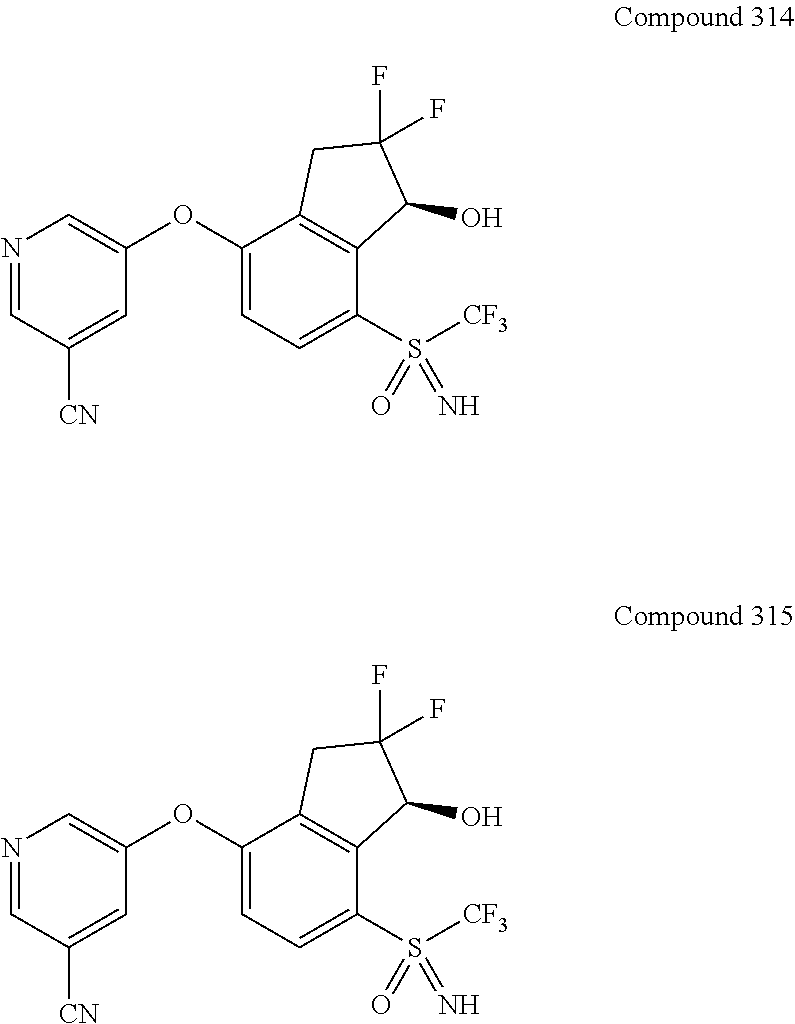
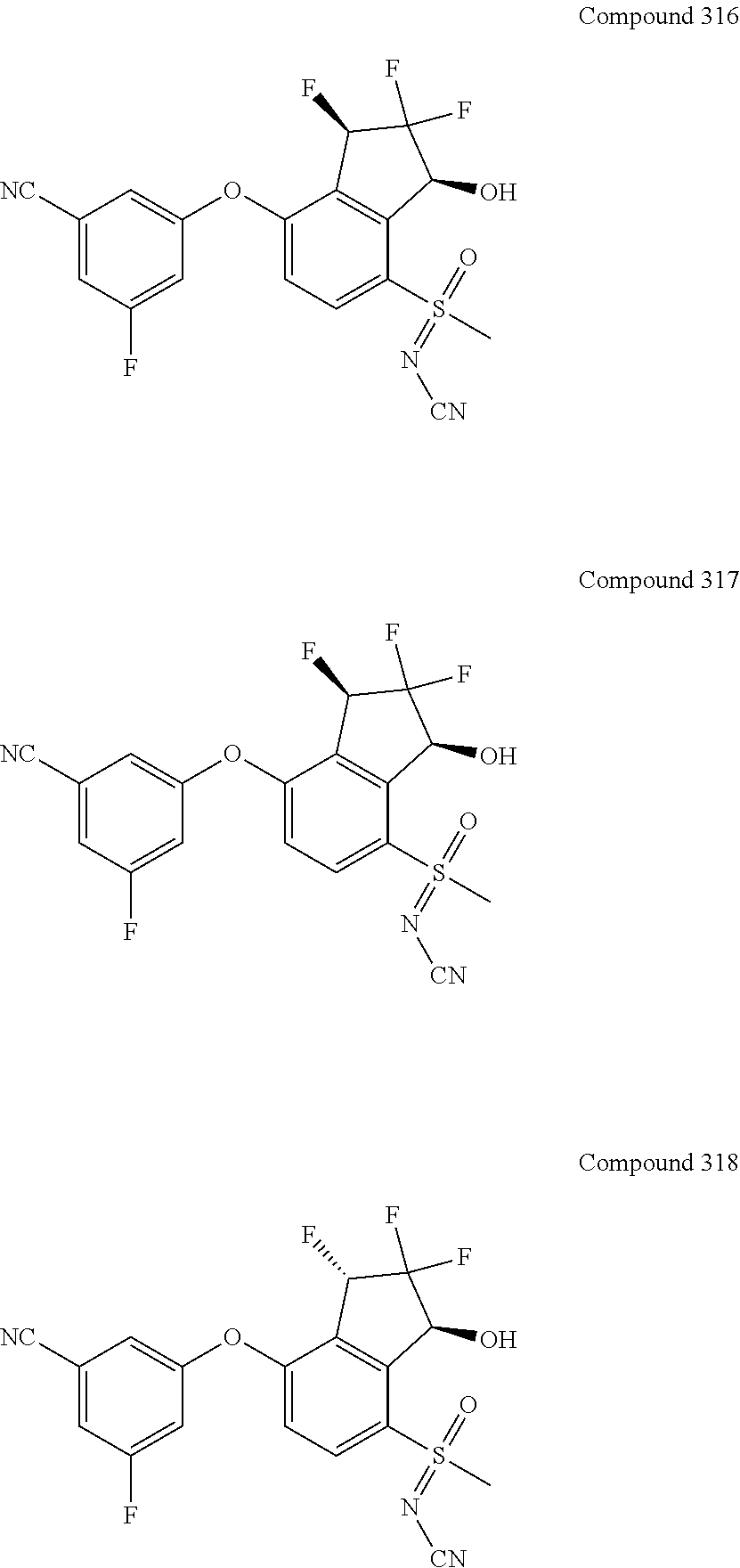
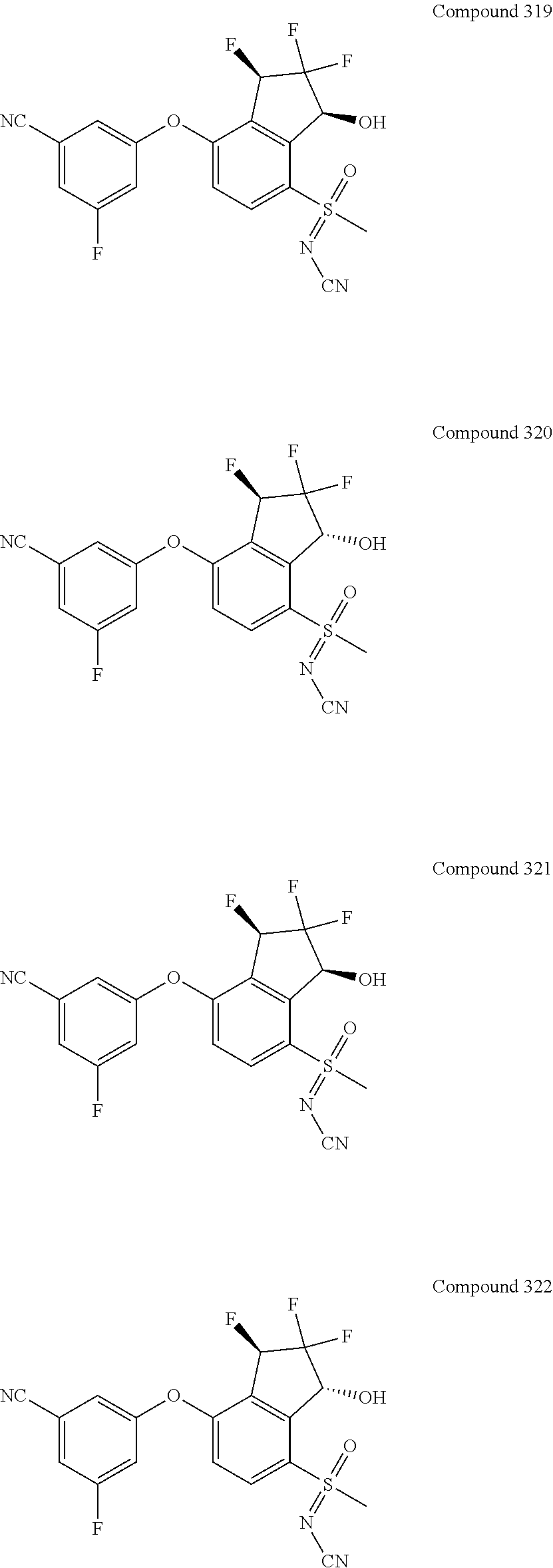
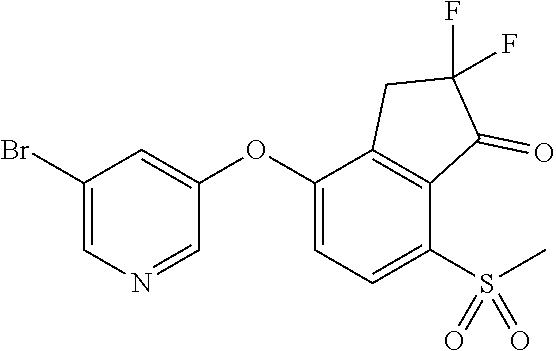

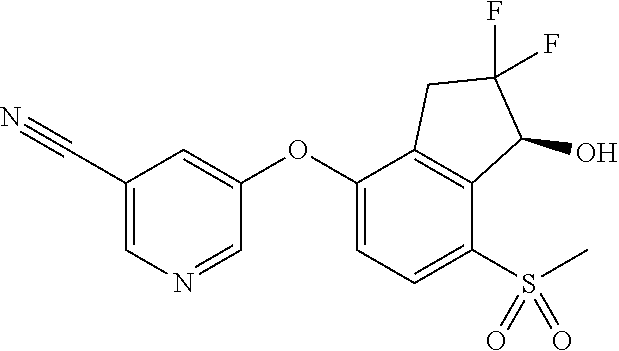
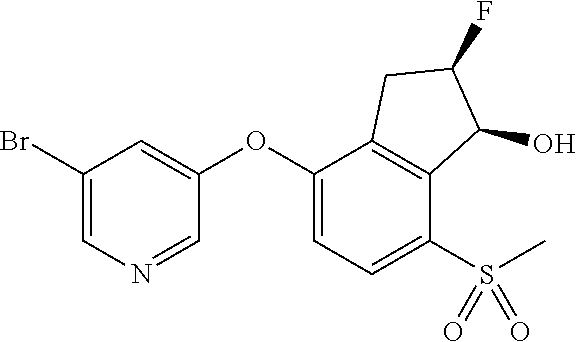


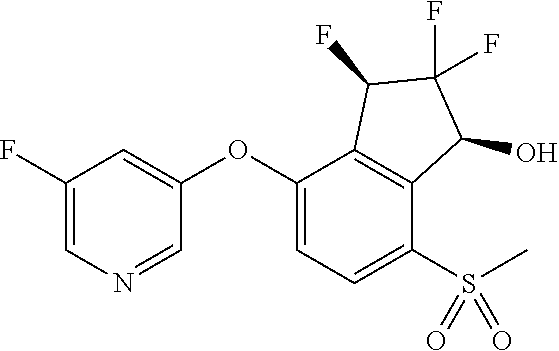
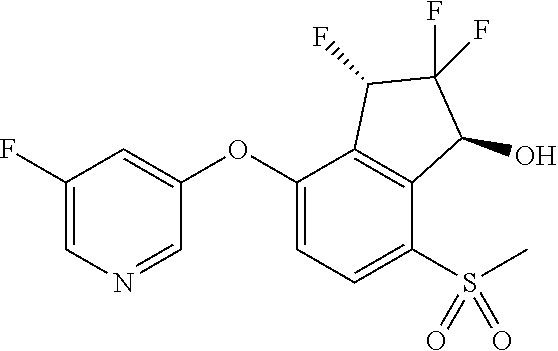
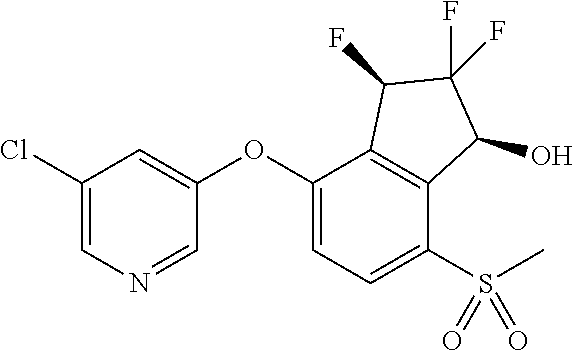




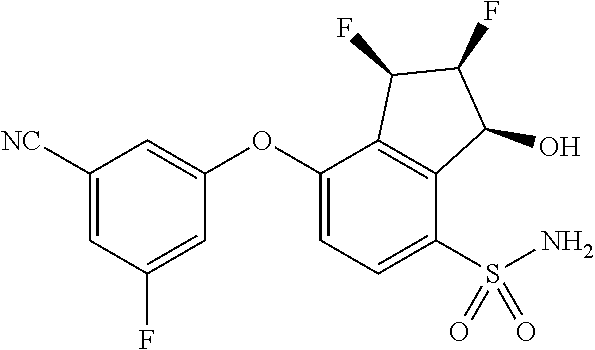
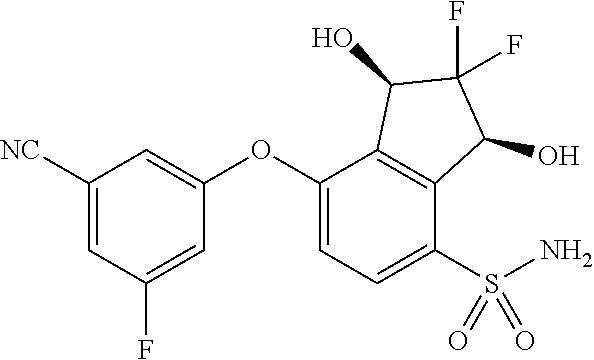
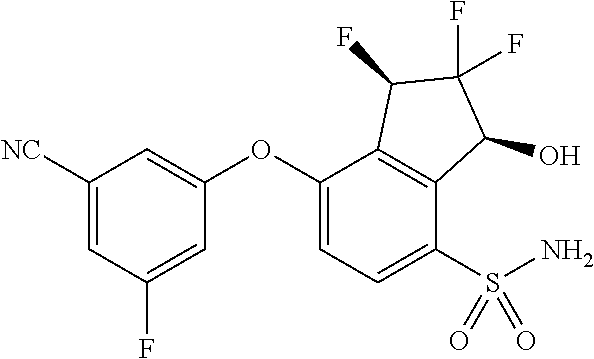
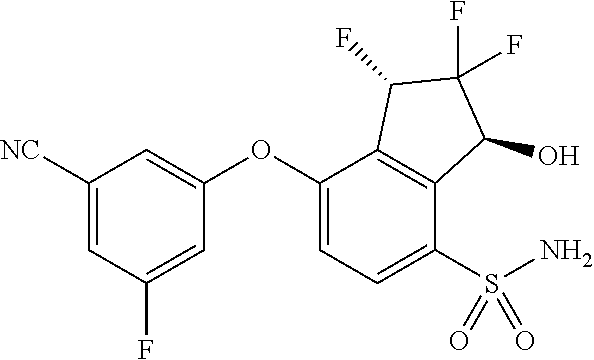
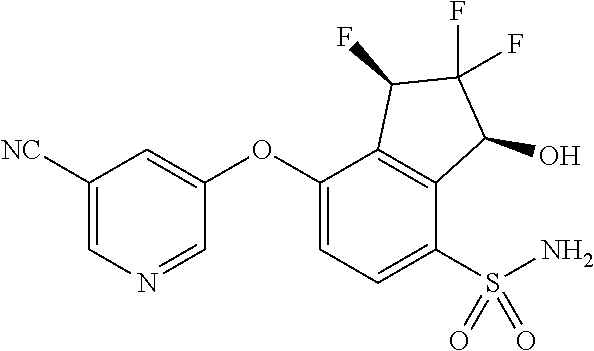
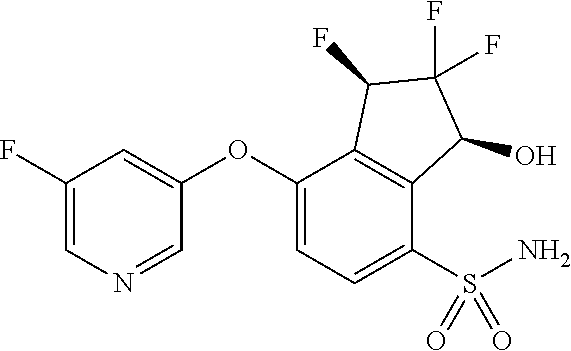
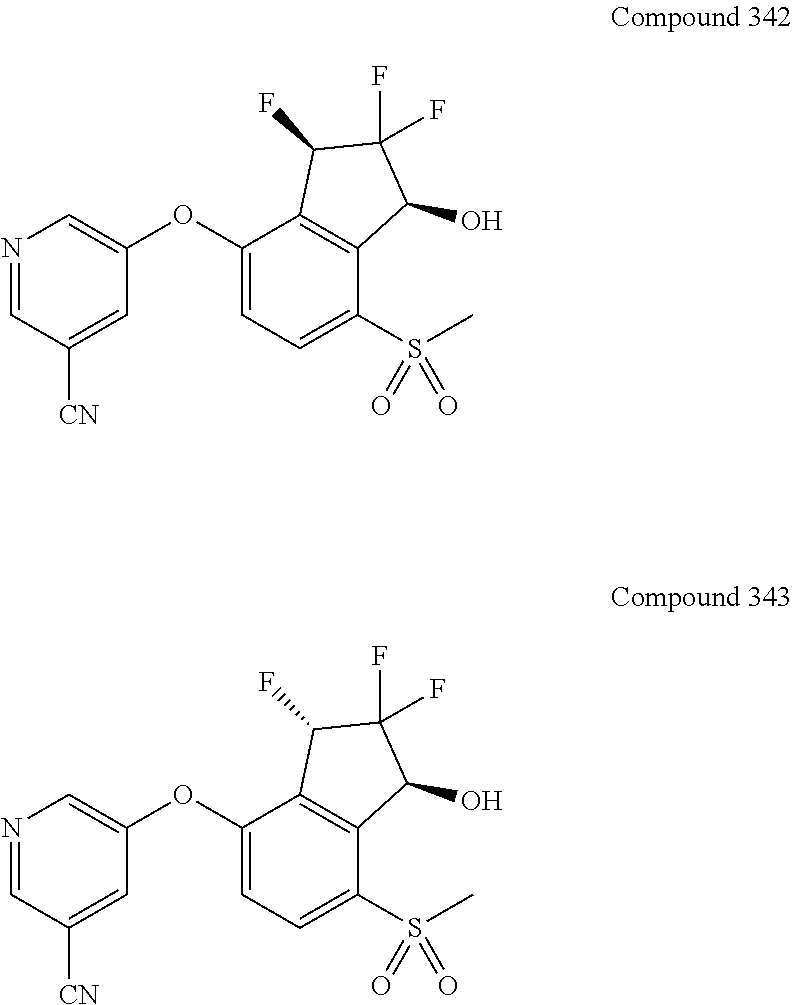
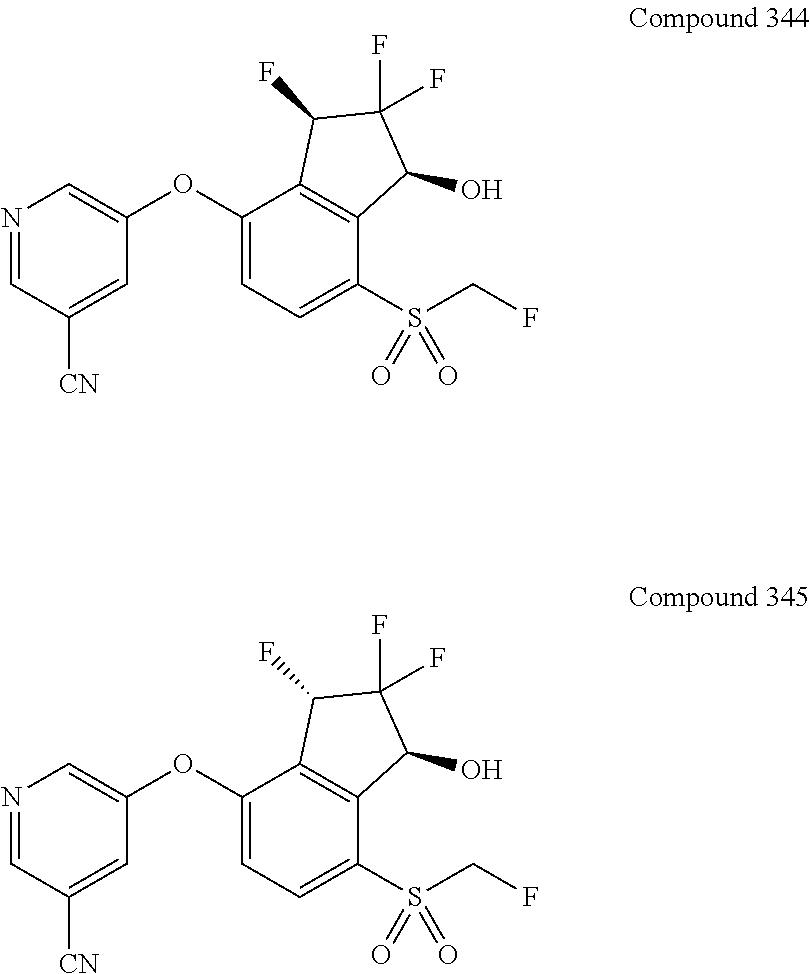
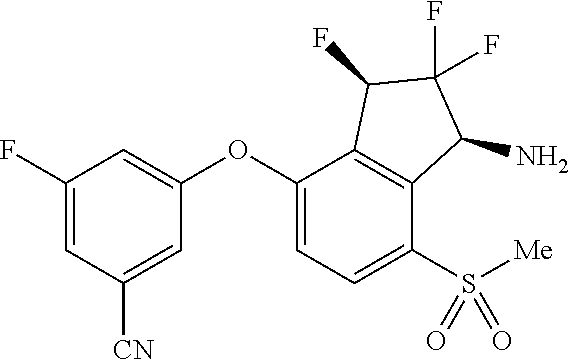

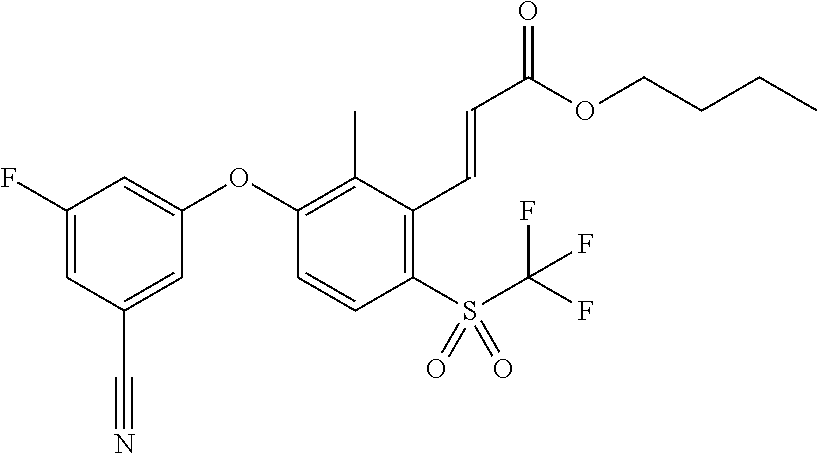
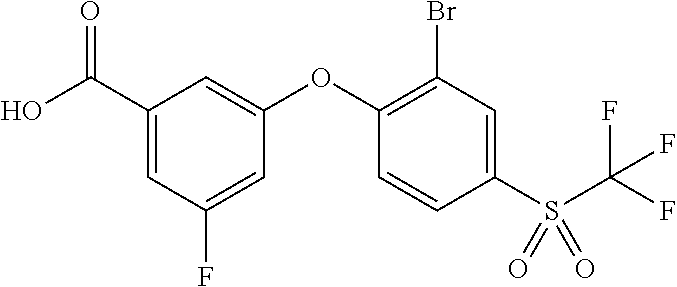
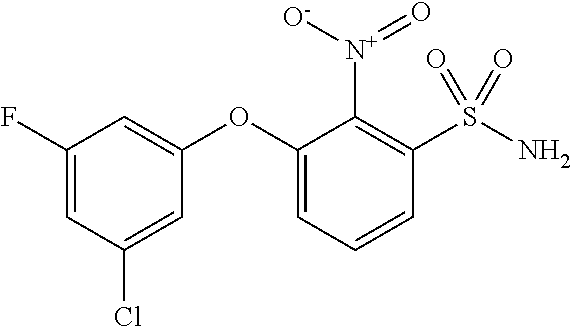
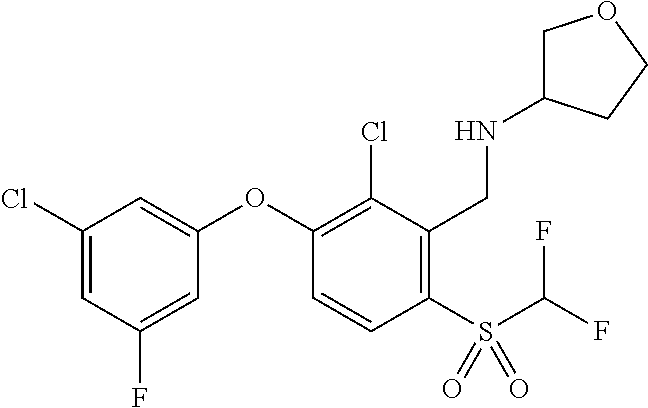


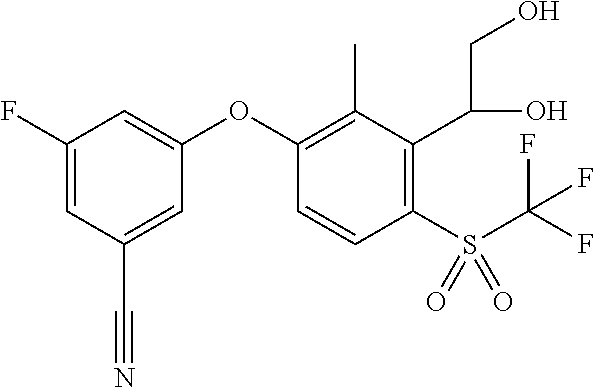
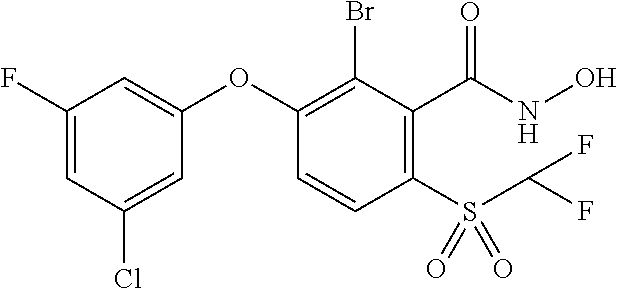
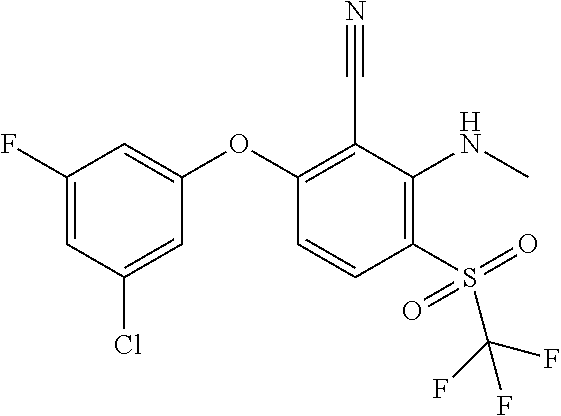

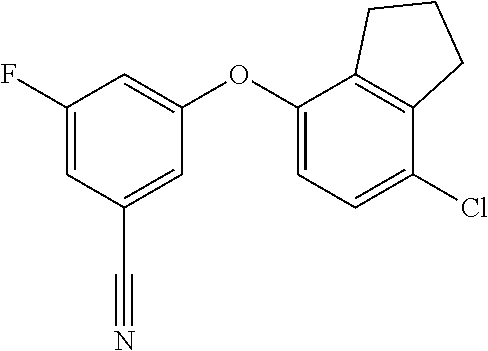

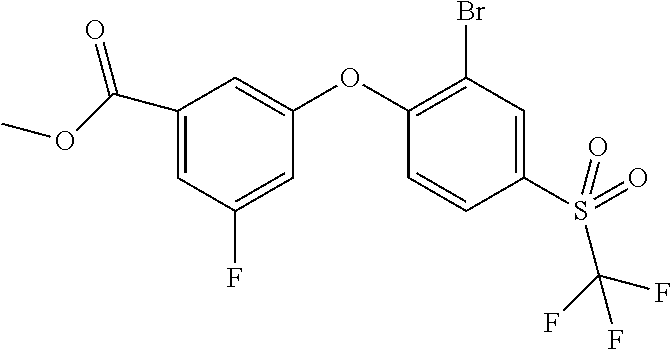
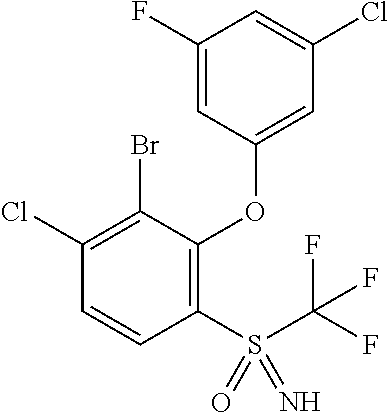
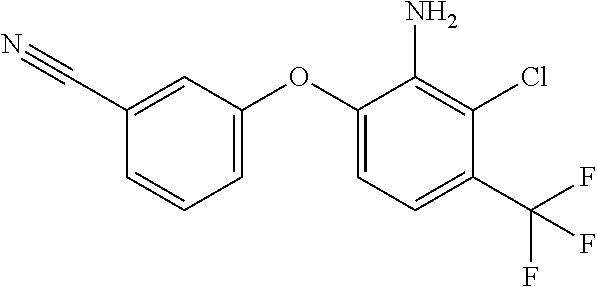
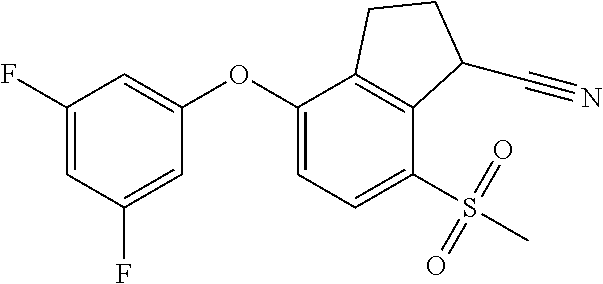
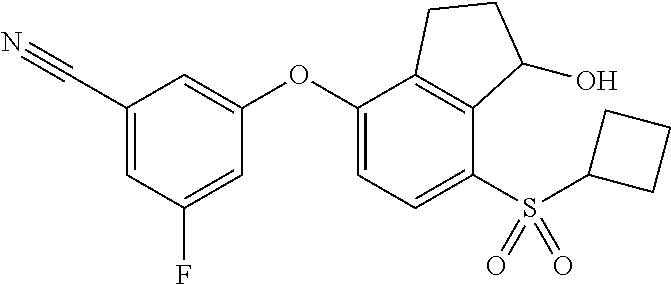
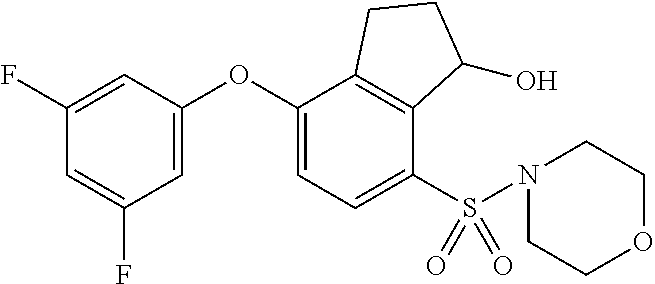
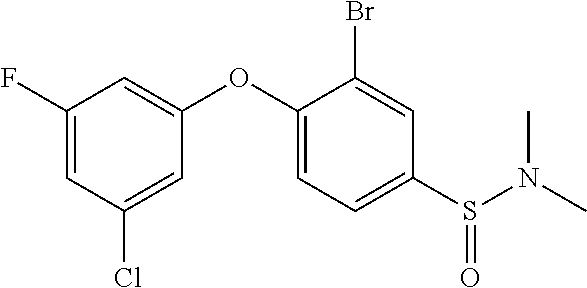

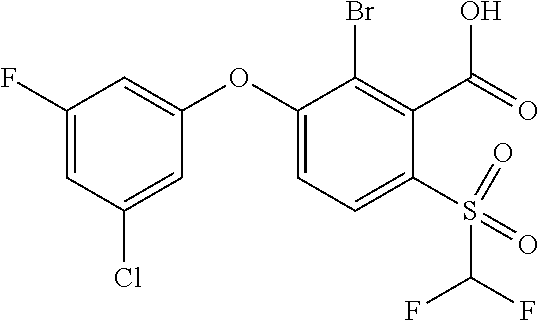
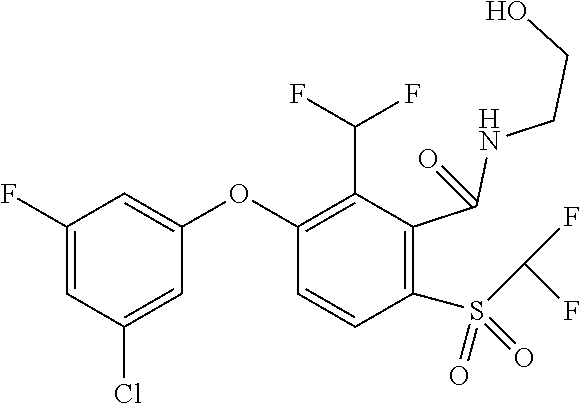
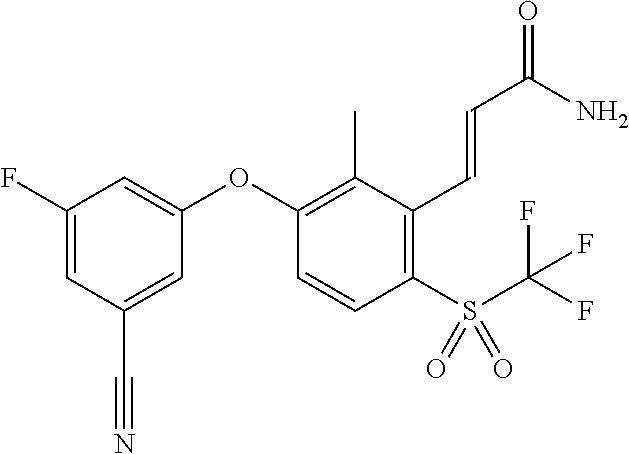
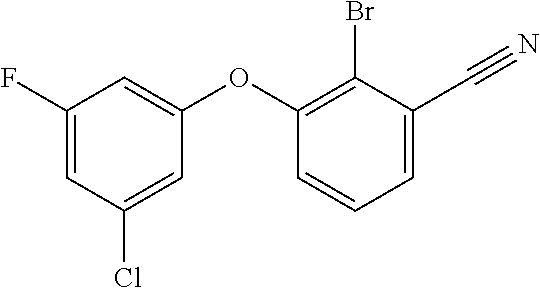



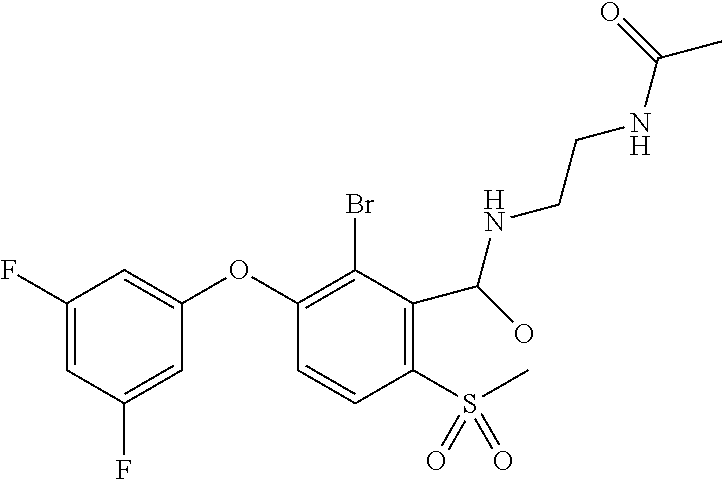
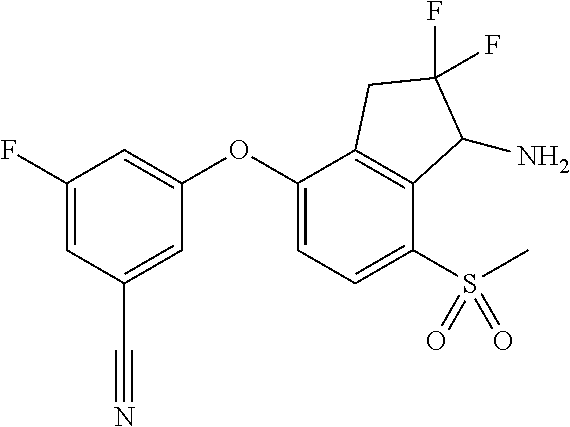
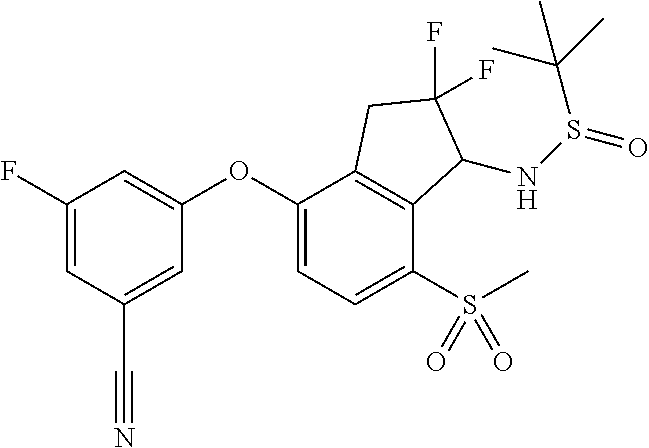
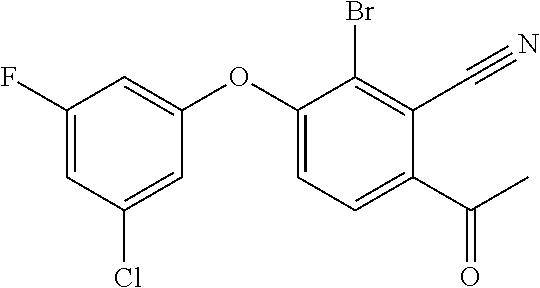
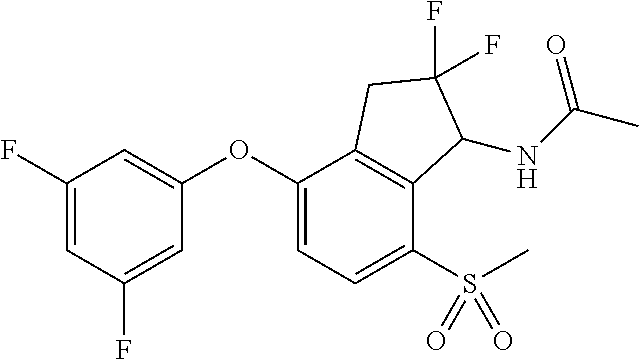
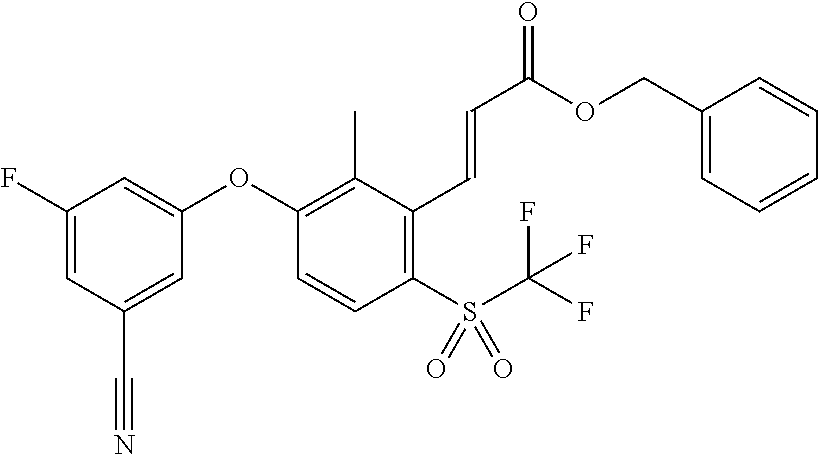
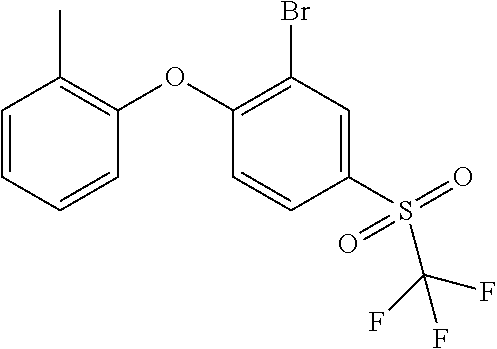
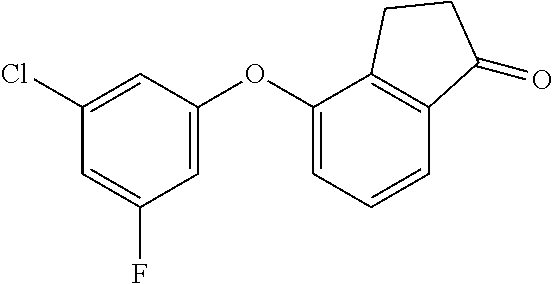
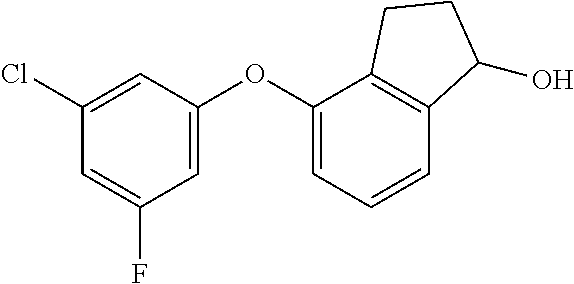
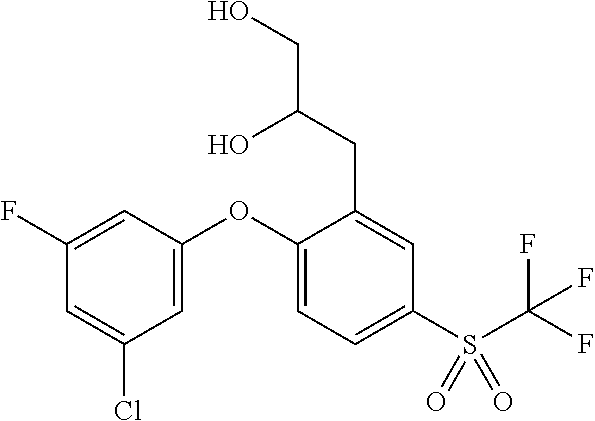
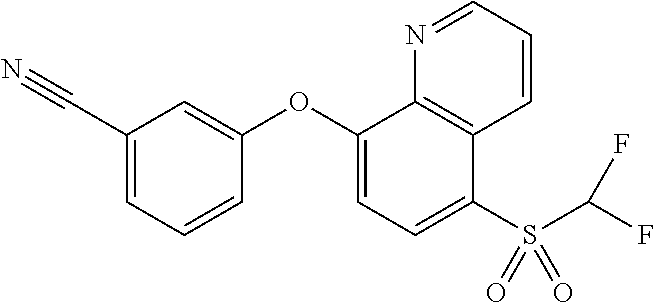
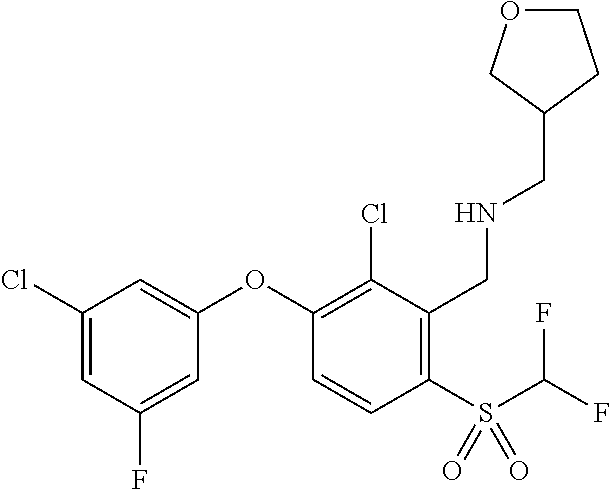


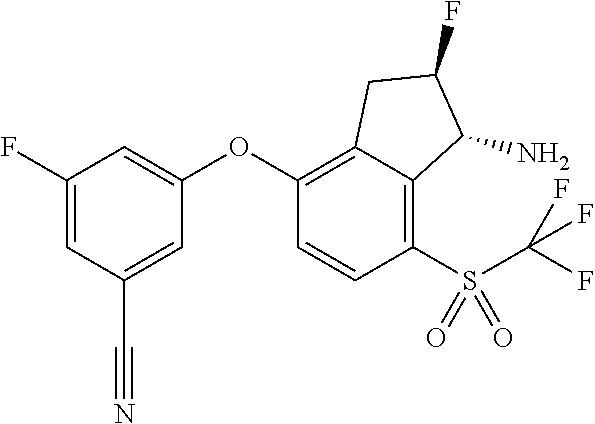
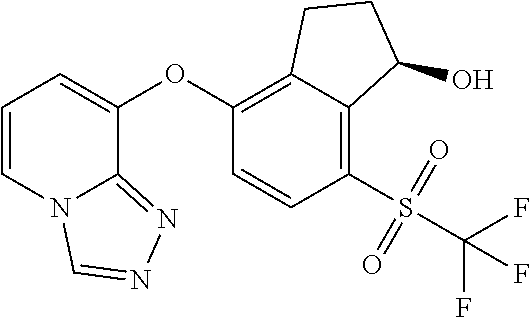

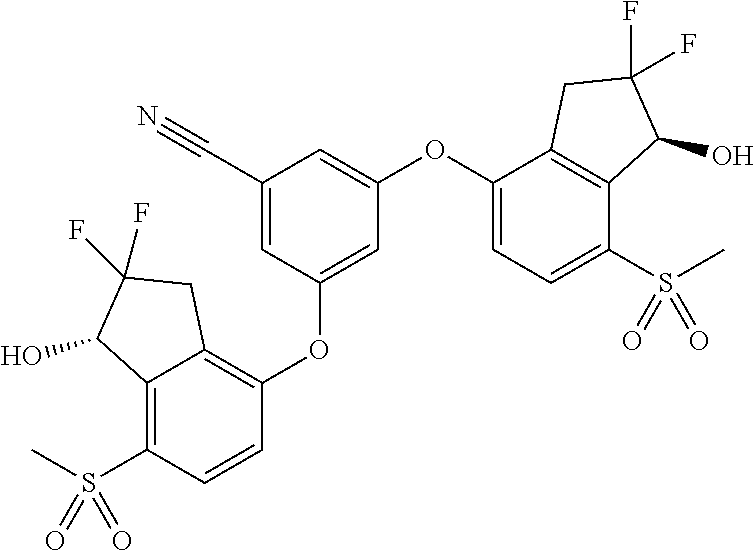

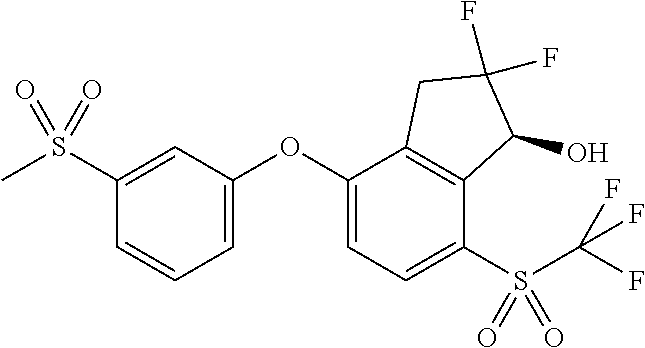

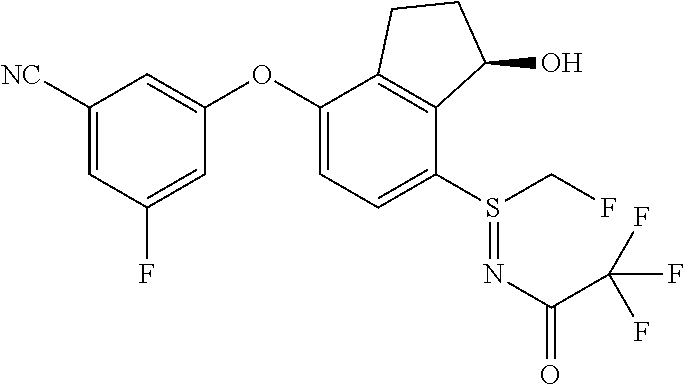
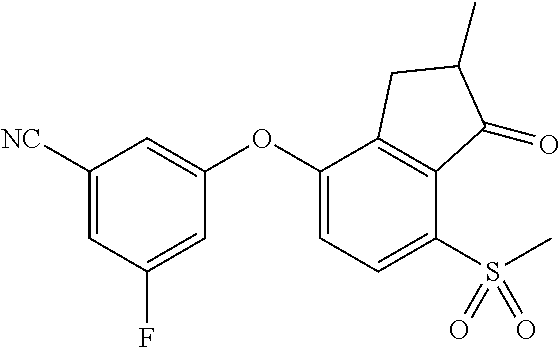
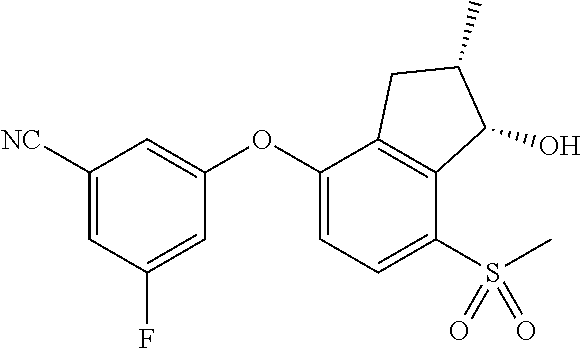
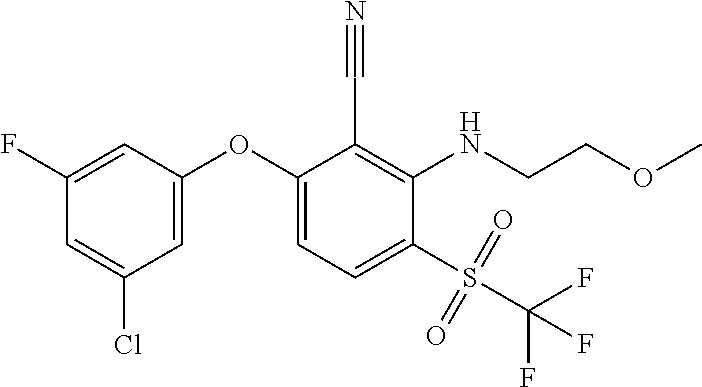
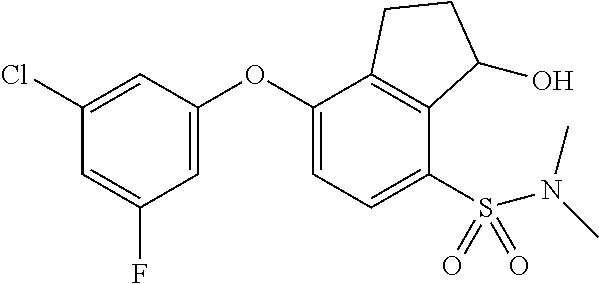

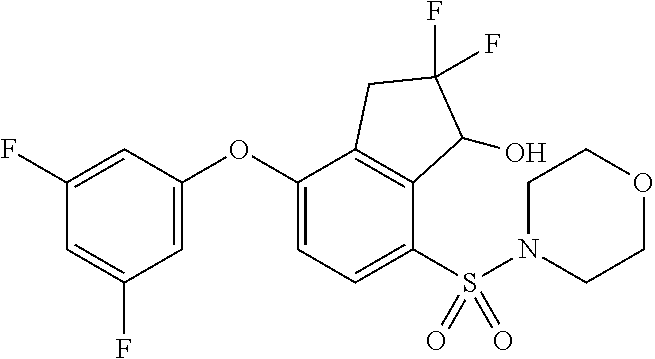
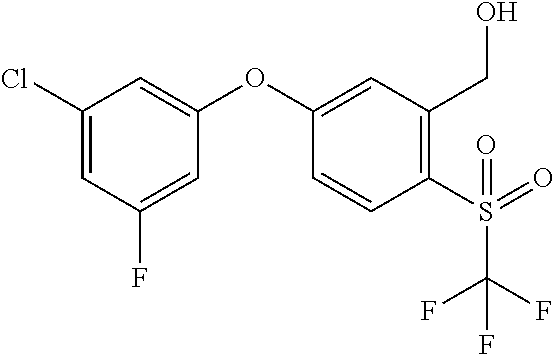
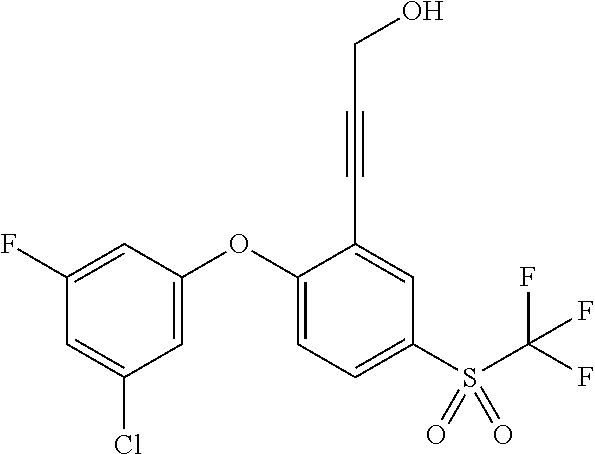


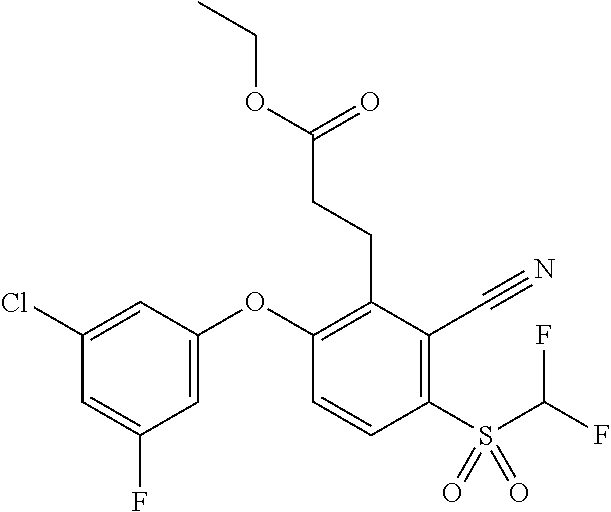
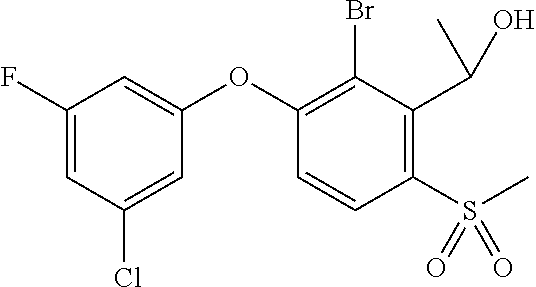
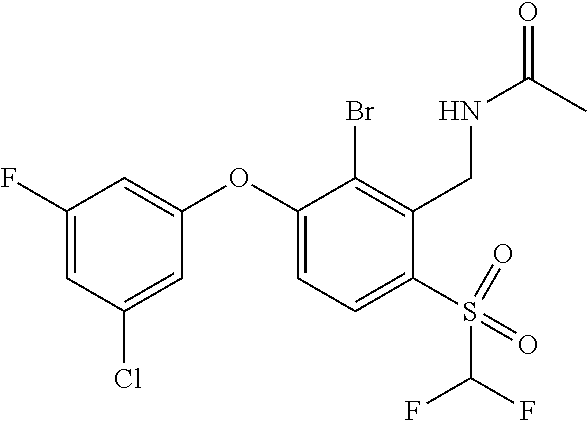


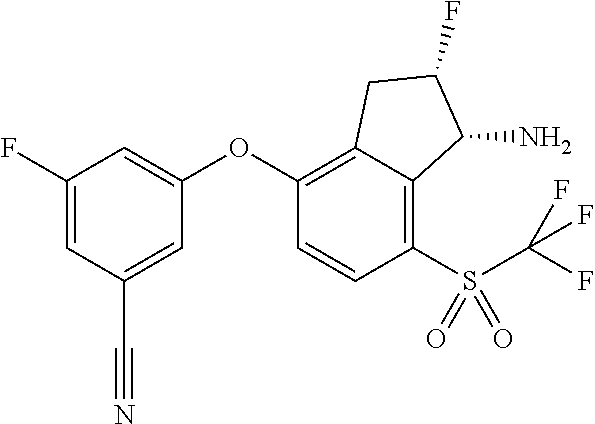
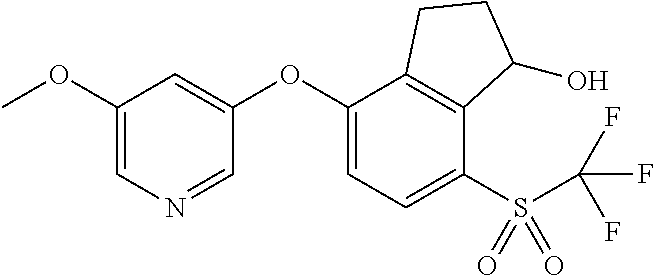

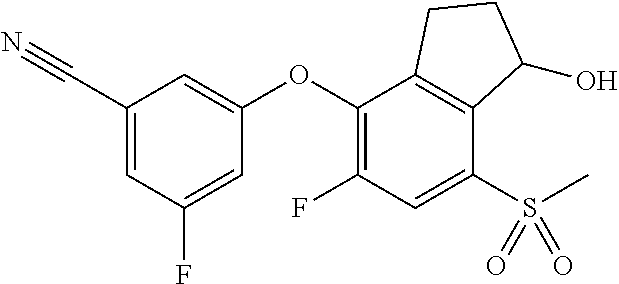

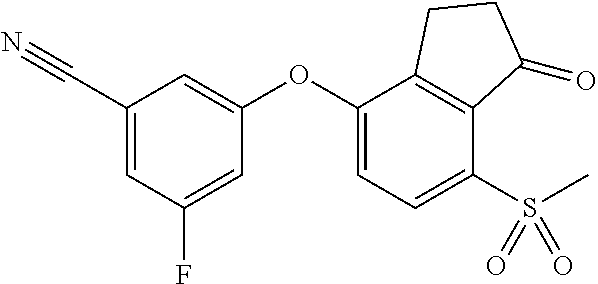
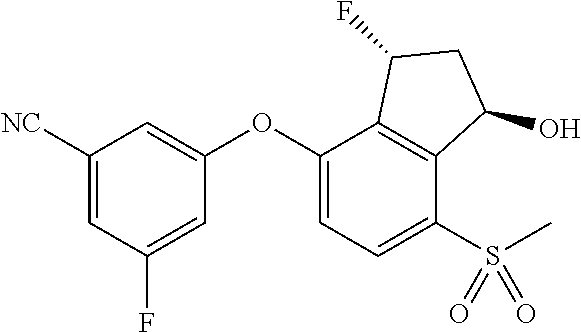
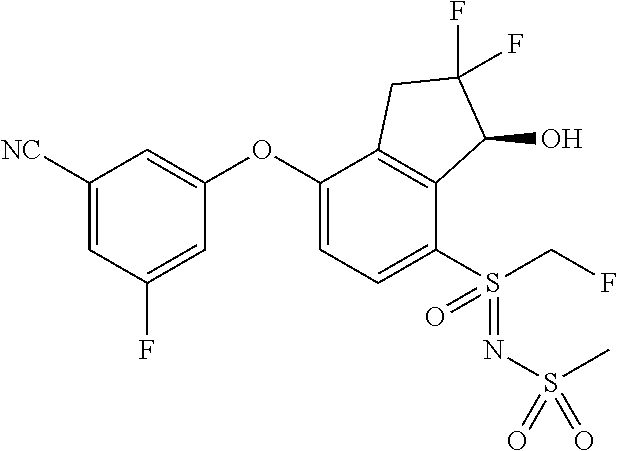


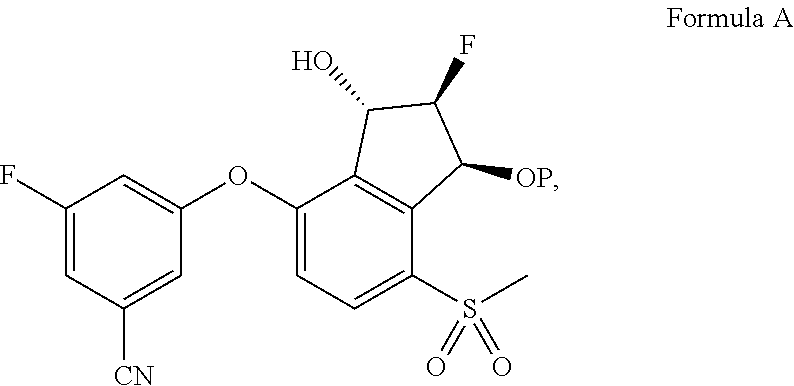
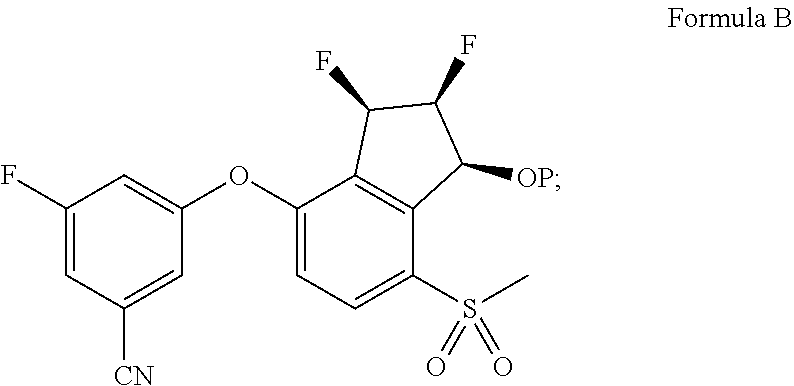
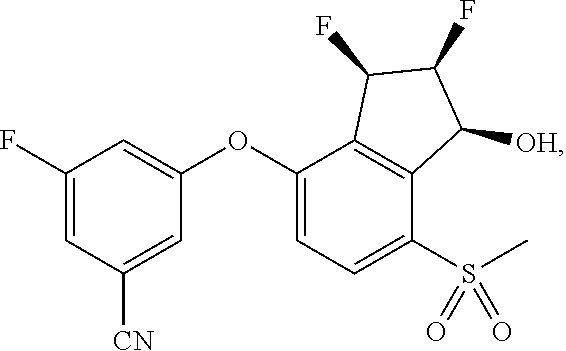
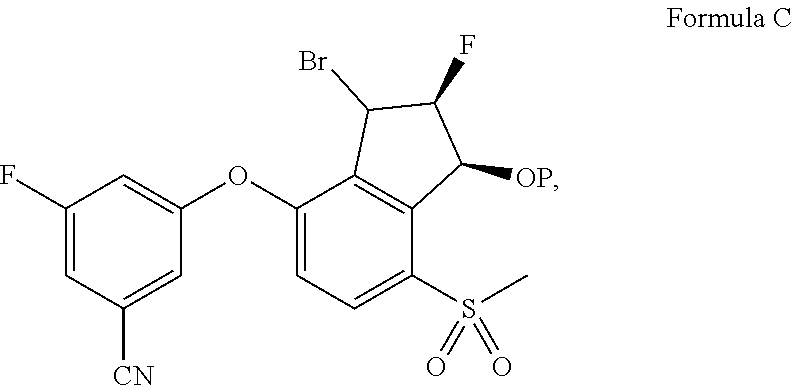

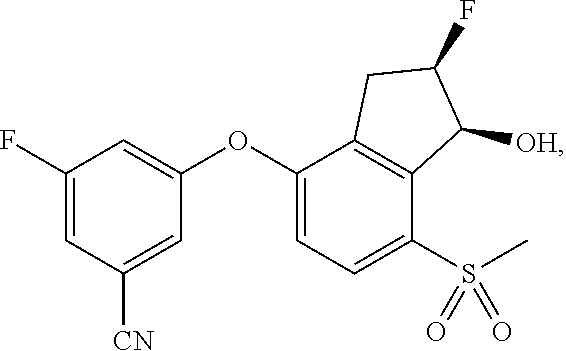
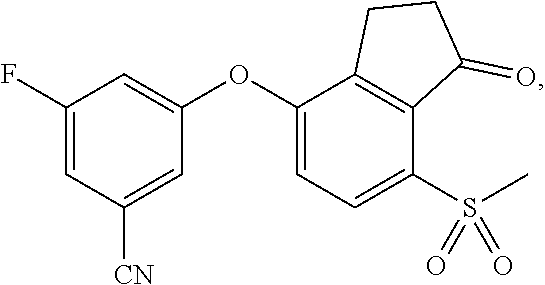
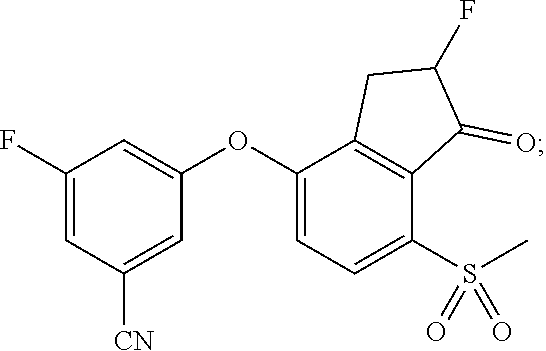

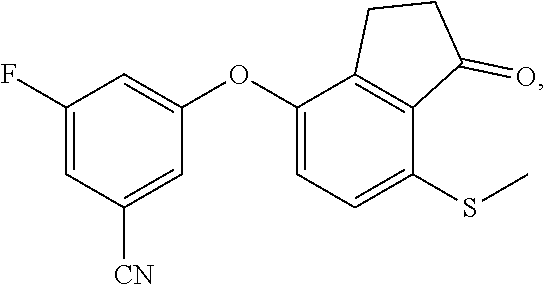
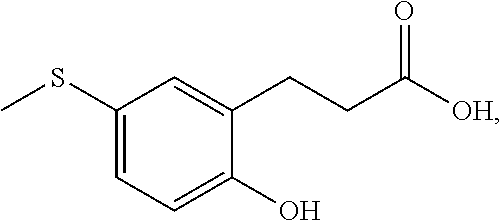
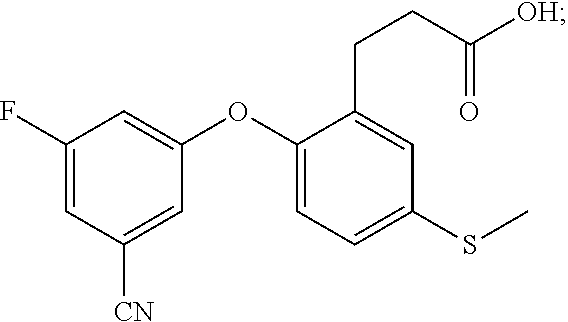
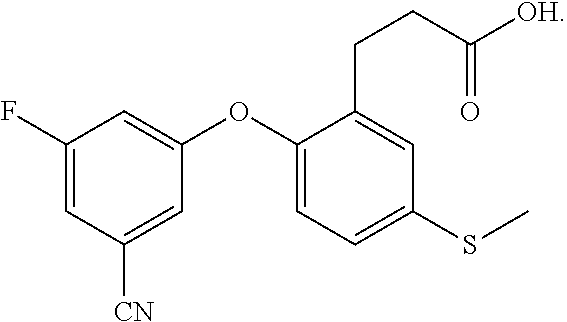
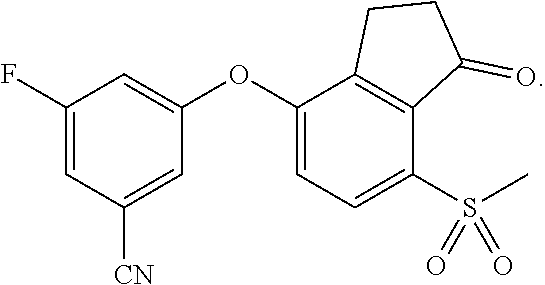
D00001
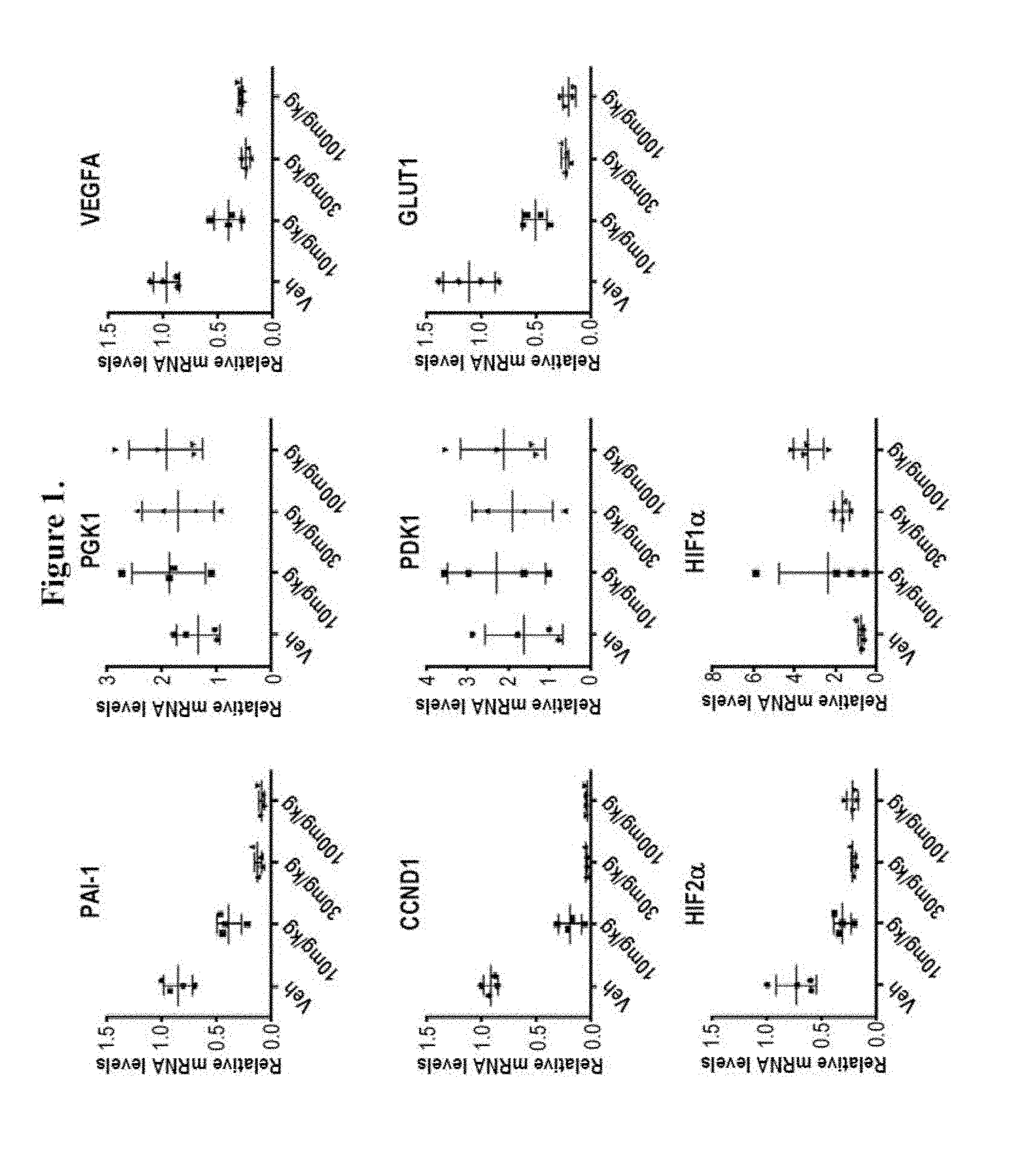
D00002
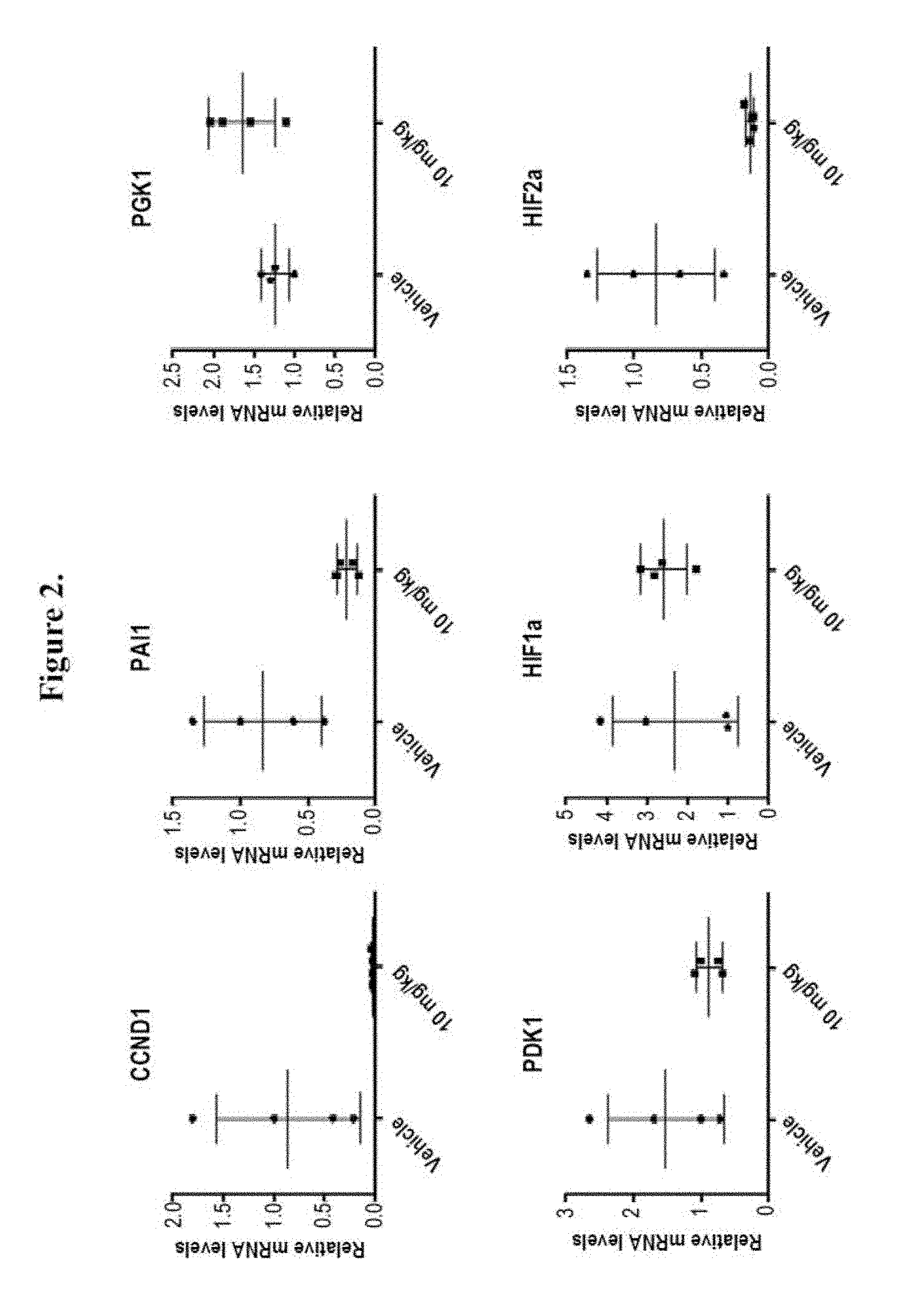
D00003
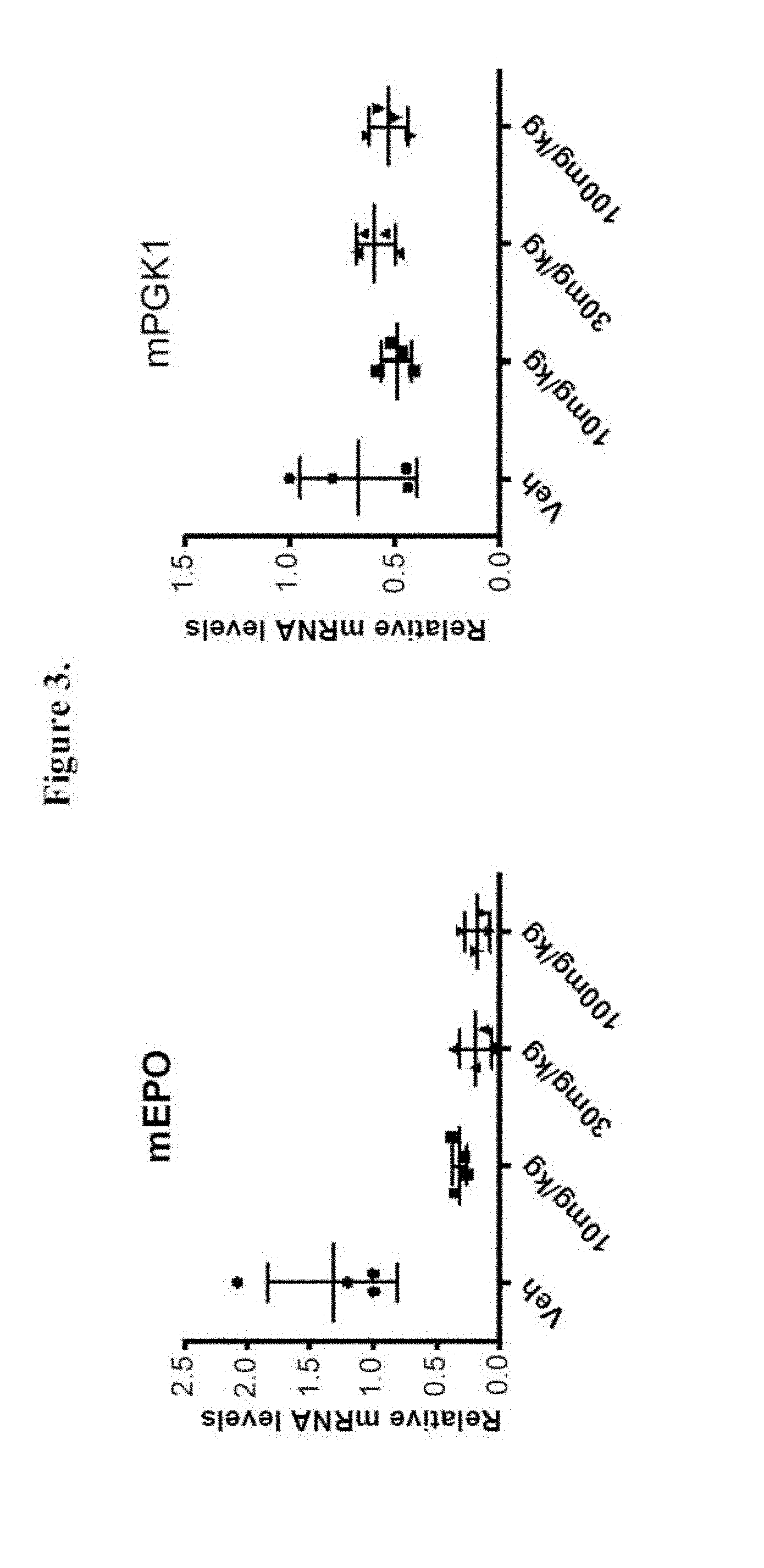
D00004
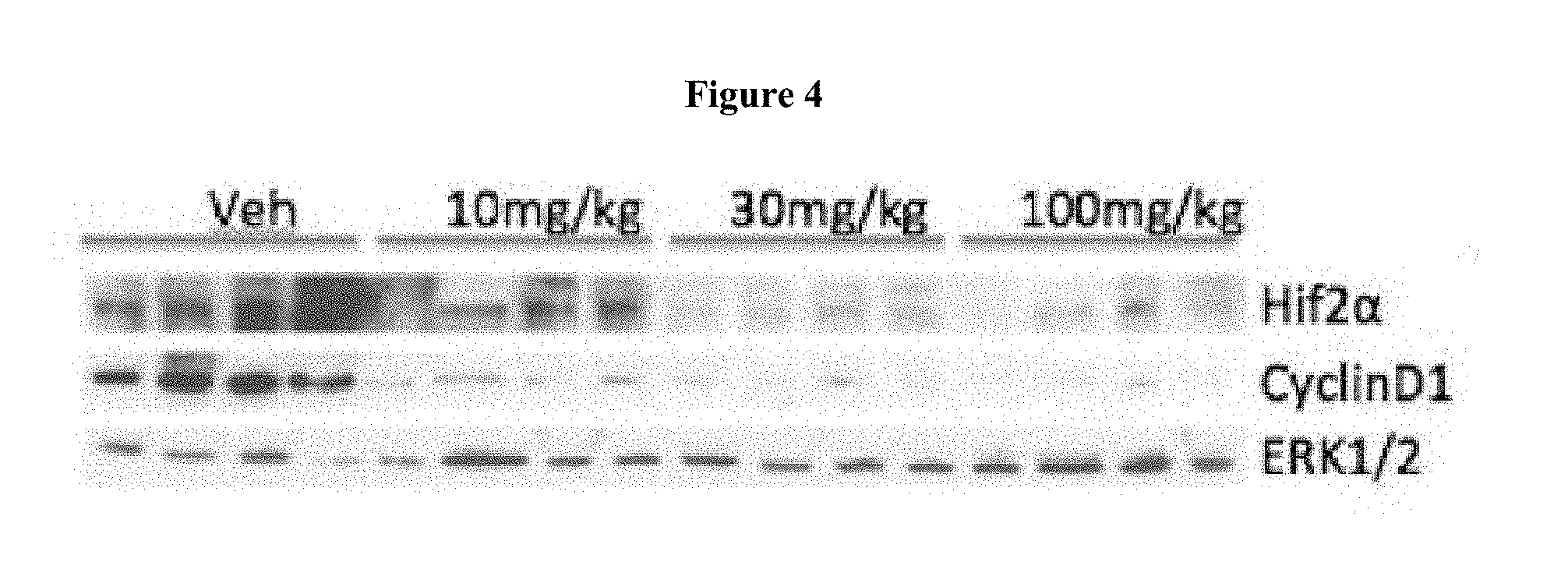
D00005
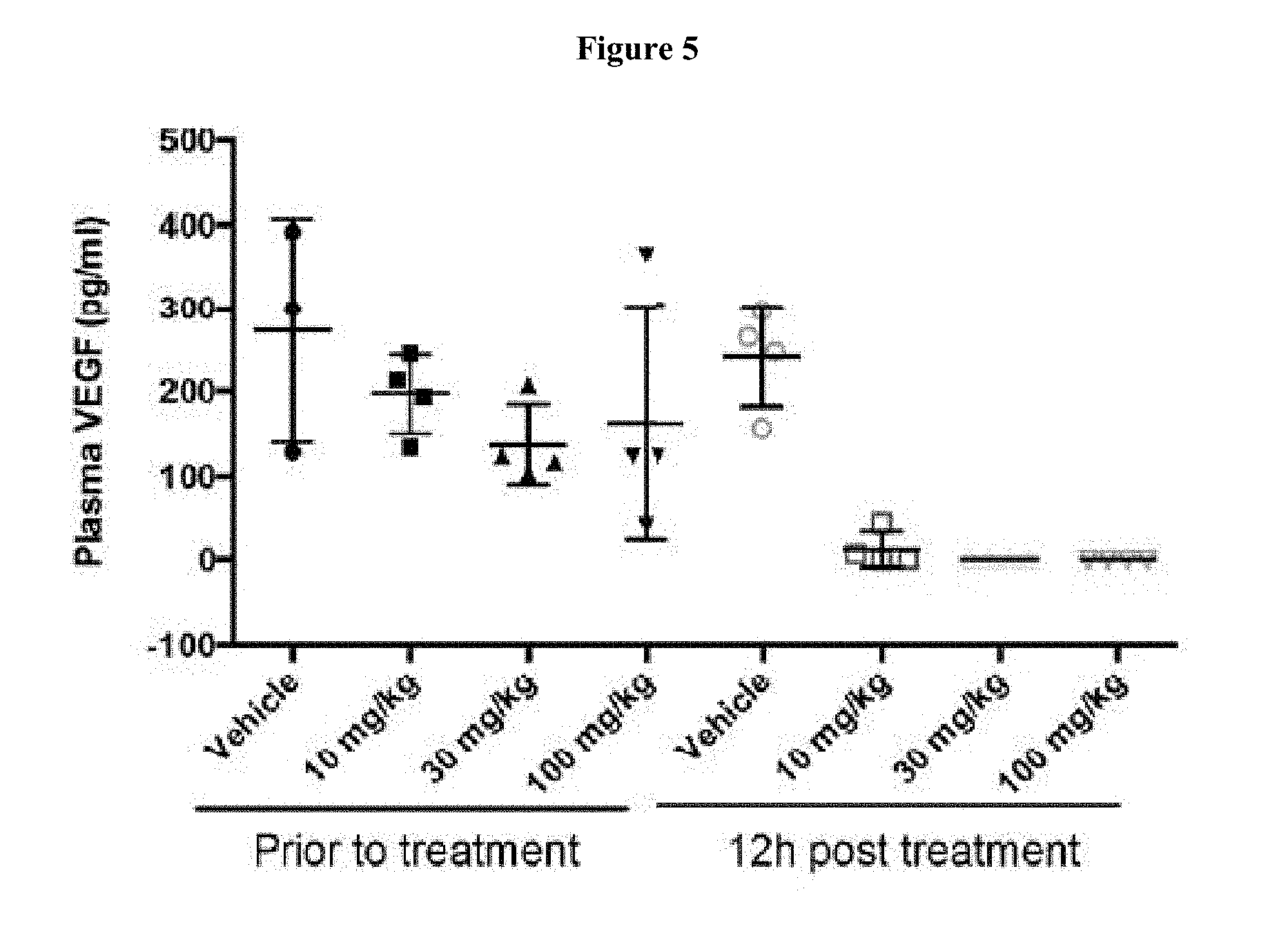
D00006
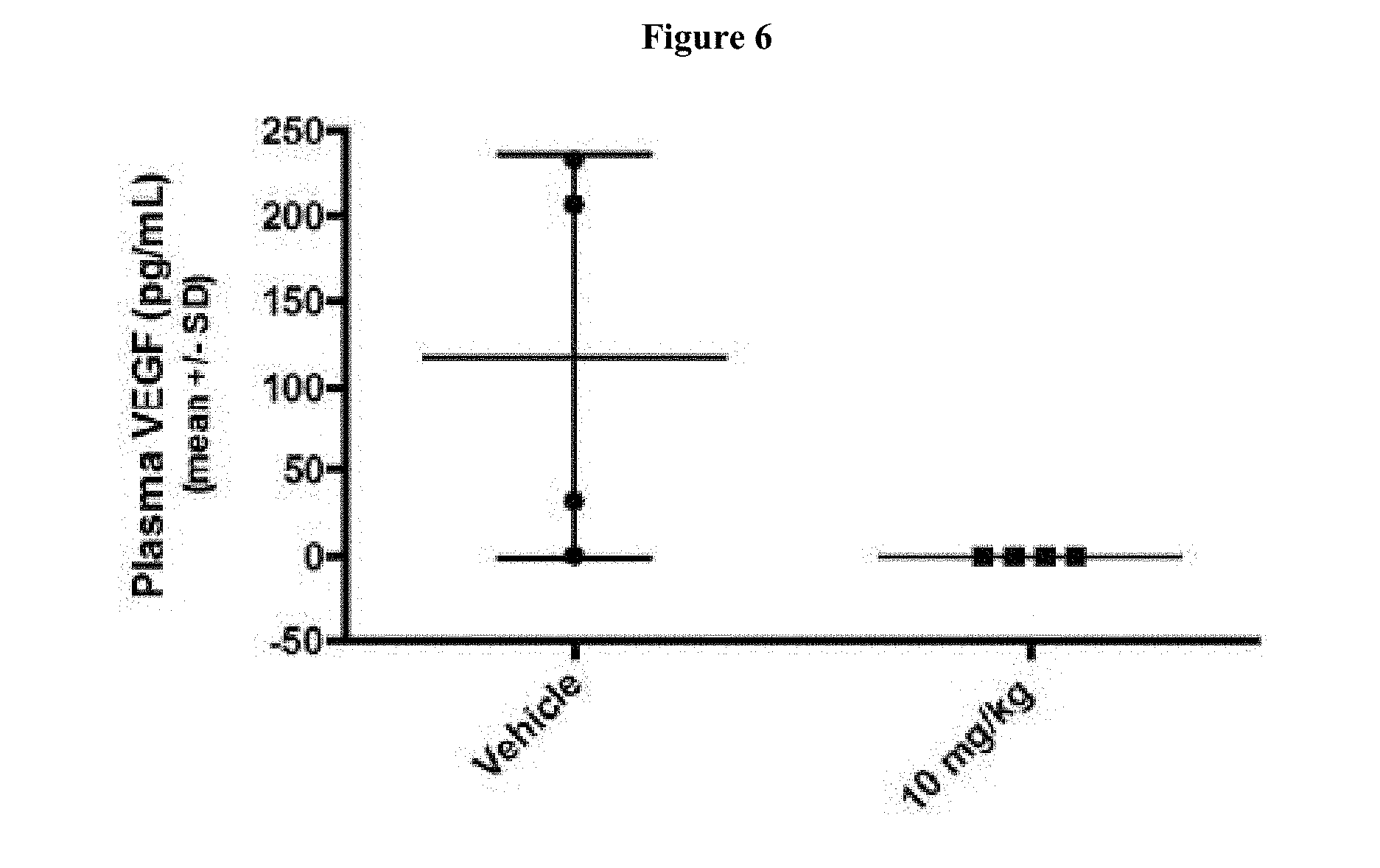
D00007
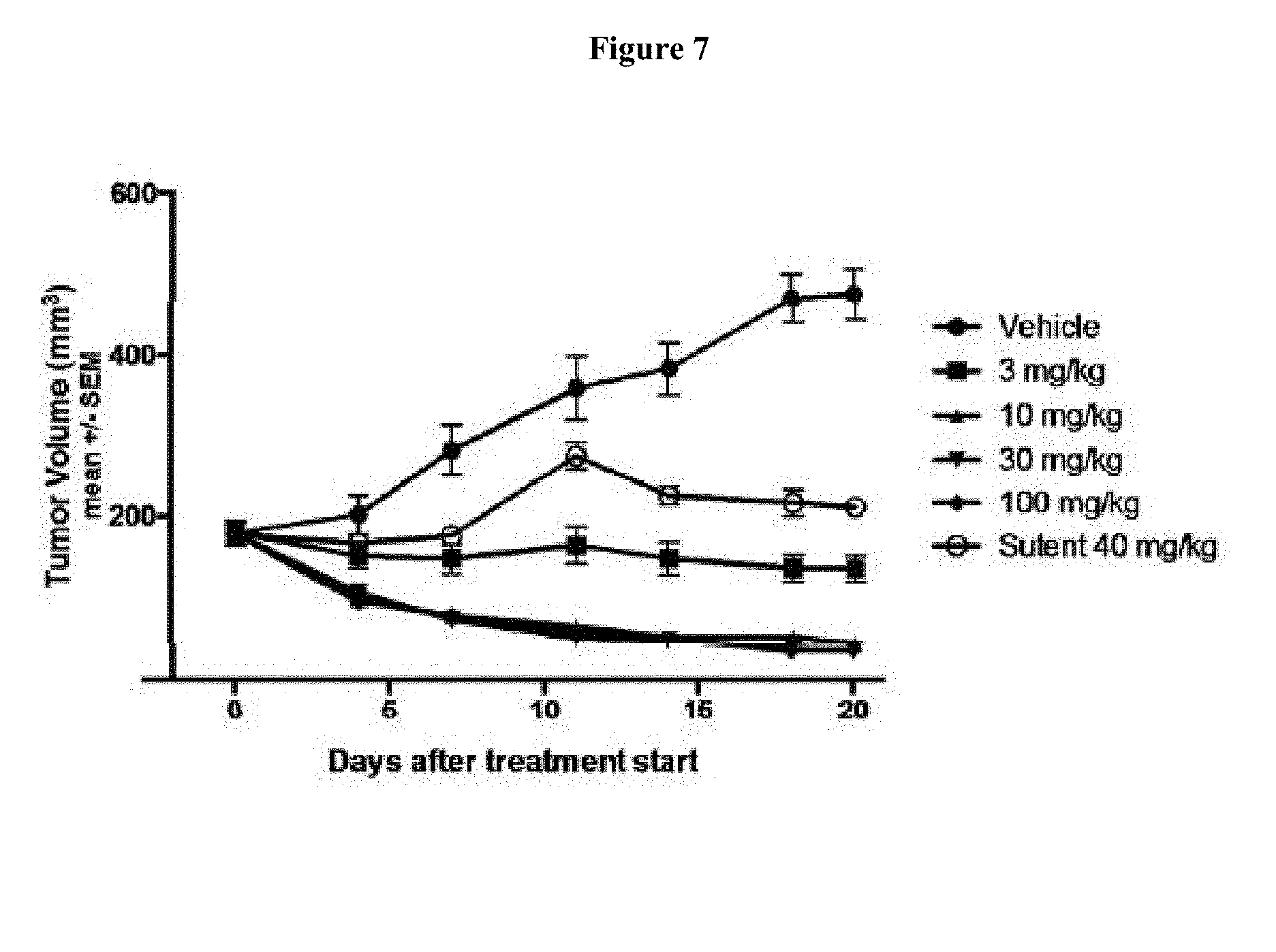
D00008
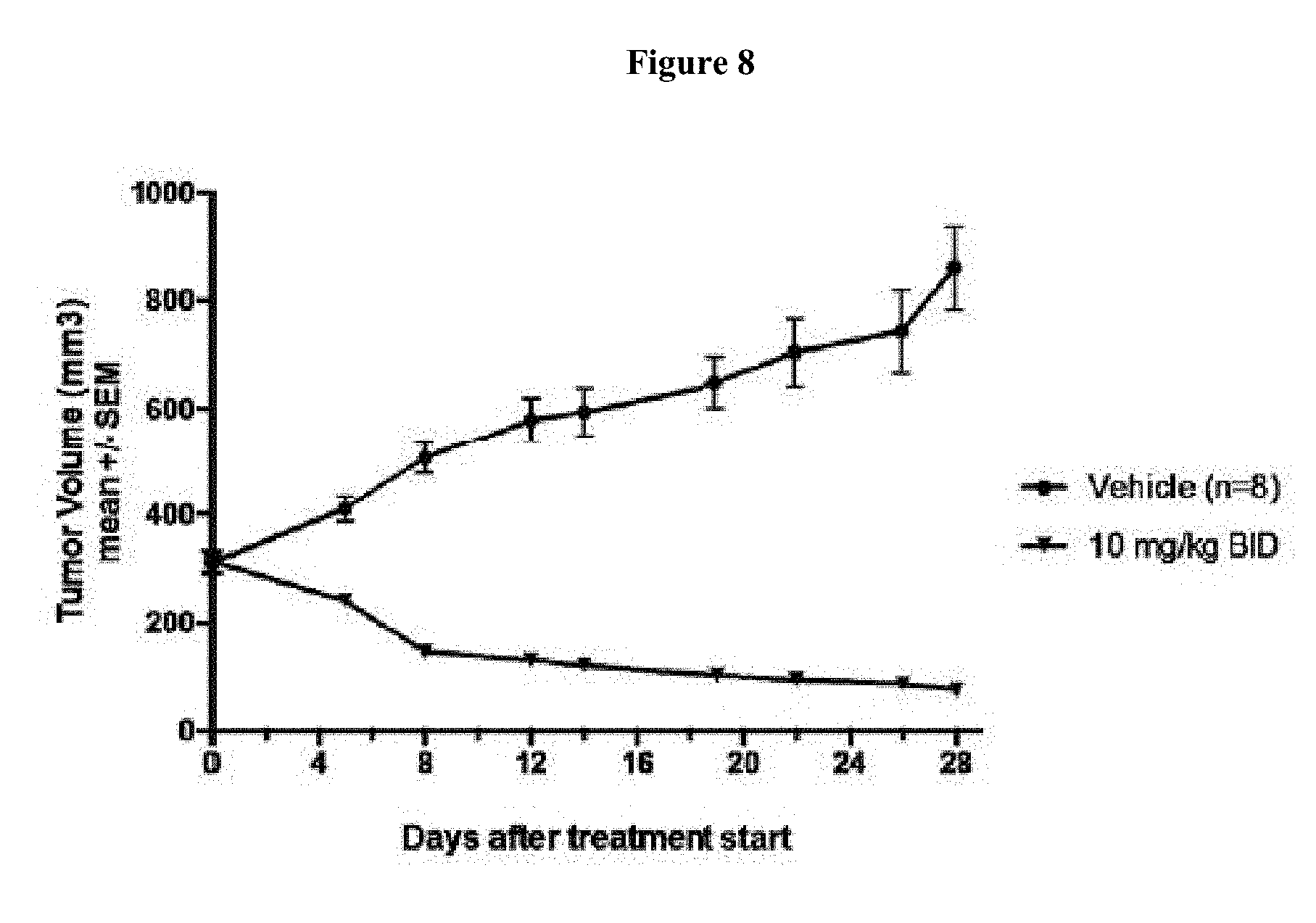
D00009
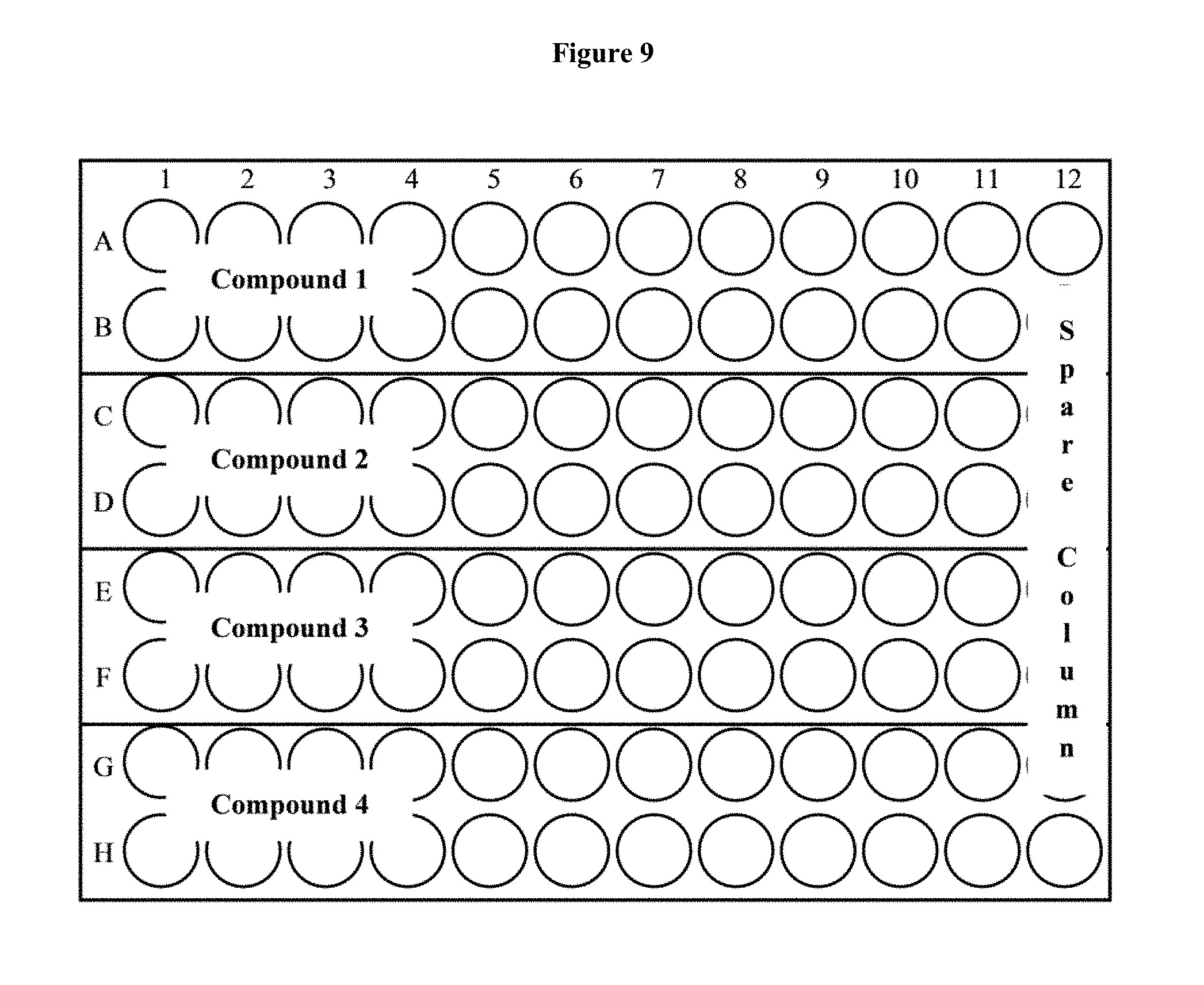
D00010
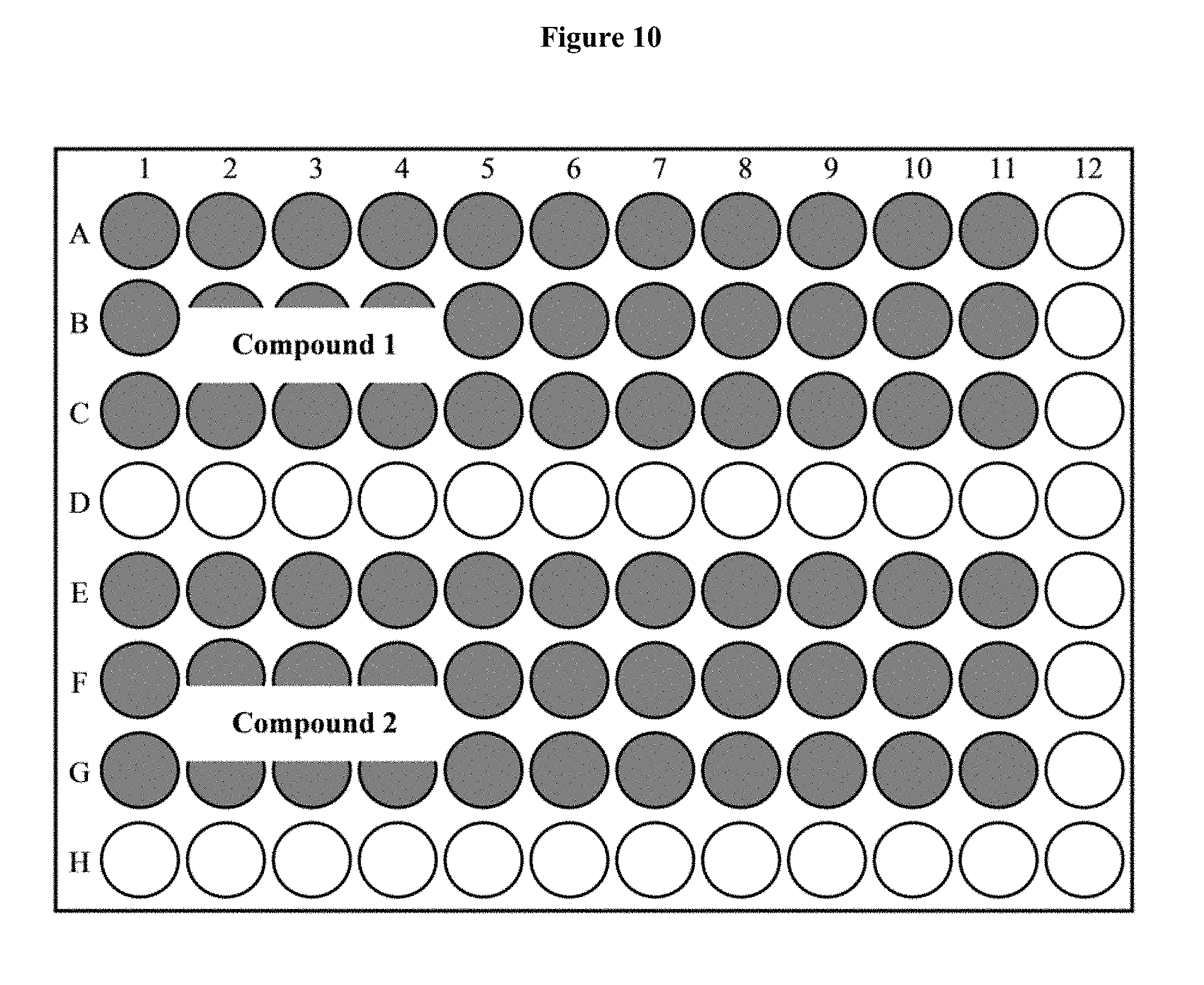
P00001

P00002

XML
uspto.report is an independent third-party trademark research tool that is not affiliated, endorsed, or sponsored by the United States Patent and Trademark Office (USPTO) or any other governmental organization. The information provided by uspto.report is based on publicly available data at the time of writing and is intended for informational purposes only.
While we strive to provide accurate and up-to-date information, we do not guarantee the accuracy, completeness, reliability, or suitability of the information displayed on this site. The use of this site is at your own risk. Any reliance you place on such information is therefore strictly at your own risk.
All official trademark data, including owner information, should be verified by visiting the official USPTO website at www.uspto.gov. This site is not intended to replace professional legal advice and should not be used as a substitute for consulting with a legal professional who is knowledgeable about trademark law.